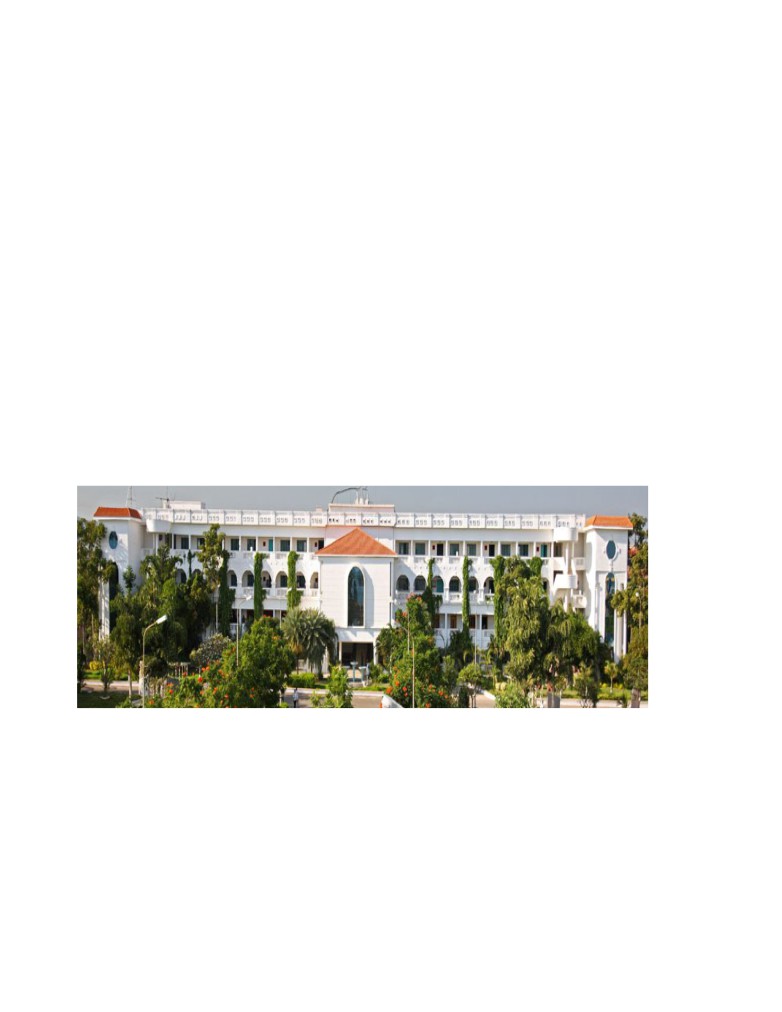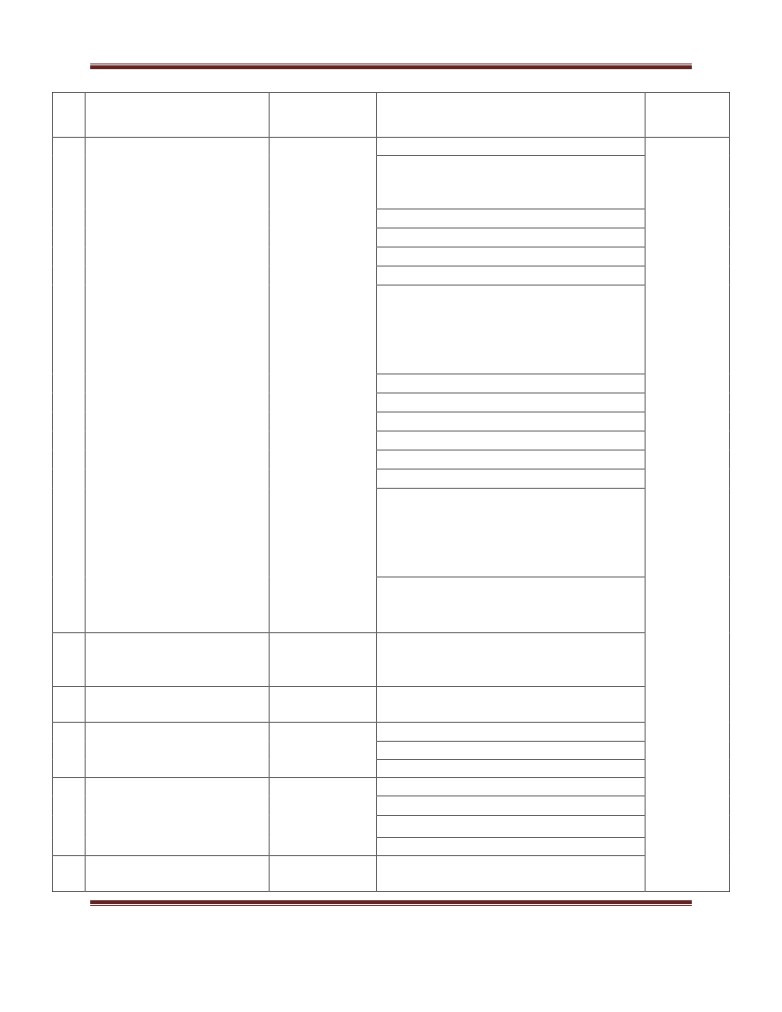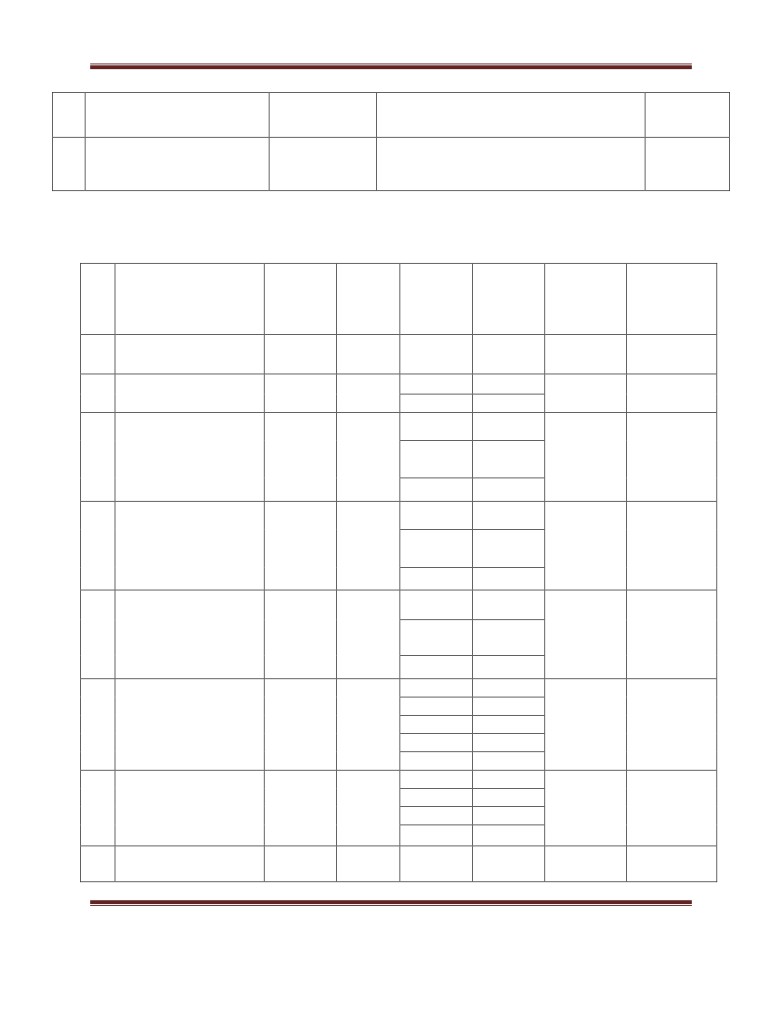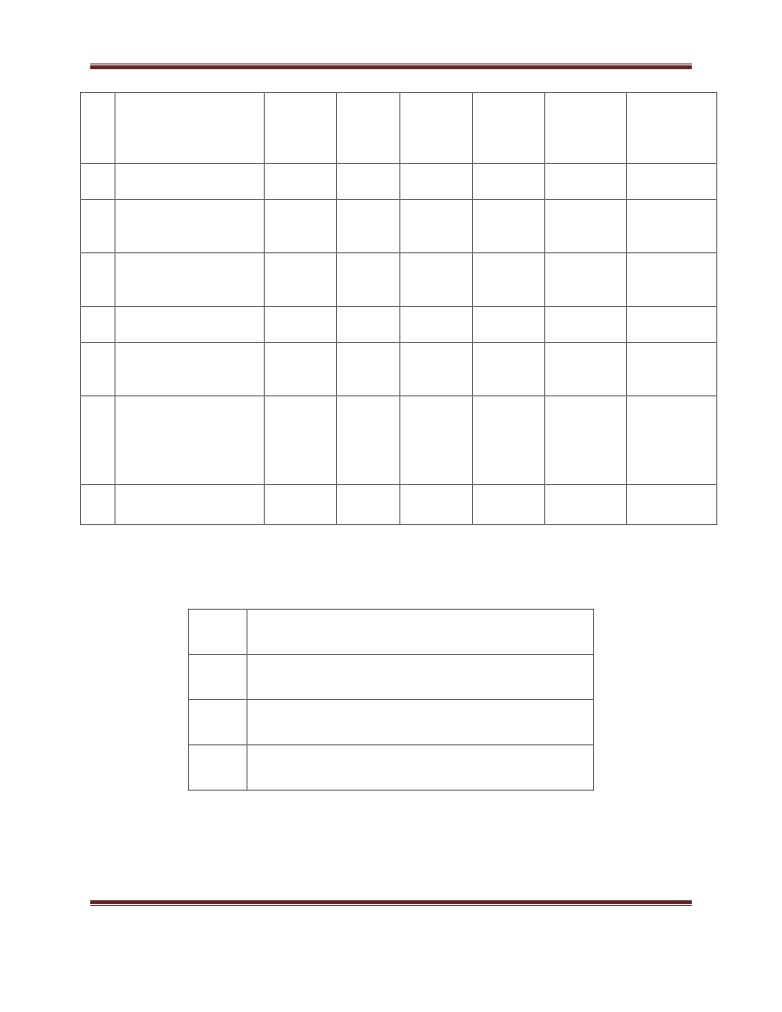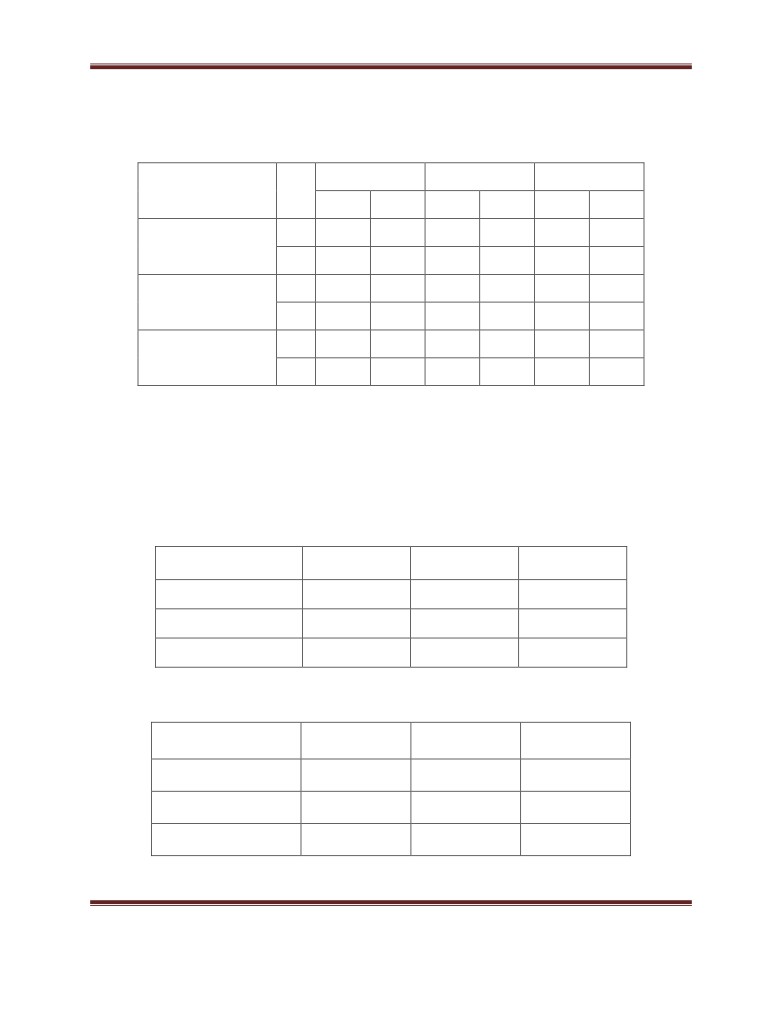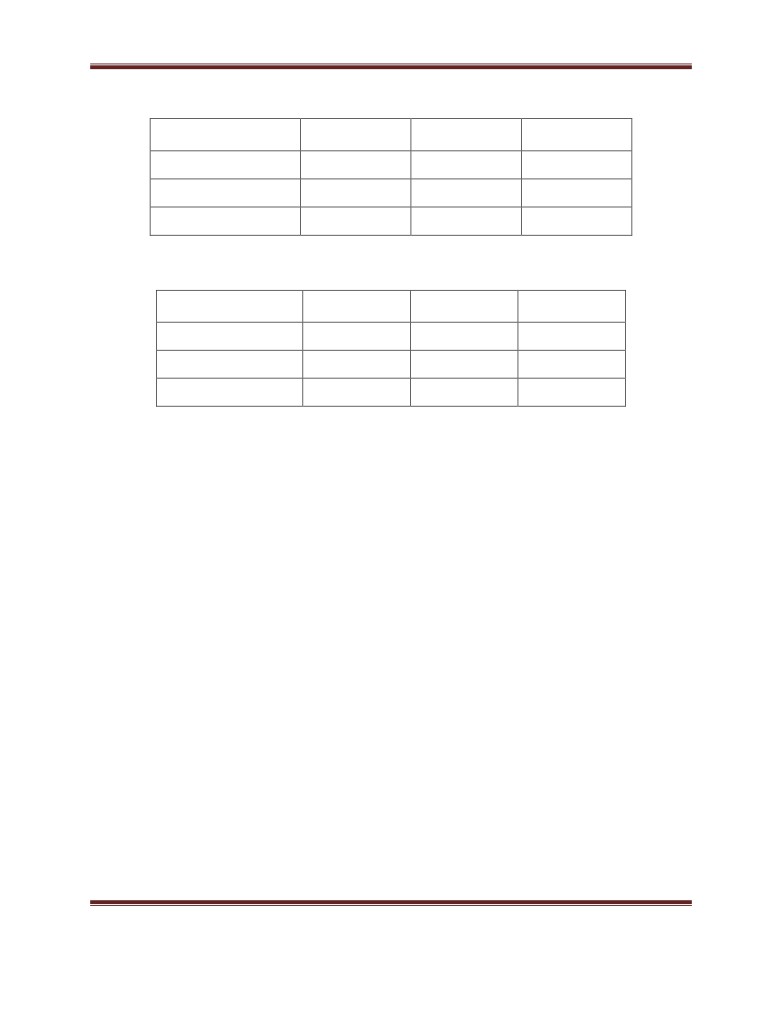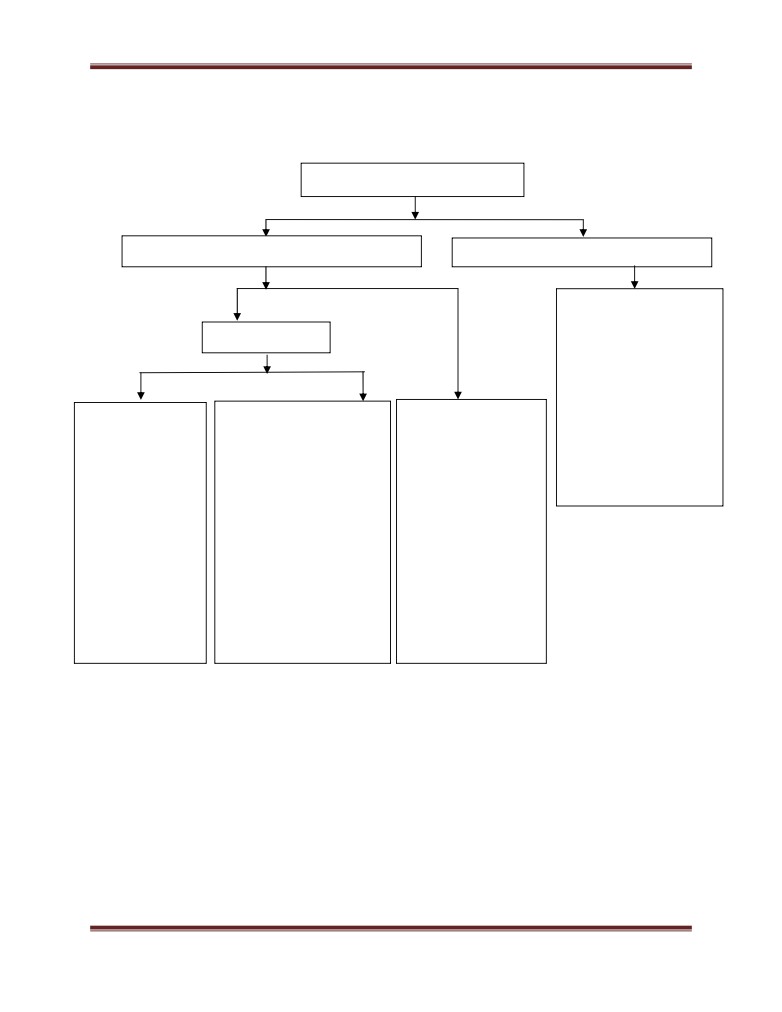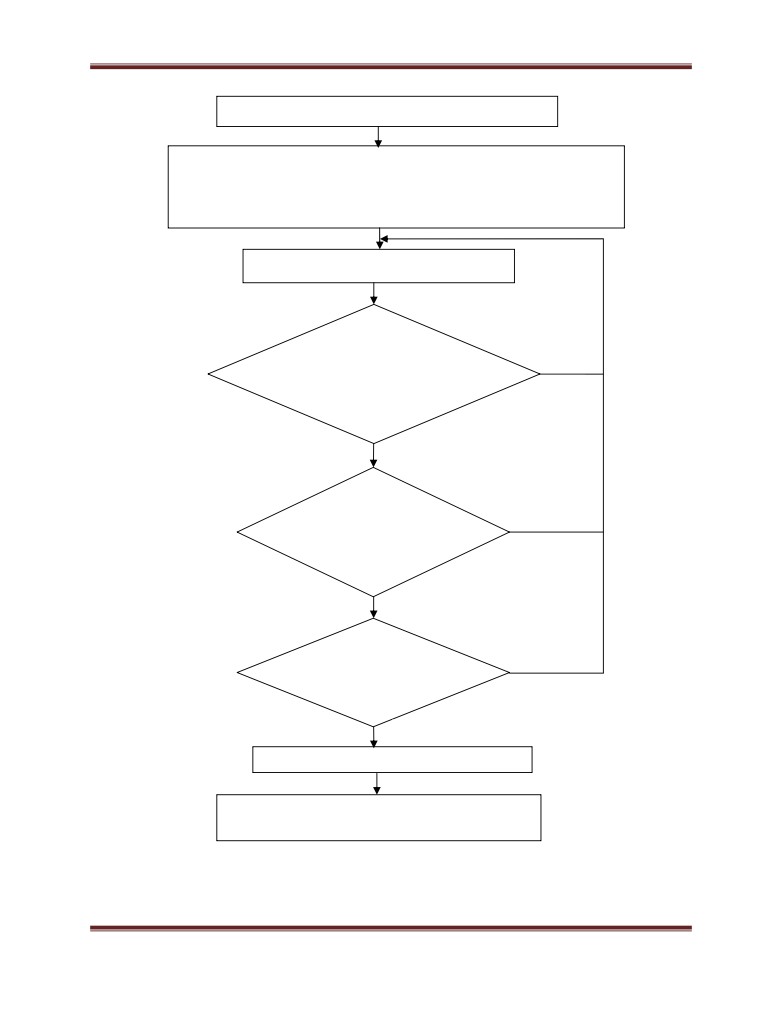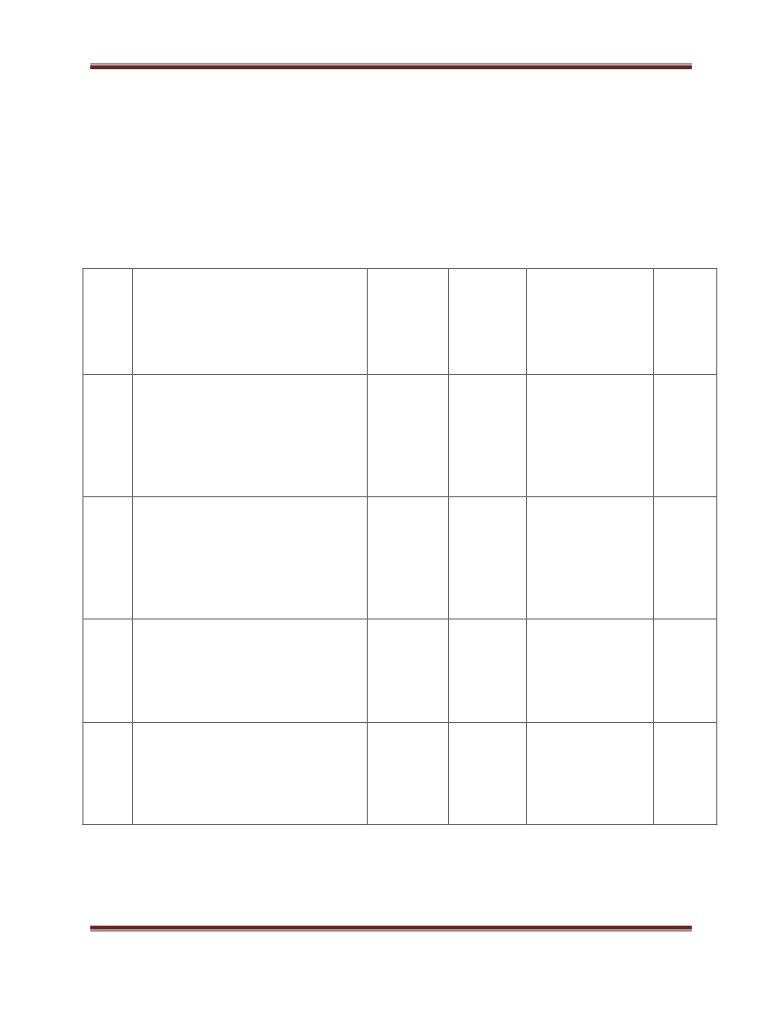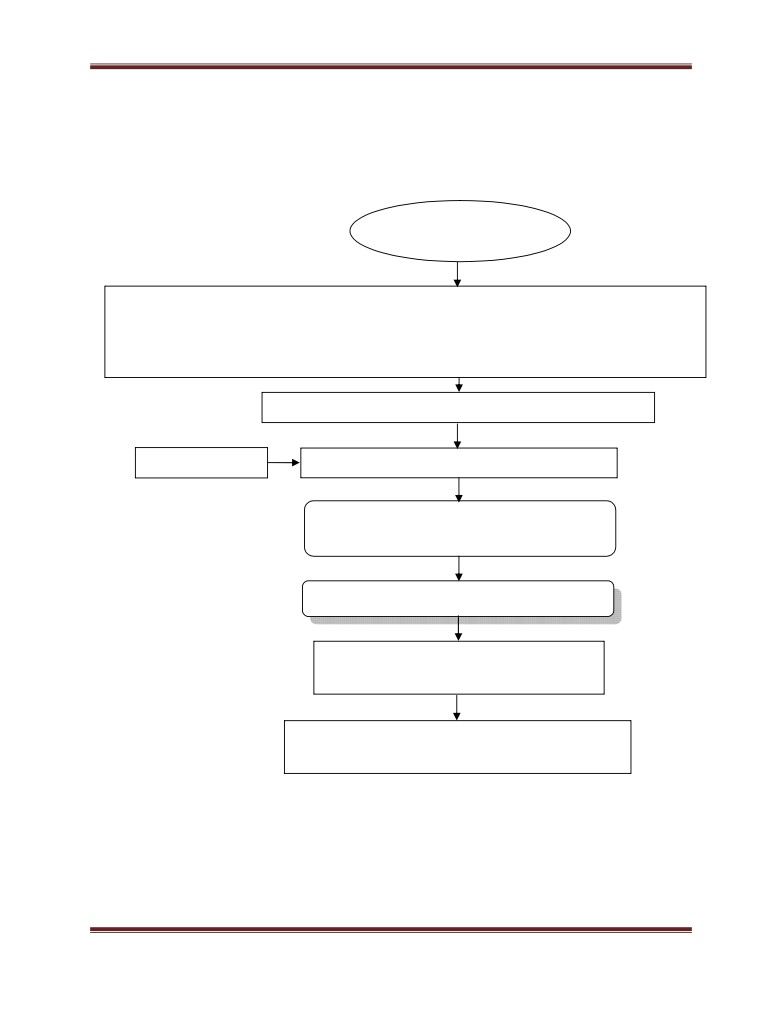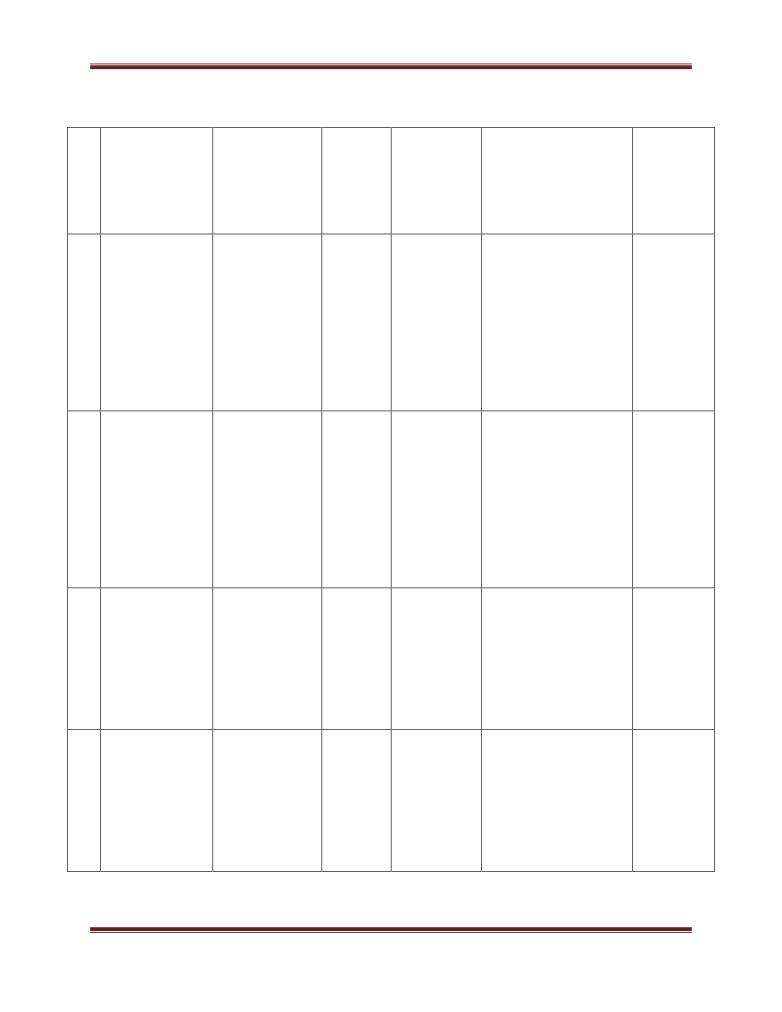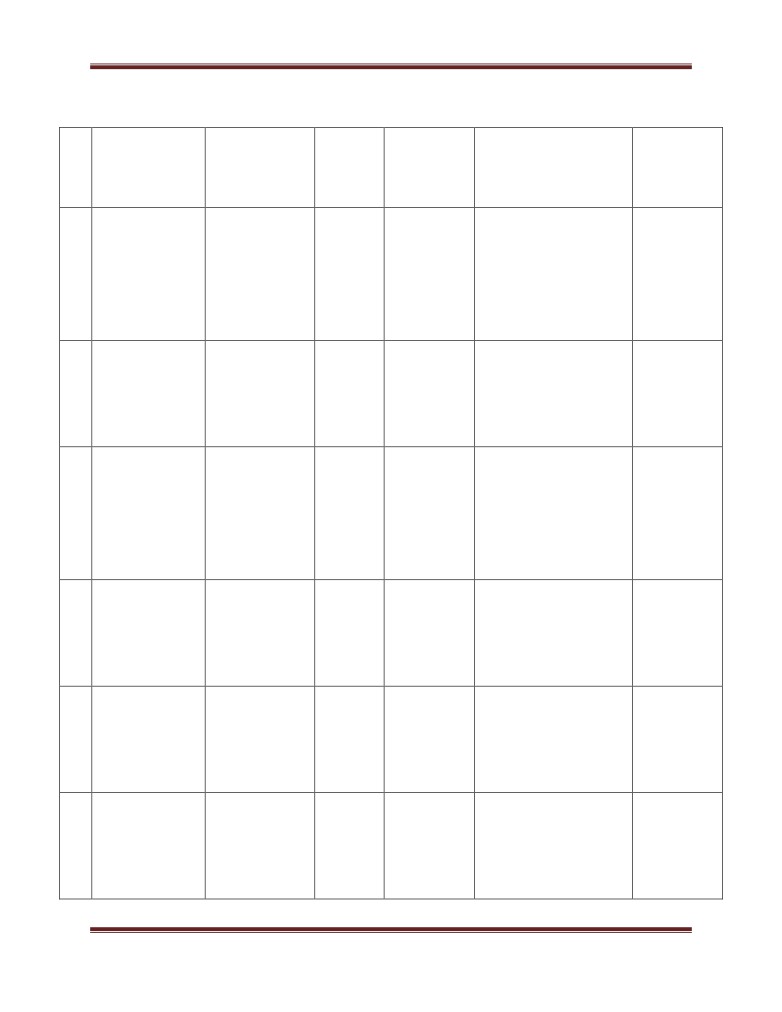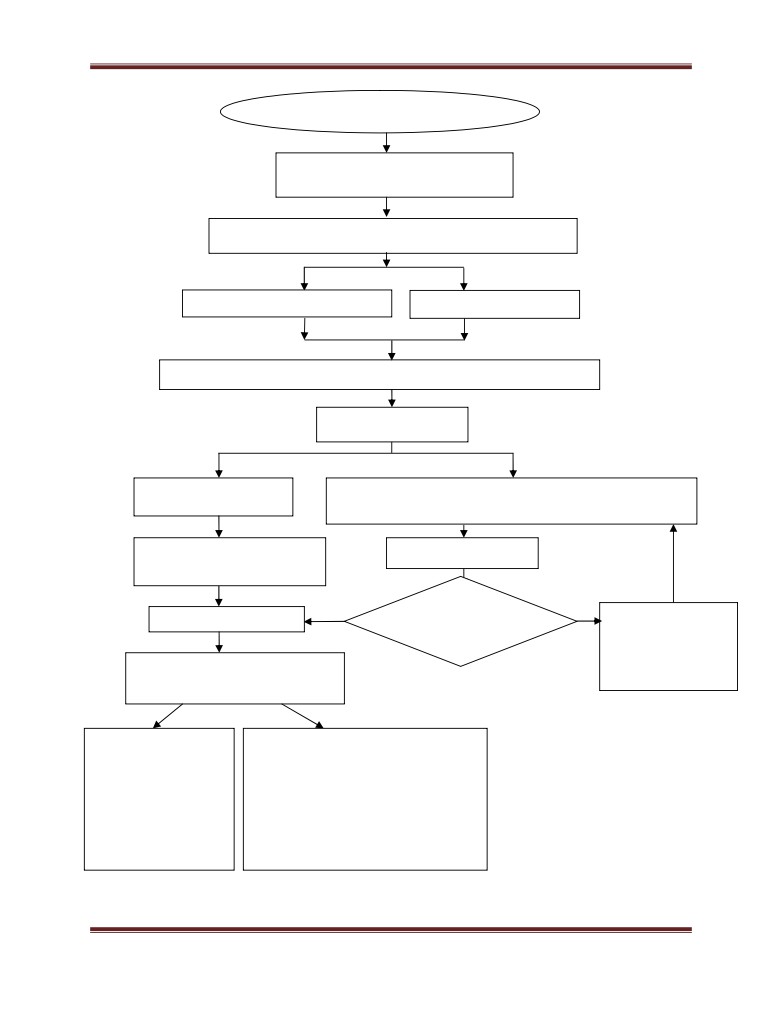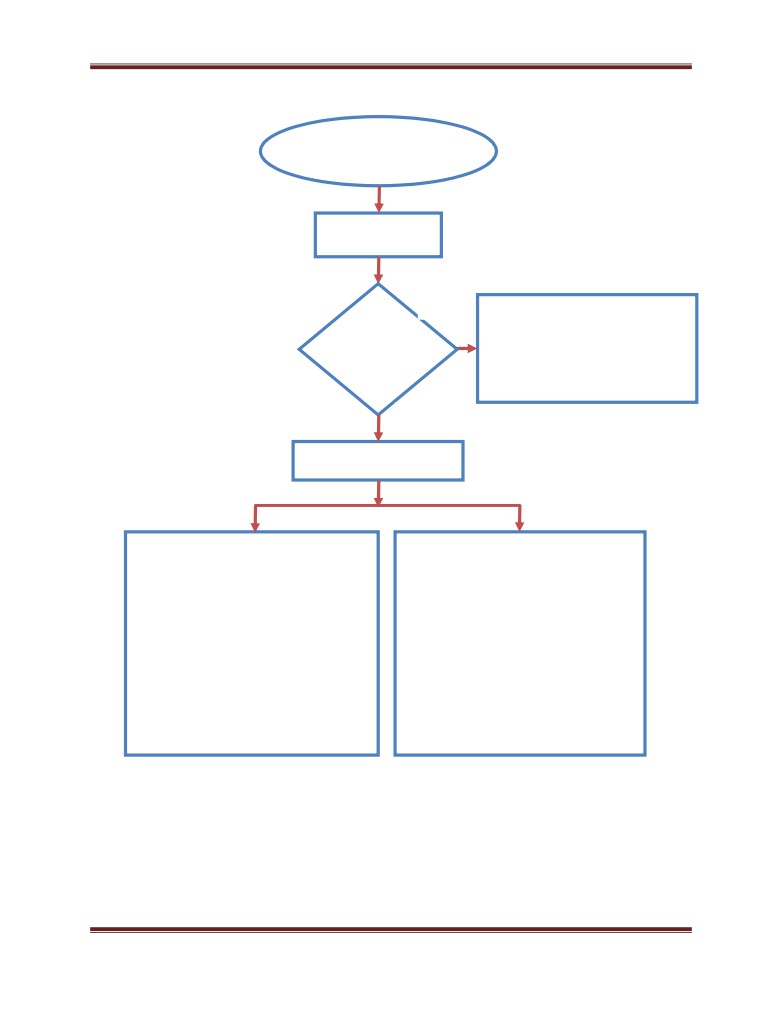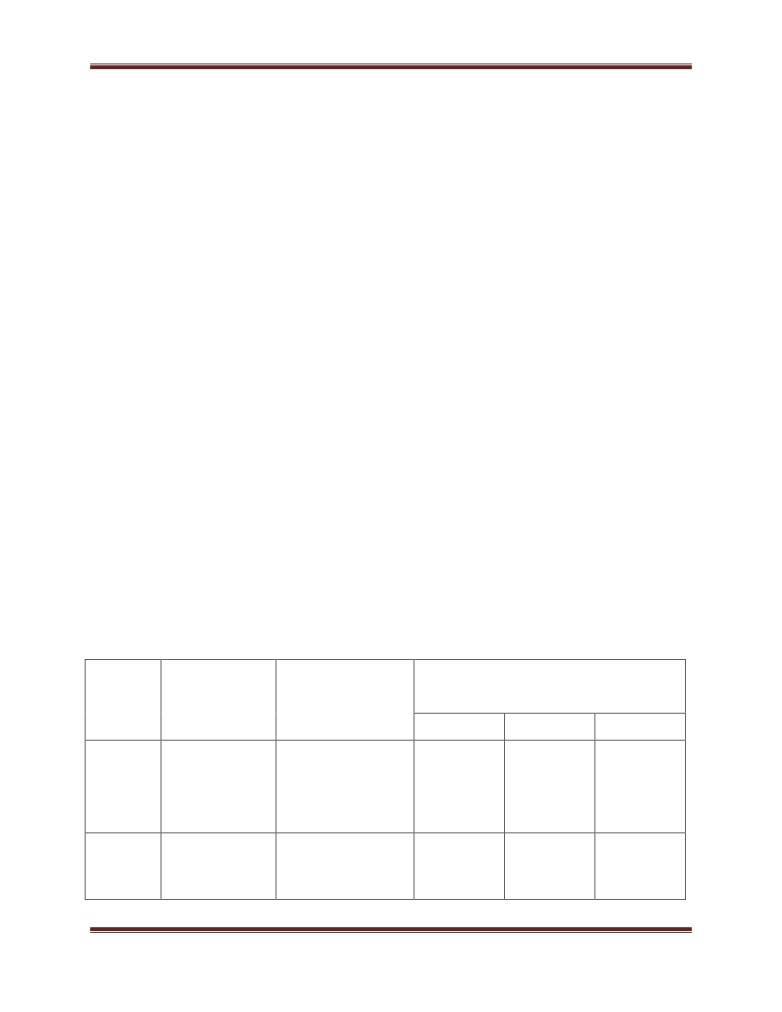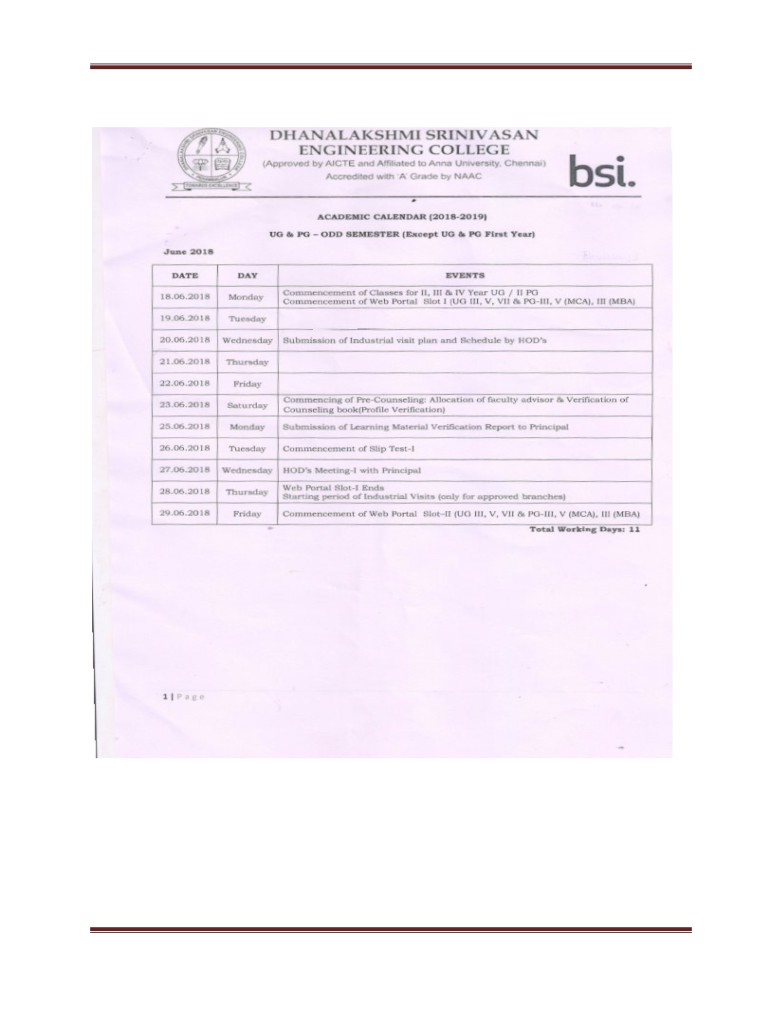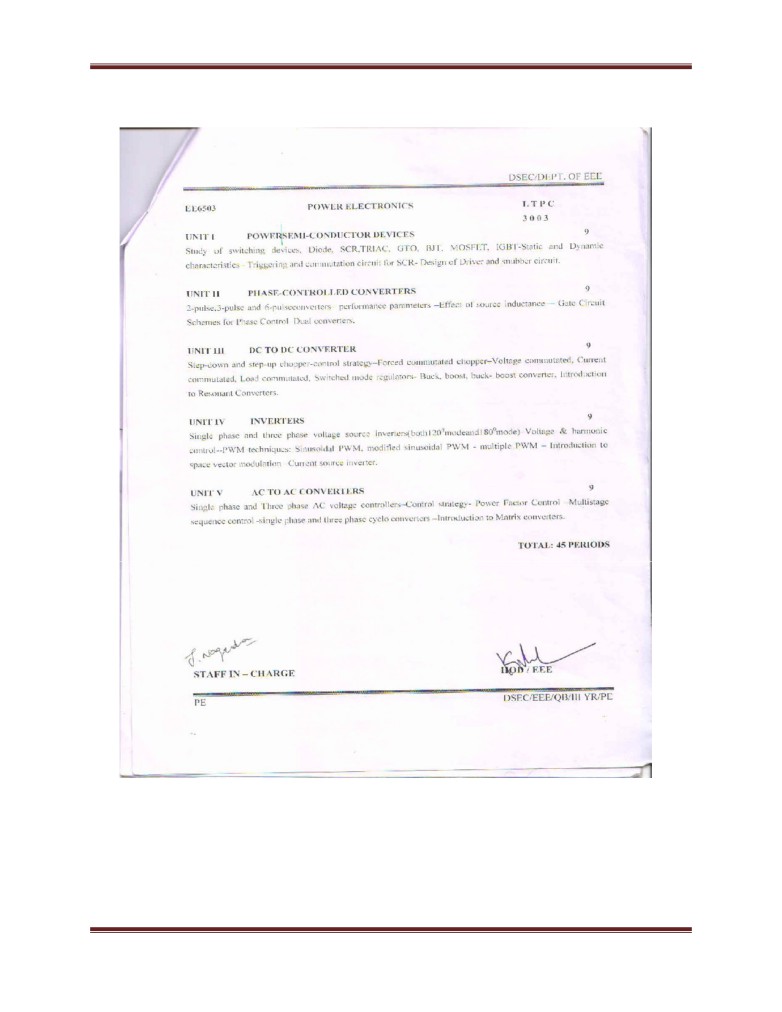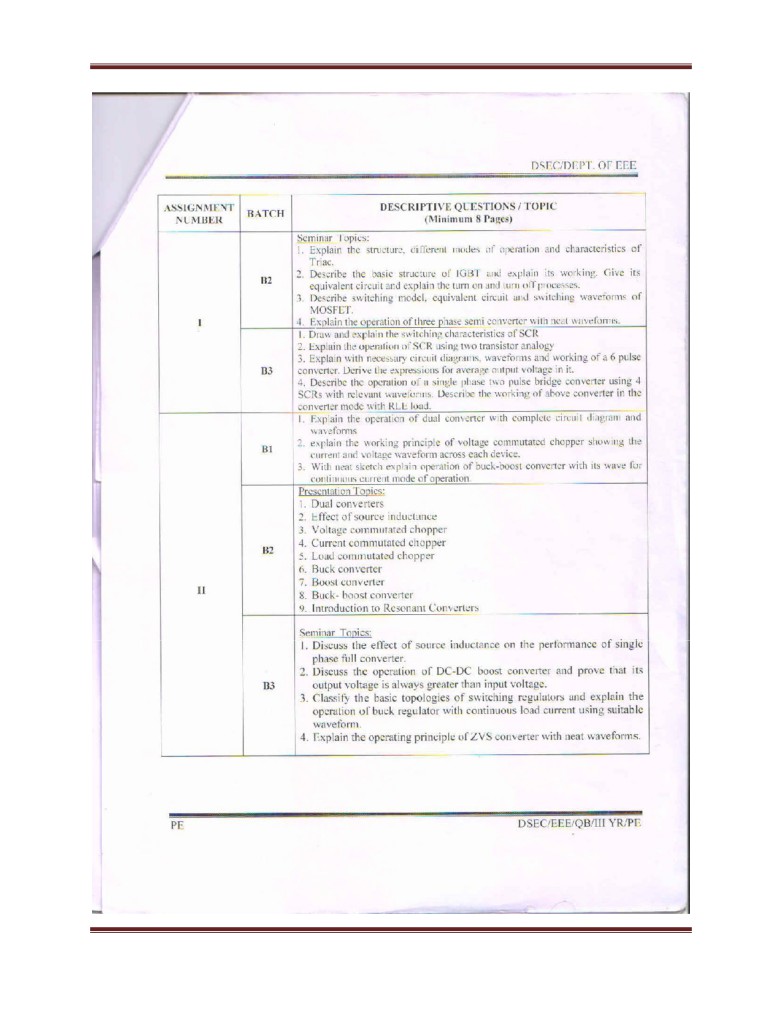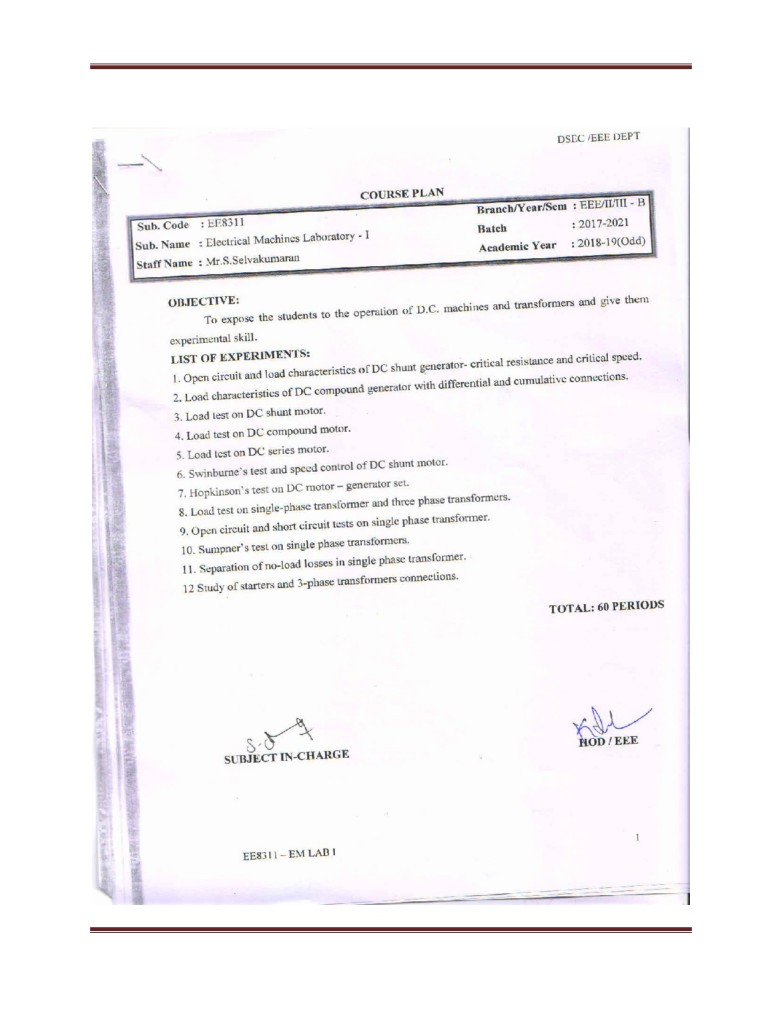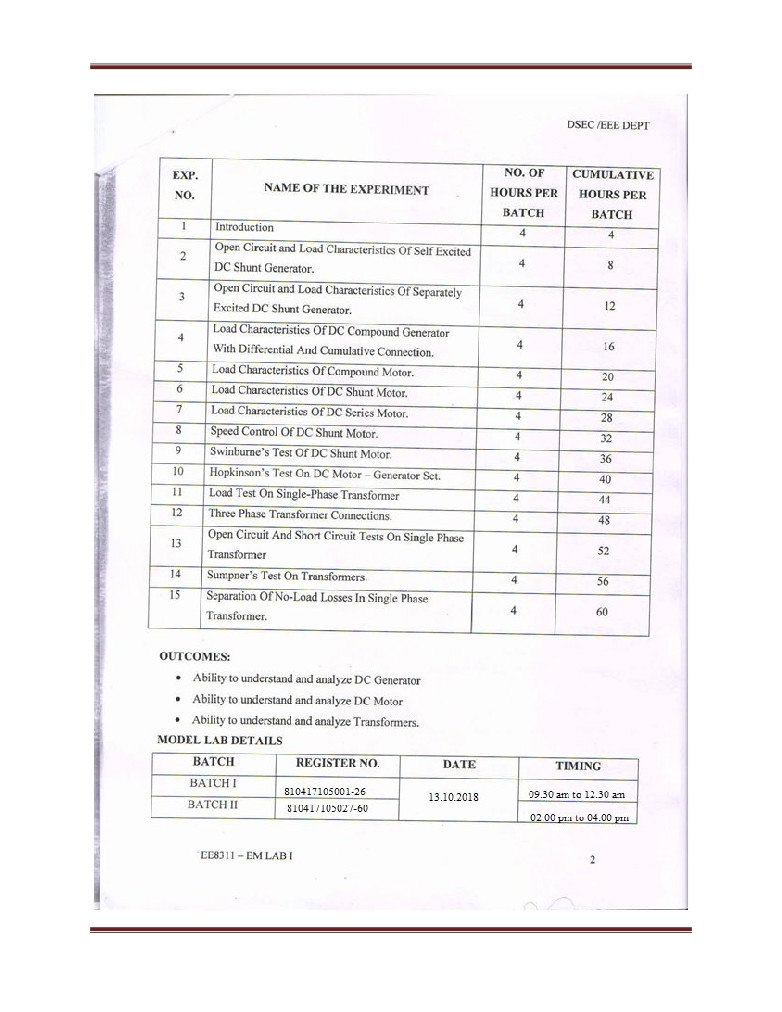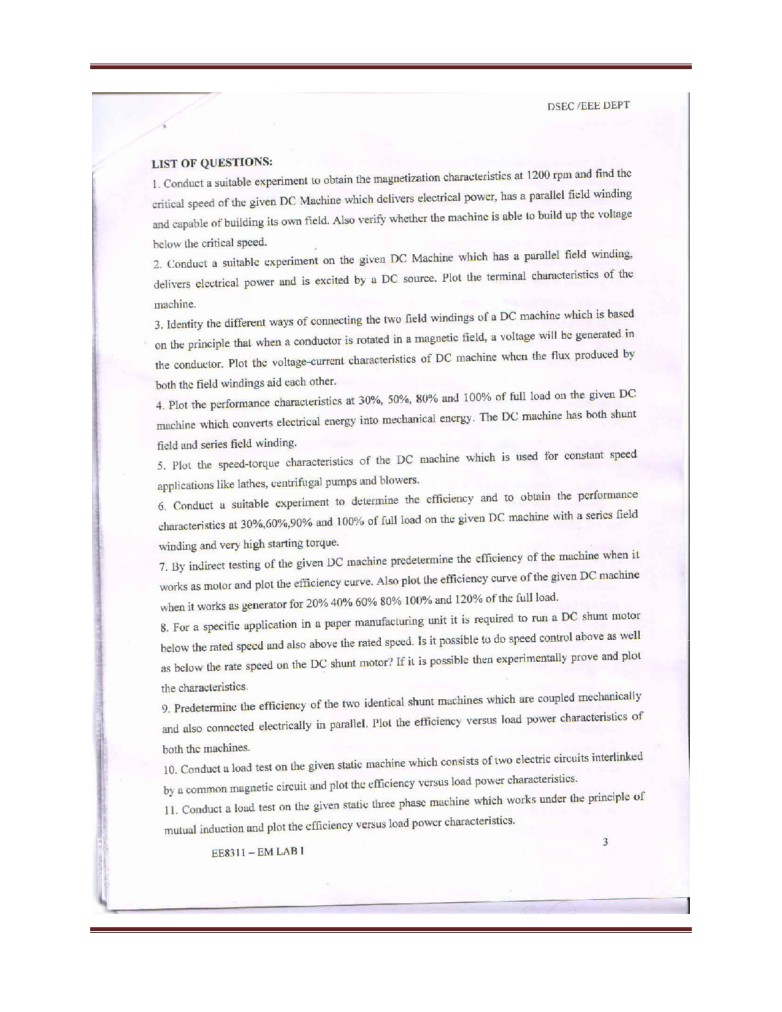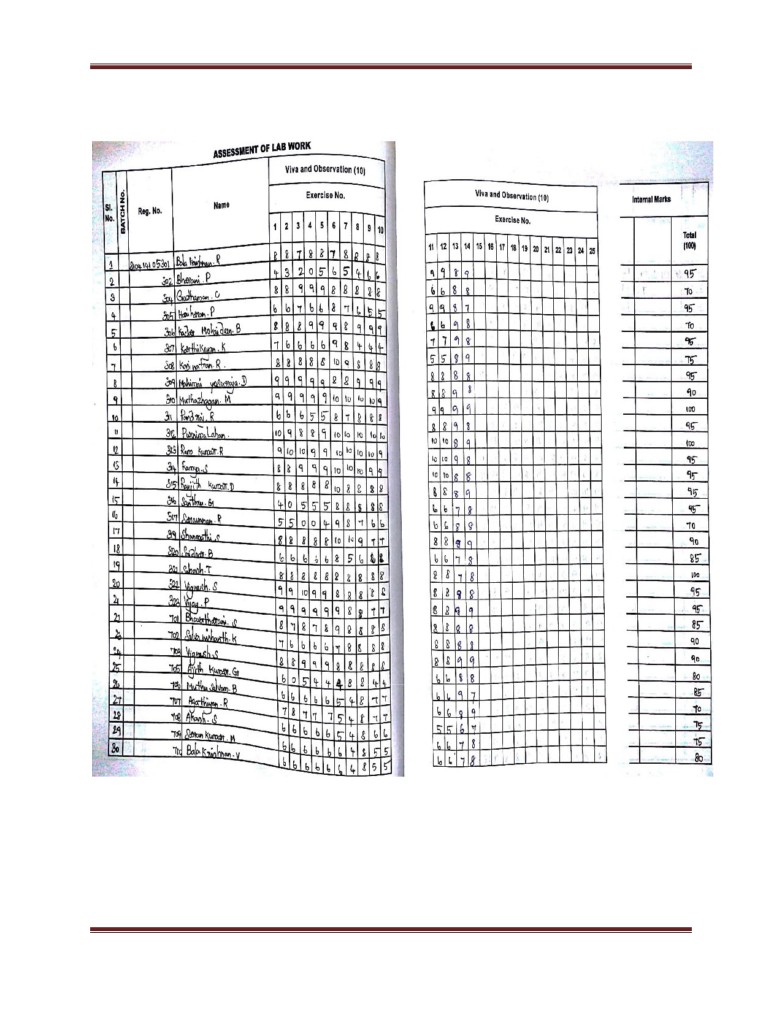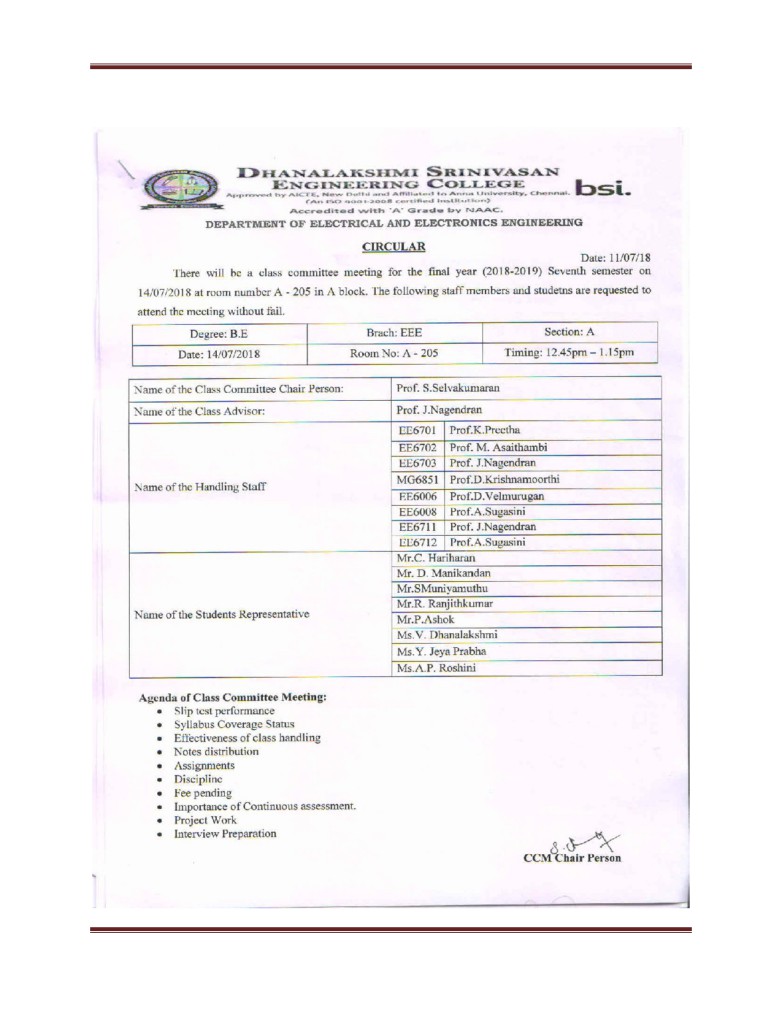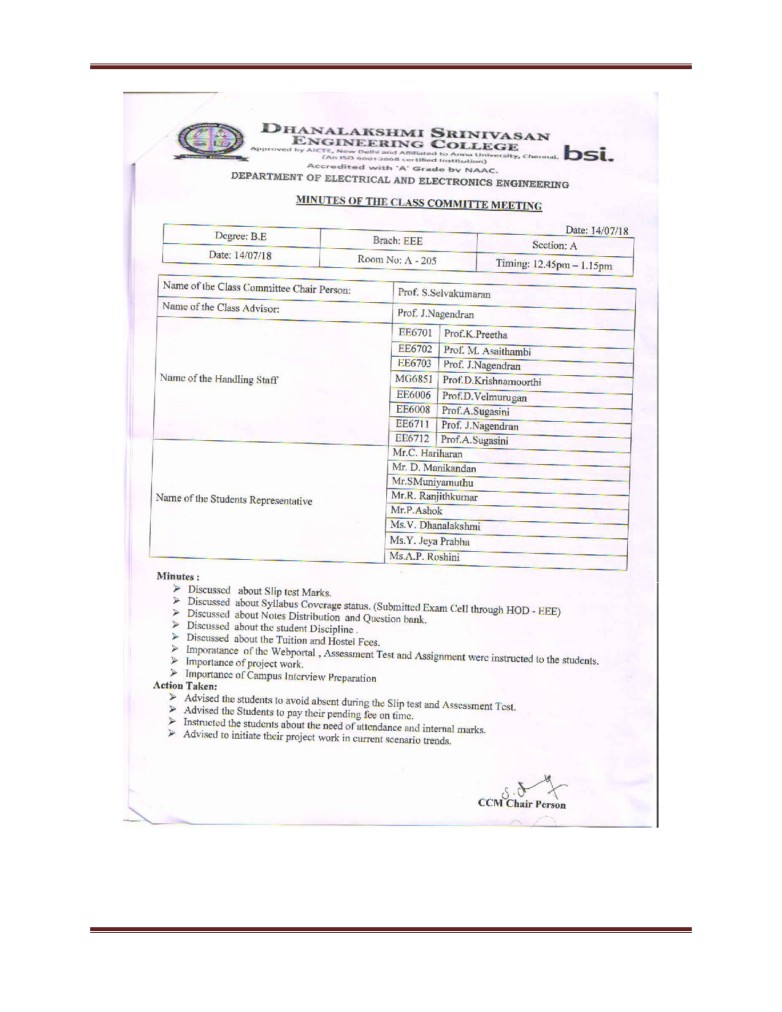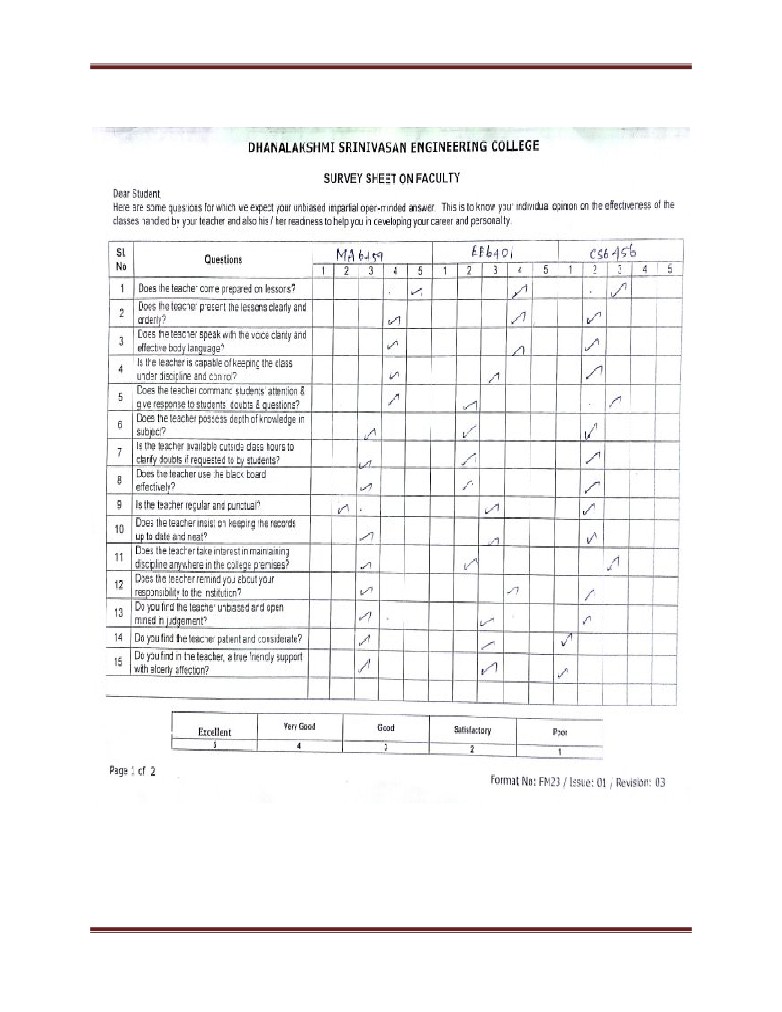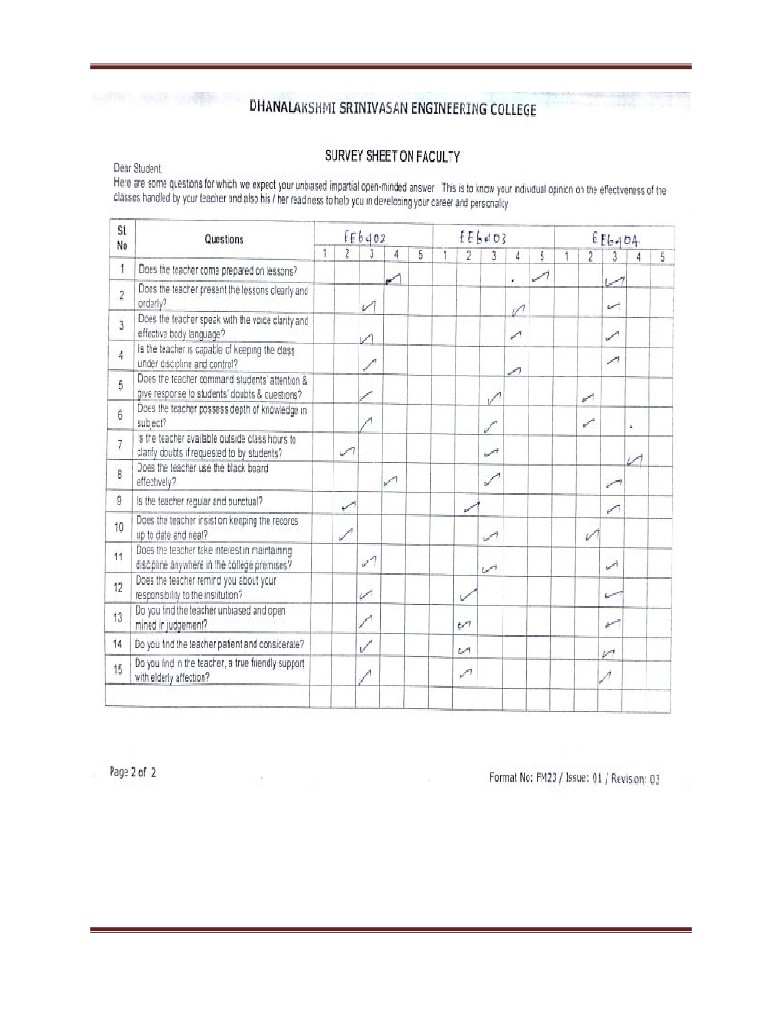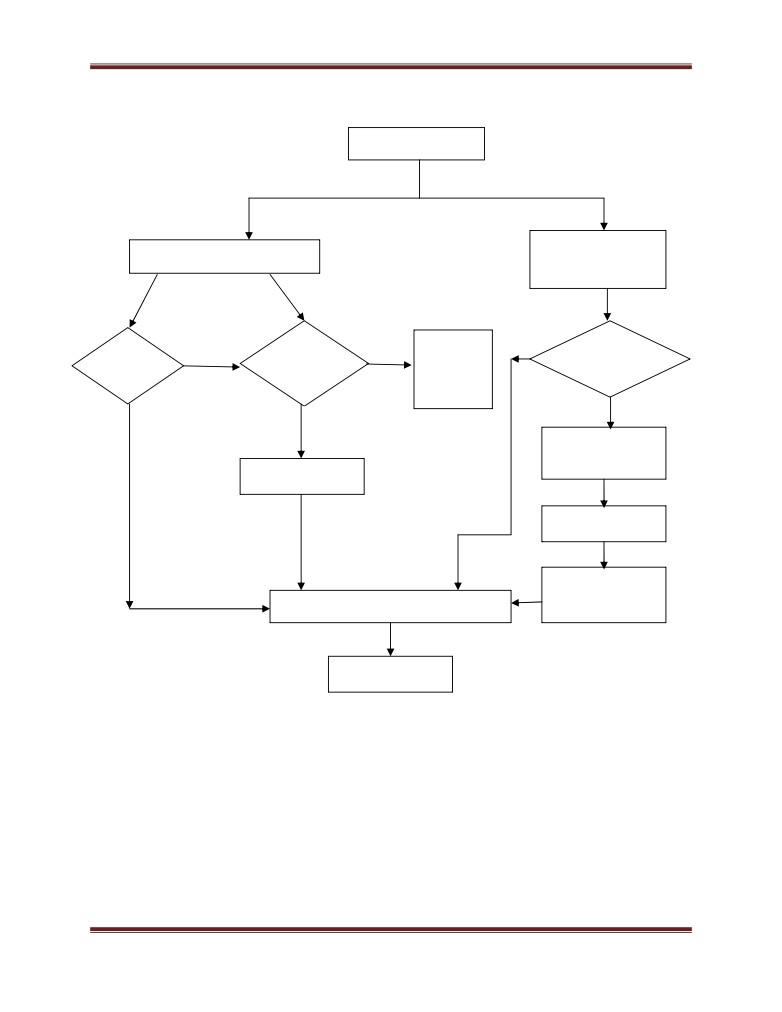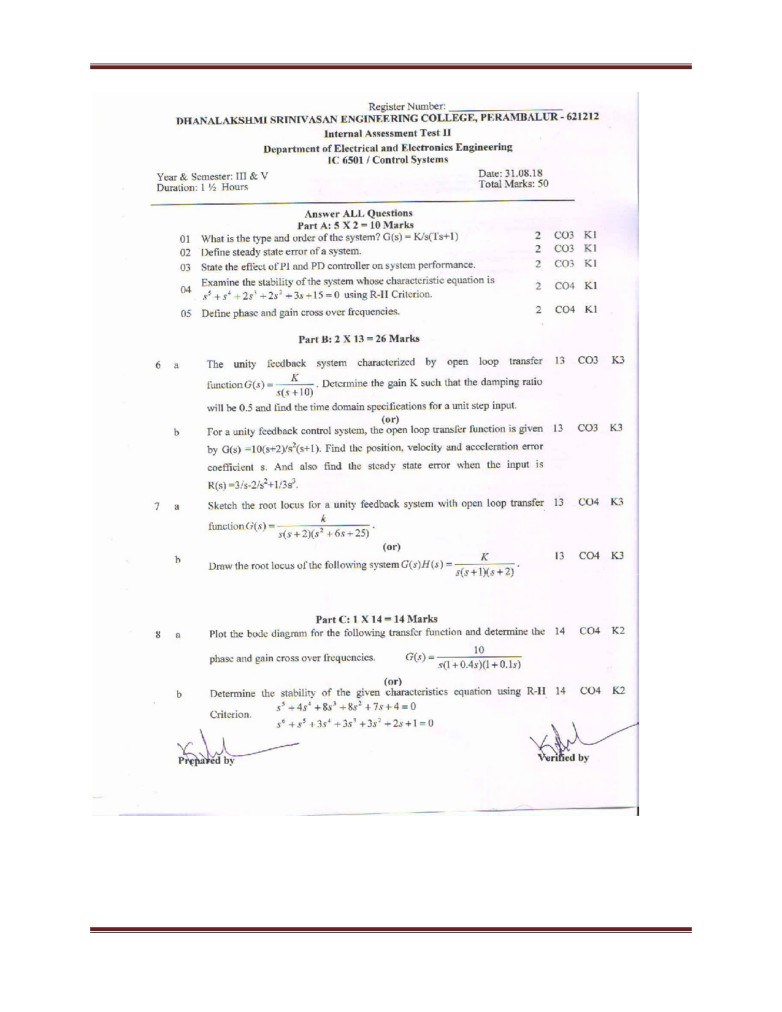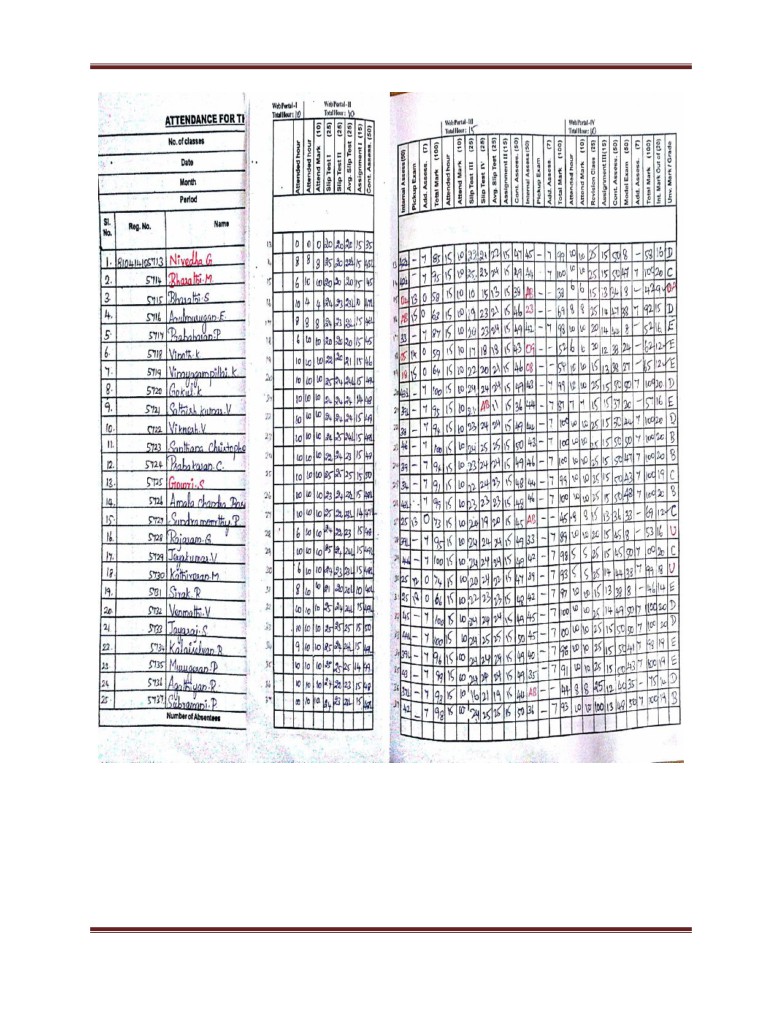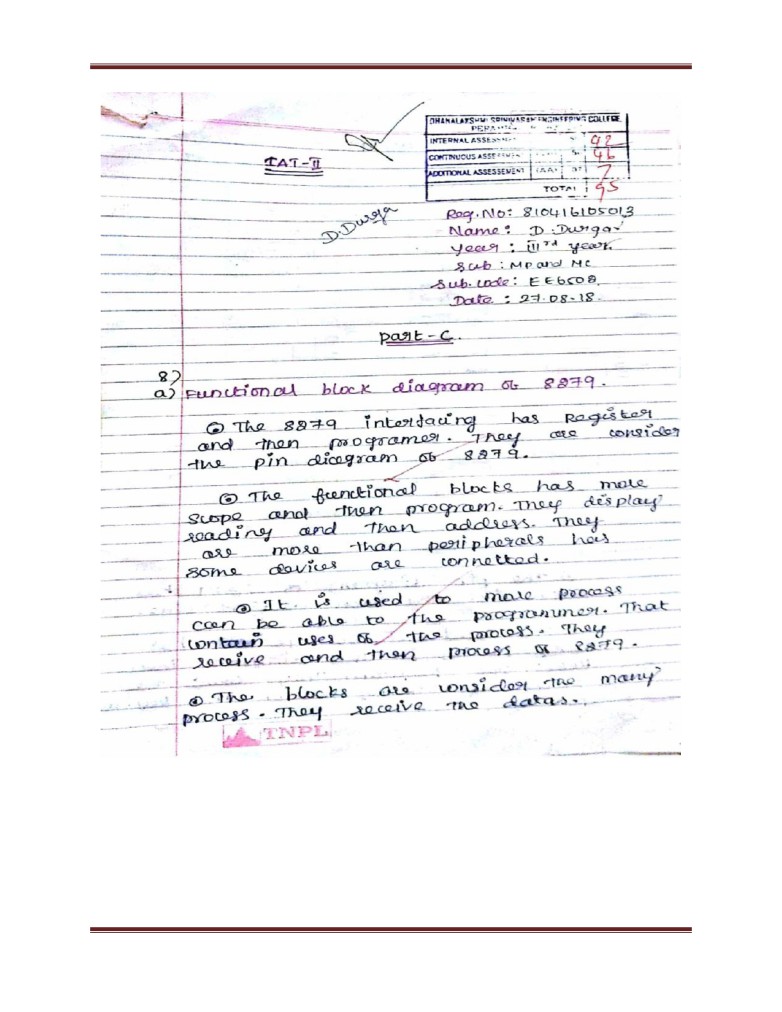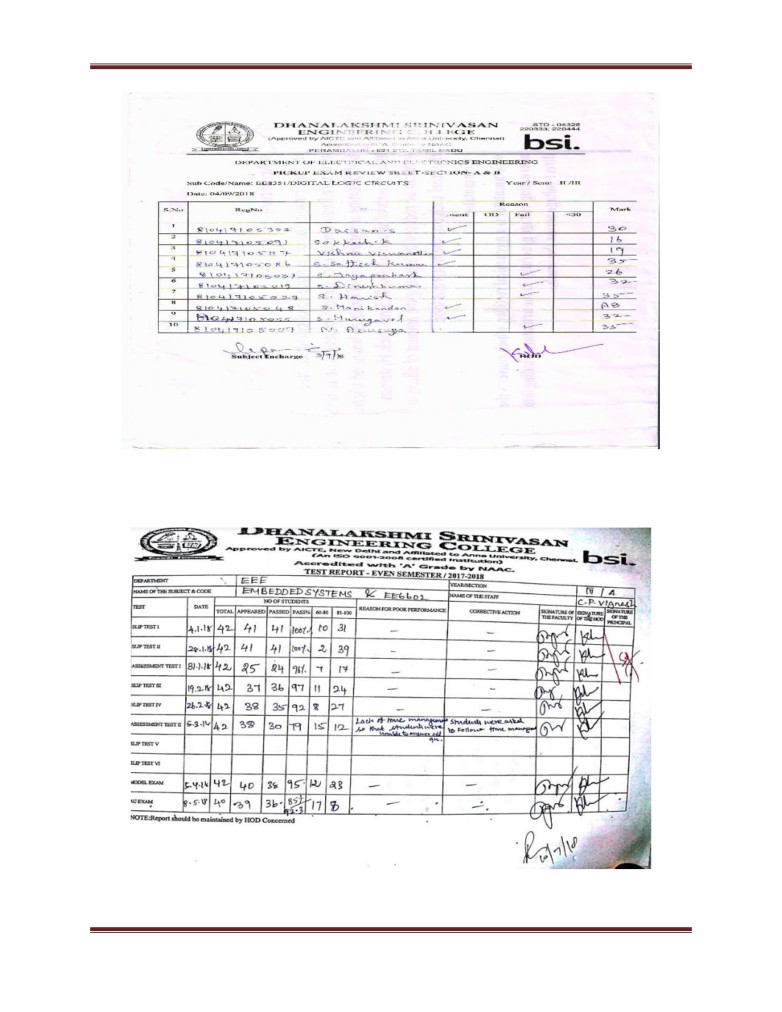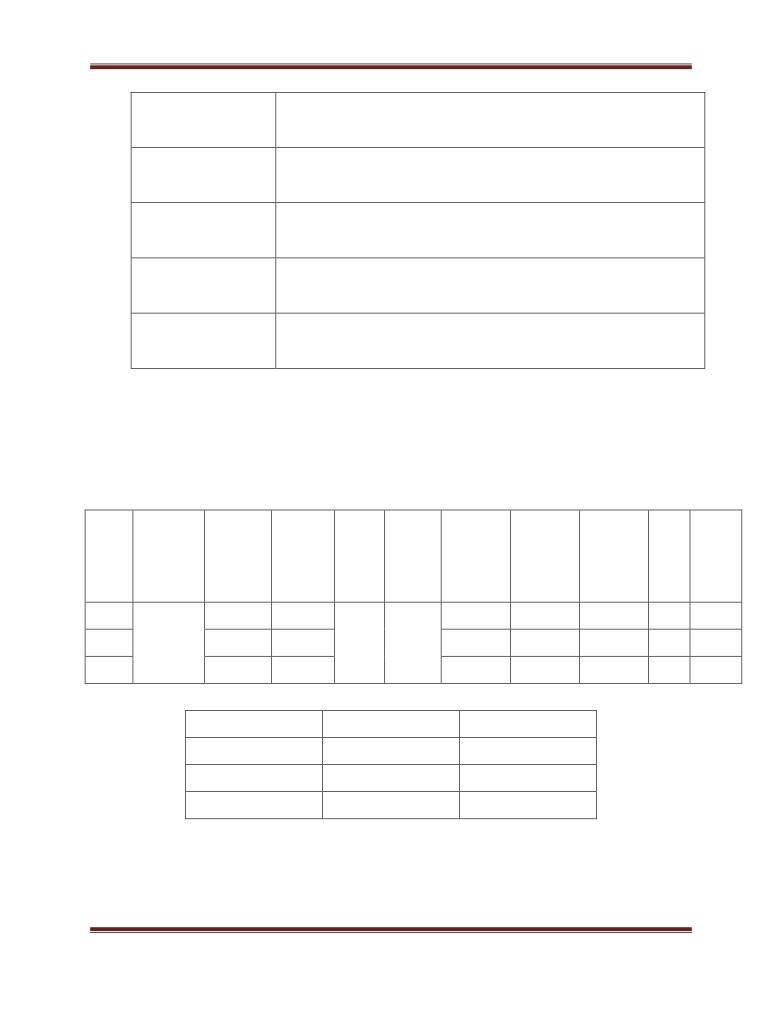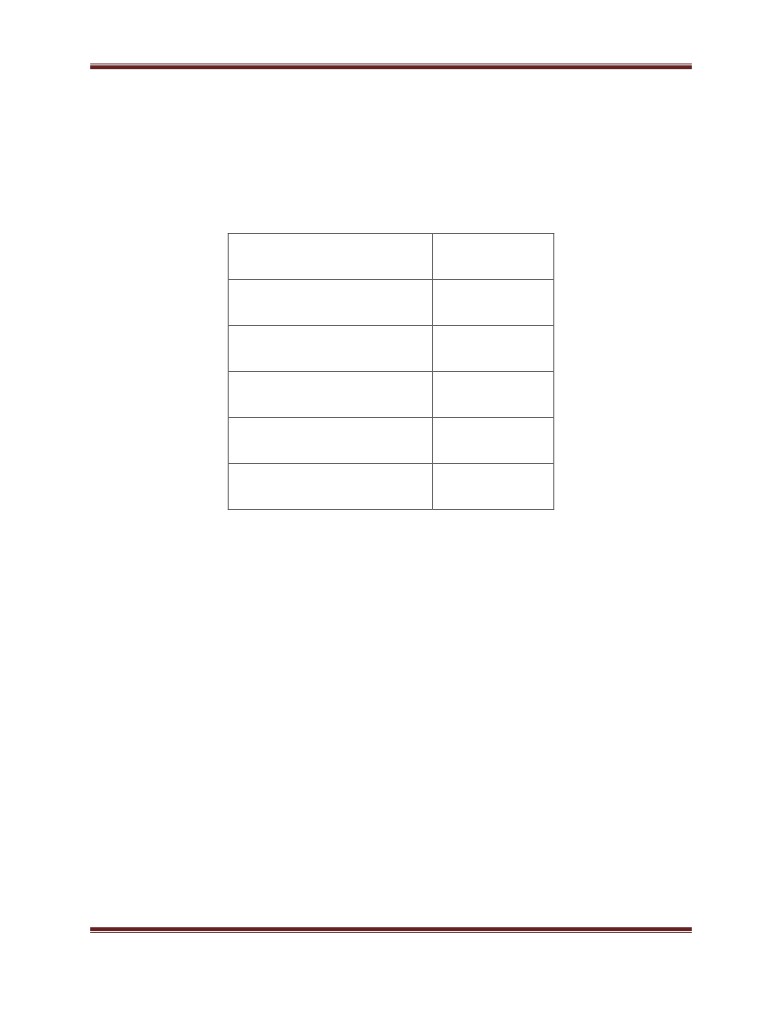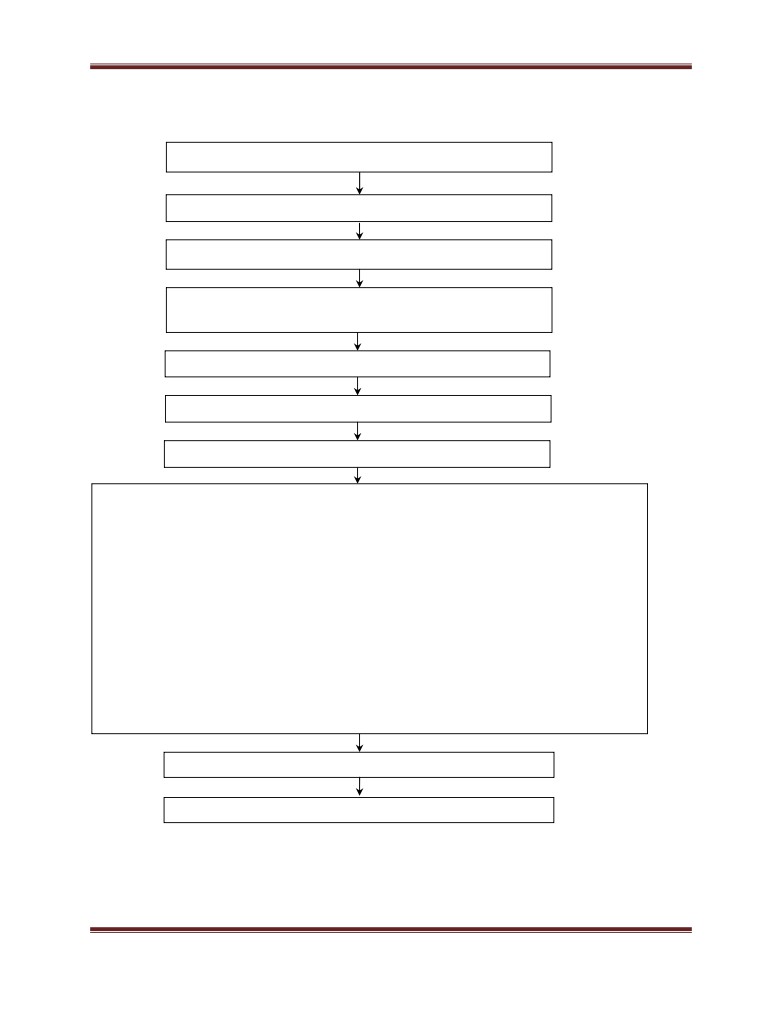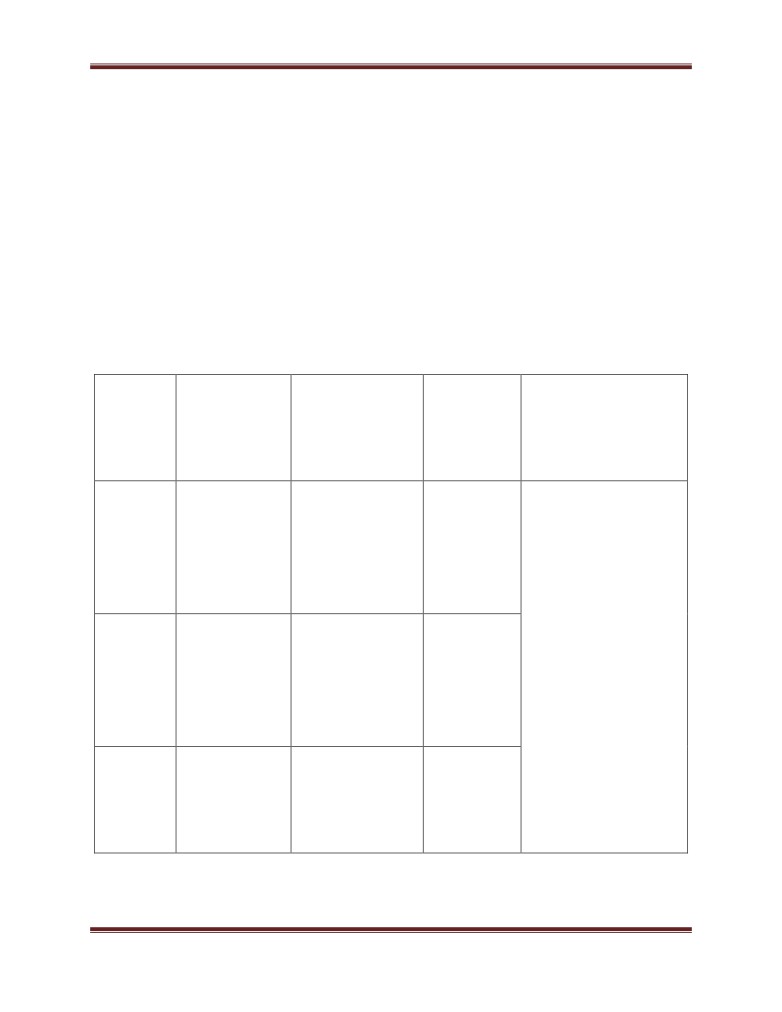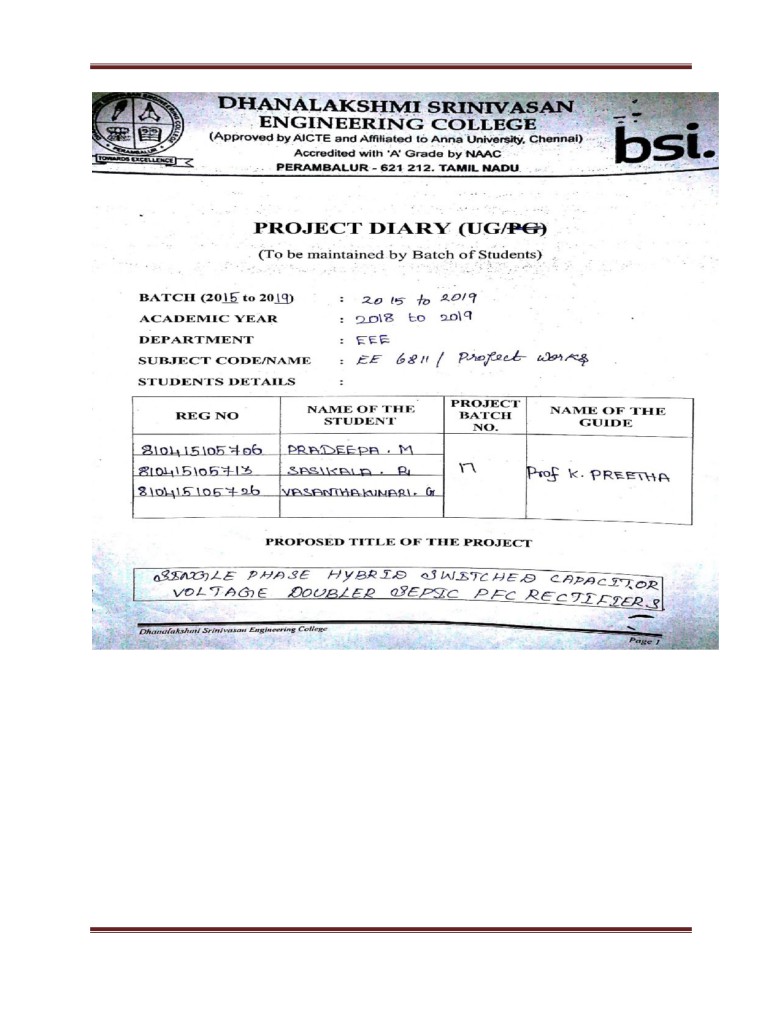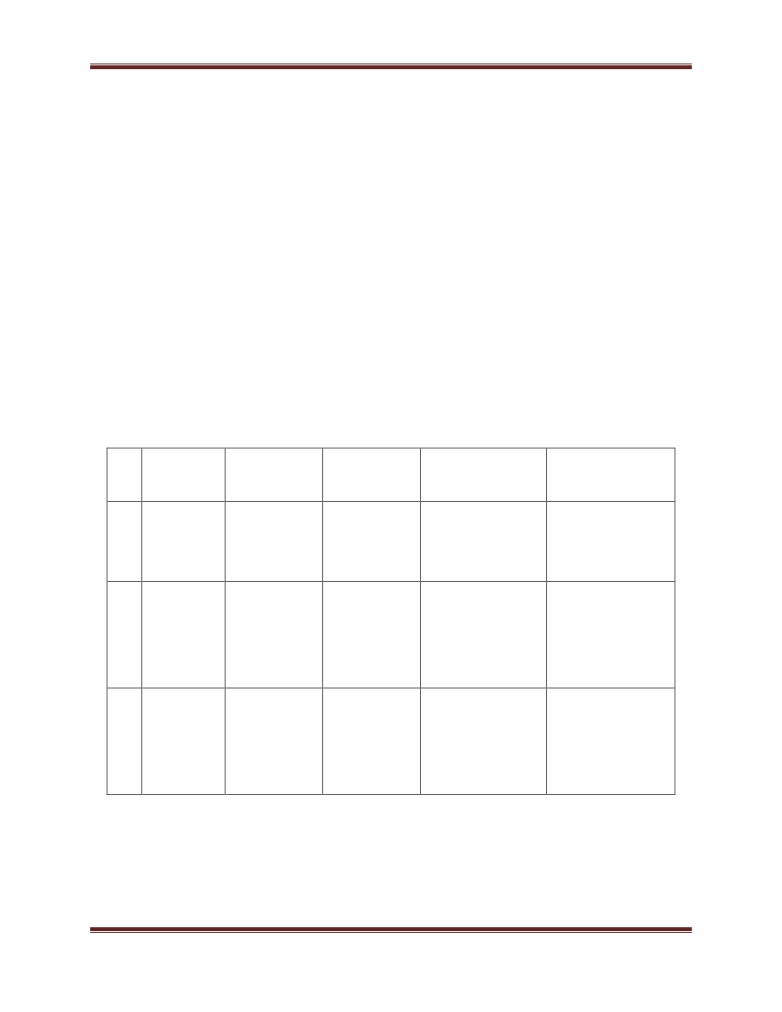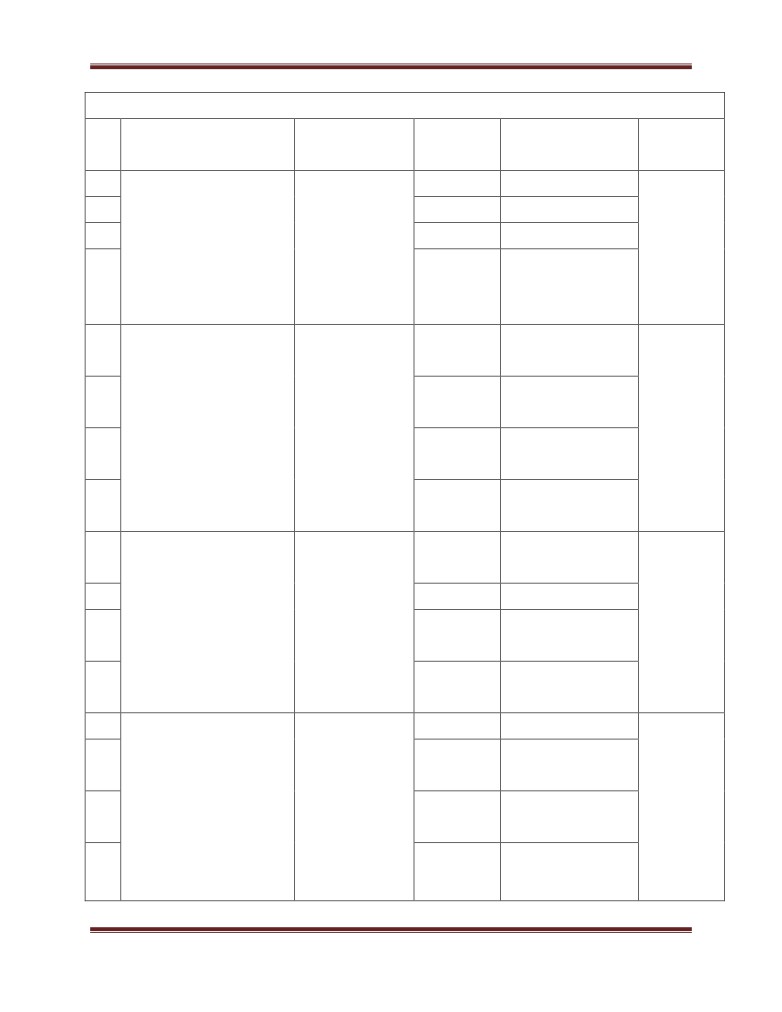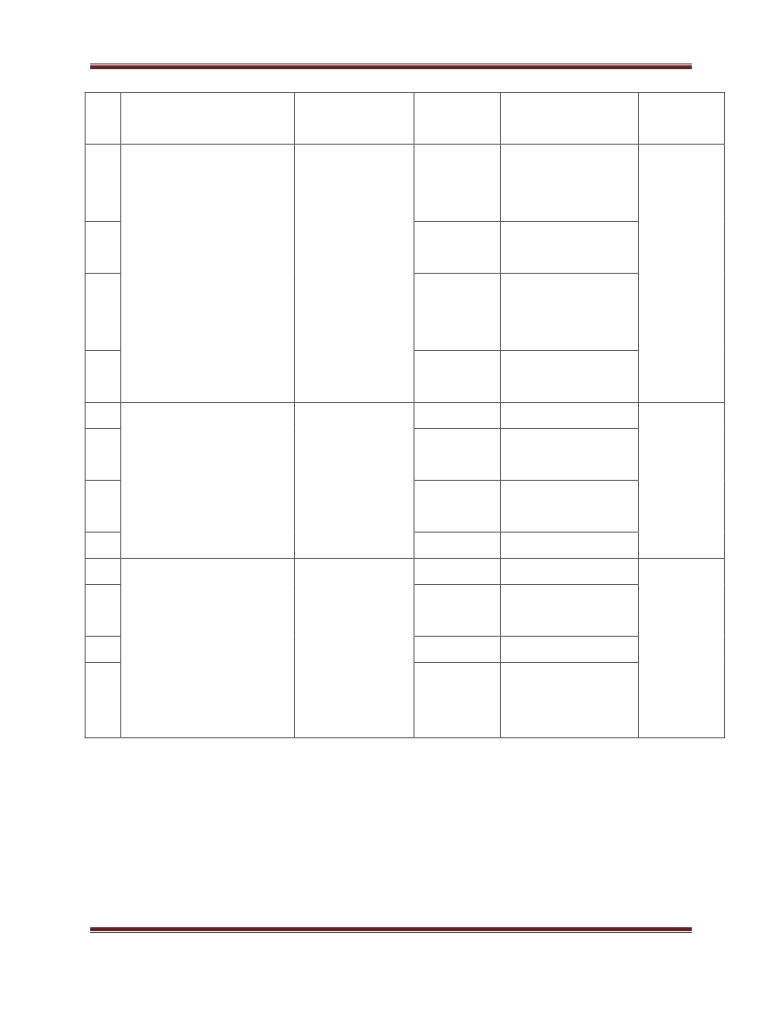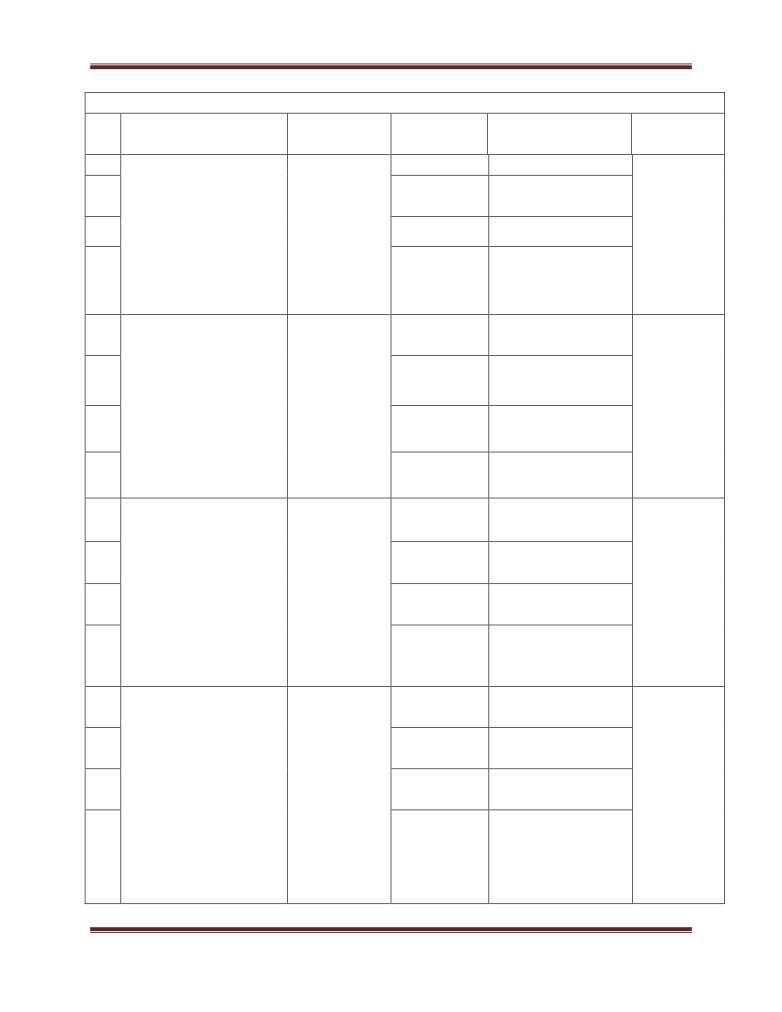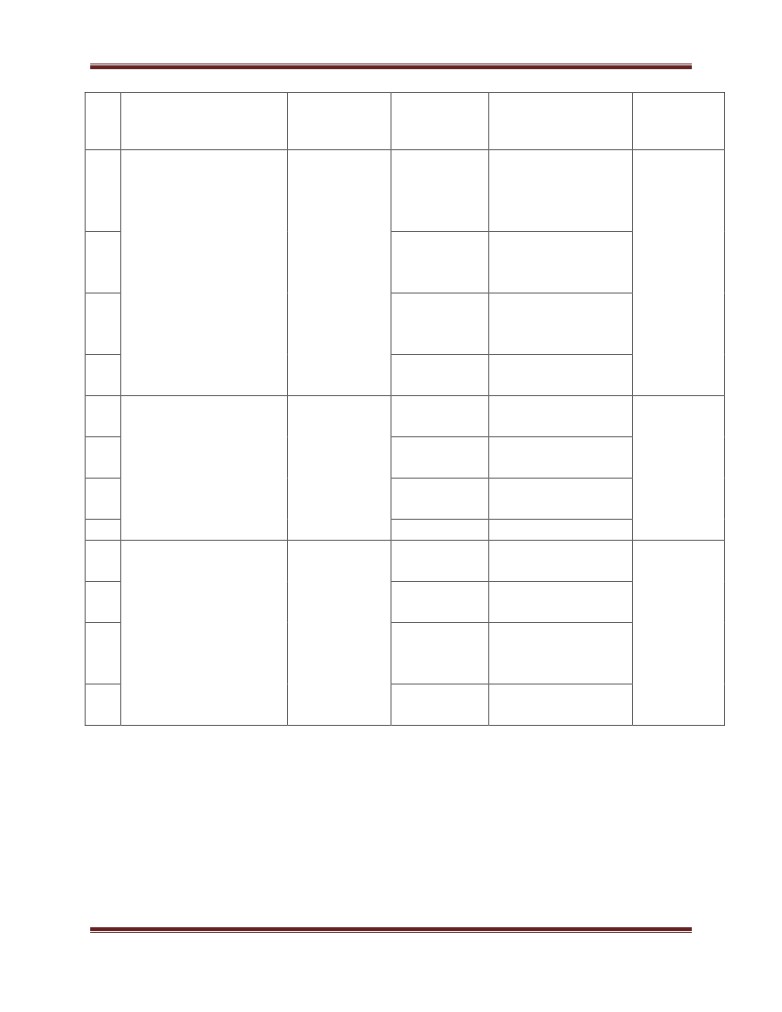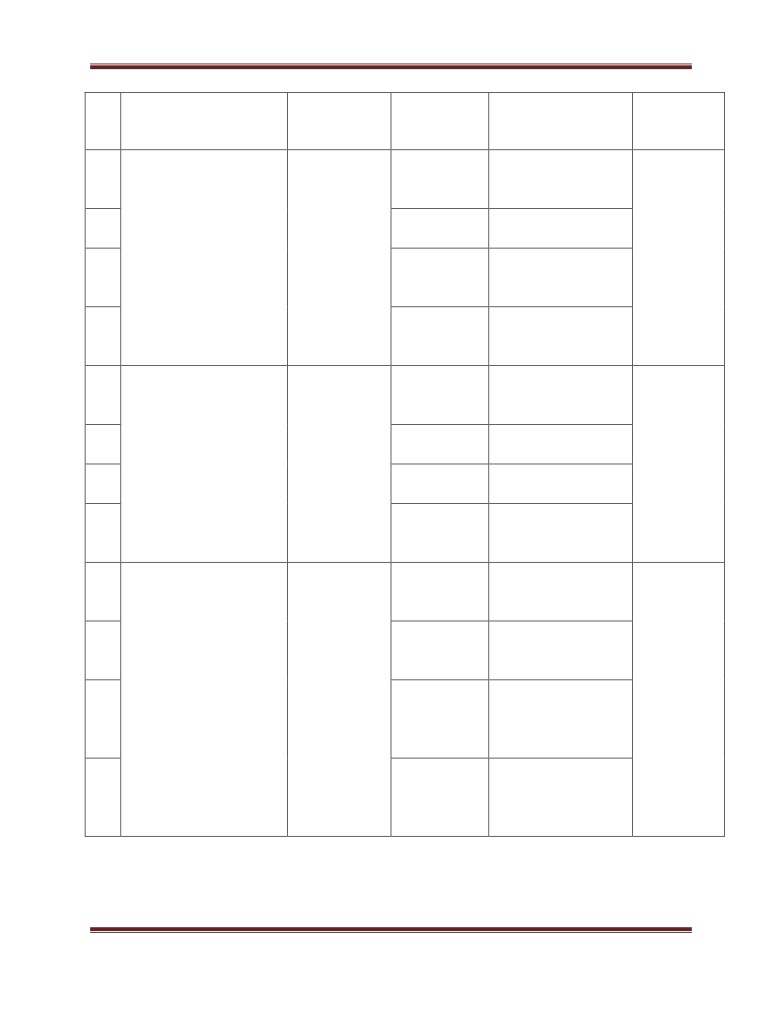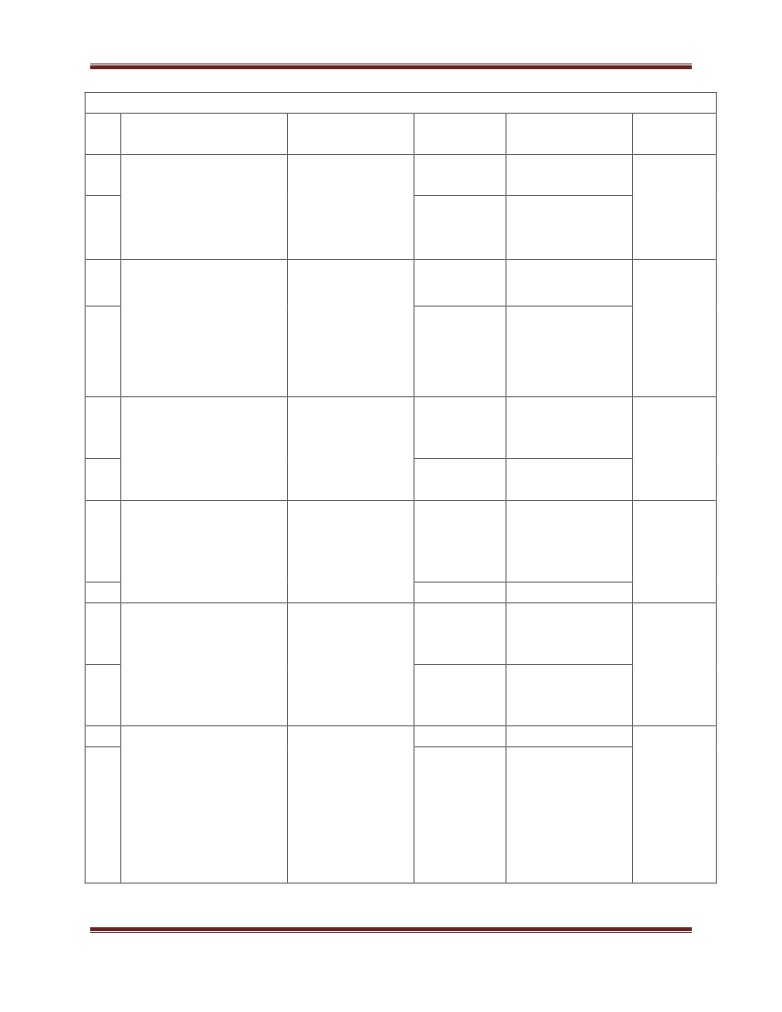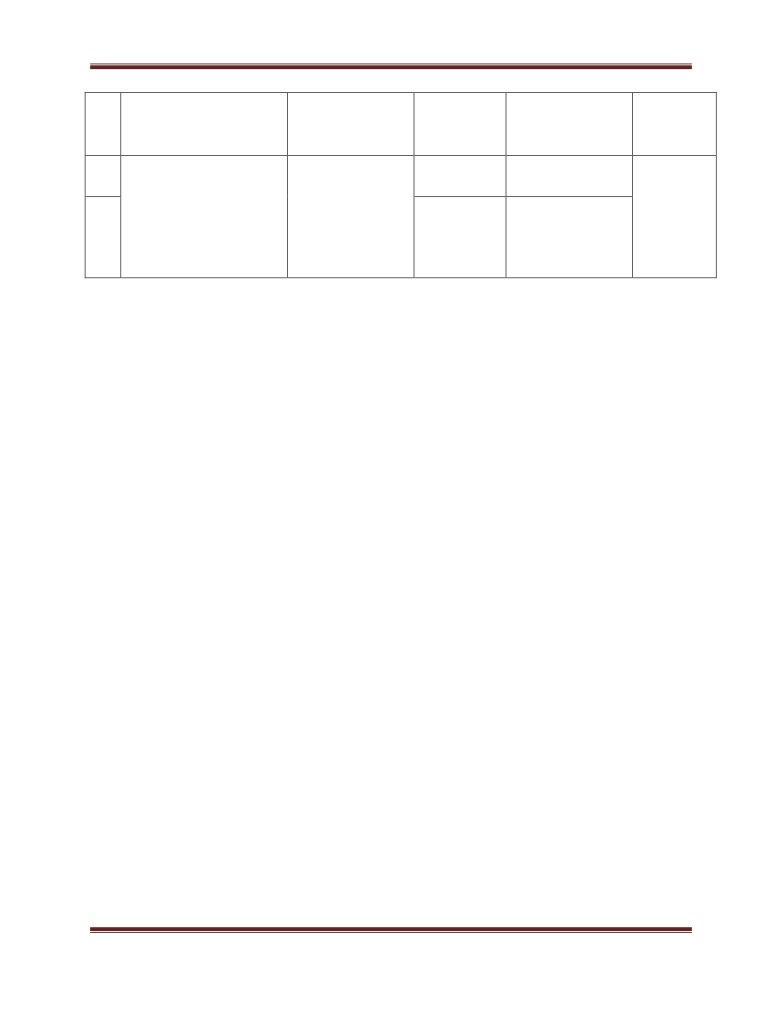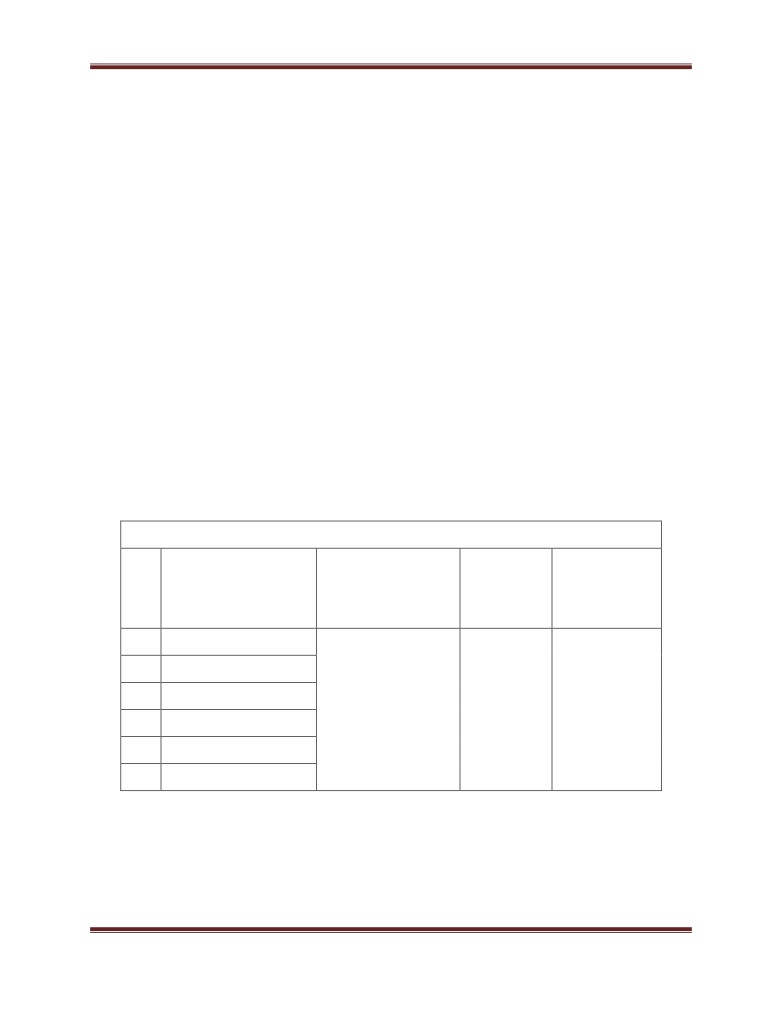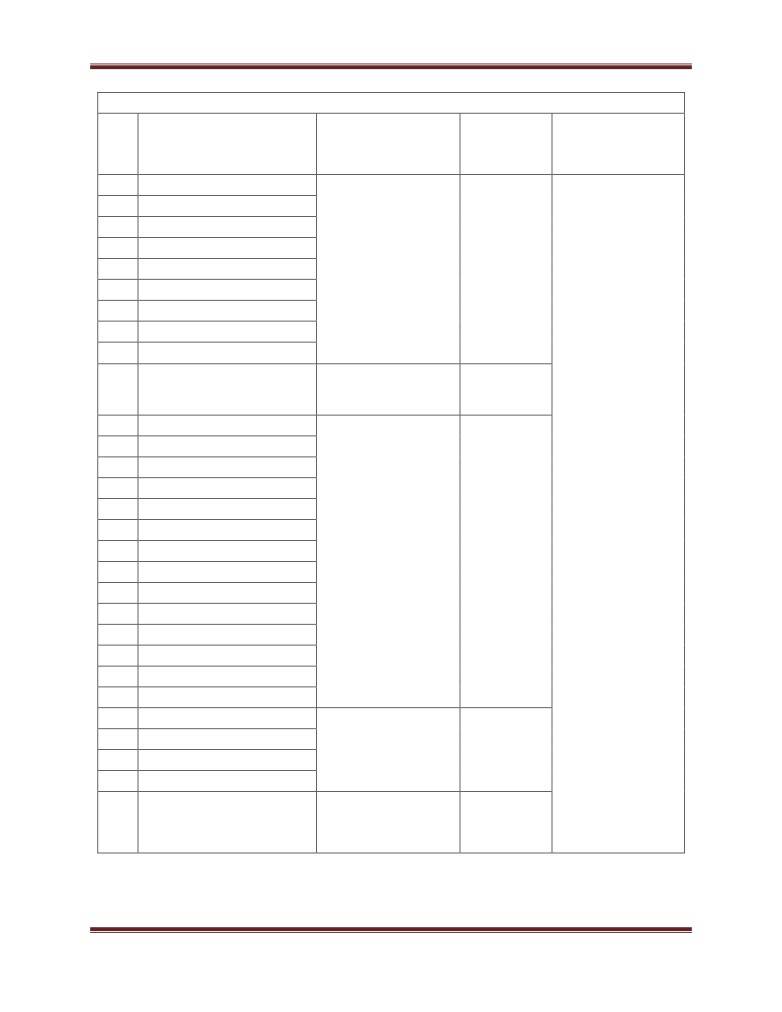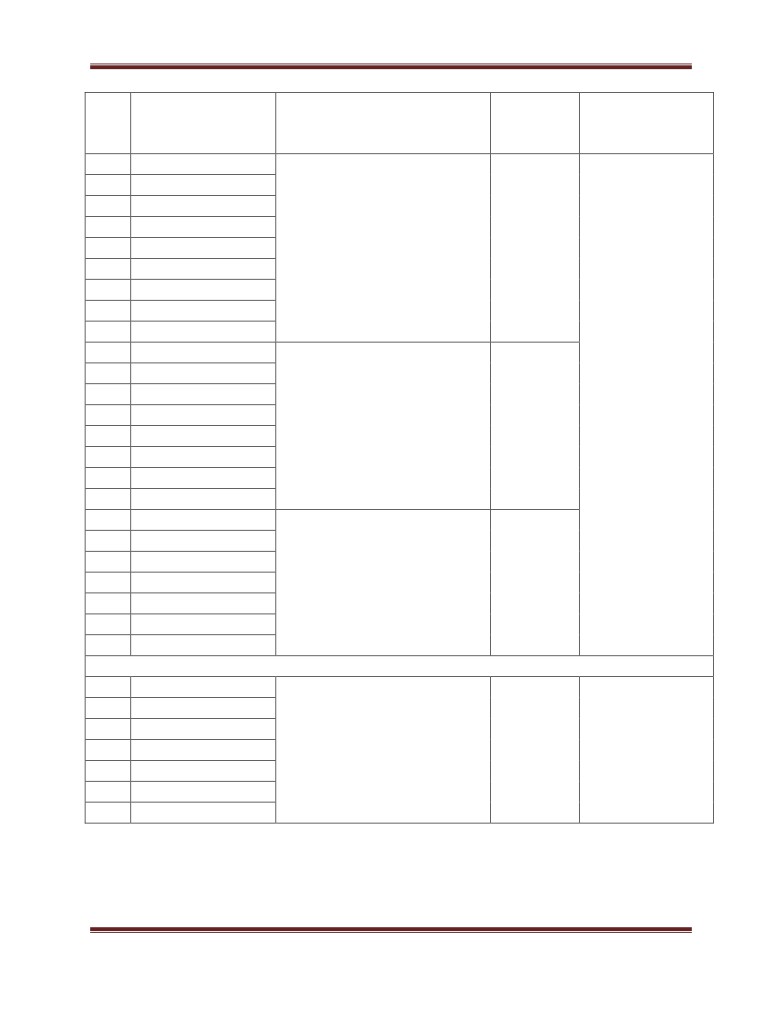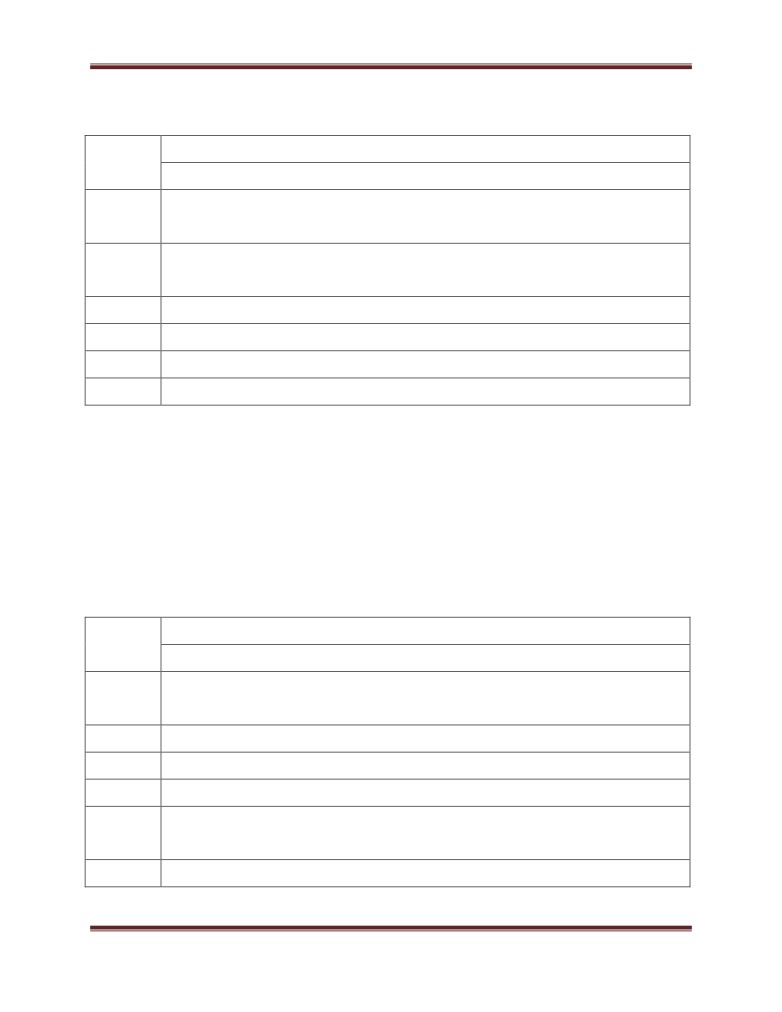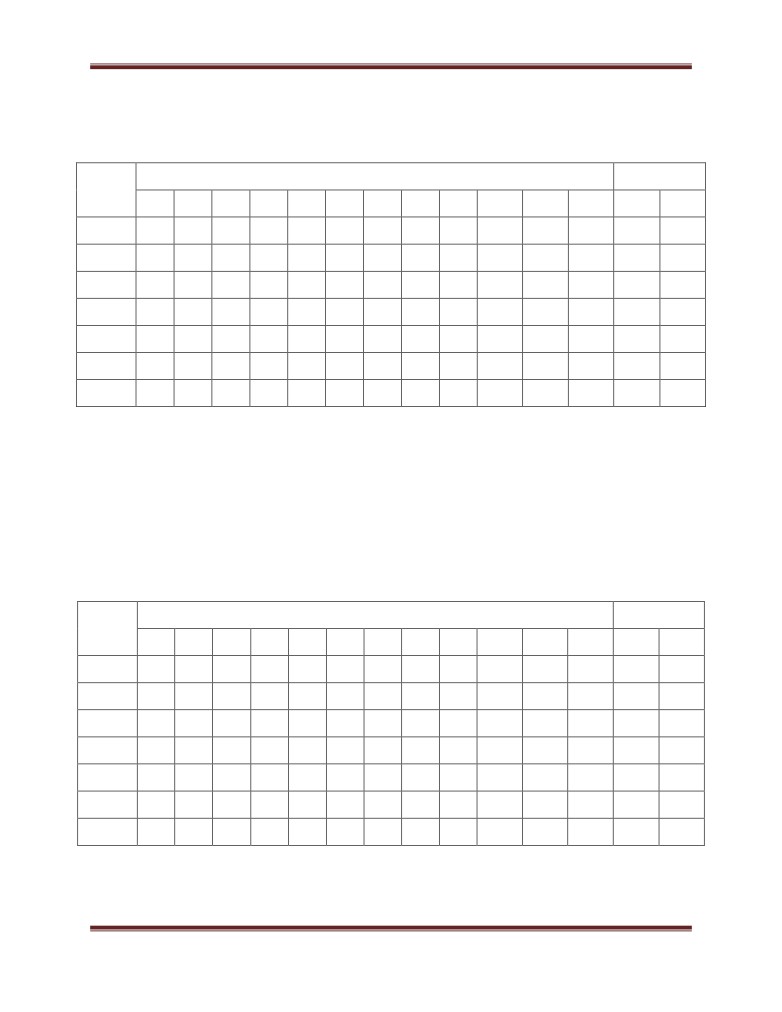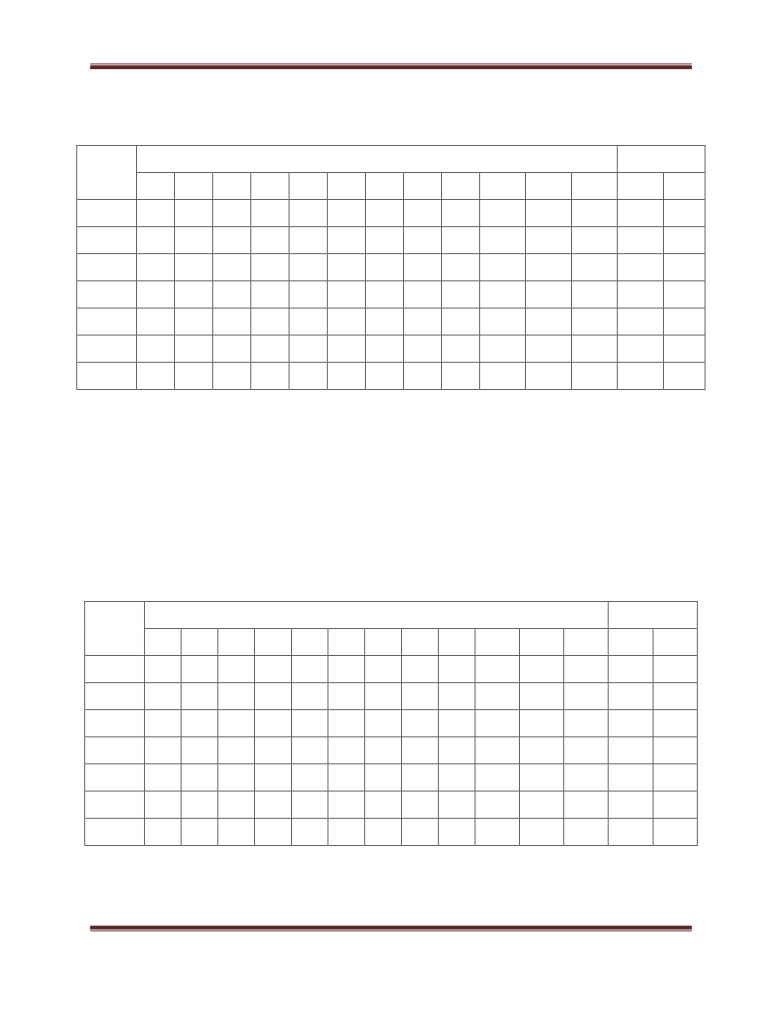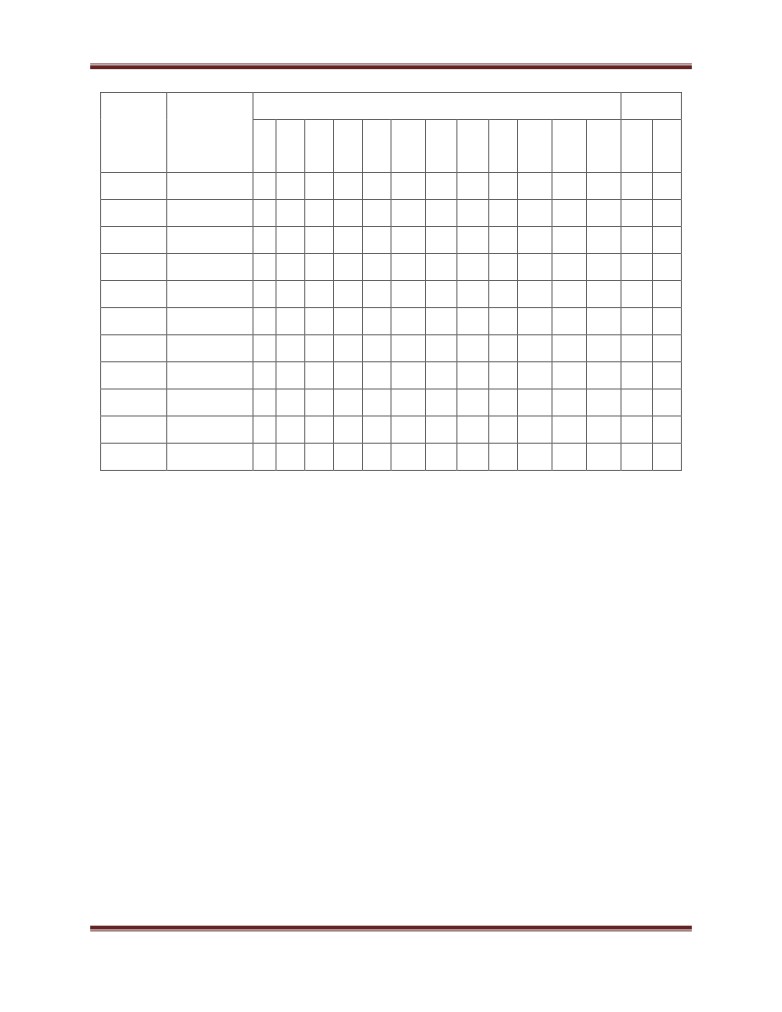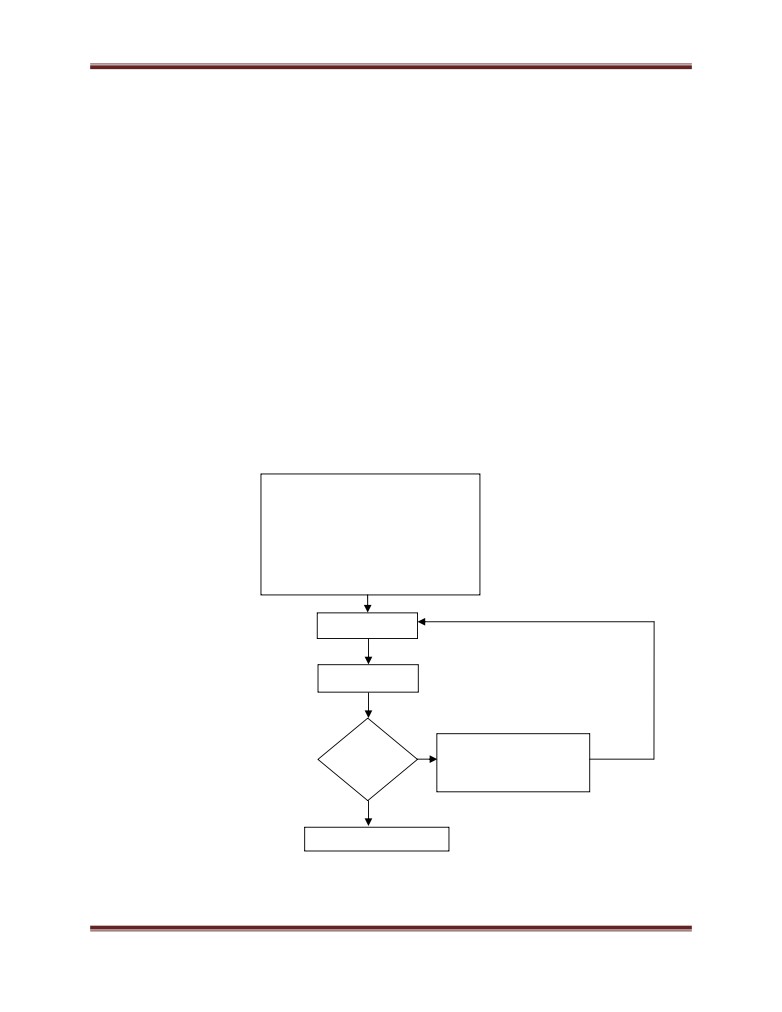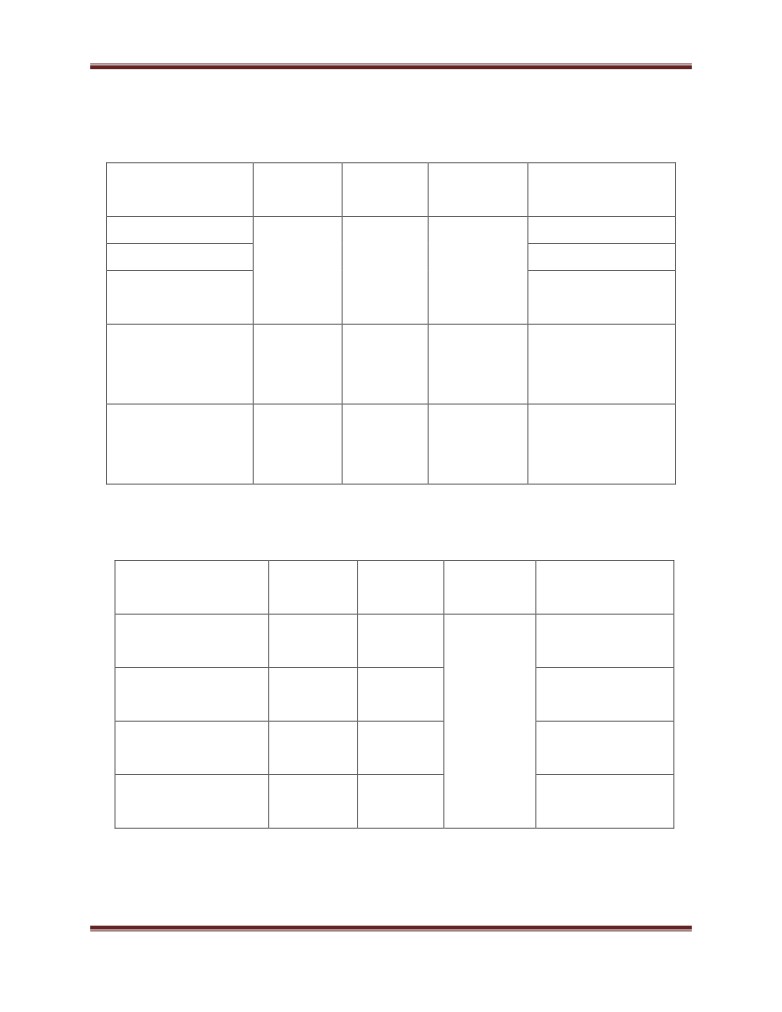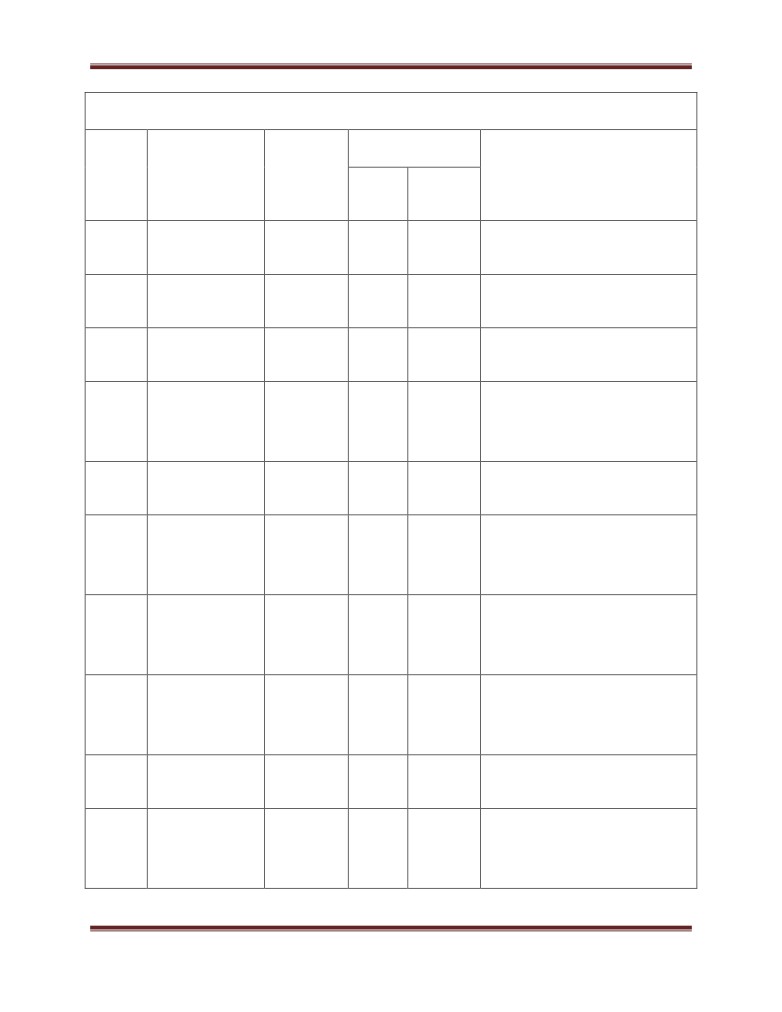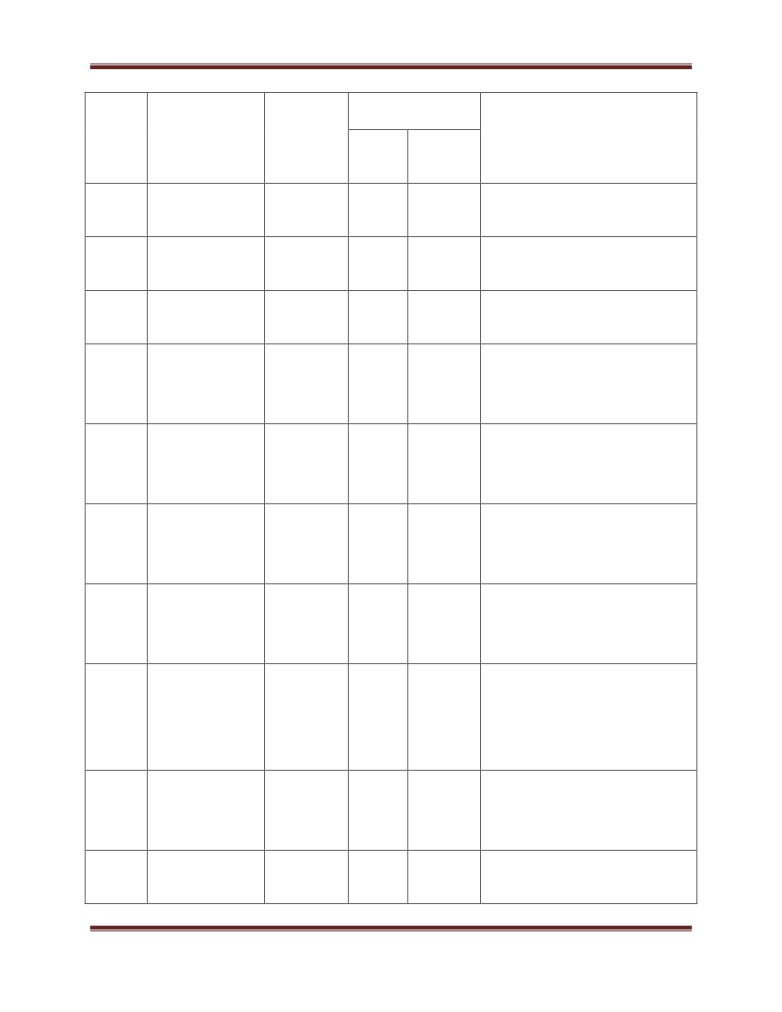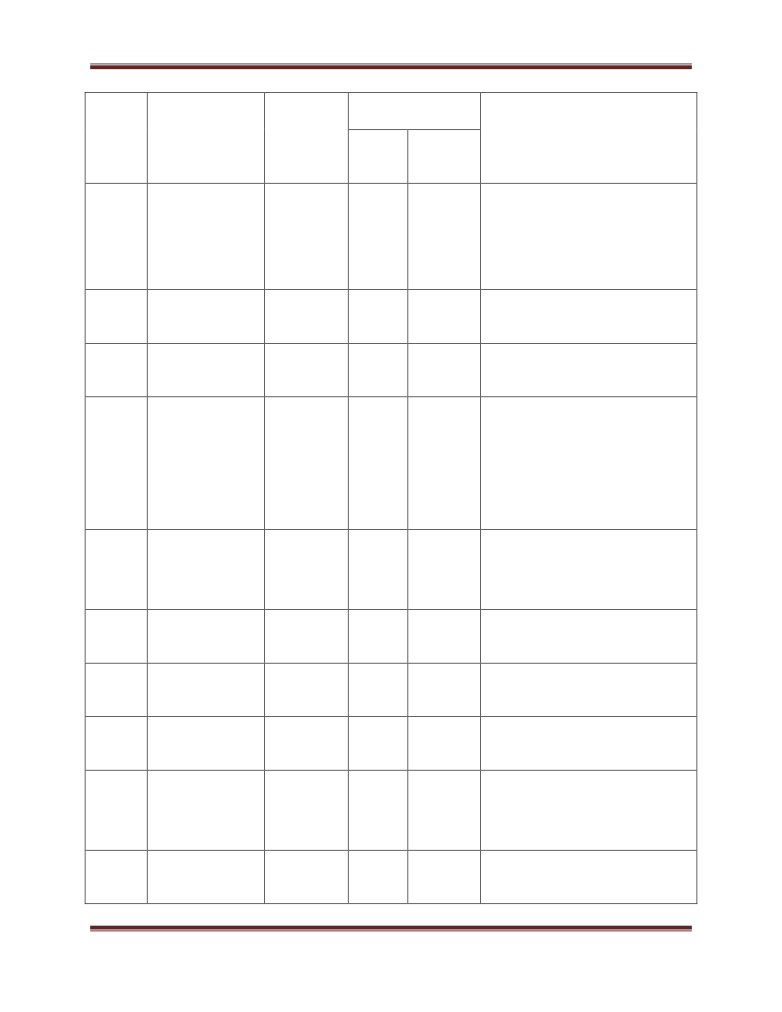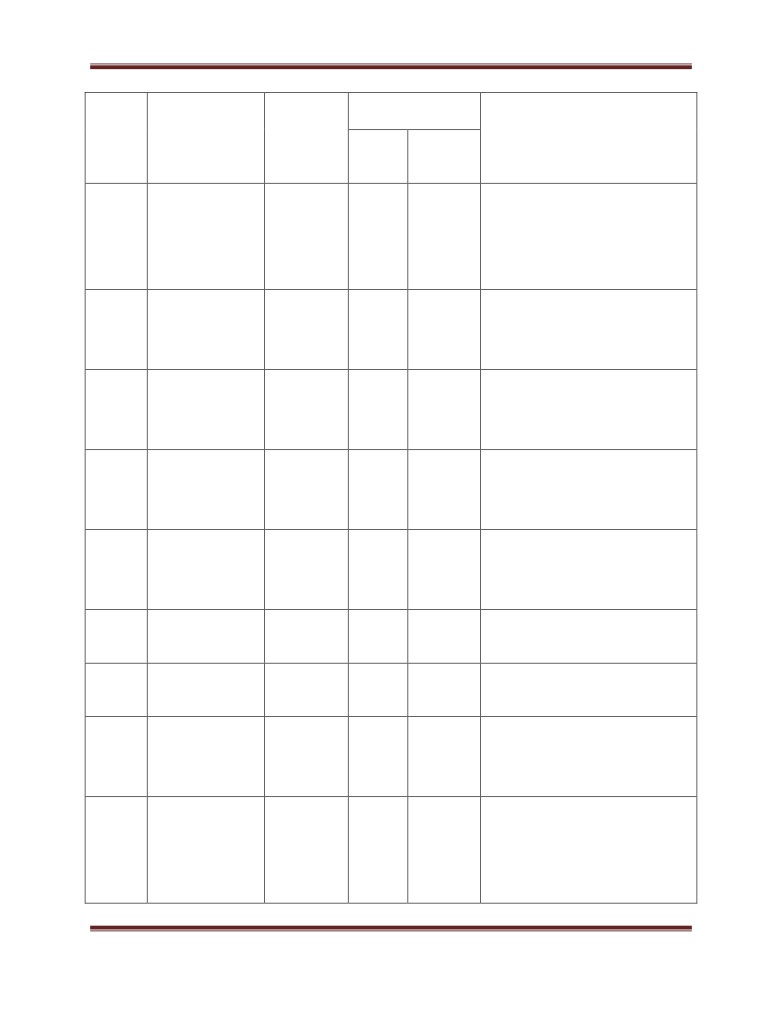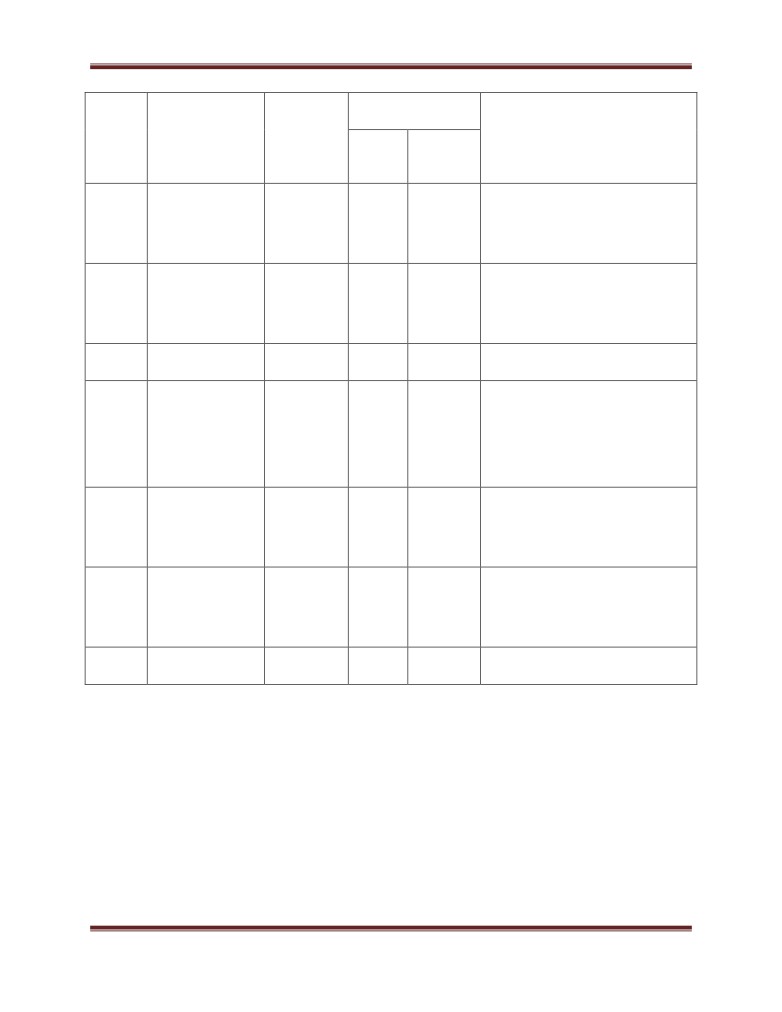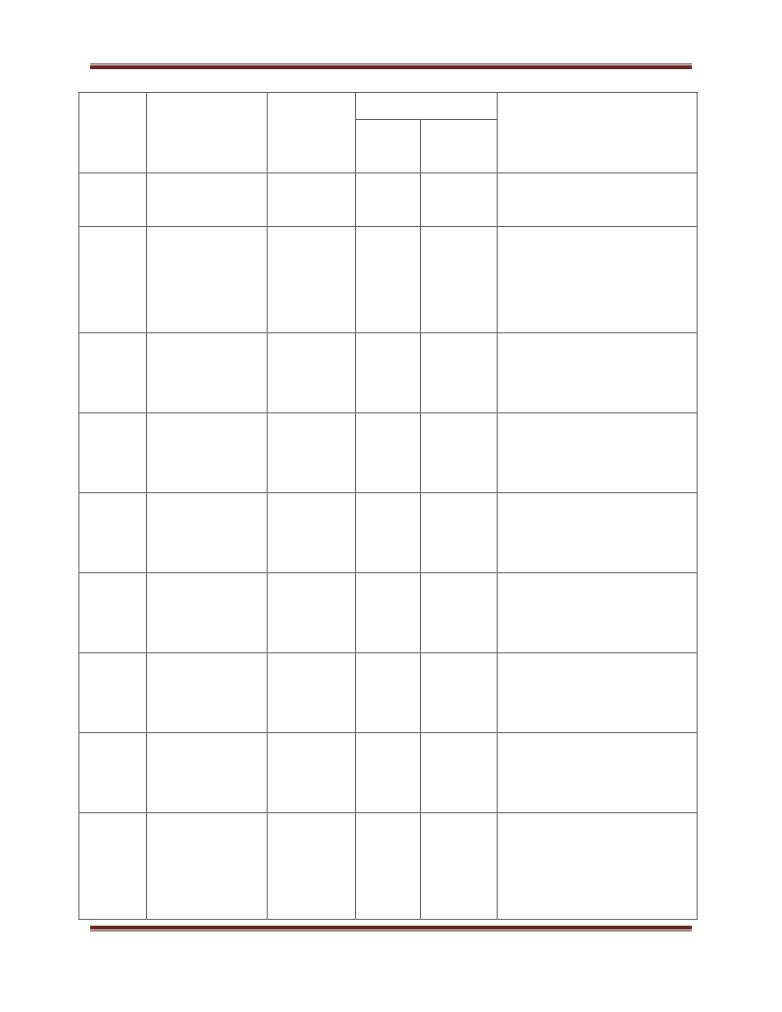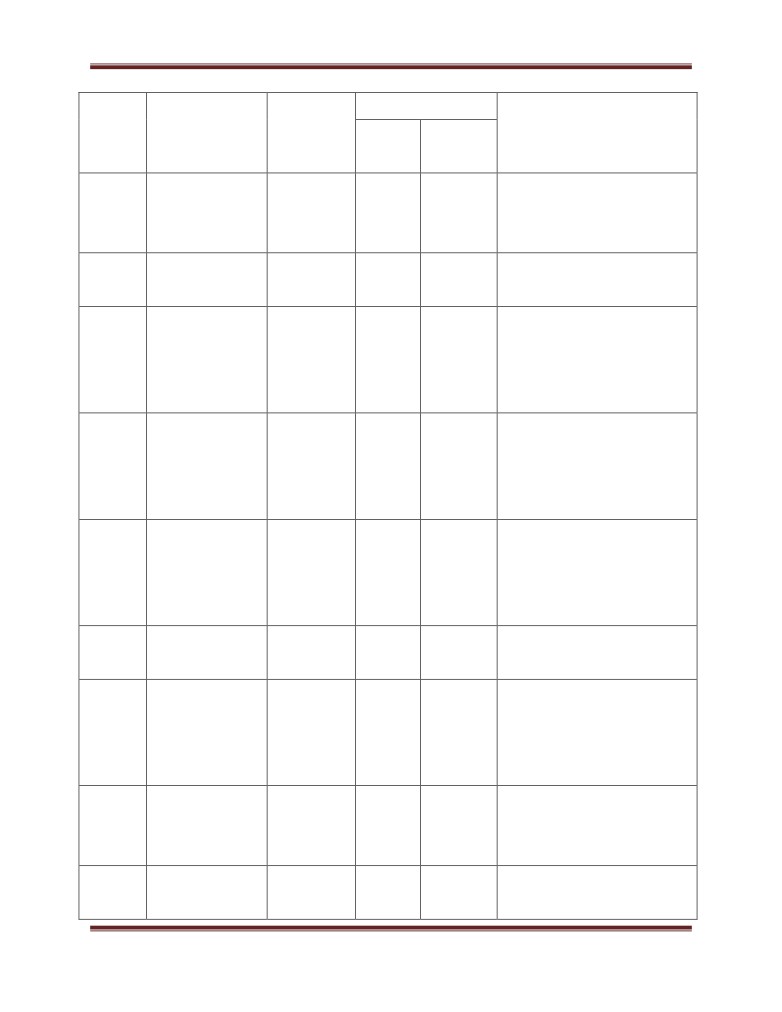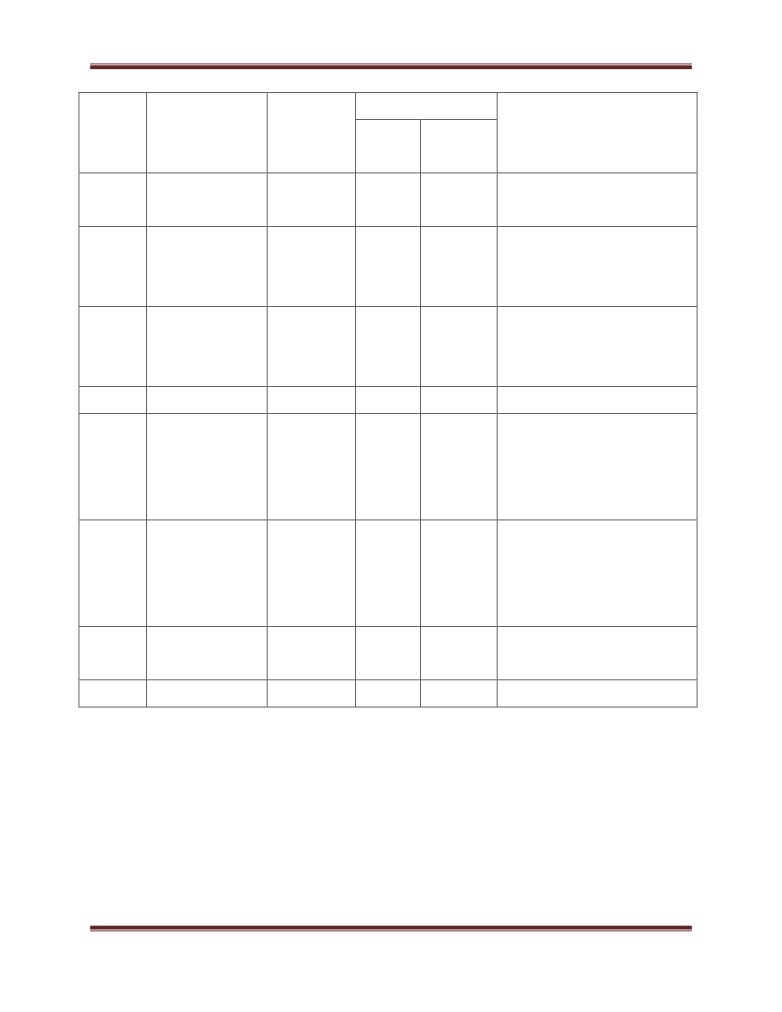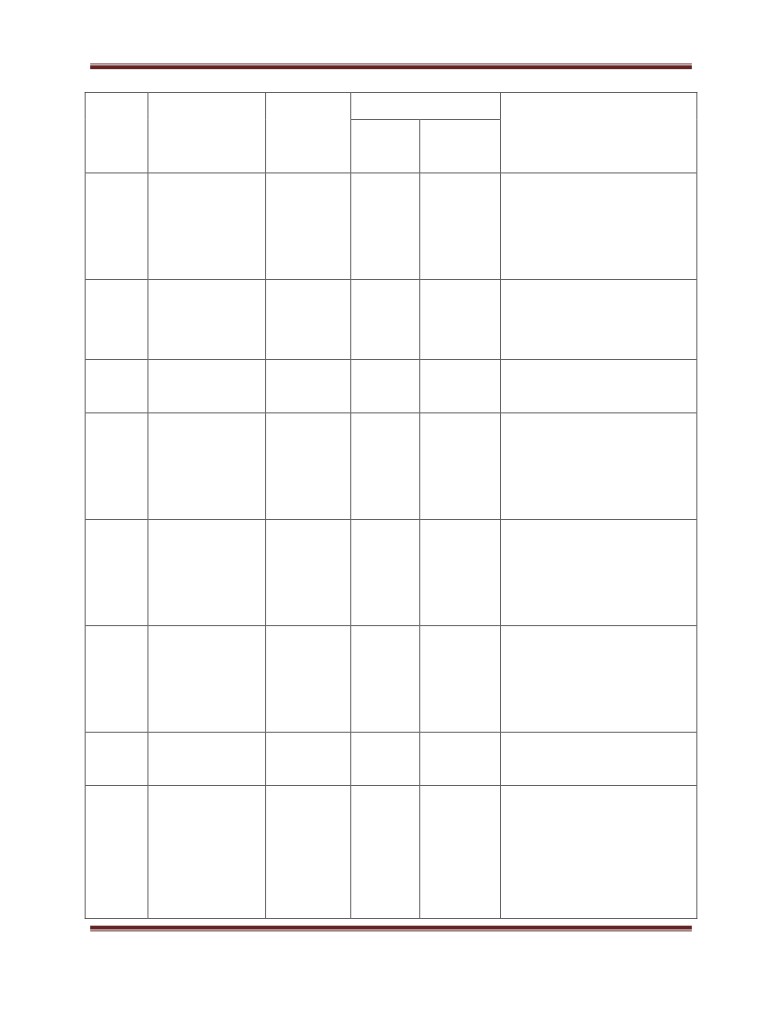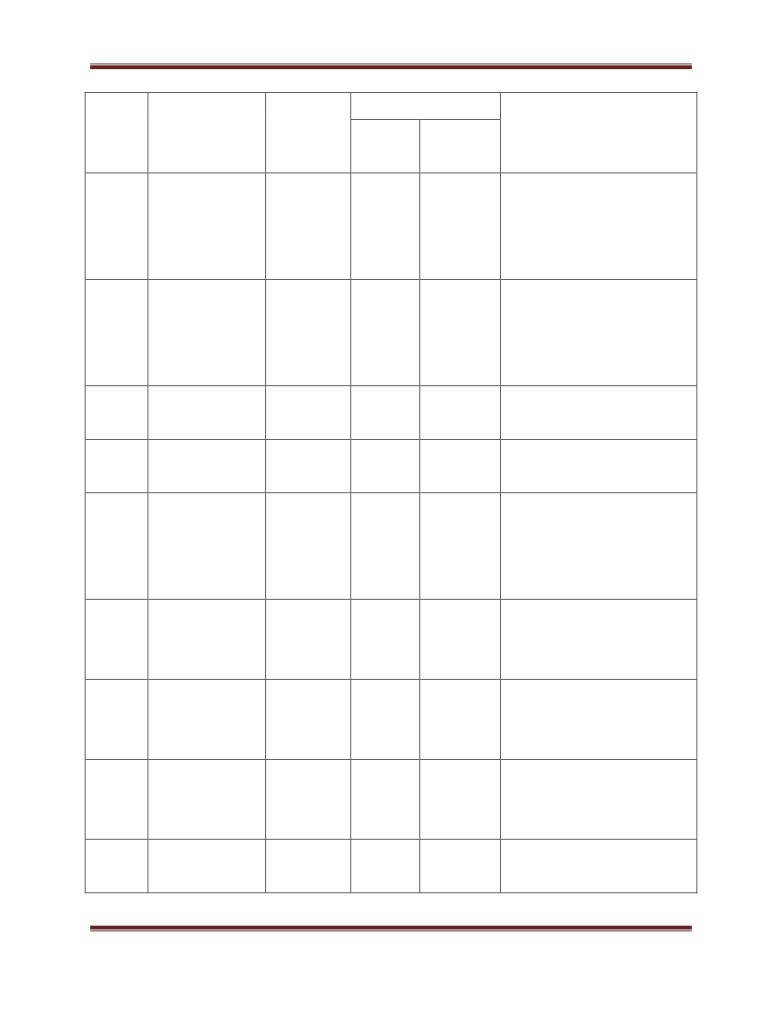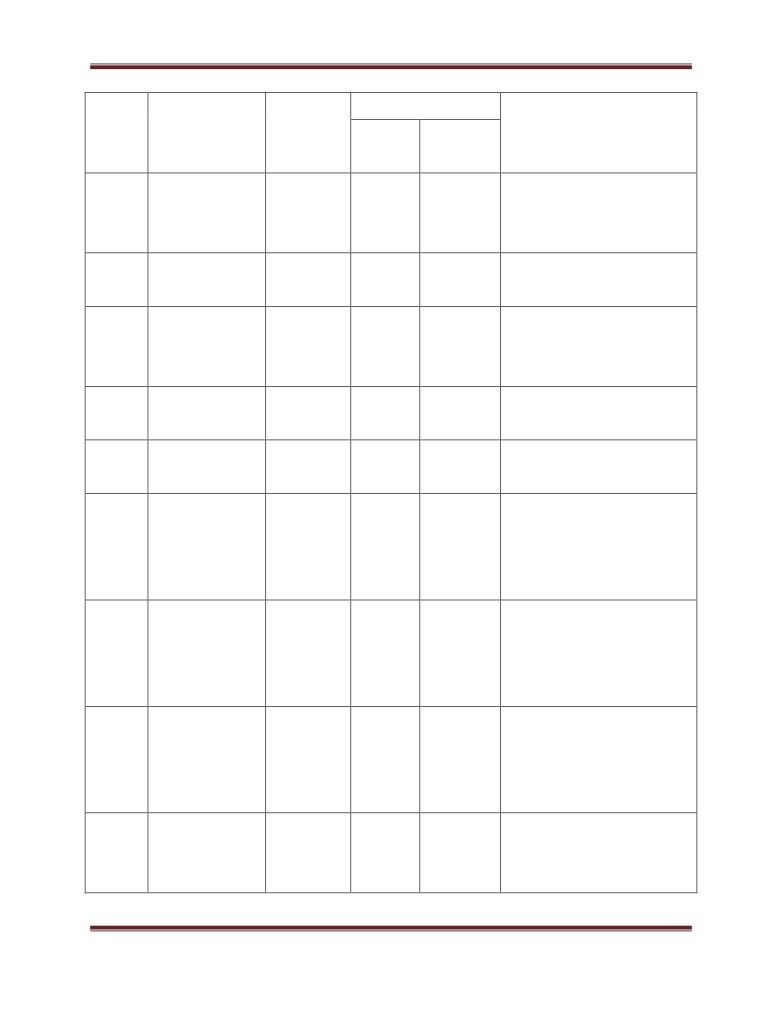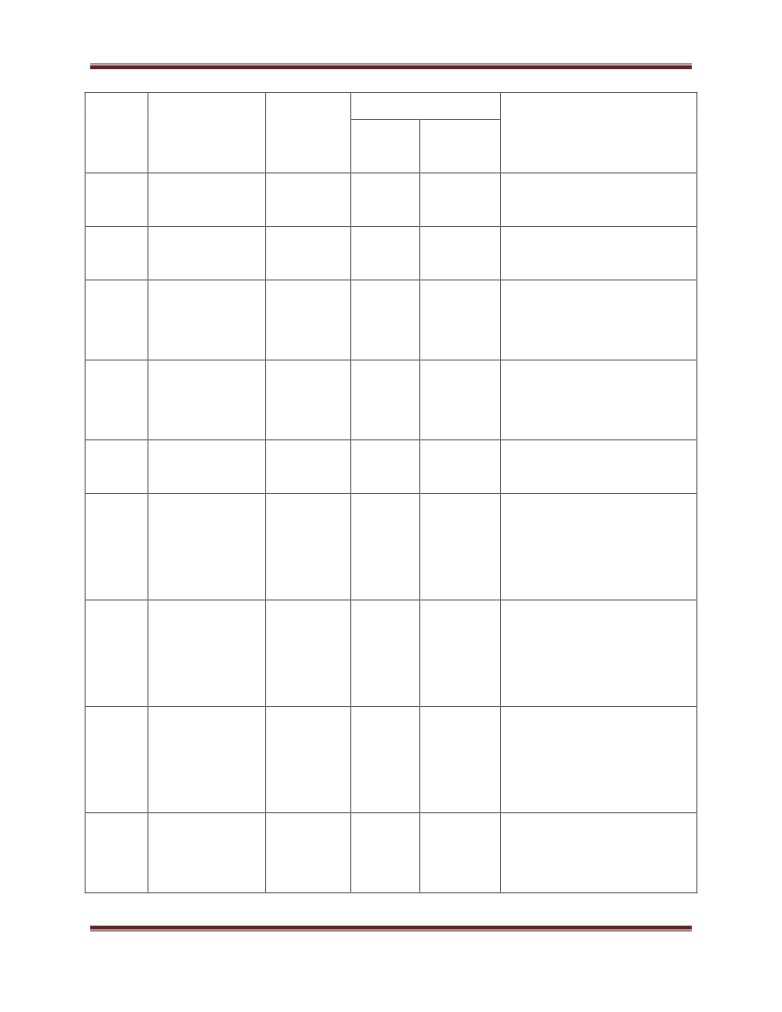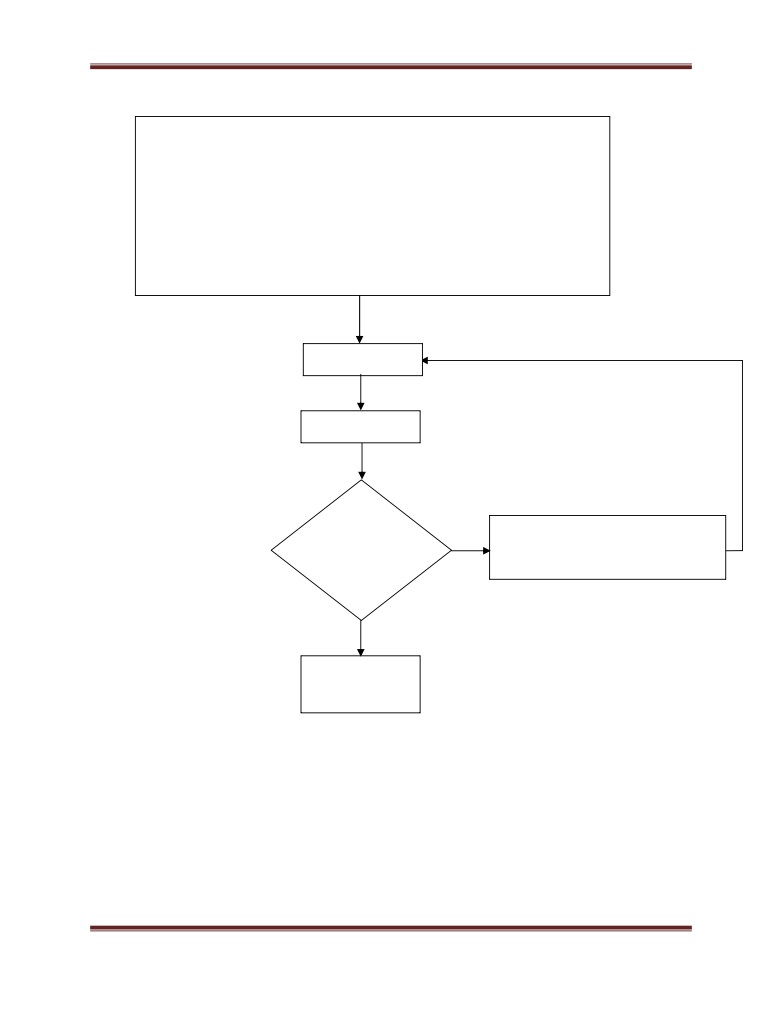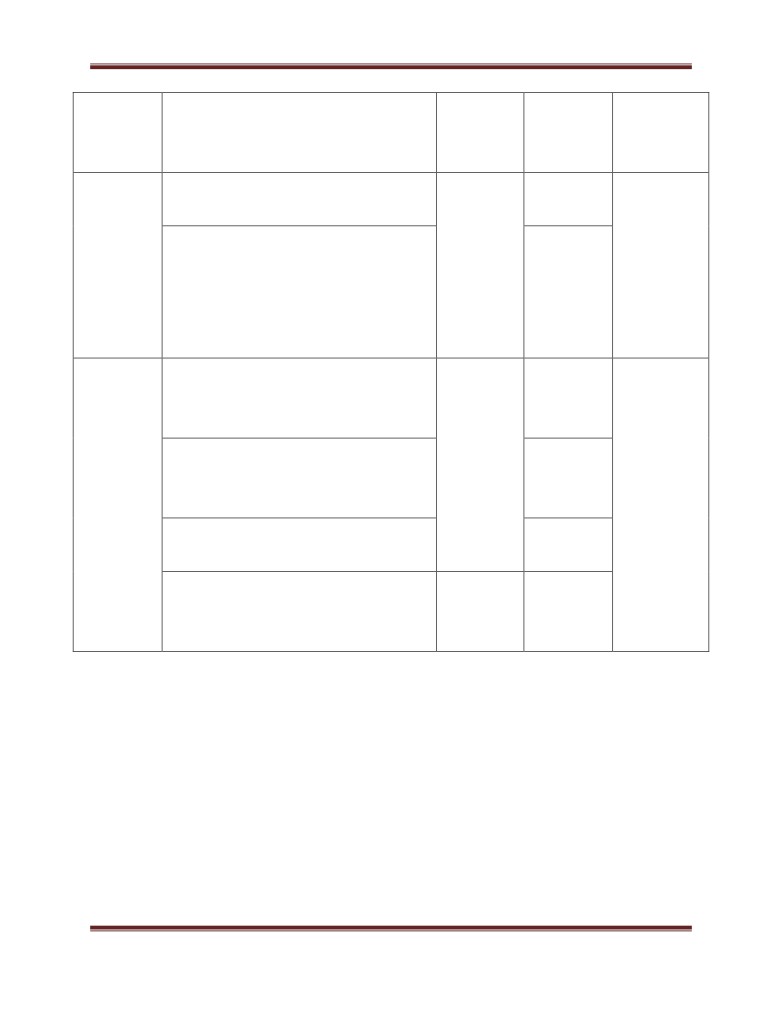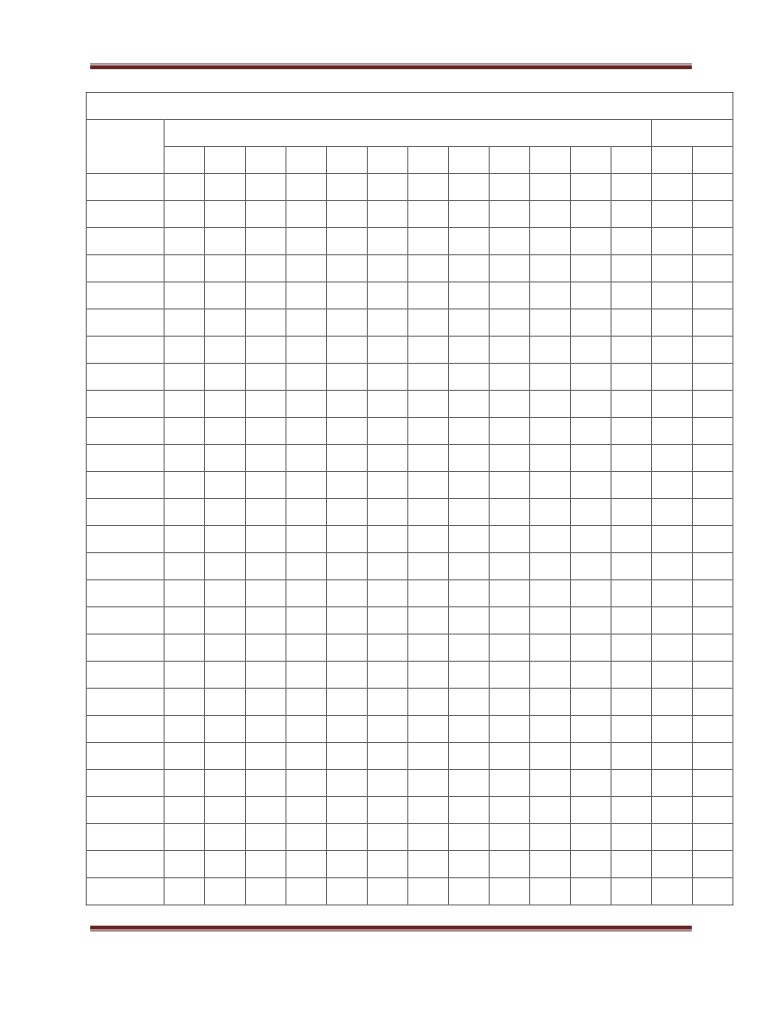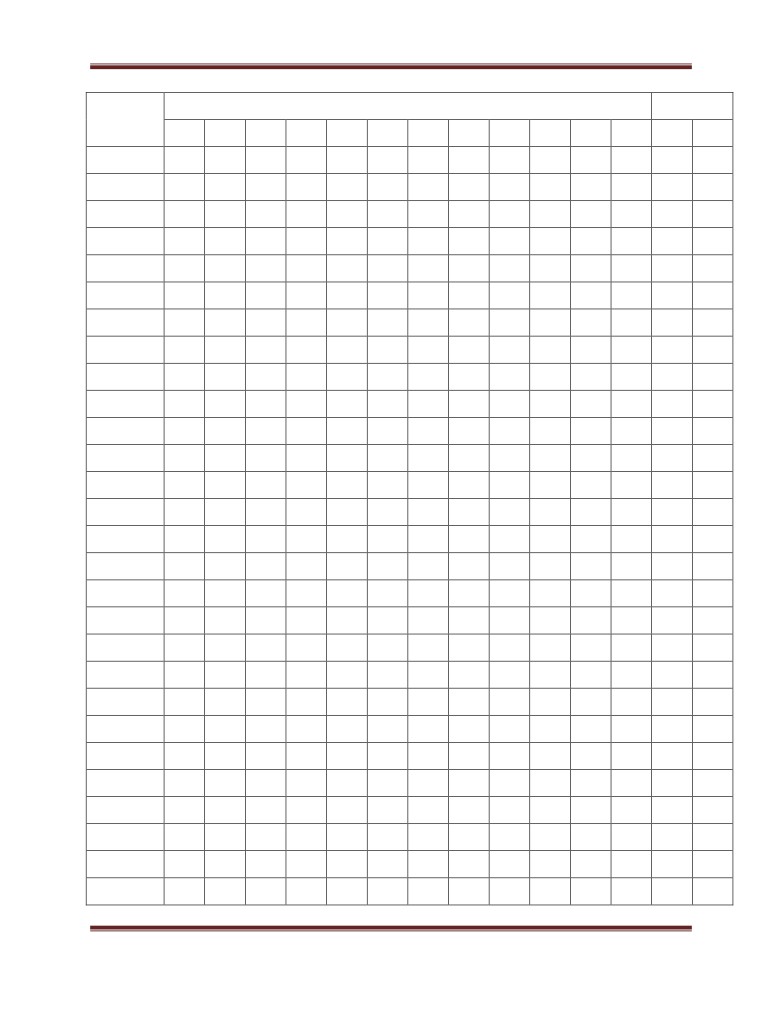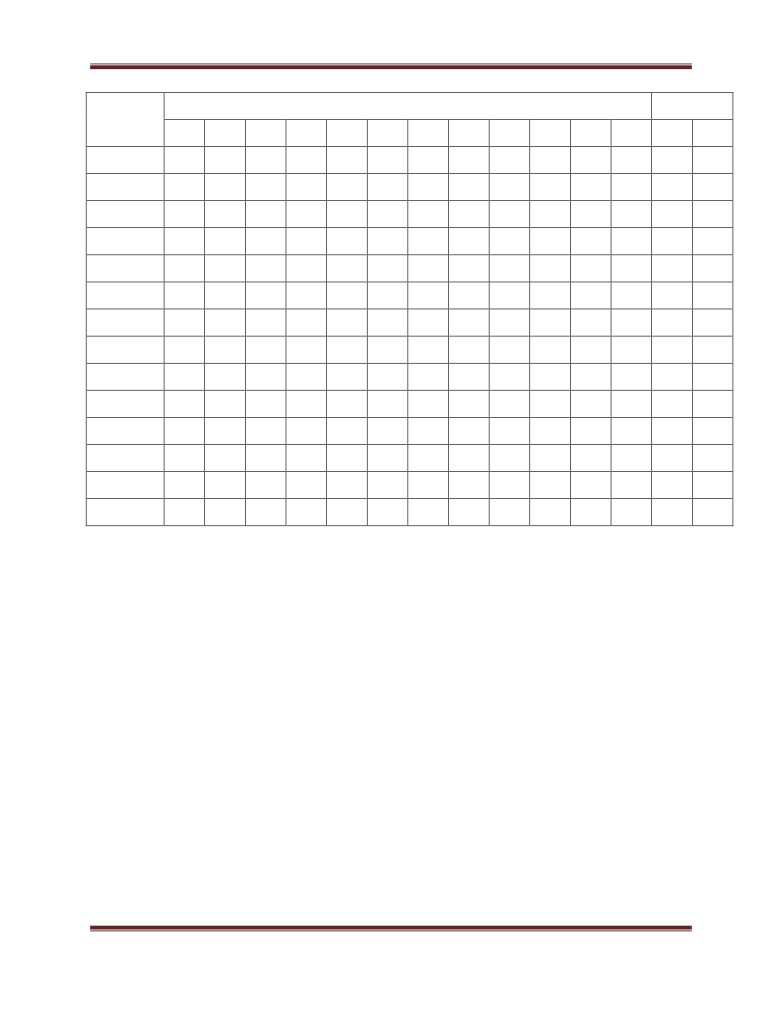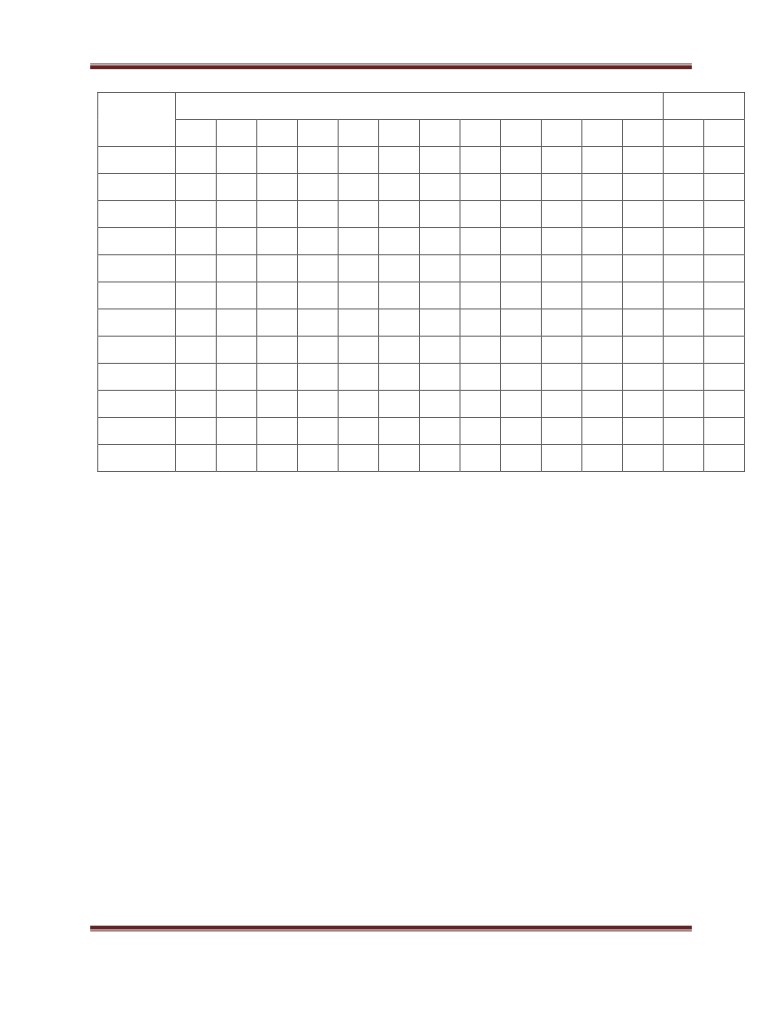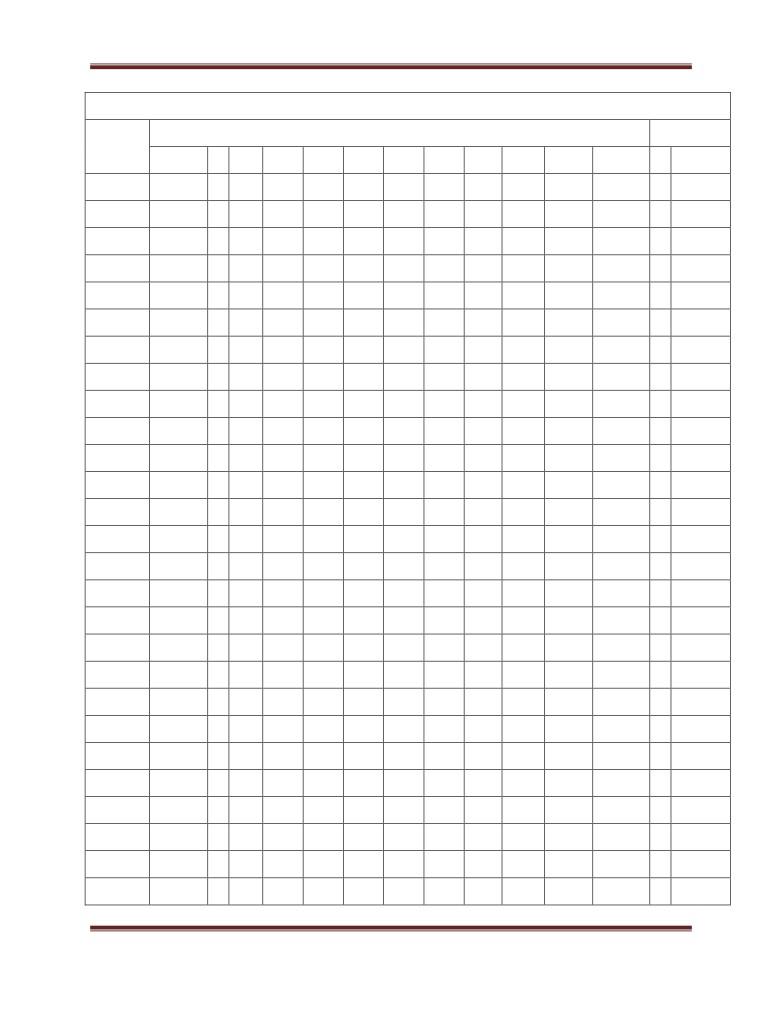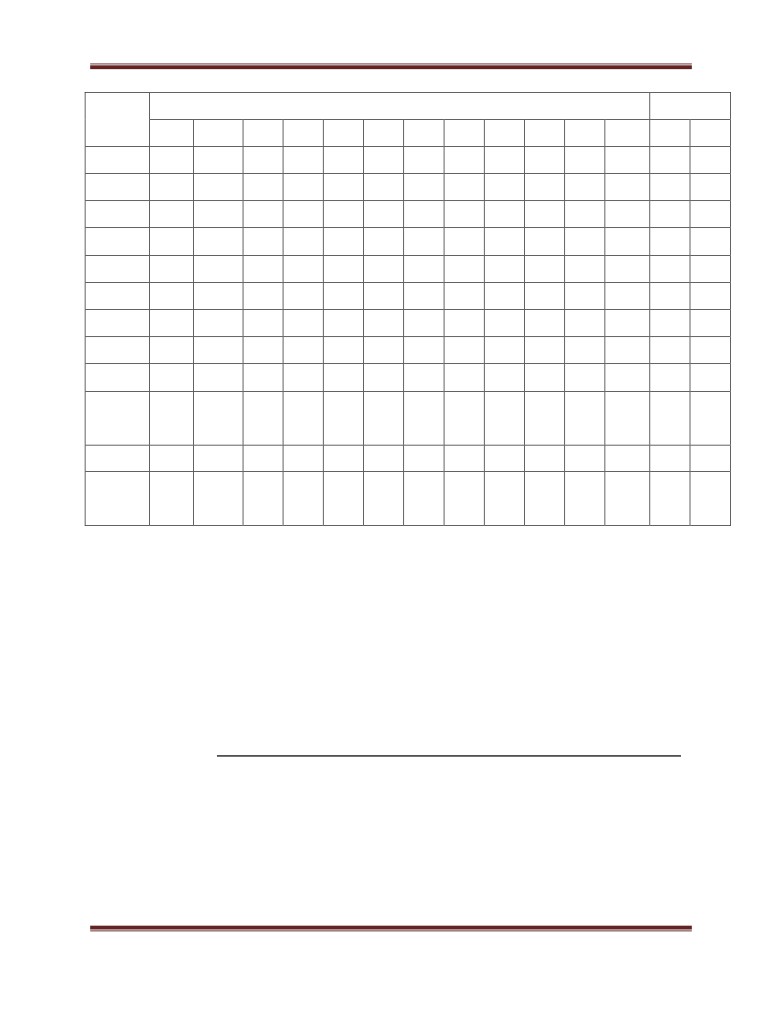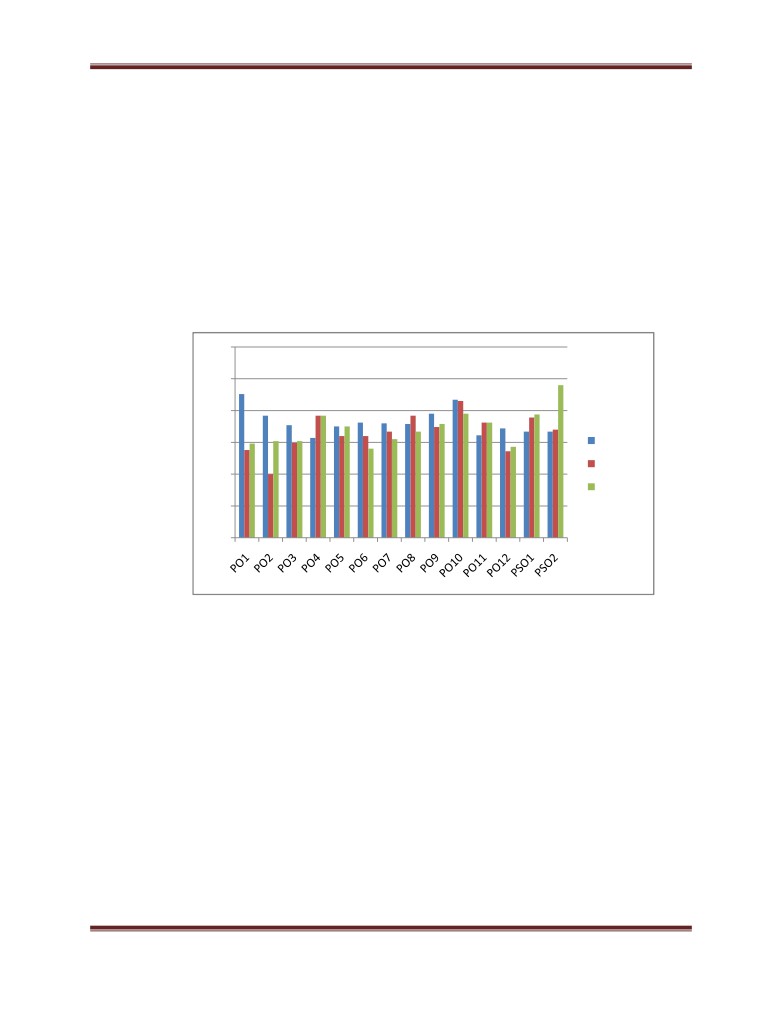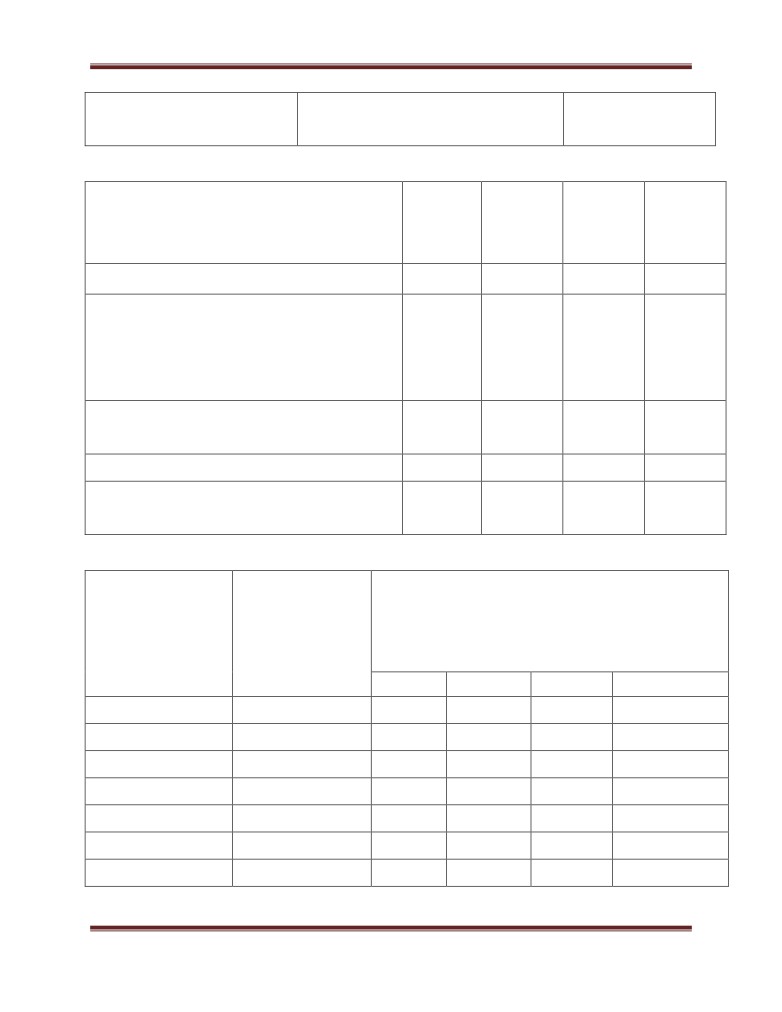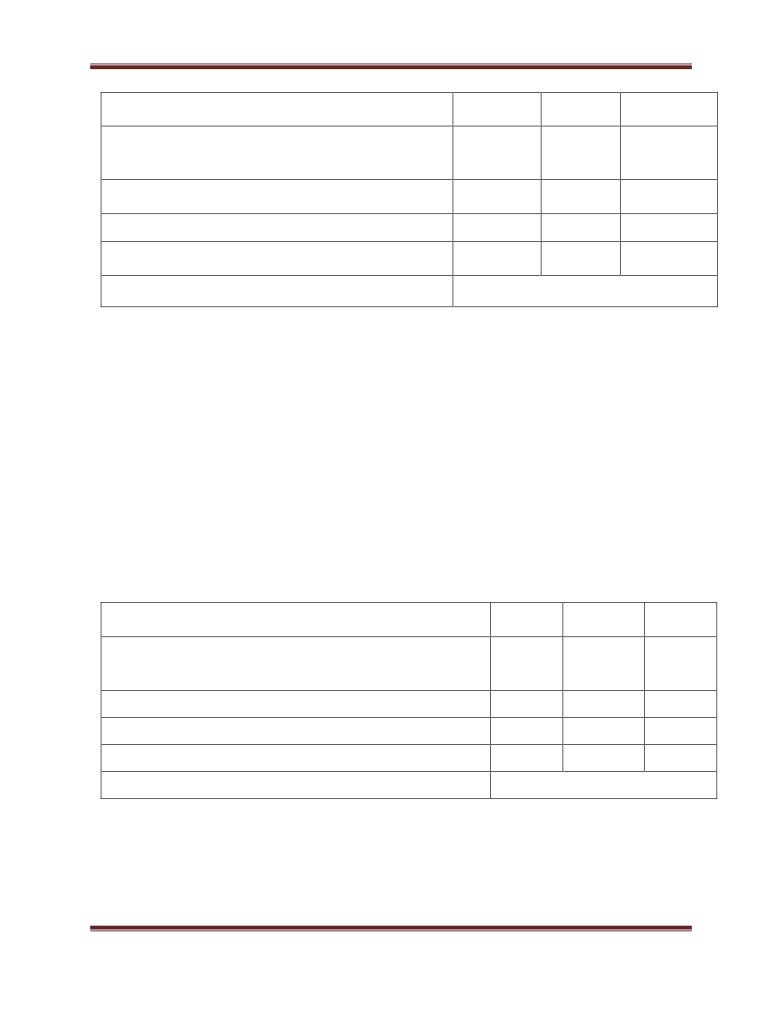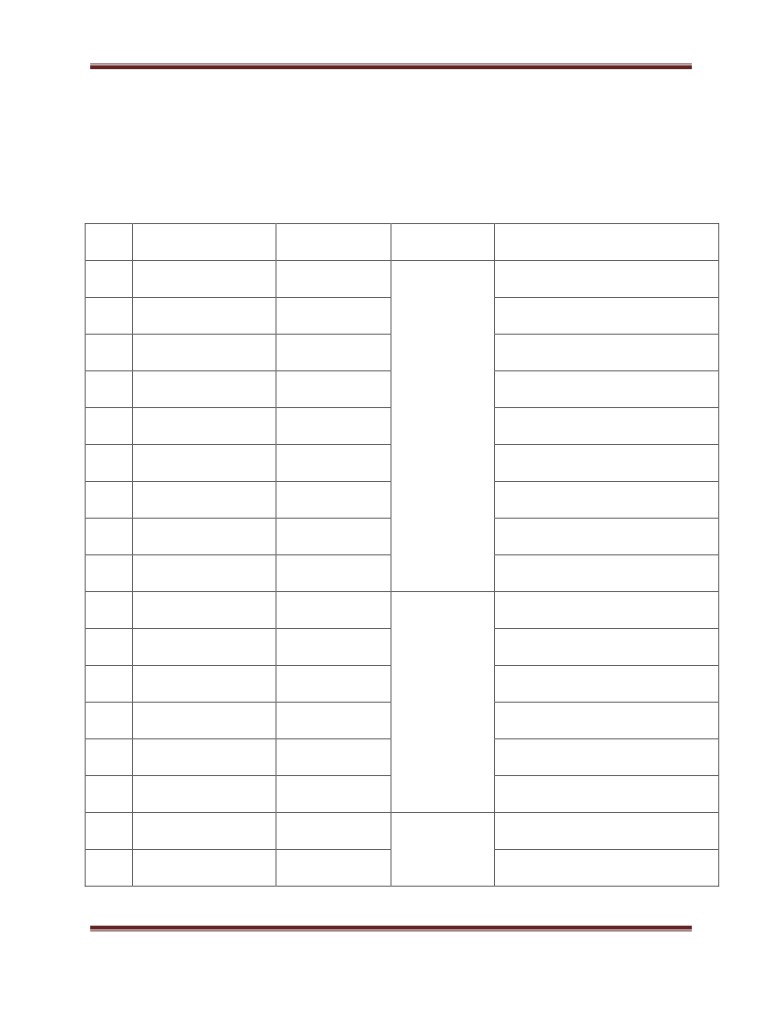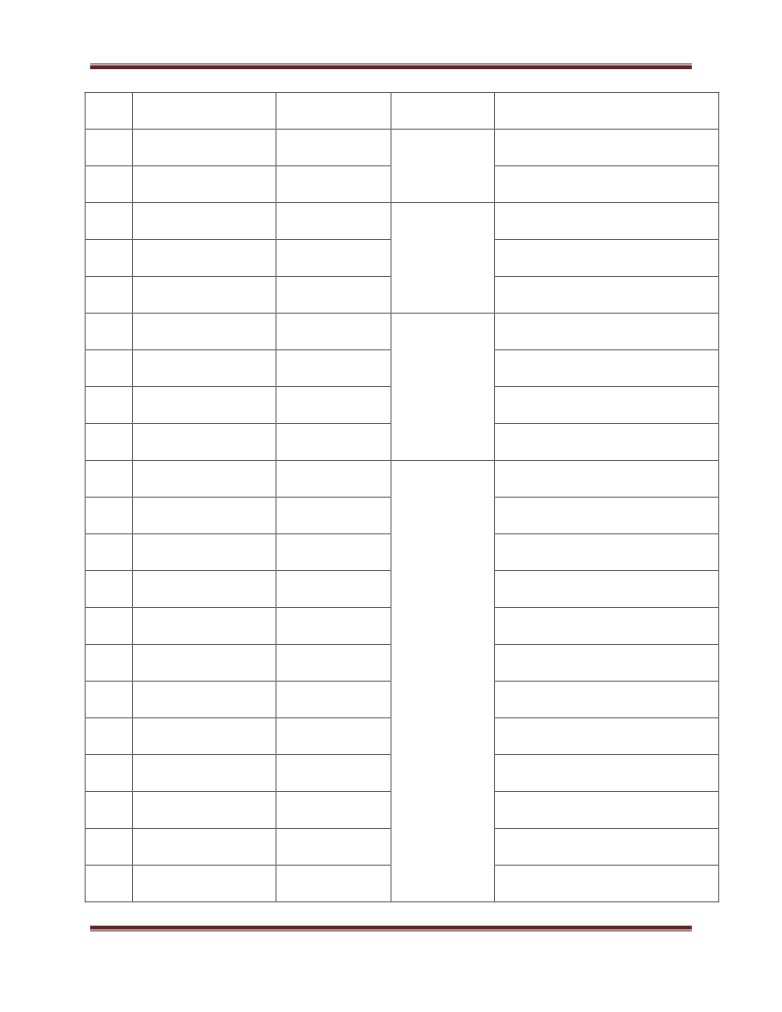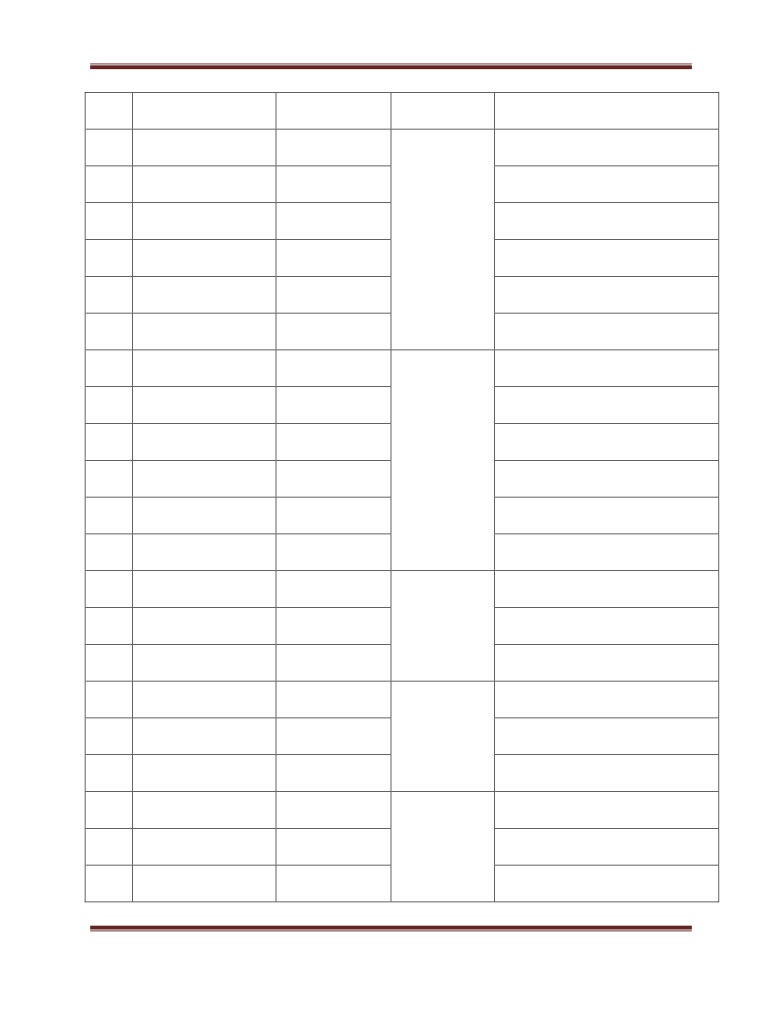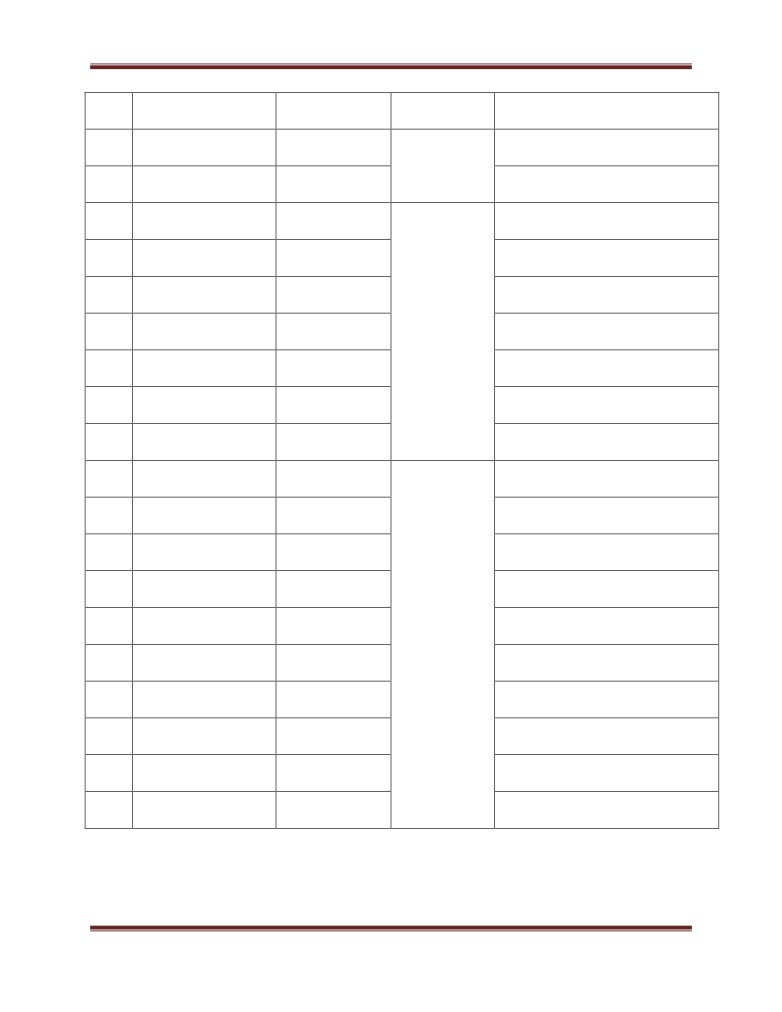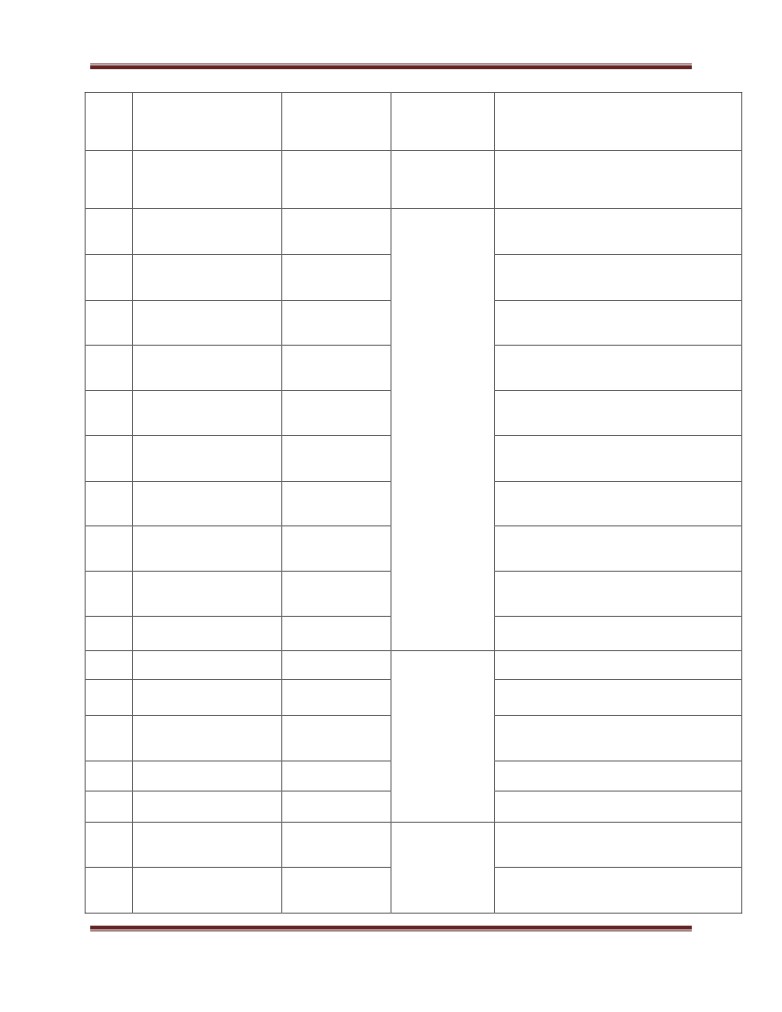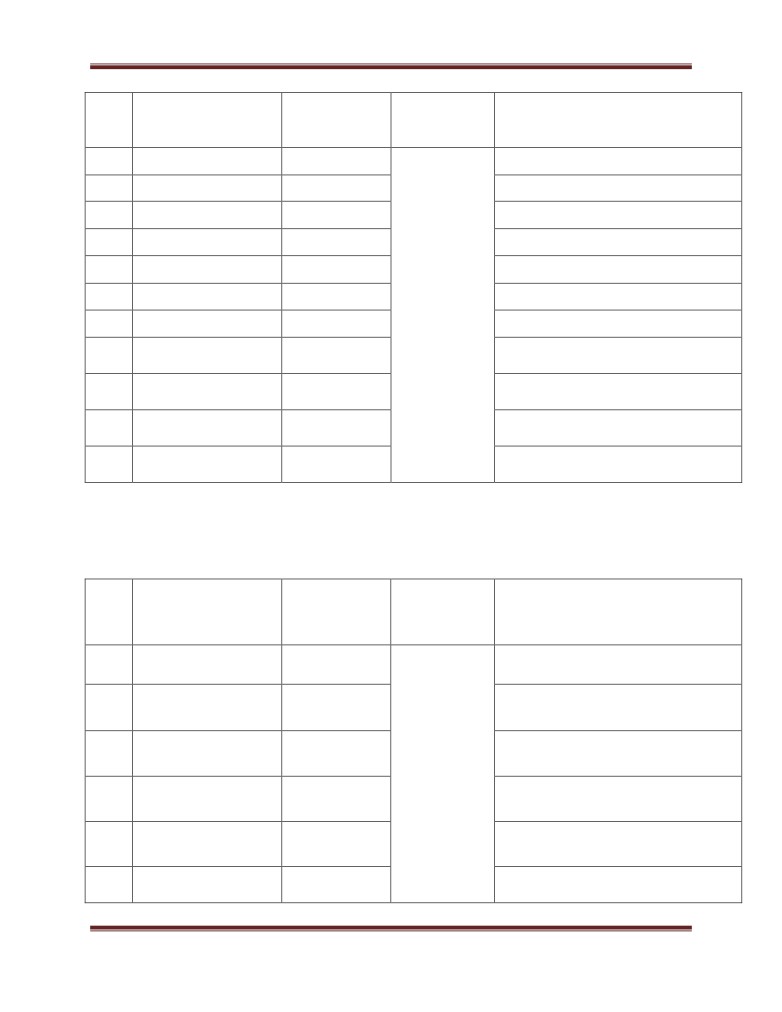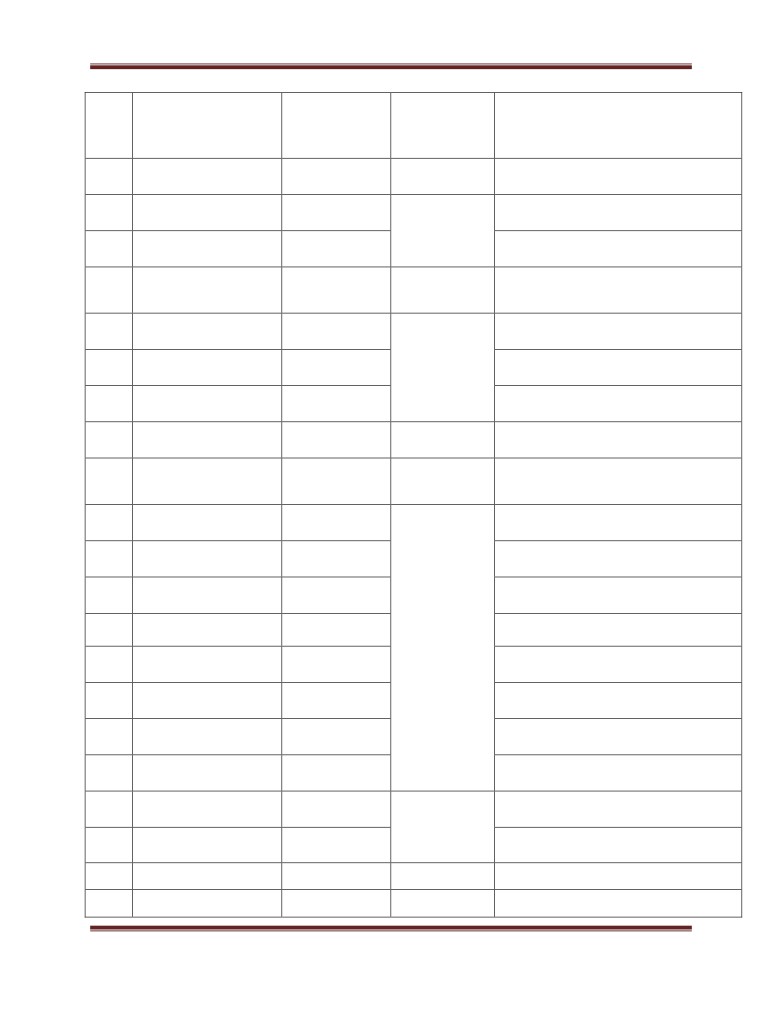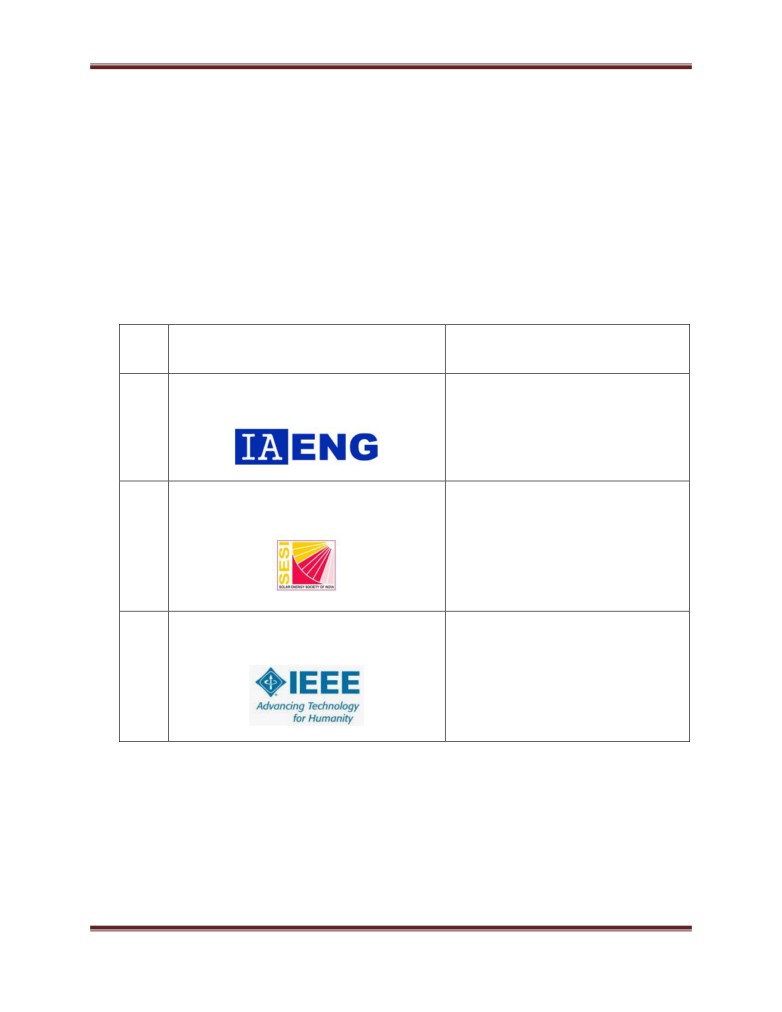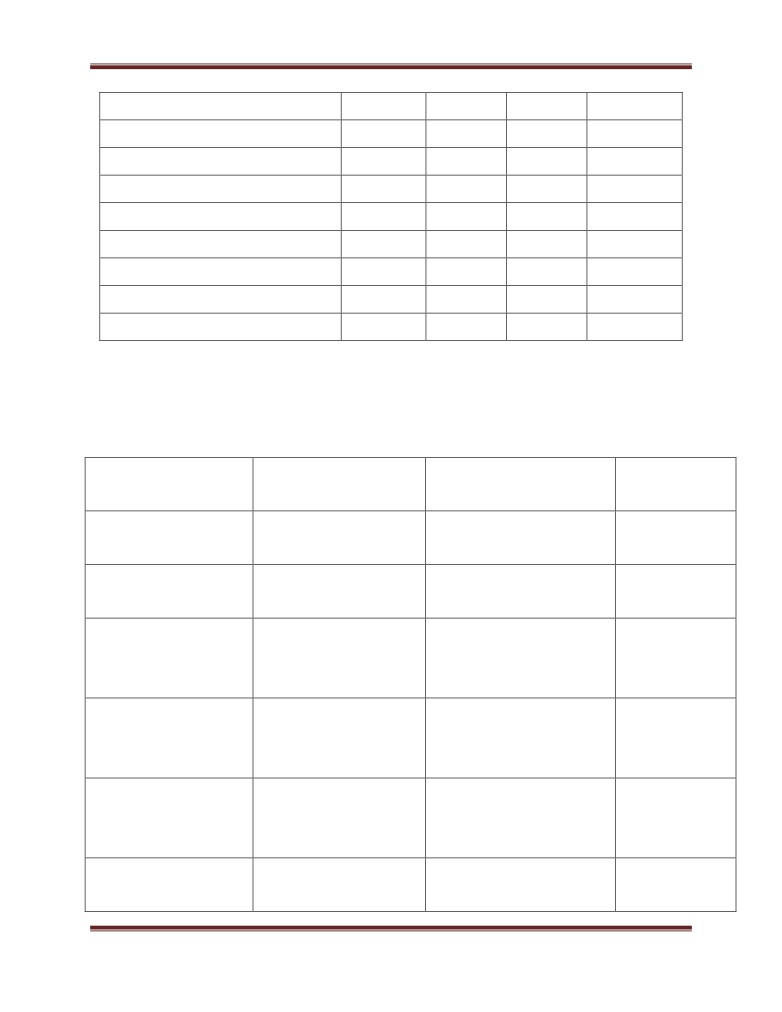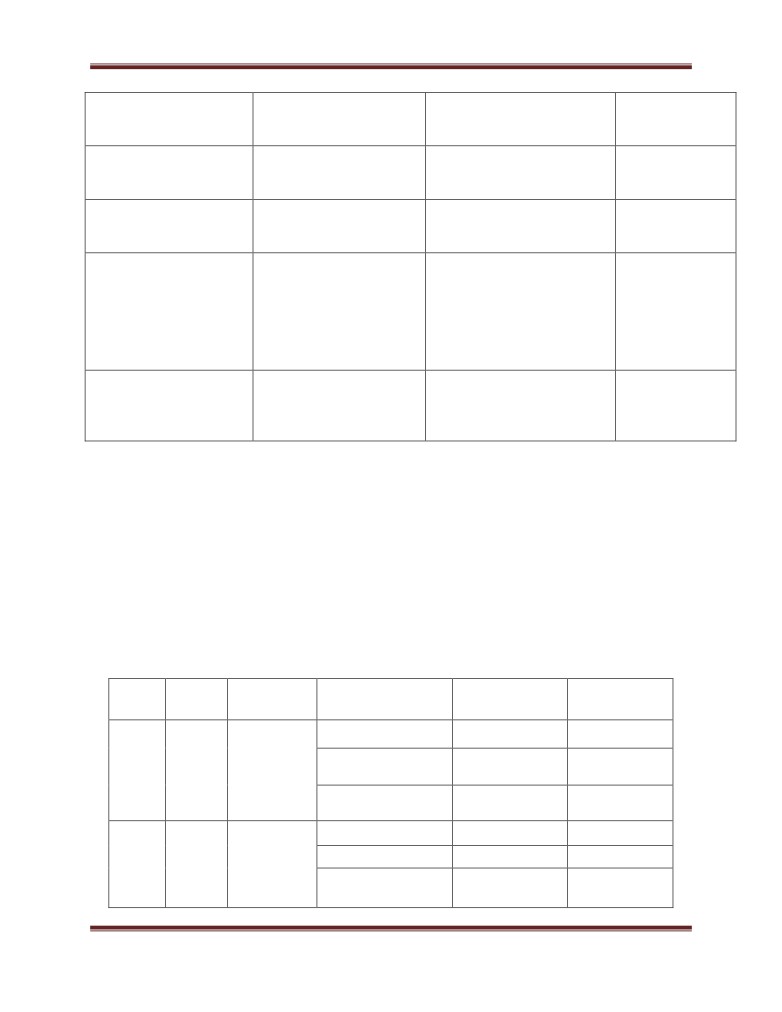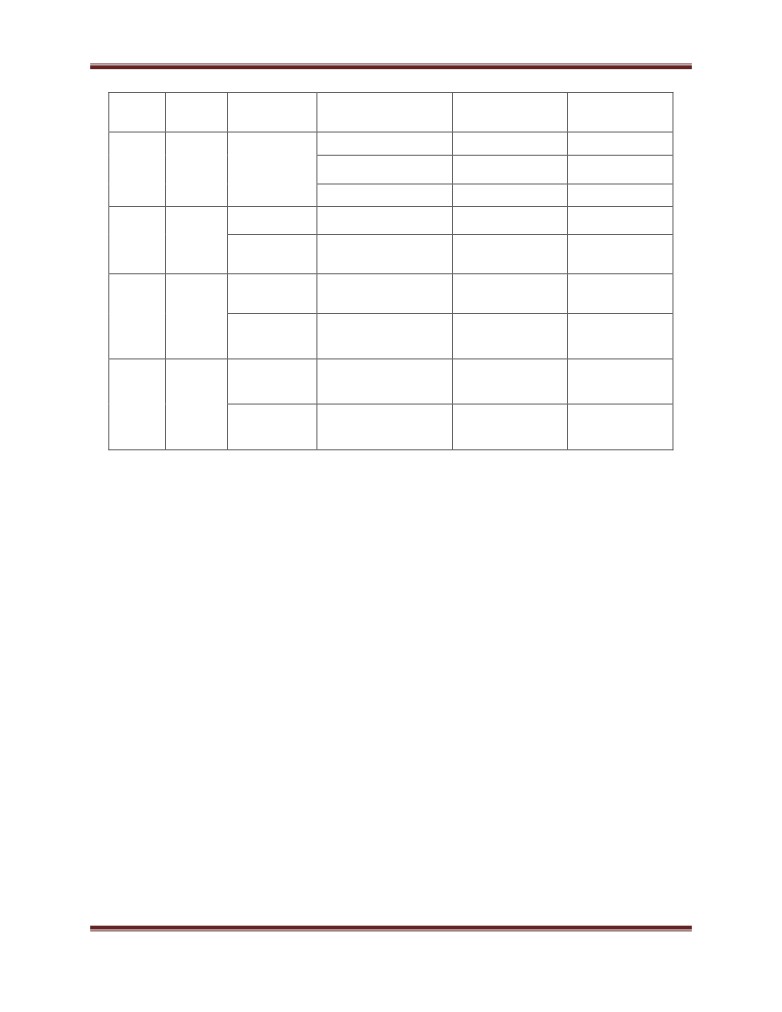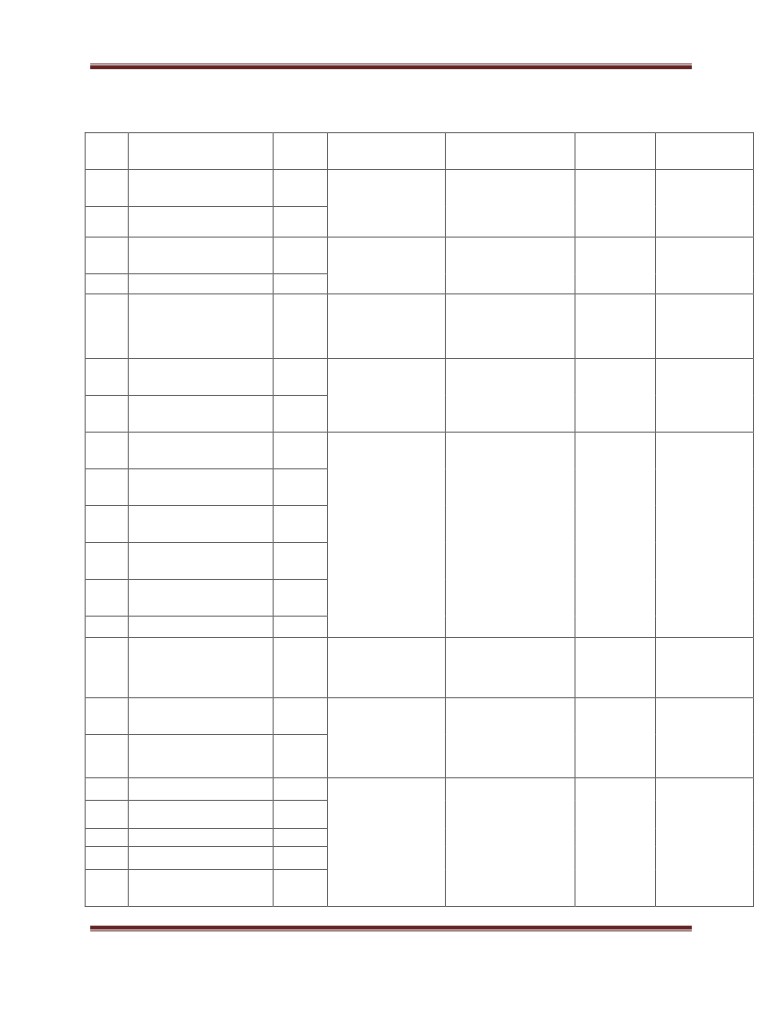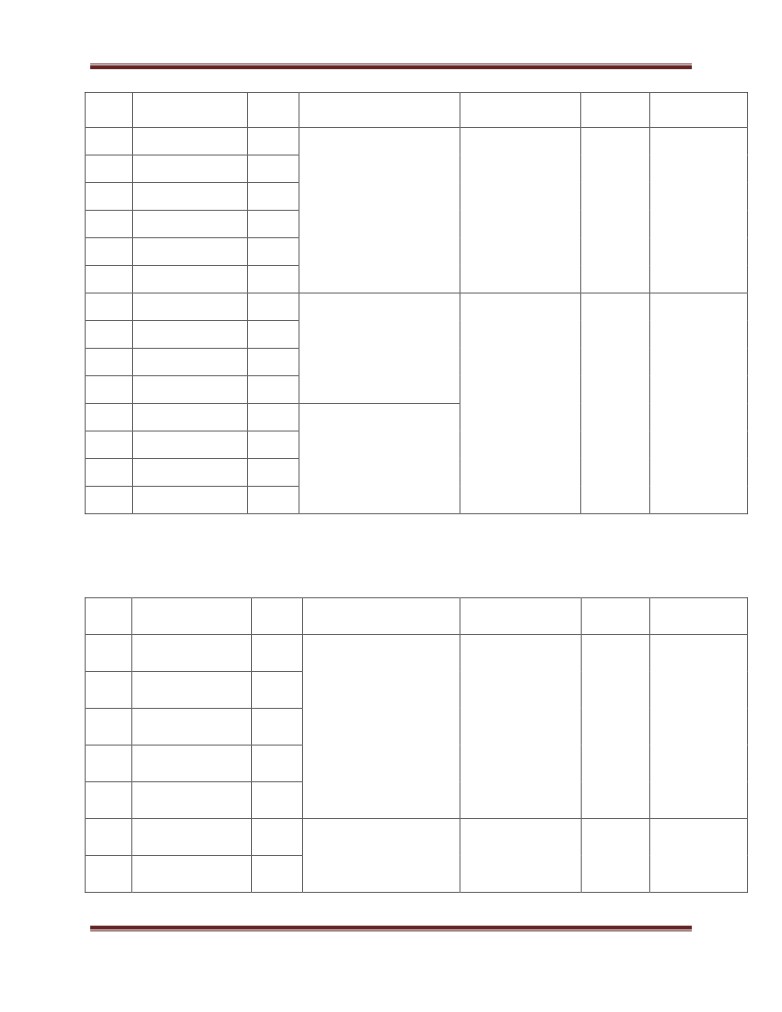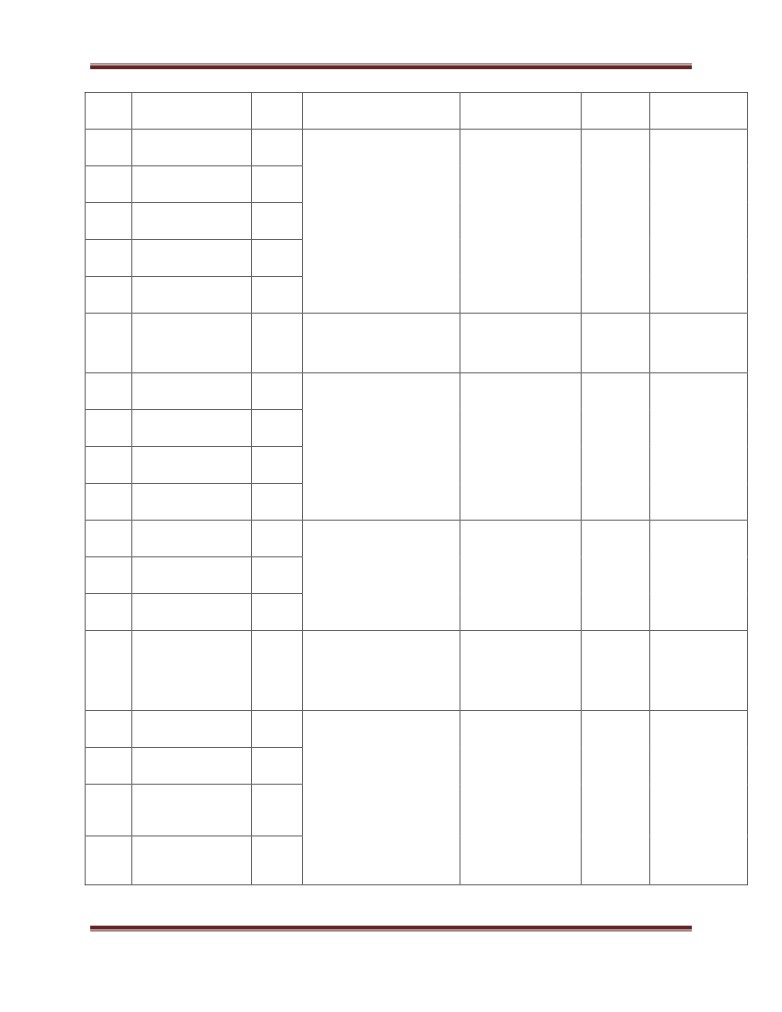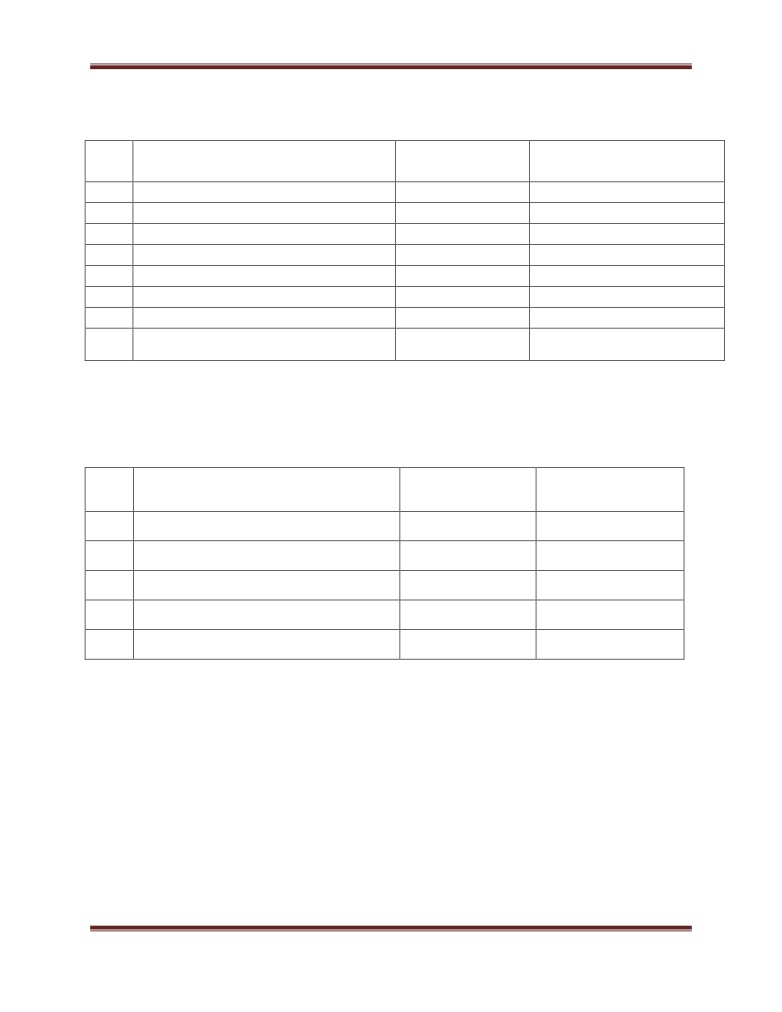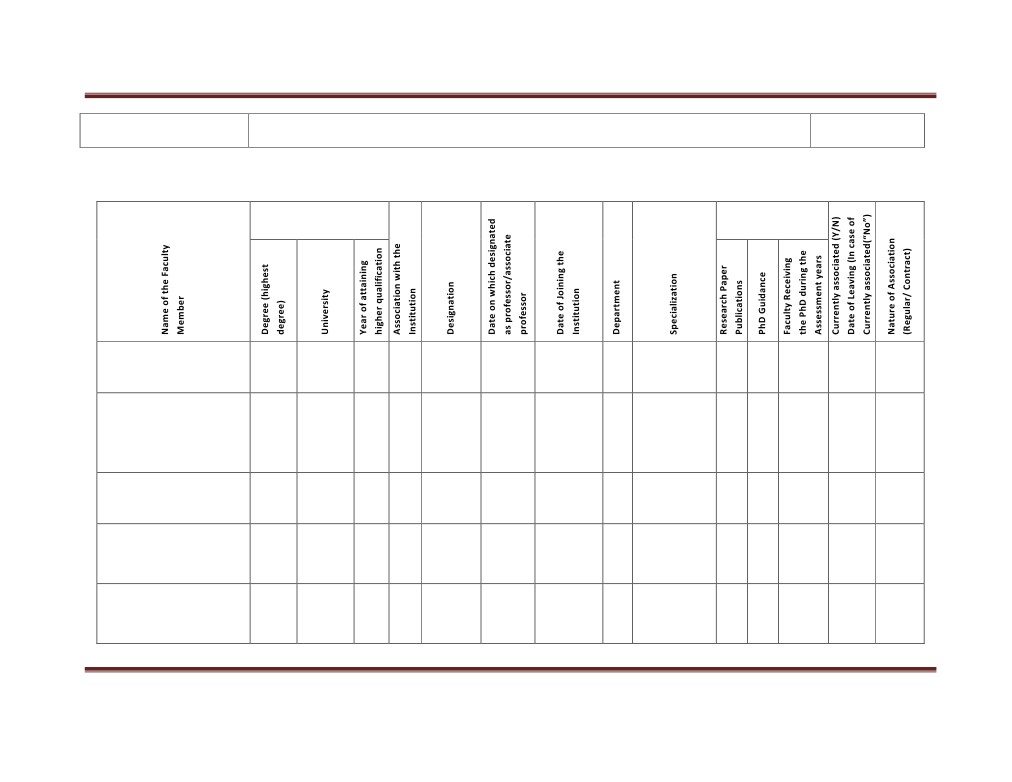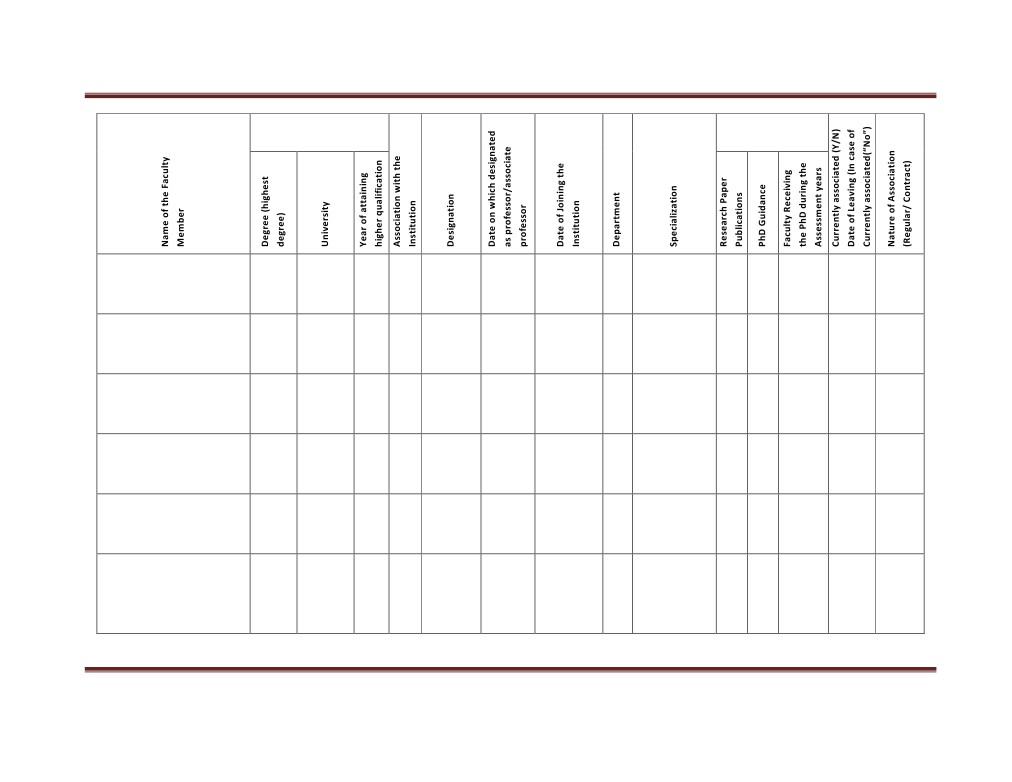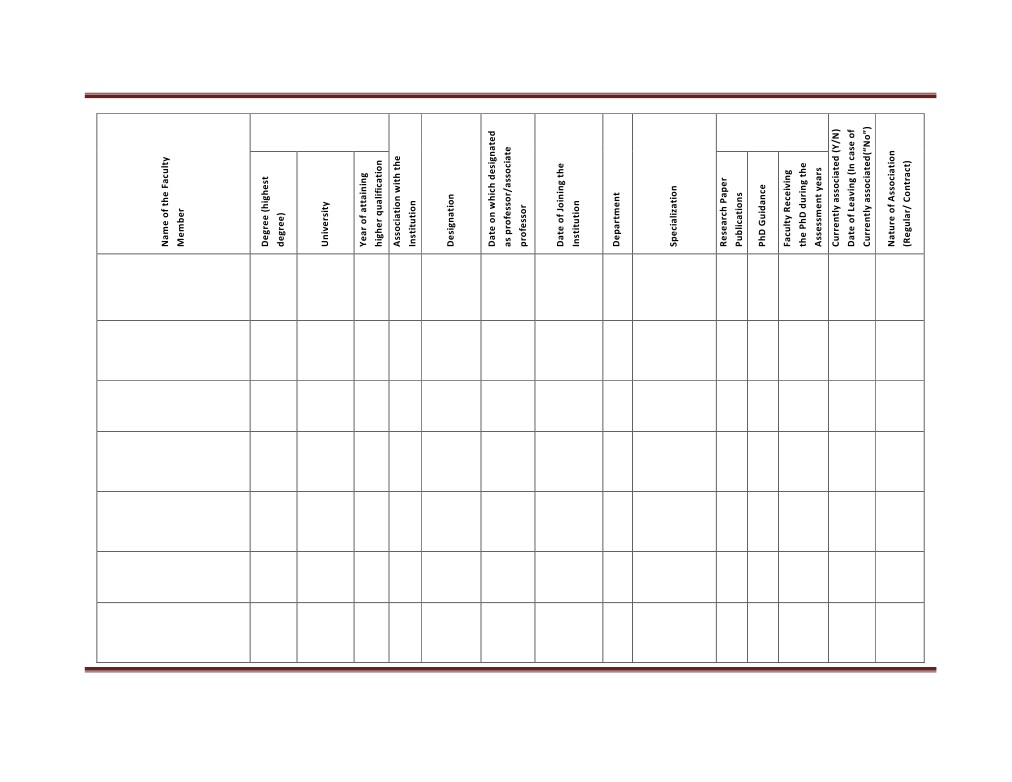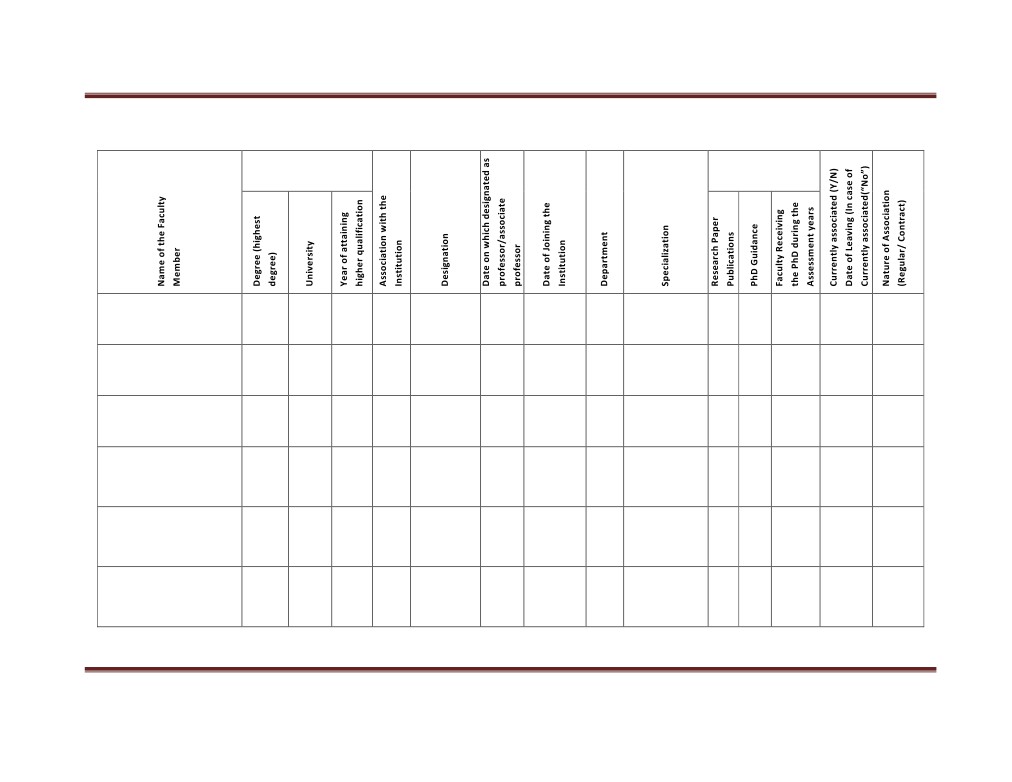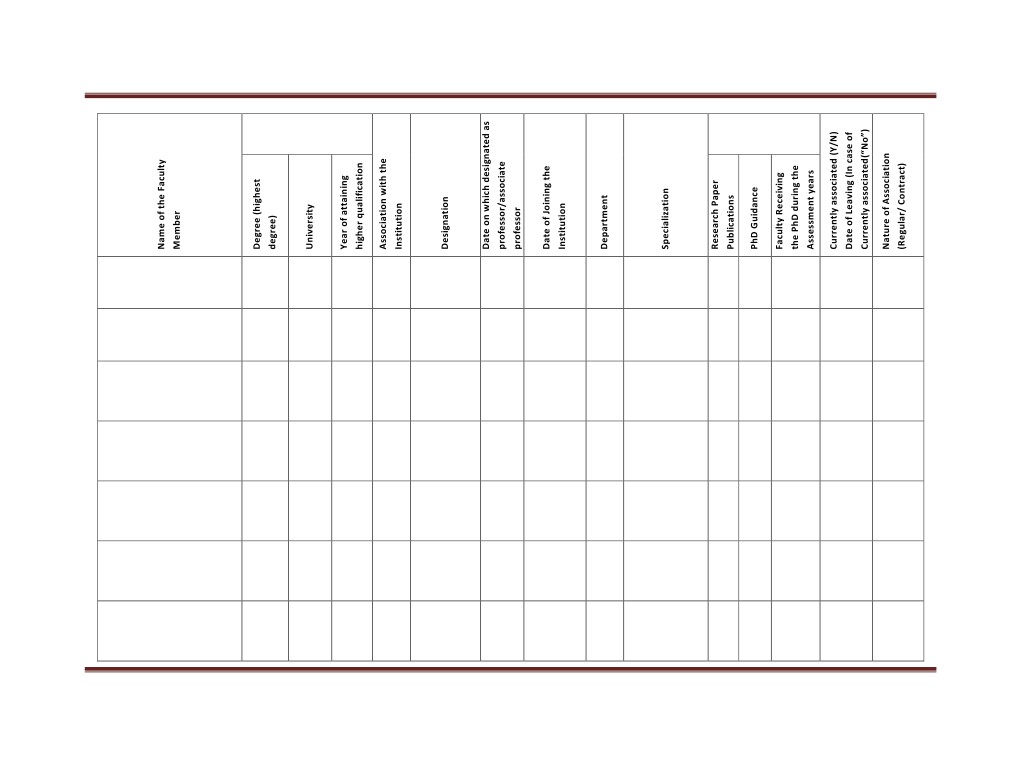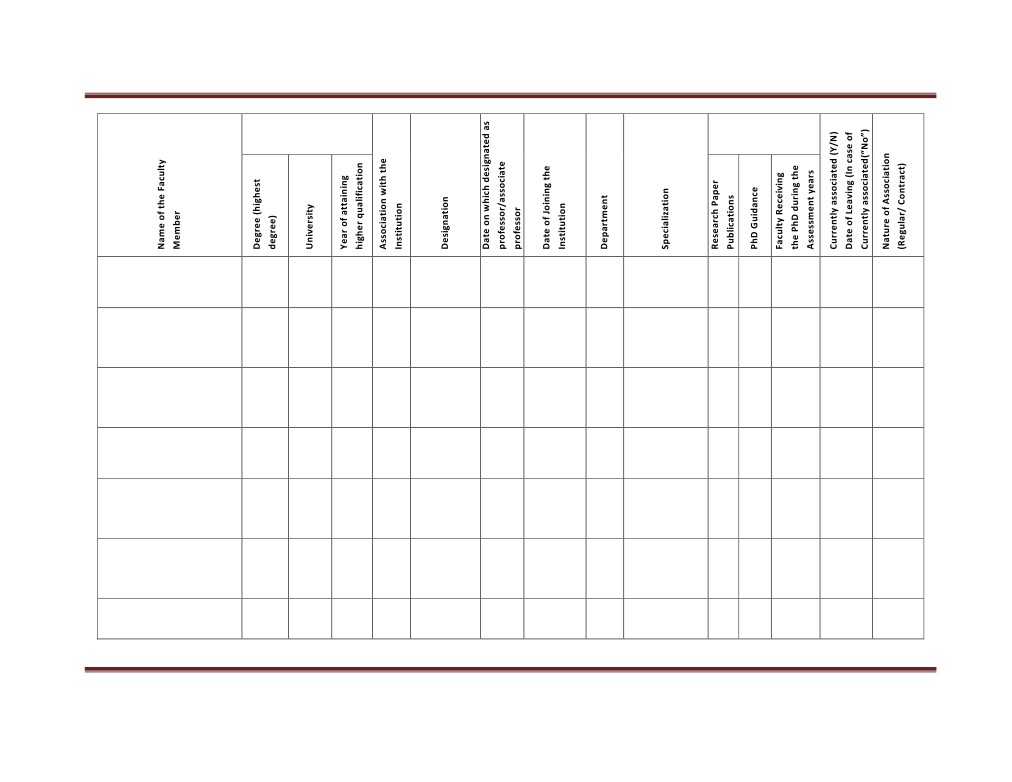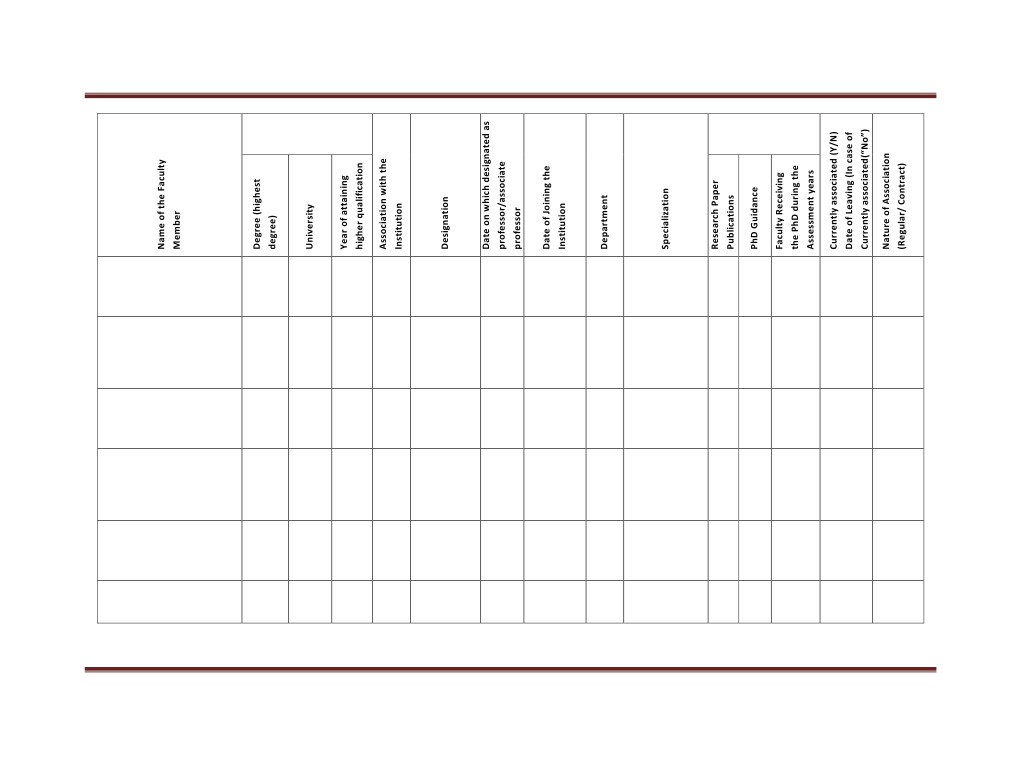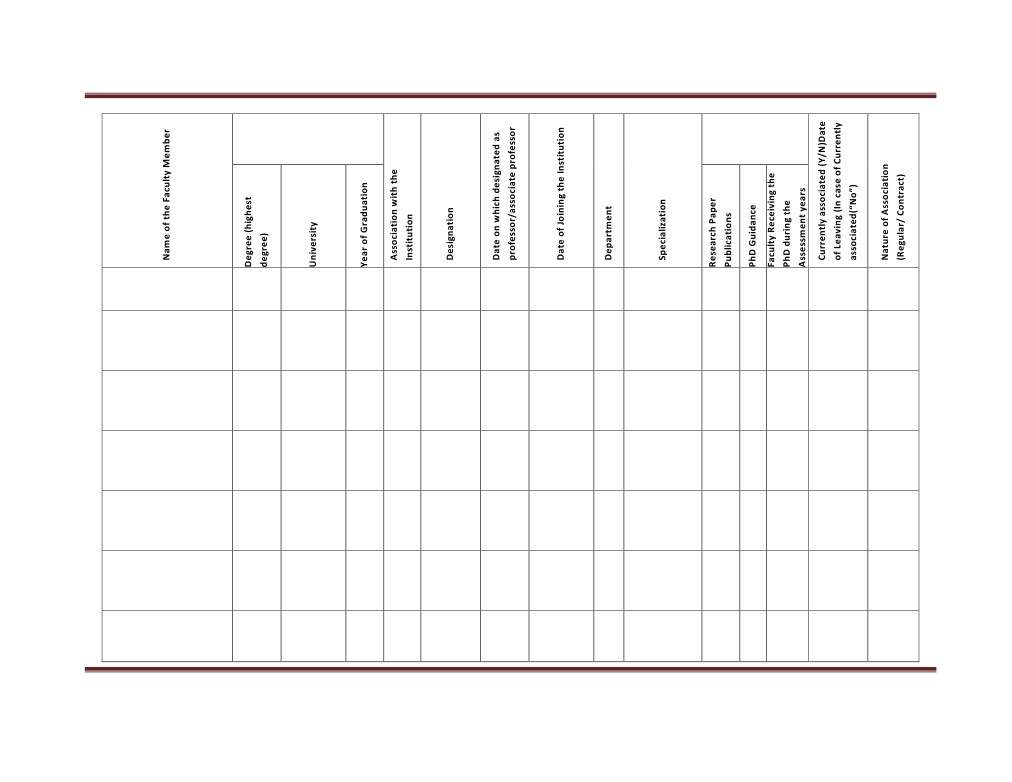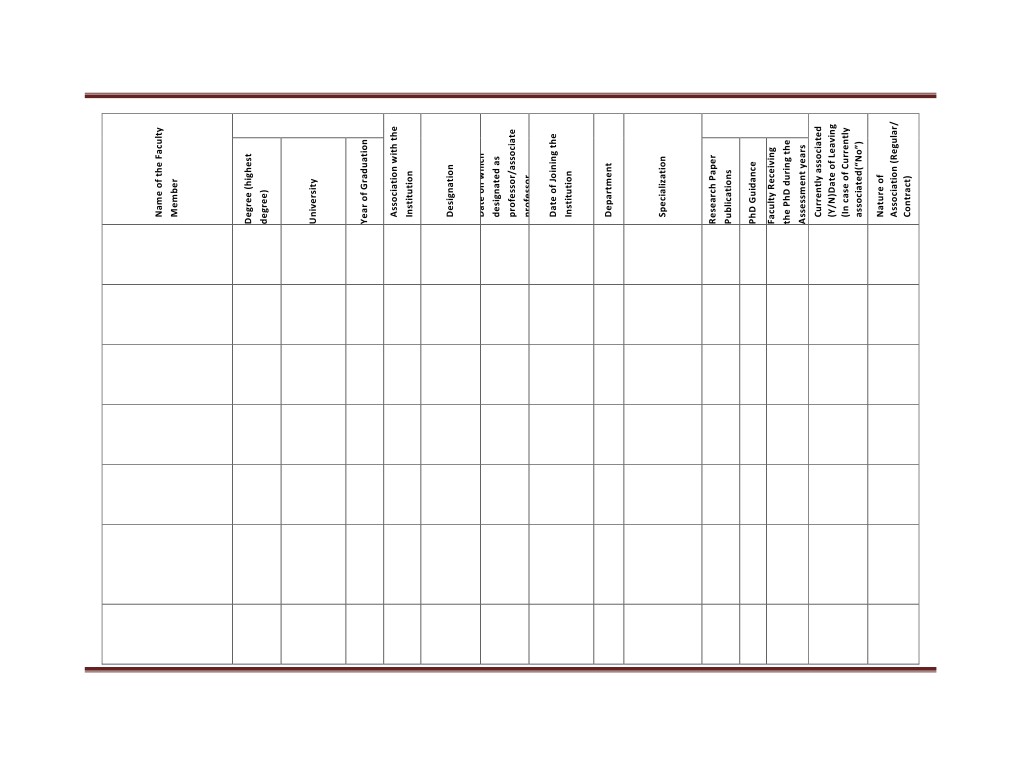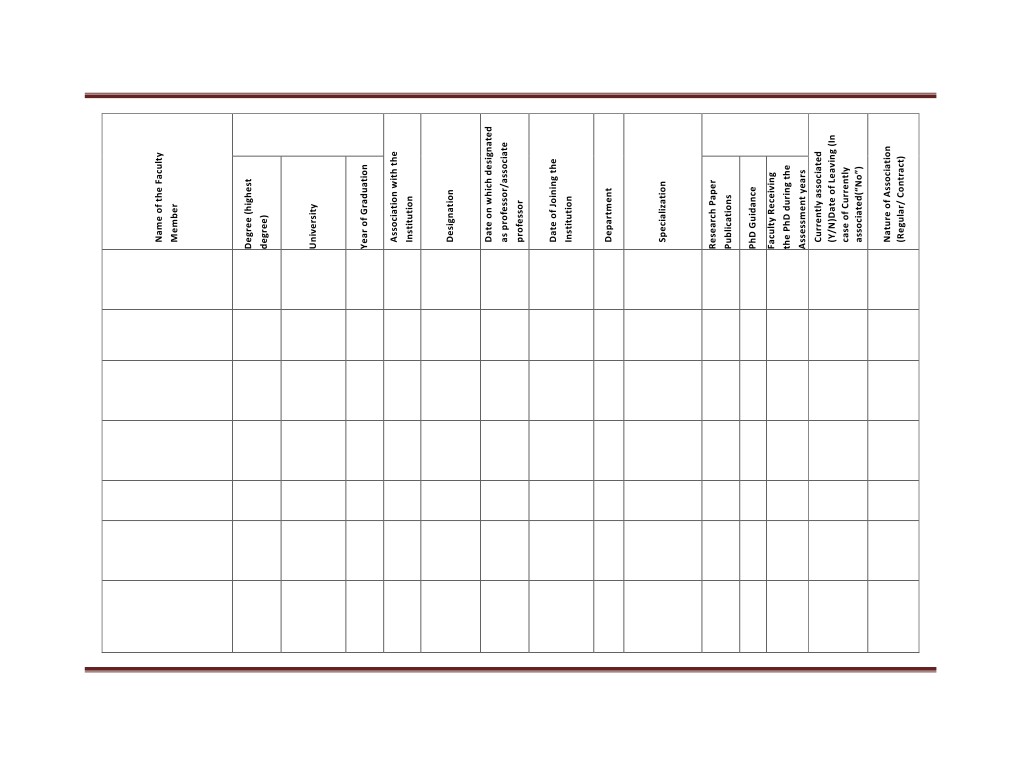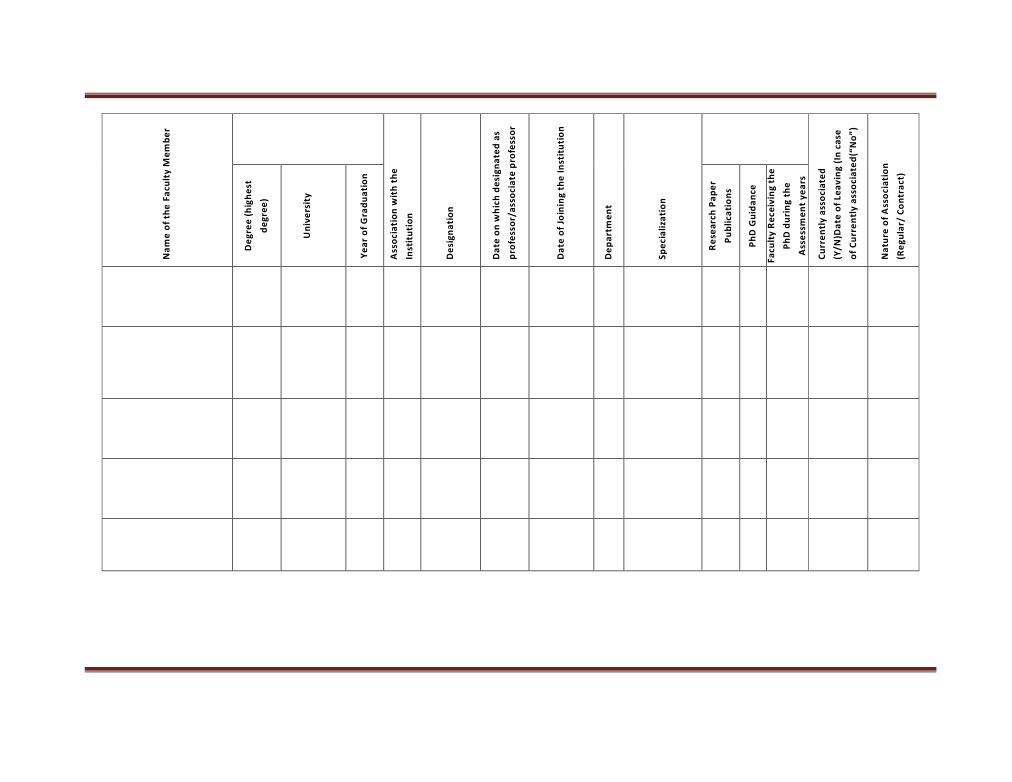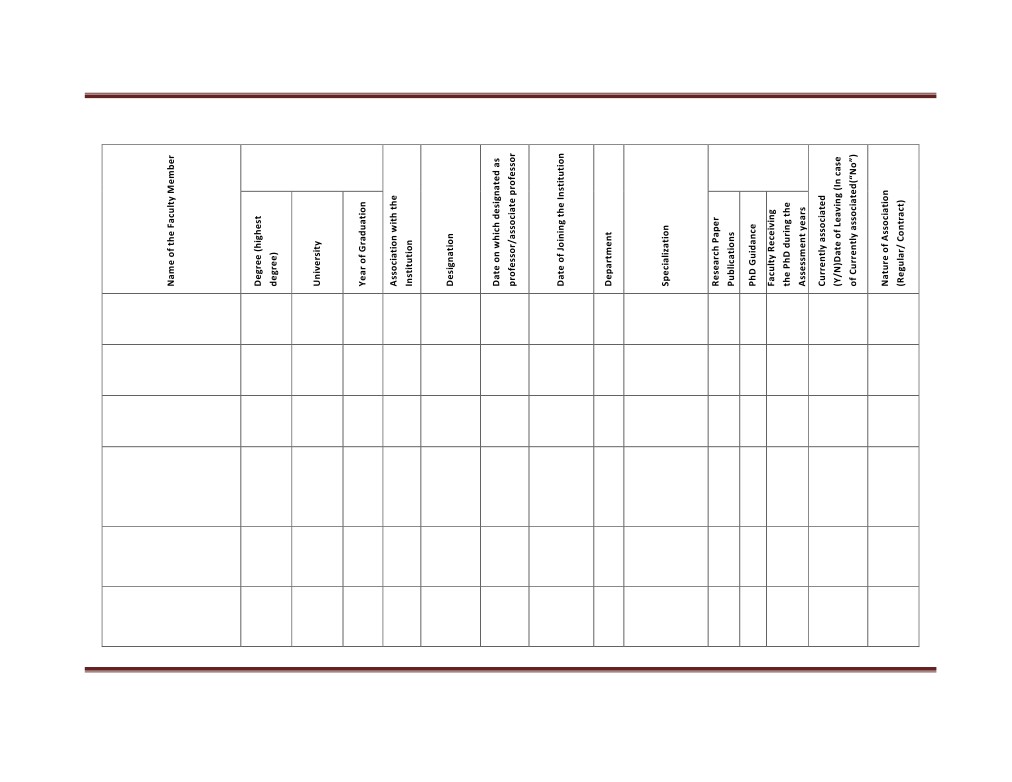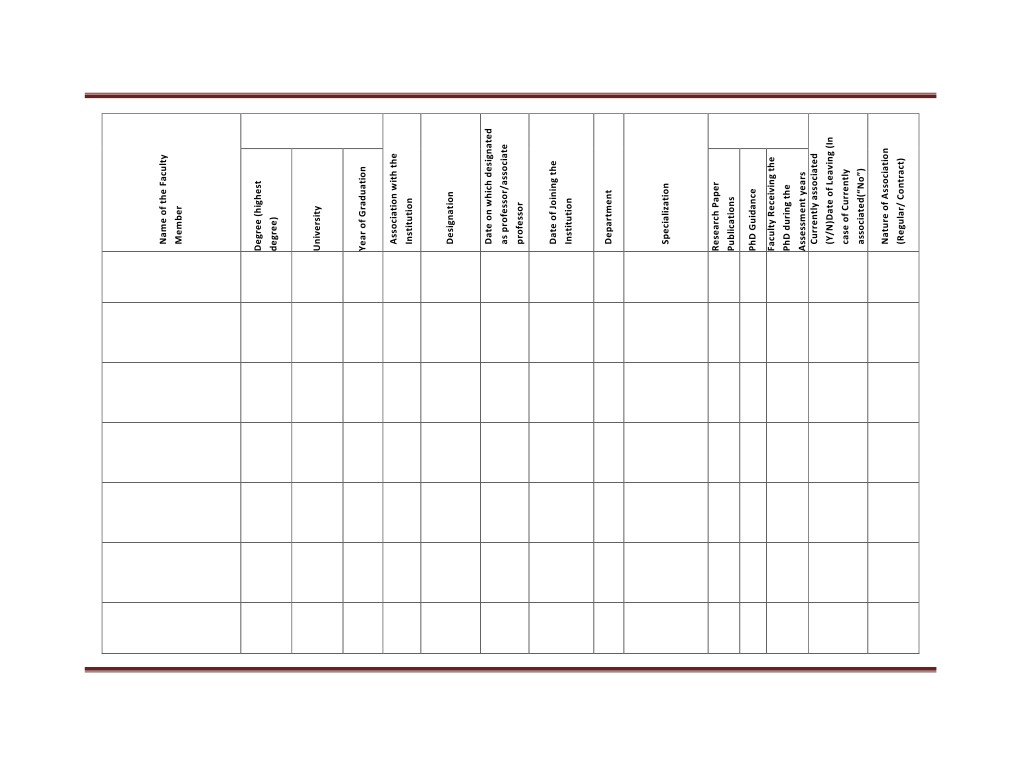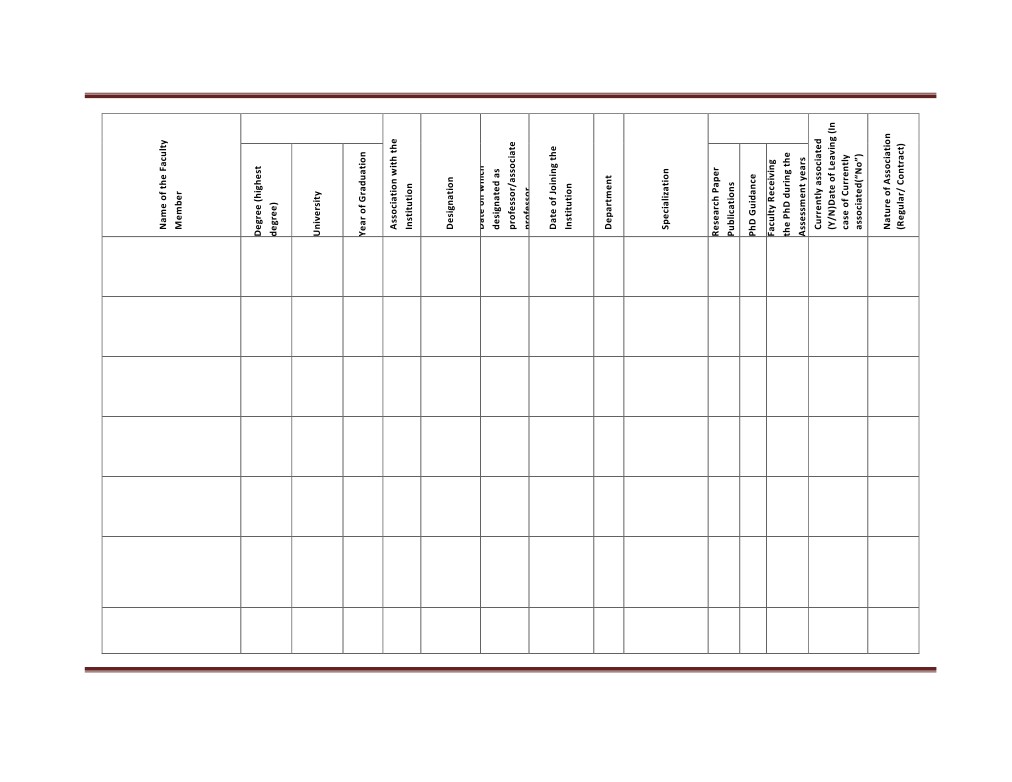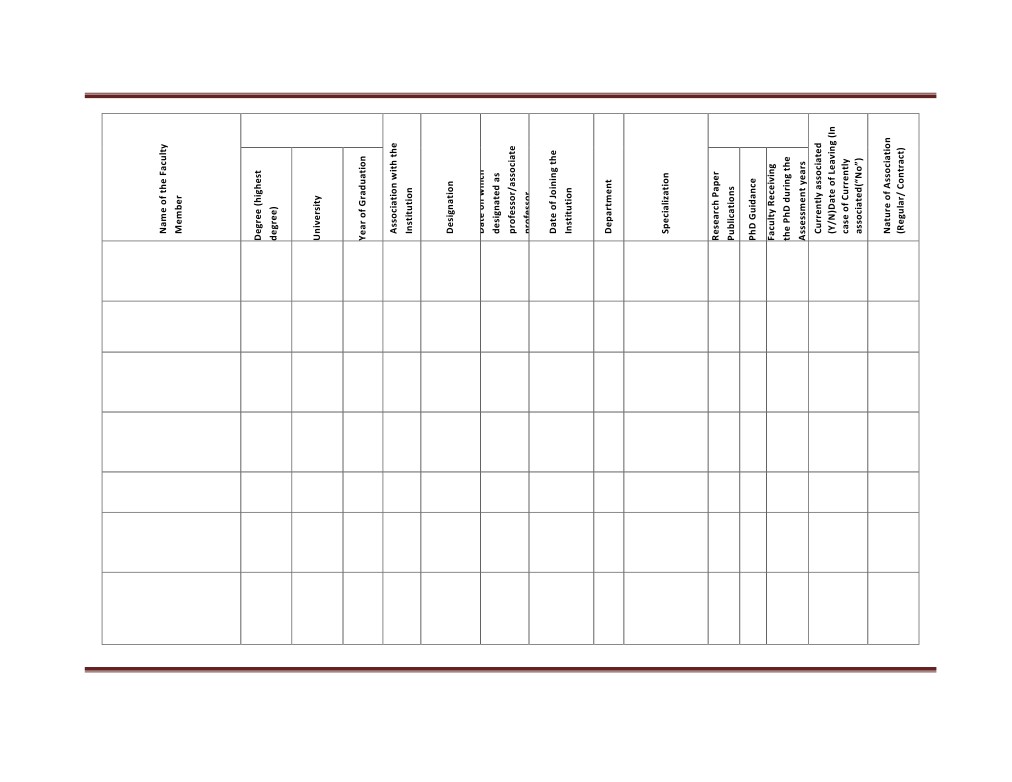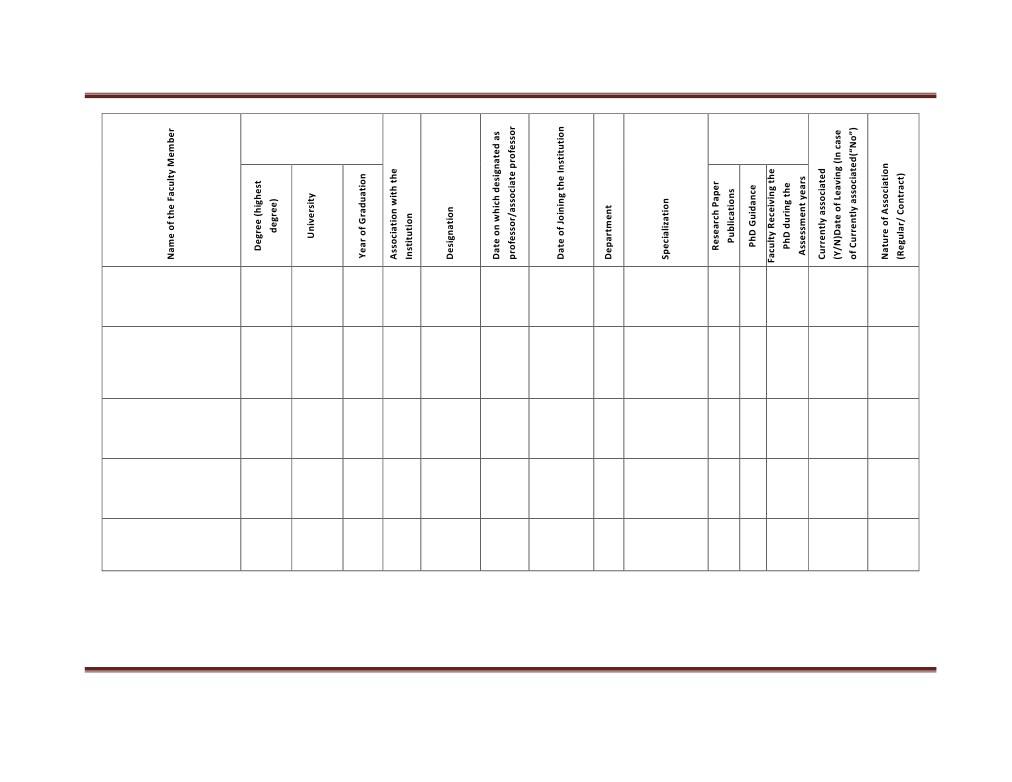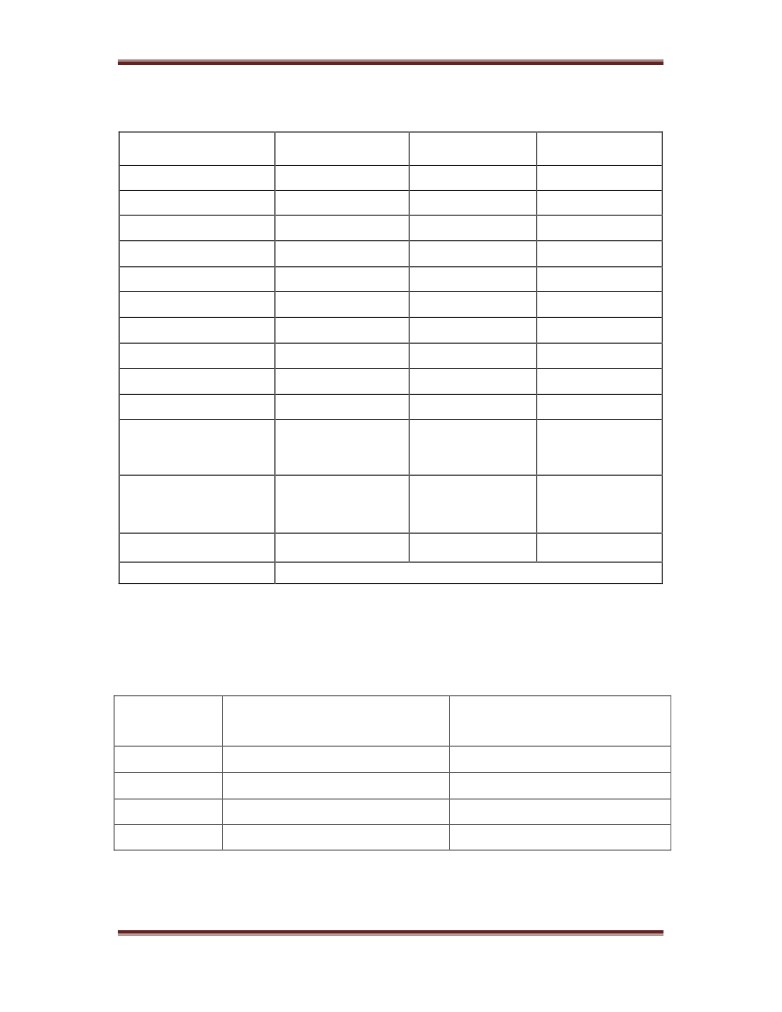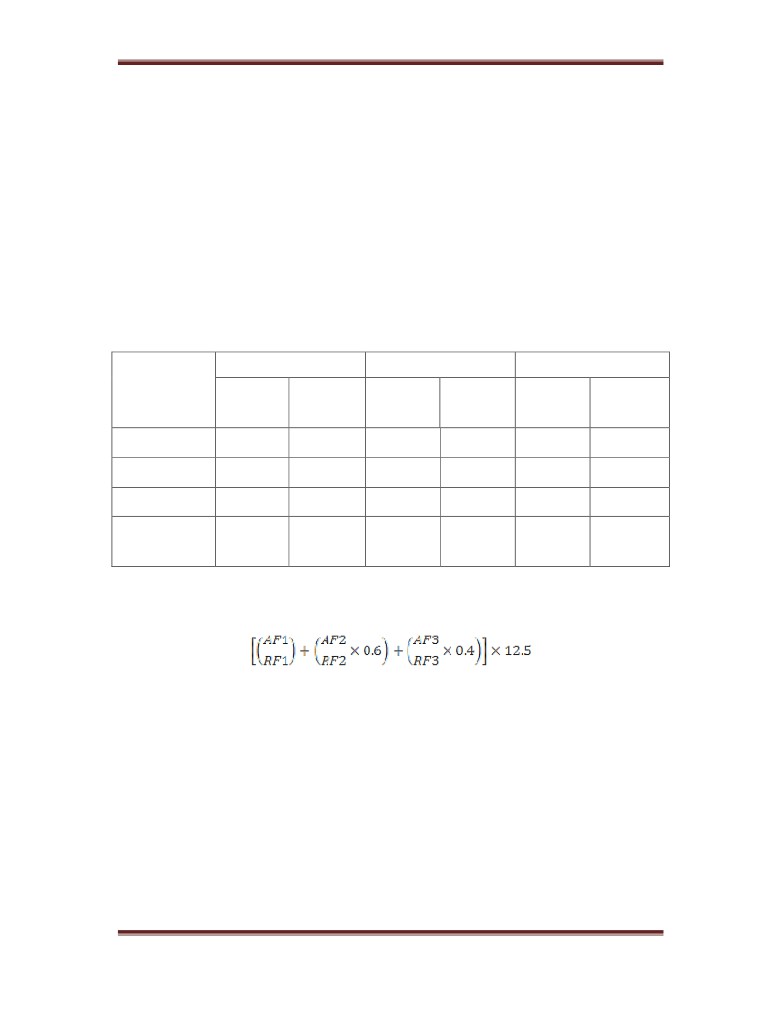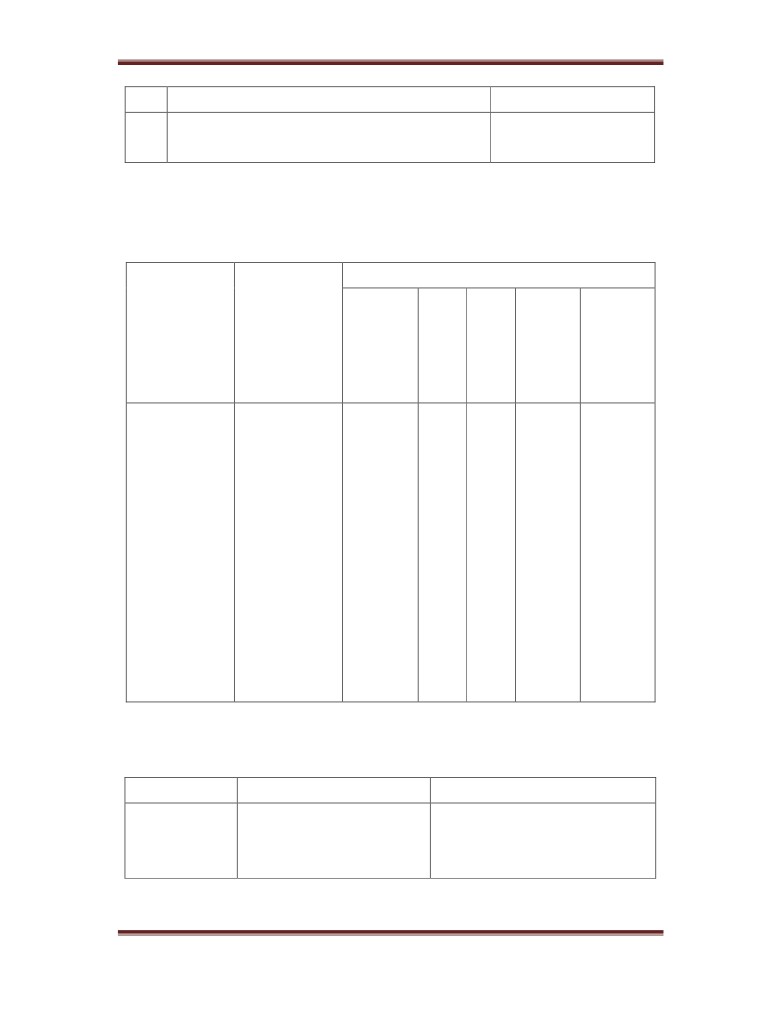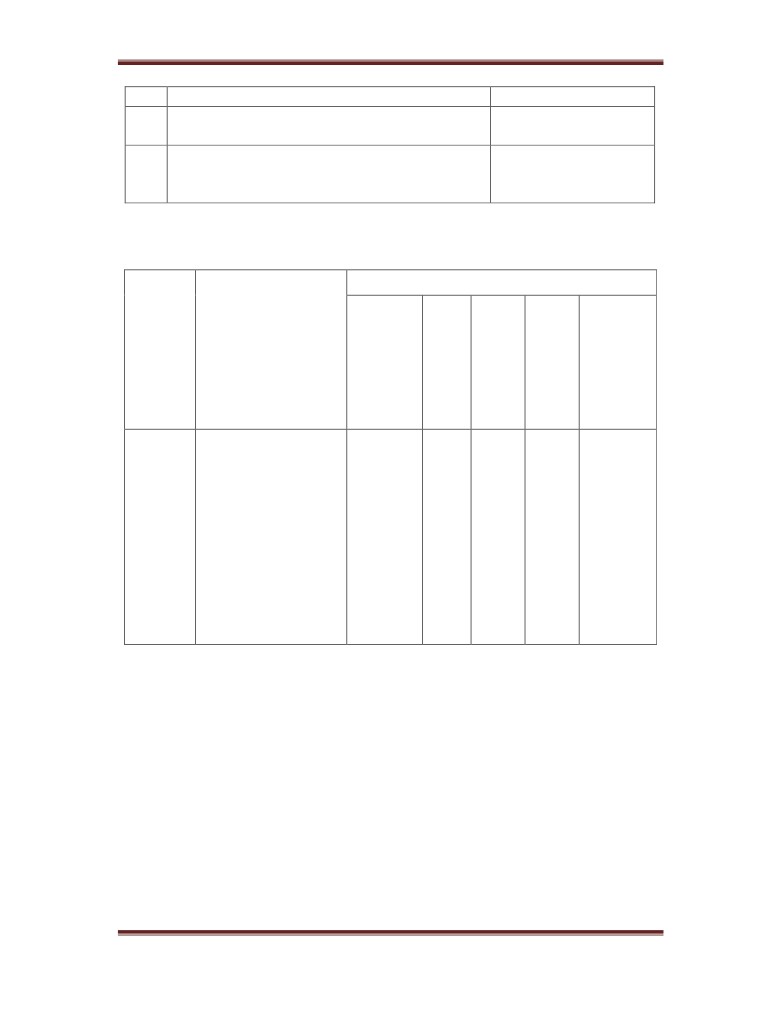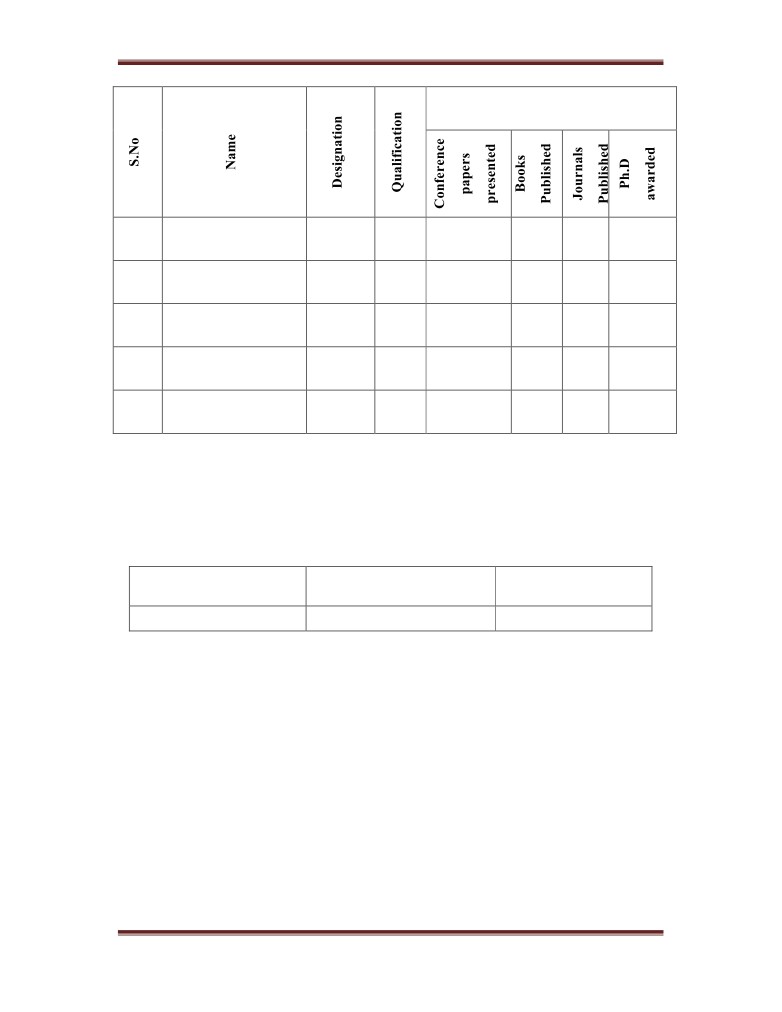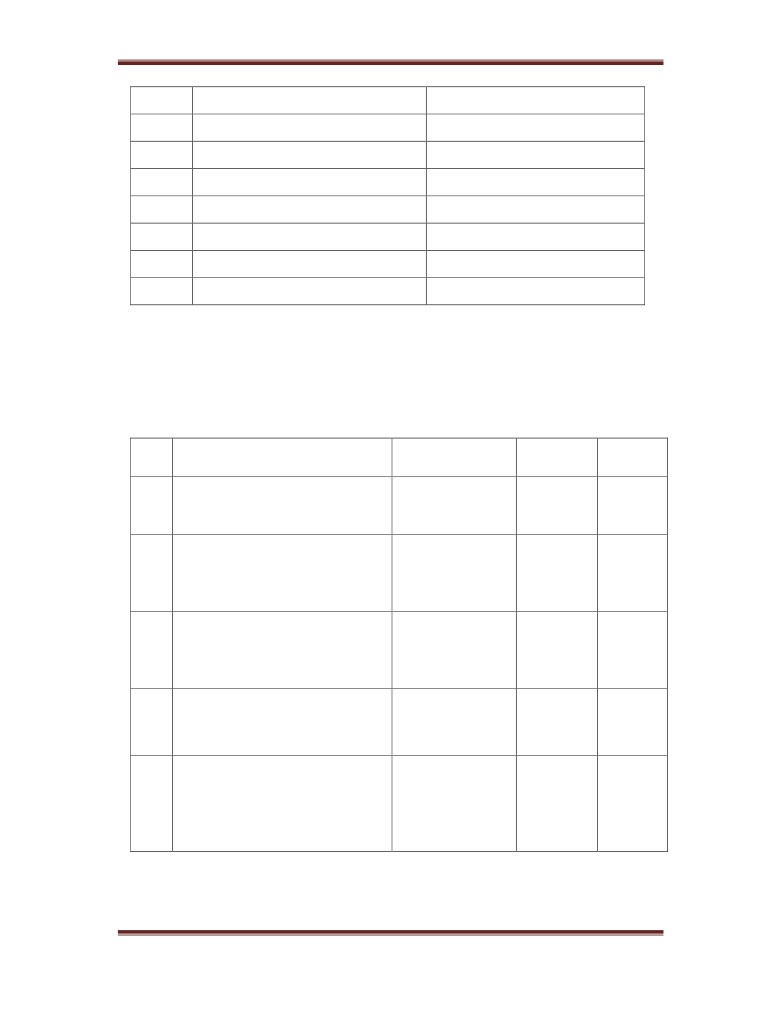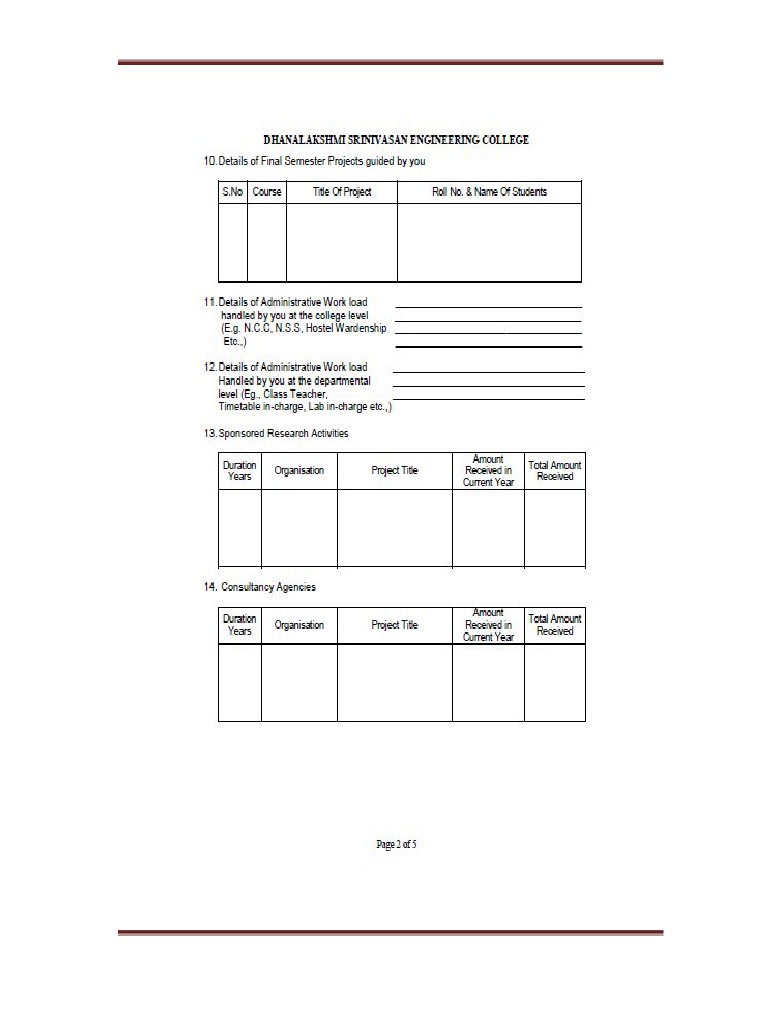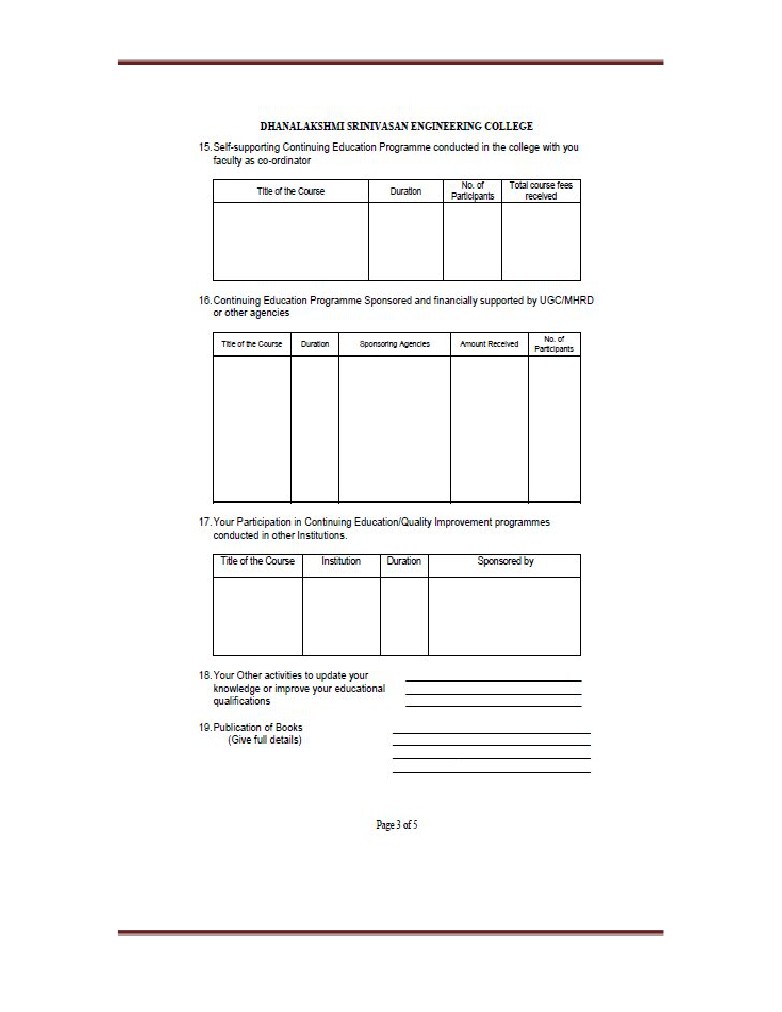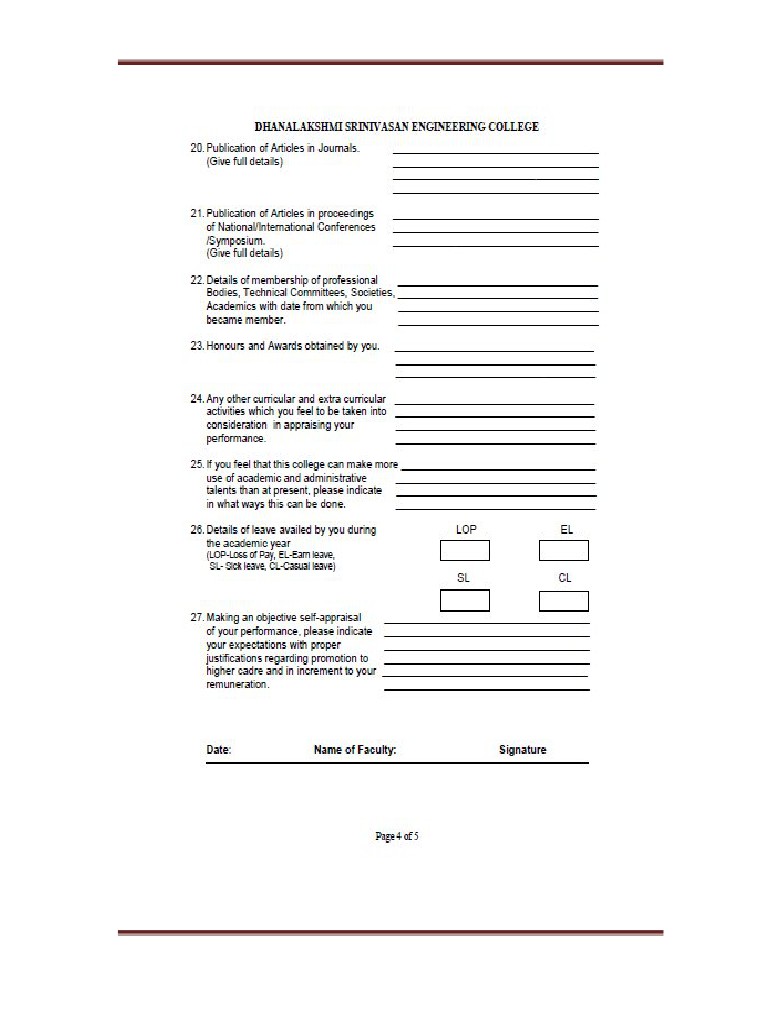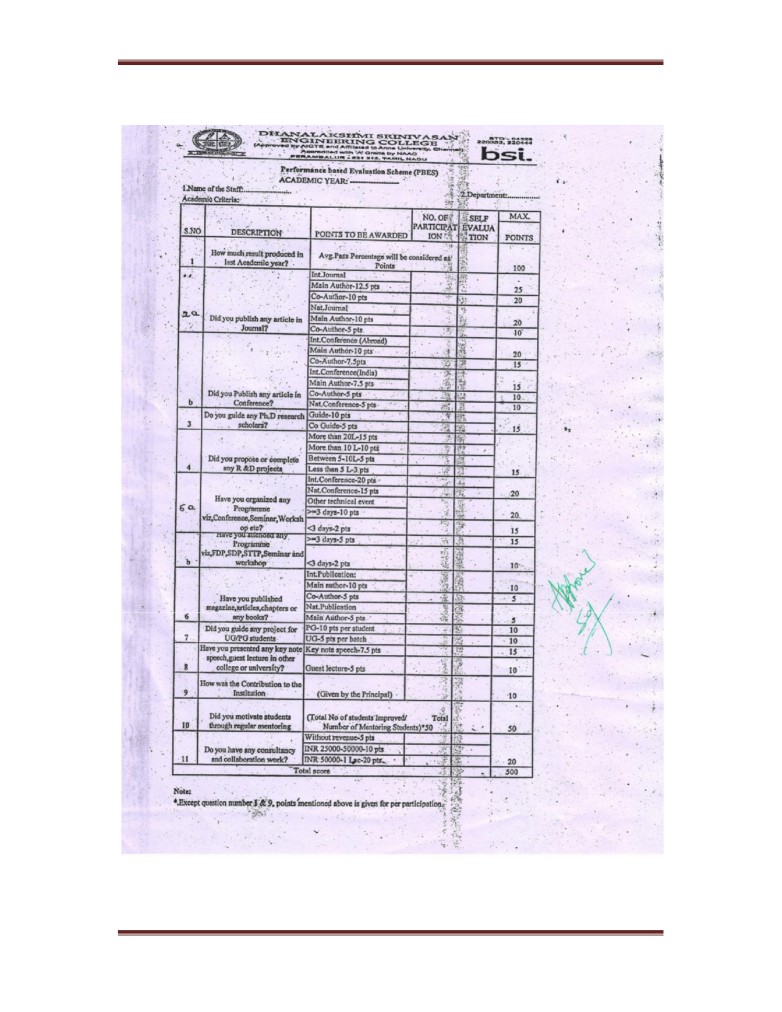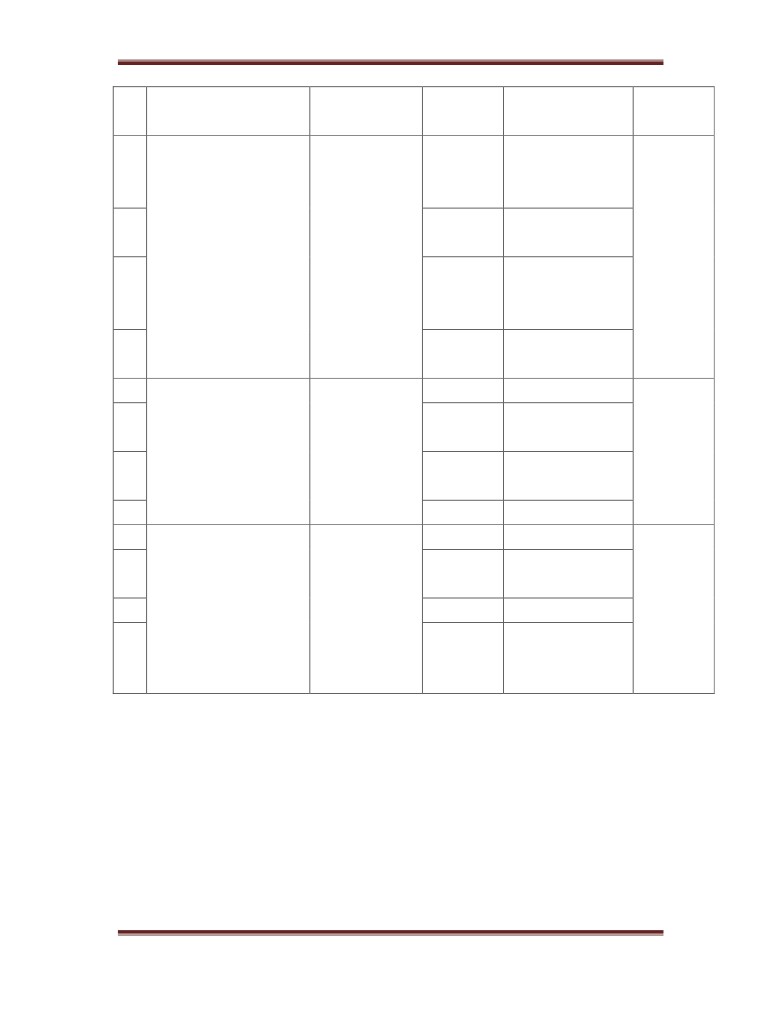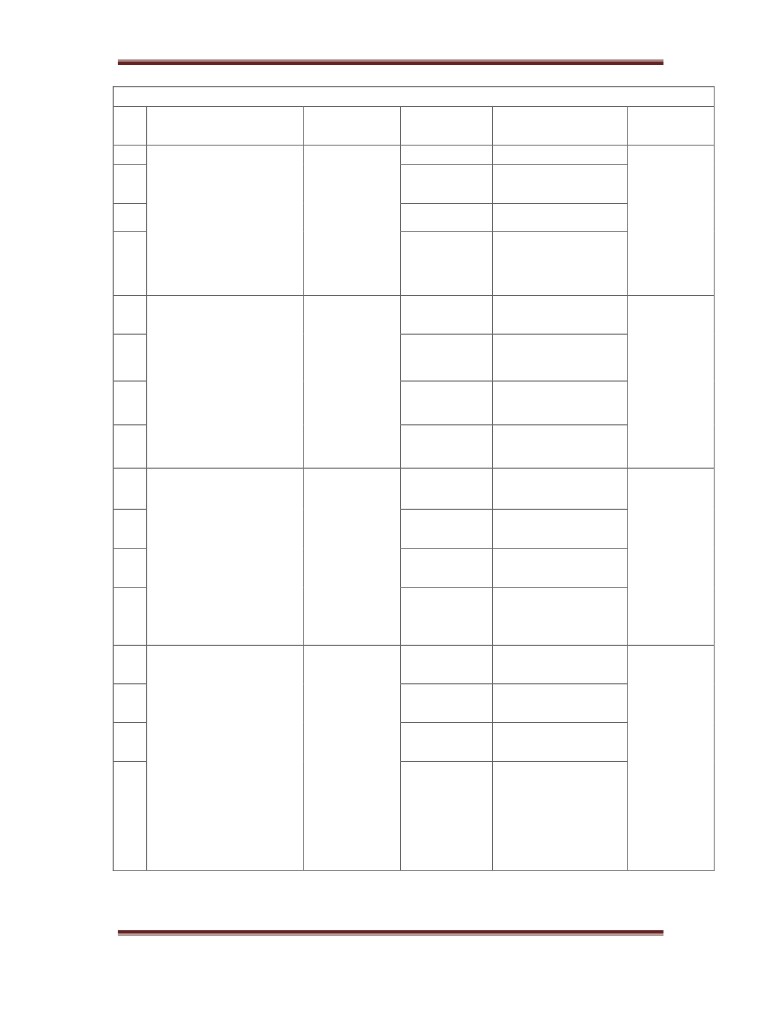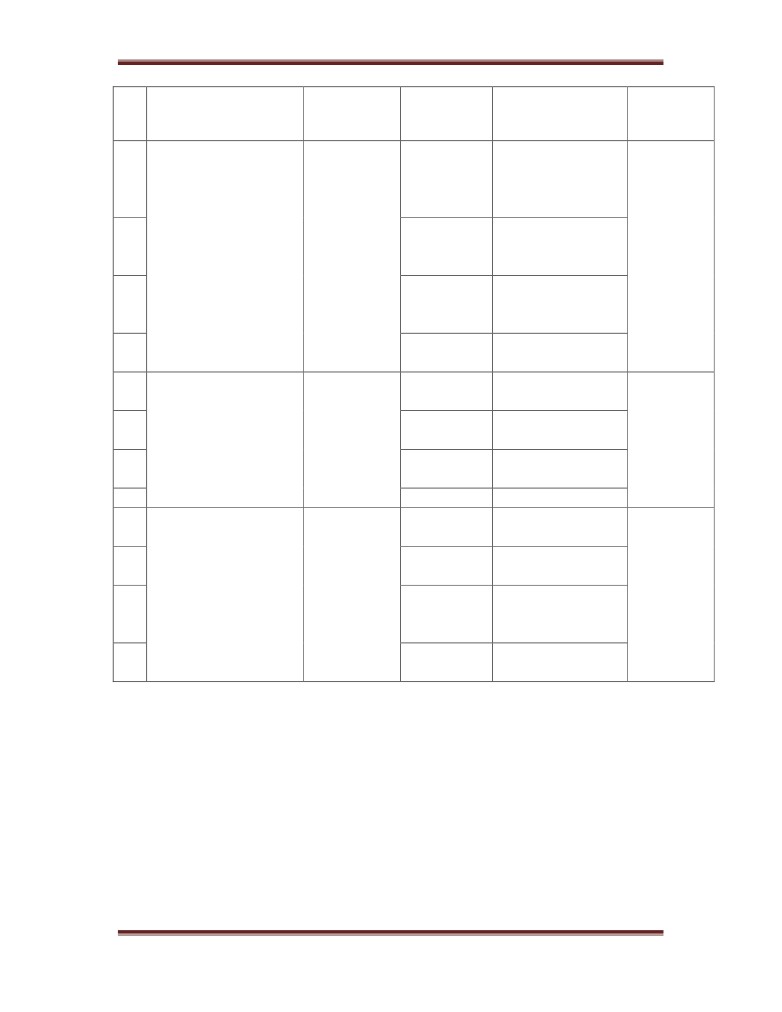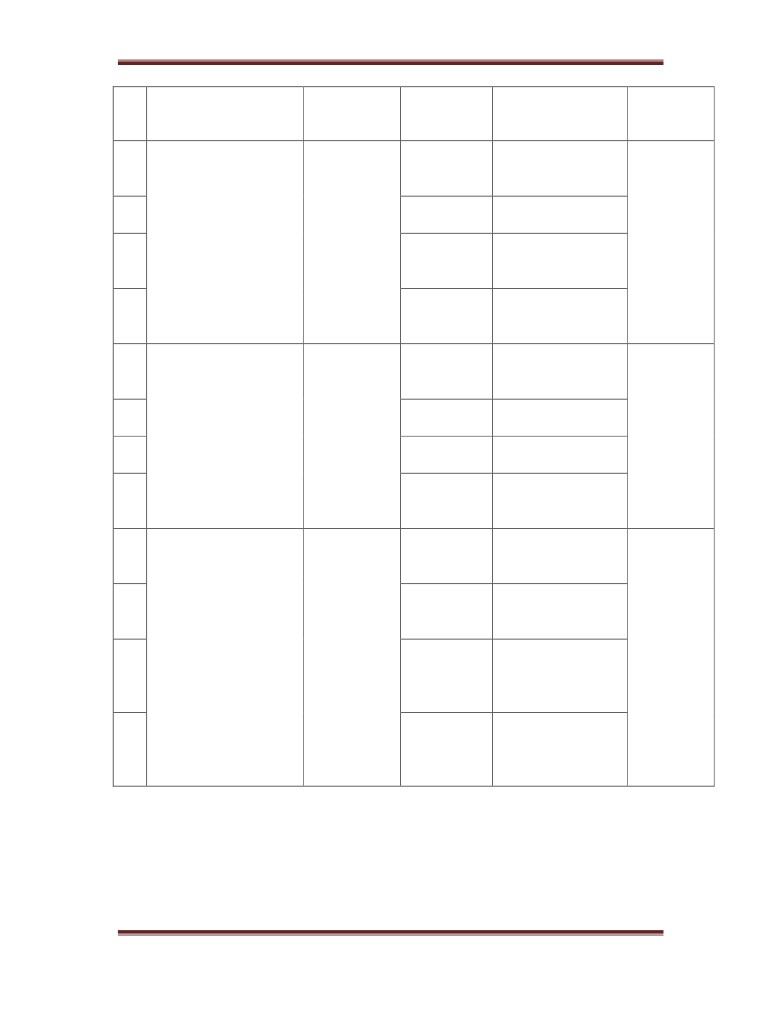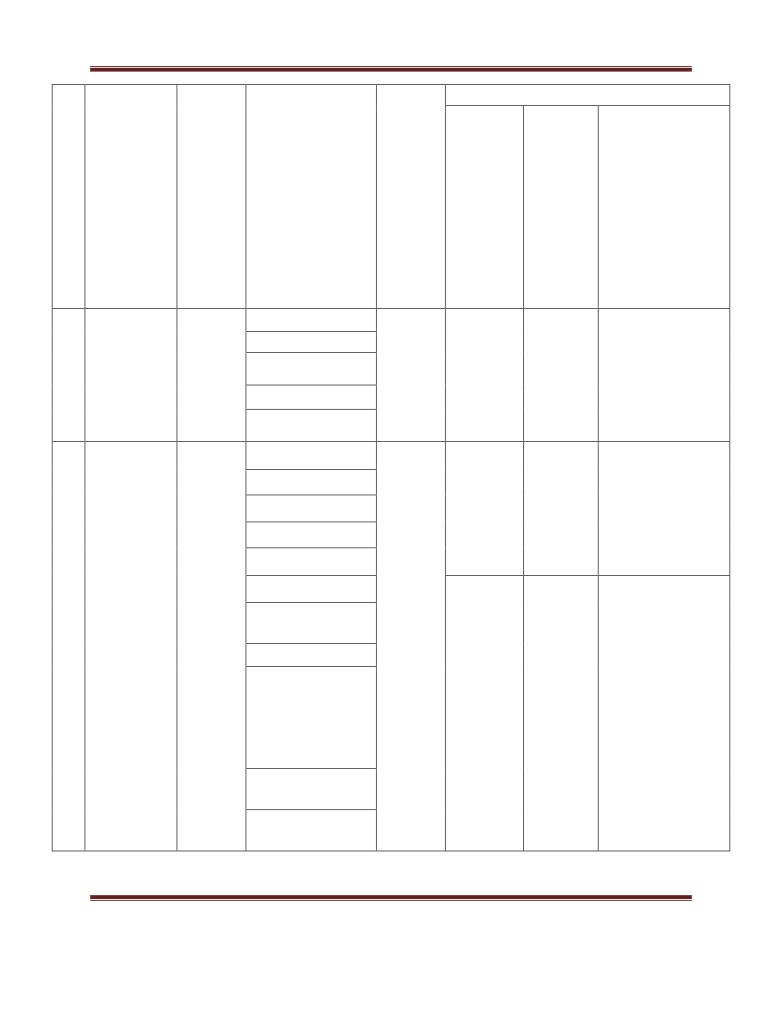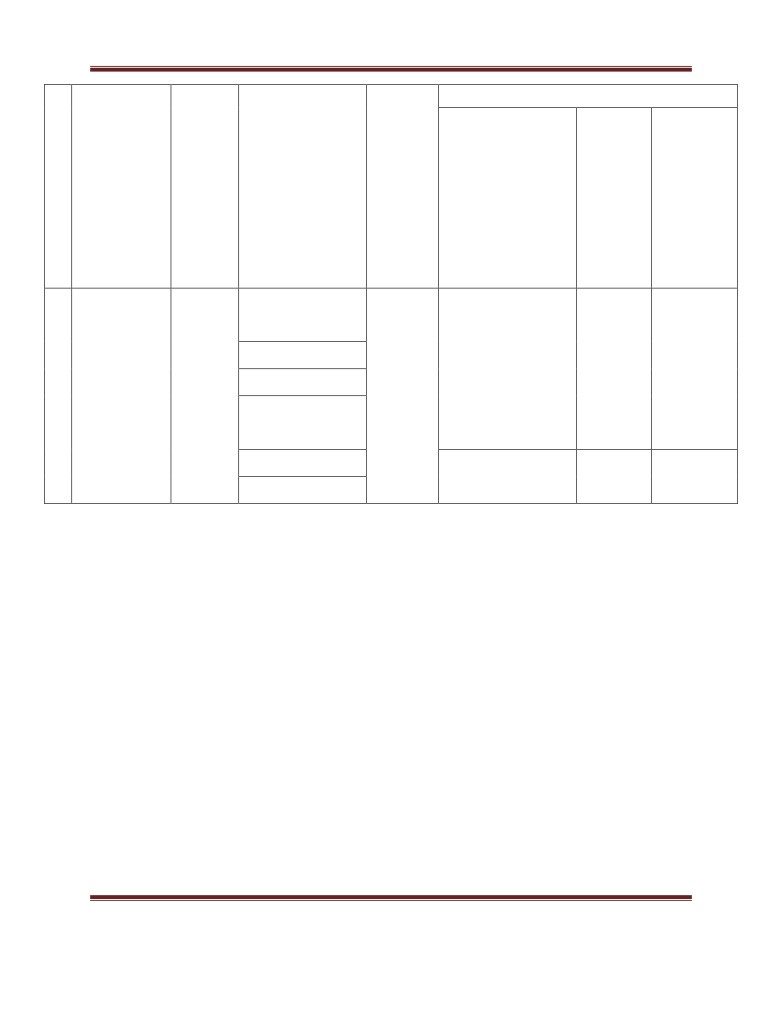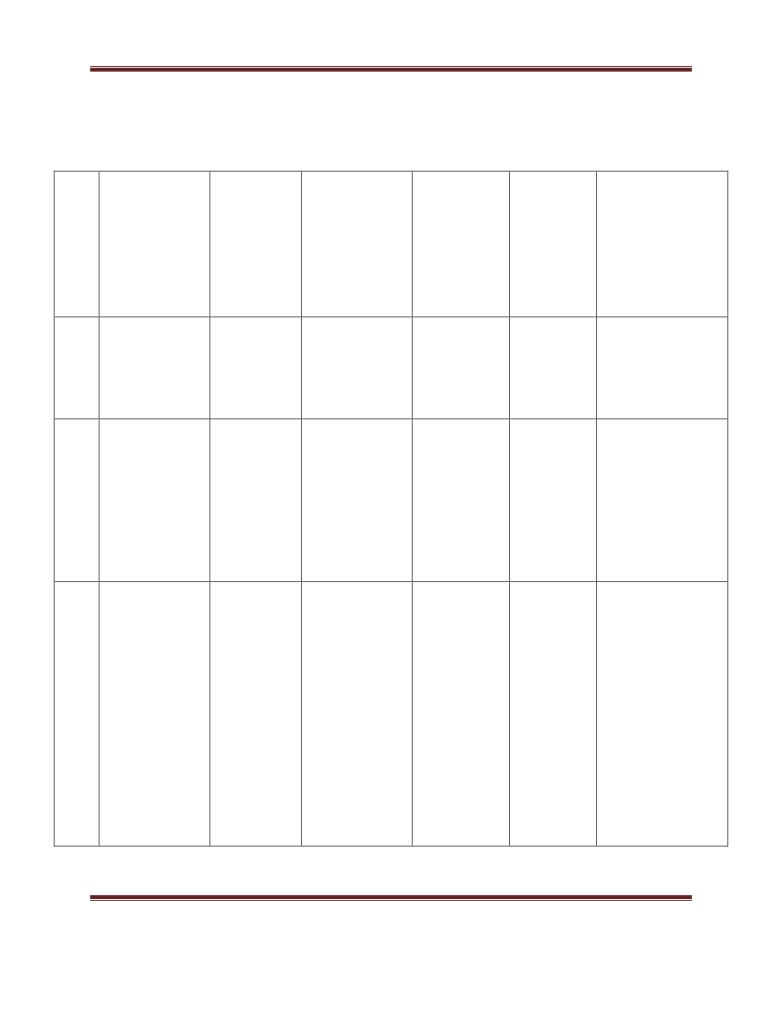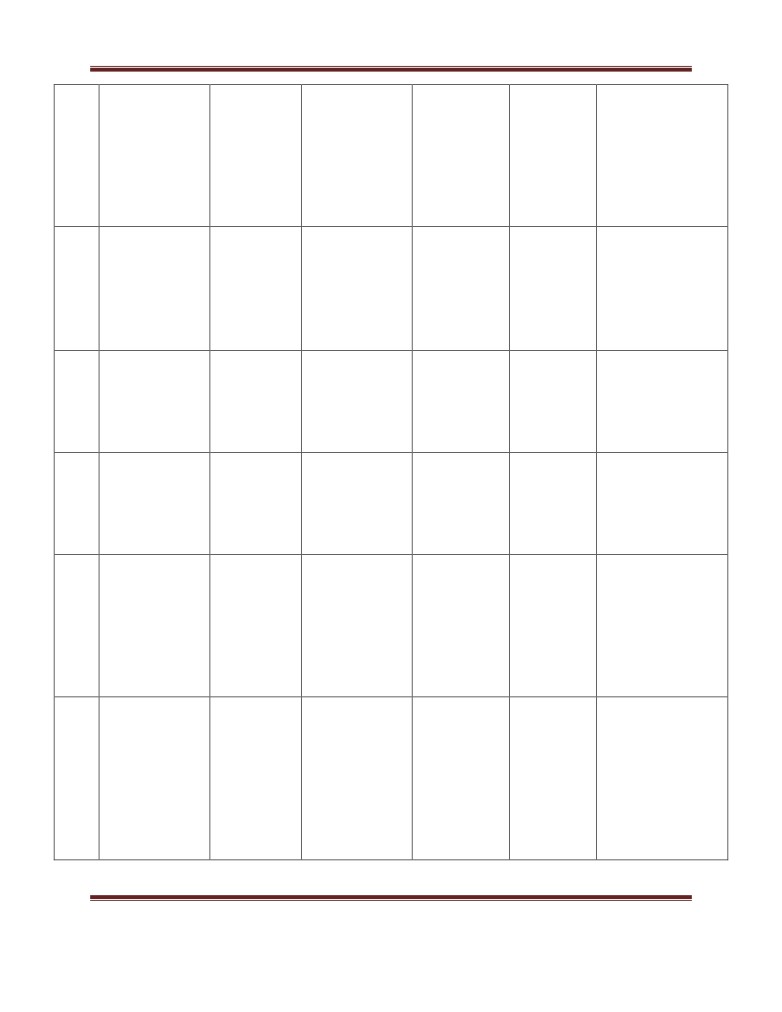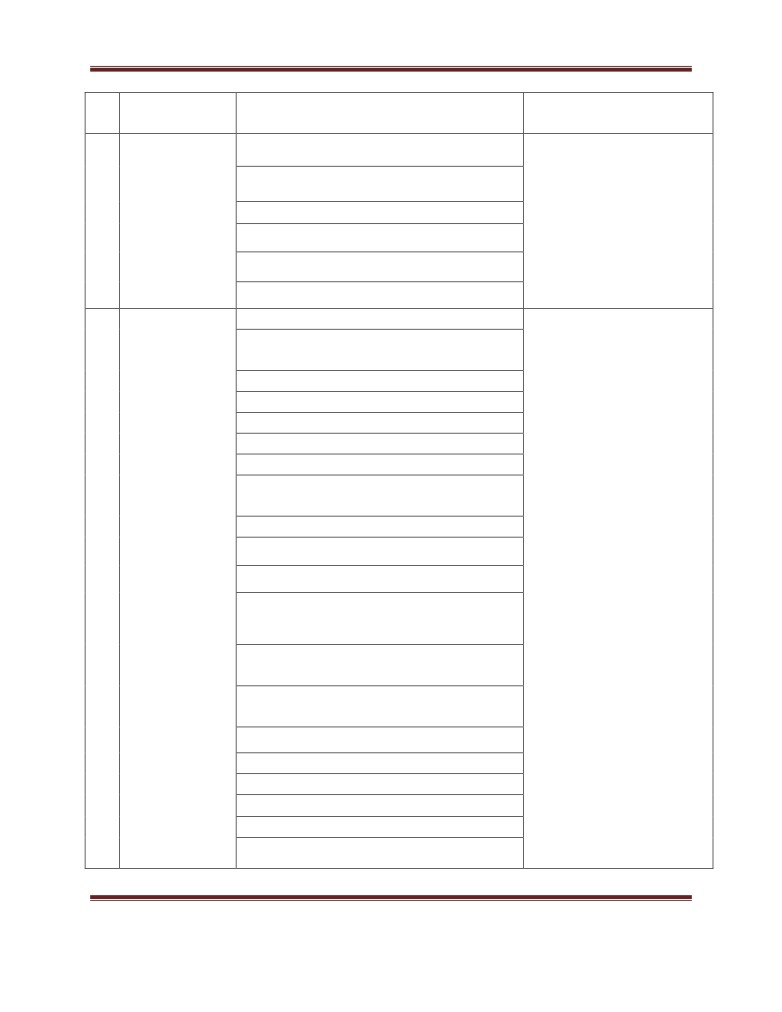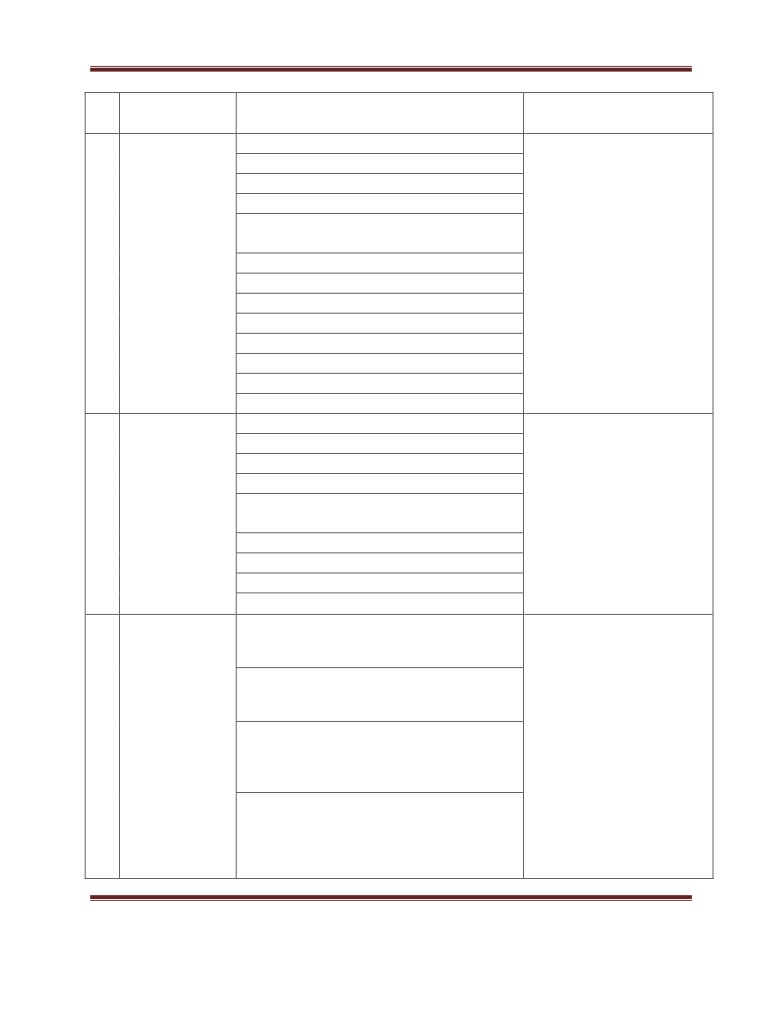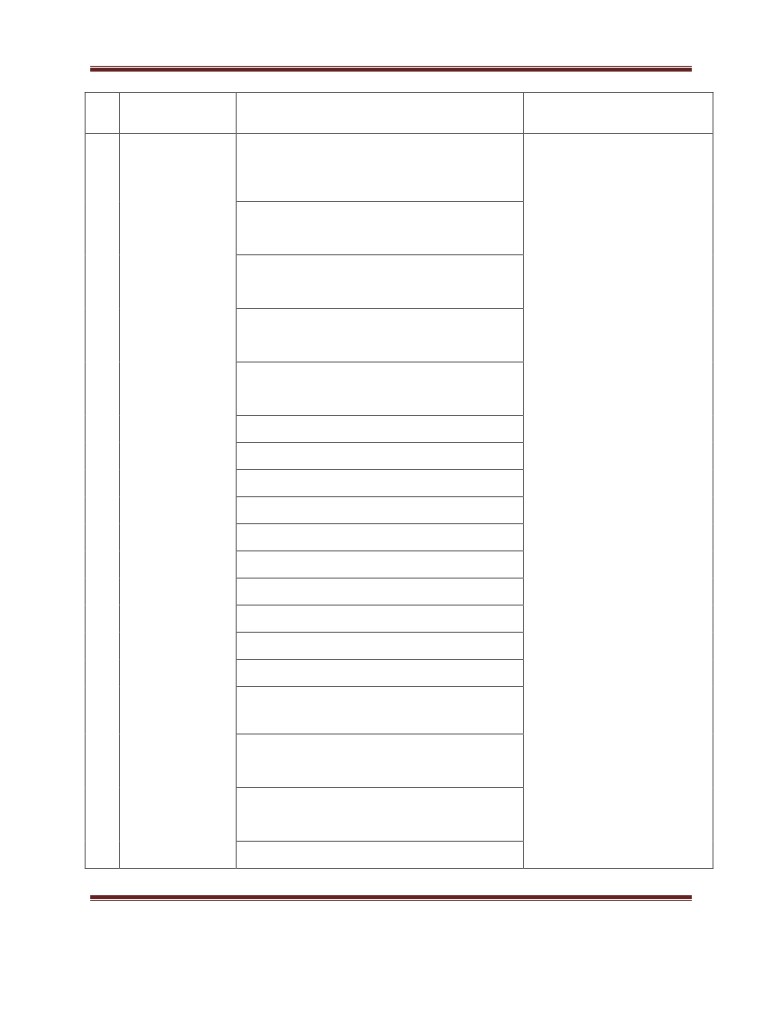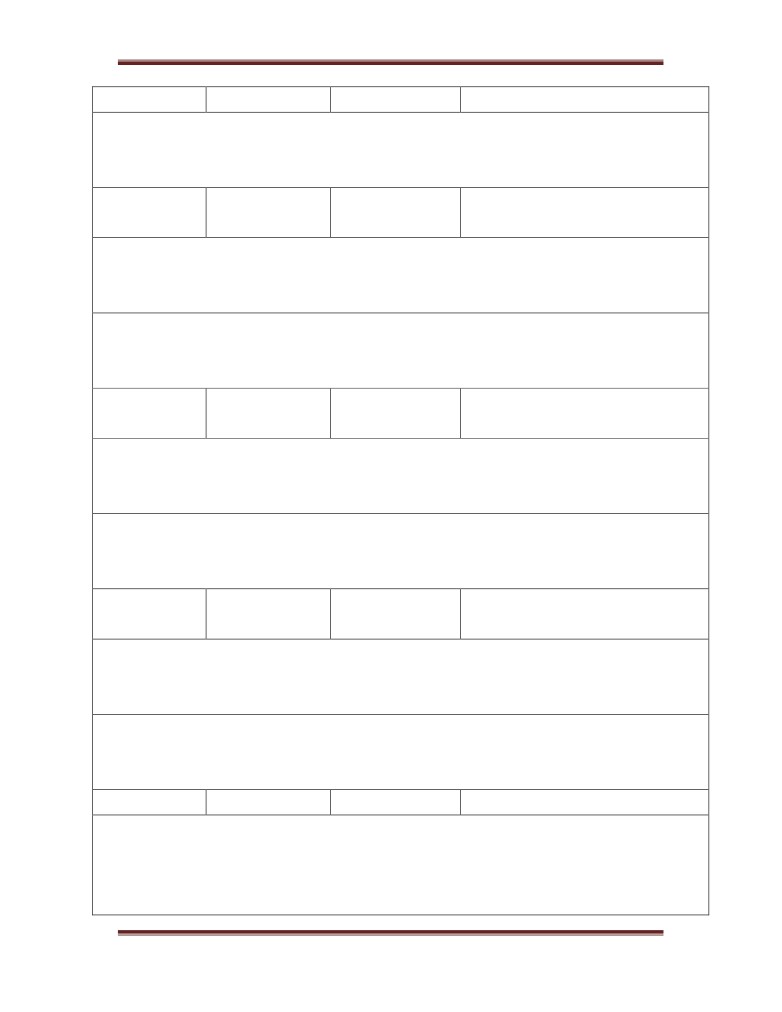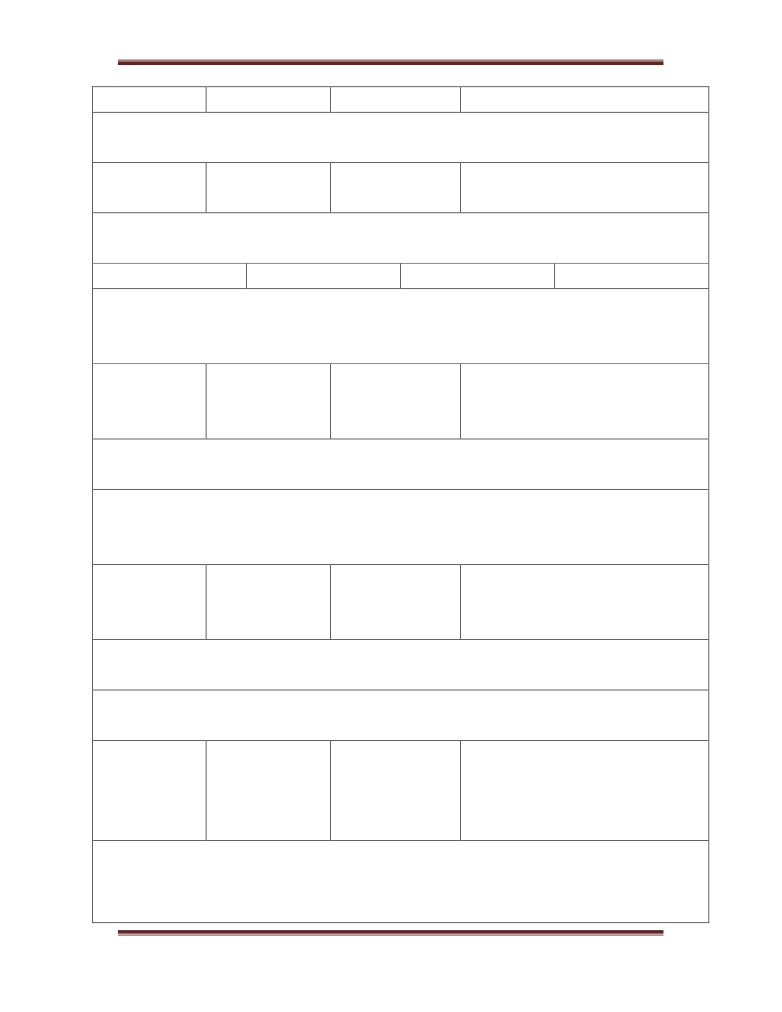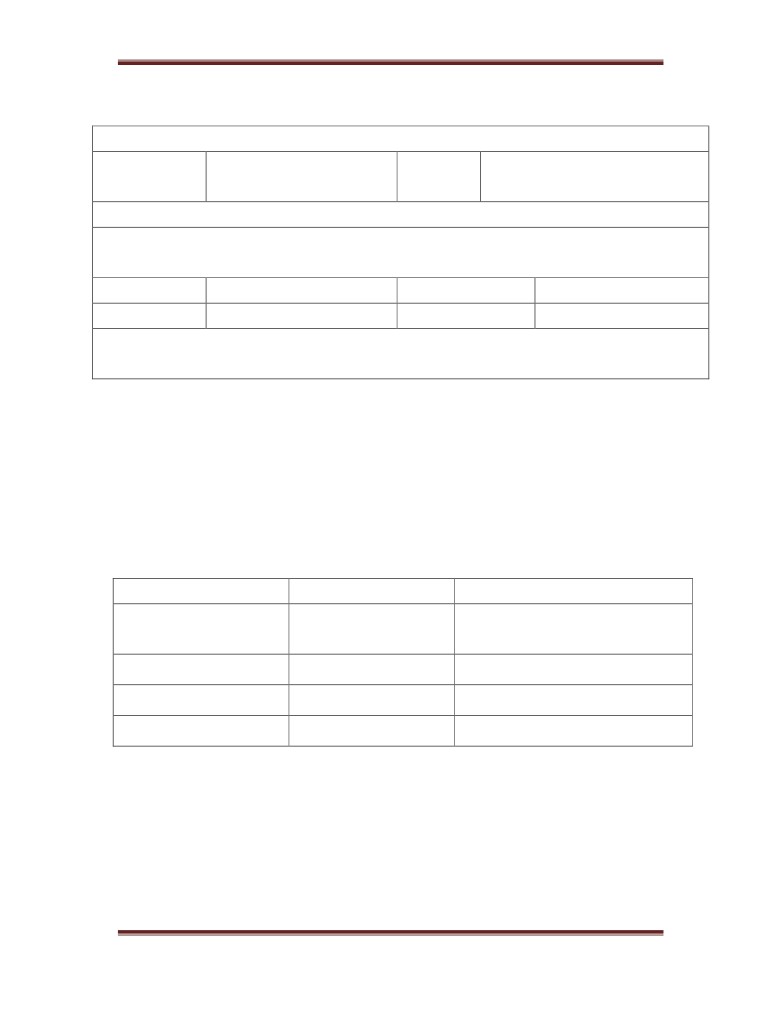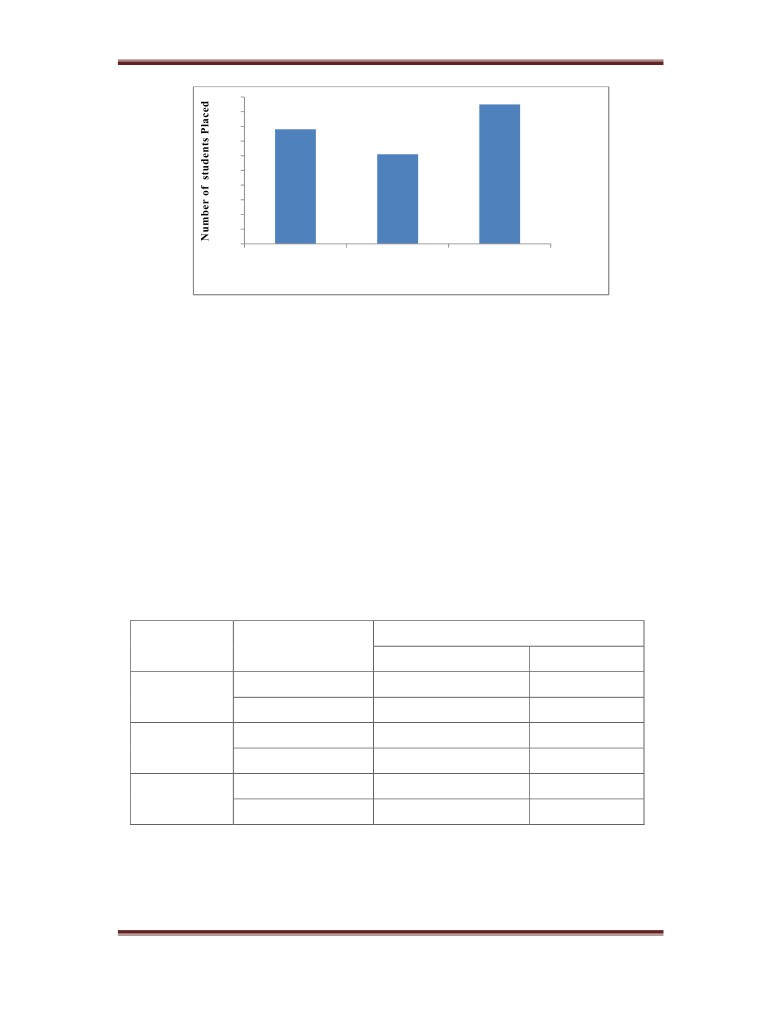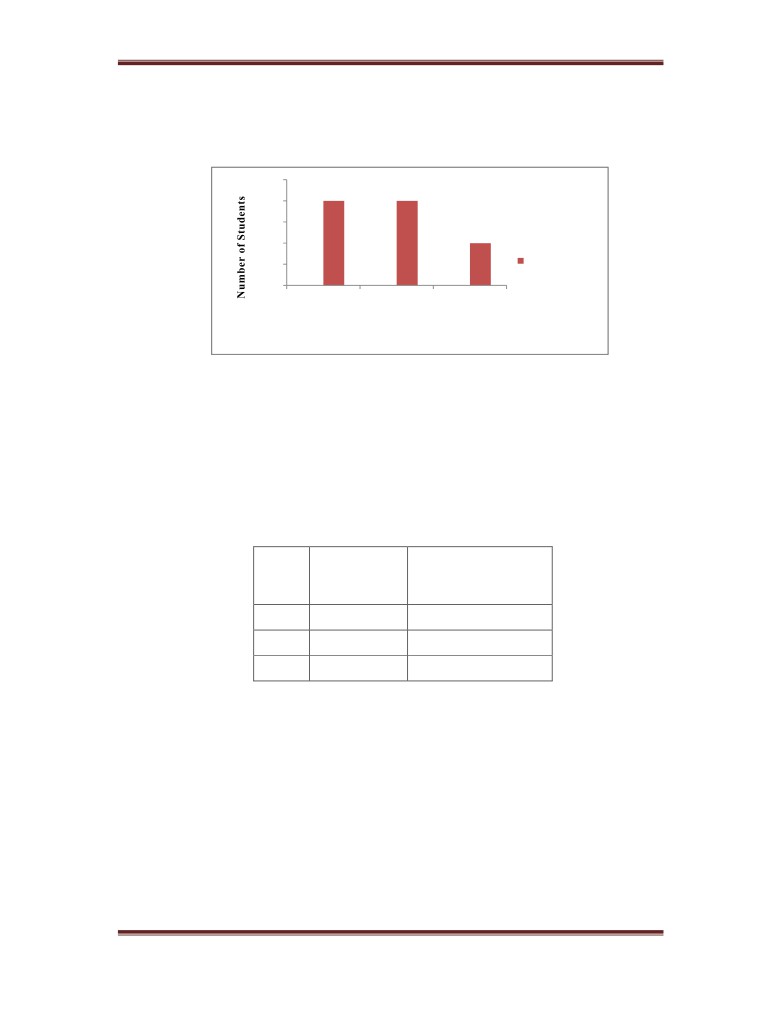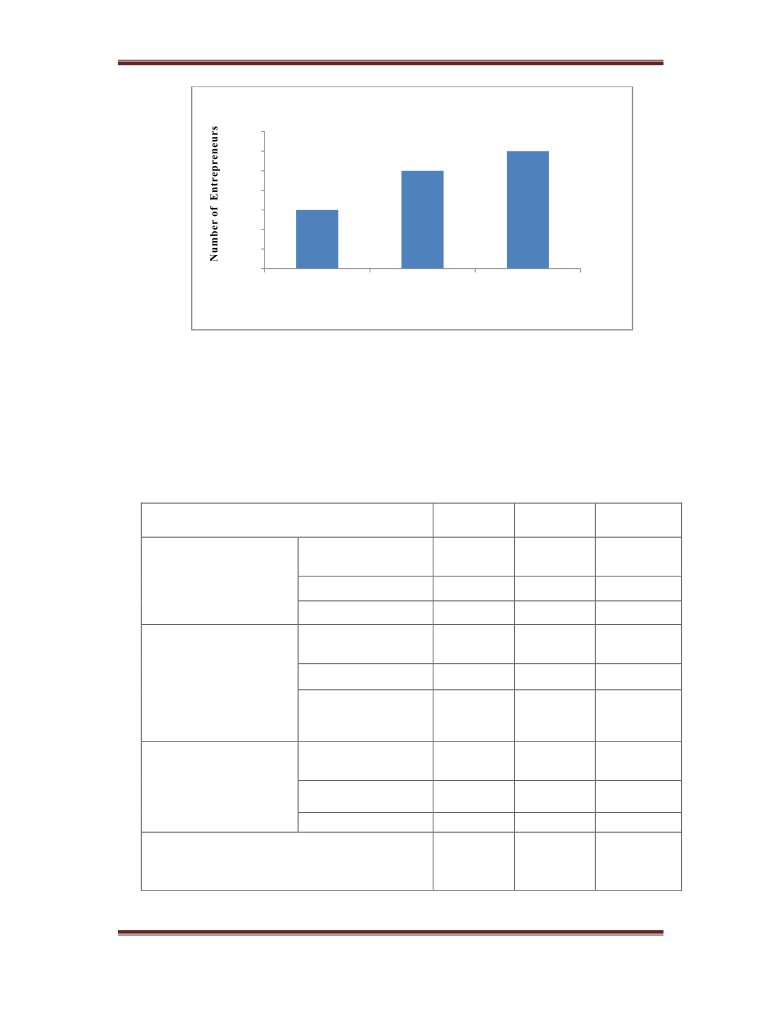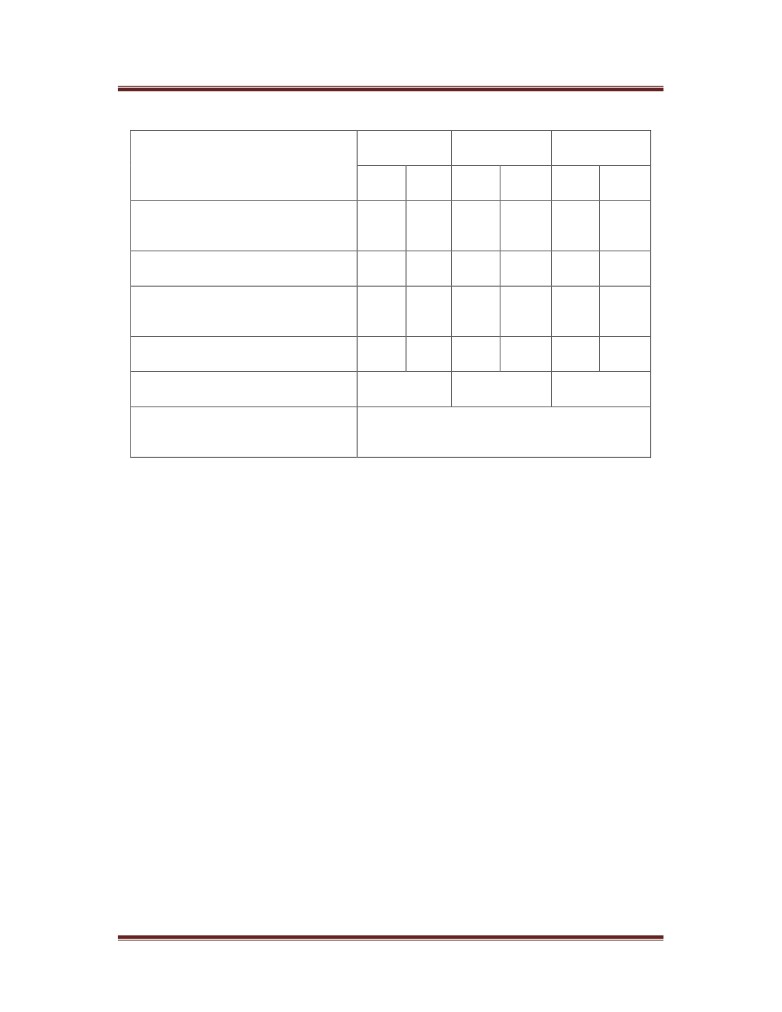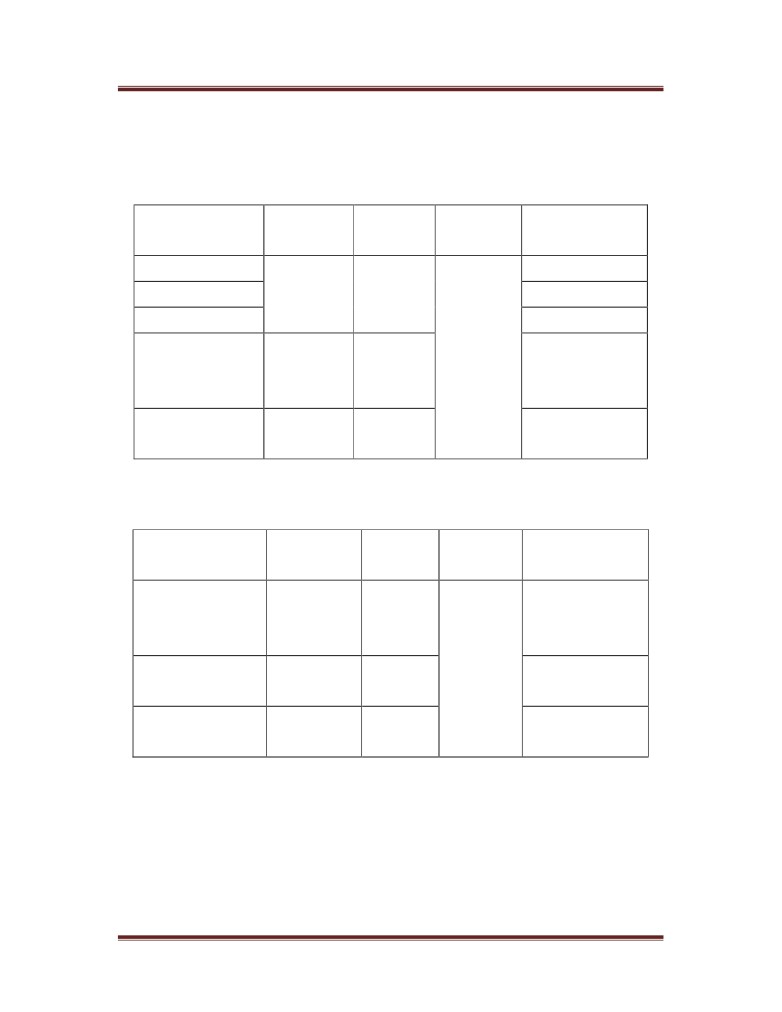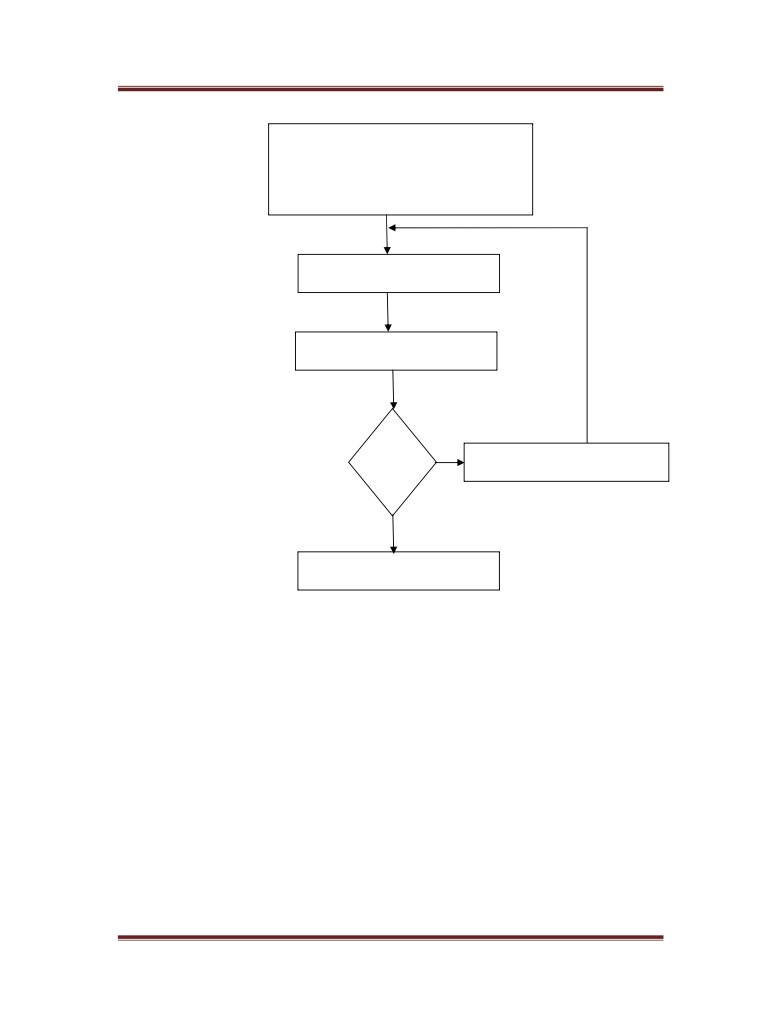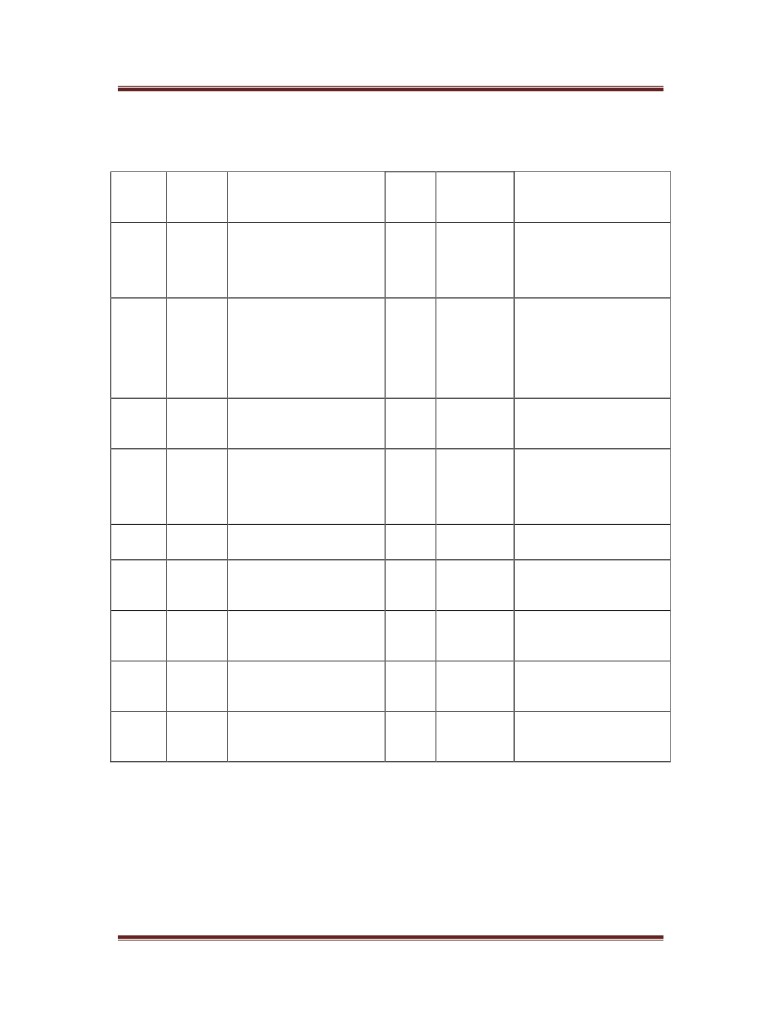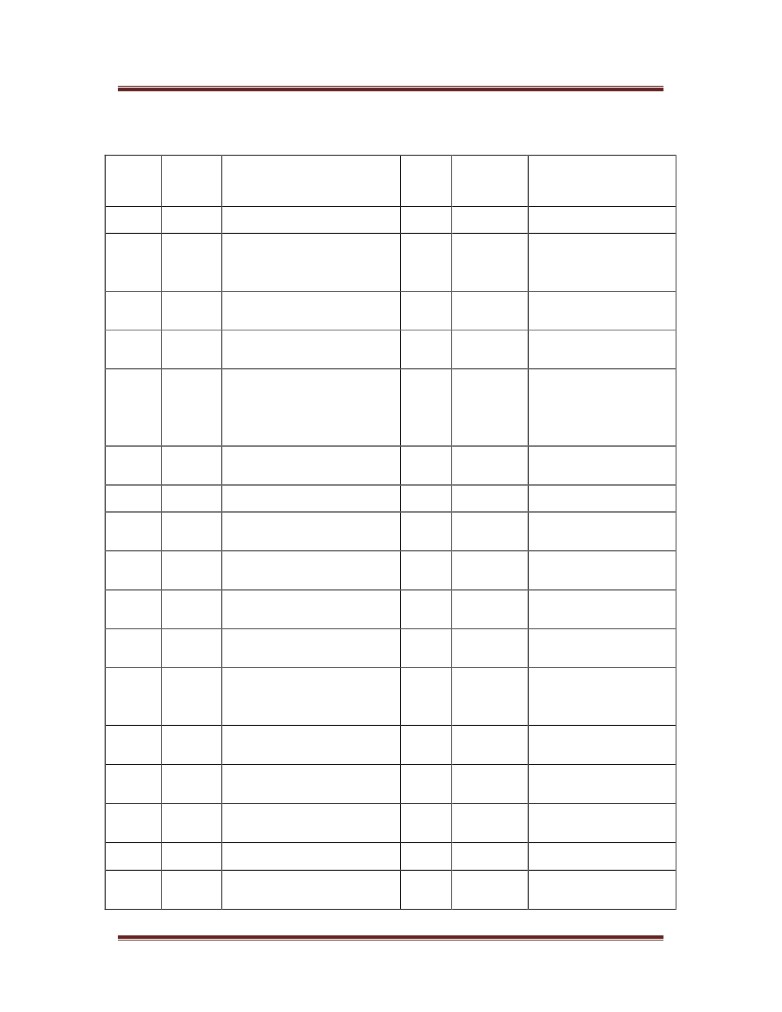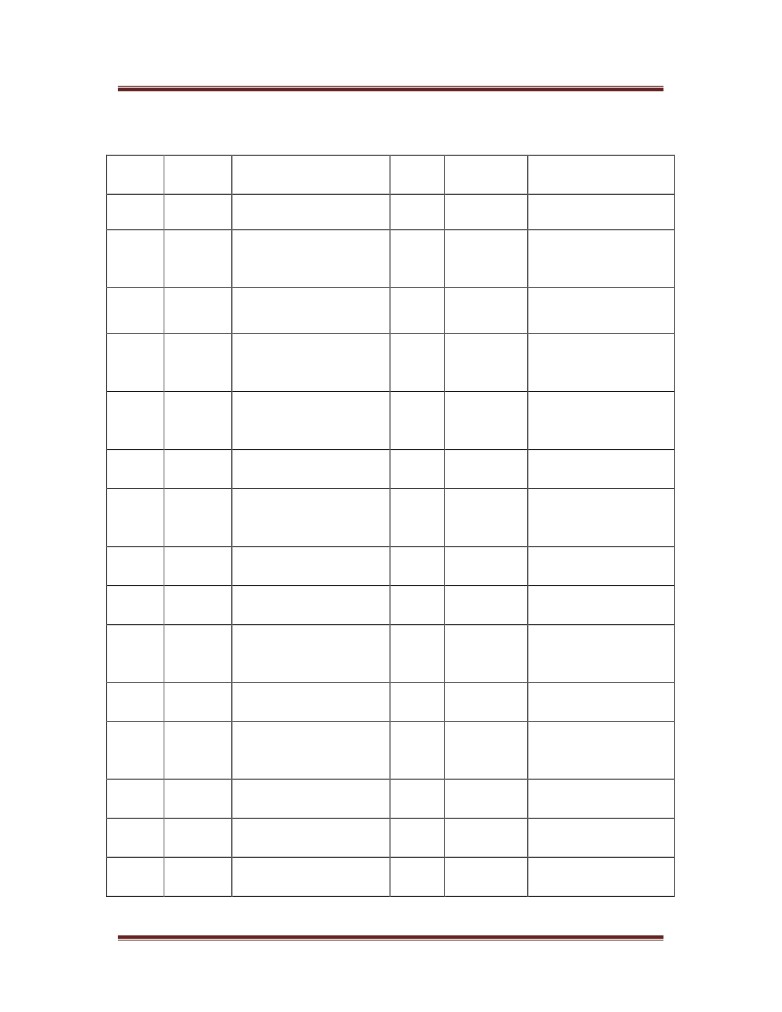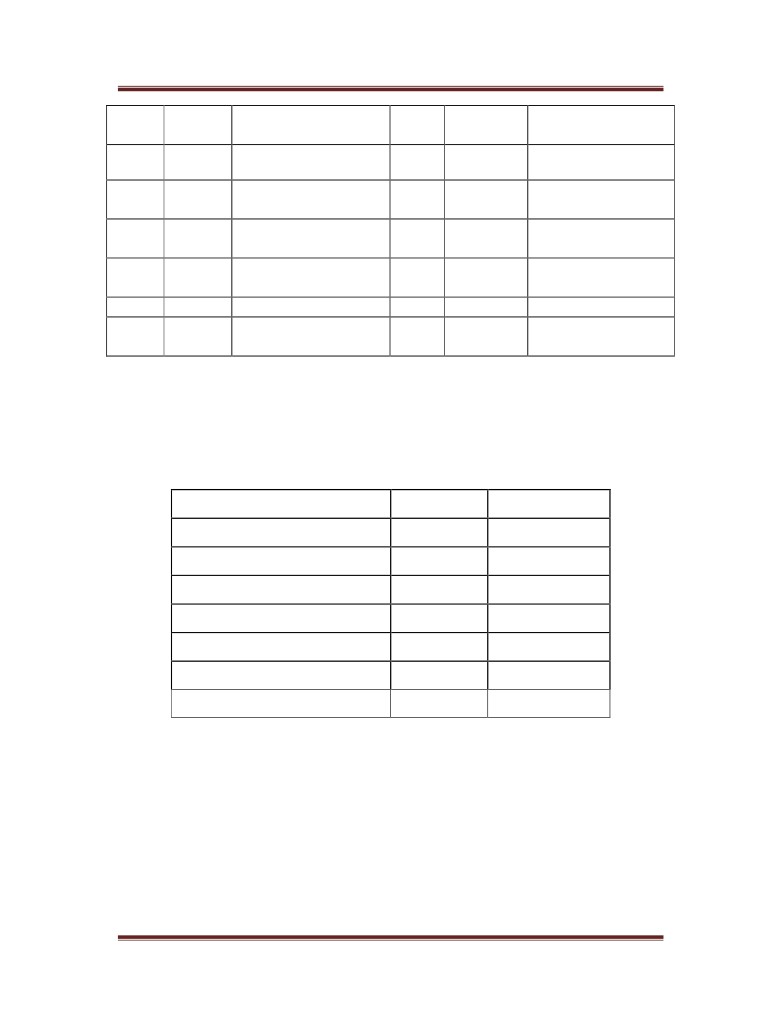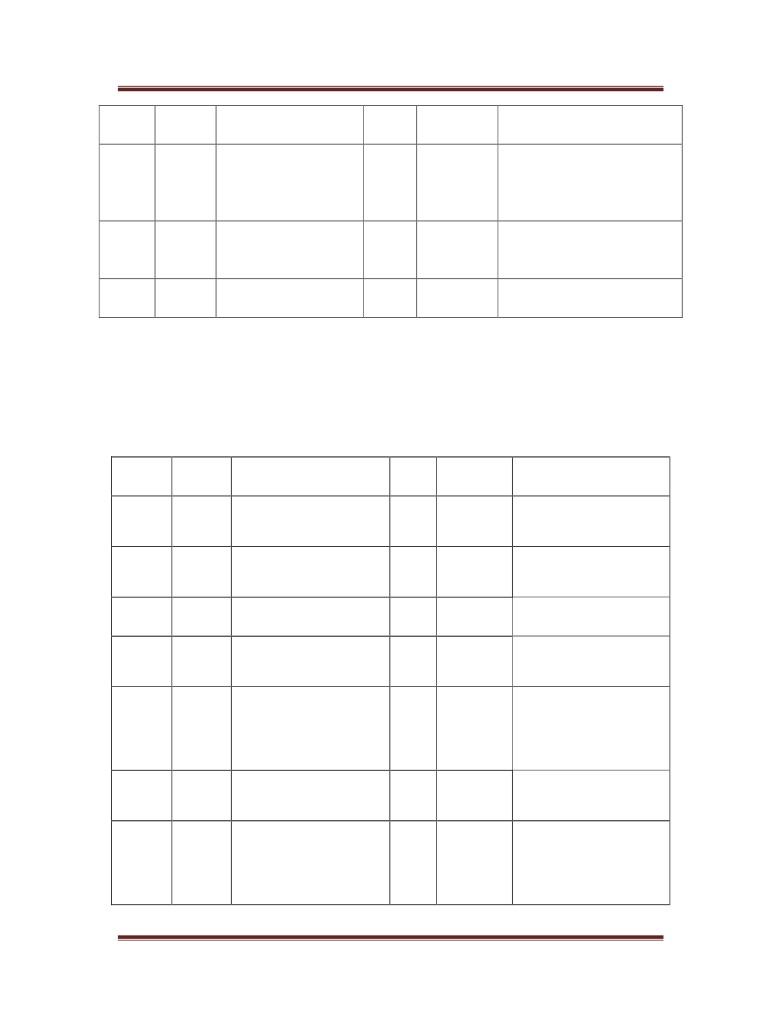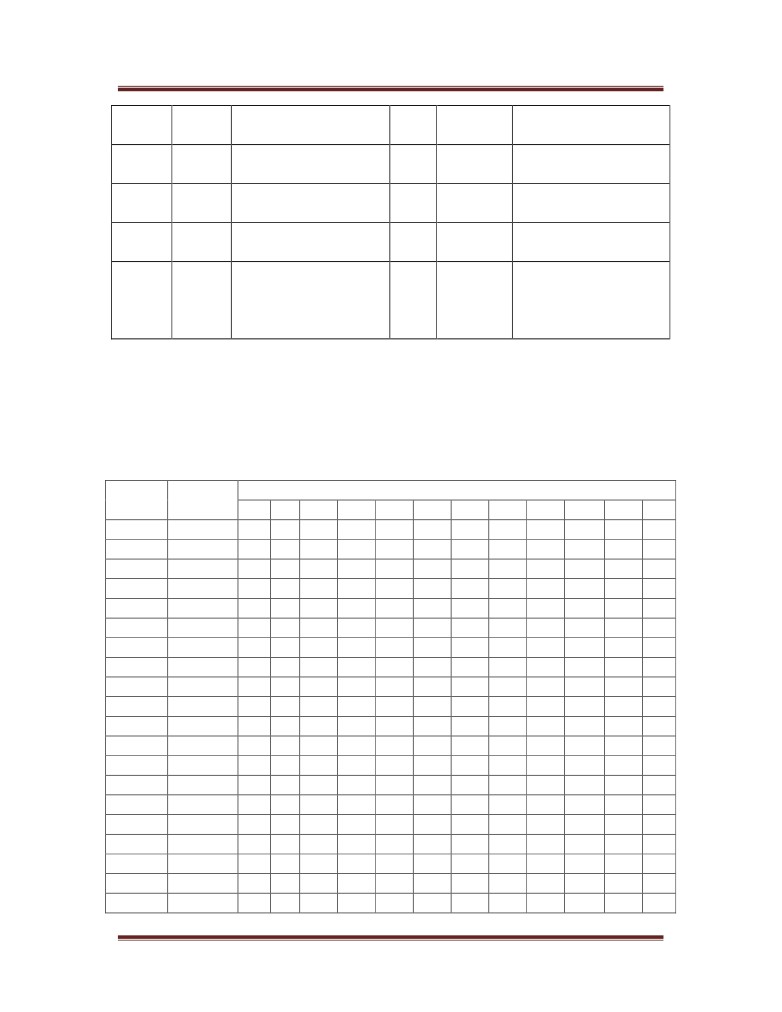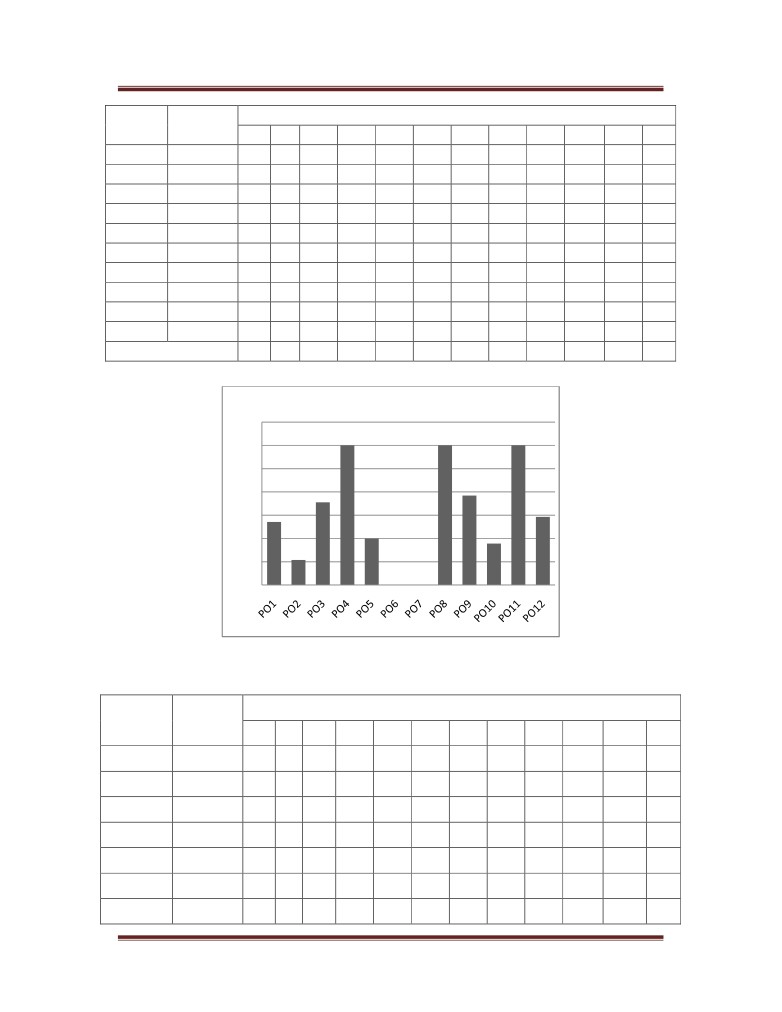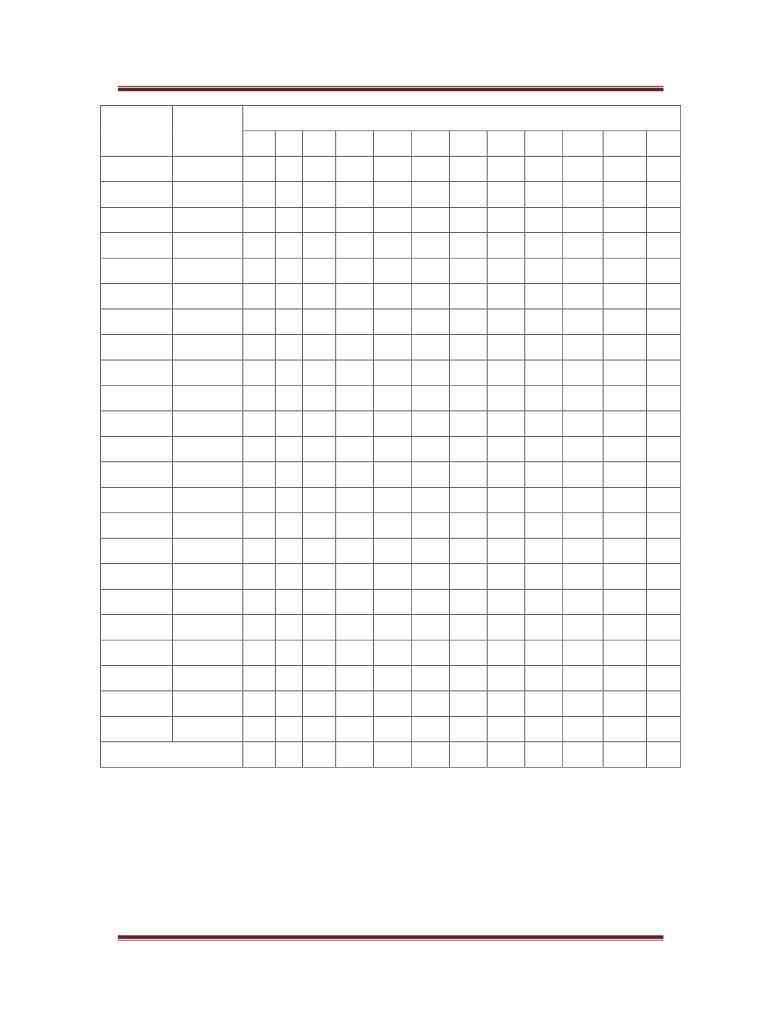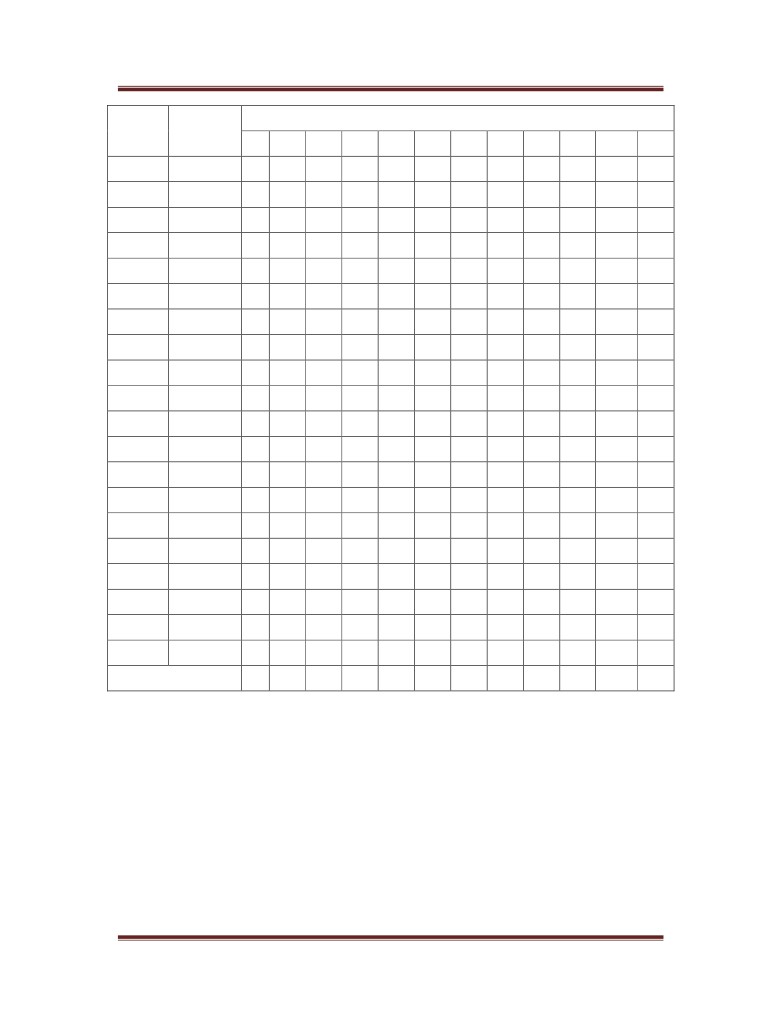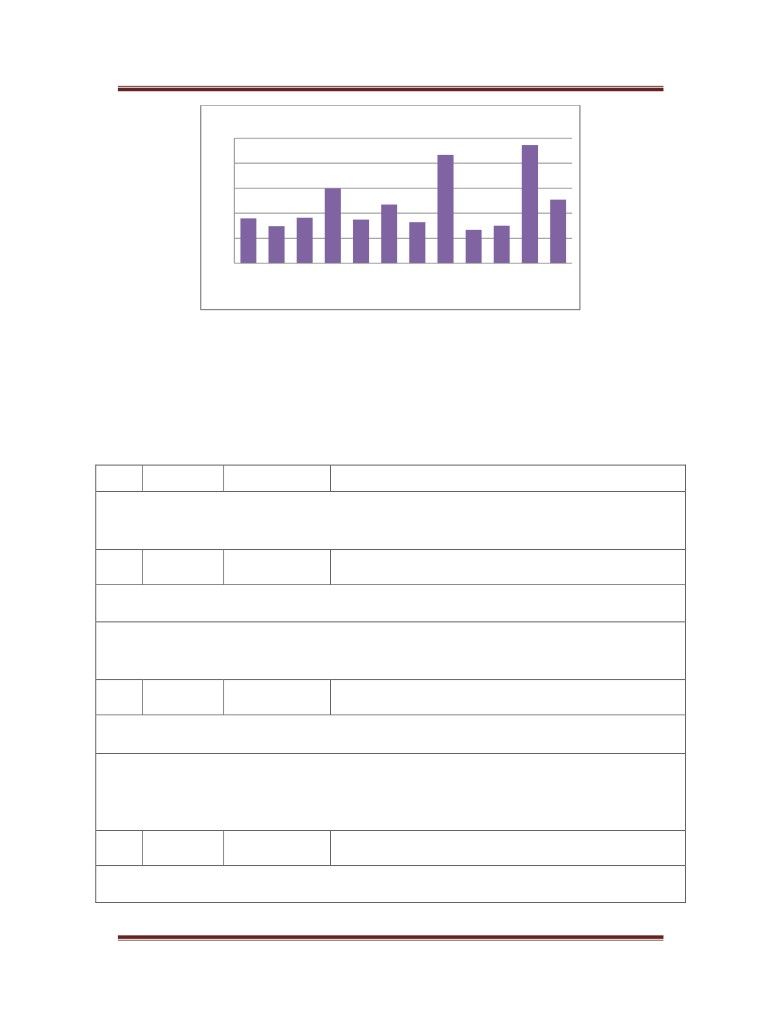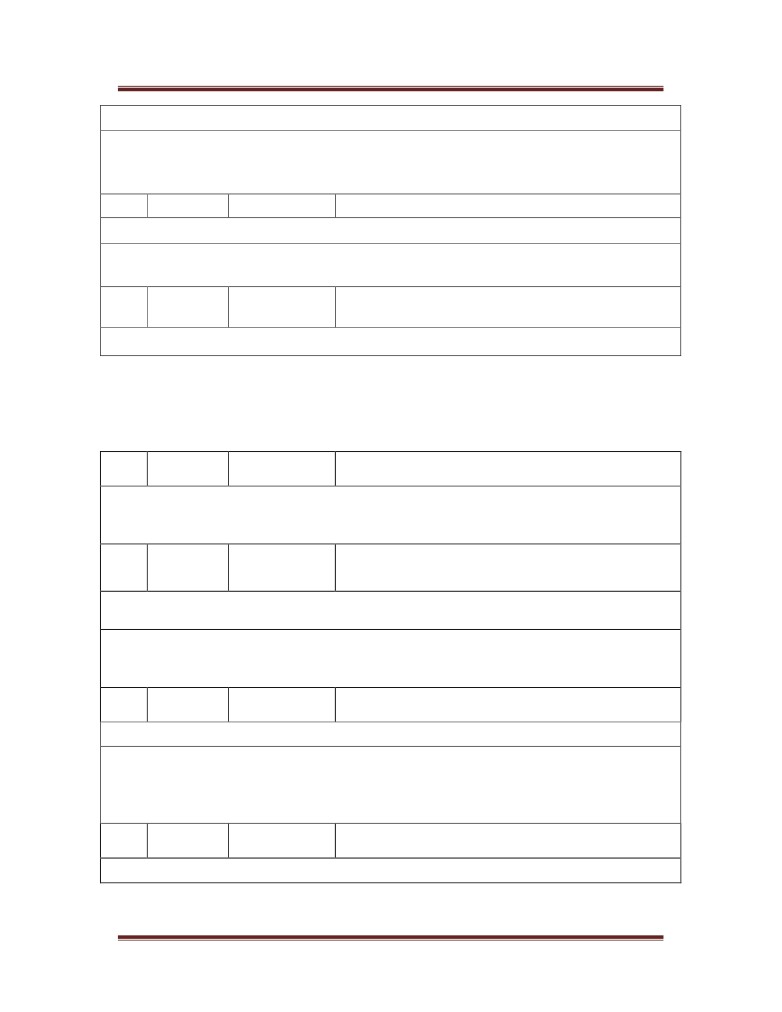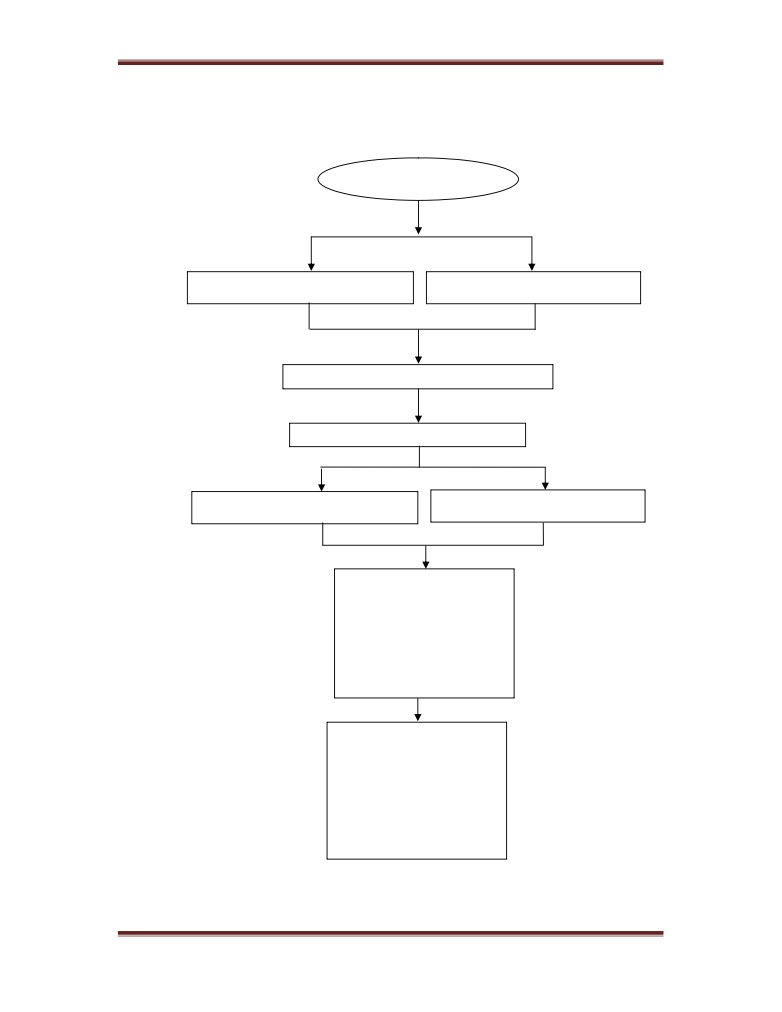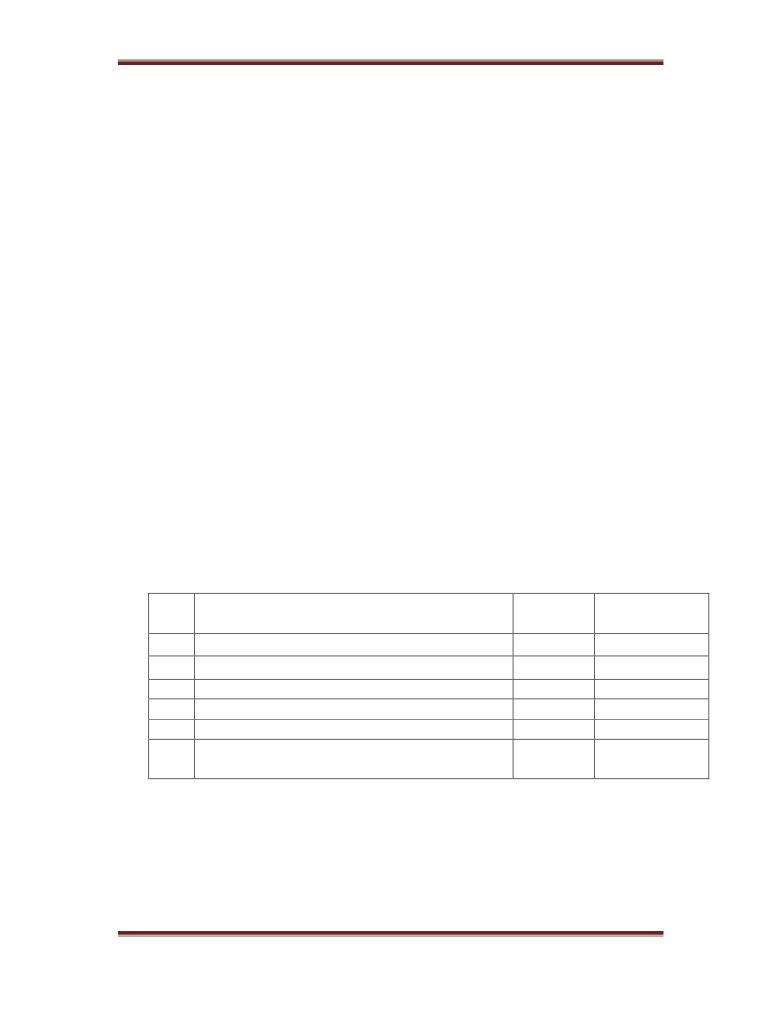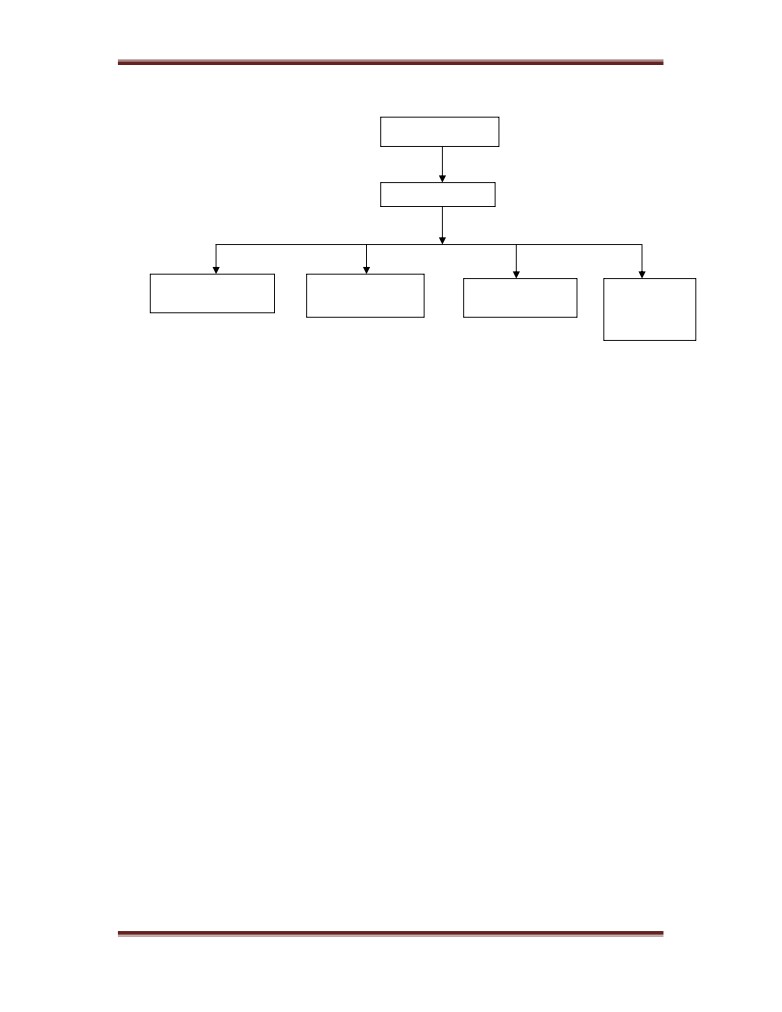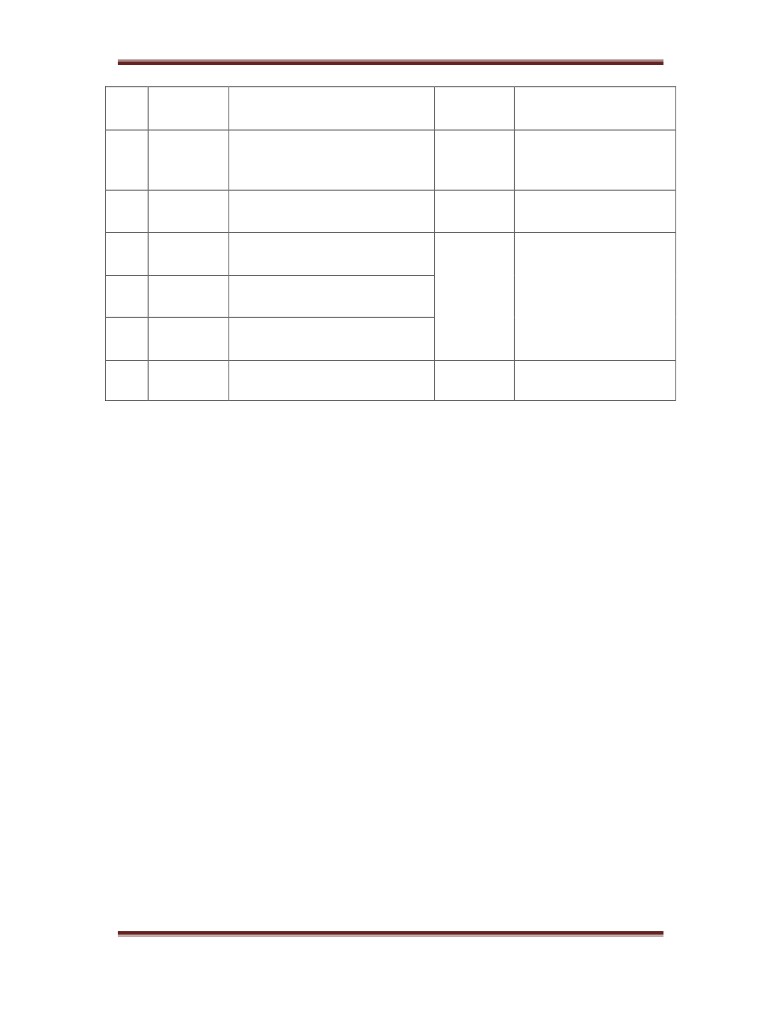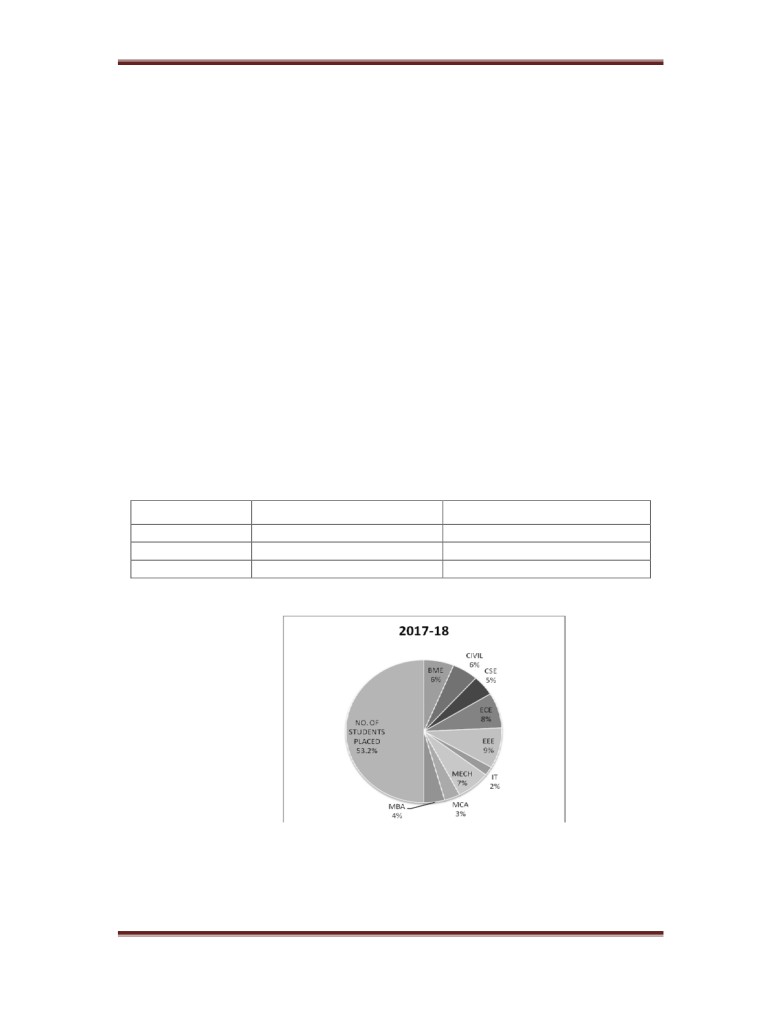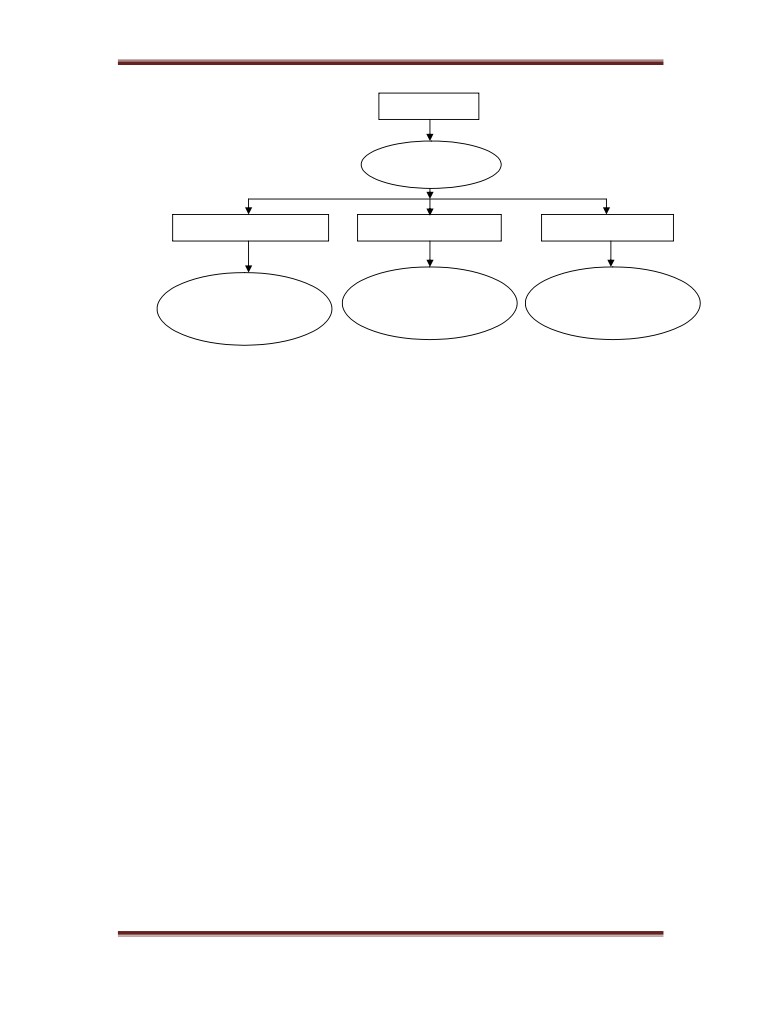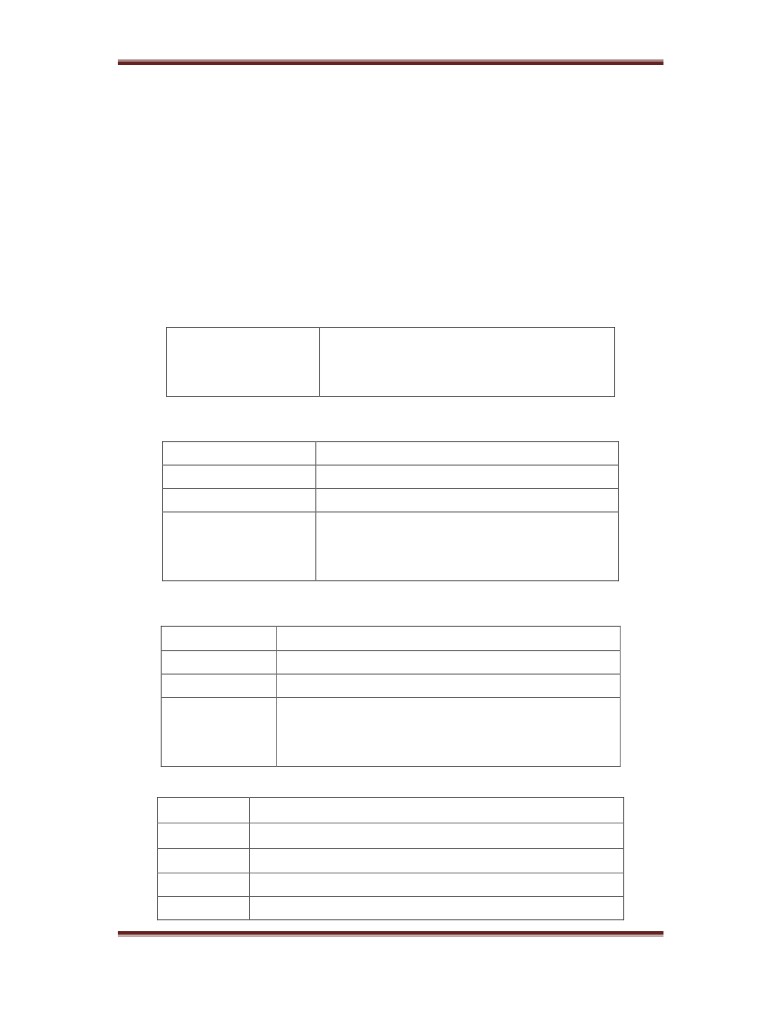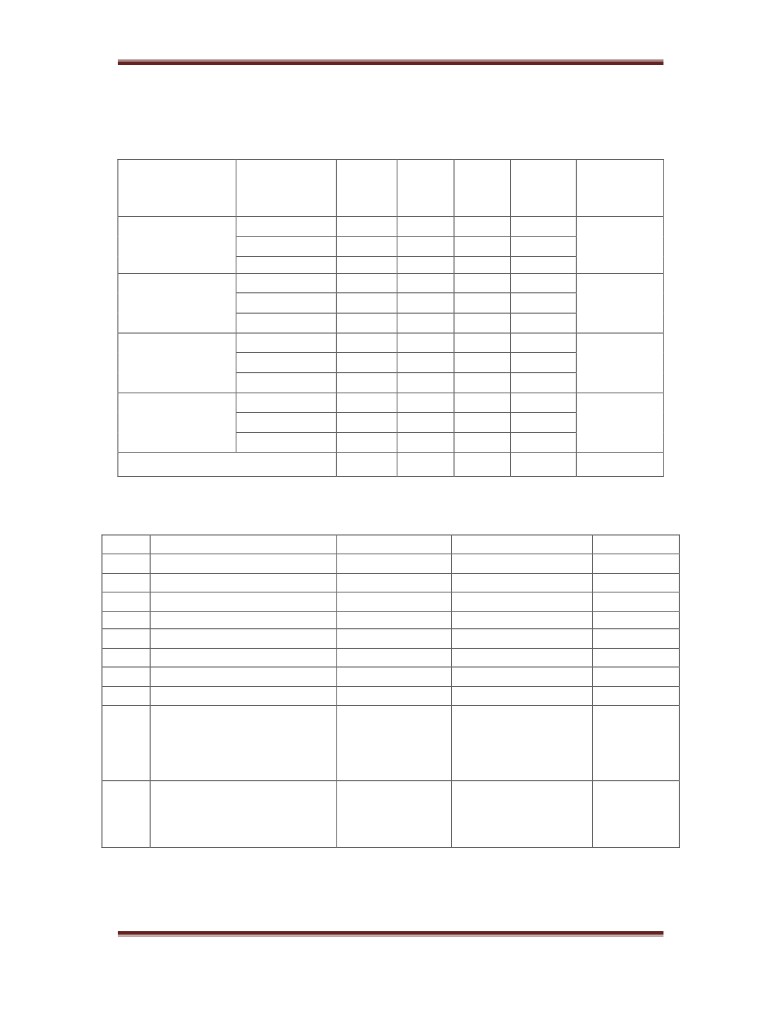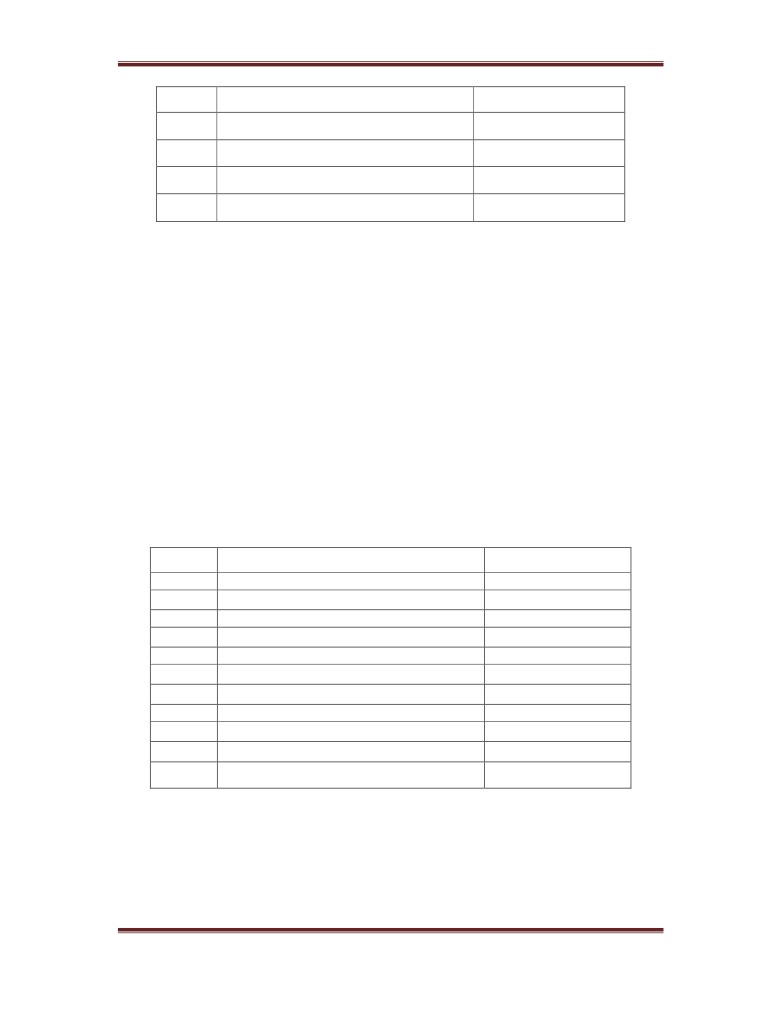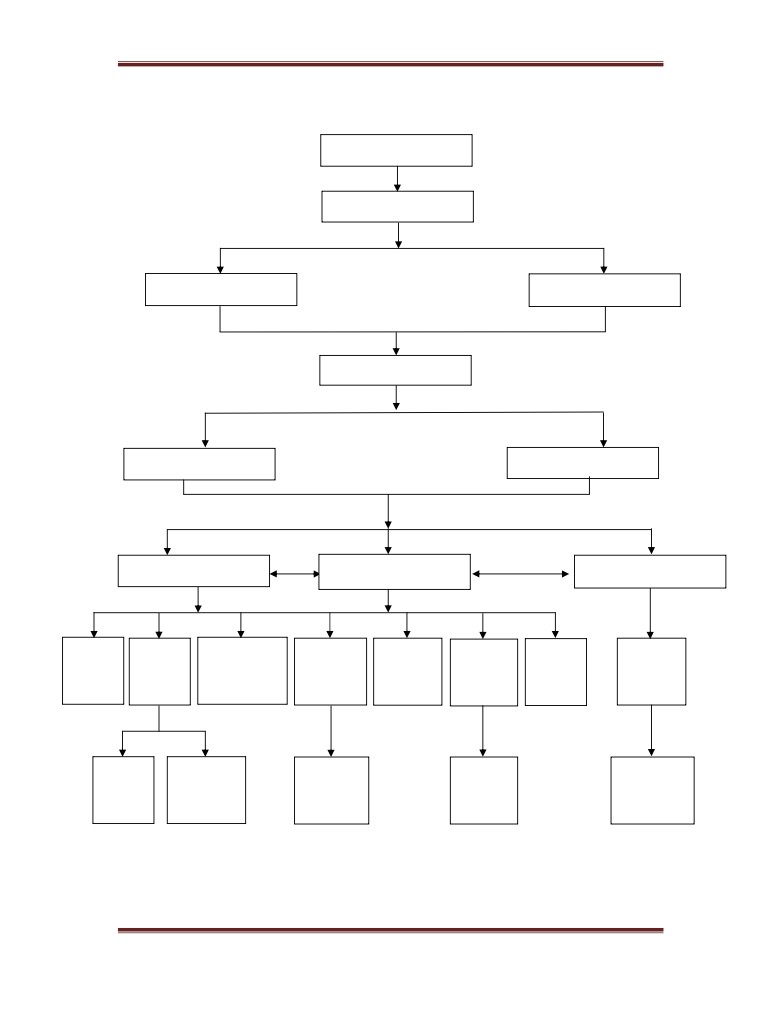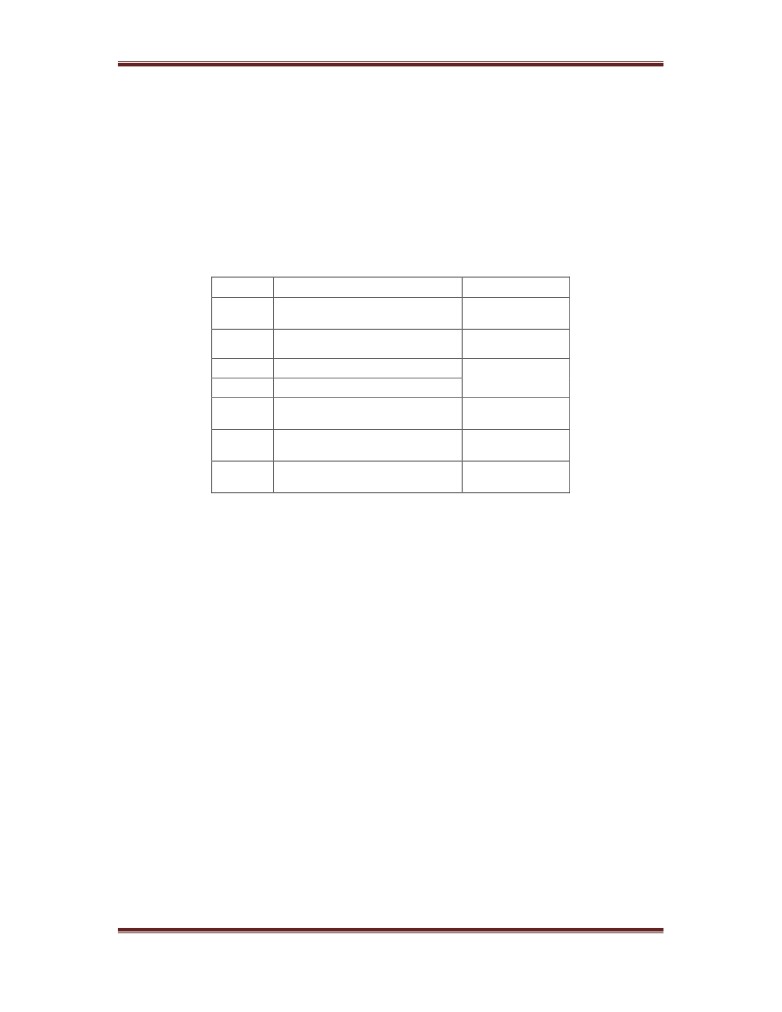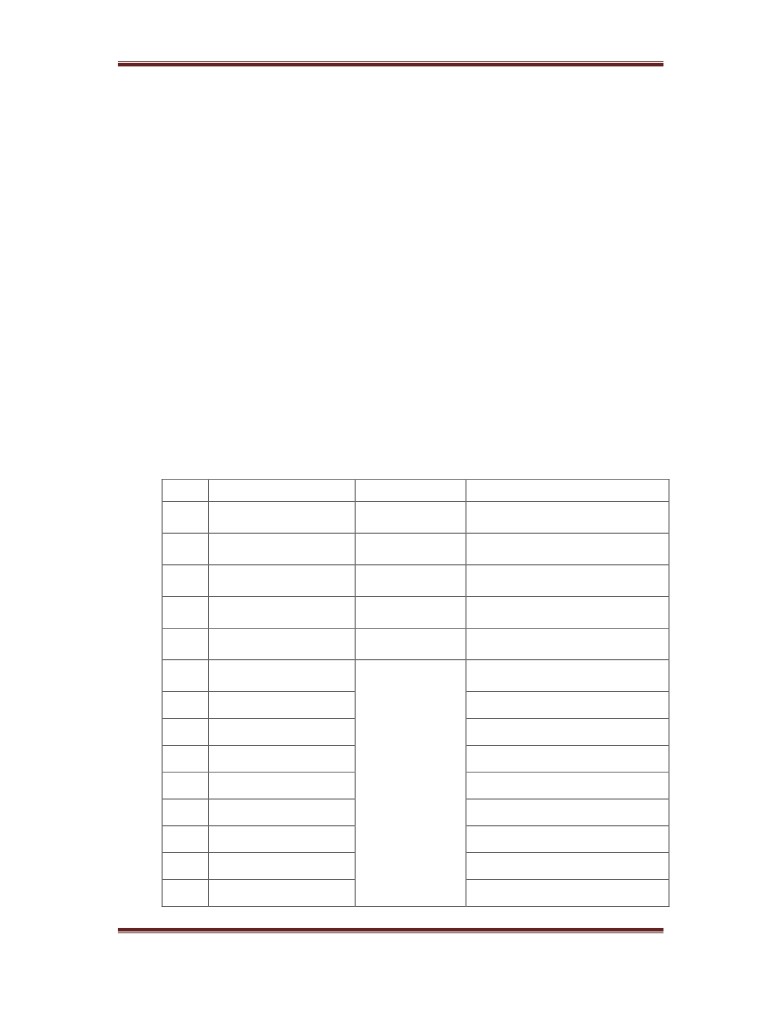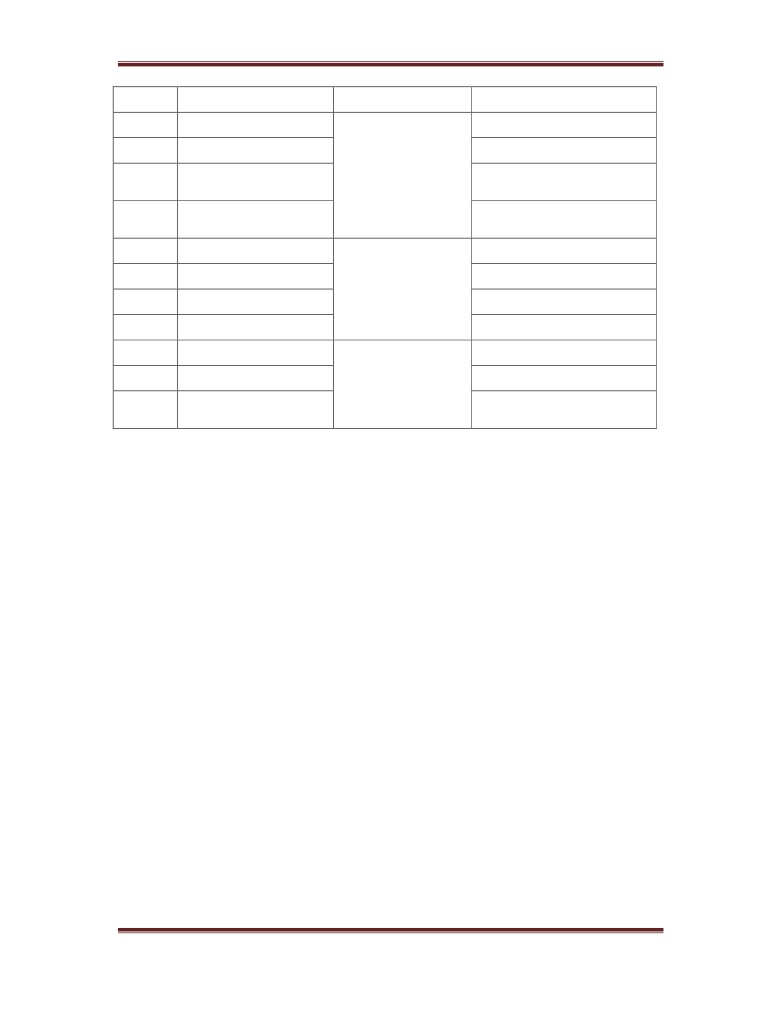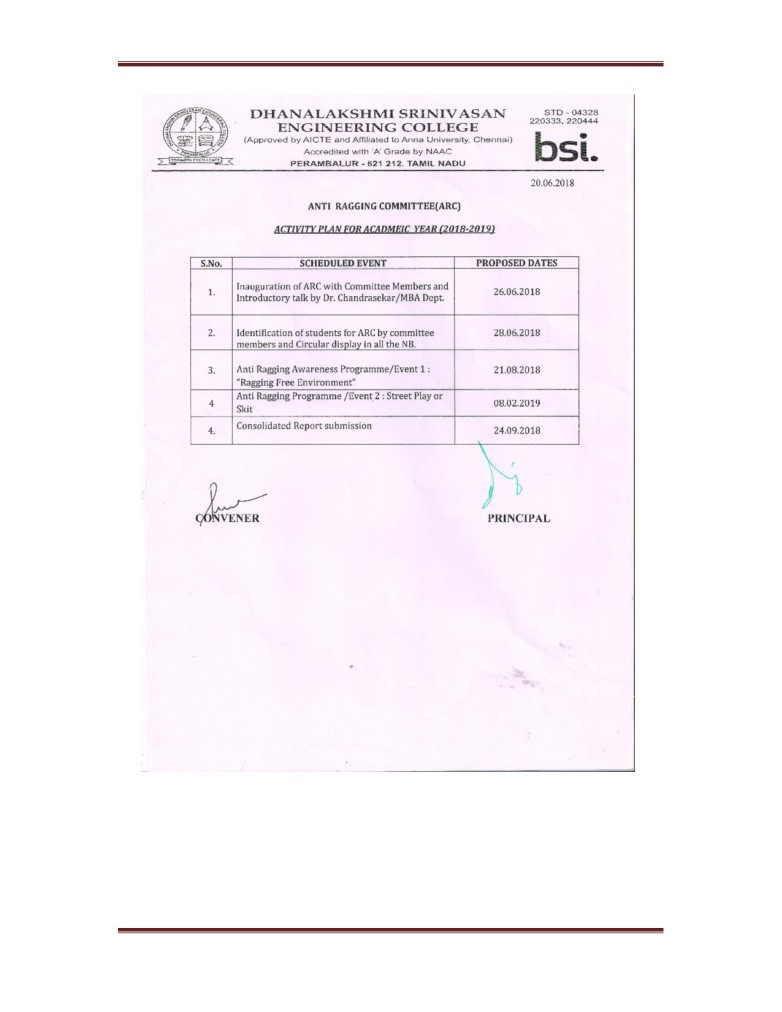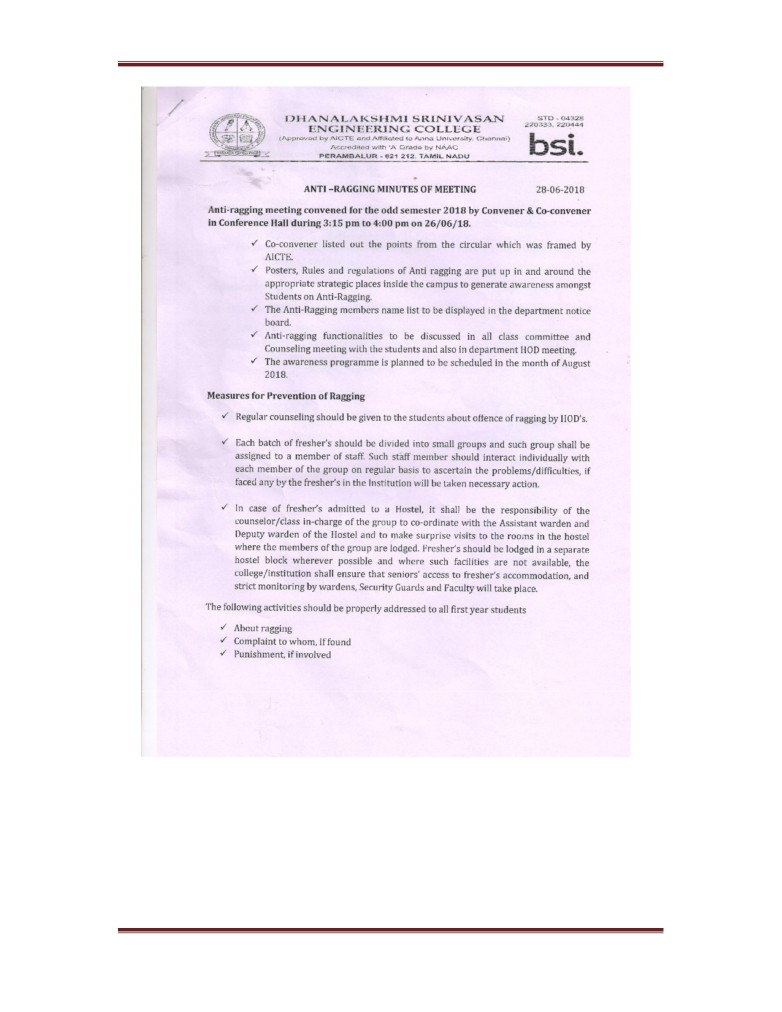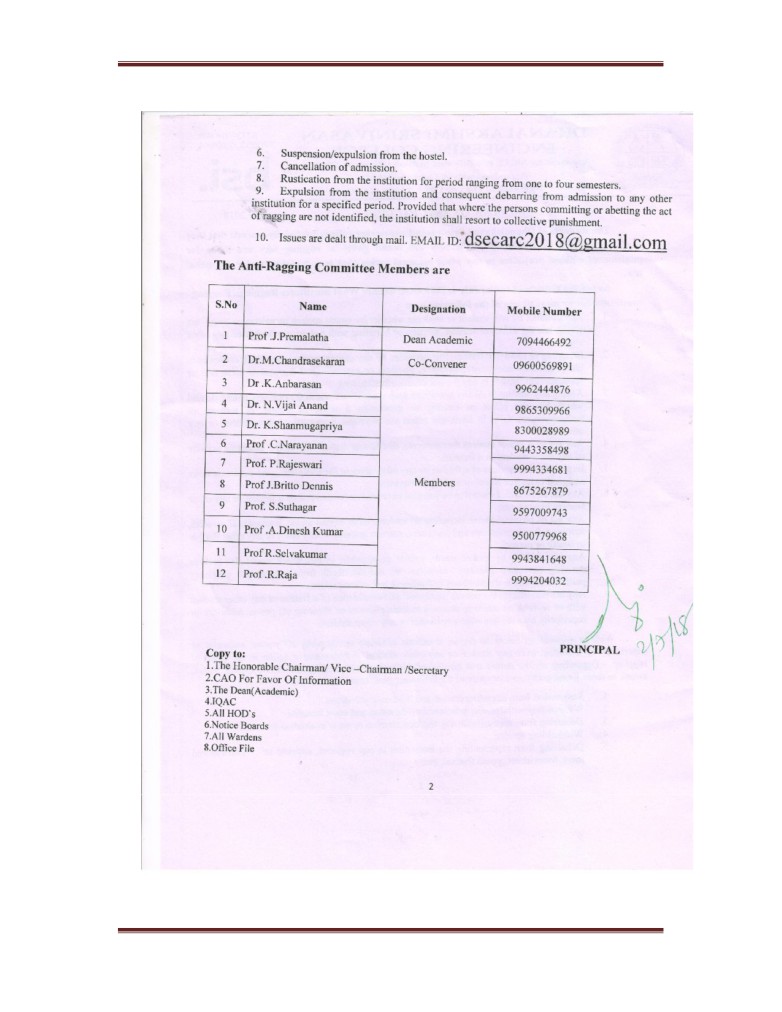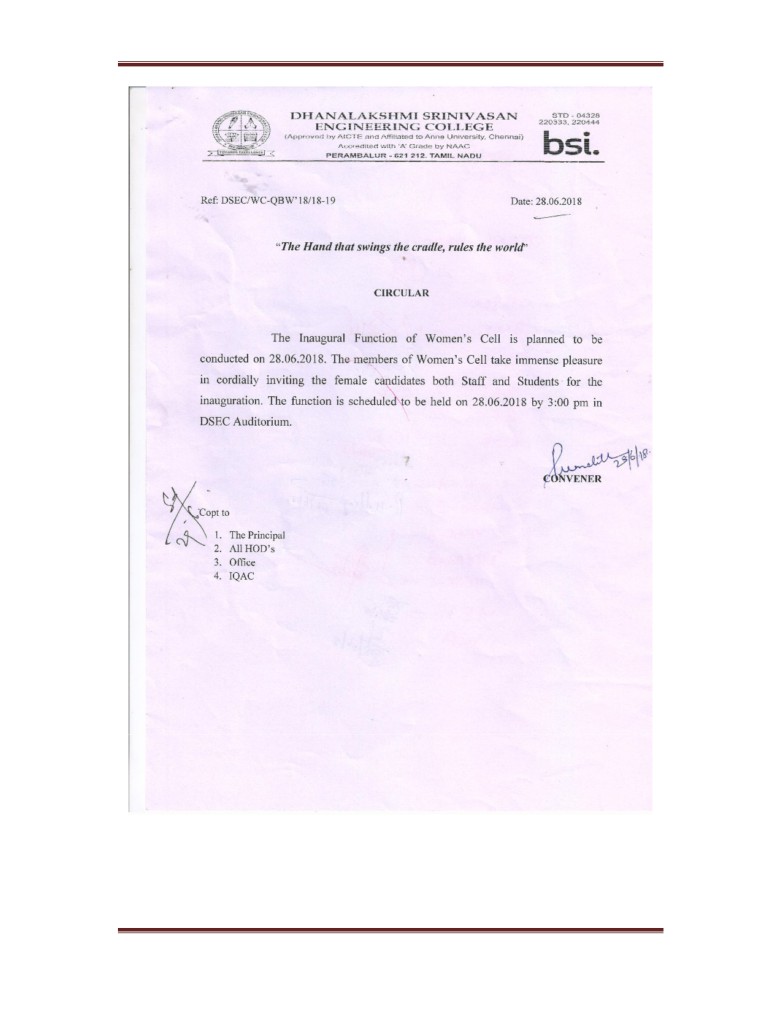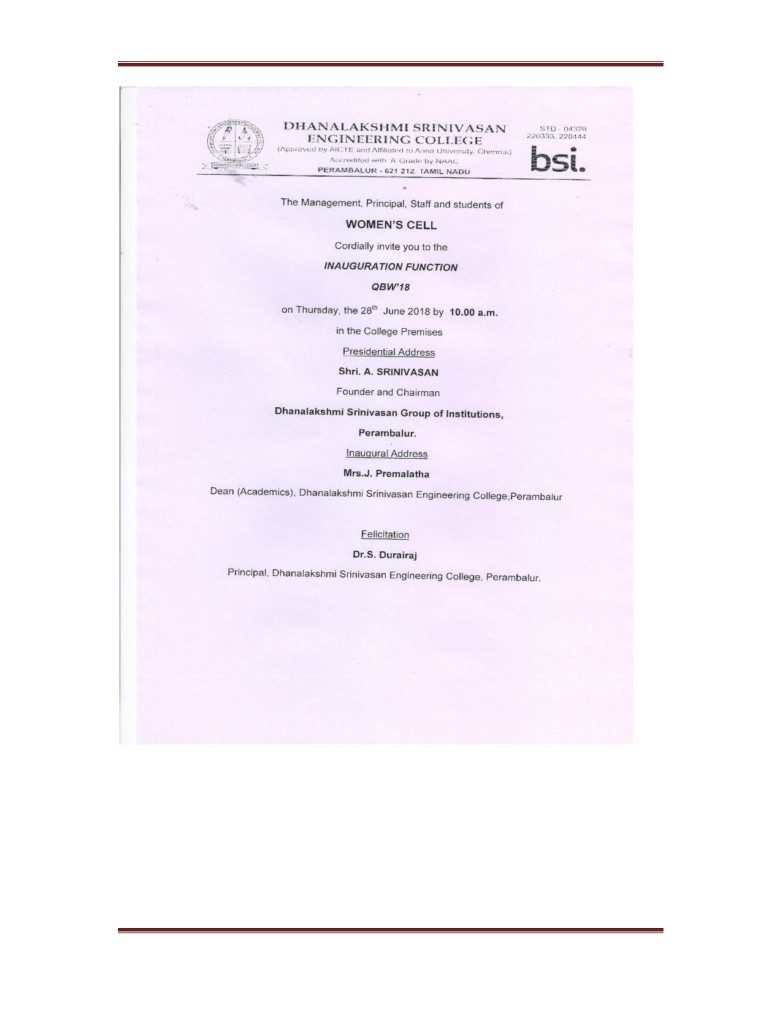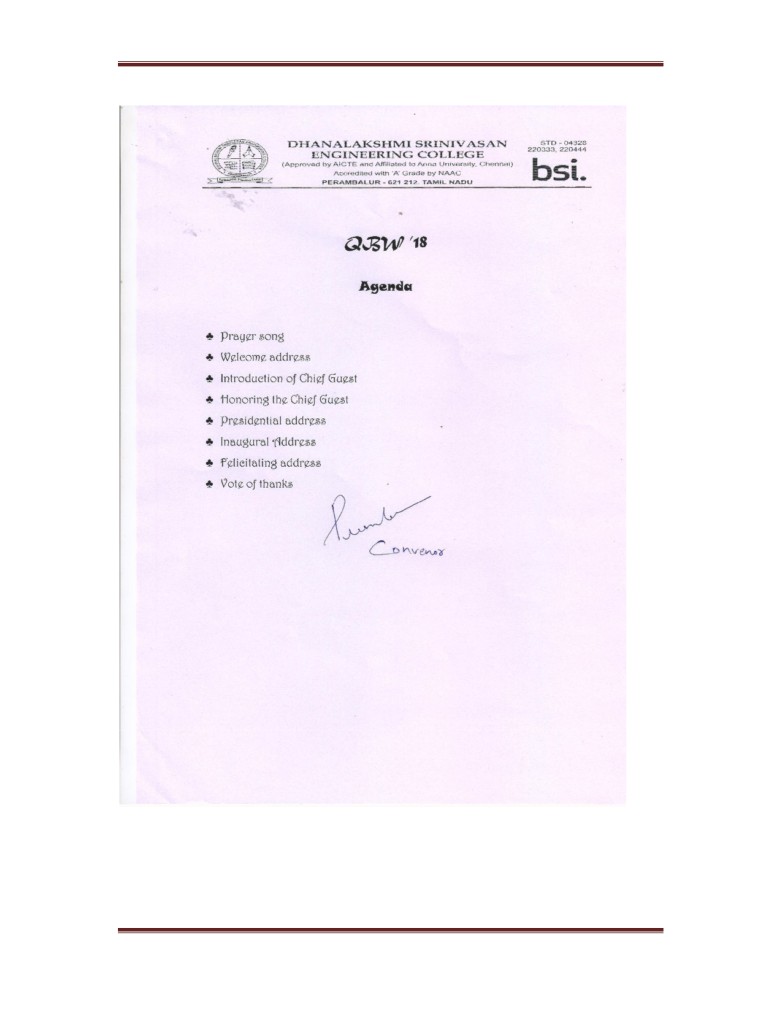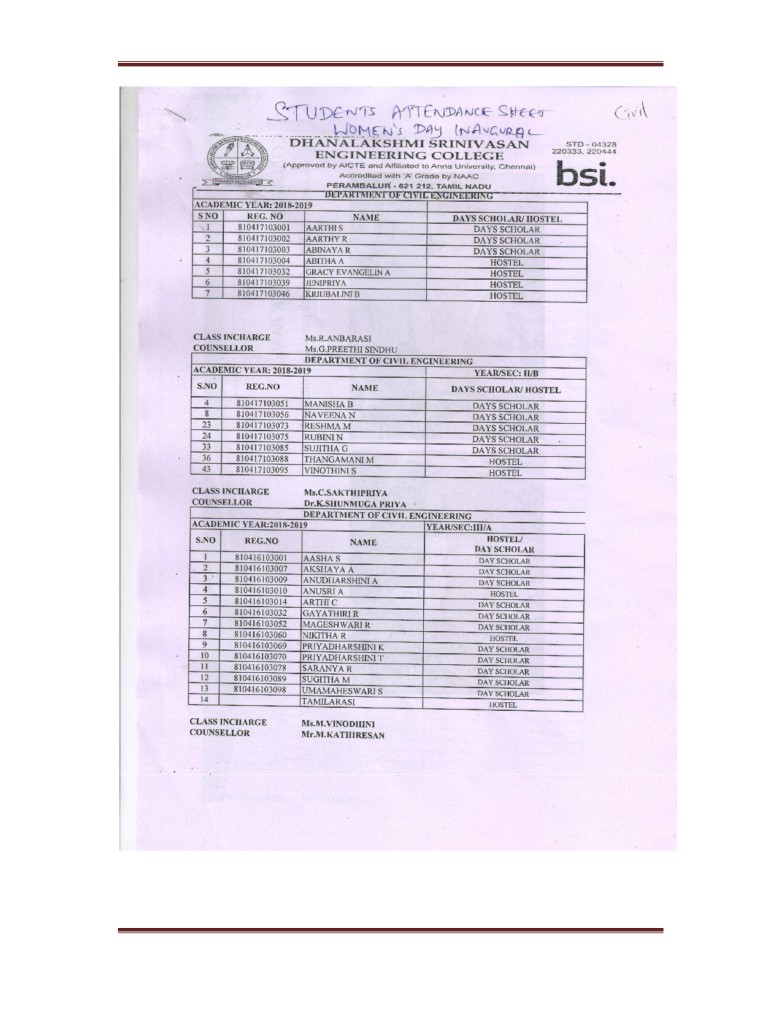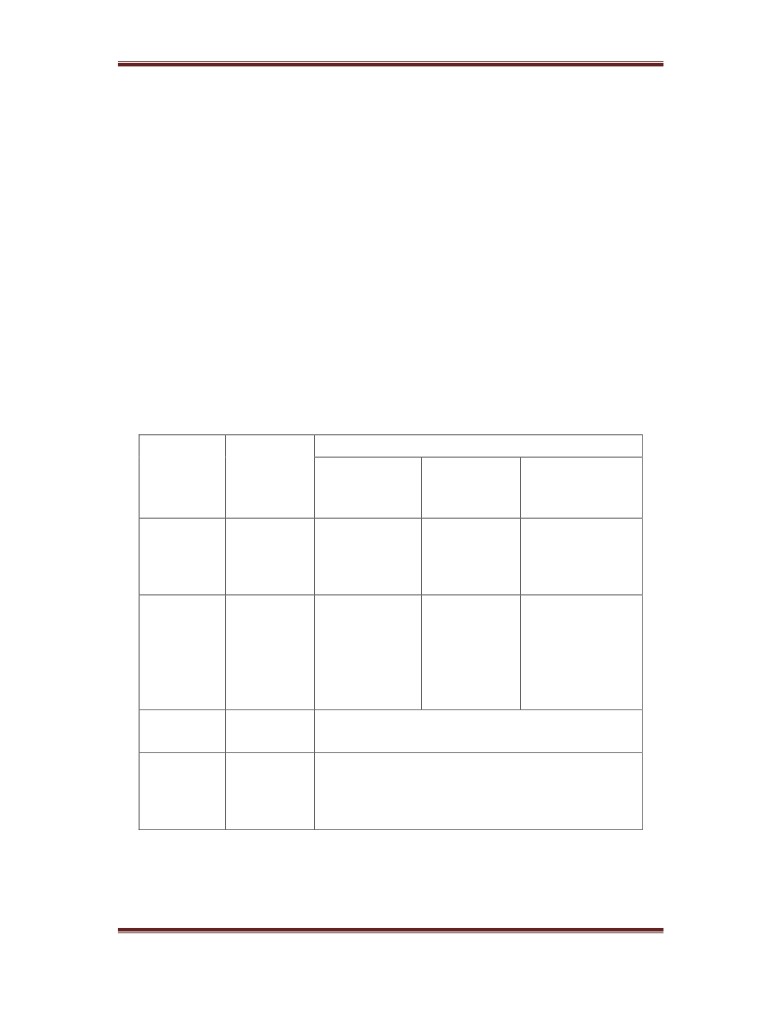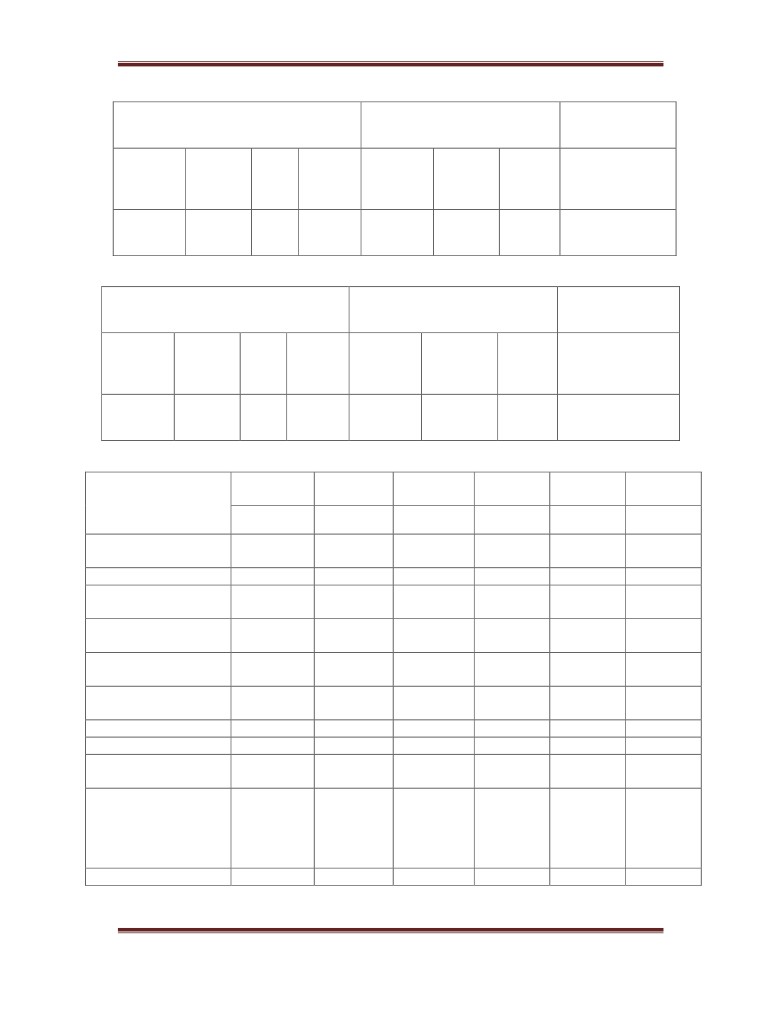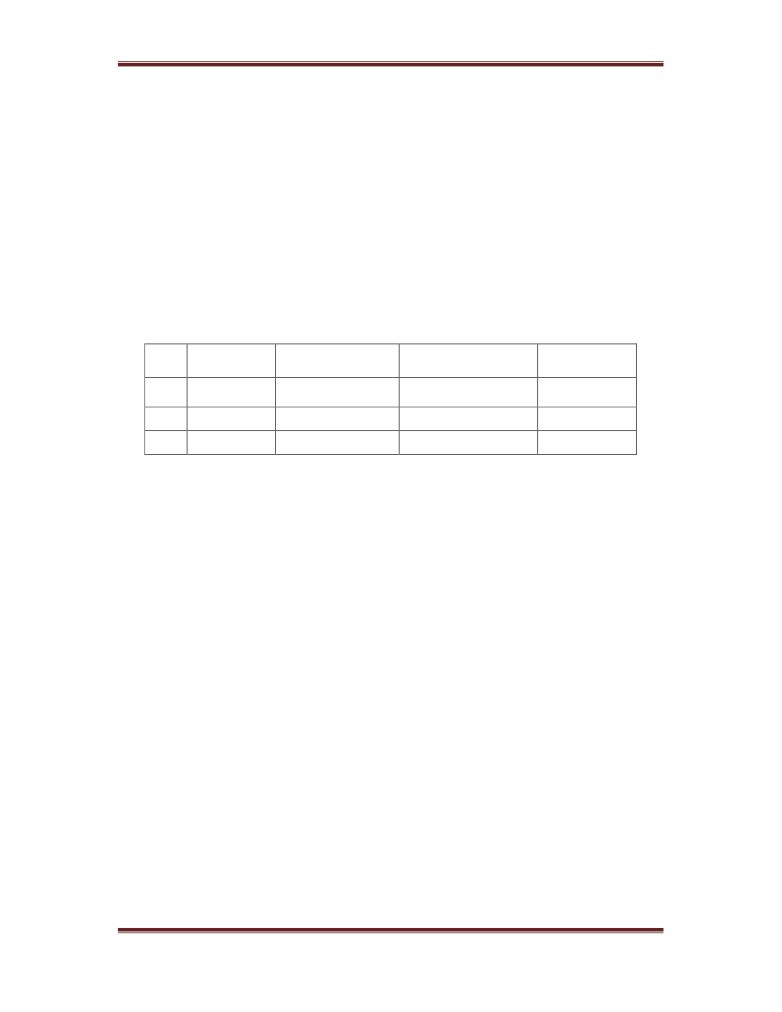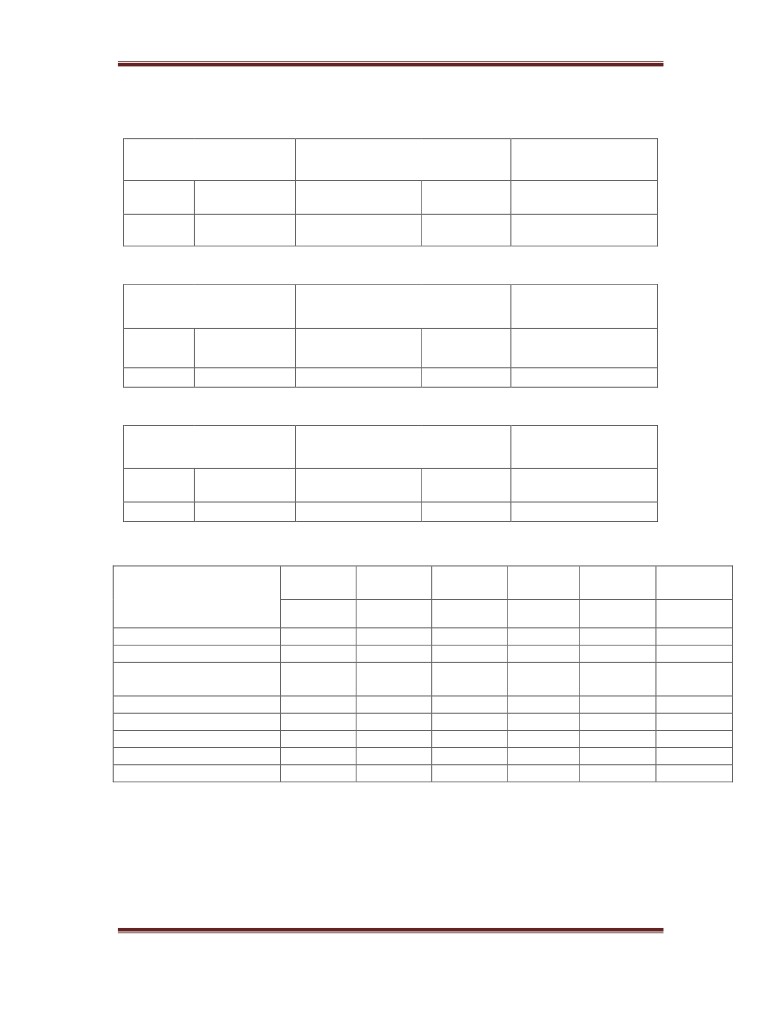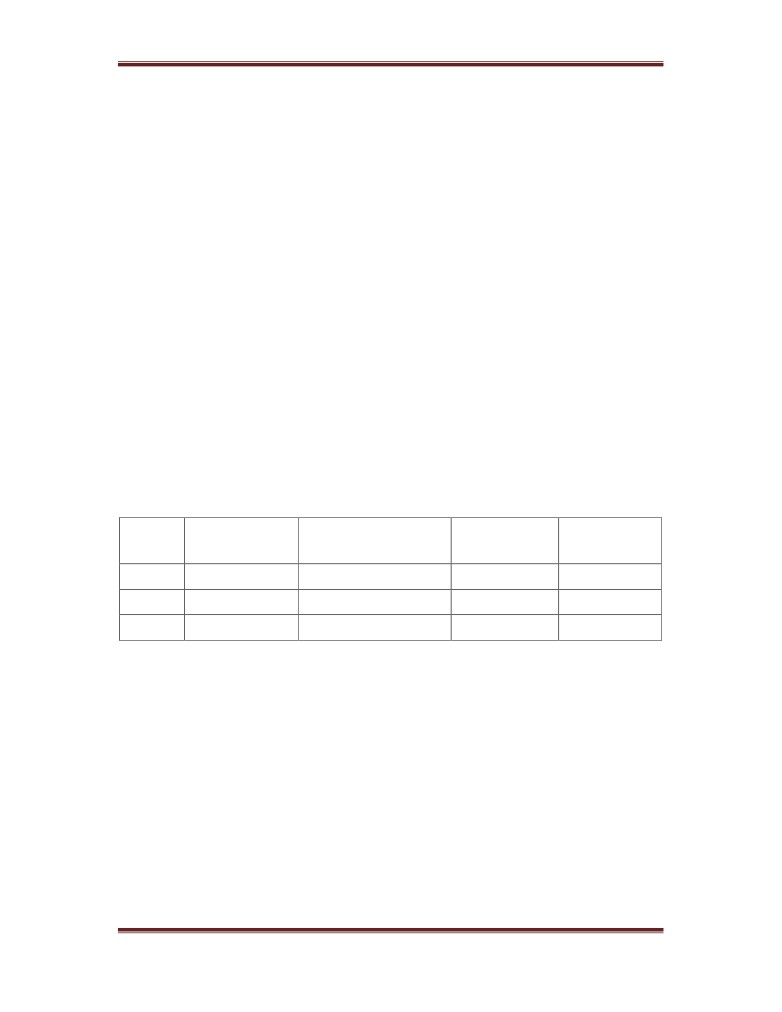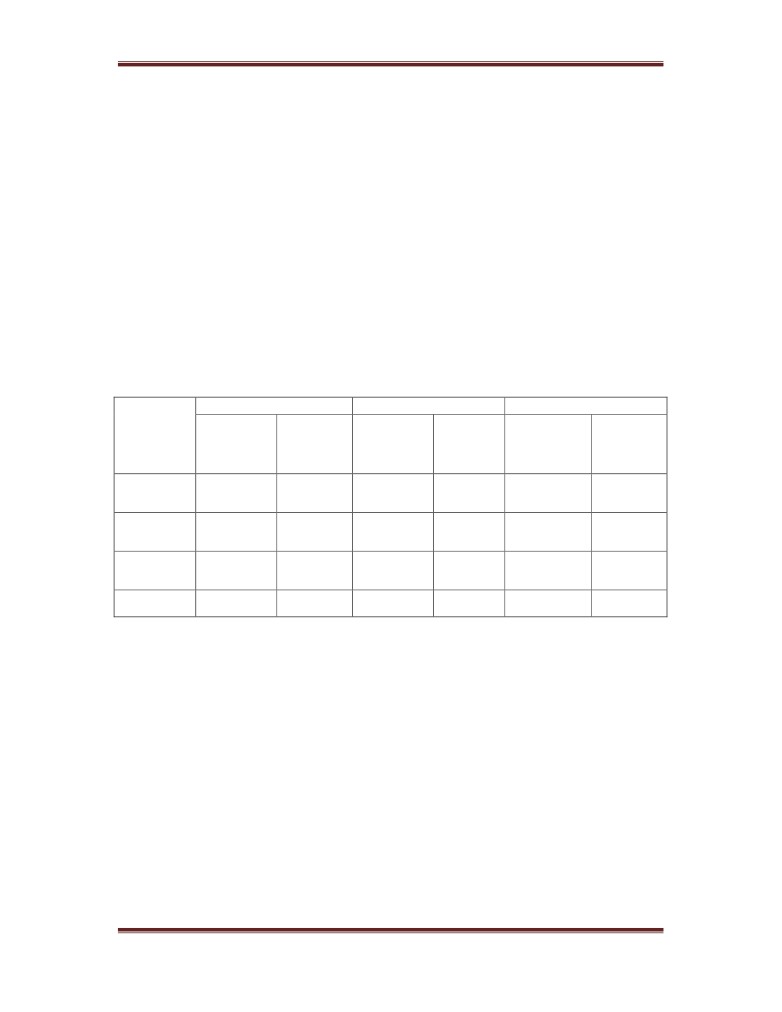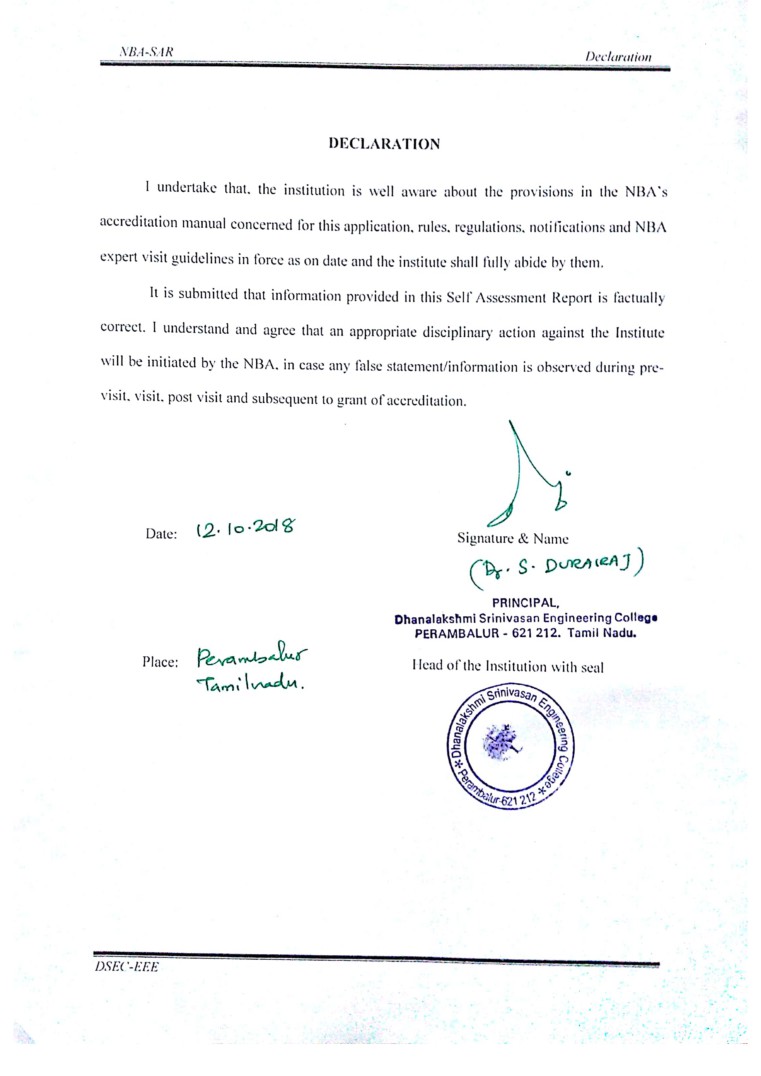SELF ASSESSMENT REPORT (SAR)
of
DEPARTMENT OF ELECTRICAL
AND ELECTRONICS ENGINEERING
for
UNDERGRADUATE ENGINEERING PROGRAMS (TIER-II)
FIRST TIME ACCREDITATION
Submitted to
NATIONAL BOARD OF ACCREDITATION
New Delhi - 110003
Dhanalakshmi Srinivasan Engineering College
(Approved by AICTE, New Delhi & Affiliated to Anna University Chennai,
Accredited with ‘A’ grade by NAAC &
An ISO 9001:2008 Certified Institution)
Perambalur - 621 212
Tamilnadu
SAR CONTENTS
Serial Code &
Link to the
Item
Page No
Item
PART A
Institutional Information
1
PART B
Criteria Summary
9
Program Level Criteria
1
Vision, Mission and Program Educational Objectives
10
2
Program Curriculum and Teaching - Learning Processes
21
3
Course Outcomes and Program Outcomes
114
4
Students’ Performance
176
5
Faculty Information and Contributions
212
6
Facilities and Technical Support
269
7
Continuous Improvement
291
Institute Level Criteria
8
First Year Academics
309
9
Student Support Systems
334
10
Governance, Institutional Support and Financial Resources
369
PART C
Declaration by the Institution
410
Program Outcomes (POs) & Program Specific
Annexure - I
411
Outcomes (PSOs)
NBA-SAR
Institutional Information
PART A: Institutional Information
1.
Name and Address
of the Institution
:
Dhanalakshmi Srinivasan Engineering College,
Thuraiyur Road, Perambalur - 621 212
Tamil Nadu, India
2.
Name and Address
of the Affiliating University
:
Anna University, Chennai -
600 025
3.
Year of establishment
of the Institution
:
2001
4.
Type of the Institution
:
University
Deemed University
Government Aided
Autonomous
Affiliated
5.
Ownership Status
:
Central Government
State Government
Government Aided
Self-financing
Trust
Society
Section 25 Company
Other
DSEC-EEE
1
NBA-SAR
Institutional Information
6. Other Academic Institutions of the Trust/Society/Company etc., if any:
S.
Year of
Name of the Institution(s)
Programs of Study
Location
No
Establishment
UG Programme
B.A.(English, Psychology)
B.B.A.
B.B.A.(Aviation Management)
B.C.A.
B.Com.
B.Com.(CA)
B.Lit. Tamil
B.Sc., (Biochemistry, Biotechnology,
Chemistry, Computer Science,
Information Technology, Mathematics,
Microbiology, Physics, Nutrition &
Dhanalakshmi Srinivasan
Dietetics, Fashion Technology &
College of Arts and
Costume Designing, Hospital
1
Science for women
1996
Administration, Food Technology &
( Autonomous)
Quality Control, Forensic Science)
PG Programme
M.A.(Tamil, English)
M.B.A.
M.C.A.
Perambalur
M.Com. (CA)
M.Sc.(Biochemistry, Biotechnology,
Chemistry, Computer Science,
Information Technology, Mathematics,
Physics, Bio-Informatics, Microbiology )
M.Phil. (Commerce, Tamil, Chemistry,
Microbiology, Biotechnology,
Mathematics)
Mechanical Engineering
Electrical & Electronics Engineering
Electronics & Communication
Dhanalakshmi Srinivasan
Engineering
2
1998
Polytechnic College
Computer Engineering
Civil Engineering
Architect Assistantship
DSEC-EEE
2
NBA-SAR
Institutional Information
S.
Year of
Name of the Institution(s)
Programs of Study
Location
No
Establishment
UG Programme
B.A., (English, Economics, Library and
Information Science, Journalism & Mass
Communication)
B.B.A.
B.Com.,(CA)
B.C.A.
B.Lit., Tamil
B.Sc.,( Biotechnology, Chemistry,
Computer Science, Hotel Management &
Catering Science, Information
Technology, Mathematics,
Microbiology, Physics)
Srinivasan College of Arts
3
2004
PG Programme
and Science
M.A., English
M.B.A.
M.C.A.
M.Com.
M.S.W.
Perambalur
M.Sc.(Biotechnology, Chemistry,
Computer Science, Hotel Management &
Catering Science, Information
Technology, Mathematics,
Microbiology, Physics)
M.Phil.(Management Studies,
Commerce, Microbiology, Computer
Science)
Dhanalakshmi Srinivasan
4
Matriculation Hr. Sec.
1994
Higher Secondary
School
Dhanalakshmi Srinivasan
5
2004
Higher Secondary
Hr. Sec. School
B.E. Aeronautical Engineering
Srinivasan Engineering
6
2006
B.E. Computer Science and Engineering
College
B.E. Mechanical Engineering
B.E. Aerospace Engineering
Dhanalakshmi Srinivasan
B.E. Robotics and Automation
7
2012
College of Engineering
B.Tech. Chemical Engineering
B.Tech. Food Technology
Dhanalakshmi Srinivasan
8
2017
B.Sc., Agriculture (Hons)
Agriculture college
DSEC-EEE
3
NBA-SAR
Institutional Information
S.
Year of
Name of the Institution(s)
Programs of Study
Location
No
Establishment
Dhanalakshmi Srinivasan
9
Matriculation Hr. Sec.
2004
Higher Secondary
Trichy
School
Table A.6
7. Details of all the programs being offered by the institution under consideration.
Increase
Year of
S.
in
Year of
AICTE
Accreditati
Program Name
Establis
Intake
No
intake, if
Increase
Approval
on Status
hment
any
B.E., Biomedical
Applying
1.
2005
60
120
2005
Yes
Engineering
First Time
B.E., Civil
120
2009-10
Eligible but
2.
2008
60
Yes
Engineering
180
2014-15
not applied
Accredited
60
2002-03
B.E., Computer
in the Year
3.
Science and
2001
45
90
2008-09
Yes
12.09.2007
Engineering
-
120
2011-12
11.09.2010
Accredited
90
2005-06
B.E., Electrical and
in the Year
4.
Electronics
2002
60
Yes
10.07.2009
60
2007-08
Engineering
-
120
2011-12
09.07.2012
Accredited
90
2004-05
B.E., Electronics and
in the Year
5.
Communication
2001
60
120
2007-08
Yes
12.09.2007
Engineering
-
180
2012-13
11.09.2010
60
2002-03
Accredited
30
2004-05
in the Year
B.Tech., Information
6.
2001
45
60
2006-07
Yes
10.07.2009
Technology
120
2012-13
-
60
2014-15
09.07.2012
90
2008-09
B.E., Mechanical
120
2009-10
Eligible but
7.
2004
60
Yes
Engineering
180
2012-13
not applied
240
2014-15
Master of Computer
Eligible but
8.
2004
60
120
2007-08
Yes
Applications
not applied
DSEC-EEE
4
NBA-SAR
Institutional Information
Increase
Year of
S.
in
Year of
AICTE
Accreditati
Program Name
Establis
Intake
No
intake, if
Increase
Approval
on Status
hment
any
Master of Business
Eligible but
9.
2004
60
120
2007-08
Yes
Administration
not applied
M.E.,
Eligible but
10.
Communication
2006
18
36
2010-11
Yes
not applied
Systems
M.E., Computer
Eligible but
11.
Science and
2006
18
36
2010-11
Yes
not applied
Engineering
Eligible but
12.
M.E., CAD/CAM
2011
18
-
-
Yes
not applied
M.E., Power
Eligible but
13.
Electronics and
2011
18
-
-
Yes
not applied
Drives
M.E., Computer
Science and
Eligible but
14.
Engineering (With
2012
18
-
-
Yes
not applied
Specialization in
Networks)
M.E., Embedded
Eligible but
15.
2012
18
-
-
Yes
Systems
not applied
Table A.7
8. Programs to be considered for Accreditation vide this application:
S.No
Program Name
1
B.E., Biomedical Engineering
2
B.E., Electrical and Electronics Engineering
3
B.E., Electronics and Communication Engineering
Table A.8
DSEC-EEE
5
NBA-SAR
Institutional Information
9.
Total number of employees in the institution:
A. Regular Employees (Faculty and Staff):
2018-19
2017 - 2018
2016 - 2017
Items
Min
Max
Min
Max
Min
Max
M
190
192
189
Faculty in
Engineering
F
98
96
99
Faculty in Maths,
M
44
42
45
Science &
F
20
21
19
Humanities
M
27
27
29
Non-teaching staff
F
21
21
18
Table A.9a
B. Contractual Staff Employees (Faculty and Staff): (Not covered in Table A):
(Not applicable)
10.
Total number of Engineering Students:
Under Graduate
Item
2018-19
2017 - 2018
2016 - 2017
Total no. of boys
2108
1586
1839
Total no. of girls
975
893
1119
Total no. of students
3083
2479
2958
Table A.10a
Post Graduate
Item
2018-19
2017 - 2018
2016 - 2017
Total no. of boys
2
4
13
Total no. of girls
39
36
53
Total no. of students
41
40
66
Table A.10b
DSEC-EEE
6
NBA-SAR
Institutional Information
MBA
Item
2018-19
2017 - 2018
2016 - 2017
Total no. of boys
58
51
56
Total no. of girls
80
70
58
Total no. of students
138
121
114
Table A.10c
MCA
Item
2018-19
2017 - 2018
2016 - 2017
Total no. of boys
23
26
37
Total no. of girls
74
87
107
Total no. of students
97
113
144
Table A.10bd
11.
Vision of the Institution
An active and committed centre of advanced learning focused on research and training
in the fields of Engineering, Technology and Management to serve the nation better.
12.
Mission of the Institution
To develop eminent scholars with a lifelong follow up of global standards by offering
UG, PG and doctoral programmes.
To pursue professional and career growth by collaborating mutually beneficial
partnership with industries and higher Institutes of research.
To promote sustained research and training with emphasis on human values and
leadership qualities.
To contribute solutions for the need based issues of our society by proper ways and
means as dutiful citizen
DSEC-EEE
7
NBA-SAR
Institutional Information
13. Contact Information of the Head of the Institution and NBA coordinator, if
designated:
i.
Head of the Institution
Name
: Dr. S. Durairaj
Designation
: Principal
Mobile No
: +91 9585594580
E-mail Id
: principal@dsengg.ac.in
ii.
NBA Coordinator
Name
: Mrs.B.Karthiga
Designation
: IQAC Coordinator
Mobile No
:
+9443412750
E-mail Id
: iqacdsec@gmail.com
DSEC-EEE
8
NBA-SAR
Institutional Information
PART B: Criteria Summary
Name of the program: B.E., Electrical and Electronics Engineering
Mark/
Criteria No
Criteria
Weightage
Program Level Criteria
1
Vision, Mission and Program Educational Objectives
60
2
Program Curriculum and Teaching - Learning Processes
120
3
Course Outcomes and Program Outcomes
120
4
Students’ Performance
150
5
Faculty Information and Contributions
200
6
Facilities and Technical Support
80
7
Continuous Improvement
50
Institute Level Criteria
8
First Year Academics
50
9
Student Support Systems
50
10
Governance, Institutional Support and Financial Resources
120
Total
1000
DSEC-EEE
9
NBA -SAR
Criterion 1
VISION, MISSION AND PROGRAM EDUCATIONAL
CRITERION 1
60
OBJECTIVES
1. Vision, Mission and Program Educational Objectives
1.1. State the Vision and Mission of the Department and Institute
Vision and Mission of Dhanalakshmi Srinivasan Engineering College
Vision
An active and committed centre of advanced learning focused on research and training in
the fields of Engineering, Technology and Management to serve the nation better.
Mission
M1: To develop eminent scholars with a lifelong follow up of global standards by offering
UG, PG and Doctoral programs.
M2: To pursue professional and career growth by collaborating mutually beneficial
partnership with industries and higher institutes of research.
M3: To promote sustained research and training with emphasis on human values and
leadership qualities.
M4: To contribute solutions for the need based issues of our society by proper ways and
means as dutiful citizen.
Vision and Mission of Electrical and Electronics Engineering Department
Vision
To infuse technical competencies of Electrical and Electronics Engineering and provide
research ambience with values.
DSEC - EEE
10
NBA -SAR
Criterion 1
Mission
M1: To impart quality education and training in Electrical and Electronics Engineering with
an overall background suitable for making a successful Engineer in industry and research
or higher education.
M2: To develop life-long learning skills that allows them to be adaptive and responsive to
changes in society, technology and the environment, as well as career demands.
M3: To provide an accredited dynamic scholarly environment wherein students learn to
develop communications and leadership abilities to blossom as a professional.
M4: To ensure that every graduate is aware of the roles and responsibilities of
the professional engineer in society through exposure to ethics, equity, safety and health
considerations.
Consistency of Department Vision with Institute Vision
To be an integral part in the development of centre for excellence in learning and
research for meeting the global standards through implementation of department’s vision by
developing competent Electrical Engineers to serve the nation.
Consistency of Department Mission with Institute Mission
There are four foundation stones of our department’s mission that are shared with our
Institute mission such as technical education, lifelong learning, leadership and ethical exposure.
The consistency is realized through developing graduates with technical education, to be
a successful engineer in industry, research and higher education as stated in first mission.
In second mission, consistency is realized by producing graduates with life-long learning
skills and adaptive to changes in society, industry and research.
DSEC - EEE
11
NBA -SAR
Criterion 1
The consistency of third mission is achieved by training the professionals with good
communication and leadership qualities.
In fourth mission, the consistency is ensured by producing dutiful citizen with exposure
to equity, society, safety and health considerations.
1.2. State the Program Educational Objectives (PEO’s)
PEO1: Graduates will possess expertise in problem analysis, solving, designing, skills and
necessary information for a successful career in the field of Electrical and Electronics
Engineering.
PEO2: Graduates will accomplish practical acquaintance in modern designing tools,
technologies and Engineering software in Electrical and Electronics
Engineering.
PEO3: Graduates will be outstanding in communication, teamwork and multidisciplinary
approach related to engineering issues in social context.
PEO4: Graduates will excel in competitive environment towards leadership and life-long
learning which is needed for a successful professional career.
1.3. Indicate where the Vision, Mission and PEO’s are published and disseminated among
stakeholders
The Vision, Mission and PEO’s are discussed, articulated and disseminated among the internal
and external stakeholders by (i) Display and (ii) Discussion/Dissemination.
(i) Display: The Vision, Mission and PEO’s are conveyed through college website
(www.dsengg.ac.in ).Further Vision and Mission of the institution are printed and
displayed in prominent places.
DSEC - EEE
12
NBA -SAR
Criterion 1
College foyer
Auditorium
Principal Cabin
Central Library
Seminar Hall
Notice Board
HOD Cabin
Subsequently Vision, Mission and PEO’s of the department are printed and displayed at
places where teachers and students gather frequently like;
Laboratories
Department Library
Faculty Rooms
Classrooms
HOD Cabin
Notice Boards
Vision, Mission and PEO’s are printed and circulated to stakeholders by the following ways:
Correspondence to Parents and Industry
Record-note wrapper pages
Placement brochures
Hand-outs at regular meetings
(ii) Discussion/Dissemination: Vision, Mission and PEO’s are regularly/periodically addressed
in the following:
Student orientation program
Faculty meet
Parent’s meet
Industry Experts meet
Alumni meet
Association activities such as Conference /
Seminar / Workshop / Symposium
DSEC - EEE
13
NBA -SAR
Criterion 1
The above mentioned process is shown in figure 1.1
Display and Dissemination
Vision, Mission & PEOs of the Department
Vision and Mission of the Institution
Printed and displayed
at,
Display
College foyer
Principal cabin
HOD cabin
Auditorium
Printed and
Printed and circulated
Discussed
Central Library
displayed at,
through,
periodically during,
Seminar Hall
HOD cabin
Record-note wrapper
Orientation
program
Notice board
Faculty
Placement brochures
Rooms
Hand-outs at regular
Parent’s meet
Laboratories
meetings
Faculty meet
Correspondence to
Industry experts
Department
Library
Parents and Industry
meet
Classrooms
Alumni meet
Association
Notice Boards
activities
Laboratories
Seminar Hall
Figure1.1 Process of Publication and Dissemination of Vision, Mission and PEO’s
DSEC - EEE
14
NBA -SAR
Criterion 1
1.4. State the process for defining the Vision and Mission of the Department and PEO’s of
the Program
Process for Establishing Vision and Mission of the Department:
A department advisory committee is formed to establish Vision and Mission of the
Department. The committee consists of Head of the Department, Faculty members and
representatives from Parents, Alumni and eminent Academicians. The committee pursues with
the following activities to establish the Vision and Mission;
The Strength, Weakness, Opportunity and Challenges (SWOC) analysis is performed.
Vision and Mission of the Institution are considered.
Views/suggestions from the management, administrator, and faculty are first
collected and then analyzed.
Opinion from the students are collected and reviewed.
Recommendations from the recruiters, academicians and industrial experts are
collected and scrutinized.
After framing the preamble of Vision and Mission, the alignment is checked / verified with
the Vision and Mission of the Institution. The appropriateness is validated by experts from
academics and industry. The Vision and Mission of the department get approved Principal. The
Vision and Mission are further published and disseminated among the stakeholders.
The above mentioned process is depicted as flow chart in figure.1.2.
DSEC - EEE
15
NBA -SAR
Criterion 1
Formation of Department Advisory Committee
Collect and analyze the following to establish Vision and Mission
Strength, Weakness, Opportunity and Challenges (SWOC)
Vision and Mission of the Institution
Views/suggestions from stakeholders
Frame preamble of Vision and Mission
Check alignment with
Vision and Mission of the
Institution & Departments
No
Yes
Validated by
Academicians and
Industry experts
No
Yes
Get approval from
Principal
No
Yes
Establish the Vision and Mission
Publish, Display and Discuss periodically
among stakeholders
Figure 1.2 Process for Establishing Vision and Mission of the Department
DSEC - EEE
16
NBA -SAR
Criterion 1
Process for Establishing PEO’s:
A department advisory committee is formed to establish PEO’s. The committee consists
of Head of the Department, Senior Faculty members, and representatives from Parents, Alumni,
industry experts and eminent academicians. The committee engages with the following activities
to establish the PEO’s:
The profile of our Department and its programs is collected.
Mission and Vision of the Department are considered.
Views/suggestions/opinions/recommendations from the stakeholders are collected and
analyzed.
Details of the current status of Department in terms of student admission quality,
Teaching-Learning process, faculty and their research activities, placement, and other
facilities are collected and reviewed.
Data about industries, research organizations and higher educational Institutions relevant
to the programs are collected and scrutinized.
After establishing/framing the PEO’s, the consistency of the PEO’s with the mission
statements of the Department is checked / verified. The defined PEO’s are compared with PEO’s
of similar category Institutions. The appropriateness of PEO’s is validated with the requirements
and expectations of employers. The PEO’s are further published and disseminated among the
stakeholders. The above mentioned process is shown as flowchart in figure.1.3.
DSEC - EEE
17
NBA -SAR
Criterion 1
Formation of Department Advisory Committee
Collect and analyze the following to establish PEO’s
Profile of department and its programs
Mission and Vision of the Department
Data from stakeholders
Frame preamble of PEO’s
Check consistency with
Mission of the
No
Department
Yes
Compare with
PEO’s of other
No
Institutions
Yes
Validate with
industry experts
No
requirements
Yes
Establish the PEO’s
Publish, Display and Discuss periodically among stakeholders
Figure 1.3 Process for Establishing PEO’s of the Department
DSEC - EEE
18
NBA -SAR
Criterion 1
1.5. Establish consistency of PEO’s with Mission of the Department
In the following Table B.1.1 the consistency of PEO’s with Mission of the Department is
shown as matrix (Mission-PEO’s). The relevance/correlation is assigned as following numerical
weights: high correlation (3), medium correlation (2), low correlation (1) and no correlation (-)
M1
M2
M3
M4
Quality
Life-
Communication
Profess
PEO
PEO Statements
Education
Long
and Leadership
ional
and
Learning
Abilities
Ethics
Training
Graduates will possess expertise in
problem
analysis,
solving,
PEO
designing, skills and necessary
3
2
1
1
1
information for a successful career
in the field of Electrical and
Electronics Engineering.
Graduates will accomplish practical
acquaintance in modern designing
PEO
tools,
technologies
and
3
3
1
1
2
Engineering
software
in
Electrical
and
Electronics
Engineering.
Graduates will be outstanding in
communication, teamwork and
PEO
multidisciplinary approach related
1
2
3
3
3
to engineering issues in social
context.
Graduates will excel in competitive
environment towards leadership
PEO
and life-long learning which is
1
3
3
1
4
needed
for
a
successful
professional career.
Table B.1.1 Mission of the department-PEO’s matrix
DSEC - EEE
19
NBA -SAR
Criterion 1
The Table demonstrates the consistency among PEO’s and Mission statements.
PEO
Mission
Consistency
Problem
Strongly correlates by providing an excellent industry &
M1
Analysis,
research background for successful career of students.
PEO1
Solving,
Averagely correlates by providing successful engineers
Designing and
M2
more competent to meet the career demands with life-long
Skills
learning skills.
Strongly correlates by providing quality education, training
Modern
M1
about modern designing tools, engineering software for
Designing Tools,
students to attain practical proficiency.
PEO2
Technologies
and Engineering
Strongly correlates by making students robust to
M2
Software
technological changes in society.
Averagely correlates by providing collaborative training for
M2
students to cope up with social context.
Communication
Strongly correlates by providing an accredited dynamic
Teamwork and
M3
PEO3
scholarly environment for students to be more studious.
Multidisciplinary
Strongly correlates by providing an ethical exposure to
Approach
M4
equity, sustainable development and environmental
stewardship.
Strongly correlates by providing students with
M2
interpersonal skills, life-long learning needed for successful
Leadership and
technocrats.
PEO4
Lifelong
Strongly correlates by providing students aware of
Learning
M3
excellence, leadership abilities to blossom as
Administrators and Entrepreneurs.
Table B.1.2 Consistency of PEO’s with Department Mission
DSEC - EEE
20
NBA-SAR
Criterion 2
PROGRAM CURRICULUM AND TEACHING-
CRITERION 2
120
LEARNING PROCESSES
2. PROGRAM CURRICULUM AND TEACHING - LEARNING PROCESSES
2.1. Program Curriculum
2.1.1. State the process used to identify extent of compliance of the University
curriculum for attaining the Program Outcomes and Program Specific Outcomes as
mentioned in Annexure I. Also mention the identified curricular gaps, if any
PROGRAM OUTCOMES (PO’s)
Engineering Graduates will be able to:
PO1: Engineering knowledge - Apply the knowledge of mathematics, science, engineering
fundamentals, and an engineering specialization to the solution of complex engineering
problems.
PO2: Problem analysis - Identify, formulate, review research literature, and analyze complex
engineering problems reaching substantiated conclusions using first principles of
mathematics, natural sciences, and engineering sciences.
PO3: Design/Development of solutions - Design solutions for complex engineering problems
and design system components or processes that meet the specified needs with appropriate
consideration for the public health and safety, and the cultural, societal, and environmental
considerations.
PO4: Conduct investigations of complex problems - Use research-based knowledge and
research methods including design of experiments, analysis and interpretation of data, and
synthesis of the information to provide valid conclusions.
DSEC-EEE
21
NBA-SAR
Criterion 2
PO5: Modern tool usage - Create, select, and apply appropriate techniques, resources, and
modern engineering and IT tools including prediction and modeling to complex
engineering activities with an understanding of the limitations.
PO6: The Engineer and Society - Apply reasoning informed by the contextual knowledge to
assess societal, health, safety, legal and cultural issues and the consequent responsibilities
relevant to the professional engineering practice.
PO7: Environment and Sustainability - Understand the impact of the professional engineering
solutions in societal and environmental contexts, and demonstrate the knowledge of, and
need for sustainable development.
PO8: Ethics - Apply ethical principles and commit to professional ethics and responsibilities
and norms of the engineering practice.
PO9: Individual and team work - Function effectively as an individual, and as a member or
leader in diverse teams, and in multidisciplinary settings.
PO10: Communication - Communicate effectively on complex engineering activities with the
engineering community and with society at large, such as, being able to comprehend and
write effective reports and design documentation, make effective presentations, and give
and receive clear instructions.
PO11: Project management and finance - Demonstrate knowledge and understanding of the
engineering and management principles and apply these to one’s own work, as a member
and leader in a team, to manage projects and in multidisciplinary environments.
PO12: Life-long learning - Recognize the need for, and have the preparation and ability to
engage in independent and life-long learning in the broadest context of technological
change.
DSEC-EEE
22
NBA-SAR
Criterion 2
PROGRAM SPECIFIC OUTCOMES (PSO’s):
PSO1: Power Networks - Assess feasibility, applicability and optimality in power networks.
PSO2: System Simulation - Ability to use software for design, simulation and analysis of
electrical systems.
Our college adheres to curriculum and syllabi as prescribed by Anna University, Chennai.
The syllabi comprises of multifaceted courses covering theory, practical and project. The Table
B.2.1 shows the regulations which are being followed in yesteryears and regulations which are
underway.
S. No
Batch
Regulation
University
1.
2011-2015
R-2008
2.
2012-2016
3.
2013-2017
Anna University,
4.
2014-2018
R-2013
Chennai.
5.
2015-2019
6.
2016-2020
7.
2017-2021
R-2017
8.
2018-2022
Table B.2.1 Regulation Details
DSEC-EEE
23
NBA-SAR
Criterion 2
2.1.1 State the process used to identify the extent of compliance of University Curriculum
for attaining the Program outcomes and Program Specific Outcomes as mentioned in
Annexure I. Also mention the identified the curricular gaps, if any.
Curriculum compliance is systematic analysis of curriculum, prescribed by University, to
identify the degree of competency of syllabi and its contents for attaining the Program Outcomes
and program specific outcomes. In this regard, Department Advisory Committee (DAC) is
framed which comprises of Head of the Department, Senior faculty members, and
representatives from Parents, Alumni, Industry Experts and Academicians. The Department
advisory committee carries out the study/investigation to reveal whether the syllabi and its
contents intentionally and systematically provide students with opportunities to attain the
appropriate knowledge, skill and attitudes. This process helps to identify the gap between
University curriculum and Program Outcomes. The identification leads to rectification
/
remediation.
The set of activities involved in this process are as follows.
The procedural training towards Outcome Based Education (OBE) was imparted to the
course instructors. Relevant courses are collected based on its contents and grouped them as
modules. For each course, the knowledge level of course contents is identified using revised
Bloom’s taxonomy and corresponding course outcomes are formulated. Curriculum compliance
may be verified by organizing the information into a matrix (course-PO matrix) which maps each
one to the other. Mapping involves making collective judgments’, by department advisory
committee, about the link between the course outcomes (COs) and the program outcomes (POs).
Mapping not only provides the information of whether curriculum meets the academic and/or
professional benchmark requirements (POs) but also manifests the way and possible level of
DSEC-EEE
24
NBA-SAR
Criterion 2
attaining the POs by curriculum. The same process is extended to course-PSOs matrix. From
mapping curricular gaps are identified. The entire process is presented as flowchart.
Anna University
curriculum
Collect the relevant courses and classify in Modules:
Module 1: Humanities and social sciences Module 4: Professional Core
Module 2: Basic sciences
Module 5: Employability Enhancement courses
Module 3: Engineering sciences
Module 6: Professional Electives
Frame Course Outcomes (CO’s) for each course
PO’s and PSO’s
Map CO’s with PO’s and PSO’s
Identify the compliance of CO’s with PO’s
and PSO’s
Indicate the curricular gap
Articulate additional COs which helps to
attain PO’s and PSO’s
Identify relevant content beyond syllabi for the
attainment of PO’s and PSO’s
Figure 2.1 Curricular Gap Identification Process
DSEC-EEE
25
NBA-SAR
Criterion 2
Programme
Number of subjects
Curriculum
PO’s and PSO’s
S. No
based on
Course
R-2008
R-2013
R-2017
R-2008
R-2013
R-2017
Content
Humanities
PO’s
PO’s
PO’s
1.
and Social
3
3
3
(8,10,12)
(8, 10,12)
(9, 10, 12)
Sciences
PO’s
PO’s
PO’s
Basic
2.
9
10
8
(1, 2, 3,
(1, 2, 3,
(1, 2, 3, 5,
Sciences
12)
12)
12)
PO’s
PO’s
PO’s
Engineering
3.
13
12
11
(1, 2, 3, 4,
(1, 2, 3, 5,
(1, 3, 4, 6,
Sciences
5, 9, 12)
9, 12)
12)
PO’s
PO’s
PO’s
(1, 2, 3, 4,
Professional
(1, 2, 3, 4,
(1, 2, 3, 4,
4.
27
26
27
8, 9,
Core Subjects
9, 12) and
5, 7, 9, 10,
11,12) and
PSO1
11, 12)
PSO1
Employability
PO’s
PO’s
PO’s
5.
Enhancement
4
4
4
(1, 2, 3, 8,
(1, 2, 3, 8,
(1, 3, 4, 9,
Courses
9, 10, 12)
9, 10, 12)
10, 11, 12)
PO’s
PO’s
PO’s
Professional
(1, 2, 3, 4,
6
10
9
12
(1, 2, 6, 7,
(1, 2, 3, 5,
Electives
7, 8, 11,
8, 11, 12)
7, 12)
12)
Table B.2.2 Curricular gap identification relevant to PO, PSO
DSEC-EEE
26
NBA-SAR
Criterion 2
2.1.2. State the delivery details of the content beyond the syllabus for the attainment of
PO’s and PSO’s.
The corrective measures to tackle the curricular gap are divided into appropriate activities
in college and effort to change the University syllabi. Non-attainment of Program outcomes and
Program specific outcomes are fulfilled by framing additional course outcomes. Content beyond
syllabi relevant to additional CO’s are established. Course outcomes of activities are mapped
with PO’s and PSO’s. Adequate attention is devoted to implement the content beyond syllabi
through additional course, self-learning materials and other appropriate activities. The
appropriateness of activity and mode of its delivery is decided by the knowledge level of
additional course contents in revised Bloom’s taxonomy. The college sent a letter of intimation,
regarding the additional course contents for identified curricular gap, to boards of studies of the
affiliating University for consideration and inclusion in the curriculum during its next revision.
The revised Anna University curriculum regulation 2017 has revealed the Programme
curriculum grouping of courses. The curricular gap identification is reformulated by insisting the
course instructors to identify the content beyond the syllabi for each course in their course plan
respectively. The delivery details of content beyond the syllabus for attainment of PO’s and
PSO’s are given below
DSEC-EEE
27
NBA-SAR
Criterion 2
2015-2016
Relevance
Date-
S.
Action
Resource Person
to PO’s
Subject Name
Gap
Month-
No
Taken
with Designation
and
Year
PSO’s
Automation
PO’s
Power System
and Advanced
Value
03/09/2015
Prof.M.K.Jeevarajan
(5, 6, 8,
1
Operation and
Programming
Added
-
Prof.M.Malayappan
11) and
Control
in PLC and
Course
10/09/2015
PANTECH Solutions,
PSO’s
SCADA
Chennai
(1, 2)
PO’s (5,
Mrs.Shobana Devi,
Special
6, 7, 11,
Electrical
Guest
University College
2
Electrical
03/09/2015
12) and
Machines
Lecture
of Engineering,
Machines
PSO’s
Ariyalur
(1, 2)
Prof.M.Ravichandran,
PO’s (4,
Electromagneti
Electromagneti
Guest
Selvam College of
5, 9, 12)
3
16/09/2015
c Theory
c Interferences
Lecture
Technology,
and PSO’s
Namakkal
(1, 2)
Dr. P. Ramesh Babu,
PO’s (5, 7,
Trends in
Digital Signal
Guest
Pondicherry
9, 12) and
4
Digital Signal
30/03/2016
Processing
Lecture
Engineering College,
PSO’s
Processors
Pondicherry
(1, 2)
DSEC-EEE
28
NBA-SAR
Criterion 2
2016-2017
Date-
Relevance
S.
Action
Resource Person with
Subject Name
Gap
Month-
to PO’s
No
Taken
Designation
Year
and PSO’s
High Voltage
Prof. Muthuveerapan,
PO’s(4, 5,
High voltage
Testing on
Guest
J.J College of
1
20/09/2016
6, 7, 8,12)
Engineering
Electrical
Lecture
Engineering and
and
Devices
Technology,Trichy
PSO’s (1, 2
Prof.K.Dhayalini,
PO’s
Power System
Substation
Guest
J.J.College of
(4, 6, 7, 8)
2
03/10/2016
Analysis
Automation
Lecture
Engineering and
and
Technology,Trichy
PSO’s(1, 2)
Industrial
ProfS.SureshKumar,
Electronic
PO’s(8, 9,
Applications of
Guest
Anna
3
Devices and
06/10/2016
12) and
Electronic
Lecture
University,Trichy
Circuits
PSO’s
devices
(1, 2)
Power
PO’s(4, 6,
Dr. N. Stalin
Electronics for
Renewable
Guest
7, 8)and
4
23/02/2017
Anna
Renewable
Energy
Lecture
PSO’s
University,Trichy
Systems
(1, 2)
Prof.Shobana Devi,
Industrial
PO’s(6, 7,
Control
Guest
University College of
5
Logic
15/03/2017
11, 12 and
Systems
Lecture
Engineering,
Controllers
PSO’s(1, 2)
Ariyalur
Data
Prof.Elangovan,
Measurement
PO’s(4, 6, 7
Acquisition
Guest
J.J College of
6
and
03/04/2017
and
Systems in
Lecture
Engineering and
Instrumentation
PSO’s(1, 2)
Automation
Technology, Trichy
DSEC-EEE
29
NBA-SAR
Criterion 2
2017-2018
Date-
Relevance
S.
Action
Resource Person with
Subject Name
Gap
Month-
to PO’s and
No
Taken
Designation
Year
PSO’s
PO’s
Prof.B.Selvakumar,
Special
Applications
(5, 9, 11,
Guest
VV College of
1
Electrical
of BLDC
30/09/2017
12) and
Lecture
Engineering,
Machines
Motors
PSO’s
Tuticorin
(1, 2)
Special
PO’s (6, 7,
Electrical
Prof.N.Vengadachalam
Electrical
Guest
11, 12) and
2
Machines
03/10/2017
TRP Engineering
Machines
Lecture
PSO’s
and its
College, Trichy
(1, 2)
Applications
Electric
PO’s( 6, 7,
Dr.P.Ajay-D-Vimal Raj
Recent
Energy
11, 12)
Pondicherry
Techniques
Guest
3
Generation,
27/03/2018
and
Engineering College
in Electric
Lecture
Utilization and
PSO’s
Pondicherry
Traction
Conservation
( 1, 2)
Automation
and
Prof.M.K.Jeevarajan
PO’s (5, 6,
Power System
Value
04/07/2018
Advanced
Prof..M.Malayappan
8, 11) and
4
Operation and
Added
-
Programming
PANTECH Solutions,
PSO’s (1,
Control
Course
10/07/2018
in PLC and
Chennai
2)
SCADA
Object
PO’s (5, 6,
Object
Prof.Manimaran
Oriented
Guest
8 and
5
Oriented
02/04/2018
Selvam College of
Programming
Lecture
PSO’s (1,
Programming
Technology, Namakkal
with JAVA
2)
Table B.2.3 Delivery details of the content beyond the syllabus for the past three academic
years
DSEC-EEE
30
NBA-SAR
Criterion 2
2.2.1. Describe Processes followed to Improve Quality of Teaching & Learning
The Program Educational Objectives (PEO’s) are established to guide the Programme
and prepare the graduates to achieve career and professional accomplishments. The PEO’s are
further transformed into specific student performance and behaviors that demonstrate student
learning and skill development as Program Outcomes (PO’s). Program Outcomes (PO’s) are
clearly and unambiguously defined. As our college is affiliated to Anna University, We follow
the curriculum prescribed by Anna University. All courses have their own course outcomes.
Each course outcome is mapped to relevant PO’s and PSO’s. Achieving course outcomes is the
direct way of accomplishing program outcomes. In this context, the teaching-learning process
and assessment methods are implemented in such a way to achieve the CO’s.
Teaching-Learning process is crucial part of outcome based education and
implements/employs as the set of activities engaging with students to enable them to acquire the
knowledge, skills and attitudes. Student-centered and practical oriented lectures, tutorials,
collaborative learning, independent learning, peer teaching approaches with integration of
appropriate teaching aids, and teaching materials are the educational strategies selected to
support the learning outcomes.
The quality improvement of teaching learning process is customized by the following
activities:
Academic Calendar
Conduct of assessment
Allocation of Course
Segregations of learners
Course Plan
Feedback Process
Content delivery process
DSEC-EEE
31
NBA-SAR
Criterion 2
Formulate Academic Calendar
Allocation of course and framing
of time table
Construct course plan (Both theory and practical)
Prepare learning material
Prepare lab manual
Approval from Learning Material Verification (LMV) Committee
Content delivery
Conduct of test
Collect feedback through CCM, Student feedback,
Counseling
Analysis of attainment
Analyze by DAC
level
YES
NO
Is any
Recommend to
Evaluation
inconsistency?
modify Teaching
methodology & to
Identification of Slow learners
attend FEP, FDP
and Fast learners
Slow learner:
Fast learner:
Peer teaching
Motivates to continue Excellency
Counseling
Encourage to participate in co-
Intimation to
curricular & extra-curricular
parents
activities
Institute level
Self learning
Coaching class
Awards
Figure 2.2 Process to improve quality of Teaching & Learning Process
DSEC-EEE
32
NBA-SAR
Criterion 2
Adherence to Academic Calendar:
The Academic Calendar serves as an information source and planning document for
students, faculty, staff and departments. The Academic Calendar includes Holidays, Start and
end date of curricular sessions, Assessment Exams and tentative University exam dates,
co-curricular and extracurricular activities.
The curricular activities comprises of the conduct dates of the following:
Start and end dates of commencement of the slip test
Class committee meeting
Counseling
Syllabus coverage status
Commencement of Assessment test
Project review dates
Revision class
Academic Audit
The co-curricular activities comprises of the conduct dates of the following:
Department Association Events like Seminar, guest lectures, Symposium and
conference
Professional Society events namely SEP, FEP
The Extracurricular activities comprises of the conduct dates of the following:
Sports day
Annual Day
Institute level cultural day
DSEC-EEE
33
NBA-SAR
Criterion 2
The Academic Calendar is displayed in our college website for remote access by students
and faculty. The Time table is prepared on par with the academic calendar and displayed in the
department notice board and circulated to the students. The institution completes the curricular
activities within the planned time frame and as per calendar. The last working day of semester
and University exam dates are announced by Anna University which is subjective to
change. Such necessary changes will be announced at the earliest. Every effort has been made to
adhere / follow the academic calendar as accurate as possible.
Allocation of Course:
Workload: Faculty is offered with preferred courses. Considering their options, the Head of the
department will allot the course for the individual faculty and the workload is
finalized. After course allocation, faculty is encouraged to undergo Faculty
Development Programme (FDP) and their course delivery process is refined by
Faculty Enrichment Programme (FEP) organized at our Institute level.
Timetable: Structured time table will also have an impact in proper planning of work. A well-
organized timetable basically helps the faculty to take control of the day from one
hour to the next. Time table consists mainly of four domains: students, faculty,
timing and venue. Despite of the above factors, additional factors are also
considered during the design process of timetable. Class strength, counselors, class
committee members and chairperson details are mentioned. The alternate week of
Saturdays are utilized for professional society and counseling activities. Apart from
the activity, special attention has been given to PDP (Personality Development
Programme) by Human Resource Development cell (HRDC) team members.
DSEC-EEE
34
NBA-SAR
Criterion 2
Course Plan: Course plan is a vital component of the teaching-learning process. Design of
course plan is inclusive of Syllabus, Objective of a course and individual units
learning outcomes, list of references
(Text, Reference Books and Web
resources), usage of teaching aids, planning of assessment tests and assignment
submission, details of assignment topics, content beyond syllabus, (if identified).
The course instructors are instructed to prepare the course plan in prior to the
commencement of the semester for the allotted courses. It is prepared for both
the theory and laboratory courses. The dispatch of the course plan to the students
from day one for strict adherence to the same is made. The motivational
perspective of the course instructor is enriched and students focus on the course
is also built up by course plan itself. The teaching-learning process is reviewed
based on the data recorded in the Log book by the Head of the Department.
Content Delivery Process:
In the Teaching-Learning process, the lectures are delivered by the faculty member
through a set of teaching aids like Chalk & Board, Power point presentation, Video Lectures,
Models, Charts, Animation, etc., and adopting various teaching methods like Lecture, Group
Discussion, Seminar, Tutorials, Guest lectures, Demonstration etc.,
Lecture:
Lecture is an efficient and traditional method for delivering substantial
information and imparting knowledge to a large number of students.
Faculty member explains the concepts, principles, solutions to problems and
applications of respective subject. Lectures create an interest in the subject among
the students and kindle their creativity for application in the field.
DSEC-EEE
35
NBA-SAR
Criterion 2
Group Discussion:
Group discussions are arranged and facilitated by faculty members. Group
removes shyness of students and develops their communication skill. It builds
their self-confidence. It nurtures them to express their views regarding a subject in
a polite manner.
The recollection of such topics can be effectively carried out by hosting a Group
Discussion rather than a lecture course delivery. This approach also paves way to
improvise the communication and technical presentation skills of the students.
The debate on topics by students effectively improvises the skills of the students.
At times, the faculty member summarizes the topic for the non-participants of the
group discussions such that they appreciate the need for recollection of the topic.
At the end of a group discussion, the student members have clear and unbiased
thoughts.
Seminar:
Seminar plays a vital part of most academic courses and they give opportunity to
students to discuss the topics in depth with other students, and with the faculty
member.
Seminar is designed for students to talk about topics in the particular course or
lectures in detail.
Tutorial:
Tutorial classes are conducted to train the students in analytical subjects.
Facilitators promote self-learning and help the students to develop critical
thinking skills in their own.
DSEC-EEE
36
NBA-SAR
Criterion 2
Implementation of tutorial classes helps the students to clear analytical papers in
University examination.
Guest Lectures:
The unique teaching capability of each faculty member is tapped in this method.
The variety of perceptions of the same subject by different experts is experienced
by the students.
The method effectively works for courses of higher levels where the students get
a blend of knowledge on focused topics.
Demonstration:
Learning Engineering demands on demonstrations. Demonstrations need not be
working models. This style gives teachers opportunities to incorporate a variety of
formats including lectures, multimedia presentations.
Faculty members choose day-to-day essentials for demonstrations of engineering
concepts. The approach is much suitable for basic level engineering courses so
that the student recollects the basic concept each and every time he looks at the
items.
Content beyond the Syllabus:
The faculty member who is teaching the course identifies the important and
current topics that are not covered in the syllabus.
In each theory course, students enrich their knowledge by learning the advanced
concepts in the course that are not prescribed in the syllabus.
DSEC-EEE
37
NBA-SAR
Criterion 2
Maintenance of Course File:
All faculty members maintain the Course file for the course that they handle. It
contains the following details
Department Vision, Mission statements
Timetable
Syllabus
Lesson plan
Learning materials (Hand written copy, printed copy, OHP, PPTs)
Log book - Delivery plan and implementation, Record of attendance, Analyze the
performance of students
Previous year University question papers
Assessment Question papers with answer key.
Details for Assignment, Seminar, Tutorial Hour implementation.
Learning Materials Verification (LMV):
Learning materials are the backbone for the students to prepare for their exams.
Learning materials contains Course plan, Part A questions (20 small ) and Part B
(10 big ), Assessment questions. All the questions have to be set based on the
university question papers. It will be verified by the LMV Committee.
Suggestions and corrections are to be updated in due time and to be kept ready in
the department for distribution. Group mail id for class has to be created and the
learning materials will be sent through on the first day of reopen.
Within a week time after the reopen of college, material has to be produced by the
students for verification purpose. This helps the students to focus on the test well.
DSEC-EEE
38
NBA-SAR
Criterion 2
Collection of Feedback:
Feedback regarding the Teaching-Learning process is collected from students by
feedback form and during Counseling session and Class Committee Meetings.
Class Committee Meeting (CCM):
Class Committee Meetings are conducted twice in a semester to convey
information regarding academic activity and know the issues of students. It is
headed by the Chairperson.
The members of Class Committee meeting are
1. Chairperson
2. Convener
3. Class Advisor
4. Faculty for handling the subjects.
5. Student representative.
Initially Circular is formed with agenda and circulated to faculty and students. On
the day of meeting, points concerning agenda to be discussed. Chairperson will
circulate the minutes of the meeting to the subject in-charges.
Finally Student representatives are asked to discuss the same in the classroom, in
which the actions taken by the department shall transparent to all student.
The Action taken for the issues discussed will be intimated to the Principal
through HOD.
DSEC-EEE
39
NBA-SAR
Criterion 2
Students Feedback:
The Feedback process provides an opportunity to look strengths and weaknesses of
teaching-learning process through the eyes of students, the prime stakeholders. The feedback on
teaching-learning process is periodically collected by means of a questionnaire from the
students for all the courses. The questionnaire comprises of questions which include the
communicative skills, learning skills and observation skills of the course instructor. Unbiased,
systematic and scientific analyses of the collected data are used to self-regulation and mid-
course correction in modifying, altering and improvising the existing teaching-learning process.
The results of the feedbacks help the faculty to engage themselves in effective teaching-learning
process. Feedback reports are reviewed by HOD and discussed with the faculty concerned and
necessary corrective and preventive actions are taken.
Set of questions was given to the students to get unbiased impartial open-minded answers
about courses. The parameters include knowledge, teaching skills, presentation, communication,
and attitude etc. Apart from questionnaire, feedback is collected during class committee meeting
and also during counseling session. The collected feedback is processed by the HOD’s and the
problem will be sorted out. If the faculty performance is not satisfied, the faculty will also be
encouraged to improve their teaching skills by undergoing FDP and FEP as a corrective action.
DSEC-EEE
40
NBA-SAR
Criterion 2
Collect feedback on
Teaching -Learning Process
Review by HOD
Yes
Encouragement for further
Set level
improvement
achieved or
Appreciation by HOD
not
Award/Reward/Promotion
No
Root Cause analysis
Any one or combinations of
Any one or combinations of
following preventive actions are
following corrective actions are
taken based on inadequacy.
specifically
taken
based
on
Advised to attend FDP, workshop,
inadequacy.
seminars.
Short term training on subject
Motivated to use the teaching aids
knowledge and/or teaching skills
effectively.
Counseling, Improving teaching
Updating teaching materials.
aids
Refer yesteryears course file
Enhancing hidden potential as per
comments on feedback.
Figure 2.3 Feedback Process
DSEC-EEE
41
NBA-SAR
Criterion 2
Content delivery Process - Laboratory:
Course plan are designed for laboratory. Lab manuals are prepared which includes do’s
and don’ts inside laboratory and data sheets of components in appendices if needed. Faculty
members have to perform trial experiments for the assigned lab courses to ensure the availability
and working condition of equipments/ components. The trial experiments help the faculty-In
charge to give the detailed picture of necessary recordings plots and relevant outputs of the
experiments. The same is verified by Lab Monitoring Committee
(LMC) to ensure the
appropriateness of the same which is carried out before the start of the semester. On the first day
of lab class, explanation is given stating the need of each experiment and application of
experiment in the laboratory.
Record and observation has to be completed before the next lab session. Viva marks,
observation marks and record marks are to be updated in logbook periodically to ensure the
completion of experiments by absentees. The absentee register is maintained at the department
level. The absentees are insisted to complete the experiments after regular timing of the college.
To enable this activity the lab has to be kept open till 6.00 pm.
Internal marks will be calculated based on:
Attendance
-
25
Record
-
25(Average of all experiments to 25)
Observation
-
25(Average of all experiments to 25)
Model
-
25
Internal marks will be displayed in notice board for the reason of transparency. Prior to
lab model exam, all students have to complete the record. The LMC periodically reviews the
process.
DSEC-EEE
42
NBA-SAR
Criterion 2
Impact:
The completion of all the experiments by the students is ensured.
The students are encouraged to carry out the In-house projects effectively.
The Systematic approach of lab session helps in the continuous progression of the
students
Conduct of Assessment:
Continuous assessment strategy is introduced which includes slip test, assignment marks
and marks for attendance. For a semester four slip tests are planned for a course and 25% of total
internal marks are awarded through the same. The Slip test questions are framed during the
course plan preparation. The LMV committee insist the course instructor to frame slip test
questions with Part A (5 small questions) and Part B (1 big question).
The Slip tests help the students to cover the syllabus regularly. The continuous
assessment marks are displayed in notice board before the start of assessment test which helps
the students to prepare well for assessment test. Students are categorized as weak students and
bright students based on the performance in assessment test.
DSEC-EEE
43
NBA-SAR
Criterion 2
Identification
Actions Taken
Criteria
Special classes are being conducted after the regular college hours.
Peer teaching is conducted by bright students.
Students
Counseling is given to the students by subject handling faculty,
scoring less
concerned faculty advisors, Class Counselors and HOD.
marks
Student performances are intimated to parents through the progress
report.
Intensive Coaching classes are planned.
Examination failure reasons are analyzed.
Failures in
Counseling is given to the student.
Semester
Coaching classes are conducted before the commencement of
Examinations
examination.
Discussion on important questions and question bank.
Table B.2.4 Guidelines to identify slow learners and mentoring system
Identification
Actions Taken
Criteria
Motivate to get rank holder and cash prizes given on Graduation
Day.
Semester
Encouraging them to participate in co-curricular Activities.
Toppers &
Motivating them to take part in National level competitions for
Subject
projects.
Toppers
Encouraging them to take part in co-curricular activities in National
and International venues by offering 50% of total expenditure.
Motivation to continue Excellency. Encouragement to get
Students with
nationwide exposure.
First Class
Motivating them to attend Conferences, Workshop, and other Co-
Curricular activities.
Table B.2.5 Guidelines to identify fast learners and mentoring system
DSEC-EEE
44
NBA-SAR
Criterion 2
Support for Fast and Slow Learners:
The fast and slow learners are identified based on the performance in assessment and
University exams. The following schemes are implemented to cater the special
educational/learning needs of advanced learners.
Appreciation: Students are appreciated and toppers (among department and year) are rewarded
during department function. Best outgoing student and best project awards are also identified and
honored with appreciation certificates.
Guidance towards excel in curricular activities: Seminars on selected reference topics.
Provision of additional learning, reference books, review articles and report, CD’s and internet
facilities are provided.
Guidance to Participate in Co-curricular activities: The advanced learners are encouraged to
take part in symposia, workshops and seminars to gain knowledge in advanced and recent topics.
Guidance for Higher Studies: The training for competitive examinations like GATE,
TANCET, TOEFL, GRE are provided.
Guidance for Research Activities: The students are encouraged to do innovative mini projects
and research activities under the guidance of faculty members.
Peer teaching: Bright students are selected as team leaders and facilitators of teams comprising
of weak learners.
DSEC-EEE
45
NBA-SAR
Criterion 2
Impact or Evidence of Success:
Improvement in university results of a sample Slow learner and Fast learners is shown
below
Semester
I
II
III
IV
V
VI
All Clear
12
5
24
21
10
22
1 Arrear
7
8
4
11
12
8
2 Arrear
7
4
6
1
4
2
3 Arrear
3
7
3
5
5
3
>3 Arrear
1
6
3
2
9
5
Figure 2.4 Graph shows impact of support for Fast Learners and Slow Learners
DSEC-EEE
46
NBA-SAR
Criterion 2
Profile Verification:
Profile verifications process is mandatory on the day of reopening of semester.
Verification contains phone number and address.
Students who have matriculated can verify or update changes to their personal
particulars. This process is mandatory to be in touch with the parents, as they can
give some valuable points about the like and dislike of the students and also to
discuss with the parents regarding their wards response in all aspects in the
college environment.
For absentees, verification will take place in subsequent days. Moreover this
process will be completed within a week. Phone number will be corrected inside
the software so that the absentees report will be sent correctly to the parents.
Impact or Evidence of Success:
Evidence of success of the practice includes improvements in academic performance,
more regular attendance, increased participation in co-curricular and extra-curricular activities,
better discipline on campus and respectful relationship between faculty and students.
Revised Teaching
Impact
S.No
Course
and Learning
(Pass %)
Methodology
2017-2018
2016-2017
2015-2016
Power System
NPTEL Video
1
Operation and
Lectures
88.75
61.11
73.87
Control
Communication
NPTEL Video
2
85
63.88
73.85
Engineering
Lectures
Table B.2.6 Impact Analysis of Teaching and Learning Process
DSEC-EEE
47
NBA-SAR
Criterion 2
Appendix 2.1 Sample copy of Academic Calendar for the year 2018 - 2019
(Odd Semester)
DSEC-EEE
48
NBA-SAR
Criterion 2
S.NO
PLAN DATE
EVENTS/ACTIVITIES
ACTUAL DATE
1.
18/06/18
Reopening Day
(UG-II,III,IV-Year
&
18/06/18
PG II Year)
2.
23/06/18
Commencing of Pre-Counseling
23/06/18
3.
26/06/18 to 03/07/18
Slip test-I
26/06/18 to
4.
05/07/18 to 12/07/18
Slip test-II
05/07/18 to 12/07/18
5.
11/07/18 to 14/07/18
CCM-I
11/07/18 to 14/07/18
6.
14/07/18
Professional Society- I
14/07/18
7.
17/07/18 to 24/07/18
AT-I
17/07/18 to 24/07/18
8.
28/07/18
Counseling - I
28/07/18
9.
02/08/18 to 09/08/18
Slip test-III
02/08/18 to 09/08/18
10.
11/08/18
Professional Society- II
11/08/18
11.
13/08/18 to 21/08/18
Slip test-IV
13/08/18 to 21/08/18
12.
17/08/18 to 23/08/18
CCM-II
17/08/18 to 23/08/18
13.
11/08/18
Counseling - II
11/08/18
14.
24/08/18 to 30/08/18
AT-II
24/08/18 to 30/08/18
15.
07/09/18
National Level Technical Symposium
07/09/18
16.
08/09/18
Professional Society- III
08/09/18
17.
14/09/18
Last Date for Syllabus Completion
14/09/18
18.
18/09/18 to 20/09/18
Model Lab
18/09/18 to 20/09/18
19.
08/09/18
Counseling - III
08/09/18
20.
09/10/18 to 16/10/18
Model Exam
09/10/18 to 16/10/18
21.
17/10/18
Last Working Day
17/10/18
22.
22/10/18 to 31/10/18
AU Lab Exam
22/10/18 to 31/10/18
23.
1/11/18
AU Exam Commences Day
(UG-
1/11/18
II,III,IV-Year & PG II Year)
Appendix 2.2Adherence to Academic Calendar for the year 2018 - 2019 Odd Semester
DSEC-EEE
49
NBA-SAR
Criterion 2
Sample theory course plan of the course Power Electronics is attached below.
DSEC-EEE
50
NBA-SAR
Criterion 2
DSEC-EEE
51
NBA-SAR
Criterion 2
DSEC-EEE
52
NBA-SAR
Criterion 2
DSEC-EEE
53
NBA-SAR
Criterion 2
DSEC-EEE
54
NBA-SAR
Criterion 2
DSEC-EEE
55
NBA-SAR
Criterion 2
Appendix 2.3 Theory Course Plan
DSEC-EEE
56
NBA-SAR
Criterion 2
Sample Lab course plan of the course Electrical Machines Lab-I is attached below.
DSEC-EEE
57
NBA-SAR
Criterion 2
DSEC-EEE
58
NBA-SAR
Criterion 2
DSEC-EEE
59
NBA-SAR
Criterion 2
Appendix 2.4 Lab Course Plan
DSEC-EEE
60
NBA-SAR
Criterion 2
Appendix 2.5Time Table
DSEC-EEE
61
NBA-SAR
Criterion 2
Appendix 2.6 Sample Practical Log Book
DSEC-EEE
62
NBA-SAR
Criterion 2
Sample Class Committee meeting report is attached below.
DSEC-EEE
63
NBA-SAR
Criterion 2
DSEC-EEE
64
NBA-SAR
Criterion 2
Appendix 2.7 Minutes of Class Committee Meeting
DSEC-EEE
65
NBA-SAR
Criterion 2
DSEC-EEE
66
NBA-SAR
Criterion 2
Appendix 2.8 Student feedback on Teaching & Learning Process
DSEC-EEE
67
NBA-SAR
Criterion 2
Faculty Enrichment Programme:
The Faculty Enrichment Programme has been organised successfully by the department
of Electrical & Electronics Engineering. The evaluation of each presentation has been done by
senior faculty of our department and from interdisciplinary department. The evaluation is based
on communication skills, content of the topics, posture and gesture towards audience. A sample
FEP report is attached below.
Appendix 2.9 Faculty Enrichment Programme Report
DSEC-EEE
68
NBA-SAR
Criterion 2
Student Enrichment Programme:
Similar to Faculty Enrichment Programme (FEP), Student Enrichment Programme (SEP) has
also been conducting by the department of Electrical & Electronics Engineering for the benefit of
students. A sample SEP report is attached below.
Appendix 2.10 Student Enrichment Programme Report
DSEC-EEE
69
NBA-SAR
Criterion 2
NPTEL Online Courses:
The Department of Electrical and Electronics Engineering motivates our students to
enroll in NPTEL online courses in various courses like Fundamentals of Electrical Engineering,
Basic Electrical circuits, Power System Analysis, Electrical Distribution System Analysis,
Recent Advances in Transmission Insulators etc., .The students are instructed to attend online
courses to develop their knowledge apart from regular curriculum and syllabi. While attending
online courses, Students are submitting assignments on respective interval of every week. After
the completion of NPTEL online courses, students are undergone online exams of their
respective courses. The following Table B.2.7 shows the number of students registered in the
NPTEL online -courses for the current academic year 2018-2019.
Number of students
S.no
Year
Online courses
registered
1
III & IV
Fundamentals of Electrical Engineering
71
2
IV
Basic Electrical circuits
10
3
IV
Power System Analysis
04
4
IV
Electrical Distribution System Analysis
2
5
IV
Recent Advances in Transmission Insulators
8
Table B.2.7 NPTEL Online Courses Registered Students in the academic year 2018-2019
2.2.2. Quality of internal Semester Question Papers, Assignments and Evaluation
The impact of measuring effectiveness in teaching is enhanced by assessing/evaluating
learners. In this context, assessment/evaluation is a process of formulating the effectiveness of
the learning experience provided in the class room and the extent to which course outcomes have
been achieved.
DSEC-EEE
70
NBA-SAR
Criterion 2
As assessment/evaluation is subsequent of teaching-learning activity, the alignment
among course outcomes, teaching and assessment helps to make the overall learning experience
more transparent and meaningful for students. The college ensures that assessment methods are
well coordinated with course outcomes and teaching methods to support students’ effective
learning. As the knowledge levels and action verbs of revised Bloom’s taxonomy are used to
formulate course outcomes, Assessment question papers are also set based on revised Bloom’s
taxonomy.
Quality of Internal Question Papers:
The assessments are designed in a relevant manner in order to ensure that the learner
achieves the intended learning outcomes. Thus, the evaluation of assessment tasks with regards
to both content and form is necessary. Our Institution has well-defined guidelines for question
paper setting and preparing key points for answers with mark distribution. While setting question
papers the following guidelines are kept in mind and strictly adhered to enhance quality.
The question paper can measure only a representative sample of the learning outcomes.
Then the reasons for posing a question from particular course content as a representative sample
for particular marks are justified by a carefully prepared course outcome-course content matrix.
Effective Implementation:
The systematic procedures are followed before submission of the Assessment question
papers to the Exam cell. Two sets of Assessment exam question papers (AT-1, AT-2, and
MODEL) are collected well in advance which strongly emphasize the completion of syllabus
before assessment examination. Syllabus coverage form is also collected before the start of
assessment to ensure completion of portions. Any incompliance in syllabus coverage for a
particular course is allotted a schedule on the day before the start of assessment tests. Since two
DSEC-EEE
71
NBA-SAR
Criterion 2
sets of question papers have been collected, there will not be any outflow in question paper. The
Head of Department is responsible for preparing and submitting the examination question papers
according to the guidelines. Once a question paper has been moderated by course instructor, the
LMV accomplishes a final check to ensure the contents consisting of standards, presentation,
factual and numerical accuracy.
Evaluation of Assessment:
The Direct assessment marks system in general reflects the performance of the students
both in theory and lab. Based on this information, course instructor will guide the students
properly which emphasizes the growth of various abilities thereby enabling the course instructor
to take corrective action as and when required.
In Anna University, internal marks had been calculated based on three entries of web
portal marks.
Theory:
Initiatives to Improve the Quality of Assignment:
There exist many barriers in implementation of standards on improving instructional
quality as some of the content in the course are framed in general terms, where
insufficient information is structured during instructional delivery. In such case,
assignments play a vital role in instructional strategy simple.
Today, educators realize that computer literacy is an important part of a student's
education. Cooperative Learning is a systematic pedagogical strategy that encourages
small groups of students to work together for the achievement of a common
goal. Students confer their state of art work by presentation.
Active learning is a process in which the students will be engaged in hands-on activities
DSEC-EEE
72
NBA-SAR
Criterion 2
rather than passively receiving knowledge.
Active learning requires students to participate in class, as opposed to sitting and
listening quietly. Strategies include, but are not limited to, brief question-and-answer
sessions, effective evaluation strategies have been framed in the assignment.
Assignments are one of the key factors in continuous assessing of student learning of a
subject.
Three modes of assignments are introduced: Paper Work, Seminar and
Presentation to enhance the teaching learning process. Assignment topics can be
finalized based on the weightage in university question papers.
Seminar and presentation mode of assignments have done during the Assignment
Presentation Hours (APH) can be planned by subject handling faculty.
Modes of assignment and submission deadlines will be included in course plan of a
subject, so that students can plan in prior.
To develop the writing strategies (clarity, spelling, and grammar), innovative
presentation style, and higher order thinking skills, correlation with examples.
Students utilize digital explore library and make use of higher standard
references and research papers that results in high quality work.
To neutralizing their fear and boosting their confidence, seminar mode of
assignments were introduced.
Presentation mode of assignment improves the student skills while prepare for
project reviews.
All these mode of assignments will be compiled in slip test note. Students who turn in
assignments on time will usually see higher grades than students who miss deadlines.
DSEC-EEE
73
NBA-SAR
Criterion 2
This promotes the students to Work collaboratively with others.
Initiatives to Improve the Evaluation:
Theory Course:
In Anna University, internal marks had been calculated based on three entries of
web portal marks.
Continuous monitoring of students will be carried out through continuous
assessment process. The primary aim of introducing continuous assessment is to
improve the performance of students. CA mark will be maintained in logbook for
each subject.
Web portal 1contains only attendance.
Web portal 2 to web portal 4: Web portal entry mark is illustrated in the
following Table B.2.8.
Web portal
Assessment
Marks
Weightage
Average of two Slip test
25
25
Assignment
15
15
Web portal 2
Attendance
Present Hours
10
&
Continuous Assessment (CA)
50
Web portal 3
Internal Assessment (IA)
50
50
Additional assessment (AA)
7
7
Coaching class attendance
Present Hours
25
Assignment
15
15
Attendance
Present Hours
10
Web portal 4
Continuous Assessment (CA)
50
Model Exam (IA)
100
50
Additional assessment (AA)
7
7
Table B.2.8 Illustration of Web Portal Entry of Theory
DSEC-EEE
74
NBA-SAR
Criterion 2
The Pickup exam are introduced for the benefits of the students who did not appear due to
Medical leave / co-curricular and extra-curricular activities / any other special permission and
also who have scored less than 30 marks with prior permission from the concerned Head of
the Department.
The weightage of this exam will be 70 marks (Maximum 70 only). The exam question
paper will be same as that of assessment test already appeared, students has to bring both
question paper and answer sheet while coming for exam, without which they will not be
permitted. Not more than 30% of students in a class are eligible to attend pick up exam.
Remedial classes will be planned before the day of assessment test from 3.15 pm to 4.50
pm, where students can discuss with their faculties regarding the subject and also faculties can
plan the conduct of class for the important topic, so that the absentees for the regular class will
get benefit.
Test report has been designed and to be maintained by the HOD. Test report comprises of
number of students passed, number of students more than average level, and reason for poor
performance and corrective action. The test report enables the course instructor to
continuous monitor the students’ performance and it’s also acts a follow up report which
Details will be entered after each test which helps in continuous monitoring of a subject by
the Heads. This serves as a node where clear focus for subject can be made.
Lab Course:
Laboratory sessions are unique learning environment having particular challenges and
opportunities that differ from the standard classroom environment. The skills acquired during the
laboratory sessions are as given below.
Ability to apply the theoretical concepts in new situations.
DSEC-EEE
75
NBA-SAR
Criterion 2
Develop awareness and deepen understanding of concepts.
Develop critical, quantitative thinking and the experimental and data
analysis skills
Learn to use modern engineering tools, scientific apparatus and equipment.
Develop report writing skills in oral as well as written form.
Improves the individual role play and team work.
Institution level Lab Monitoring Committee (LMC) is introduced to improve the Teaching
Learning process of Lab classes.
LMC should ensure the laboratory exercises are executed as per the course plan. Lab
manuals including course plan are to be prepared. Manuals should include Do’s and Don’ts
of lab, data sheets of components are to be placed in appendices if needed.
Faculty members to perform trial experiments for the assigned lab courses to make sure the
components are readily available.
On the first day of lab class, explanation can be given stating the need of experiment and
application of experiment in the classroom.
Record and observation has to be completed before the next class. Viva mark, observation
mark, record mark is to be updated in logbook periodically.
Labs to be kept open up to 6.00 pm for the benefit of absentees to complete the experiment,
the same should be recorded in absentee register. Date has to be entered in logbook for the
completion of experiment of absentees (observation column).
Internal marks and the Continuous evaluation for Web Portal - 4 shall be as illustrated in
the following TableB.2.9.
DSEC-EEE
76
NBA-SAR
Criterion 2
S. No.
Assessment
Weightage
Marks
1
Observation
25
5
2
Attendance
45
5
3
Record
25
5
4
Model
100
5
TOTAL (Internal)
20
Table B.2.9 Illustration of Web Portal Entry of Practical
In case of absentees, record and observation mark, maximum weightage of a single
experiment will be 6 marks; else it will be 10 marks.
Internal marks will be displayed in notice board for the transparency. Prior to model exam,
all students will complete the record note and signing procedure will also get concluded.
This committee periodically reviews the process.
Revision Class:
Procedure for the Conduct of revision classes are framed by the Institute level coordinator and
its flow are monitored by the corresponding department co-coordinator.
Based on university questions, questions will be framed for the conduct of test. Test
will be carried out and the performance is continuously monitored.
For weak student, intensive coaching classes will be planned. Special care is given to
the Students individually.
DSEC-EEE
77
NBA-SAR
Criterion 2
Students
Academic
Attendance
performance
Yes
Break of
No
>=65
No
Is good?
>=75%
%&<75%
Study
No
Yes
Yes
Inform to
Parents
Counseling
Counseling
Remedial class
Semester Exam
Result
Figure 2.5 Continuous Assessment Evaluation Process
DSEC-EEE
78
NBA-SAR
Criterion 2
Appendix 2.11 Sample Question Paper with CO Acknowledgement
DSEC-EEE
79
NBA-SAR
Criterion 2
Appendix 2.12 Sample Theory Log Book
DSEC-EEE
80
NBA-SAR
Criterion 2
Appendix 2.13 Sample Answer Script of Fast Learner
DSEC-EEE
81
NBA-SAR
Criterion 2
Appendix 2.14Sample Answer Script of Slow Learner
DSEC-EEE
82
NBA-SAR
Criterion 2
Appendix 2.15 Sample Pick up Exam Review Sheet
Appendix 2.16 Sample Test Report
DSEC-EEE
83
NBA-SAR
Criterion 2
2.2.3. Quality of Student Projects
It is imperative to promote the spirit of inquiry among young graduates since
Lifelong learning is a synergy between teaching and research. The knowledge through lectures in
class rooms, practical in laboratories and reference work in libraries do not expose students to
real life situations. The adoption of participatory approach in learning, whereby the students
involve themselves in identifying a problem, analyzing the causes and finding the solution
objectively will have a positive impact on the students and will make the learning process more
meaningful and interesting.
The outcomes of project work and mapping with program outcomes are as follows:
S.
Program
Course Outcomes
No
Outcomes
Identify the problem domain, collect and review the literature, and
1.
PO1, PO2
define the problem.
Analyze the data collected/generated by applying appropriate
2.
PO4, PO5
techniques, resources and modern engineering tools and interpret the
results and synthesize the information to provide valid conclusions.
Examine the analyzed results to understand the impact of the
PO3, PO6,
3.
professional engineering solutions with ethics, society and
PO7, PO8
environment.
Illustrate the results with effective presentations in graphical and
4.
PO10
tabular form to write effective reports and design documentation.
Recognize the need and scope for future study in the broader context
5.
PO12
of technology.
Function as individuals, members and leading the team to manage
6.
PO9, PO11
projects in multidisciplinary environments.
Table B.2.10 Course Outcome for Project Work
DSEC-EEE
84
NBA-SAR
Criterion 2
The conduct of project is monitored by Project Monitoring Committee (PMC) which is
initiated in VII semester although Anna University recommends the initiation of end semester
project from VIII semester onwards. Project hour has to be allotted in time table of VII semester,
per week one period can be given. It is the carry forward process, project coordinator can be
allotted taking into account of VIII semester (same coordinator has to continue for VIII semester)
Students of final year are divided into various groups to carry out the project work. The
Identification of projects and allotment is carried out through a formal circular by Project
coordinator/HOD. The specialization areas of respective faculty with their area of interest is
collected which will then be considered for allocation of research topics and Student groups.
Preliminary discussion between the batch of students and faculty is held to decide on the
following aspects of project work: Suitable and appropriate problem of research, Objectives of
the study, Methodology to be employed, Data collection to be made, Prospectiveanalysis and
interpretation of data, Expected conclusions and Scope for further study. This will finally decide
on the Preparation of a Project report and Qualities of a researcher. Every project supervisor is
allotted with a group of students who will be guided by him until the project work is completed.
This will be monitored and ratified by Project coordinator/HOD.
Plan and Description of activities for VII semester are listed below:
DSEC-EEE
85
NBA-SAR
Criterion 2
Schedule
Work plan
First week
Project Orientation by Project coordinator
Second week
Domain description by Project coordinator
Third week
Team formation(Maximum of 4 members)
Guide allocation based on the specialization
Fourth week
(Arrange for display of staff with specialization)
Presentation regarding domain related ongoing activities by the project
Fifth week
students.(About proposed projects)
Collection of literature papers (Conference + Journal) -
Sixth week
Atleast 20 papers (Hard copies)
Seventh week
Survey activities
Eighth week
Problem identification
Ninth week
Title Confirmation
Tenth week
Zeroth review presentation+ Literature survey report submission
Process for Monitoring and Evaluating the Quality of Projects:
Two Expert members will be nominated for the smooth conduct of review. Expert
members should not be changed under any circumstances. At the end of VII semester, team
has to submit the literature survey report along with the bonafide certificate.(Refer :Anna
University UG thesis report-Front page, Bonafide certificate, Table of Contents-
Introduction, Literature Survey
(Content, Advantage, Disadvantage, Conclusion) Guide
should be present for all the review. Project coordinator is to monitor the ongoing process.
Plan and Description of activities for VIII semester are listed below:
DSEC-EEE
86
NBA-SAR
Criterion 2
Schedule
Work plan
Review-Outline of Project work-
First week
Report-First Chapter submission
Third week
Review-Description of Project work
Sixth Week
Report submission-Second and Third Chapter Submission
Final Review
Tenth week
Report-Submission-Comprised of full work.
All the scheduled work must be maintained in project diary (will be given by the
department) and acknowledge by guide.
Summary of review to be submitted by the project coordinator
Expert
Expert
Expert
Batch
Guide
Att
Total
S.No
Reg No
Name
Title
1
2
3
No.
Name
(25)
(100)
(25)
(25)
(25)
1
2
I
3
Expert
Name
Signature
Expert 1
Expert 2
Expert 3(Guide)
Project coordinator
HOD
Review (25) marks can be categorized as
DSEC-EEE
87
NBA-SAR
Criterion 2
Presentation (15)
Handout(5)
Viva Questions(5)
Attendance 25 marks can be categorized as:
Percentage of attendance
Marks
91-100%
25
81-90%
20
71-80%
15
61-70%
10
51-60%
5
The progress of project is periodically monitored by a review committee headed by HOD
and project coordinator. They duly assessed the work and pass on their critical comments
regarding the project. Their comments are acted upon by the students under the supervision of
the project guide. Marks are awarded for every review. The total reviews are three. Marks
awarded for all the three reviews form part of internal assessment of project work. This includes
the following aspects and orientation:
Innovation
Originality
Social Impact and relevance
Environmental safety and Ethics
DSEC-EEE
88
NBA-SAR
Criterion 2
The evaluation is carried out to assess both individual and team performance. The team
performance is gauged on the following aspects:
The final getup of the project report
The depth of Literature review covered
The methodology adopted
The analysis carried out and presented
The display of the results by way of Bar charts, pie charts, graphs supported by
detailed tables.
The discussion culminating in conclusions and
The new impacts at the end of the project work with scope for further study.
The individual performance evaluation is made on the following observations:
The style of presentation
Ability to answer the questions
Depth of understanding of the problem
Individual contribution to data collection and analysis of the problem proper.
Demonstration of the work by way of presenting models and other innovative
ways of expression.
After total evaluation, the PMC proposes an "Best Project Award" which is given to
the students of every programme for the best project. These in turn encourage and motivate
students to explore many thought provoking ideas/problems.
DSEC-EEE
89
NBA-SAR
Criterion 2
Submission of Project Report and Conduct of Viva-Voce:
Continuous internal assessment is monitored by the faculty guide at every stage of the
project work by giving due weight-age to sources consulted / literature review, methodology,
data collection, technical accuracy, content of the report and references. In addition, the external
examiner evaluates the project report and conducts viva-voice examination.
Internal Assessment
University Examination\Evaluation
Total
Project Thesis
Viva-Voce
Review
Attendance
Submission (30)
(50)
(20)
Internal
External
Internal
External
I
II
III
Supervisor
Examiner
Examiner
Examiner
Examiner
5
5
5
5
15
15
16
18
16
100
DSEC-EEE
90
NBA-SAR
Criterion 2
Form a Project Review Committee
Collect faculty specialization areas & Research areas
Project Orientation by Project Coordinator
Disseminate the Faculty specialization areas
to students
Form batch of students as team based on their own interest
Allocate Guide based on the specialization
Presentation regarding domain specification
Continuous Monitoring/Assessment Process
Seventh semester:
Collection of literature papers
Analyse Survey papers
Identify Problems
Confirm title of project
0th review
: Submission of Literature survey report
Eight semester:
1st review
: Outline of Project work, Submission of First Chapter report
2nd review
: Description of Project work, Submission of second & third
Chapter report
Final review
: Submission of full report.
Evaluation
University Examination / Evaluation
Figure 2.6 Process of Project Work
DSEC-EEE
91
NBA-SAR
Criterion 2
Evidence of Success:
The project work undertaken by the students develops self-confidence to take up any work of
substance and motivates them to take up real time projects. This includes short, fast and very
useful Mini projects. The feedback collected from the students on their opinion about project
work shows that project work at UG level has helped to develop scientific temper and has
enhanced their understanding of the subject. It is gratifying to note that even an average caliber
student is able to do well and get a sense of achievement through the project work.
Few samples of publication details are listed in below in Table
Publication
Academic
Students’
Details/
Relevance to PO’s and
Project Name
Year
Name
Best Project
PSO’s
Award
G.Aravinthan
Matrix Converter
V.Aravinthan
Based DTC of IM
Best project
2015-2016
D.Charlie
Drive using Space
award
Praveen Kumar
Vector Switching
K.Divakaran
Scheme
PO’s
Flexible Fault
G.Sathiyaraj
(1,2,3,4,5,
Tolerant Topology
N.Venkatesan
Best project
6,7,8,9,10,11,12)
2016-2017
for Switched
M.Vignesh
award
and
Reluctance Motor
N.Balaji
PSO’s (1, 2)
Drives
M.Ajith Kumar
IoT Based
M.Elamaran
Industrial
NCER -
2017-2018
C.Ravichandran
Monitoring
2K18
S.Shanmugam
System
Table B.2.11 Publication/Best Project Awards details (Project)
DSEC-EEE
92
NBA-SAR
Criterion 2
Sample Project Evaluation sheet is attached below.
DSEC-EEE
93
NBA-SAR
Criterion 2
Appendix 2.17 Project Evaluation Sheet of UG Project
DSEC-EEE
94
NBA-SAR
Criterion 2
Appendix 2.18 Sample Project Diary
2.2.4. Initiatives Related to Industry Interaction
Initiatives were taken to meet out the tremendous need for Academic-Industry
Interaction. All the stakeholders, namely: Management, Industry, Employers, Faculty, Students’
and society stand to gain, as it can be a ‘win-win’ partnership. Here academic-industries are
viewed as a system where active participation of all players is important.
DSEC-EEE
95
NBA-SAR
Criterion 2
Academic Benefits include improving their morale through secure training and final
placements for students and relationship established with industry.
Faculty Benefits lead to improve teaching perspective through knowledge sharing by
various industrial training programmes designed by the Industry, partial delivery of the regular
courses and to carry out the research work.
Students stand to gain by way of hands-on training during visits, reduction of learning
curve in industrial practices, employment opportunities, filling the gap between theoretical and
practical courses, various Internship trainings and to carry out the project work.
Industry Benefited by updated and upgrading the knowledge base of the industry
professionals through management program designed by the academia, expenditure on internal
Research and development and using academia’s knowledge base to improve quality and global
competitive products. Overall, effective Academia-Industry Interaction leads to strengthen
competitiveness, promote innovation and new technology development and ensure quality and
quantity of Human Resource base. There are several initiatives, successfully carried out and
some of the initiatives are described below:
Memorandum of Understanding (MOU’s):
Memorandum of Understandings are signed between our Department and various
Industry like VI MICROSYSTEMS, PANTECH solutions, CRISP systems through which
Students can gain their knowledge relevant to industries by interacting with industry persons
during Guest lectures, Seminars and Workshops.
Project Lab:
Major projects and Mini projects are taken up more seriously and industries and alumni
have also been brought into the loop for having more knowledge resources. Students are
DSEC-EEE
96
NBA-SAR
Criterion 2
motivated to do their projects in Project lab. The products developed from Project Lab are
displayed for students.
Industry Support/Involvement Lab:
Our Department has developed some Industrial supported laboratories to meet the current
and future developments in the field of Electrical and Electronics Engineering.
Active Programmes are established for regular visits experts as visiting faculty from
various industries to address students, faculty and technical assistants. They are participating in
teaching activities for few days in our college. Few activities are listed out.
S.
Academic
Industry
Implementation
Relevance to
Lab
No
year
Name
details
PO’s, PSO’s
PCB Design of
PO’s( 2, 3)
CRISP
1
2015-2016
Circuits Lab
Electrical Circuits
and
Systems
and Networks
PSO1
Power
PO’s (2, 3, 4, 5)
EMT Analysis of
PANTECH
System
and
2
2016-2017
Power Systems
Solutions
Simulation
PSO’s (1, 2)
using ETAP
Lab
Modeling and
PO’s( 3, 4)
Power
VI MICRO
Control of Power
and
3
2017-2018
Electronics
Systems
Electronic
PSO1
Lab
Converters
Table B.2.12 Industry Support Lab
The detailed list of Special Lectures given by industry experts is shown in the table below.
DSEC-EEE
97
NBA-SAR
Criterion 2
2015-2016
S.
Name of the Industrial
Working
PO’s and
Date
Topic
No
Personnel
Organization
PSO’s
1
General
08/07/2015
Control Systems
2
Manager,
11/08/2015
Process Control
PO’s (2, 3,
3
Electrical and
03/02/2016
Industrial Control
4, 5) and
Dr.K.Kanagasabapathy
Automation
PSO 2
4
FLsmidth,
10/03/2016
Systems Modeling
Chennai
Biodiesel
5
15/07/2015
Protection
Divisional
Power System
6
13/08/2015
PO1
Executive
Voltage Stability
Prof.S.Balasubramanian
and
Engineer/ Indian
Types of Electric
7
18/02/2016
PSO1
Railway,
Traction
Chennai
Types of Track
8
17/03/2016
Electrification
Analysis of Solar
9
22/07/2015
Power Generation
Additional
10
20/08/2015
Robotic Motors
PO 1
Director,
Prof.C.Madivanan
Paralleling of
and
11
DRDO/CVRDE,
11/02/2016
Generators
PSO1
Chennai
Basics and Types of
12
26/03/2016
Transformers
13
29/07/2015
Cryptography
27/08/2015
Wireless Intelligent
14
Associate
Networking
PO 5
Engineer, HCL
Prof.B.Raja
19/02/2016
Novel Network
and
15
Technologies,
Protocol Layering
PSO2
Chennai
22/03/2016
TCP/IP Protocol
16
Layering
DSEC-EEE
98
NBA-SAR
Criterion 2
S.
Name of the Industrial
Working
PO’s and
Date
Topic
No
Personnel
Organization
PSO’s
05/08/2015
Natural Gas
17
Electricity Power
Plant
PO’s
Senior Executive
03/09/2015
Emergency Control
18
(1,4,5 ,9
Engineer /
of Power Systems
Prof.P.Ganesan
11)
Neyveli Lignite
06/04/2016
Open Access Issues
and
19
Corporation
and Indian Energy
PSO’s(1,2)
Act
12/04/2016
Distribution
20
Generation
21
12/08/2015
Solar Cells
Deputy
16/09/2015
PV Sun Tracking
22
PO 3
Manager, GSH
Systems
Prof.P.Arunraj
and
India Pvt.,Ltd.,
08/04/2016
Micro Wind
23
PO 11
Chennai
Turbines
24
13/04/2016
Hybrid Systems
25
19/08/2015
Feeder Protection
23/09/2015
DSP on Motor
PO’s (2, 3,
26
Product
Control
4, 5)
Engineer, KLV
27
Prof.V.Arun
21/04/2016
Electrical Vehicle
and
Automation,
27/04/2016
Nano Fuel Cells
PSO2
Chennai
28
DSEC-EEE
99
NBA-SAR
Criterion 2
2016-2017
S.
Name of the Industrial
Working
PO’s and
Date
Topic
No
Personnel
Organization
PSO’s
1
06/07/2016
Systems Engineering
General
Real Time
PO’s
2
06/09/2016
Manager,
Programming
(2, 3,
Electrical and
Software Tools
4)
3
27/01/2017
Dr.K.Kanagasabapathy
Automation
and
Open Loop Control
FLsmidth,
PSO 2
and Closed Loop
4
20/02/2017
Chennai
Control
Single Catenary
5
13/07/2016
Construction
Divisional
Systems of Track
Executive
6
16/09/2016
PO1
Electrification
Engineer/
Prof.S.Balasubramanian
and
Indian
Components Of an
7
03/02/2017
PSO1
Railway,
AC Locomotives
Chennai
Major Components
8
07/03/2017
of Electric Traction
Applications of
9
20/07/2016
FuelCells
Energy Efficient
10
Additional
20/09/2016
Motors
PO 1
Director,
Prof.C.Madivanan
09/02/2017
Electrical AC and
and
11
DRDO/CVR
DC Drives
PSO 1
DE, Chennai
Need for Reactive
12
08/03/2017
Power
Compensation
TCP Behavior
Associate
13
27/07/2016
Inference Tool
Engineer,
Network Controller
HCL
14
04/10/2016
for Mobile Networks
Technologies,
PO 5
Microsoft Window
Prof.B.Raja
Chennai
15
16/02/2017
and
Protocol Layering
Associate
PSO2
ISO Layering Model
Engineer,
HCL
16
28/03/2017
Technologies,
Chennai
DSEC-EEE
100
NBA-SAR
Criterion 2
S.
Name of the Industrial
Working
PO’s and
Date
Topic
No
Personnel
Organization
PSO’s
Sensors in
Transformers
17
03/08/2016
Condition
Senior
Monitoring
PO’s
Executive
Real Time
(1,4,5 ,9,
18
Engineer /
11/10/2016
Simulation of Power
Prof.P.Ganesan
11)
Neyveli
Systems
and
Lignite
Inverter Fault
PSO’s (1,2)
19
Corporation
09/03/2017
Tolerance of BLDC
Devices
Hydrocarbons for
20
04/04/2017
Fuel Cells
Green Energy
21
10/08/2016
Deputy
Management
Manager,
Green Buildings or
PO 3
22
20/10/2016
Prof.P.Arunraj
GSH India
Factories
and
Pvt.,Ltd.,
Rain Water for The
PO 11
23
30/03/2017
Chennai
Use Of Boilers
24
06/04/2017
Wind Tower
Power System
PO’s
25
17/08/2016
Automation
(2, 3, 4, 5)
Product
Substation
and
26
26/10/2016
Engineer,
Automation
PSO2
Prof.V.Arun
KLV
Industrial
27
Automation,
31/03/2017
Networking Using
Chennai
Various Field Buses
Home Automation
28
20/03/2017
Systems
DSEC-EEE
101
NBA-SAR
Criterion 2
2017-2018
S.
Name of the Industrial
Working
PO’s and
Date
Topic
No
Personnel
Organization
PSO’s
1
10/07/2017
Instrumentation
General
2
16/08/2017
Transducers
Manager,
PO’s
SCADA
3
03/01/2018
Electrical and
(2, 3, 4, 5)
Dr.K.Kanagasabapathy
Automation
13/02/2018
Programmbale Logic
and
FLsmidth,
Controller
PSO 2
4
Chennai
5
11/07/2017
PCB Design
Divisional
Electromagnetic
6
16/08/2017
Executive
Fields and Waves
PO1
Engineer/
Prof.S.Balasubramanian
Renewable Energy
and
Indian
7
14/02/2018
and Environment
PSO1
Railway,
Protection
Chennai
Current Fed Inverter
8
20/03/2018
Irrigation Control
System using
9
17/08/2017
Modern Power
Networks
PO 1
Electrical Machines
and
10
Additional
12/09/2018
PSO 1
Director,
Variable Frequency
Prof.C.Madivanan
DRDO/CVR
Transformer Model
11
21/03/2018
DE, Chennai
Analysis by
MATLAB
Power Electronic
12
10/04/2018
Devices and
Applications
13
13/09/2017
Adhoc Networks
Bluetooth Based
14
10/10/2017
Smart Sensor
Associate
Networks
Engineer,
PO 5
Home Networking
Prof.B.Raja
HCL
and
15
11/04/2018
Technologies,
PSO2
Ultra Wide Band
Chennai
Networking
16
18/04/2018
DSEC-EEE
102
NBA-SAR
Criterion 2
S.
Name of the Industrial
Working
PO’s and
Date
Topic
No
Personnel
Organization
PSO’s
Ion Conductivity of
17
11/10/2017
Solid Oxide Fuel
Cells
Senior
Expansion Planning
PO’s
18
Executive
18/10/2017
of Power Sector
(1,4,5 ,9
Engineer /
Prof.P.Ganesan
Performance of
11)
Neyveli
19
27/03/2018
Tracking Solar PV
and
Lignite
Systems
PSO’s(1,2)
Corporation
Aerodynamic
20
23/04/2018
Design of Wind
Turbines
Hydrogen Protection
21
21/09/2017
from Coal
Gasification
Deputy
Solar Thermal
22
Manager,
25/10/2017
Electricity
Prof.P.Arunraj
GSH India
PO’s(3,11)
Ground and Air
23
Pvt.,Ltd.,
21/02/2018
Source Heat Pumps
Chennai
Wind Generator
24
17/04/2018
Driven Doubly Fed
Induction Generator
Modern speed
25
09/08/2017
control techniques of
AC drives
Fuzzy logic based
26
26/08/2017
flow control
Product
Engineer,
PID controllers for
Prof.V.Arun
KLV
PO’s
industrial process
27
Automation,
07/02/2018
(2, 3, 4,
control
Chennai
5)
and
Programmable Logic
PSO2
Controller vs
28
27/03/2018
Distributed Control
System
DSEC-EEE
103
NBA-SAR
Criterion 2
2018-2019
S.N
Name of the Industrial
Working
PO’s and
Date
Topic
o
Personnel
Organization
PSO’s
General Manager,
Computer Aided
1
03/07/2018
PO’s
Electrical and
Design
(2, 3, 4, 5)
Automation
Dr.K.Kanagasabapathy
and
2
FLsmidth,
07/08/2018
Visualization
PSO 2
Chennai
Wireless Power
3
10/07/2018
Transmission
Divisional
PO1
Executive
Prof.S.Balasubramanian
and
Voltage Power
Engineer/ Indian
PSO1
4
08/08/2018
Stability of
Railway, Chennai
HVDC System
Renewable
Additional
5
04/07/2018
Energy Potential
Director,
PO 1
Prof.C.Madivanan
in India
DRDO/CVRDE,
and
Nuclear Power
6
Chennai
14/08/2018
PSO 1
Plants
Data Security in
Associate
Local Network
PO 5
7
Engineer, HCL
11/07/2018
Prof.B.Raja
using Distributed
and
Technologies,
Firewalls
PSO2
Chennai
8
21/08/2018
Network Security
Sustainable
PO’s
9
Senior Executive
24/07/2018
Energy
(1,4,5 ,9
Engineer /
Technologies
Prof.P.Ganesan
11)
Neyveli Lignite
Photo Voltaic and
and
10
Corporation
16/08/2018
other Innovative
PSO’s 1,2
Solar Systems
11
25/07/2018
Wind Grabber
Renewable
Technologies for
Deputy Manager,
PO 3
On-Grid
Prof.P.Arunraj
GSH India
and
12
23/08/2018
Electricity
Pvt.,Ltd., Chennai
PO 11
Generation
DSEC-EEE
104
NBA-SAR
Criterion 2
S.
Name of the Industrial
Working
PO’s and
Date
Topic
No
Personnel
Organization
PSO’s
Eco Design in
13
26/07/2018
Industry
PO’s
Product Engineer,
Renewable
(2, 3,
Prof.V.Arun
KLV Automation,
Conversion
4, 5)
14
24/08/2018
Chennai
Technologies
and
PSO2
Table B.2.13 Details of Special Lecture by Industry Experts
Evidence of Success:
Huge demand and response from the students for the course
Increase in employment opportunities
Industrial visits are arranged to the students. These visits build a strong practical
knowledge in students to provide solutions for problems.
In-plant trainings are provided to the students to get an industry work culture and
first-hand information on real world problems.
Practical training is given to the students in addition to their regular work outs in
Laboratories with the help of resource persons from industry.
Conducted a several enrichment courses for students through workshops, seminars and
guest lectures.
DSEC-EEE
105
NBA-SAR
Criterion 2
2.2.5. Initiatives Related to Industry Internship/Summer Training
The industrial knowledge is essential for all students to get success in their job. Industry training
provides the exposure to the students to face the industry once they set their foot out of the
campus. Once the students step into the industry they should be ready to face competitive world
with confidence. The core competence area is extending its boundary ever as technology grows.
The initiatives taken by the department are as follows
1. In-Plant Training
During semester holidays students are motivated to attend in-plant training to collect
information about the industry work culture as a planned activity. On their successful completion
of training, a formal report and feedback of the same is to be submitted by the students. They are
encouraged to share their experience by giving a seminar.
2015-2016
Industry Name /
S.
Relevant
Name of the Student
Type of Industry
Duration
No
PO’s
(Core/Non-core)
1
Ragul.D
2
Rajan.H
Neyveli Lignite
3
Rajasekar.R
Corporation,Neyveli
18/12/2015
PO’s(1,2,4,6,7,
4
Ravikanth.R
(Core)
-
8,9,10,12)
5
Sri Sailapathi.K
24/12/2015
6
Prasanth.K
DSEC-EEE
106
NBA-SAR
Criterion 2
2016-2017
S.
Industry Name /
Relevant
Name of the Student
Duration
No
Type of Industry
PO’s
1
Nithya.R
2
Suganthi.R
3
Jayapriya.S
4
Vinodha.M
5
Sasirega.K
6
Balamurugan. M
7
Haribaskar.S
8
Mohammed siddiq.M
TANGEDCO
27/06/16-
PO’s(1,2,4,6,7,
(Core)
01/07/16
8,9,10,12)
9
Mullaivendhan.N
10
Naveen.M
11
Ramesh.R
12
Ranjithkumar.M
13
Sivashanmugam.G
14
Subash.R
15
Ramesh. R
16
Ranjithkumar .M
DSEC-EEE
107
NBA-SAR
Criterion 2
2017-2018
Industry name /
S.
Relevant
Name of the Student
Type of Industry
Duration
No
PO’s
(Core/Non-core)
1
Eazhumalai.R
2
Hariharan.C
3
Manivasakam.M
4
Muniyamuthu.S
Durga Technology
14/12/2017-
5
Ashok.P
(Noncore),Erode
20/12/2017
6
Ajithkumar.P
7
Boobalan.V
8
Jayaprakash.R
9
Subash.R
14/12/2017-
HVF (Core), Avadi
10
MeenaParameswari.S
23/12/2017
Chennai
11
Meenaparameswari.S
12
Vasanthakumari.K
13
Dhanasri.R
PO’s (1,2, 4,6,7,
14
Vasanthakumari.G
8,9,10,12)
15
Vivetha.E
and
16
Gokulakrishnan.S
PO’s (1,2, 4,6,7,
Neyveli Lignite
17
Jayashankar.E
16/05/2018-
8,9,10,12)
Corporation,Neyveli
18
Krishnamoorthy.K
27/05/2018
(Core)
19
Murugan.A
20
Muthukumaran.M
21
Sivashanmugam.G
22
Subash.R
23
Ramesh. R
24
Ranjithkumar M
25
Vivetha.E
Tamilnadu
26
Vinothini.K
27/11/2017-
Electricity Board
27
Sasikala.R
01/12/2017
(Core)
28
MeenaParameswari.S
29
Central Workshop,
12/12/2017-
Dhanalakshmi.E
Ponmalai
20/12/2017
(Core)
Table B.2.14 In-Plant Training details
DSEC-EEE
108
NBA-SAR
Criterion 2
Appendix 2.19 Sample In-Plant Training Certificate
DSEC-EEE
109
NBA-SAR
Criterion 2
2. Industrial Training/Tours
Industrial visits are arranged for the students every year as part of the curriculum which
helps them to understand the practical application of their education to real world scenarios.
S.
Academic
Industry Name
No of Students
Type of Industry
Area of Training
No
Year
with address
Participated
(Core/Non-core)
V-GUARD
Manufacturing
100
Core
1
2015-2016
TELK
Electrical Machines
68
Core
HAL
Control Systems
50
Core
Measurements &
PRICOL
75
Core
Instrumentation
FOCUS
2
2016-2017
InfoTech
MATLAB/ORCAD
64
Non-Core
Pvt.,Ltd
Protection and Switch
JVS Electronics
72
Core
Gear
CRANES
Simulation Software
100
Core
Software
3
2017-2018
Protection and Switch
JVS Electronics
78
Non-Core
Gear
KELTRON
Power Electronics
56
Core
Table B.2.15 Industrial Visit details
3.
Internship for Students in doing Project Work
Internship for students are arranged to expose them to industrial practices and for undergoing
their project work for more than two weeks. The students plan and structure the internship
program after getting proper approval from both college and industry. The internship is to be
made more meaningful and long term so that it benefits both students and industry. Data
collection, Prospective analysis and interpretation of data are done for project completion by
students with the help of industry.
DSEC-EEE
110
NBA-SAR
Criterion 2
2015-2016
Industry Name /Type of
S.
Name of the
Relevant
Industry
Duration
No
Student
PO’s
(Core/Non-core)
1
Archana.S
2
Arul sevi.A.
3
Bhuvaneswari.C
4
Chitrapriya.S
5
Divyabharathi.S
6
Hema.R
7
Godhai.G
Neyveli Lignite Corporation,
PO’s
8
Indhumathi.V
14/12/2015-
Neyveli
(
1,2, 4,6,7, 8,9,10,
9
Kalaiselvi.K
30/12/2015
(Core)
12)
10
Kalyani.K
11
Kavitha.A
12
Anand.S
13
Anathaprabhakar.E
14
Aravinthan.G
15
Dhivakaran.K
16
Iyyappan.N
2016-2017
1
Arivukkarasi.G
2
Dayana.M
3
Ganeshini.D
Neyveli Lignite
4
Gowsalya.V
05/12/16-
Corporation,Neyveli
5
Kaviya.N
20/12/16
(Core)
6
Malathi.R
7
Mariyammal.M
8
Sarumathi.D
9
Anbumani S
10
Manikandan S
PO’s
11
Vinoth E
(1,2, 4,6,7, 8,9,10,
12
Vijay A
08/12/16-
HCL(Non-Core)
12)
13
Ram Kumar J
22/12/16
14
Gopal P
15
DhinendranR
16
Manohar S
20/06/16-
17
GyanPrakashOjha
Tata Steel, Jharkhand (Core)
10/07/16
DSEC-EEE
111
NBA-SAR
Criterion 2
Industry Name /Type of
S.
Name of the
Relevant
Industry
Duration
No
Student
PO’s
(Core/Non-core)
18
Sarumathi.D
19
Kiruthika.C
21
Arivukkarasi.G
22
Dayana.M
13/06/16
23
Ganeshini.D
Ramco Cements
-
24
Kaviya.N
(Core)
27/06/16
25
Poovarasi.A
26
Priyadharshini.A
27
Gowsalya.G
28
Nivedhitha.R
29
Ananthi.A
PO’s
30
Chitra.D
20/06/16
(1,2, 4,6,7, 8,9,10,
31
Kamali.S
BSNL (Core)
-
12)
32
Parkavi.S
04/07/16
33
Rajasri.P
34
Rajeshwari.B
35
Sowmya.K
36
Azhagarasan. R
37
Balamurugan. M
38
HariBaskar M
39
Mohammed Siddiq
13/06/16
40
Mullaivendhan. N
HCL(Non-Core)
-
41
Naveen. M
27/06/16
42
Ramesh. R
2017-2018
1
Gokulakrishnan.S
2
Jayashankar.E
PO’s
3
Krishnamoorthy.K
08/06/17
( 1,2, 4,6,7,
4
Murugan A
Ramco Cements (Core)
-
8,9,10, 12)
5
Muthukumaran M
22/06/17
6
Sivashanmugam.G
7
Subash.R
Table B.2.16 Internship details
DSEC-EEE
112
NBA-SAR
Criterion 2
Impact:
All these Initiatives related to industry internship/summer training have positively
impacted the learning culture of students. MOUs, employers, alumni and parents who are
working in core companies help in identifying the industries for industrial visits and in-plant
training. Due to such training and placement initiatives, the employability and placement of
prospective students is improved. Students have opportunity to interact with the technocrats.
The effectiveness of the industry training is assessed by the students’ feedback. Based on
the analysis of student learning level and usefulness of the training, an Initiative/Action taken to
sign more MOUs with the industry and tie up with the company for placements are undertaken
with the help of Industry Institute Interaction Cell.
DSEC-EEE
113
NBA-SAR
Criterion 3
CRITERION 3
COURSE OUTCOMES AND PROGRAM OUTCOMES
120
3. COURSE OUTCOMES AND PROGRAM OUTCOMES
3.1. Establish the correlation between the courses and the Program Outcomes (POs) and
Program Specific Outcomes (PSO’s)
PROGRAM OUTCOMES (PO’s):
Engineering Graduates will be able to
PO1: Engineering knowledge- Apply the knowledge of mathematics, science, engineering
fundamentals, and an engineering specialization to the solution of complex
engineering problems.
PO2: Problem analysis- Identify, formulate, review research literature, and analyze
complex engineering problems reaching substantiated conclusions using first
principles of mathematics, natural sciences, and engineering sciences.
PO3: Design/development of solutions- Design solutions for complex engineering
problems and design system components or processes that meet the specified needs
with appropriate consideration for the public health and safety, and the cultural,
societal, and environmental considerations.
PO4: Conduct investigations of complex problems- Use research-based knowledge and
research methods including design of experiments, analysis and interpretation of
data, and synthesis of the information to provide valid conclusions.
PO5: Modern tool usage- Create, select, and apply appropriate techniques, resources, and
modern engineering and IT tools including prediction and modeling to complex
engineering activities with an understanding of the limitations.
DSEC-EEE
114
NBA-SAR
Criterion 3
PO6: The engineer and society- Apply reasoning informed by the contextual knowledge
to assess societal, health, safety, legal and cultural issues and the consequent
responsibilities relevant to the professional engineering practice.
PO7: Environment and sustainability- Understand the impact of the professional
engineering solutions in societal and environmental contexts, and demonstrate the
knowledge of, and need for sustainable development.
PO8: Ethics- Apply ethical principles and commit to professional ethics and
responsibilities and norms of the engineering practice.
PO9: Individual and team work- Function effectively as an individual, and as a member
or leader in diverse teams, and in multidisciplinary settings.
PO10: Communication- Communicate effectively on complex engineering activities with
the engineering community and with society at large, such as, being able to
comprehend and write effective reports and design documentation, make effective
presentations, and give and receive clear instructions.
PO11: Project management and finance- Demonstrate knowledge and understanding of
the engineering and management principles and apply these to one’s own work, as a
member and leader in a team, to manage projects and in multidisciplinary
environments.
PO12: Life-long learning- Recognize the need for, and have the preparation and ability to
engage in independent and life-long learning in the broadest context of technological
change.
DSEC-EEE
115
NBA-SAR
Criterion 3
PROGRAM SPECIFIC OUTCOMES (PSO’s):
PSO1: Power Networks- Assess feasibility, applicability and optimality in power
networks.
PSO2: System Simulation- Ability to use software for design, simulation and analysis of
electrical systems.
3.1.1 Course Outcomes (CO’s) (SAR should include Course Outcomes of one course from
each semester of study, however, should be prepared for all courses and made available as
evidence, if asked)
All courses have their own Course Outcomes. The Course Outcomes of one course from
each semester of study are listed below for the regulation of Anna University, Chennai 2008.
Anna University Chennai - Regulation 2008
EE2201 MEASUREMENTS & INSTRUMENTATION
C202 Year of Study 2013-14
Course
Course Outcomes
Code
On Successful completion of the course, Students will be able to,
C202.1
Summarize functional elements, characteristics, calibration and errors of measuring
instruments.
C202.2
Explain construction and working of electrical and electronic instruments.
C202.3
Explain interference, Grounding Techniques and Instrument transformers.
C202.4
Make use of bridges, potentiometers for measurement of electrical parameters.
C202.5
Illustrate working of various storage and display devices.
C202.6
Explain types of transducers and elements of Data acquisition system.
Table B.3.1.1.1 Course Outcomes for C202
DSEC-EEE
116
NBA-SAR
Criterion 3
EE2253 CONTROL SYSTEMS
C213 Year of Study 2013-14
Course
Course Outcomes
Code
On Successful completion of the course, Students will be able to,
C213.1
Explain the fundamental concepts of control systems and PID control.
C213.2
Simplify complex systems using block diagram reduction techniques and Mason’s
gain formula.
C213.3
Build transfer function models of mechanical systems, thermal systems, Synchros
and servomotor.
C213.4
Analyze time domain transient and steady state response of first and second order
systems for various step inputs and evaluate the steady state error.
C213.5
Analyze stability of closed loop systems using root locus, Routh Hurwitz criterion,
Bode plot, Polar Plot and Nyquist plot.
C213.6
Develop lag, lead and lag-lead compensators using Frequency response methods.
Table B.3.1.1.2 Course Outcomes for C213
EE2301 POWER ELECTRONICS
C304 Year of Study 2014-15
Course
Course Outcomes
Code
On Successful completion of the course, Students will be able to,
Summarize construction, performance characteristics of different power
C304.1
semiconductor devices.
Demonstrate driver and snubber circuits for the given power semiconductor
C304.2
devices.
C304.3
Develop phase controlled converter for the given specifications.
Explain different types of choppers, inverters, switched mode regulators and
C304.4
resonant converters.
Compare the performance of inverter using various PWM and space vector
C304.5
modulation techniques.
Explain performance of different AC Voltage, frequency controllers and Matrix
C304.6
converters.
Table B.3.1.1.3 Course Outcomes for C304
DSEC-EEE
117
NBA-SAR
Criterion 3
EE2354 MICROPROCESSORS&MICROCONTROLLERS C314 Year of Study 2014-15
Course
Course Outcomes
Code
On Successful completion of the course, Students will be able to,
Explain various functional blocks, memory organization and operation of 8085
C314.1
Microprocessor and 8051 Microcontroller.
Build new program for the given tasks using 8085 Microprocessor and 8051
C314.2
Microcontroller.
Compare programming concepts of
8085 Microprocessor and
8051
C314.3
Microcontroller.
C314.4
Explain use of Interrupts in 8085 Microprocessor and 8051Microcontroller.
Compare different peripheral interfacing ICs with 8085 Microprocessor and 8051
C314.5
Microcontroller.
Build program for the given applications development with 8085 Microprocessor
C314.6
and 8051 Microcontroller.
Table B.3.1.1.4 Course Outcomes for C314
EE2402 PROTECTION & SWITCHGEAR
C402 Year of Study 2015-16
Course
Course Outcomes
Code
On Successful completion of the course, Students will be able to,
C402.1
Explain power system operation, stability, control and protection.
C402.2
Explain the causes, types of fault and grounding methods.
C402.3
Summarize operating principles, characteristics and functions of different relays.
C402.4
Explain different protective schemes applicable for all type of outdoor electrical
equipments.
C402.5
Identify Rotor, Stator faults, inter turn faults and their protection.
C402.6
Explain arcing phenomenon, principles of operation of Circuit breakers and its
applications.
Table B.3.1.1.5 Course Outcomes for C402
DSEC-EEE
118
NBA-SAR
Criterion 3
EE2028 POWER QUALITY
C410 Year of Study 2015-16
Course
Course Outcomes
Code
On Successful completion of the course, Students will be able to,
C410.1
Summarize the root cause of power quality problems in industry and their impact
on performance and economics
C410.2
Apply appropriate mitigation techniques for power quality based on the type of
problem
C410.3
Illustrate the importance of grounding due to transients in power quality
C410.4
Solve transient problems by using computer analysis tools
C410.5
Analyze sources of harmonics and protective devices for controlling them
C410.6
Explain power quality monitoring techniques and its impact on voltage quality
Table B.3.1.1.6 Course Outcomes for C410
The Course Outcomes of one course from each semester of study are listed below for the
regulation of Anna University, Chennai 2013.
Anna University Chennai - Regulation 2013
EE6303 LINEAR INTEGRATED CIRCUITS & APPLICATIONS
C206 Year of Study 2014-15
Course
Course Outcomes
Code
On Successful completion of the course, Students will be able to,
Explain various steps involved in IC fabrication of Diode, Resistance, Capacitance
C206.1
and FET’s.
C206.2
Compare different characteristics of an Op-Amp.
C206.3
Summarize various applications of an Op-Amp.
C206.4
Explain functional blocks, characteristics and applications of Special IC’s.
Construct voltage regulators, power amplifiers and function generator using
C206.5
application IC’s.
C206.6
Develop linear and digital electronic circuits for given applications.
Table B.3.1.1.7 Course Outcomes for C206
DSEC-EEE
119
NBA-SAR
Criterion 3
EE6404 MEASUREMENTS& INSTRUMENTATION `C214 Year of Study 2014-15
Course
Course Outcomes
Code
On Successful completion of the course, Students will be able to,
C214.1
Summarize functional elements, characteristics, calibration and errors of
measuring instrument.
C214.2
Explain construction and working of electrical and electronic instruments.
C214.3
Explain interference, Grounding Techniques and Instrument transformers.
C214.4
Make use of bridges, potentiometers for measurement of electrical parameters.
C214.5
Illustrate working of various storage and display devices.
C214.6
Explain types of transducers and elements of Data acquisition system.
Table B.3.1.1.8 Course Outcomes for C214
EE6503 POWER ELECTRONICS
C304 Year of Study 2015-16
Course
Course Outcomes
Code
On Successful completion of the course, Students will be able to,
Summarize construction, performance characteristics of different power
C304.1
semiconductor devices.
Demonstrate driver and snubber circuits for the given power semiconductor
C304.2
devices.
C304.3
Develop phase controlled converter for the given specifications.
Explain different types of choppers, inverters, switched mode regulators and
C304.4
resonant converters.
Compare the performance of inverter using various PWM and space vector
C304.5
modulation techniques.
Explain performance of different AC Voltage, frequency controllers and Matrix
C304.6
converters.
Table B.3.1.1.9 Course Outcomes for C304
DSEC-EEE
120
NBA-SAR
Criterion 3
EE6601 SOLID STATE DRIVES
C312 Year of Study 2015-16
Course
Course Outcomes
Code
On Successful completion of the course, Students will be able to,
C312.1
Explain steady state operation and transient dynamic of motor load system.
C312.2
Explain operation of the various controlled rectifier and chopper fed DC drive.
C312.3
Design current and speed controllers for a solid state DC motor drive.
Apply various speed control methods of Induction Motor and Synchronous Motor
C312.4
drives.
C312.5
Compare concepts of AC and DC drive system.
C312.6
Select drives for various industrial applications.
Table B.3.1.1.10 Course Outcomes for C312
EE6703 SPECIAL ELECTRICAL MACHINES
C403 Year of Study 2016-17
Course
Course Outcomes
Code
On Successful completion of the course, Students will be able to,
C403.1
Explain Construction, working and performance of Synchronous reluctance motor.
Summarize the Construction, principle of operation, control and performance of
C403.2
stepping motors.
Illustrate the Construction, principle of operation and performance of switched
C403.3
reluctance motors.
C403.4
Explain different types of control used for switched reluctance motors.
Explain Construction, principle of operation, control and performance of permanent
C403.5
magnet brushless D.C. Motors.
Explain Construction, principle of operation and performance of Permanent magnet
C403.6
synchronous motors.
Table B.3.1.1.11 Course Outcomes for C312
DSEC-EEE
121
NBA-SAR
Criterion 3
EE6801 ELECTRIC ENERGY GENERATION, UTILIZATION AND CONSERVATION
C409 Year of Study 2016-17
Course
Course Outcomes
Code
On Successful completion of the course, Students will be able to,
C409.1
Explain electric traction system and its performance.
C409.2
Select electric drive system for various applications.
C409.3
Explain energy saving concept by different ways of illumination.
C409.4
Summarize different methods of electric heating and welding.
Explain solar radiation, different types of solar energy collectors and its
C409.5
performance.
Explain principle of operation, components, site selection, classification and
C409.6
performance of WECS.
Table B.3.1.1.12 Course Outcomes for C409
3.1.2. CO-PO matrices of courses selected in 3.1.1 (Six matrices to be mentioned: one per
semester from 3rd to 8th semester)
Each Course Outcome is mapped to relevant PO’s and PSO’s. The relevance
/
correlations are assigned as following numerical weights: high correlation
(3), medium
correlation (2), low correlation (1) and no correlation (-). CO’s-PO’s and CO’s-PSO’s matrices
of all courses are framed using three learning domains: Cognitive, Affective and Psychomotor
skills of revised Bloom’s taxonomy. However CO-PO and CO-PSO matrices for one course per
semester (as selected in 3.1.1) are presented in below Tables.
DSEC-EEE
122
NBA-SAR
Criterion 3
Anna University Chennai - Regulation 2008
EE2201 MEASUREMENT AND INSTRUMENTATION C202 Year of Study 2013-14
PO’s
PSO’s
CO
1
2
3
4
5
6
7
8
9
10
11
12
1
2
C202.1
1
2
-
-
-
-
-
-
-
-
-
1
-
-
C202.2
1
-
-
-
-
-
-
-
-
-
-
2
-
-
C202.3
2
-
-
-
-
-
-
-
-
-
-
2
-
-
C202.4
2
2
-
-
-
-
-
-
-
-
-
2
-
-
C202.5
2
-
-
-
-
-
-
-
-
-
-
2
-
-
C202.6
1
2
-
-
-
-
-
-
-
-
-
2
-
-
C202
2
1
0
0
0
0
0
0
0
0
0
2
0
0
Table B.3.1.2.1 CO - PO Mapping for C202
EE2253 CONTROL SYSTEMS
C213 Year of Study 2013-14
PO’s
PSO’s
CO
1
2
3
4
5
6
7
8
9
10
11
12
1
2
C213.1
3
-
--
-
-
-
-
-
-
-
-
2
-
-
C213.2
3
3
3
-
-
-
-
-
-
-
-
1
-
-
C213.3
3
3
3
2
-
-
-
-
-
-
-
2
-
-
C213.4
2
3
3
2
-
-
-
-
-
-
-
1
-
-
C213.5
2
3
3
2
-
-
-
-
-
-
-
1
-
-
C213.6
1
3
3
2
-
-
-
-
-
-
-
-
-
-
C213
2
3
3
1
0
0
0
0
0
0
0
1
0
0
Table B.3.1.2.2 CO - PO Mapping for C213
DSEC-EEE
123
NBA-SAR
Criterion 3
EE2301 POWER ELECTRONICS
C304 Year of Study 2014-15
PO’s
PSO’s
CO
1
2
3
4
5
6
7
8
9
10
11
12
1
2
C304.1
2
1
-
-
-
-
-
-
-
-
-
1
1
-
C304.2
1
1
-
-
-
-
-
-
-
-
-
-
-
-
C304.3
2
2
1
-
-
-
-
-
-
-
-
1
1
-
C304.4
2
2
1
-
-
-
-
-
-
-
-
1
1
-
C304.5
2
1
-
-
-
-
-
-
-
-
-
1
-
-
C304.6
2
2
1
-
-
-
-
-
-
-
-
2
1
-
C304
2
2
1
0
0
0
0
0
0
0
0
1
1
0
Table B.3.1.2.3 CO - PO Mapping for C304
EE2354 MICROPROCESSORS & MICROCONTROLLERS C314 Year of Study 2014-15
PO’s
PSO’s
CO
1
2
3
4
5
6
7
8
9
10
11
12
1
2
C314.1
2
-
-
-
-
-
-
-
-
-
-
-
-
-
C314.2
-
-
2
-
-
-
-
-
-
-
-
-
-
-
C314.3
2
2
-
-
-
-
-
-
-
-
-
-
-
-
C314.4
2
-
-
-
-
-
-
-
-
-
-
-
-
-
C314.5
2
-
2
-
-
-
-
-
-
-
-
-
-
-
C314.6
2
1
2
-
-
-
-
-
-
-
-
-
-
-
C314
2
1
1
0
0
0
0
0
0
0
0
0
0
0
Table B.3.1.2.4 CO - PO Mapping for C314
DSEC-EEE
124
NBA-SAR
Criterion 3
EE2402 PROTECTION & SWITCH GEAR
C402 Year of Study 2015-16
PO’s
PSO’s
CO
1
2
3
4
5
6
7
8
9
10
11
12
1
2
C402.1
2
3
2
-
-
-
2
-
-
-
-
3
-
-
C402.2
3
3
1
-
-
-
1
-
-
-
-
3
-
-
C402.3
3
2
1
-
-
-
-
-
-
-
-
3
-
-
C402.4
3
2
3
-
-
-
-
-
-
-
-
3
-
-
C402.5
2
2
1
-
-
-
-
-
-
-
-
-
-
-
C402.6
3
3
1
-
-
-
-
-
-
-
-
3
-
-
C402
3
3
2
0
0
0
1
0
0
0
0
3
0
0
Table B.3.1.2.5 CO - PO Mapping for C402
EE2028 POWER QUALITY
C410 Year of Study 2015-16
PO’s
PSO’s
CO
1
2
3
4
5
6
7
8
9
10
11
12
1
2
C410.1
3
3
-
-
-
-
3
-
-
-
-
3
3
-
C410.2
3
3
-
-
-
-
3
-
-
-
-
2
3
-
C410.3
3
2
-
-
-
-
3
-
-
-
-
3
2
-
C410.4
1
3
-
-
-
-
3
-
-
-
-
1
3
-
C410.5
3
2
-
-
-
-
3
-
-
-
-
1
1
-
C410.6
3
2
-
-
-
-
3
-
-
-
-
1
3
-
C410
3
3
0
0
0
0
3
0
0
0
0
2
3
0
Table B.3.1.2. CO - PO Mapping for C410
DSEC-EEE
125
NBA-SAR
Criterion 3
Anna University Chennai -Regulation 2013
EE6303 LINEAR INTEGRATED CIRCUITS & APPLICATIONS
C206 Year of Study 2014-15
PO’s
PSO’s
CO
1
2
3
4
5
6
7
8
9
10
11
12
1
2
C206.1
2
-
-
-
-
-
-
-
-
-
-
-
-
-
C206.2
2
2
-
-
-
-
-
-
-
-
-
-
-
-
C206.3
2
-
3
-
-
-
-
-
-
-
-
-
-
-
C206.4
2
-
-
-
-
-
-
-
-
-
-
-
-
-
C206.5
2
2
2
-
-
-
-
-
-
-
-
-
-
-
C206.6
-
2
2
-
-
-
-
-
-
-
-
-
-
-
C206
2
1
1
0
0
0
0
0
0
0
0
0
0
0
Table B.3.1.2.7 CO - PO Mapping for C206
EE6404 MEASUREMENTS & INSTRUMENTATION
C214 Year of Study 2014-15
PO’s
PSO’s
CO
1
2
3
4
5
6
7
8
9
10
11
12
1
2
C214.1
1
2
-
-
-
-
-
-
-
-
-
1
-
-
C214.2
1
-
-
-
-
-
-
-
-
-
-
2
-
-
C214.3
2
-
-
-
-
-
-
-
-
-
-
2
-
-
C214.4
2
2
-
-
-
-
-
-
-
-
-
2
-
-
C214.5
2
-
-
-
-
-
-
-
-
-
-
2
-
-
C214.6
1
2
-
-
-
-
-
-
-
-
-
2
-
-
C214
2
1
0
0
0
0
0
0
0
0
0
2
0
0
Table B.3.1.2.8 CO - PO Mapping for C214
DSEC-EEE
126
NBA-SAR
Criterion 3
EE6503 POWER ELECTRONICS
C304 Year of Study 2015-16
PO’s
PSO’s
CO
1
2
3
4
5
6
7
8
9
10
11
12
1
2
C304.1
2
1
-
-
-
-
-
-
-
-
-
1
1
-
C304.2
1
1
-
-
-
-
-
-
-
-
-
-
-
-
C304.3
2
2
1
-
-
-
-
-
-
-
-
1
1
-
C304.4
2
2
1
-
-
-
-
-
-
-
-
1
1
-
C304.5
2
1
-
-
-
-
-
-
-
-
-
1
-
-
C304.6
2
2
1
-
-
-
-
-
-
-
-
2
1
-
C304
2
2
1
0
0
0
0
0
0
0
0
1
1
0
Table B.3.1.2.9 CO - PO Mapping for C304
EE6601SOLID STATE DRIVES
C311 Year of Study 2015-16
PO’s
PSO’s
CO
1
2
3
4
5
6
7
8
9
10
11
12
1
2
C311.1
1
1
-
-
-
-
-
-
-
-
-
1
-
1
C311.2
1
3
2
1
1
-
-
-
-
-
-
-
1
2
C311.3
-
2
3
-
-
-
-
-
-
-
-
-
1
-
C311.4
2
2
-
-
-
-
-
-
-
-
-
-
1
1
C311.5
2
2
-
-
-
-
-
-
-
-
-
-
1
1
C311.6
2
1
-
-
-
-
-
-
-
-
-
-
-
1
C311
1
2
1
0
0
0
0
0
0
0
0
0
1
1
Table B.3.1.2.10 CO - PO Mapping for C312
DSEC-EEE
127
NBA-SAR
Criterion 3
EE6703 SPECIAL ELECTRICAL MACHINES
C403 Year of Study 2016-17
PO’s
PSO’s
CO
1
2
3
4
5
6
7
8
9
10
11
12
1
2
C403.1
3
2
-
-
-
-
-
-
-
-
-
2
-
-
C403.2
3
2
-
-
-
-
-
-
-
-
-
-
-
-
C403.3
3
1
-
-
-
-
-
-
-
-
-
-
-
-
C403.4
2
2
-
-
-
-
-
-
-
-
-
-
-
-
C403.5
2
2
-
2
-
-
-
-
-
-
-
-
-
-
C403.6
2
-
-
-
-
-
-
-
-
-
-
3
-
-
C403
3
2
0
0
0
0
0
0
0
0
0
1
0
0
Table B.3.1.2.11 CO - PO Mapping for C403
EE6801 ELECTRIC ENERGY GENERATION, UTILIZATION AND CONSERVATION
C409 Year of Study 2016-17
PO’s
PSO’s
CO
1
2
3
4
5
6
7
8
9
10
11
12
1
2
C409.1
2
-
-
-
-
-
-
-
-
-
-
-
-
-
C409.2
2
-
-
-
-
-
-
-
-
-
-
-
-
-
C409.3
2
3
2
3
-
-
2
-
-
-
-
1
-
-
C409.4
-
-
-
-
-
-
-
-
-
-
-
-
-
-
C409.5
2
-
2
3
-
-
1
3
-
-
-
3
1
-
C409.6
2
-
-
2
-
-
1
-
-
-
-
3
-
-
C409
2
1
1
1
0
0
1
1
0
0
0
1
0
0
Table B.3.1.2.12 CO - PO Mapping forC409
DSEC-EEE
128
NBA-SAR
Criterion 3
3.1.3. Program level Course-PO matrix of all courses including first year courses
The Course-PO’s and Course-PSO’s matrices, for all courses, are framed by rounding off
the average value of the mapping results for each PO and PSO.
Anna University Chennai-Regulation 2008
Batch: 2011-2015
Course
PO’s
PSO’s
Course
University
Code
1
2
3
4
5
6
7
8
9
10
11
12
1
2
Code
C101
HS
2111
-
-
-
-
-
-
-
2
-
3
-
2
-
-
C102
MA 2111
3
2
-
-
-
-
-
-
-
-
-
1
-
-
C103
PH
2111
3
1
1
-
-
-
-
-
-
-
-
1
-
-
C104
CY 2111
3
1
1
-
-
-
-
-
-
-
-
2
-
-
C105
GE 2111
3
-
1
-
2
-
-
-
-
-
-
1
-
-
C106
GE 2112
3
-
1
-
1
-
-
-
-
-
-
1
-
-
C107
GE 2115
1
-
1
-
3
-
-
-
1
-
-
1
-
-
C108
GE 2116
3
-
2
-
-
-
-
-
1
-
-
1
-
-
C109
HS
2161
-
-
-
-
-
-
-
1
-
3
-
2
-
-
C110
MA 2161
3
2
-
-
-
-
-
-
-
-
-
1
-
-
C111
PH
2161
3
1
1
-
-
-
-
-
-
-
-
-
-
-
C112
CY 2161
3
-
-
-
-
2
2
-
-
-
-
-
-
-
C113
EE
2151
2
2
-
-
-
-
-
-
-
-
-
2
-
-
C114
GE 2152
2
1
-
-
-
-
-
-
-
-
-
-
-
-
C115
GE 2155
3
1
1
-
-
-
-
-
1
-
-
-
-
-
C116
GS
2165
3
2
-
-
-
-
-
-
2
-
-
2
-
-
C117
EE
2155
3
1
-
-
-
-
-
-
2
-
-
1
-
-
C201
MA 2211
3
2
-
-
-
-
-
-
-
-
-
1
-
-
C202
EE
2201
2
1
-
-
-
-
-
-
-
-
-
2
-
-
C203
EE
2202
3
2
1
-
-
-
-
-
-
-
-
1
-
-
C204
GE 2021
-
-
-
-
-
2
2
-
1
-
-
3
-
-
C205
EE
2203
1
2
2
-
-
-
-
-
-
-
-
2
-
-
DSEC-EEE
129
NBA-SAR
Criterion 3
Course
PO’s
PSO’s
Course
University
Code
1
2
3
4
5
6
7
8
9
10
11
12
1
2
Code
C206
EE
2204
3
2
3
1
1
-
-
-
-
-
1
-
-
-
C207
EE
2207
2
2
3
-
-
-
-
-
3
-
-
1
-
-
C208
EE
2208
2
3
3
1
1
-
-
1
-
-
-
-
-
-
C209
EE
2209
3
2
1
-
-
-
-
-
2
-
-
1
-
-
C210
MA 2264
3
2
-
-
-
-
-
-
-
-
-
1
-
-
C211
EE
2251
3
2
-
-
-
-
-
-
-
-
-
1
-
-
C212
EE
2252
3
2
1
-
-
-
-
-
-
-
-
1
-
-
C213
EE
2253
2
3
3
1
-
-
-
-
-
-
-
1
-
-
C214
EE
2254
2
1
1
-
-
-
-
-
-
-
-
-
-
-
C215
EE
2255
2
1
2
1
-
-
-
-
-
-
-
-
-
-
C216
EE
2257
3
2
1
-
-
-
-
-
2
-
-
1
-
-
C217
EE
2258
2
1
1
-
-
-
-
-
2
2
-
-
-
-
C218
EE
2259
2
2
1
-
-
-
-
1
2
-
1
1
-
-
C301
EC
2311
2
1
-
-
-
-
-
-
-
-
-
-
-
-
C302
EC
2314
2
2
1
-
-
-
-
-
-
-
-
1
-
-
C303
CS
2311
3
2
2
1
1
-
-
-
-
-
-
-
-
-
C304
EE
2301
2
2
1
-
-
-
-
-
-
-
-
1
1
-
C305
EE
2302
3
2
-
-
-
-
-
-
-
-
-
2
-
-
C306
EE
2303
3
2
1
1
-
-
-
-
-
-
-
1
1
-
C307
CS
2312
2
3
3
1
2
-
-
1
-
-
1
-
-
-
C308
GE 2321
1
-
-
-
-
1
1
1
2
2
1
1
-
-
C309
EE
2304
3
1
-
-
1
-
-
-
2
-
-
1
1
-
C310
EE
2305
2
2
1
-
-
-
-
1
2
-
1
1
-
-
C311
EE
2351
3
2
2
1
-
-
-
-
-
-
-
1
-
-
C312
EE
2352
1
2
1
-
-
-
-
-
-
-
-
-
1
1
C313
EE
2353
2
-
-
-
-
2
1
-
-
-
-
1
-
-
C314
EE
2354
2
1
1
-
-
-
-
-
-
-
-
-
-
-
DSEC-EEE
130
NBA-SAR
Criterion 3
Course
PO’s
PSO’s
Course
University
Code
1
2
3
4
5
6
7
8
9
10
11
12
1
2
Code
C315
EE 2355
2
2
3
1
-
-
-
-
-
-
-
-
1
-
C316
CS 2363
3
2
-
-
-
-
-
-
-
-
-
1
-
-
C317
GE 2025
-
-
-
-
-
2
2
3
-
-
1
-
-
-
C318
EE 2356
-
2
1
1
-
-
-
-
2
2
-
-
-
-
C319
EE 2357
2
2
2
-
-
-
-
2
3
3
-
3
-
-
C401
EE 2401
3
2
1
1
-
-
-
-
-
-
-
1
1
-
C402
EE 2402
3
3
2
-
-
-
1
-
-
-
-
3
-
-
C403
EE 2403
3
2
-
-
-
-
-
-
-
-
-
1
-
-
C404
MG 2351
-
-
-
-
-
1
1
2
1
1
1
-
-
-
C405
CS 2411
2
1
1
1
-
-
-
-
-
-
-
-
-
-
C406
EI 2311
3
2
-
-
-
-
-
-
-
-
-
2
-
-
C407
EE 2404
3
2
1
1
1
-
-
1
2
-
1
2
1
1
C408
EE 2405
3
3
2
-
-
-
-
-
3
3
-
3
-
-
C409
EE 2451
2
1
-
-
-
1
1
-
-
-
-
1
-
-
C410
EE 2028
3
3
-
-
-
-
3
-
-
-
-
2
3
-
C411
EE 2036
3
1
-
-
-
-
-
-
-
-
-
1
-
-
C412
EE 2452
3
3
2
3
2
2
2
3
2
2
3
3
2
2
Table B.3.1.3.1
Program level Course-PO matrix for AUC Regulation
2008
DSEC-EEE
131
NBA-SAR
Criterion 3
Anna University Chennai - Regulation 2013
Batch: 2013-2017& 2014-2018
Course
PO’s
PSO’s
Course
University
Code
1
2
3
4
5
6
7
8
9
10
11
12
1
2
Code
C101
HS6151
-
-
-
-
-
-
-
2
-
3
-
3
-
-
C102
MA6151
3
2
-
-
-
-
-
-
-
-
-
1
-
-
C103
PH6151
3
1
1
-
-
-
1
-
-
-
-
1
-
-
C104
CY6151
3
1
1
-
-
-
-
-
-
-
-
2
-
-
C105
GE6151
3
-
1
-
1
-
-
-
-
-
-
1
-
-
C106
GE6152
3
-
1
-
2
-
-
-
-
-
-
1
-
-
C107
GE6161
2
-
1
-
2
-
-
-
-
-
-
2
-
-
C108
GE6162
3
-
1
-
-
-
-
-
2
-
-
1
-
-
C109
GE6163
2
1
-
-
-
-
-
-
2
-
-
1
-
-
C110
HS6251
-
-
-
-
-
-
-
2
-
3
-
3
-
-
C111
MA6251
3
2
-
-
-
-
-
-
-
-
-
2
-
-
C112
PH6251
3
1
1
-
-
-
-
-
-
-
-
2
-
-
C113
CY6251
3
1
1
-
-
-
-
-
-
-
-
1
-
-
C114
GE6251
2
1
-
-
-
-
-
-
-
-
-
-
-
-
C115
EE6201
2
2
-
-
-
-
-
-
-
-
-
2
-
-
C116
GE6262
3
2
-
-
-
-
-
-
1
-
-
1
-
-
C117
GE6263
2
2
-
-
-
-
-
-
1
-
-
1
-
-
C118
EE6211
3
1
-
-
-
-
-
-
2
-
-
1
-
1
C201
MA6351
3
2
-
-
-
-
-
-
-
-
-
1
-
-
C202
EE6301
2
1
2
1
-
-
-
-
-
-
-
-
-
-
C203
EE6302
3
2
1
-
-
-
-
-
-
-
-
1
-
-
C204
GE6351
-
-
-
-
-
2
2
-
1
-
-
3
-
-
C205
EC6202
1
2
2
-
-
-
-
-
-
-
-
2
-
-
C206
EE6303
2
1
1
-
-
-
-
-
-
-
-
-
-
-
C207
EC6361
2
2
3
-
-
-
-
-
3
-
-
1
-
-
C208
EE6311
2
1
1
-
-
-
-
-
2
2
-
-
-
-
DSEC-EEE
132
NBA-SAR
Criterion 3
Course
PO’s
PSO’s
Course
University
Code
1
2
3
4
5
6
7
8
9
10
11
12
1
2
Code
C209
MA6459
3
2
-
-
-
-
-
-
-
-
-
1
-
-
C210
EE6401
3
2
-
-
-
-
-
-
-
-
-
1
-
-
C211
CS6456
3
2
2
-
1
-
-
-
-
-
-
-
-
-
C212
EE6402
3
2
1
1
-
-
-
-
-
-
-
1
1
-
C213
EE6403
2
2
1
-
-
-
-
-
-
-
-
1
-
-
C214
EE6404
2
1
-
-
-
-
-
-
-
-
-
2
-
-
C215
CS6461
2
3
3
-
2
-
-
1
-
-
-
-
-
-
C216
EE6411
2
2
1
-
-
-
-
1
2
-
1
1
-
-
C301
EE6501
3
2
2
1
-
-
-
-
-
-
-
1
-
-
C302
EE6502
2
1
1
-
-
-
-
-
-
-
-
-
-
-
C303
ME6701
3
2
1
-
-
-
-
-
-
-
-
1
-
-
C304
EE6503
2
2
1
-
-
-
-
-
-
-
-
1
1
-
C305
EE6504
3
2
-
-
-
-
-
-
-
-
1
2
-
-
C306
IC6501
2
3
3
1
-
-
-
-
-
-
-
1
-
-
C307
EE6511
3
2
1
-
-
-
-
-
2
-
-
1
-
-
C308
GE6674
1
-
-
-
-
1
1
1
2
2
1
1
-
-
C309
EE6512
2
2
1
-
-
-
-
1
2
-
-
1
-
-
C310
EC6651
2
1
-
-
-
-
-
-
-
-
-
-
-
-
C311
EE6601
1
2
1
-
-
-
-
-
-
-
-
-
1
1
C312
EE6602
2
-
1
1
1
-
-
-
-
-
-
1
-
-
C313
EE6603
3
2
1
1
-
-
-
-
-
-
-
1
1
-
C314
EE6604
2
2
3
1
-
-
-
-
-
-
-
-
1
-
C315
EE6002
3
1
-
-
-
-
-
-
-
-
-
1
-
-
C316
EE6611
3
1
-
-
1
-
-
-
2
-
-
1
1
-
C317
EE6612
-
2
1
1
-
-
-
-
2
2
-
-
-
-
C318
EE6613
2
2
2
-
-
-
-
2
3
3
-
3
-
-
C401
EE6701
2
-
-
-
-
2
1
-
-
-
-
1
-
-
DSEC-EEE
133
NBA-SAR
Criterion 3
Course
PO’s
PSO’s
Course
University
Code
1
2
3
4
5
6
7
8
9
10
11
12
1
2
Code
C402
EE6702
3
3
2
-
-
-
1
-
-
-
-
3
-
-
C403
EE6703
3
2
-
-
-
-
-
-
-
-
-
1
-
-
C404
MG6851
-
-
-
-
-
1
1
2
1
1
1
-
-
-
C405
EE6006
3
2
-
-
-
-
-
-
-
-
-
2
-
-
C406
EE6007
1
2
1
1
1
-
-
-
-
-
1
-
-
1
C407
EE6711
3
2
1
1
1
-
-
1
2
-
1
2
1
1
C408
EE6712
3
3
2
-
-
-
-
-
3
3
-
3
-
-
C409
EE6801
2
1
1
1
-
-
1
1
-
-
-
1
-
-
C410
EE6009
2
1
1
1
-
-
-
-
-
-
-
1
1
-
C411
GE6757
1
-
-
-
-
-
1
1
-
1
1
-
-
-
C412
EE6811
3
3
2
3
2
2
2
3
2
2
3
3
2
2
Table B.3.1.3.2 Program level Course-PO matrix for AUC Regulation 2013
DSEC-EEE
134
NBA-SAR
Criterion 3
3.2. Attainment of Course Outcomes
3.2.1
Describe the assessment processes used to gather the data upon which the evaluation
of Course Outcome is based
The evaluation process for achieving Course outcome takes place in each semester. The process
for evaluation of Course Outcomes proceeds in the following way:
Assessment tools such as Assessment tests 1, 2 and model test, assignments, tutorials and
University exams are appropriately chosen.
The relevant data are collected in accordance with Course Outcomes.
The collected data are further analyzed.
Whether Course outcomes meet the set level or not are verified and necessary actions are
taken. The above described process is shown in figure 3.1.
Assessment process for
Theory, Practical and Project
Choose assessment tools
Conduct test at regular
interval
Collect data
Evaluation
Analysis
NO
Modify the Teaching
Is CO
Learning Process
met?
YES
Attainment of CO’s
Figure 3.1 Assessment Process for Evaluation of Course Outcomes
DSEC-EEE
135
NBA-SAR
Criterion 3
Assessment tools and its frequency, the responsible authority to collect data and its relevant
CO’s are tabulated in Tables 3.2.1.1, 3.2.1.2 and 3.2.1.3.
Assessment
Assessed
Assessment Tool
Reviewed by
Mapping with CO
Period
by
Assessment Test - 1
Relevant Co’s
Department
Assessment Test - 2
Once per
Course
Relevant Co’s
Advisory
semester
Instructor
CO1, CO2, CO3,
Model Test
Committee
CO4, CO5 & CO6
Department
Assignments /
Course
As required
Advisory
Relevant Co’s
Tutorials
Instructor
Committee
Department
Once per
Anna
CO1, CO2, CO3,
University Exam
Advisory
semester
university
CO4, CO5 & CO6
Committee
Table B.3.2.1.1 Assessment Process for Theory Courses
Assessment
Assessed
Reviewed
Assessment Tool
Mapping with CO
Period
by
by
Continuous evaluation
Course
CO1, CO2, CO3,
-
for all Experiments
Instructor
CO4, CO5 & CO6
Outcome based
Once per
Course
CO1, CO2, CO3,
Lab
Assessment Test
semester
Instructor
CO4, CO5 & CO6
Monitoring
Course
CO1, CO2, CO3,
Mini project
As required
Committee
Instructor
CO4, CO5 & CO6
University Lab exam.
Once per
Anna
CO1, CO2, CO3,
semester
university
CO4, CO5 & CO6
Table B.3.2.1.2 Assessment Process for Practical Courses
DSEC-EEE
136
NBA-SAR
Criterion 3
Assessment
Assessed
Reviewed
Mapping with
Assessment Tool
Period
by
by
CO
7th
0th Review
Relevant CO’s
Semester
Project
Project
1stReview
Review
Monitoring
Relevant CO’s
8th
2ndReview
Committee
Committee
Relevant CO’s
Semester
3rd Review
Relevant CO’s
Internal and
External
Project
Once per
examiners
CO1, CO2, CO3,
University Exam
Monitoring
semester
appointed
CO4, CO5, CO6
Committee
by Anna
University
Table B.3.2.1.3 Assessment Process for Project Work
3.2.2
Record the attainment of Course Outcomes of all courses with respect to
set
attainment levels
The performance of a candidate for each course is assessed for 100 marks and further
converted into grade point and letter grade as per guidelines of Anna University which are shown
in below Tables.
Letter grade
Grade Points
Marks Range
S
10
91 - 100
A
09
81 - 90
B
08
71 - 80
C
07
61 - 70
D
06
57 - 60
E
05
50 - 56
U
00
< 50
Table B.3.2.2.1 Details of Grade system R2008 & R2013
DSEC-EEE
137
NBA-SAR
Criterion 3
Letter grade
Grade Points
Marks Range
O
10
91-100
A+
09
81-90
A
08
71-80
B+
07
61-70
B
06
50-60
RA
0
< 50
Table B.3.2.2.2 Details of Grade system R2017
The weightage for Assessment tests and model exam is taken for 20% of total marks and
remaining 80% for University Exam. For each course the course attainment is calculated based
on the results in terms of grades published by Anna University for all the candidates.
Based on the results by Anna University and from the inference obtained during the entry
analysis of the admitted students, the attainment level of courses is determined to be fixed for D
grade.
The Course attainment level is set as follows:
Attainment Level 1:
50 % to 54.9% students secured the Program Average Grade and
above grades in the University examination.
Attainment Level 2:55% to 59.9% students secured the Program Average Grade and
above grades in the University examination.
Attainment Level 3: Above 60 % students secured the Program Average Grade and
above grades in the University examination.
The Course attainment level of all courses for the past three batches is shown in Tables
B.3.2.2.3, B.3.2.2.4 & B.3.2.2.5.
DSEC-EEE
138
NBA-SAR
Criterion 3
Calculation of CO attainment level for few courses is explained below:
Sample 1
Course Code / Course University Code: C409 / EE6801
Course Name: Electric Energy Generation, Utilization and Conservation
Total number of students attended= 75
Number of students who secured grade D and above grades = 51
Percentage of students who secured D and above grades= (51 /75) ×100 = 68%
As per our fixed attainment level the percentage 68 comes under attainment level 3.
Sample 2
Course Code / Course University Code: C112 / PH6251
Course Name: Engineering Physics - II
Total number of students attended= 67
Number of students who secured grade D and above grades= 34
Percentage of students who secured D and above grades=(34/67)×100 = 50.74%
As per our fixed attainment level the percentage 50.74 comes under attainment level 1.
DSEC-EEE
139
NBA-SAR
Criterion 3
BATCH (2012-2016) & Anna University, Chennai Regulation 2008
Course
Attainment level
Course
Course Name
University
Action Plan
Target
Attained
Code
Level
Level
Technical
Students will be trained with
C101
HS 2111
2
0
English I
technical vocabularies.
Intensive coaching classes will
C102
Mathematics I
MA 2111
2
1
be conducted.
Engineering
C103
PH 2111
2
3
Fundamentals will be recalled
Physics I
Pictorial
representation
of
Engineering
C104
CY 2111
2
0
equations will be displayed and
Chemistry I
trained
Engineering
Innovative and simple problems
C105
GE 2111
2
1
Graphics
will be solved in tutorial classes.
Fundamentals of
Additional information related
C106
Computing and
GE 2112
2
0
to the subject will be delivered.
Programming
Computer
C107
Practices
GE 2115
2
3
Target attained
Laboratory I
Engineering
C108
Practices
GE 2116
2
3
Target attained
Laboratory
Technical
C109
HS 2161
2
3
Target attained
English II
Practice more number of
C110
Mathematics II
MA 2161
2
1
problems by one to one teaching
method.
DSEC-EEE
140
NBA-SAR
Criterion 3
Course
Attainment level
Course
Course Name
University
Action Plan
Target
Attained
Code
Level
Level
Engineering
C111
PH 2161
2
3
Target attained
Physics II
Engineering
C112
CY 2161
2
0
Practice equation orally
Chemistry II
One to one teaching
will
be
C113
Circuit Theory
EE 2151
2
0
done.
Basic Civil and
C114
Mechanical
GE 2152
2
2
Target attained
Engineering
Computer
C115
Practice
GE 2155
2
3
Target attained
Laboratory II
Physics &
C116
Chemistry
GS 2165
2
3
Target attained
Laboratory
Electrical
C117
Circuits
EE 2155
2
3
Target attained
Laboratory
Transforms and
Partial
C201
MA 2211
2
2
Target attained
Differential
Equations
Measurements
Real time usages
will
be
C202
and
EE 2201
2
0
explained with videos related to
Instrumentation
various instruments
Electromagnetic
C203
EE 2202
2
3
Target attained
Theory
DSEC-EEE
141
NBA-SAR
Criterion 3
Course
Attainment level
Course
Course Name
University
Action Plan
Target
Attained
Code
Level
Level
Environmental
More number of case studies
C204
Science and
GE 2021
2
0
will be given to the students for
Engineering
current environmental status
Electron
Basic Electronic device concepts
C205
Devices and
EE 2203
2
0
will be explained with videos.
Circuits
C206
Data Structures
EE 2204
2
2
Target attained
Electron
Devices and
C207
EE 2207
2
3
Target attained
Circuits
Laboratory
Data Structures
C208
EE 2208
2
3
Target attained
Laboratory
Measurement
and
C209
EE 2209
2
3
Target attained
Instrumentation
Laboratory
Numerical
Solve more number of problems
C210
MA 2264
2
0
Methods
by group discussion method.
With the help of chart models,
Electrical
C211
EE 2251
2
0
the principle of operation will be
Machines I
discussed
Power Plant
C212
EE 2252
2
2
Engineering
Target attained
C213
Control Systems
EE 2253
2
0
One to one teaching method
DSEC-EEE
142
NBA-SAR
Criterion 3
Course
Attainment level
Course
Course Name
University
Action Plan
Target
Attained
Code
Level
Level
Linear
Students will be motivated to
Integrated
C214
EE 2254
2
0
attend
seminar,
workshop
Circuits and
related to LIC.
Applications
Digital Logic
One to one teaching method will
C215
EE 2255
2
0
Circuits
be introduced
Control Systems
C216
EE 2257
2
3
Target attained
Laboratory
Linear and
Digital
C217
Integrated
EE 2258
2
3
Target attained
Circuits
Laboratory
Electrical
C218
Machines I
EE 2259
2
3
Target attained
Laboratory
Communication
Related videos will be shown to
C301
EC 2311
2
0
Engineering
the students in classes
Digital Signal
Teach shortcuts to reduce time
C302
EC 2314
2
0
Processing
in problem solving.
Object Oriented
Special coaching will be given
C303
CS 2311
2
0
Programming
to students.
Seminars will be handled by
Power
C304
EE 2301
2
0
industrial
experts regarding
Electronics
various converters.
Electrical
With the help of chart models,
C305
EE 2302
2
0
Machines II
operation will be discussed
DSEC-EEE
143
NBA-SAR
Criterion 3
Course
Attainment level
Course
Course Name
University
Action Plan
Target
Attained
Code
Level
Level
Workshop will be handled by
Transmission
industrial experts regarding
C306
EE 2303
2
0
and Distribution
outdoor electrical equipment’s.
Object Oriented
C307
Programming
CS 2312
2
3
Target attained
Laboratory
Communication
Related videos will be shown to
C308
Skills
GE 2321
2
1
the students in classes
Laboratory
Power
C309
Electronics
EE 2304
2
3
Target attained
Laboratory
Electrical
C310
Machines II
EE 2305
2
3
Target attained
Laboratory
Power System
Assign more number of
C311
EE 2351
2
0
Analysis
homework problems.
Solid State
C312
EE 2352
2
2
Target attained
Drives
Seminars will be handled by
High Voltage
C313
EE 2353
2
0
industrial
experts regarding
Engineering
various insulation level
Planned to assign task for every
Microprocessor
students
to
solve
using
C314
and
EE 2354
2
0
instruction set.
Microcontroller
DSEC-EEE
144
NBA-SAR
Criterion 3
Course
Attainment level
Course
Course Name
University
Action Plan
Target
Attained
Code
Level
Level
Design of
Teach shortcuts to reduce time
C315
Electrical
EE 2355
2
0
in problem solving.
Machines
Computer
Special guest
lecture
will
be
C316
CS 2363
2
0
Networks
arranged
Power system
C317
EE2027
2
3
Target attained
transients
Microprocessor
and
C318
EE 2356
2
3
Target attained
Microcontroller
Laboratory
Presentation and
C319
Technical
EE 2357
2
3
Target attained
Seminar
Power System
C401
Operation and
EE 2401
2
2
Target attained
Control
Protection and
Seminars will
be
handled
by
C402
EE 2402
2
0
Switch Gear
industrial experts.
Special
C403
Electrical
EE 2403
2
3
Target attained
Machines
Guest lecture will be arranged in
Principles of
C404
MG 2351
2
1
the expertise area.
Management
Operating
C405
CS 2411
2
0
Guest lecture will be arranged.
Systems
DSEC-EEE
145
NBA-SAR
Criterion 3
Course
Attainment level
Course
Course Name
University
Action Plan
Target
Attained
Code
Level
Level
Visit various medical camp
Bio Medical
C406
EI 2311
2
1
related to applications of
Instrumentation
medical instruments.
Power System
C407
Simulation
EE 2404
2
3
Target attained
Laboratory
C408
Comprehension
EE 2405
2
3
Target attained
Electric Energy
Seminars will be handled by
Generation,
C409
EE 2451
2
0
industrial
experts regarding
Conservation
various illumination method
and Utilization
Seminars will be handled by
C410
Power Quality
EE 2028
2
0
industrial
experts regarding
different quality issues
Flexible AC
C411
Transmission
EE 2036
2
3
Target attained
Systems
C412
Project
EE 2452
2
3
Target attained
Table B.3.2.2.3 Course Attainment Level for Batch 2012-2016
DSEC-EEE
146
NBA-SAR
Criterion 3
BATCH (2013-2017) & Anna University, Chennai Regulation 2013
Course
Attainment level
Course
Course Name
University
Target
Attained
Action Plan
Code
Code
Level
Level
Enhancement
of
Technical
C101
HS6151
2
0
communication skills with
English - I
help of HRDC
C102
Mathematics - I
MA6151
2
2
Target attained
NPTEL videos where shown
Engineering
C103
PH6151
2
0
to get knowledge basic
Physics - I
principles.
Pictorial representation of
Engineering
C104
CY6151
2
0
equations will be displayed
Chemistry - I
and trained
Computer
Additional program has to
C105
GE6151
2
0
Programming
train in tutorial sections.
Additional
information
Engineering
C106
GE6152
2
0
related to the subject will be
Graphics
delivered.
Computer
Fundamentals
will be
C107
Practices
GE6161
2
0
recalled
Laboratory
Engineering
Fundamentals
will be
C108
Practices
GE6162
2
0
recalled
Laboratory
Physics and
Special training
(seminar,
C109
Chemistry
GE6163
2
0
group discussion, simple
Laboratory - I
debate) will be arranged
Technical
C110
HS6251
2
2
Target attained
English - II
DSEC-EEE
147
NBA-SAR
Criterion 3
Course
Attainment level
Course
Course Name
University
Target
Attained
Action Plan
Code
Code
Level
Level
More practice in solving
C111
Mathematics - II
MA6251
2
0
problems
Engineering
C112
PH6251
2
3
Target attained
Physics - II
Engineering
One to one teaching will be
C113
CY6251
2
0
Chemistry - II
done.
Basic Civil and
Additional
information
C114
Mechanical
GE6251
2
1
related to the subject will be
Engineering
delivered
Practice more number of
C115
Circuit Theory
EE6201
2
0
problems by one to one
teaching method.
Physics and
Fundamentals
will be
C116
Chemistry
GE6262
2
0
recalled
Laboratory - II
Computer
Fundamentals
will be
C117
Programming
GE6263
2
0
recalled
Laboratory
Students group will be
Electric Circuits
C118
EE6211
2
0
formed to solve the problems
Laboratory
by discussion within the class.
Transforms and
Practice more number of
Partial
C201
MA6351
2
0
problems by one to one
Differential
teaching method.
Equations
Digital Logic
Fundamentals
will be
C202
EE6301
2
0
Circuits
recalled
DSEC-EEE
148
NBA-SAR
Criterion 3
Course
Attainment level
Course
Course Name
University
Target
Attained
Action Plan
Code
Code
Level
Level
Seminars will be conducted in
Electromagnetic
C203
EE6302
2
0
the area of
electrical &
Theory
magnetic fields
Environmental
Special coaching will be
C204
Science and
GE6351
2
0
given to students.
Engineering
Electronic
Basic
electronic
device
C205
Devices and
EC6202
2
0
concepts will be explained
Circuits
with videos.
Linear Integrated
Classes have to be conducted
C206
Circuits and
EE6303
2
0
effectively
with
Applications
demonstration
Electronics
Fundamentals
will be
C207
EC6361
2
0
Laboratory
recalled
Linear and
Digital
C208
Integrated
EE6311
2
3
Target attained
Circuits
Laboratory
Solve more number of
Numerical
C209
MA6459
2
0
problems by group discussion
Methods
method.
With the help of chart
Electrical
C210
EE6401
2
0
models,
the
operation
Machines - I
principle will be discussed
Object Oriented
Guest lectures have to be
C211
CS6456
2
0
Programming
arranged
DSEC-EEE
149
NBA-SAR
Criterion 3
Course
Attainment level
Course
Course Name
University
Target
Attained
Action Plan
Code
Code
Level
Level
Transmission
One to one teaching method
C212
EE6402
2
0
and Distribution
will be introduced
Discrete Time
Systems and
More practice in solving
C213
EE6403
2
0
Signal
problems
Processing
Measurements
One to one teaching method
C214
and
EE6404
2
0
will be introduced
Instrumentation
Object Oriented
Fundamentals
will be
C215
Programming
CS6461
2
0
recalled
Laboratory
Electrical
Fundamentals
will be
C216
Machines
EE6411
2
1
recalled
Laboratory - I
One to one teaching method
Power System
C301
EE6501
2
0
will be introduced
Analysis
Microprocessors
Related videos will be shown
C302
and
EE6502
2
0
to the students in classes
Microcontrollers
NPTEL videos where shown
Power Plant
C303
ME6701
2
0
to get knowledge basic
Engineering
principles.
Seminars will be handled by
Power
industrial experts regarding
C304
EE6503
2
0
Electronics
various converters.
DSEC-EEE
150
NBA-SAR
Criterion 3
Course
Attainment level
Course
Course Name
University
Target
Attained
Action Plan
Code
Code
Level
Level
Classes have to be conducted
Electrical
C305
EE6504
2
0
effectively
with
Machines - II
demonstration
One to one teaching method
C306
Control Systems
IC6501
2
0
will be introduced
Control and
C307
Instrumentation
EE6511
2
2
Target attained
Laboratory
Communication
and Soft Skills-
Related videos will be shown
C308
GE6674
2
0
Laboratory
to the students in classes
Based
Electrical
Related videos will be shown
C309
Machines
EE6512
2
1
to the students in classes
Laboratory - II
NPTEL videos where shown
Communication
to get knowledge about
C310
EC6651
2
0
Engineering
modulation techniques
Related videos will be shown
Solid State
C311
EE6601
2
1
to the students in classes
Drives
Embedded
C312
EE6602
2
3
Target attained
Systems
Power System
Workshop will be handled by
C313
Operation and
EE6603
2
0
industrial experts
Control
DSEC-EEE
151
NBA-SAR
Criterion 3
Course
Attainment level
Course
Course Name
University
Target
Attained
Action Plan
Code
Code
Level
Level
Design of
C314
Electrical
EE6604
2
3
Target attained
Machines
Power System
Seminars will be handled by
C315
EE6002
2
0
Transients
industrial experts
Power
Electronics and
C316
EE6611
2
3
Target attained
Drives
Laboratory
Microprocessors
and
C317
EE6612
2
3
Target attained
Microcontrollers
Laboratory
Presentation
Skills and
C318
EE6613
2
3
Target attained
Technical
Seminar
High Voltage
Seminars will be handled by
C401
EE6701
2
0
Engineering
industrial experts
NPTEL videos where shown
Protection and
to get knowledge in basic
C402
EE6702
2
0
Switchgear
components of power system
protection equipment’s
Special
Seminars will be handled by
C403
Electrical
EE6703
2
0
industrial experts like special
Machines
machines
Principles of
C404
MG6851
2
3
Target attained
Management
DSEC-EEE
152
NBA-SAR
Criterion 3
Course
Attainment level
Course
Course Name
University
Target
Attained
Action Plan
Code
Code
Level
Level
Applied Soft
Guest lecture will be arranged
C405
EE6006
2
1
Computing
in the expertise area.
Micro Electro
Guest lectures
have
to
be
C406
Mechanical
EE6007
2
0
arranged
Systems
Power System
C407
Simulation
EE6711
2
3
Target attained
Laboratory
C408
Comprehension
EE6712
2
3
Target attained
Electric Energy
Generation,
C409
EE6801
2
3
Target attained
Utilization and
Conservation
Power
Electronics for
C410
EE6009
2
3
Target attained
Renewable
Energy Systems
Total Quality
C411
GE6757
2
3
Target attained
Management
C412
Project Work
EE6811
2
3
Target attained
Table B.3.2.2.4 Course Attainment Level Batch 2013-2017
DSEC-EEE
153
NBA-SAR
Criterion 3
BATCH (2014-2018) & Anna University, Chennai Regulation 2013
Course
Attainment level
Course
Course Name
University
Target
Attained
Action Plan
Code
Code
Level
Level
Technical
Students will be trained with
C101
HS6151
2
0
English - I
technical vocabularies.
Additional coaching classes
C102
Mathematics - I
MA6151
2
0
will be conducted.
Engineering
Fundamentals
will be
C103
PH6151
2
0
Physics - I
recalled
Pictorial representation of
Engineering
C104
CY6151
2
0
equations will be displayed
Chemistry - I
and trained
Innovative
and
simple
Computer
problems will be solved in
C105
GE6151
2
0
Programming
tutorial classes.
Additional
information
Engineering
C106
GE6152
2
0
related to the subject will be
Graphics
delivered.
Computer
Fundamentals
will be
C107
Practices
GE6161
2
0
recalled
Laboratory
Engineering
Fundamentals
will be
C108
Practices
GE6162
2
0
recalled
Laboratory
Physics and
C109
Chemistry
GE6163
2
2
Target attained
Laboratory - I
DSEC-EEE
154
NBA-SAR
Criterion 3
Course
Attainment level
Course
Course Name
University
Target
Attained
Action Plan
Code
Code
Level
Level
Practice more number of case
Technical
C110
HS6251
2
0
studies by one to one
English - II
teaching method.
More practice in solving
problems
for
further
C111
Mathematics - II
MA6251
2
0
improvement
Classes have to be conducted
Engineering
C112
PH6251
2
0
effectively
with
Physics - II
demonstration
NPTEL videos where shown
Engineering
C113
CY6251
2
0
to get realistic knowledge in
Chemistry - II
basic principles.
Basic Civil and
C114
Mechanical
GE6251
2
3
Target attained
Engineering
Practice more number of
C115
Circuit Theory
EE6201
2
1
problems by one to one
teaching method.
Physics and
Fundamentals
will be
C116
Chemistry
GE6262
2
0
recalled
Laboratory - II
Computer
Fundamentals
will be
C117
Programming
GE6263
2
0
recalled
Laboratory
Electric Circuits
C118
EE6211
2
3
Target attained
Laboratory
DSEC-EEE
155
NBA-SAR
Criterion 3
Course
Attainment level
Course
Course Name
University
Target
Attained
Action Plan
Code
Code
Level
Level
Transforms and
Practice more number of
Partial
C201
MA6351
2
0
problems by one to one
Differential
teaching method.
Equations
More assignments were
Digital Logic
C202
EE6301
2
0
given to
solve
many
Circuits
problems
Electromagnetic
Guest lectures have to be
C203
EE6302
2
0
Theory
arranged
More number of case studies
Environmental
will give to the student for
C204
Science and
GE6351
2
0
current environmental status.
Engineering
Basic
electronic
device
Electronic
concepts will be
explained
C205
Devices and
EC6202
2
0
with videos.
Circuits
Linear
Integrated
Special coaching will be
C206
EE6303
2
0
Circuits and
given to students.
Applications
Electronics
C207
EC6361
2
3
Target attained
Laboratory
Linear and
Digital
C208
Integrated
EE6311
2
3
Target attained
Circuits
Laboratory
DSEC-EEE
156
NBA-SAR
Criterion 3
Course
Attainment level
Course
Course Name
University
Target
Attained
Action Plan
Code
Code
Level
Level
Solve more number of
Numerical
problems
by
group
C209
MA6459
2
0
Methods
discussion method.
With the help of chart
Electrical
models,
the
operation
C210
EE6401
2
0
Machines - I
principle will be discussed.
Object Oriented
Guest lectures and seminars
C211
CS6456
2
0
Programming
have arranged
Transmission
One to one teaching method
C212
EE6402
2
0
and Distribution
will be introduced
Discrete Time
Systems and
One to one teaching method
C213
EE6403
2
1
Signal
will be introduced
Processing
Measurements
With the help of chart
C214
and
EE6404
2
1
models,
the
operation
Instrumentation
principle will be discussed
Object Oriented
Fundamentals
will be
C215
Programming
CS6461
2
0
recalled
Laboratory
Electrical
Fundamentals
will be
C216
Machines
EE6411
2
0
recalled
Laboratory - I
Power System
One to one teaching method
C301
EE6501
2
0
Analysis
will be introduced
DSEC-EEE
157
NBA-SAR
Criterion 3
Course
Attainment level
Course
Course Name
University
Target
Attained
Action Plan
Code
Code
Level
Level
Microprocessors
Related
videos will be
C302
and
EE6502
2
0
shown to the students in
Microcontrollers
classes
Power Plant
C303
ME6701
2
2
Target attained
Engineering
Seminars will be handled by
Power
C304
EE6503
2
0
industrial experts regarding
Electronics
various converters.
Electrical
Special coaching will be
C305
EE6504
2
0
Machines - II
given to students.
One to one teaching method
C306
Control Systems
IC6501
2
0
will be introduced
Workshop will be handled by
Control and
industrial experts regarding
C307
Instrumentation
EE6511
2
0
outdoor
electrical
Laboratory
equipments.
Communication
Related
videos will be
and Soft Skills-
C308
GE6674
2
0
shown to the students in
Laboratory
classes
Based
Related
videos will be
Electrical
shown to the students in
C309
Machines
EE6512
2
0
classes
Laboratory - II
Related
videos will be
Communication
C310
EC6651
2
0
shown to the students in
Engineering
classes
DSEC-EEE
158
NBA-SAR
Criterion 3
Course
Attainment level
Course
Course Name
University
Target
Attained
Action Plan
Code
Code
Level
Level
Solid State
C311
EE6601
2
2
Target attained
Drives
Embedded
C312
EE6602
2
3
Target attained
Systems
Power System
C313
Operation and
EE6603
2
2
Target attained
Control
Design of
More practice
in
solving
C314
Electrical
EE6604
2
0
problem
Machines
Power System
C315
EE6002
2
3
Target attained
Transients
Power
Electronics and
C316
EE6611
2
3
Target attained
Drives
Laboratory
Microprocessors
and
C317
EE6612
2
3
Target attained
Microcontrollers
Laboratory
Presentation
Skills and
C318
EE6613
2
3
Target attained
Technical
Seminar
Seminars will be handled by
High Voltage
C401
EE6701
2
0
industrial experts.
Engineering
DSEC-EEE
159
NBA-SAR
Criterion 3
Course
Attainment level
Course
Course Name
University
Target
Attained
Action Plan
Code
Code
Level
Level
Protection and
Seminars will be handled by
C402
EE6702
2
0
Switchgear
industrial experts
Special
NPTEL videos were shown
C403
Electrical
EE6703
2
0
to get realistic knowledge in
Machines
basic principles
Guest lectures will be
Principles of
C404
MG6851
2
1
arranged by management
Management
experts
Guest lecture
will
be
Applied Soft
C405
EE6006
2
0
arranged in the
expertise
Computing
area.
Micro
Controller
C406
EE6008
2
3
Target attained
Based System
Design
Power System
C407
Simulation
EE6711
2
3
Target attained
Laboratory
C408
Comprehension
EE6712
2
3
Target attained
Electric Energy
Generation,
C409
EE6801
2
3
Target attained
Utilization and
Conservation
Power
Electronics for
C410
EE6009
2
3
Target attained
Renewable
Energy Systems
DSEC-EEE
160
NBA-SAR
Criterion 3
Course
Attainment level
Course
Course Name
University
Target
Attained
Action Plan
Code
Code
Level
Level
Computer Aided
Design of
C411
EE6012
2
3
Target attained
Electrical
Apparatus
C412
Project Work
EE6811
2
3
Target attained
Table B.3.2.2.5 Course Attainment Level for Batch 2014-2018
3.3. Attainment of Program Outcomes and Program Specific Outcomes
3.3.1. Describe assessment tools and processes used for measuring the attainment of
each of the Program Outcomes and Program Specific Outcomes
All the theory and practical courses are directly related / mapped with PO’s and PSO’s.
Achieving Course attainment is the direct way of accomplishing PO’s and PSO’s. Performance
in various courses reflects the extent of achievement of PO’s and PSO’s. The weightage of each
assessment method is given as 50% for direct and 50% for indirect tools. The above detailed
process is displayed in figure 3.2. The various direct and indirect tools and its frequency, the
responsible authority to collect data for assessing the attainment of each PO and PSO are given
in below Table B.3.3.1.
DSEC-EEE
161
NBA-SAR
Criterion 3
Direct assessment tools
Outcome based Assessment test / Review-1,2 and 3
University Exam
Indirect assessment tools
Annual statistics Report
Student exit survey
Alumni Survey
Assignments/Viva/Mini Projects/Online courses/Value added
course/Symposium/Conference/Workshop
Evaluation
Analysis
NO
Is PO’s /
Modify the teaching learning
PSO’s
process
attained?
YES
Attainment of
PO’s & PSO’s
Figure 3.2 Assessment process for measuring the attainment of PO’s and PSO’s
DSEC-EEE
162
NBA-SAR
Criterion 3
Assessed
Assessment
Assessment
Assessment method
Weightage
and
type
period
reviewed by
100%
Once per
Assessment Tests / Review - 1, 2 and 3
(80% of
semester
University
Department
Direct
Exam
Advisory
Once per
University Exam
+20% of
Committee
semester
Assessment
test)
At the end
Student exit level survey
of 8th
semester
Every
50%
Recruiters survey
Placement
Department
Indirect
activity
Advisory
Once per
Committee
Alumni survey
year
Assignments/Viva/Mini Projects/Online
During the
courses/Value added
50%
course of
course/Symposium/Conference/Workshop
study
Table B.3.3.1 Direct and Indirect Assessment Method
The performance of students in each course is evaluated for 100 marks. Out of these 100
marks, internal marks carry 20 marks and 80 marks are from the end semester examination. For
these 80 marks, the students write exam for 100 marks and it get converted to 80 marks. For the
internal mark of 20, internally two assessment exams and one model exam is conducted in a
semester, and the average is taken as internal mark.
DSEC-EEE
163
NBA-SAR
Criterion 3
Note: PO and PSO attainment level has been calculated as 50% of direct attainment and
50% of indirect attainment.
Indirect Tools:
Some of the assessment tools used for indirect attainment are described as follows.
Annual statistics Report: At the end of every academic year, annual statistics report
which consists of the details of students participated in curricular, co-curricular and extra-
curricular activities such as formal, informal meeting with faculty, professional bodies,
student chapters, workshops, seminars, conferences, paper presentations, competitive
exams, internships, in plant training, industry visits, cultural events etc., is prepared. This
report is utilized to assess the PO’s and PSO’s indirectly.
Students exit level Feedback: The attainment of PO and PSO is evaluated by the
feedback collected from the final year (8th semester) students.
3.3.2Provide results of evaluation of each PO & PSO
The Process of calculation for PO & PSO attainment is as follows:
Our program has approximately 60 to 70 courses. Each course is constructed with six Course
Outcomes which are mapped with various PO’s and PSO’s. The level of course attainment of
each course is measured. The value of obtained level of course attainment is maintained same for
POs which are mapped by the course. For example course ‘C101/ Technical English - I’ (From
below Table B.3.3.2.1 Anna University Chennai Regulation 2008, Batch 2012-2016) is mapped
with PO8, PO10, PO12. As the course attainment level for course ‘C101/ Technical English - I’
is 1, The PO attainment level for PO8, PO10, PO12 by the course ‘C101/ Technical English - I’
is kept same as 1.
DSEC-EEE
164
NBA-SAR
Criterion 3
For a particular PO (say PO2), Direct Attainment is calculated as ratio between sum of
various attainment levels (3,2,1) obtained from courses which mapped with particular PO
to the total number of courses which mapped with particular PO.
Direct attainment = {(Sum of various attainment levels obtained from courses
which mapped with particular PO)/ (Total number of courses which mapped with
particular PO)}
From the result of indirect tools (surveys and portfolios) the attainment of each PO is
measured/ calculated.
Total attainment is calculated as summation of 50% of Direct attainment and 50% of
Indirect Attainment.
Total attainment = 50% Direct attainment +50% Indirect attainment
The values of Direct, Indirect and Total attainment level for each POs and PSOs are calculated
and presented in following table for past three academic years.
DSEC-EEE
165
NBA-SAR
Criterion 3
2012-2016
PO’s
PSO’s
COURSE
1
2
3
4
5
6
7
8
9
10
11
12
1
2
C101
-
-
-
-
-
-
-
2
-
3
-
2
-
-
C102
3
2
-
-
-
-
-
-
-
-
-
1
-
-
C103
3
1
1
-
-
-
-
-
-
-
-
1
-
-
C104
3
1
1
-
-
-
-
-
-
-
-
2
-
-
C105
3
-
1
-
2
-
-
-
-
-
-
1
-
-
C106
3
-
1
-
1
-
-
-
-
-
-
1
-
-
C107
1
-
1
-
3
-
-
-
1
-
-
1
-
-
C108
3
-
2
-
-
-
-
-
1
-
-
1
-
-
C109
-
-
-
-
-
-
-
1
-
3
-
2
-
-
C110
3
2
-
-
-
-
-
-
-
-
-
1
-
-
C111
3
1
1
-
-
-
-
-
-
-
-
-
-
-
C112
3
-
-
-
-
2
2
-
-
-
-
-
-
-
C113
2
2
-
-
-
-
-
-
-
-
-
2
-
-
C114
2
1
-
-
-
-
-
-
-
-
-
-
-
-
C115
3
1
1
-
-
-
-
-
1
-
-
-
-
-
C116
3
2
-
-
-
-
-
-
2
-
-
2
-
-
C117
3
1
-
-
-
-
-
-
2
-
-
1
-
-
C201
3
2
-
-
-
-
-
-
-
-
-
1
-
-
C202
2
1
-
-
-
-
-
-
-
-
-
2
-
-
C203
3
2
1
-
-
-
-
-
-
-
-
1
-
-
C204
-
-
-
-
-
2
2
-
1
-
-
3
-
-
C205
1
2
2
-
-
-
-
-
-
-
-
2
-
-
C206
3
2
3
1
1
-
-
-
-
-
1
-
-
-
C207
2
2
3
-
-
-
-
-
3
-
-
1
-
-
C208
2
3
3
1
1
-
-
1
-
-
-
-
-
-
C209
3
2
1
-
-
-
-
-
2
-
-
1
-
-
C210
3
2
-
-
-
-
-
-
-
-
-
1
-
-
DSEC-EEE
166
NBA-SAR
Criterion 3
PO’s
PSO’s
COURSE
1
2
3
4
5
6
7
8
9
10
11
12
1
2
C211
3
2
-
-
-
-
-
-
-
-
-
1
-
-
C212
3
2
1
-
-
-
-
-
-
-
-
1
-
-
C213
2
3
3
1
-
-
-
-
-
-
-
1
-
-
C214
2
1
1
-
-
-
-
-
-
-
-
-
-
-
C215
2
1
2
1
-
-
-
-
-
-
-
-
-
-
C216
3
2
1
-
-
-
-
-
2
-
-
1
-
-
C217
2
1
1
-
-
-
-
-
2
2
-
-
-
-
C218
2
2
1
-
-
-
-
1
2
-
1
1
-
-
C301
2
1
-
-
-
-
-
-
-
-
-
-
-
-
C302
2
2
1
-
-
-
-
-
-
-
-
1
-
-
C303
3
2
2
1
1
-
-
-
-
-
-
-
-
-
C304
2
2
1
-
-
-
-
-
-
-
-
1
1
-
C305
3
2
-
-
-
-
-
-
-
-
-
2
-
-
C306
3
2
1
1
-
-
-
-
-
-
-
1
1
-
C307
2
3
3
1
2
-
-
1
-
-
1
-
-
-
C308
1
-
-
-
-
1
1
1
2
2
1
1
-
-
C309
3
1
-
-
1
-
-
-
2
-
-
1
1
-
C310
2
2
1
-
-
-
-
1
2
-
1
1
-
-
C311
3
2
2
1
-
-
-
-
-
-
-
1
-
-
C312
1
2
1
-
-
-
-
-
-
-
-
-
1
1
C313
2
-
-
-
-
2
1
-
-
-
-
1
-
-
C314
2
1
1
-
-
-
-
-
-
-
-
-
-
-
C315
2
2
3
1
-
-
-
-
-
-
-
-
1
-
C316
3
2
-
-
-
-
-
-
-
-
-
1
-
-
C317
-
-
-
-
-
2
2
3
-
-
1
-
-
-
C318
-
2
1
1
-
-
-
-
2
2
-
-
-
-
C319
2
2
2
-
-
-
-
2
3
3
-
3
-
-
C401
3
2
1
1
-
-
-
-
-
-
-
1
1
-
DSEC-EEE
167
NBA-SAR
Criterion 3
PO’s
PSO’s
COURSE
1
2
3
4
5
6
7
8
9
10
11
12
1
2
C402
3
3
2
-
-
-
1
-
-
-
-
3
-
-
C403
3
2
-
-
-
-
-
-
-
-
-
1
-
-
C404
-
-
-
-
-
1
1
2
1
1
1
-
-
-
C405
2
1
1
1
-
-
-
-
-
-
-
-
-
-
C406
3
2
-
-
-
-
-
-
-
-
-
2
-
-
C407
3
2
1
1
1
-
-
1
2
-
1
2
1
1
C408
3
3
2
-
-
-
-
-
3
3
-
3
-
-
C409
2
1
-
-
-
1
1
-
-
-
-
1
-
-
C410
3
3
-
-
-
-
3
-
-
-
-
2
3
-
C411
3
1
-
-
-
-
-
-
-
-
-
1
-
-
C412
3
3
2
3
2
2
2
3
2
2
3
3
2
2
Direct
2.51
1.83
1.53
1.14
1.5
1.62
1.6
1.58
1.9
2.33
1.22
1.44
1.33
1.33
Indirect
2
2
2
2
2
2
2
2
2
2
2
2
2
2
Total
2.26
1.92
1.77
1.57
1.75
1.81
1.80
1.79
1.95
2.17
1.61
1.72
1.67
1.67
Table B.3.3.2.1
PO’s and PSO’s Attainment for batch 2012-16
DSEC-EEE
168
NBA-SAR
Criterion 3
2013-2017
PO’s
PSO’s
COURSE
1
2
3
4
5
6
7
8
9
10
11
12
1
2
C101
0
-
-
-
-
-
-
-
0
-
0
-
0
-
C102
2
2
2
-
-
-
-
-
-
-
-
-
2
-
C103
0
0
0
0
-
-
-
0
-
-
-
-
0
-
C104
0
0
0
0
-
-
-
-
-
-
-
-
0
-
C105
0
0
-
0
-
0
-
-
-
-
-
-
0
-
C106
0
0
-
0
-
0
-
-
-
-
-
-
0
-
C107
0
0
-
0
-
0
-
-
-
-
-
-
0
-
C108
0
0
-
0
-
-
-
-
-
0
-
-
0
-
C109
0
0
0
-
-
-
-
-
-
0
-
-
0
-
C110
2
-
-
-
-
-
-
-
2
-
2
-
2
-
C111
0
0
0
-
-
-
-
-
-
-
-
-
0
-
C112
3
3
3
3
-
-
-
-
-
-
-
-
3
-
C113
0
0
0
0
-
-
-
-
-
-
-
-
0
-
C114
1
1
1
-
-
-
-
-
-
-
-
-
-
-
C115
0
0
0
-
-
-
-
-
-
-
-
-
0
-
C116
0
0
0
-
-
-
-
-
-
0
-
-
0
-
C117
0
0
0
-
-
-
-
-
-
0
-
-
0
-
C118
0
0
0
-
-
-
-
-
-
0
-
-
0
-
C201
0
0
0
-
-
-
-
-
-
-
-
-
0
-
C202
0
0
0
0
0
-
-
-
-
-
-
-
-
-
C203
0
0
0
0
-
-
-
-
-
-
-
-
0
-
C204
0
-
-
-
-
-
0
0
-
0
-
-
0
-
C205
0
0
0
0
-
-
-
-
-
-
-
-
0
-
C206
0
0
0
0
-
-
-
-
-
-
-
-
-
-
C207
0
0
0
0
-
-
-
-
-
0
-
-
0
-
C208
3
3
3
3
-
-
-
-
-
3
3
-
-
-
C209
0
0
0
-
-
-
-
-
-
-
-
-
0
-
DSEC-EEE
169
NBA-SAR
Criterion 3
PO’s
PSO’s
COURSE
1
2
3
4
5
6
7
8
9
10
11
12
1
2
C210
0
0
0
-
-
-
-
-
-
-
-
-
0
-
C211
0
0
0
0
-
0
-
-
-
-
-
-
-
-
C212
0
0
0
0
3
-
-
-
-
-
-
-
0
0
C213
0
0
0
0
-
-
-
-
-
-
-
-
0
-
C214
0
0
0
-
-
-
-
-
-
-
-
-
0
-
C215
0
0
0
0
-
0
-
-
0
-
-
-
-
-
C216
1
1
1
1
-
-
-
-
1
1
-
1
1
-
C301
0
0
0
0
0
-
-
-
-
-
-
-
0
-
C302
0
0
0
0
-
-
-
-
-
-
-
-
-
-
C303
0
0
0
0
-
-
-
-
-
-
-
-
0
-
C304
0
0
0
0
-
-
-
-
-
-
-
-
0
0
C305
0
0
0
-
-
-
-
-
-
-
-
0
0
-
C306
0
0
0
0
0
-
-
-
-
-
-
-
0
-
C307
2
2
2
2
-
-
-
-
-
2
-
-
2
-
C308
0
0
-
-
-
-
0
0
0
0
0
0
0
-
C309
1
1
1
1
-
-
-
-
1
1
-
-
1
-
C310
0
0
0
-
-
-
-
-
-
-
-
-
-
-
C311
1
1
1
1
-
-
-
-
-
-
-
-
-
1
C312
3
3
-
3
3
3
-
-
-
-
-
-
3
-
C313
0
0
0
0
0
-
-
-
-
-
-
-
0
0
C314
3
3
3
3
3
-
-
-
-
-
-
-
-
3
C315
0
0
0
-
-
-
-
-
-
-
-
-
0
-
C316
3
3
3
-
-
3
-
-
-
3
-
-
3
3
C317
3
-
3
3
3
-
-
-
-
3
3
-
-
-
C318
3
3
3
3
-
-
-
-
3
3
3
-
3
-
C401
0
0
-
-
-
-
0
0
-
-
-
-
0
-
C402
0
0
0
0
-
-
-
0
-
-
-
-
0
-
C403
0
0
0
-
-
-
-
-
-
-
-
-
0
-
DSEC-EEE
170
NBA-SAR
Criterion 3
PO’s
PSO’s
COURSE
1
2
3
4
5
6
7
8
9
10
11
12
1
2
C404
3
-
-
-
-
-
3
3
3
3
3
3
-
-
C405
1
1
1
-
-
-
-
-
-
-
-
-
1
-
C406
0
0
0
0
0
0
-
-
-
-
-
0
-
-
C407
3
3
3
3
3
3
-
-
3
3
-
3
3
3
C408
3
3
3
3
-
-
-
-
-
3
3
-
3
-
C409
3
3
3
3
3
-
-
3
3
-
-
-
3
-
C410
3
3
3
3
3
-
-
-
-
-
-
-
3
3
C411
3
3
-
-
-
-
-
3
3
-
3
3
-
-
C412
3
3
3
3
3
3
3
3
3
3
3
3
3
3
Direct
0.76
0
0.97
1.84
1.2
1.2
1.33
1.83
1.47
2.3
1.62
0.72
1.77
1.4
Indirect
2
2
2
2
2
2
2
2
2
2
2
2
2
2
Total
1.38
1.00
1.49
1.92
1.60
1.60
1.67
1.92
1.74
2.15
1.81
1.36
1.89
1.70
Table B.3.3.2.2 PO’s and PSO’s Attainment for batch 2013-17
DSEC-EEE
171
NBA-SAR
Criterion 3
2014-2018
COUR
PO’s
PSO’s
SE
1
2
3
4
5
6
7
8
9
10
11
12
1
2
C101
-
-
-
-
-
-
-
0
-
0
-
0
-
-
C102
0
0
-
-
-
-
-
-
-
-
-
0
-
-
C103
0
0
0
-
-
-
0
-
-
-
-
0
-
-
C104
0
0
0
-
-
-
-
-
-
-
-
0
-
-
C105
0
-
0
-
0
-
-
-
-
-
-
0
-
-
C106
0
-
0
-
0
-
-
-
-
-
-
0
-
-
C107
0
-
0
-
0
-
-
-
-
-
-
0
-
-
C108
0
-
0
-
-
-
-
-
0
-
-
0
-
-
C109
2
2
-
-
-
-
-
-
2
-
-
2
-
-
C110
-
-
-
-
-
-
-
0
-
0
-
0
-
-
C111
0
0
-
-
-
-
-
-
-
-
-
0
-
-
C112
0
0
0
-
-
-
-
-
-
-
-
0
-
-
C113
0
0
0
-
-
-
-
-
-
-
-
0
-
-
C114
3
3
-
-
-
-
-
-
-
-
-
-
-
-
C115
1
1
-
-
-
-
-
-
-
-
-
1
-
-
C116
0
0
-
-
-
-
-
-
0
-
-
0
-
-
C117
0
0
-
-
-
-
-
-
0
-
-
0
-
-
C118
3
3
-
-
-
-
-
-
3
-
-
3
-
3
C201
0
0
-
-
-
-
-
-
-
-
-
0
-
-
C202
0
0
0
0
-
-
-
-
-
-
-
-
-
-
C203
0
0
0
-
-
-
-
-
-
-
-
0
-
-
C204
-
-
-
-
-
0
0
-
0
-
-
0
-
-
C205
0
0
0
-
-
-
-
-
-
-
-
0
-
-
C206
0
0
0
-
-
-
-
-
-
-
-
-
-
-
C207
3
3
3
-
-
-
-
-
3
-
-
3
-
-
C208
3
3
3
-
-
-
-
-
3
3
-
-
-
-
C209
0
0
-
-
-
-
-
-
-
-
-
0
-
-
DSEC-EEE
172
NBA-SAR
Criterion 3
COUR
PO’s
PSO’s
SE
1
2
3
4
5
6
7
8
9
10
11
12
1
2
C210
0
0
-
-
-
-
-
-
-
-
-
0
-
-
C211
0
0
0
-
0
-
-
-
-
-
-
-
-
-
C212
0
0
0
0
-
-
-
-
-
-
-
0
0
-
C213
1
1
1
-
-
-
-
-
-
-
-
1
-
-
C214
1
1
-
-
-
-
-
-
-
-
-
1
-
-
C215
0
0
0
-
0
-
-
0
-
-
-
-
-
-
C216
0
0
0
-
-
-
-
0
0
-
0
0
-
-
C301
0
0
0
0
-
-
-
-
-
-
-
0
-
-
C302
0
0
0
-
-
-
-
-
-
-
-
-
-
-
C303
2
2
2
-
-
-
-
-
-
-
-
2
-
-
C304
0
0
0
-
-
-
-
-
-
-
-
0
0
-
C305
0
0
-
-
-
-
-
-
-
-
0
0
-
-
C306
0
0
0
0
-
-
-
-
-
-
-
0
-
-
C307
0
0
0
-
-
-
-
-
0
-
-
0
-
-
C308
0
-
-
-
-
0
0
0
0
0
0
0
-
-
C309
0
0
0
-
-
-
-
0
0
-
-
0
-
-
C310
0
0
-
-
-
-
-
-
-
-
-
-
-
-
C311
2
2
2
-
-
-
-
-
-
-
-
-
2
2
C312
3
-
3
3
3
-
-
-
-
-
-
3
-
-
C313
3
3
3
3
-
-
-
-
-
-
-
3
3
-
C314
0
0
0
0
-
-
-
-
-
-
-
-
0
-
C315
3
3
-
-
-
-
-
-
-
-
-
3
-
-
C316
3
3
-
-
3
-
-
-
3
-
-
3
3
-
C317
-
3
3
3
-
-
-
-
3
3
-
-
-
-
C318
3
3
3
-
-
-
-
3
3
3
-
3
-
-
C401
0
-
-
-
-
0
0
-
-
-
-
0
-
-
C402
0
0
0
-
-
-
0
-
-
-
-
0
-
-
C403
0
0
-
-
-
-
-
-
-
-
-
0
-
-
DSEC-EEE
173
NBA-SAR
Criterion 3
PO’s
PSO’s
Course
1
2
3
4
5
6
7
8
9
10
11
12
1
2
C404
-
-
-
-
-
1
1
1
1
1
1
-
-
-
C405
0
0
-
-
-
-
-
-
-
-
-
0
-
-
C406
3
3
3
3
3
-
-
-
-
-
3
-
-
3
C407
3
3
3
3
3
-
-
3
3
-
3
3
3
3
C408
3
3
3
-
-
-
-
-
3
3
-
3
-
-
C409
3
3
3
3
-
-
3
3
-
-
-
3
-
-
C410
3
3
3
3
-
-
-
-
-
-
-
3
3
-
C411
3
-
-
-
-
-
3
3
-
3
3
-
-
-
C412
3
3
3
3
3
3
3
3
3
3
3
3
3
3
Direct
0.96
1.03
1.03
1.84
1.5
0.8
1.1
1.33
1.57
1.9
1.62
0.86
1.88
2.8
Indirect
2
2
2
2
2
2
2
2
2
2
2
2
2
2
Total
1.48
1.52
1.52
1.92
1.75
1.40
1.55
1.67
1.79
1.95
1.81
1.43
1.94
2.40
Table B.3.3.2.3
PO’s and PSO’s Attainment for batch 2014-18
Sample Calculation:
Total attainment is calculated for PO1 for the batch 2012-2016, Regulation 2008- Chennai.
Direct attainment = {(Sum of various attainment levels obtained from courses which mapped
with particular PO)
(Total number of courses which mapped with particular PO)}
= 151/60=2.51
DSEC-EEE
174
NBA-SAR
Criterion 3
Indirect attainment =2
Total attainment
= 50% Direct attainment + 50% Indirect attainment
= (2.51+2)/2=2.26
The comparative analysis of attainment of Program Outcomes and Program Specific Outcomes
for three consecutive batches is shown below.
3
2.5
2
1.5
2015-16
2013-17
1
2014-18
0.5
0
Figure 3.3 Comparative analysis of program outcomes
DSEC-EEE
175
NBA-SAR
Criterion 4
CRITERION 4
STUDENTS’ PERFORMANCE
150
4. STUDENTS’ PERFORMANCE
Item
(Information to be provided cumulatively for
(2018-19)
(2017-18)
(2016-17)
(2015-16)
all the shifts with explicit headings, wherever
applicable)
Sanctioned intake of the program (N)
120
120
120
120
Total number of students admitted in first year
minus number of students migrated to other
66
106
44
74
programs/institutions plus no. of students
migrated to this program (N1)
Number of students admitted in 2nd year in the
--
16
20
17
same batch via lateral entry (N2)
Separate division students, if applicable (N3)
Nil
Nil
Nil
Nil
Total number of students admitted in the
66
122
64
91
Program (N1 + N2 + N3)
Table B.4a Students’ strength
Number of students who have successfully
graduated without backlogs in any semester / year
of study (Without Backlog means no compartment
Year of entry
N1 + N2 + N3
or failures in any semester / year of study)
(As defined above)
I Year
II Year
III Year
IV Year
2018-19
66
-
-
-
-
2017-18
122
5
-
-
-
2016-17
64
13
1
-
-
2015-16
91
5
5
4
-
2014-15
134
12
12
12
10
2013-14
86
24
3
2
2
2012-13
119
25
21
16
16
Table B.4b Students who have successfully graduated without backlogs in any semester
DSEC-EEE
176
NBA-SAR
Criterion 4
Number of students who have successfully
Year of entry
N1 + N2 + N3
graduated (Students with backlog in
stipulated period of study)
I Year
II Year
III Year
IV Year
2018-19
66
-
-
-
-
2017-18
122
5
-
-
-
2016-17
61
15
12
-
-
2015-16
93
13
22
33
2014-15
134
13
17
35
72
2013-14
86
24
2
26
42
2012-2013
119
25
49
29
68
Table B.4c Students who have successfully graduated with backlogs in any semester
4.1. Enrollment Ratio
Enrollment Ratio = N1 / N
= (106+44+74) / (120+120+120) =0.6222
= 62.22%
Item
Marks
(Students enroll at the First Year Level on average basis during the previous
three academic years starting from current academic year)
>= 90% students enrolled at the First Year Level on average basis during the
-
period of assessment.
>= 80% students enrolled at the First Year Level on average basis during the
-
period of assessment
>= 70% students enrolled at the First Year Level on average basis during the
-
period of assessment
>= 60% students enrolled at the First Year Level on average basis during the
14
period of assessment
>= 50% students enrolled at the First Year Level on average basis during the
-
period of assessment
-
Otherwise
Table B.4.1 Enrollment Ratio
DSEC-EEE
177
NBA-SAR
Criterion 4
4.2. Success rate in the stipulated period of the program
4.2.1 Success rate without backlogs in any Semester / year of study
SI= (Number of students who graduated from the program without backlog) / (Number of
students admitted in the first year of that batch and admitted in 2nd year via lateral entry and
separate division, if applicable)
Average SI = Mean of success index (SI) for past three batches
Success rate without backlogs in any year of study = 25 × Average SI
Item
2017-18
2016-17
2015-16
Number of students admitted in the
corresponding First Year + admitted in
134
85
120
2nd year via lateral entry and separate
division, if applicable
Number of students who have graduated
12
2
16
without backlogs in the stipulated period
Success Index (SI)
0.10
0.023
0.133
Average SI
0.085
Table B.4.2.1 Success rate without backlogs in any Semester
Success rate without backlogs in any year of study
= 25 × Average SI
= 25 × 0.085= 2.125
4.2.2. Success rate with backlog in stipulated period of study
SI = (Number of students who graduated from the program in the stipulated period of course
duration) / (Number of students admitted in the first year of that batch and admitted in 2nd year
via lateral entry and separate division, if applicable).
Average SI = mean of success index (SI) for past three batches
DSEC-EEE
178
NBA-SAR
Criterion 4
Item
2017-18
2016-17
2015-16
Number of students admitted in the
corresponding First Year
+ admitted in
2nd
134
85
120
year via lateral entry and separate division, if
applicable
Number of students who have graduated in the
72
42
68
stipulated period
Success Index (SI)
0.53
0.49
0.56
Average SI
0.71
Table B.4.2.2 Success rate with backlog in stipulated period of study
Success rate
= 15 × Average SI
Success rate
= 15 × 0.71
= 10.65
4.3. Academic Performance in Third year
Academic performance = 1.5 × Average API (Academic Performance Index)
Academic Performance = 1.5 × 2.86 = 4.29
API= (( Mean of 3rd Year Grade Point Average of all Successful Students on a 10 point scale) or
(Mean of the percentage of all successful students in Third year /10)) ×
(number of successful
students /number of successful students/ number of students appeared in the examination)
Successful students are those who are permitted to proceed to the final year
DSEC-EEE
179
NBA-SAR
Criterion 4
Academic Performance
2017-18
2016-17
2015-16
Mean of CGPA or Mean Percentage of all Successful
7.17
7.01
7.06
Students (X)
Total no. of successful students (Y)
33
35
26
Total no. of students appeared in the examination (Z)
83
74
76
API= X*(Y/Z)
2.85
3.32
2.42
Average API= (AP1+AP2+AP3) / 3
2.86
Table B.4.3 Academic Performance in Third year
4.4. Academic Performance in Second Year
Academic Performance = 1.5 × Average API (Academic Performance Index)
Academic Performance = 1.5 × 2.07 = 3.105
API= (( Mean of 2nd Year Grade Point Average of all Successful Students on a 10 point scale) or
(Mean of the percentage of all successful students in second year /10)) ×
(number of successful
students / number of students appeared in the examination)
Successful students are those who are permitted to proceed to the third year.
Academic Performance
2017-18
2016-17
2015-16
Mean of CGPA or Mean Percentage of all successful
7.04
7.05
6.76
students(X)
Total no. of successful students (Y)
12
22
17
Total no. of students appeared in the examination (Z)
59
56
57
API = X × (Y/Z)
1.43
2.77
2.02
Average API = (AP1 + AP2 + AP3) / 3
2.07
Table B.4.4 Academic performance in Second year
DSEC-EEE
180
NBA-SAR
Criterion 4
4.5 Placement, Higher Studies and Entrepreneurship
Item
2017-18
2016-17
2015-16
Total No. of Final Year Students (N)
134
85
120
No. of students placed in companies or Government Sector(x)
95
61
78
No. of students admitted to higher studies with valid
qualifying scores (GATE or equivalent State or National
01
02
02
Level Tests, GRE, GMAT etc.)(y)
No. of students turned entrepreneur in engineering/technology
06
05
03
(z)
x + y + z =
102
68
83
Placement Index : (x + y + z) / N
0.76
0.8
0.69
Average placement = (P1+P2+P3) / 3
0.75
Table B.4.5 Placement, Higher studies and Entrepreneurship
Assessment Points = 40 × average placement
Assessment Points = 40 × 0.75
Assessment Points = 30
DSEC-EEE
181
NBA-SAR
Criterion 4
4.5 a. Provide the placement data in the below mentioned format with the name of the
program and the assessment year:
ACADEMIC YEAR 2015-16
S.
Name of the
Enrollment no.
Name of the
Appointment letter reference
No.
Student Placed
Employer
no. with date
1
Divya V
810412105018
ACS/DSEC/EEE/001 - APR 2016
2
Saravanan K
810412105062
ACS/DSEC/EEE/002 - APR 2016
3
Sri Sailapathy K
810412105074
ACS/DSEC/EEE/003 - APR 2016
Charlie
4
810412105014
ACS/DSEC/EEE/004 - APR 2016
Praveenkumar D
Aagna
5
Thangaprakash M
810412105339
Corporate
ACS/DSEC/EEE/005 - APR 2016
Services
6
Elavarasan G E
810412105021
ACS/DSEC/EEE/006 - APR 2016
Gajendra Kumar
7
810412105023
ACS/DSEC/EEE/007 - APR 2016
Singh
8
Anantha Prabakar E
810412105006
ACS/DSEC/EEE/008 - APR 2016
9
Anuchitra R
810412105007
ACS/DSEC/EEE/009 - APR 2016
ACS/DSEC/EEE/0010 - APR
10
Indhumathi V
810412105026
2016
ACS/DSEC/EEE/0011 - APR
11
Devi.R
810412105016
2016
Aagna
ACS/DSEC/EEE/0012 - APR
12
Kokila S
810412105034
Corporate
2016
ACS/DSEC/EEE/0013 - APR
Services
13
Archana S
810412105011
2016
ACS/DSEC/EEE/0014 - APR
14
Miruthula S
810412105040
2016
ACS/DSEC/EEE/0015 - APR
15
Srimathi Era
810412105073
2016
16
Revathi E
810412105057
Karma IT
KS/DSEC/EEE01-APRIL 2016
Solutions,
17
Renuga Devi M
810412105702
Chennai
KS/DSEC/EEE01-APRIL 2016
DSEC-EEE
182
NBA-SAR
Criterion 4
S.
Name of the
Enrollment no.
Name of the
Appointment letter reference
No.
Student Placed
Employer
no. with date
18
Umamaheswari K
810412105079
Karma IT
KS/DSEC/EEE02-APRIL 2016
Solutions,
19
Rajasekar R
810412105052
Chennai
KS/DSEC/EEE03-APRIL 2016
SGS/DSEC/EEE001- APRIL
20
Ratheesha R
810412105055
2016
Sutherland
SGS/DSEC/EEE002- APRIL
21
Surendhiran M
810412105076
Global
2016
Services
SGS/DSEC/EEE003- APRIL
22
Abinaya.G
810412105001
2016
ICICI/DSEC/EEE001-APRIL
23
Anand S
810412105004
2016
ICICI/DSEC/EEE002-APRIL
24
Albeegia Mary.A
810412105002
2016
ICICI Bank
ICICI/DSEC/EEE003-APRIL
25
Arulselvi A
810412105012
2016
ICICI/DSEC/EEE004-APRIL
26
Kalaiselvi K
810412105027
2016
ICICI/DSEC/EEE005-APRIL
27
Natarajan A
810412105325
2016
ICICI/DSEC/EEE006-APRIL
28
Kamatchi V
810412105029
2016
ICICI/DSEC/EEE007-APRIL
29
Karthick C
810412105030
2016
ICICI/DSEC/EEE008-APRIL
30
Kaviyarasan S
810412105032
2016
ICICI/DSEC/EEE009-APRIL
31
Keerthiga K
810412105033
2016
ICICI/DSEC/EEE0010-APRIL
32
Manoranjitham C
810412105038
2016
ICICI Bank
ICICI/DSEC/EEE0011-APRIL
33
Mehala R
810412105039
2016
ICICI/DSEC/EEE0012-APRIL
34
Pandeeshwari M
810412105045
2016
ICICI/DSEC/EEE0013-APRIL
35
Prasanth K
810412105049
2016
ICICI/DSEC/EEE0014-APRIL
36
Rajan H
810412105051
2016
ICICI/DSEC/EEE001-APRIL
37
Ramyadevi N
810412105053
2016
ICICI/DSEC/EEE0015-APRIL
38
Sathiya P
810412105067
2016
DSEC-EEE
183
NBA-SAR
Criterion 4
S.
Name of the
Enrollment no.
Name of the
Appointment letter reference
No.
Student Placed
Employer
no. with date
Shiv Sankara Prasad
ICICI/DSEC/EEE0016-APRIL
39
810412105072
Yadav
2016
ICICI/DSEC/EEE0017-APRIL
40
Chitra Priya S
810412105015
2016
ICICI/DSEC/EEE0018-APRIL
41
Dhivakaran.K
810412105017
2016
ICICI Bank
ICICI/DSEC/EEE0019-APRIL
42
Vinitha V
810412105081
2016
ICICI/DSEC/EEE0020-APRIL
43
Jayaraj S
810412105315
2016
ICICI/DSEC/EEE0021-APRIL
44
Murugan M
810412105323
2016
45
Anandhan K
810412105005
CG/001-MAY 2016
46
Aravindhan G
810412105008
CG/002-MAY 2016
47
Aravindhan V
810412105009
CG/003-MAY 2016
Cape Gemini
48
Faisal Khan S
810412105022
CG/004-MAY 2016
49
Kavitha A
810412105031
CG/005-MAY 2016
50
Manikandan P
810412105036
CG/006-MAY 2016
51
Muthukumar M
810412105043
LT/ EEE001-MAY 2016
L&T
52
Parthasarathy R
810412105046
LT/ EEE002-MAY 2016
Construction
53
Prasanth A
810412105048
LT/DSEC/EEE003-MAY 2016
54
Sangeetha U
810412105059
EC/DSEC/EEE001-APRIL 2016
E CARE
55
Revathy Kowsalya
810412105058
INDIA PVT
EC/DSEC/EEE002-APRIL 2016
LTD
56
Susmitha R
810412105077
EC/DSEC/EEE003-APRIL 2016
57
Vijay V
810412105080
VL/DSEC/EEE001APRIL 2016
Venture
58
Shijil M K
810412105071
VL/DSEC/EEE002- APRIL 2016
Lighting
59
Sathish Kanna S
810412105064
VL/DSEC/EEE003- APRIL 2016
DSEC-EEE
184
NBA-SAR
Criterion 4
S.
Name of the
Enrollment no.
Name of the
Appointment letter reference
No.
Student Placed
Employer
no. with date
60
Saravanan V
810412105063
VL/DSEC/EEE004- APRIL 2016
Venture
Lighting
61
Ragul D
810412105050
VL/DSEC/EEE005- APRIL 2016
62
Divya.T
810412105019
FE/021-MAY 2016
63
Godhai.G
810412105024
FE/022-MAY 2016
64
Hema.R
810412105025
FE/023-MAY 2016
Flex
65
Mohammed Ali.A
810412105041
FE/024-MAY 2016
Electronics
66
Ashokraj.B
810412105302
FE/025-MAY 2016
67
Babu T
810412105304
FE/026-MAY 2016
68
Balaji K
810412105306
FE/027-MAY 2016
69
Balamurugan A
810412105308
MI/070/-MAY 2016
70
Balaji.K
810412105307
MI/071/-MAY 2016
71
Ezhilarasan
810412105311
MI/072/-MAY 2016
72
Goveronor R
810412105312
MI/073/-MAY 2016
73
Idhyachandran S
810412105313
MI/074/-MAY 2016
MIT Suba
Industries
74
Karthick M
810412105317
MI/075/-MAY 2016
75
Saravakumar P
810412105061
MI/076/-MAY 2016
76
Mohammed Issak
810412105322
MI/077/-MAY 2016
Shiek Mohammed
77
810412105335
MI/078/-MAY 2016
M
78
Sathyaseelan S
810412105334
MI/079/-MAY 2016
DSEC-EEE
185
NBA-SAR
Criterion 4
ACADEMIC YEAR 2016-17
Name of the Student
Enrollment
Name of the
Appointment letter reference no.
S.
Placed
no.
Employer
with date
No.
Sans Pareil It
Services Pvt
1
Neelima Chandran
810413105033
SPS/DSEC/EEE003-APRIL 2017
Ltd, Chennai,
Rustomjee
Groups,
2
Gyan Prakash Ojha
810413105016
Rustomjee
RG/DSEC/EEE011-APRIL 2017
Groups,
3
Nivedhitha R
810413105701
Mumbai,
RG/DSEC/EEE012-APRIL 2017
E Care India
4
Monika S
810413105032
ECARE/DSEC/EEE07- APRIL 2017
Pvt Ltd,
Chennai,
We5 Solution
5
Abinaya A
810413105301
WE5//DSEC/EEE017-APRIL 2017
/ Bluez
Infomatic
6
Kamali S
810413105022
WE5/DSEC/EEE019-APRIL 2017
Solution
Zone Tech
7
Sowmya K
810413105057
ZTS/DSEC/EEE013-APRIL 2017
Solutions Pvt
Ltd, Chennai
8
Amala T
810413105002
SEE/DSEC/EEE01- APRIL 2017
9
Solaiyammal S
810413105056
SEE/DSEC/EEE02- APRIL 2017
10
Thamijunisha A
810413105063
SEE/DSEC/EEE03- APRIL 2017
Se Electricals,
Coimbatore
11
Arockia Stalin G
810413105303
SEE/DSEC/EEE04- APRIL 2017
12
Vijayalakshmi K
810413105320
SEE/DSEC/EEE05- APRIL 2017
13
Manikandan S
810413105709
SEE/DSEC/EEE06- APRIL 2017
DSEC-EEE
186
NBA-SAR
Criterion 4
Name of the Student
Enrollment
Name of the
Appointment letter reference no.
S.
Placed
no.
Employer
with date
No.
Ascent
14
Santhosh Kumar B
810413105049
ASC/DSEC/EEE01-APRIL 2017
Circuits,
Hosur
15
Ameer Mohamed A
810413105004
VL/DSEC/EEE01 APRIL 2017
16
Ananthi A
810413105005
VL/DSEC/EEE02 APRIL 2017
17
Anthony Raj A
810413105006
VL/DSEC/EEE03 APRIL 2017
18
Javith Ahmed J
810413105017
VL/DSEC/EEE04 APRIL 2017
19
Kalai Selvan K
810413105020
VL/DSEC/EEE05 APRIL 2017
Venture
Lighting
20
Suganthi R
810413105060
VL/DSEC/EEE06-APRIL 2017
21
Vignesh M
810413105066
VL/DSEC/EEE07 APRIL 2017
22
Vinotha M
810413105070
VL/DSEC/EEE08 APRIL 2017
23
Anbumani S
810413105708
VL/DSEC/EEE09 APRIL 2017
24
Gopal P
810413105710
VL/DSEC/EEE010 APRIL 2017
25
Chitra D
810413105013
ACS/DSEC/EEE/000APR 2017
26
Jaya Priya S
810413105019
ACS/DSEC/EEE001APR 2017
Aagna
Corporate
27
Sudha K
810413105059
ACS/DSEC/EEE002-APR 2017
Services,
Chennai
28
Rajasri P
810413105042
ACS/DSEC/EEE003-APR 2017
29
Sabeel Rahman K
810413105047
ACS/DSEC/EEE/004-APR 2017
30
Sasirega K
810413105051
Zealous
ACS/DSEC/EEE/005-APR 2017
Services Pvt
31
Prabhakaran R
810413105312
Ltd Chennai
ACS/DSEC/EEE/006-APR 2017
DSEC-EEE
187
NBA-SAR
Criterion 4
Name of the Student
Enrollment
Name of the
Appointment letter reference no.
S.
Placed
no.
Employer
with date
No.
Zealous
32
Parkavi S
810413105037
ZS/DSEC/EEE-007-APR 2017
Services Pvt
Ltd Chennai
V Dart,
33
Nithya R
810413105034
VD/DSEC/EEE007 - APR 2017
Trichy
34
Mohamed Siddiq M
810413105030
SEE/DSEC/EEE008- APRIL 2017
35
Palanisamy M
810413105036
SEE/DSEC/EEE009- APRIL 2017
SE Electricals
36
Ragupathi S
810413105041
SEE/DSEC/EEE010- APRIL 2017
37
Saravanan K
810413105050
SEE/DSEC/EEE011- APRIL 2017
38
Sathyaraj G
810413105053
EC/DSEC/EEE001-APRIL 2017
39
Vijay G
810413105069
EC/DSEC/EEE002-APRIL 2017
40
Venkatesan N
810413105065
EC/DSEC/EEE003-APRIL 2017
E Care India
Pvt Ltd
41
Surya M
810413105061
EC/DSEC/EEE004-APRIL 2017
42
Jeyakumar P
810413105018
EC/DSEC/EEE005-APRIL 2017
43
Vijay A
810413105707
EC/DSEC/EEE006-APRIL 2017
44
Abhinand M.D
810413105001
CRIP/071- APR 2017
CRI Pumps
45
Chithambaranathan P
810413105305
CRIP/087- APR 2017
46
Anthony Raj M
810413105302
FEM/EEE01-APRIL 2017
Femina
47
Gopinath P
810413105307
FEM/EEE02-APRIL 2017
Electronics
48
Manohar S
810413105310
FEM/EEE03-APRIL 2017
49
Mohamed Basith A
810413105311
LT/EEE01-MAY 2017
L&T Ese
Pvt.Ltd
50
Premkumar S
810413105313
LT/EEE02-MAY 2017
DSEC-EEE
188
NBA-SAR
Criterion 4
Name of the Student
Enrollment
Name of the
Appointment letter reference no.
S.
Placed
no.
Employer
with date
No.
51
Redneshwaran R
810413105314
LT/EEE03-MAY 2017
52
Saravanakumar S
810413105316
LT/EEE04-MAY 2017
53
Theeran R
810413105319
LT//EEE05-MAY 2017
54
Balaji N
810413105703
LT/EEE06-MAY 2017
55
Ramkumar J
810413105712
LT/EEE07-MAY 2017
56
Suryaprakash
810413105705
LT/EEE08-MAY 2017
L&T ESE
57
Karthick M
810413105702
Pvt.Ltd
LT/EEE09-MAY 2017
58
Vinoth E
810413105706
LT/EEE010-MAY 2017
59
Srinath S
810413105711
LT/EEE011-MAY 2017
60
Vignesh V
810413105068
LT/EEE012-MAY 2017
61
Dhinendran.R
810413105306
LT/EEE013-MAY 2017
Table B.4.5a ACADEMIC YEAR 2016-17
ACADEMIC YEAR 2017-18
Name of the Student
Enrollment
Name of the
Appointment letter reference no.
S.
Placed
no.
Employer
with date
No.
1
Balamurugan M
810414105008
IDBI/ DSEC/EEE001 - APR 2018
2
Dayana M
810414105009
IDBI/ DSEC/EEE002 - APR 2018
810414105013
3
Ganeshini D
IDBI/ DSEC/EEE003 - APR 2018
IDBI Federal
Life,
4
Sindhuja K
810414105034
IDBI/ DSEC/EEE004 - APR 2018
Coimbatore
5
Prabakaran C
810414105724
IDBI/ DSEC/EEE005 - APR 2018
6
Sethulakshmi P
810414105744
IDBI/ DSEC/EEE006 - APR 2018
DSEC-EEE
189
NBA-SAR
Criterion 4
Name of the Student
Enrollment
Name of the
Appointment letter reference no.
S.
Placed
no.
Employer
with date
No.
7
Priyadharshini A
810414105025
IDBI/ DSEC/EEE007 - APR 2018
IDBI Federal
8
Silambarasan G
810414105753
IDBI/ DSEC/EEE008 - APR 2018
Life,
Coimbatore
9
Arunkumar A
810414105742
IDBI/ DSEC/EEE009 - APR 2018
10
Loganathan
810414105701
IDBI/ DSEC/EEE010 - APR 2018
WE5
Solutions/Bluz
11
Purnima Lahan
810414105312
WE5/ DSEC/EEE001 - APR 2018
Informatic
System,
Coimbatore
12
Deepika J
810414105010
Focus
FE/DSEC/002
03-04 2018
Edumatics,
13
Suryaprakash J
810414105775
Coimbatore
FE/DSEC/001-
03-04 2018
14
Azhagarasan R
810414105007
WC/DSEC/EEE001APR 2018
15
Elamaran M
810414105012
WC/DSEC/EEE003APR 2018
Windcare
16
Shanmugam S
810414105033
WC/DSEC/EEE004APR 2018
India Pvt Ltd,
Udumalpet
17
Gowthaman C
810414105304
MSI/ EEE012-APR 2018
18
Ram Kumar R
810414105313
WC/DSEC/EEE006APR 2018
19
Vignesh S
810414105703
WC/DSEC/EEE007APR 2018
Santhana Christopher
20
810414105723
WC/DSEC/EEE008APR 2018
S
DSEC-EEE
190
NBA-SAR
Criterion 4
Name of the Student
Enrollment
Name of the
Appointment letter reference no.
S.
Placed
no.
Employer
with date
No.
21
Lingeshwaran A
810414105746
WC/DSEC/EEE011APR 2018
22
Udhyageethan S
810414105776
PVC Pvt Ltd
PVC/EEE012-APR 2018
23
Vignesh.V
810414105722
AR/EEE027-APR 2018
AR
Constructions
24
Pandiyarasan.S
810414105738
AR/EEE028-APR 2018
25
Pradeep Kumar S
810414105769
ACS/DSEC/EEE/001 - APR 2018
26
Prabakaran S
810414105757
ACS/DSEC/EEE/002- APR 2018
Aagna
Corporate
27
Praveen C
810414105758
ACS/DSEC/EEE/003- APR 2018
Services,
Chennai
28
Gokul.K
810414105720
ACS/DSEC/EEE/004- APR 2018
29
Daniel A
810414105741
ACS/DSEC/EEE/005- APR 2018
30
Mohammed Siddiq A
810414105020
CRI Pumps
CRIP/001-APR 2018
31
Jothimurugan M
810414105770
SSI/250 - MAY 2018
32
Rajkumar S
810414105759
SSI/251- MAY 2018
33
Rajaram G
810414105728
SSI/252- MAY 2018
Sanmina Sci
India Pvt Ltd
34
Venmathi V
810414105732
SSI/253- MAY 2018
35
Jeyakumar V
810414105729
SSI/254- MAY 2018
36
Kalaiselvan.K
810414105739
SSI255- MAY 2018
37
Kathiresan M
810414105730
HM/320- MAY 2018
Hyundai
DSEC-EEE
191
NBA-SAR
Criterion 4
Name of the Student
Enrollment
Name of the
Appointment letter reference no.
S.
Placed
no.
Employer
with date
No.
38
Rajkumar D
810414105740
Motor
HM/321- MAY 2018
39
Roshi A
810414105761
FE/074-MAY 2018
Flex
Electronics
40
Gowri
810414105725
FE/075-MAY 2018
Flex
41
Abinaya A
810414105774
FE/076-MAY 2018
Electronics
42
Kanagaraj P
810414105763
HC/76-MAY 2018
43
Agathiyan R
810414105736
HC/77-MAY 2018
44
Selvakumaran S
810414105778
HC/78-MAY 2018
45
Amarnath S
810414105756
HC/79-MAY 2018
HOFINCONS
46
Sathesh S
810414105754
HC/80-MAY 2018
47
Sundaramoorthy R
810414105727
HC/81-MAY 2018
48
Vijay R
810414105779
HC/82-MAY 2018
49
Punitha Velmurugan
810414105752
HC/83-MAY 2018
50
Rajesh Kumar R
810414105026
FE/001-APR 2018
51
Akash S
810414105708
FE/001-APR 2018
Flex
Electronics
52
Balakrishnan.V
810414105710
FE/001- APR 2018
53
Malathi R
810414105018
FE/001- APR 2018
54
Hariharan P
810414105305
MSI Pvt Ltd
MSI/033/-MAY 2018
MIT Suba
55
Kiruthika C
810414105017
MI/050/-MAY 2018
Industries
56
Aravinth K
810414105005
-
JAY JAY
DSEC-EEE
192
NBA-SAR
Criterion 4
Name of the Student
Enrollment
Name of the
Appointment letter reference no.
S.
Placed
no.
Employer
with date
No.
57
Ajithkumar M
810414105003
Mill India Pvt
-
Ltd
58
Bharathi S
810414105715
-
Kimal
Consultants
59
Prabakaran S
810414105757
-
Windcare
60
Prakash T
810414105745
WC/DSEC/EEE023APR 2018
India Pvt Ltd
61
Sivakumar E
810414105035
-
Manganese
62
Selvadurai P
810414105032
-
Pvt Ltd
63
Ramesh.R
810414105027
-
64
Kadar Mohaideen B
810414105306
CRI Pumps
CRIP/002- APR 2018
Sugar
65
Periyasamy A
810414105747
-
Mills,Peramb
alur
66
Ajithkumar A
810414105002
FE/001-MAY 2018
67
Arivukarasi G
810414105006
FE/002-MAY 2018
68
Hari Baskar
810414105015
FE/003-MAY 2018
69
Mukilan S
810414105021
FE/004-MAY 2018
Flex
Electronics
70
Poovarasi A
810414105024
FE/005-MAY 2018
71
Ranjithkumar M
810414105028
FE/006-MAY 2018
72
Sarumathi D
810414105031
FE/007-MAY 2018
73
Balakrishnan R
810414105301
FE/008-MAY 2018
74
Bharani P
810414105302
CRIP/120- APR 2018
CRI Pumps
75
Ramya S
810414105314
CRIP/070- APR 2018
76
Arulalan R
810414105772
PVS Pvt Ltd
PVS/EEE02-APR 2018
77
Vishal Srinivasan S
810414105743
MR Tyres
MR/EE017- APR 2018
DSEC-EEE
193
NBA-SAR
Criterion 4
Name of the Student
Enrollment
Name of the
Appointment letter reference no.
S.
Placed
no.
Employer
with date
No.
78
Bharathi M
810414105714
AR/EEE021-APR 2018
Arnika Pvt
Ltd
79
Vinayagam Pillai K
810414105719
AR/EEE022-APR 2018
80
Bhuvaneshwari S
810414105765
WC/DSEC/EEE015APR 2018
81
Santhru G
810414105316
WC/DSEC/EEE012APR 2018
82
Balaji K
810414105755
WC/DSEC/EEE017APR 2018
83
Balachandran.P
810414105749
WC/DSEC/EEE018APR 2018
Windcare
India Pvt Ltd
84
Sirak R
810414105731
WC/DSEC/EEE019APR 2018
85
Siva V
810414105762
WC/DSEC/EEE020APR 2018
86
Velusamy S
810414105767
WC/DSEC/EEE021APR 2018
87
Suryamoorthy .K
810414105748
WC/DSEC/EEE022APR 2018
88
Kaviya N
810414105016
MI/057/-MAY 2018
89
Anbuvalli R
810414105004
MI/058/-MAY 2018
MIT Suba
90
Gowsalya G
810414105014
MI/059/-MAY 2018
Industries
91
Aarthi R
810414105001
MI/060/-MAY 2018
92
Mariyammal M
810414105019
MI/061/-MAY 2018
93
Kasinathan R
810414105308
FE/009-MAY 2018
Flex
94
Mahimai yesuraja D
810414105309
FE/010-MAY 2018
Electronics
95
Ranjithkumar D
810414105315
FE/011-MAY 2018
Table B.4.5a ACADEMIC YEAR 2017-18
DSEC-EEE
194
NBA-SAR
Criterion 4
4.6 Professional Activities
4.6.1. Professional societies / chapters and organizing engineering events
Professional societies such as IEEE.IAENG, SESI have already been incepted in the
college. Many events are organized in collaboration with professional bodies. Through our
students association FIESTA, various events are organized for the benefit of the students and
faculty.
S.NO
NAME OF THE SOCIETY
MOTO
INTERNATIONAL ASSOCIATION OF
ENGINEERS (IAENG)
Advancement of Academy to
Industry
1
SOLAR ENERGY SOCIETY OF
INDIA(SESI)
2
Accelerating through Solar Energy
INSTITUTE OF ELECTRICAL AND
ELECTRONICS ENGINEERS(IEEE)
3
Advancing technology for humanity
Table B.4.6.1a Professional societies
DSEC-EEE
195
NBA-SAR
Criterion 4
EVENTS
2015-2016
2016-2017
2017-2018
2018-2019
SYMPOSIUM
1
1
-
1
WORKSHOP
2
1
2
-
SEMINAR
-
1
1
-
CONFERENCE
1
1
1
-
GUEST LECTURES
8
9
7
3
FEP
-
-
2
3
SEP
-
-
-
7
12
13
13
14
Table B.4.6.1b Cumulative Events
Professional activities for the past three academic years are shown in the following Tables
NAME OF THE
NAME OF THE
EVENT NAME
DATE
RESOURCE PERSON
COLLEGE
Association
National Institute of
Dr.N.Sivakumaran
15/07/2015
Inauguration
Technology, Trichy.
One Day Workshop
Prof. K.Jayapal
Vishwam Institute of Fire
05/08/2015
“Fire and Safety”
State Level Trainer
and Safety, Trichy
Guest lecture on
Prof.N.Vengadachalam
TRP Engineering
“Special Electrical
20/08/2015
College,Trichy
Machines”
National Level
SASTRA University,
Technical Symposium
Dr.K.Vijayarekha
15/10/2015
Tanjore.
on Daselsy ‘6G
Special Lecture on
Prof.Muthuveerapan
J.J College of Engineering
“High Voltage
20/10/2015
and Technology,
Engineering”
Guest Lecture on
Prof.S.Rajasekar
M.A.M College of
22/10/2015
“Power system analysis”
Engineering & Tech.Trichy
DSEC-EEE
196
NBA-SAR
Criterion 4
NAME OF THE
NAME OF THE
EVENT NAME
DATE
RESOURCE PERSON
COLLEGE
National Level
Prof.M.Malaiyappan
Workshop on “Hands on
Pantech Solutions , Chennai
03/11/2015
Prof.M.K.Jeevarajan
Training” in Matlab
Special Lecture on
“Recent Trends in
Prof.C.Madivanan
DRDO/CVRDE,
26/11/2015
Electric Drives and
Chennai
Control”
Special Lecture on
Prof.R.Rajesh
Srinivasan Engineering
03/02/2016
“Solid state drives”
College, Perambalur
National Conference on
National Institute of
“Emerging
Dr.P.Selvan
Technology, Trichy
17/02/2016
Investigations in
Electrical Engineering”
Special Lecture on
Dr.K.Dhayalini
K.Ramakrishnan College of
“Power system
03/03/2016
Engineering,Trichy
operation and control”
Special Lecture on
“Recent Trends in
Prof.S.Balasubramanian
DEE/ Indian Railways
18/03/2016
Electric Traction”
Table B.4.6.1c Professional Society activities for the year 2015-2016
NAME OF THE
NAME OF THE
EVENT NAME
RESOURCE
DATE
COLLEGE
PERSON
Association Inauguration
DRDO/CVRDE,
Prof.C.Madivanan,
14/07/2016
Chennai
One Day National level
Dr.P.Rameshbabu,
Pondicherry Engineering
Seminar on “DSP and its
03/08/2016
College, Pondicherry
Applications”
DSEC-EEE
197
NBA-SAR
Criterion 4
NAME OF THE
NAME OF THE
EVENT NAME
RESOURCE
DATE
COLLEGE
PERSON
National Conference on
General Manager,
Dr.K.Kanagasabapathy,
“Emerging Investigations
Electrical and Automation
02/09/2016
In Electrical Engineering”
FLsmidth-Chennai
National Level Technical
National Institute of
Symposium “Daselsy
Dr.K.Srinivasan
25/09/2016
Technology, Trichy
‘7G”
Guest Lecture on
Prof .C.Madivanan
DRDO/CVRDE,
29/09/2016
“Electrical Machines”
Chennai
Guest Lecture on “Power
Dr. K.Dhayalini
K.Ramakrishnan College of
05/10/2016
System Analysis”
Engineering,Trichy
International Workshop on
Victoria University,
“Emerging Trends in
Dr.Akthar Kalam
Melbourne.
25/01/2017
Power System Protection
Dr.N.Stalin
Anna University Trichy
and Energy Management”
Guest Lecture on “High
Dhanalakshmi Srinivasan
Voltage Engineering”
Prof .K.Rajkumar
Institute of
16/02/2017
Technology,Trichy
Guest Lecture on
DRDO/CVRDE,
“Electrical Drives and
Prof .C.Madivanan
24/02/2017
Chennai
Control”
Special Lecture on
DEE/ Indian
“Electric Traction”
Prof
28/02/2017
Railway,Chennai
.S.Balasubramanian
Guest Lecture on “Power
M.A.M College of
System Operation and
Prof .P.Revathi,
Engineering and
03/03/2017
Control”
Technology,Trichy
Guest Lecture on
Prof
TRP Engineering
16/03/2017
“Electrical Machines”
.N.Vengadachalam
College,Trichy
Guest Lecture on
Dr.S.Kavitha
K.Ramakrishnan College of
27/03/2017
“Embedded systems”
Technology,Trichy
Table B.4.6.1c Professional Society activities for the year 2016-2017
DSEC-EEE
198
NBA-SAR
Criterion 4
NAME OF THE
NAME OF THE
EVENT NAME
DATE
RESOURCE PERSON
COLLEGE
Association inauguration
DRDO/CVRDE,
Prof.C.Madivanan
07/07/2017
Chennai
Guest Lecture on
Jayaran College of
“Electronic Devices and
Prof.Devapriya
Engineering and
19/07/2017
Circuits”
Technology,Trichy
Guest Lecture on
Trichy Engineering College,
“Electromagnetic
Dr.Priyadharshini
21/07/2017
Trichy
Theory”
Guest Lecture on
University College of
Prof.V.Malathy
18/08/2017
“Power Electronics”
Engineering,Ariyalur
Guest Lecture on
University College of
Prof.Shobanadevi
23/08/2017
“Electrical Machines”
Engineering,Ariyalur
Guest Lecture on
J.J College of Engineering
“Special Electrical
Prof.Muthuveerapan
31/08/2017
and Technology,Trichy
Machines”
Interactive workshop on
Dr.James M.Conrad
University of North
“Embedded system &
30/12/2017
Carolina,Charolette.
Robotics”
Workshop on “Electric
Prof.N.Chandraraju
Advisor,Sri Vijaya Fire and
10/02/2018
fire & Safety”
Safety Company, Trichy
Seminar on industrial
Project Director,
Prof.G.Senthil Kumar
automation PLC AND
Unicorn Institute of
12/02/2018
SCADA-2015
Technology, Chennai.
Guest Lecture On
Prof.Elangovan
J.J College of Engineering
“Power System
22/03/2018
and Technology, Trichy
Operation and Control”
National Conference -
Dr.Ajay D.Vimalraj
Pondicherry Engineering
23/03/2018
NCER 2K18
College,Pondicherry
Table B.4.6.1c Professional Society activities for the year 2017-2018
DSEC-EEE
199
NBA-SAR
Criterion 4
NAME OF THE
NAME OF THE
EVENT NAME
DATE
RESOURCE PERSON
COLLEGE
Association
Pondicherry Engineering
Dr.G.Sudhakaran
26/06/2018
Inauguration
College
Inauguration of
Monash university,
Dr.S.Parasuraman
14/07/2018
Professional Societies
Malaysia
Dean, School of Electronics
& Electrical Engineering,
Dr.D.Devaraj
Kalasalingam University,
Inauguration of IEEE
28/07/2018
Execom Member, IEEE
Madras Section.
National Level
Electrical Manager
Technical Symposium-
Er.S.Sivakumar
07/09/2018
TNPL,Perungudi
E3 FEST 2K18
Table B.4.6.1c Professional Society activities for the year 2018-2019 (ODD SEM)
Students Enrichment Programme:
The Department of EEE conducts various Students Enrichment Programme for the
benefits of the students. The SEP is conducted with the association of Professional Societies
IAENG, SESI and IEEE. On behalf of the Students Enrichment Programme, various activities
were conducted like technical debate, technical quiz, individual seminars etc.
Name of the
Year of
S.No
Year
Date
Events
organisation
students
IEEE
Minute to Win
II
SESI
Technical
2018-
III
1
14/07/2018
Debate
2019
IAENG
Multimedia
IV
Presentation
IEEE
Minute to Win
II
SESI
Minute to Win
III
2
2018-
11/08/2018
IAENG
Multimedia
2019
IV
Presentation
DSEC-EEE
200
NBA-SAR
Criterion 4
Name of the
Year of
S.No
Year
Date
Events
organisation
students
IEEE
Technical Test
II
2017-
SESI
Technical Test
3
08/09/2018
III
2018
IAENG
Technical Quiz
IV
SESI
II,III,IV
2017-
13/012018
Inauguration
4
2018
AV
ISTE
10/02/2018
Presentation
IV
IAENG
09/07/2016
Placement Talk
IV
2016-
5
2017
PDP Class
ISTE
09/07/2016
II, III
(HRDC)
Motivational
IAENG
09/01/2015
IV
2015-
Speech
6
2016
Students
ISTE
09/01/2015
II, III
Seminar
Table B.4.6.1c Professional Society Activities
Faculty Enrichment Programme:
As a part of a professional society activity, Faculty Enrichment Programme was started in
the year 2017-2018. The Faculty Enrichment Programme is conducted every month in our
department. Faculty gave presentation on their various expert areas like ARM processor, Genetic
Algorithm, Electrical grid, Applications of Electromagnetic theory, Power Factor Improvement,
MEMS technology etc. The evaluation of each presentation was done by senior faculty of our
department and from interdisciplinary department. The evaluation was based on communication
skills, content of the topics, posture and gesture towards audience. Faculty will present their
topics on respective slots allotted for them. Their presentations were recorded for complete 45
minutes. This kind of training program will help to increase the quality of Teaching and
Learning process.
DSEC-EEE
201
NBA-SAR
Criterion 4
NAME OF THE
S.NO
DATE
TOPIC
FACULTY
1
D.Krishnamoorthi
Electrical Grid
2
V.Vinoth Kumar
Power Converters & Control of Renewable Energy
3
K.Priyanka
Applications of Electromagnetic Field Theory
4
A.Sugasini
ARM Processor
28/07/2018
5
M.Kathamuthu
Genetic Algorithms
6
D.Velmurugan
Applications of Electrical Machines
7
C.P.Kandhasamy
Applications of Control Systems
8
P.L.Santhosh Kumar
Block Diagram Reduction
9
Dr. S. Durairaj
Losses in Power Systems
10
Dr.K.Anbarasan
Alternative next generation controller
11
Modern Developments in Electrical Motors and
Mr.S.Selvakumaran
Comparative Study of Speed Control of DC Motor
12
Ms.P.Chandra
Physiological Assist Devices
13
25/08/2018
Ms.M.Parameswari
Communication Techniques and its applications
14
Manufacturing and Testing of Transmission
Ms.K.Preetha
Insulators
15
Mr.J.Nagendran
Recent Advances in Power Electronics Technology
16
Mr.M.Asaithambi
Recent Trends in Protective Relays
17
Mr.C.P.Vignesh
Advancement in MEMS Technology
18
P.L.Santhosh kumar
Controller design for non-linear systems
19
Advanced methodologies to reduce transmission and
C.P.Kandasamy
distribution losses
20
D.Velmurugan
ANN based power system restoration
21
M.Kathamuthu
Applications of GA in renewable energy systems
27/09/2018
22
A.Sugasini
IOT application in underwater network
23
Recent methodologies in power factor improvement in
K.Priyanka
industries
24
Advancement in inverter technology for industrial
V.Vinothkumar
applications
25
D.Krishnamoorthy
Contactless energy transfer systems
Table B.4.6.1c Faculty Enrichment Programme 2018-2019
DSEC-EEE
202
NBA-SAR
Criterion 4
DATE
NAME OF THE
S.NO
TOPIC
FACULTY
IOT Based Ambient Monitoring Using Low Power
1
Dr.K.Anbarasan
Wireless Sensors
2
Dr.A.Rajkumar
Green House Gas Monitoring System
WI- FI Based Health Monitoring and Control
3
Mrs.T.Lavanya
24/03/2017
System
Efficiency Improvement in Dual Inverter fed Open
4
Mrs.M. Parameswari
End Permanent Magnet Synchronous Motor
5
Ms.K. Preetha
Design and Analysis of Thirty One Level Inverter
A New Technique for Fault Detection in Induction
6
Ms.K. Kiruthika
Motor
Design of Isolated Power System Using MPPT
7
Ms.A.Sri Lalitha
Control Technique
High Voltage Gain DC- DC LLC Type Resonant
8
Ms.A.Sugasini
24/03/2017
Converter
Design and Development of Hybrid Energy Control
9
Mr.D.Krishnamoorthi
Scheme for Multipurpose Usage in a Building
Speed controller of BLDC motor using ZETA
10
Mr.V.Vinothkumar
converter
Hybrid Energy for Bidirectional CLLC Resonant
11
Dr.S.Durairaj
Converter with PWAM Control
A Smart Hybrid Starter for Reducing Power Loss
12
Dr.B.Jayachandran
and Increasing Efficiency in Induction Motor
High Gain Step up Converter Using Multilevel
13
Mr.R.Kabilan
Inverter for HVDC Applications
An Implementation of Battery Charging Methods for
14
Mr.J.Nagendran
26/08/2017
Electric Vehicle Application
Harmonic Suppression for Critical Loads Using
15
Mr.M.Asai Thambi
Electric Spring with Current Source Inverter
Mr.C.Paramasivan@
ANFIS Based Energy Management System Design
16
Vignesh
for Residential Grid Connected Microgrid
Building Automation System to improve Energy
17
Mr.R.Kannan
Efficiency by using Fuzzy Neutral Network for
HVAC System
Equipment Identification using Active RFID and
18
Mr.G.Sarathkumar
26/08/2017
WIFI IC for Internet of Things
A Real Time Health Monitoring Using LI-FI
19
Ms.N.Brunda
Technology
Table B.4.6.1c Faculty Enrichment Programme 2017-2018
DSEC-EEE
203
NBA-SAR
Criterion 4
4.6.2. Publication of technical magazines, newsletters, etc
The list of student publications for yesteryears is shown in the Table 4.6.2
2015-16
S.No
Program Name
Date
Title
Editors details
National Level
Rajan. H
1.
Technical
17/02/16
DASELSY ‘8G
Aravindhan.G
Symposium
July 2015-
VOLTS Reader’15-16
Kalyani.K
2.
News letter
Dec 2015
(Volume I)
Srimathi.Era
Jan 2016-
VOLTS Reader’15-16
Javith Ahamed.J
3.
News letter
May 2016
(Volume II )
Anandhi.A
2016-17
9th National
“Emerging Investigations
Jayapriya.S
1.
10.03.17
Conference
in Electrical Engineering’’
Neelima chandran
July 2016-
VOLTS Reader’16-17
Purnima Lahan
2.
News letter
Dec 2016
(Volume I)
Gyan prakash ojha
Jan 2017-
VOLTS Reader’16-17
Rajasri.P
3.
News letter
May 2017
(Volume II )
Vignesh.V
2017-18
S.No
Program Name
Date
Title
Editors details
10th National
“Energy Management And
C.Gowthaman
1.
23.3.18
Conference
Renewable Energy Systems
M.Balamurugan
July 2017-
VOLTS Reader’17-18
R.Aarthi
2.
News letter
Dec 2017
(Volume I)
A.Mohammed siddiq
Jan 2018-
VOLTS Reader’17-18
V.Venmathi
3.
News letter
May 2018
(Volume II )
A.Lingeswaran
2018-19
S.No
Program Name
Date
Title
Editors details
National level
E3 FEST
C.Hariharn
1.
technical
7.9.18
D.Manikandan
Symposium
July 2018-
VOLTS Reader’18-19
Y.Jeyaprabha
2.
News letter
Dec 2018
(Volume I)
S.Muniyamuthu
Table B.4.6.2 Publication of Technical Magazines & Newsletters
DSEC-EEE
204
NBA-SAR
Criterion 4
4.6.3 Participation in inter-institute events by students of the program of study
Academic Year 2015 -2016
S.No
Student Name
Year
Event Name
College Name
Date
Position
Saranathan
22/09/15
1
Umamaheshwari.K
IV
PRUDENTIA
&
College of
2015
2
Vinitha.V
IV
Engineering
23/09/15
Participation
Roever
3
Rajan.H
IV
23/1/16
NCCT’16
Engineering
Participation
4
Dhivakaran.K
IV
College
Roever
5
Keerthana.S
IV
NCCT’16
Engineering
23/1/16
Participation
College
University
6
Karthick.C
IV
Agnimithra’16
25/2/16
College of
(Symposium)
&
Participation
Engineering,
7
Renuga Devi.N
IV
26/2/16
Villupuram
8
Albegia Mary.A
IV
9
Rajan.H
IV
Roever
Renewable
10
Dhivakaran.K
IV
Engineering
12/02/16
Energy
Participation
College
Charlie Praveen
(Workshop)
11
IV
Kumar.D
12
Sathishkumar.J
IV
13
Sathish Kumar.C
IV
Power Converters
Oxford
14
Revathi Gowsalya.P
IV
for Renewable
Engineering
08/03/16
Participation
Energy
College
Power Converters
Oxford
15
Silambarasan.S
IV
for Renewable
Engineering
08/03/16
Participation
Energy
College
16
Saravanakumar.G
IV
Generation
17
Chitra Priya.S
IV
18
Abinaya.G
IV
RTPEPS’16
RMK Engineering
19
Susmitha.R
IV
(Paper
11/03/16
Participation
College
20
Rajan.H
IV
Presentation)
21
E.Revathi
IV
DSEC-EEE
205
NBA-SAR
Criterion 4
S.No
Student Name
Year
Event Name
College Name
Date
Position
22
Aravinthan.G
IV
Matrix Converter
Based DTC of
23
Aravinthan.V
IV
IM Drive using
Charlie Praveen
Space Vector
24
IV
Kumar.D
Switching
Dhanalakshmi
Scheme
25
Dhivakaran.K
IV
Srinivasan
Best project
10/05/16
Engineering
award
26
Pandeeshwari.M
IV
Design of Duty
College
27
Ramyadevi.N
IV
Cycle Controlled
Buck LED Driver
28
Susmitha.B
IV
using PI
Compensator
29
Anusuya.B
IV
Table B.4.6.3 Co-Curricular Achievements during 2015 - 2016
Academic Year 2016 -2017
S.No
Student Name
Year
Event Name
College Name
Date
Position
1
Ram Kumar.J
IV
2
Amala.T
IV
3
Baalambiga.D
IV
MAM College of
E-REVOLUTIONS’16
Engineering &
4
Chitra.D
IV
07/09/16
Participation
(Symposium)
Tech
5
Kamali.S
IV
6
Kohila.S
IV
7
Nithya.R
IV
Ameer
8
IV
Mohamed.A
9
Anthony Raj.A
IV
Arunai
10
Oviya.R
IV
QUASAR’16
Engineering
19/09/16
Participation
(Symposium)
College
11
Ram Kumar.J
IV
12
Balamurugan.M
III
13
Gopal.P
IV
DSEC-EEE
206
NBA-SAR
Criterion 4
S.No
Student Name
Year
Event Name
College Name
Date
Position
14
Anbumani .S
IV
15
Manikandan. S
IV
19/09/16
Saranathan
Participation
16
Ananthi.A
IV
PRUDENTIA
&
College of
2016(Symposium)
20/09/16
17
Jaya Priya. S
IV
Engineering
18
Monika.S
IV
Neelima
19
IV
Chandran
Performance of
20
Ananthi.A
IV
Bidirectional
21
Jaya Priya. S
IV
Sepic/Zeta Converter
22
Kohila.S
IV
Based Renewable
Dhanalakshmi
Energy System
23
Nithya.R
IV
Srinivasan
Best project
12/05/17
Engineering
award
24
Sathiyaraj.G
IV
Flexible Fault Tolerant
College
25
Venkatesan.N
IV
Topology for Switched
Reluctance Motor
26
Vignesh.M
IV
Drives
27
Balaji N
IV
Table B.4.6.3 Co-Curricular Achievements during 2016 - 2017
Academic Year 2017 -2018
S.No
Student Name
Year
Event Name
College Name
Date
Position
1
Praveena.S
III
Wikitechy and
2
Hariharan.C
III
World Biggest
Microsoft
International Hands-
3
Vivetha E
III
Research
23/07/17
Participation
On Security Forensics
Community
Workshop”
4
Silambarasan G
IV
Group, Chennai
5
Arivukkarasi.G
IV
6
Balamurugan.M
IV
Modeling of Special
K.Ramakrishnan
Electrical Drives using
College of
02/08/17
Participation
7
Ganeshini D
IV
MATLAB
Technology
DSEC-EEE
207
NBA-SAR
Criterion 4
S.No
Student Name
Year
Event Name
College Name
Date
Position
8
Sethulakshmi P
IV
9
Kiruthika C
IV
E-REVOLUTIONS’17
MAM College of
10
Sathiya.K
II
(Symposium)
Engineering &
25/08/17
Participation
Technology
11
Karthick.N
IV
12
Ilamparithi S
IV
31/08/17
RPCDGM-2017
TRP Engineering
13
Vivetha E
III
&
Participation
(Seminar)
College
01/09/17
14
Sarumathi D
IV
15
Ganeshini D
IV
31/08/17
RPCDGM-2017
TRP Engineering
&
Participation
Vishal
(Seminar)
College
16
IV
01/09/17
Srinivasan S
17
Gowthaman.C
IV
18
Kalaiselvan K
IV
Arunai
QUASAR’17
19
Daniel A
IV
Engineering
15/09/17
Participation
(Symposium)
College
20
Bhuvaneswari S
IV
Recent Trends and
E.G.S Pillay
Approaches in Solid
21
Hariharan.C
III
Engineering
16/12/17
Participation
State Devices
College
(Seminar)
22
Vasanthakumari
III
23
Aarthi R
IV
“PRO-BOT: Obstacle
03/02/18
Avoiding Bot”
NIT Trichy
&
Participation
24
Venmathi V
IV
(Workshop)
04/02/18
25
Vivetha.E
III
DSEC-EEE
208
NBA-SAR
Criterion 4
S.No
Student Name
Year
Event Name
College Name
Date
Position
26
Balamurugan M
IV
Implementation of
mixed Resonant
IV
27
Ramkumar R
Topology of Inductive
Dhanalakshmi
IV
power transfer system
28
Balakrishnan R
Srinivasan
Best project
11/03/18
IV
Engineering
award
A Contra Rotating
29
Lingeshwaran A
College
based Wind Power
IV
30
Periyasamy A
Generation and
Transmission using
IV
31
Suriya moorthy
Matrix Converter
Table B.4.6.3 Co-Curricular Achievements during 2017 -
2018
Academic Year 2018 -2019
S.No
Student Name
Year
Event Name
College Name
Date
Position
1
Dhanalakshmi.E
IV
2
Pradeepa.M
IV
3
Sathiya.K
III
MAM College
E-
4
Durga D
III
of Engineering
REVOLUTIONS’18
01/09/18
Participation
5
Akilan S
III
& Technology
(Symposium)
6
S.Praveena
IV
7
MeenaParamesh
IV
8
Roshini.A.P
IV
9
Pradeepa.M
IV
RPCDGM-2018
TRP
07/09/18
Participation
10
Roshini.A.P
IV
(Seminar)
Engineering
& 08/09/18
11
Dhiviyabharathi
IV
12
Suriya.D
IV
Embedded
13
Santhiya.S
IV
Applications using
Pantech Pro Ed
22/09/18
Participation
14
Roshini.A.P
IV
Arduino (Workshop)
15
Sudha.S
IV
16
Anuja.K
IV
DSEC-EEE
209
NBA-SAR
Criterion 4
S.No
Student Name
Year
Event Name
College Name
Date
Position
17
P.Ashok
IV
Participation
First in
St.Joseph’s
18
P.Ashok
IV
Creative
E-MISSION 2K18
College of
28/09/18
Modelling
(Symposium)
Engineering and
19
M.Pradeepa
IV
Technology
20
S.Praveena
IV
Participation
21
Hariharan C
IV
22
Muniyamuthu S
IV
Participation
23
Hema Prabha N
II
St.Joseph’s
24
Hema Prabha N
II
E-MISSION 2K18
College of
Second
28/09/18
25
Jeya Prabha Y
IV
(Symposium)
Engineering and
26
S.Praveena
IV
Technology
Participation
27
Malathi M
III
28
MeenaParamesh
IV
29
Priyadharshini J
IV
Arunai
30
Santhosam J
IV
QUASAR’18
Engineering
28/09/18
Participation
31
Karthick S
IV
(Symposium)
College
32
Kudiyarasu R
IV
33
Satheesh Kumar
IV
Table B.4.6.3 Co-Curricular Achievements during 2018 -
2019
Apart from the above activities, the following events have been conducted every year and our
students have participated effectively.
DSEC-EEE
210
NBA-SAR
Criterion 4
Academic Year 2017 -2018
No of Students
S.No
Name of the Events
Date of the Events
Participated
1
Fire and Safety Programme
20
28/07/2017
2
Independence Day
15
15/08/2017
3
Tree Plantation
34
15/08/2017
4
Cleaning Campaign
100
09/09/2017
5
Energy Club
24
16/10/2017
6
Republic Day
19
26/01/2018
7
Hostel Cleaning Campaign
117
09/03/2018
8
Nakchatra-2018
14
15/02/2018-17/02/2018
Table B.4.6.3 Events conducted during 2017 - 2018
Academic Year 2018 -2019
No of Students
S.No
Name of the Events
Date of the Events
Participated
1
Fire and Safety Program
17
11/08/2018
2
Independence Day
12
15/08/2018
3
Tree Plantation
42
15/08/2018
4
DSEC Cleaning Campaign
60
31/08/2018
5
Energy Club
84
10/09/2018
Table B.4.6.3 Events conducted during 2018 - 2019
DSEC-EEE
211
NBA-SAR
Criterion 5
CRITERION 5
FACULTY INFORMATION AND CONTRIBUTIONS
200
ANNEXURE - II
Academic Year: 2018-19
Qualification
Academic Research
Ph.D,
Kamaraj
Power System
EEE
Dr.S.DURAIRAJ
2006
-
Professor
-
07/08/2017
-
2
-
-
Regular
PDF
Univ
Engineering
Process and
NIT,
Control
EEE
Dr.K.ANBARASAN
Ph.D
2015
-
Professor
18/06/2015
06/12/2005
-
-
-
-
Regular
Trichy
Instrumentatio
n
Anna
EEE
Mr.S.GOBIMOHAN
M.E.
2000
-
Professor
-
18/08/2008
Mechatronics
-
-
-
-
Regular
Univ
Electrical &
Anna
EEE
Dr.N.SHANMUGASUNDARAM
Ph.D
2017
-
Professor
-
21/06/2017
Electronics
-
-
-
-
Regular
Univ
Engg.
Electrical &
Mewar
Associate
EEE
Dr.B.JAYACHANDRAN
Ph.D
2013
-
-
27/01/2015
Electronics
-
-
-
-
Regular
Univ
Professor
Engg.
DSEC-EEE
212
NBA-SAR
Criterion 5
Qualification
Academic Research
Associate
Anna
Image
EEE
Regular
Dr.R.LATHA
Ph.D
2014
-
-
21/06/2017
-
-
-
-
Professor
Univ
Processing
Associate
Anna
Electric Power
EEE
Regular
Dr.K.MEKALA
Ph.D
2015
-
-
21/06/2017
-
-
-
-
Professor
Univ
Engineering
Power
Associate
Anna
EEE
Regular
Mr.S.SELVAKUMARAN
M.E
2009
-
-
09/07/2009
Electronics &
-
-
-
-
Professor
Univ
Drives
Power
Associate
Anna
-
EEE
Regular
Mrs.K.PREETHA
M.E
2012
-
26/06/2014
Electronics &
-
-
-
-
Professor
Univ
Drives
Associate
High Voltage
-
EEE
Regular
Mrs.T.LAVANYA
M.Tech
SASTRA
2005
-
26/06/2014
-
-
-
-
Professor
Engineering
Univ
Power
Associate
Anna
-
EEE
Regular
Mr.R.KABILAN
M.E
2007
-
27/01/2015
Electronics &
-
-
-
-
Professor
Univ
Drives
Electronics &
Sathiyaba
Assistant
EEE
Regular
Mrs.M.PARAMESWARI
M.E
2012
-
-
25/06/2009
Control
-
-
-
-
ma Univ
Professor
Engineering
DSEC-EEE
213
NBA-SAR
Criterion 5
Qualification
Academic Research
Power
Anna
Assistant
EEE
Regular
Mr.M.ASAITHAMBI
M.E
2012
-
-
21/06/2012
Electronics &
-
-
-
-
Univ
Professor
Drives
Power
Anna
Assistant
-
EEE
Regular
Mr.J.NAGENDRAN
M.E
2012
-
21/06/2012
Electronics &
-
-
-
-
Univ
Professor
Drives
Power
Mr.C.PARAMASIVAN
Anna
Assistant
-
EEE
Regular
M.E
2013
-
23/12/2013
Electronics &
-
-
-
-
@VIGNESH
Univ
Professor
Drives
Power
Anna
Assistant
-
EEE
Regular
Ms.K.PRIYANKA
M.E
2013
-
26/06/2014
Electronics &
-
-
-
-
Univ
Professor
Drives
Power
Anna
Assistant
-
EEE
Regular
Mr.S.RANJITH
M.E
2013
-
26/06/2014
Electronics &
-
-
-
-
Univ
Professor
Drives
Energy
Anna
Assistant
Conservation
-
EEE
Regular
Ms.S.ANANDHI
M.Tech
2014
-
26/06/2014
-
-
-
-
Univ
Professor
and
Management
DSEC-EEE
214
NBA-SAR
Criterion 5
Qualification
Academic Research
Power
Anna
Assistant
-
EEE
Regular
Mr.R.KANNAN
M.E
2014
-
26/06/2014
Electronics &
-
-
-
-
Univ
Professor
Drives
Embedded
Anna
Assistant
-
EEE
Regular
Ms.A.SRILALITHA
M.E
2014
-
26/06/2014
Systems
-
-
-
-
Univ
Professor
Technologies
Anna
Assistant
Applied
-
EEE
Regular
Mr.D.KRISHNAMOORTHI
M.E
2012
-
18/06/2015
-
-
-
-
Univ
Professor
Electronics
Power
Anna
Assistant
-
EEE
Regular
Mr.V.VINOTHKUMAR
M.E
2013
-
18/06/2015
Electronics &
-
-
-
-
Univ
Professor
Drives
Embedded
Anna
Assistant
-
EEE
Regular
Mrs.A.SUGASINI
M.E
2015
-
18/06/2015
Systems
-
-
-
-
Univ
Professor
Technologies
Anna
Assistant
-
EEE
Regular
Mr.D.VELMURUGAN
M.E
2012
-
18/06/2015
VLSI Design
-
-
-
-
Univ
Professor
Power
Anna
Assistant
-
EEE
Regular
Mr.G.SARATHKUMAR
M.E
2015
-
18/06/2015
Electronics &
-
-
-
-
Univ
Professor
Drives
DSEC-EEE
215
NBA-SAR
Criterion 5
Qualification
Academic Research
Instrumentatio
SASTRA
Assistant
-
EEE
Regular
Mr.M.KATHAMUTHU
M.Tech
2015
-
24/01/2018
n & Control
-
-
-
-
Univ
Professor
Engineering
AMRITA
Control &
VISHWA
Assistant
-
EEE
Regular
Mr.P.L.SANTHOSHKUMAR
M.Tech
2018
-
13/06/2018
Instrumentatio
-
-
-
-
VIDYAPEE
Professor
n
THAM
Anna
Assistant
Power System
-
EEE
Regular
Mr.C.P.KANDHASAMY
M.E
2013
-
13/06/2018
-
-
-
-
Univ
Professor
Engineering
DSEC-EEE
216
NBA-SAR
Criterion 5
Academic Year: 2017-18
Qualification
Academic Research
Ph.D,
Kamar
Power System
EEE
Dr.S.DURAIRAJ
2006
-
Professor
-
07/08/2017
7
2
-
-
Regular
PDF
aj Univ
Engineering
NIT,
EEE
Ph.D
2015
-
Professor
-
06/12/2005
Control Systems
-
-
-
-
Regular
Dr.K.ANBARASAN
Trichy
Anna
EEE
Mr.S.GOBIMOHAN
M.E.
2006
-
Professor
-
18/8/2008
Mechatronics
-
-
-
-
Regular
Univ
Power
Anna
EEE
Dr.A.RAJKUMAR
Ph.D
2016
-
Professor
-
21/06/2017
Electronics &
-
-
-
-
Regular
Univ
Drives
Electrical &
Anna
EEE
Dr.N.SHANMUGASUNDARAM
Ph.D
2017
-
Professor
-
21/6/2017
Electronics
-
-
-
-
Regular
Univ
Engg.
Electrical &
Mewa
Associate
EEE
Dr.B.JAYACHANDRAN
Ph.D
2013
-
-
27/01/2015
Electronics
-
-
-
-
Regular
r Univ
Professor
Engg.
DSEC-EEE
217
NBA-SAR
Criterion 5
Qualification
Academic Research
Associate
Anna
Image
EEE
Regular
Dr.R.LATHA
Ph.D
2014
-
-
21/06/2017
-
-
-
-
Professor
Univ
Processing
Associate
Anna
Electric Power
EEE
Regular
Dr.K.MEKALA
Ph.D
2015
-
-
21/06/2017
-
-
-
-
Professor
Univ
Engineering
Power
Associate
Anna
EEE
Regular
Mr.S.SELVAKUMARAN
M.E
2009
-
-
09/07/2009
Electronics &
-
-
-
-
Professor
Univ
Drives
Power
Associate
Anna
-
EEE
Regular
Mrs.K.PREETHA
M.E
2012
-
26/06/2014
Electronics &
-
-
-
-
Professor
Univ
Drives
Associate
High Voltage
-
EEE
Regular
Mrs.T.LAVANYA
M.Tech
SASTR
2005
-
26/06/2014
-
-
-
-
Professor
Engg
A Univ
Power
Associate
Anna
-
EEE
Regular
Mr.R.KABILAN
M.E
2007
-
27/01/2015
Electronics &
-
-
-
-
Professor
Univ
Drives
Sathiy
Electronics &
Assistant
EEE
Regular
Ms.M.PARAMESWARI
M.E
abama
2012
-
-
25/06/2009
Control
2
-
-
-
Professor
Univ
Engineering
DSEC-EEE
218
NBA-SAR
Criterion 5
Qualification
Academic Research
Anna
Assistant
EEE
Mrs.K.KEERTHANA
M.E
2011
-
-
12.12.2011
Power Systems
-
-
-
-
Regular
Univ
Professor
Power
Anna
Assistant
EEE
Regular
Mr.M.ASAITHAMBI
M.E
2012
-
-
21/06/2012
Electronics &
-
-
-
-
Univ
Professor
Drives
Power
Anna
Assistant
-
EEE
Regular
Mr.J.NAGENDRAN
M.E
2012
-
21/06/2012
Electronics &
-
-
-
-
Univ
Professor
Drives
Power
Mr.C.PARAMASIVAN
Anna
Assistant
-
EEE
Regular
M.E
2013
-
23/12/2013
Electronics &
-
-
-
-
@VIGNESH
Univ
Professor
Drives
Power
Anna
Assistant
-
EEE
Regular
Ms.K.PRIYANKA
M.E
2013
-
26/06/2014
Electronics &
-
-
-
-
Univ
Professor
Drives
Power
Anna
Assistant
-
EEE
Regular
Mr.S.RANJITH
M.E
2013
-
26/06/2014
Electronics &
-
-
-
-
Univ
Professor
Drives
Anna
Assistant
Energy
-
EEE
Regular
Ms.S.ANANDHI
M.Tech
2014
-
26/06/2014
-
-
-
-
Univ
Professor
Conservation
DSEC-EEE
219
NBA-SAR
Criterion 5
Qualification
Academic Research
and
Management
Power
Anna
Assistant
-
EEE
Regular
Mr.R.KANNAN
M.E
2014
-
26/06/2014
Electronics &
-
-
-
-
Univ
Professor
Drives
Embedded
Anna
Assistant
-
EEE
Regular
Ms.A.SRILALITHA
M.E
2014
-
26/06/2014
Systems
-
-
-
-
Univ
Professor
Technologies
Anna
Assistant
Applied
-
EEE
Regular
Mr.D.KRISHNAMOORTHI
M.E
2012
-
18/06/2015
-
-
-
-
Univ
Professor
Electronics
Power
Anna
Assistant
-
EEE
Regular
Mr.V.VINOTHKUMAR
M.E
2013
-
18/06/2015
Electronics &
-
-
-
-
Univ
Professor
Drives
Embedded
Anna
Assistant
EEE
Regular
Mrs.A.SUGASINI
M.E
2015
-
18/06/2015
Systems
-
-
-
-
Univ
Professor
Technologies
Anna
Assistant
-
EEE
Regular
Mr.D.VELMURUGAN
M.E
2012
-
18/06/2015
VLSI Design
-
-
-
-
Univ
Professor
DSEC-EEE
220
NBA-SAR
Criterion 5
Qualification
Academic Research
Power
Anna
Assistant
-
EEE
Regular
Mr.G.SARATHKUMAR
M.E
2015
-
18/06/2015
Electronics &
-
-
-
-
Univ
Professor
Drives
Power
Anna
Assistant
-
EEE
Electronics &
Regular
Ms.N.BRUNDA
M.E
2014
-
18/06/2015
-
-
-
-
Univ
Professor
Drives
Embedded
Anna
Assistant
-
EEE
Regular
Ms.A.YAZHINI
M.E
2015
-
18/06/2015
Systems
-
-
-
-
Univ
Professor
Technologies
Power
Anna
Assistant
EEE
Electronics &
Ms.K.KIRUTHIKA
M.E
2014
-
-
26.06.2014
-
-
-
-
Regular
Univ
Professor
Drives
Embedded
Anna
Assistant
EEE
Mr.V.KARTHIK RAJA
M.E
2012
-
-
18.06.2015
Systems
-
-
-
-
Regular
Univ
Professor
Technologies
Anna
Assistant
Communication
EEE
Mrs.T.DURGA
M.E
2015
-
-
06.06.2017
-
-
-
-
Regular
Univ
Professor
Systems
DSEC-EEE
221
NBA-SAR
Criterion 5
Academic Year: 2016-17
Qualification
Academic Research
Dr.G.MADHUSUDHANARA
EEE
Regular
Ph.D
JNTU
2011
-
Professor
-
23/12/2013
EEE
-
-
-
-
O
Control
EEE
Dr. K.ANBARASAN
Ph.D
NIT, Trichy
2015
-
Professor
-
06/12/2005
1
-
-
-
Regular
Systems
EEE
Mr.S.GOBIMOHAN
M.E.
Anna Univ
2006
-
Professor
-
18/8/2008
Mechatronics
-
-
-
-
Regular
Sathiyabam
Power
EEE
Dr. K.SRINIVASAN
Ph.D
a Univ
2012
-
Professor
-
03/03/2004
-
-
-
-
Regular
Systems
Power System
EEE
Dr.P.RAVI BABU
Ph.D
2010
-
Professor
-
26/06/2014
Load
-
-
-
-
Regular
JNTU
Mangement
Electrical &
Mewar
Associate
EEE
Dr.B.JAYACHANDRAN
Ph.D
2013
-
-
27/01/2015
Electronics
-
-
-
-
Regular
Univ
Professor
Engg
DSEC-EEE
222
NBA-SAR
Criterion 5
Qualification
Academic Research
Bharath
Associate
Electrical
EEE
Regular
Dr.M.C.JOHN WISELIN
Ph.D
2011
-
-
26/12/2014
-
-
-
-
Univ
Professor
Engineering
Power
Associate
-
EEE
Regular
Mr.R.KABILAN
M.E
Anna Univ
2007
-
27/01/2015
Electronics &
-
-
-
-
Professor
Drives
Power
Associate
EEE
Regular
Mr.S.SELVAKUMARAN
M.E
Anna Univ
2009
-
-
09/07/2009
Electronics &
-
-
-
-
Professor
Drives
Power
Associate
-
EEE
Regular
Mrs.K.PREETHA
M.E
Anna Univ
2012
-
26/06/2014
Electronics &
1
-
-
-
Professor
Drives
Associate
High Voltage
-
EEE
Regular
Mrs.T.LAVANYA
M.Tech
SASTRA
2005
-
26/06/2014
-
-
-
-
Professor
Engg
Univ
Electronics &
Sathiyabam
Assistant
EEE
Regular
Mrs.M.PARAMESWARI
M.E
2012
-
-
25/06/2009
Control
2
-
-
-
a Univ
Professor
Engineering
Assistant
Power
EEE
Mrs.K.KEERTHANA
M.E
Anna Univ
2011
-
-
12.12.2011
-
-
-
-
Regular
Professor
Systems
DSEC-EEE
223
NBA-SAR
Criterion 5
Qualification
Academic Research
Power
Assistant
EEE
Regular
Mr.M.ASAITHAMBI
M.E
Anna Univ
2012
-
-
21/06/2012
Electronics &
-
-
-
-
Professor
Drives
Power
Assistant
-
EEE
Regular
Mr.J.NAGENDRAN
M.E
Anna Univ
2012
-
21/06/2012
Electronics &
-
-
-
-
Professor
Drives
Power
Mr.C.PARAMASIVAN
Assistant
-
EEE
Regular
M.E
Anna Univ
2013
-
23/12/2013
Electronics &
-
-
-
-
@VIGNESH
Professor
Drives
Power
Assistant
-
EEE
Regular
Ms.K.PRIYANKA
M.E
Anna Univ
2013
-
26/06/2014
Electronics &
-
-
-
-
Professor
Drives
Power
Assistant
-
EEE
Regular
Mr.S.RANJITH
M.E
Anna Univ
2013
-
26/06/2014
Electronics &
-
-
-
-
Professor
Drives
Energy
Assistant
Conservation
-
EEE
Regular
Ms.S.ANANDHI
M.Tech
Anna Univ
2014
-
26/06/2014
-
-
-
-
Professor
and
Management
Power
Assistant
-
EEE
Regular
Mr.R.KANNAN
M.E
Anna Univ
2014
-
26/06/2014
Electronics &
-
-
-
-
Professor
Drives
DSEC-EEE
224
NBA-SAR
Criterion 5
Qualification
Academic Research
Embedded
Assistant
-
EEE
Regular
Ms.A.SRILALITHA
M.E
Anna Univ
2014
-
26/06/2014
Systems
-
-
-
-
Professor
Technologies
Assistant
Applied
-
EEE
Regular
Mr.D.KRISHNAMOORTHI
M.E
Anna Univ
2012
-
18/06/2015
-
-
-
-
Professor
Electronics
Power
Assistant
-
EEE
Regular
Mr.V.VINOTHKUMAR
M.E
Anna Univ
2013
-
18/06/2015
Electronics &
-
-
-
-
Professor
Drives
Embedded
Assistant
-
EEE
Regular
Mrs.A.SUGASINI
M.E
Anna Univ
2015
-
18/06/2015
Systems
-
-
-
-
Professor
Technologies
Assistant
-
EEE
Regular
Mr.D.VELMURUGAN
M.E
Anna Univ
2012
-
18/06/2015
VLSI Design
-
-
-
-
Professor
Power
Assistant
-
EEE
Regular
Mr.G.SARATHKUMAR
M.E
Anna Univ
2015
-
18/06/2015
Electronics &
-
-
-
-
Professor
Drives
Power
Assistant
-
EEE
Electronics &
Regular
Ms.N.BRUNDA
M.E
Anna Univ
2014
-
18/06/2015
-
-
-
-
Professor
Drives
DSEC-EEE
225
NBA-SAR
Criterion 5
Qualification
Academic Research
Embedded
Assistant
Anna Univ
-
EEE
Regular
Ms.A.YAZHINI
M.E
2015
-
18/06/2015
Systems
-
-
-
-
Professor
Technologies
Power
Assistant
EEE
Electronics &
Ms.K.KIRUTHIKA
M.E
Anna Univ
2014
-
-
26.06.2014
-
-
-
-
Regular
Professor
Drives
Power
Assistant
EEE
Mr.V.SURESH KUMAR
M.E
Anna Univ
2013
-
-
26.06.2014
Electronics &
-
-
-
-
Regular
Professor
Drives
Power
Assistant
EEE
Mr.T.VISHNUKUMAR
M.E
Anna Univ
2014
-
-
26.06.2014
Electronics &
-
-
-
-
Regular
Professor
Drives
Assistant
Karunya
Embedded
EEE
Mr.J.ANANDPUSHPARAJ
M.Tech
2014
-
-
26.06.2014
-
-
-
-
Regular
Professor
Univ
Systems
DSEC-EEE
226
NBA-SAR
Criterion 5
Academic Year: 2015-16
Qualification
Academic Research
EEE
Regular
Dr.G.MADHUSUDHANARAO
Ph.D
JNTU
2011
-
Professor
-
23/12/2013
EEE
-
-
-
-
NIT,
Control
EEE
Dr. K.ANBARASAN
Ph.D
2015
-
Professor
-
06/12/2005
1
-
-
-
Regular
Trichy
Systems
Anna
EEE
Mr.S.GOBIMOHAN
M.E.
2006
-
Professor
-
18/8/2008
Mechatronics
-
-
-
-
Regular
Univ
Sathiyab
ama
EEE
Dr. K.SRINIVASAN
Ph.D
2012
-
Professor
-
03/03/2004
Power Systems
-
-
-
-
Regular
Univ
Power System
EEE
Dr.P.RAVI BABU
Ph.D
2010
-
Professor
-
26/06/2014
Load
-
-
-
-
Regular
JNTU
Mangement
Electrical &
Mewar
Associate
EEE
Dr.B.JAYACHANDRAN
Ph.D
2013
-
-
27/01/2015
Electronics
-
-
-
-
Regular
Univ
Professor
Engg
DSEC-EEE
227
NBA-SAR
Criterion 5
Qualification
Academic Research
Bharath
Associate
Electrical
EEE
Regular
Dr.M.C.JOHN WISELIN
Ph.D
2011
-
-
26/12/2014
-
-
-
-
Univ
Professor
Engineering
Power
Associate
Anna
-
EEE
Regular
Mr.R.KABILAN
M.E
2007
-
27/01/2015
Electronics &
-
-
-
-
Professor
Univ
Drives
Power
Associate
Anna
EEE
Regular
Mr.S.SELVAKUMARAN
M.E
2009
-
-
09/07/2009
Electronics &
-
-
-
-
Professor
Univ
Drives
Power
Associate
Anna
-
EEE
Regular
Mrs.K.PREETHA
M.E
2012
-
26/06/2014
Electronics &
1
-
-
-
Professor
Univ
Drives
Associate
High Voltage
-
EEE
Regular
Mrs.T.LAVANYA
M.Tech
SASTRA
2005
-
26/06/2014
-
-
-
-
Professor
Engg
Univ
Sathiyab
Electronics &
Assistant
EEE
Regular
Mrs.M.PARAMESWARI
M.E
ama
2012
-
-
25/06/2009
Control
2
-
-
-
Professor
Univ
Engineering
Anna
Assistant
EEE
Mrs.K.KEERTHANA
M.E
2011
-
-
12.12.2011
Power Systems
-
-
-
-
Regular
Univ
Professor
DSEC-EEE
228
NBA-SAR
Criterion 5
Qualification
Academic Research
Power
Anna
Assistant
EEE
Regular
Mr.M.ASAITHAMBI
M.E
2012
-
-
21/06/2012
Electronics &
-
-
-
-
Univ
Professor
Drives
Power
Anna
Assistant
-
EEE
Regular
Mr.J.NAGENDRAN
M.E
2012
-
21/06/2012
Electronics &
-
-
-
-
Univ
Professor
Drives
Power
Mr.C.PARAMASIVAN
Anna
Assistant
-
EEE
Regular
M.E
2013
-
23/12/2013
Electronics &
-
-
-
-
@VIGNESH
Univ
Professor
Drives
Power
Anna
Assistant
-
EEE
Regular
Ms.K.PRIYANKA
M.E
2013
-
26/06/2014
Electronics &
-
-
-
-
Univ
Professor
Drives
Power
Anna
Assistant
-
EEE
Regular
Mr.S.RANJITH
M.E
2013
-
26/06/2014
Electronics &
-
-
-
-
Univ
Professor
Drives
Energy
Anna
Assistant
-
EEE
Conservation
Regular
Ms.S.ANANDHI
M.Tech
2014
-
26/06/2014
-
-
-
-
Univ
Professor
and
Management
Anna
Assistant
Power
-
EEE
Regular
Mr.R.KANNAN
M.E
2014
-
26/06/2014
Electronics &
-
-
-
-
Univ
Professor
Drives
DSEC-EEE
229
NBA-SAR
Criterion 5
Qualification
Academic Research
Embedded
Anna
Assistant
-
EEE
Regular
Ms.A.SRILALITHA
M.E
2014
-
26/06/2014
Systems
-
-
-
-
Univ
Professor
Technologies
Anna
Assistant
Applied
-
EEE
Regular
Mr.D.KRISHNAMOORTHI
M.E
2012
-
18/06/2015
-
-
-
-
Univ
Professor
Electronics
Power
Anna
Assistant
-
EEE
Regular
Mr.V.VINOTHKUMAR
M.E
2013
-
18/06/2015
Electronics &
-
-
-
-
Univ
Professor
Drives
Embedded
Anna
Assistant
-
EEE
Regular
Mrs.A.SUGASINI
M.E
2015
-
18/06/2015
Systems
-
-
-
-
Univ
Professor
Technologies
Anna
Assistant
-
EEE
Regular
Mr.D.VELMURUGAN
M.E
2012
-
18/06/2015
VLSI Design
-
-
-
-
Univ
Professor
Power
Anna
Assistant
-
EEE
Regular
Mr.G.SARATHKUMAR
M.E
2015
-
18/06/2015
Electronics &
-
-
-
-
Univ
Professor
Drives
Power
Anna
Assistant
-
EEE
Electronics &
Regular
Ms.N.BRUNDA
M.E
2014
-
18/06/2015
-
-
-
-
Univ
Professor
Drives
DSEC-EEE
230
NBA-SAR
Criterion 5
Qualification
Academic Research
Embedded
Anna
Assistant
-
EEE
Regular
Ms.A.YAZHINI
M.E
2015
-
18/06/2015
Systems
-
-
-
-
Univ
Professor
Technologies
Power
Anna
Assistant
EEE
Electronics &
Ms.K.KIRUTHIKA
M.E
2014
-
-
26.06.2014
-
-
-
-
Regular
Univ
Professor
Drives
Power
Assistant
Anna
EEE
Mr.V.SURESH KUMAR
M.E
2013
-
-
26.06.2014
Electronics &
-
-
-
-
Regular
Professor
Univ
Drives
Power
Assistant
Anna
EEE
Mr.T.VISHNUKUMAR
M.E
2014
-
-
26.06.2014
Electronics &
-
-
-
-
Regular
Professor
Univ
Drives
Assistant
Karunya
Embedded
EEE
Mr.J.ANANDPUSHPARAJ
M.Tech
2014
-
-
26.06.2014
-
-
-
-
Regular
Professor
Univ
Systems
DSEC-EEE
231
NBA-SAR
Criterion 5
5. FACULTY INFORMATION AND CONTRIBUTIONS
5.1 Student-Faculty Ratio (SFR)
No. of UG Programs in the Department (n): 01
No. of PG Programs in the Department (m): 02
No. of Students in UG 2nd Year= 119
No. of Students in UG 3rd Year= 59
No. of Students in UG 4th Year= 80
No. of Students in PG 1st Year= 03
No. of Students in PG 2nd Year= 06
No. of Students = Sanctioned Intake + Actual admitted lateral entry students
(The above data to be provided considering all the UG and PG programs of the
department)
S=Number of Students in the Department = UG1 + UG2 +… +UGn + PG1 + …PGn
F = Total Number of Faculty Members in the Department (excluding first year faculty)
DSEC-EEE
232
NBA-SAR
Criterion 5
Student Teacher Ratio (STR) = S/F
Year
2018-2019
2017-2018
2016-2017
U1.1
119
59
86
U1.2
59
83
76
U1.3
80
134
86
UG1
258
276
248
P1.1
1
4
3
P1.2
2
3
1
PG1
3
7
4
P2.1
2
4
0
P2.2
4
0
5
PG2
6
4
5
Total No. of Students in
the Department (S)
267
287
257
No. of Faculty in the
Department (F)
28
32
32
SFR=S/F
9.53
8.96
8.03
Average SFR
8.84
Table B.5.1 Student-Faculty Ratio
5.1.1. Provide the information about the regular and contractual faculty as per the
format mentioned below:
Total number of regular faculty in
Total number of contractual
Year
the department
faculty in the department
2018-2019
28
Nil
2017-2018
32
Nil
2016-2017
32
Nil
2015-2016
32
Nil
Table B.5.1.1 Regular and Contractual Faculty
DSEC-EEE
233
NBA-SAR
Criterion 5
5.2.
Faculty Cadre Proportion
The reference Faculty cadre proportion is 1(F1):2(F2):6(F3)
F1: Number of Professors required = 1/9 x Number of Faculty required to comply with 20:1
Student-Faculty ratio based on no. of students (N) as per 5.1
F2: Number of Associate Professors required = 2/9 x Number of Faculty required to comply
with 20:1 Student-Faculty ratio based on no. of students (N) as per 5.1
F3: Number of Assistant Professors required = 6/9 x Number of Faculty required to comply
with 20:1 Student-Faculty ratio based on no. of students (N) as per 5.1
Professors
Associate professors
Assistant professors
YEAR
Required
Required
Required
Available
Available
Available
F1
F2
F3
2018-2019
2
2
4
6
12
20
2017-2018
3
3
6
8
18
21
2016-2017
3
3
5
8
15
21
Average
RF1=3
AF1=3
RF2=5
AF2=7
RF3=15
AF3=21
numbers
Table B.5.2 Faculty Cadre Proportion
Cadre Proportion Marks =
Cadre proportion marks = (1+0.84+ 0.56) x12.5= 30
5.3. Faculty Qualification
FQ =2.5 x [(10X +4Y)/F] where x is no. of regular faculty with Ph.D., Y is no. of regular
faculty with M.Tech. F is no. of regular faculty required to comply 20:1 Faculty Student ratio
(no. of faculty and no. of students required are to be calculated as per 5.1)
DSEC-EEE
234
NBA-SAR
Criterion 5
Years
X
Y
F
FQ=2.5 x [(10X+4Y)/F]
2018-2019
6
22
28
13.21
2017-2018
6
26
32
12.81
2016-2017
6
26
32
12.81
Average Assessment
12.94
Table B.5.3 Faculty Qualification
5.4. Faculty Retention
No. of regular faculty members in
2015-2016 = 32
2016-17= 32
2017-18=32
2018-19=28
Item
(% of faculty retained during the period of assessment keeping CAYm3 as
Marks
base year)
>=90% of required Faculty members retained during the period of
25
assessment keeping CAYm3 as base year
>=75% of required Faculty members retained during the period of
20
assessment
keeping CAYm3 as base year
>=60% of required Faculty members retained during the period of
15
assessment
keeping CAYm3 as base year
>=50% of required Faculty members retained during the period of
10
assessment
keeping CAYm3 as base year
<50% of required Faculty members retained during the period of assessment
0
keeping CAYm3 as base year
Table B.5.4 Faculty Retention
No. of regular faculty members in CAYm3 (2015-2016) = 32
Percentage of faculty members retained in (2015-2016) = (32/32)*100=100%
No. of regular faculty members in CAYm2 (2016-2017) = 32
No. of regular faculty members retained in CAYm2 (2016-2017) = 32
DSEC-EEE
235
NBA-SAR
Criterion 5
Percentage of faculty members retained in (2016-2017) = (32/32)*100=100%
No. of regular faculty members in CAYm1 (2017-2018) = 32
No. of regular faculty members retained in CAYm1 (2017-2018) = 25
Percentage of faculty members retained in (2017-2018) = (25/32)*100=78.13%
No. of regular faculty members in CAYS (2018-2019) = 28
No. of regular faculty members retained in CAY (2018-2019) =21
Percentage of faculty members retained in (2018-2019) = (21/28)*100=75%
5.5. Innovations by the Faculty in Teaching and Learning
A. The work must be made available on the institute website.
Question banks are prepared based on subsequent occurrence on university question
paper (both small and big question) for all the courses of the department of Electrical
and Electronics Engineering are being transferred into the institute website regularly
the same is also circulated via group email ID. This approach helps the students to
concentrate on specific problems which help in improving the results of slow learners.
Newsletter (VOLTS Reader) is periodically dispatched which comprises of curricular
and extracurricular activities.
Curricular and extracurricular events are updated timely.
Achievements of faculty /students are updated and awarded.
The website provides information about the facilities of institution and also
department.
The college website inspires the students by timely update of achievements and
awards.
Easy access of the study materials is enriched.
DSEC-EEE
236
NBA-SAR
Criterion 5
B.
The work must be available for peer review and critique.
The documents available in the institution website are easily accessible.
The opinions and annotations by faculty, students and others are encouraged.
C.
The work must be reproducible and developed further by other scholars.
To enrich the knowledge of faculty through Faculty Enrichment Programme.
Easy access for amended, which is simultaneously updated.
D.
Statement of clear goals, use of appropriate methods, significance of results,
effective presentation and reflective critique.
Statement of clear goals
Convey knowledge and provide study materials to the students in prior.
Mold the students to acquire excellent skills and establish themselves in their
profession.
Use appropriate methods
Guest lectures and seminars are conducted to update students’ knowledge in
their stream. This mode of approach helps the rapid learners to enhance the
technical skills to a greater extent and enrich their concepts in the curriculum
with the industrial oriented applications.
Chalk and talk method is the common mode of content delivery.
Static & working models, OHP & LCD projectors and activity based learning
methodology are used whenever required.
Batch wise assignments are implemented.
Encourage the students towards undergoing in plant training and hands on
training.
Aids like text books, auxiliary materials and university question banks are
provided.
DSEC-EEE
237
NBA-SAR
Criterion 5
Study materials are also provided through online.
Significance of results
Sharing updated technological developments which help to enhance technical
knowledge, problem solving, decision-making skills and encouraging
innovations.
Team activities and team projects help students to encounter their own ideas to
promote self development and growth. Visual aids help students to obtain an
accurate idea of the particular topic/process. Visual learning often rates higher
than audio learning for many students. Visual aids also help to present clearly
and smoothly, without complications. Charts, graphs, timelines and pictures
are some of the visual aids, which can be provided even through chalk and talk
method. Thus visual aids play a major role in improving results.
Effective presentation
The Information and Communication Technologies (ICT) are used for content
delivery, such as smart class. LCD projectors are periodically serviced and
maintained in working condition.
Program coordinators, course in-charges, counsellors and the head of the
department ensure that the study materials are dispatched to the student.
Reflective Critique
Sophisticated resources are provided to support the advancements in pedagogy
on campus.
Well-equipped and enormous facilities are provided for technological efforts.
DSEC-EEE
238
NBA-SAR
Criterion 5
Electrical Machines
Real time examples
In this course along with theoretical and practical knowledge, students learn more real
time examples by doing projects and visiting many industries related to the respective course.
This makes the students to improve their practical proficiency and to gain more marks in that
course. Here many projects and industrial visits have been done in Electrical Machines
domain, so students can practically demonstrate what they theoretically learn in this course.
Some of the student projects and Industrial visits in Electrical Machines domain are listed in
below Table B.5.5.1 & 5.5.2.
S.No
Title of the Project
Comments
Speed Control of Motor Using Single Phase
Analyze the Motor Speed
1
Induction Motor
Control
Zeta Converter Based Water Pumping
Implementation of BLDC
2
System Using BLDC Motor
Motor using Zeta Converter
Table B.5.5.1 List of projects during 2016-17
Collaborative learning
Students gain theoretical knowledge through theory course and practical proficiency
through the corresponding laboratory. Along with these students also gain industrial exposure
by means of Collaborative learning. In collaborative learning, Industrial experts from various
esteemed industries visit our college and give special lectures for the course Electrical
Machines to provide students with more industrial spotlight.
Date
Title
Industrial Experts
Guest Lecture on “DC
Prof.Shobanadevi, Anna University,
10/03/2017
Machines”
Ariyalur
Special Electrical Machines
Prof.N.Vengadachalam, TRP
03/10/2017
and its applications
Engineering College
Table B.5.5.2 Co - Curricular Activities
DSEC-EEE
239
NBA-SAR
Criterion 5
Table B.5.5.3 shows the impact of improvement in result analysis for the course Electrical
Machines - I by implementing various teaching - learning methodologies.
Analysis of data
IMPACT
% of
% of
% of
% of
% of
university
AT1
AT2
Model
university
Teaching-learning
Course
result in
result in
result
Exam
result in
methodology
2015-2016
2016-
in 2016-
result in
2016-2017
2017
2017
2016-
2017
Real time examples,
Collaborative
learning, Quality of
Laboratory
experience
with
regard to conducting
experiments,
Electrical
Recording
56.14
92.5
94.64
98.21
75.92
Machines - I
Observations,
Encouraging bright
students, Assisting
weak students, ICT
supported learning,
Interactive
Classrooms
Table B.5.5 3 Result Analysis for the Course Electrical Machines-I
Electric Energy Generation, Utilization and Conservation
S.No
Title of the Project
Comments
Performance of Bidirectional Sepic / Zeta Converter
Analyze Renewable Energy
1.
based Renewable Energy System
Applications
Implementation of IoT in Grid
2.
IOT based Smart Grids Management System
Table B.5.5.4 List of projects during 2016-2017
DSEC-EEE
240
NBA-SAR
Criterion 5
Table B.5.5.5 shows the details of guest lecture and workshop handled by industrial
experts.
Date
Title
Industrial Experts
Dr.P.Ajay-D-Vimal Raj
Recent techniques in Electric
27/03/2018
Pondicherry Engineering College
traction
Pondicherry
Table B.5.5.5 Guest lecture and workshop handled by industrial experts.
Table B.5.5.6 shows the impact of improvement in result analysis for the course Electric
Energy Generation, Utilization and Conservation by implementing various Teaching
-
Learning methodologies. It was observed that the result had been increased drastically by
adopting different teaching - learning methodologies.
Analysis of data
IMPACT
% of
% of
% of
% of
% of
university
AT1
AT2
Model
university
Teaching-learning
result in
result
result
Exam
result in
Course
methodology
2015-2016
in
in
result
2016-2017
2016-
2016-
in
2017
2017
2016-
2017
Real life examples,
Electric
Collaborative
Energy
learning,
Generation,
Encouraging bright
Utilization
students, Assisting
74
94.86
91.02
96.15
95.97
and
weak students, ICT
Conservation
supported learning,
Interactive
Classrooms
Table B.5. 5.6 Result of the Course Electric Energy Generation, Utilization and
Conservation
DSEC-EEE
241
NBA-SAR
Criterion 5
S.No
Title of the Project
Comments
Wireless Power Transfer to Multiple Compact
Analyze the Wireless
1
Receivers
Receivers
Table B.5.5.7 List of projects during 2017-18
Communication Engineering
Analysis of data
IMPACT
% of
% of
% of
% of
% of
Teaching-
university
AT1
AT2
Model
university
Course
learning
result in
result
result
Exam
result in
methodology
2016-2017
in
in
result in
2017-
2017-
2017-
2017-
2018
2018
2018
2018
Real life
examples,
Collaborative
learning,
Encouraging
Communication
bright students,
61
58.96
57.66
91.57
85
Engineering
Assisting weak
students, ICT
supported
learning,
Interactive
Classrooms
Table B.5.5.8 Result of the Course Communication Engineering
Power System Operation and Control
Date
Title
Industrial Experts
Automation and Advanced
Mr. M.K.Jeevarajan
04/07/2018
Programming in PLC and
Mr.M.Malayappan
SCADA
PANTECH Solutions, Chennai
Table B.5.5.9 Guest Lecture handled by Industry experts
DSEC-EEE
242
NBA-SAR
Criterion 5
S.No
Title of the Project
Comments
An Improved Power Quality System using Static
Analyze the Static VAR
1
VAR Compensator
Compensator
Implementation of
Improving Performance of two stage Grid connected
2
Optimized
PV System using optimized Synchronization system
Synchronization
Table B.5.5.10 List of projects during 2017-18
Analysis of data
IMPACT
% of
% of
% of
% of
% of
university
AT1
AT2
Model
university
Teaching-learning
result in
result
result
Exam
result in
Course
methodology
2016-2017
in
in
result
2017-2018
2017-
2017-
in
2018
2018
2017-
2018
Real life examples,
Power
Collaborative learning,
System
Encouraging
bright
Operation
students,
Assisting
83.44
34
78
80.21
88.75
and
weak students, ICT
Control
supported
learning,
Interactive Classrooms
Table B. 5.5.11 Result of the Course Power System Operation and Control
Encouraging bright students
Advanced learners are provided with the opportunity for
Exhibiting self-learning capabilities through seminars in advanced topics in
relevance to the course.
The students are encouraged to do innovative mini projects and consultancy
projects under the guidance of faculty members.
DSEC-EEE
243
NBA-SAR
Criterion 5
The course instructor focuses on delivery of content beyond syllabus even after
the completion of syllabus.
The training for competitive examinations like GATE, TANCET are provided to
the students.
Assisting weak students
Slow learners are supported by
Remedial classes are conducted for slow learners to cope with fellow students.
Faculty provides solitary attention and training to counsel the students for
improvement in performance.
Provision of supplementary copies from the department library resource.
Assistance rendered by advanced learners.
ICT supported learning
As technology becomes more and more embedded in our culture, we must provide our
learners with relevant and contemporary experiences that allow them to successfully engage
with technology and prepare them for life. It is widely recognized that learners are motivated
and purposefully engaged in the learning process when concepts and skills are underpinned
with technology and sound pedagogy. The Electrical and Electronics department aims to
provide resources for practitioners and pupils to engage with these technologies in order to
enhance the learning experience.
By making use of this ICT supported learning tools like NPTEL videos, Power point
presentations, OHP presentations the result of the course Electrical Machines - I had been
improved.
Interactive Classrooms
The Digital Interactive Classroom is packaged with a robust infrastructure that helps
students to stand globally competent with the help of state-of-the-art technology, bringing
DSEC-EEE
244
NBA-SAR
Criterion 5
tomorrow's education to us today. The set-up includes a giant Interactive White Board and a
projector, a super-fast desktop or a laptop. Classrooms are equipped with ceiling-mounted
projectors and whiteboards for writing notes. A typical lecture is about 50 minutes and has
around 60 students. By making use of this interactive classroom the result of the course
Electrical Machines - I had been improved.
In this course, by incorporating all the above mentioned teaching learning methodologies the
result had been increased drastically.
5.6. Faculty as participants in Faculty development/training activities/STTPs
NAME OF THE FACULTY
2017-2018
2016-2017
2015-2016
Dr.K.Anbarasan
-
3
3
Mrs.T.Lavanya
3
3
-
Mr.R.Kabilan
3
3
3
Mrs.M.Parameswari
3
3
3
Mrs.K.Preetha
3
3
3
Mr.S.Selvakumaran
3
3
-
Mr.J.Nagendran
3
-
3
Mr.M.Asaitahmbi
3
3
3
Mr.C.Paramasivan@Vignesh
3
3
3
Mrs.S.Anandhi
3
3
3
Mr.R.Kannan
3
-
3
Mr.G.Sarathkumar
3
3
-
Mrs.A.Yazhini
3
3
3
DSEC-EEE
245
NBA-SAR
Criterion 5
NAME OF THE FACULTY
2017-2018
2016-2017
2015-2016
Mr.S.Ranjith
-
3
3
Mrs.K.Kiruthika
3
-
3
Mrs.A.Srilalitha
-
3
3
Mrs.N.Brunda
3
3
-
Ms.K.Priyanka
3
3
3
Mrs.A.Sugasini
3
3
3
Mr.D.Velmurugan
3
3
3
Mr.D.Krishnamoorthi
3
3
-
Mr.V.Vinothkumar
3
3
-
Mr.J.Anandpushparaj
-
3
3
Mr.T.Vishnukumar
3
3
3
Mrs.K.Keerthana
3
3
3
Mr.V.Sureshkumar
-
3
3
Mr.M.Kathamuthu
3
-
-
Sum
66
69
60
RF= Number of Faculty
required to comply with 15:1
32
32
32
Student-Faculty ratio as per
5.1
Assessment = 3 ×
12.37
12.93
11.25
(Sum/0.5RF)
(Marks limited to 15)
Average assessment over three years (Marks limited to 15) =
12.18
Table B.5.6 Faculty participation in Faculty development/training activities/STTPs
DSEC-EEE
246
NBA-SAR
Criterion 5
Faculty Training programs organized by the institution to empower and enable the use
of various tools and technology for
Improved teaching learning methods/ approaches
Content/knowledge management
Selection, development and use of Learning materials
Assessment
Audio visual aide/multimedia
Use of Open Educational resources
5.7. Research and Development
5.7.1. Academic Research
Faculty publications in journals, conferences and books are shown in below TableB.5.7.1.
Number of
1.
Dr.S.Durairaj
Professor
Ph.D
12
2
5
-
2.
Dr.K.Anbarasan
Professor
Ph.D
5
1
4
-
3.
Mr.S.Gobimohan
Professor
M.E
2
-
-
-
4.
Mr.R.Kabilan
-
-
-
Professor
Ph.D
2
5.
Mr.S.Selvakumaran
Assistant
-
-
-
M.E
2
Professor
6.
Mrs.M.Parameswari
Assistant
1
4
-
Ph.D
5
Professor
7.
Mrs.K.Preetha
Assistant
-
2
-
M.E
2
Professor
DSEC-EEE
247
NBA-SAR
Criterion 5
Number of
8.
Mrs.T.Lavanya
Assistant
M.E
3
Professor
9.
Mr.J.Nagendran
Assistant
-
-
-
M.E
-
Professor
10.
Mr.M.Asaitahmbi
Assistant
M.E
2
-
-
-
Professor
11.
Mr.C.Paramasivan@
Assistant
M.E
2
-
-
-
Vignesh
Professor
12.
Mrs.S.Anandhi
Assistant
M.E
2
-
-
-
Professor
13.
Mr.R.Kannan
Assistant
M.E
-
-
-
-
Professor
14.
Mr.G.Sarathkumar
Assistant
M.E
2
-
-
-
Professor
15.
Mrs.A.Yazhini
Assistant
M.E
-
-
-
2
Professor
16.
Mr.S.Ranjith
Assistant
M.E
-
-
-
-
Professor
17.
Mrs.K.Kiruthika
Assistant
M.E
-
-
-
-
Professor
18.
Mrs.A.Srilalitha
Assistant
M.E
2
-
-
-
Professor
19.
Ms.K.Priyanka
Assistant
M.E
2
-
-
-
Professor
20.
Mrs.A.Sugasini
Assistant
M.E
-
-
-
-
Professor
21.
Mr.D.Velmurugan
Assistant
M.E
-
-
-
-
Professor
22.
Mr.D.Krishnamoorthi
Assistant
M.E
2
-
-
-
Professor
23.
Mr.V.Vinothkumar
Assistant
M.E
2
-
-
-
Professor
DSEC-EEE
248
NBA-SAR
Criterion 5
Number of
24.
Mr.J.Anandpushparaj
Assistant
M.E
-
-
-
Professor
25.
Mr.T.Vishnukumar
Assistant
M.E
-
-
-
-
Professor
26.
Mrs.K.Keerthana
Assistant
M.E
-
-
-
-
Professor
27.
Mr.V.Sureshkumar
Assistant
M.E
-
-
-
-
Professor
28.
Mr.M.Kathamuthu
Assistant
M.E
-
-
-
-
Professor
Table B.5.7.1 Faculty research publications
The cumulative list of published papers in conferences, journals and books is shown in below
Table B.5.7.1.1.
No. of Conferences
No. of journals
Books/book chapters
(Papers Presented)
Presented
51
04
15
Table B.5.7.1.1 Cumulative list of journals and conferences
Ph.D. guided /Ph.D. awarded during the assessment period while working in the
Institute
Faculty members are encouraged and allowed to acquire higher qualifications and
register for Ph.D.
On duty is provided for the candidates to pursue Ph.D and to attend conference
and other technical events.
The details of research scholars of our department, Ph. D awarded faculty and research
scholars guided by our faculty are shown in Table B.5.7.1.2.
DSEC-EEE
249
NBA-SAR
Criterion 5
No. of Ph.D students
No. of Ph.D awarded
Ongoing Ph.D
guided
02
NIL
01
Table B.5.7.1.2 Research details
5.7.2 SPONSORED RESEARCH
Table B.5.7.2 shows the list of sponsored research projects.
Name of the
Grant to be
S.No.
Project
Funding Agency
Received/ Accepted
Duration
Fund (INR)
Dhanalakshmi
1.
Solar water heater
Srinivasan Charitable
300000
1 year
and Educational Trust
Table B. 5.7.2 List of sponsored Research
5.7.3 Development activities
Product Development
The list of completed projects is shown in below Table B.5.7.3.1.
S.No.
Project Handled
Domain
1.
Solar Water Heater
Renewable Energy Sources
2.
Wiring Layout
Engineering Practice
Table B. 5.7.3.1 List of developed products
Research Laboratories
The list of available research laboratories is shown in below Table B.5.7.3.2.
Name of the
Reasons for creating
S.No
Facility Name
Utilization
Laboratory
facility
Students are
1.
Power Electronics &
UPS Trainer
To maintain
utilizing this for
Drives lab
kit
uninterrupted power
internal projects
To utilize different
Students are
Embedded System
PIC microcontroller
utilizing this for
2.
MPLAB IDE
Lab
chips for various
internal projects
applications
Table B.5.7.3.2 List of Research Lab
DSEC-EEE
250
NBA-SAR
Criterion 5
Instructional Materials
Table B.5.7.3.3 shows the details of instructional materials and its availability.
S.No.
Instructional Materials
Location/Available at
1
Guidelines
Notice board
2
Vision and Mission
Laboratory
3
Laboratory
List of experiments
4
Lab in charge, lab instructor
Laboratory
5
Do’s and Dont’s
Laboratory
6
Lab manual
Laboratory
7
Course handout for theory and
Course File
practical subject
8
Question bank
Course File
9
Study materials as PPT ,word
Course File
document
10
Circular
Notice board
11
Time table
Class room, Laboratory
Table B. 5.7.3.3 List of Instructional Materials
Working Model/Charts/Monograms
Table B.5.7.3.4 shows the list of charts and its location.
S.No.
List of charts
Location
1.
PN Junction Diode
Power Electronics & Drives Lab
2.
Transistor - Characteristics
Power Electronics & Drives Lab
List of Electrical & Electronics
3.
Power Electronics & Drives Lab
Symbols
4.
Field Effect Transistor
Power Electronics & Drives Lab
5.
Bipolar Junction Transistor
Power Electronics & Drives Lab
6.
SCR and DIAC
Power Electronics & Drives Lab
7.
Resistance Color Code
Power Electronics & Drives Lab
8.
Slip ring Induction motor
Electrical Machines Lab
9.
Commutator
Electrical Machines Lab
DSEC-EEE
251
NBA-SAR
Criterion 5
S.No.
List of charts
Location
10.
Transformer oil tank
Electrical Machines Lab
11.
Types of insulator
Electrical Machines Lab
12.
Starter of Induction motor
Electrical Machines Lab
13.
DC machine yoke
Electrical Machines Lab
14.
Semi closed slot of armature
Electrical Machines Lab
15.
Parallel slot of armature
Electrical Machines Lab
16.
Squirrel cage rotor
Electrical Machines Lab
Table B.5.7.3.4 List of Charts and its location.
5.7.4. CONSULTANCY (from Industry)
The list of consultancy projects, funding agency, amount and duration for the past three
academic years are shown in Tables B.5.7.4.1, B.5.7.4.2 and B.5.7.4.3.
Amount
S.No
Program
Funding Agency
Duration
(INR)
Design of New Driver Safety
VEE Technologies
1
Awareness and Assistance System
Solutions
130000
1 Year
for Cognitive Vehicle Control
Pvt.,Ltd., Chennai.
Micro power DC/DC Converter
with Independent Low-Battery
AMS Battery
2
150000
1 Year
Detector, Synchronous Boost
Industries, Salem.
Converter
Design of BLDC for automobile
VI Microsystems ,
application, FPGA based SVPWM
3
Pvt., Ltd.,
220000
1 Year
technique for two level VSI
Chennai.
controlled Induction Drives
ForeView
Vienna rectifier and fly back
4
Technologies,
125000
1 Year
converter for induction motor
Pvt.Ltd., Chennai.
Dhanalakshmi
Closed loop control of new three
Srinivasan
5
input dc-dc boost converter for
Medical College
175000
1 Year
hybrid battery power system
and Hospital,
Perambalur.
Table B.5.7.4.1 List of Consultancy projects during 2015-2016
DSEC-EEE
252
NBA-SAR
Criterion 5
Amount
S.No
Program
Funding Agency
Duration
(INR)
Design of SPWM controller
Green Soft System
1
138000
1 Year
for three Phase UPS system
Ltd
Dhanalakshmi
Wiring layout
and cost
2
Srinivasan Hotel,
150000
1 Year
estimation
Perambalur
Dhanalakshmi
Wiring layout
and cost
Srinivasan College
3
estimation
of
electrical
222000
1 Year
of Engineering,
machines lab
Perambalur
Dhanalakshmi
Wireless control of three
Srinivasan sugars
10
4
125000
phase Induction motor
Pvt., Ltd.,
Months
Perambalur
Implementation of modified
Asian
5
quasi z source topology on
175000
1 Year
Technologies Ltd.
single phase ac-ac converter
Table B.5.7.4.2 List of Consultancy projects during 2016-2017
Amount
S.No
Program
Funding Agency
Duration
(INR)
Elite Power
Priority scheduler for real
Systems India
1
time power allocation in home
175000
1 Year
Private Limited,
energy management system.
Chennai
Interleaved Boost Converter
2
with ZVS for reducing the
VI Micro Systems
165000
1 Year
Switching losses
Double Buck Boost converter
Dhanalakshmi
3
as a High power factor driver
Srinivasan
195000
1 Year
for Power LED lamps
Groups- Trust
Single phase to three phase
4
VI Micro Systems
135000
1 Year
IGBT based PWM converter.
Design and implementation of
current source converter for
5
common mode voltage
VI Micro Systems
180000
1 Year
reduction by using space
vector modulation method
Table B.5.7.4.3 List of Consultancy projects during 2017-2018
DSEC-EEE
253
NBA-SAR
Criterion 5
5.8. Faculty Performance Appraisal and Development System (FPADS)
The Institution is committed to move on the path of excellence with a clear vision for
quality of education and research. Image of any academic institution is determined by the
quality of its faculty, their research and academic achievements. The Institution provides full
freedom to the faculty members in performing academic work of their choice within a
framework. So, it is necessary to periodically review the faculty performance to ensure the
following.
The work done by faculty is in tune with the university’s national and international
requirements.
The faculty continuously benchmark against the best and set high standards of
teaching and research.
Institution rewards the excellent performers who perform well in curricular and co-
curricular activities. Faculty Appraisal and Development System
(FADS) should
focus on the quality of faculty and different activities they undertake.
Faculty at Institution is expected to perform the following:
To teach in the Academic Program including FDP / Training Program of similar type.
To guide the students in Undergraduate, Postgraduate and research Program.
To carry out research, publish papers in scholarly journals and to bring different
research grants from national and international agencies.
To organize national / international workshops / seminars / conferences
To undertake consultancy assignments.
To undertake institution building activities. It is in relation to each of these activities
that a faculty member’s contribution needs to be measured and a suitable mechanism
needs to be evolved.
DSEC-EEE
254
NBA-SAR
Criterion 5
Different research and development projects are carried out in areas of
Electrical Engineering, Power Electronics and Drives and Embedded Technology.
Most of the under graduate and post graduate projects are research oriented to meet
the demand of industrial needs. Different industry related projects are carried out at
TELC, TANGEDCO, NLC and DRDO.
DSEC-EEE
255
NBA-SAR
Criterion 5
Faculty Performance Self Appraisal form is given in an Appendix 5.1.
DSEC-EEE
256
NBA-SAR
Criterion 5
DSEC-EEE
257
NBA-SAR
Criterion 5
DSEC-EEE
258
NBA-SAR
Criterion 5
DSEC-EEE
259
NBA-SAR
Criterion 5
Appendix - 5.1 Faculty Performance Self Appraisal form
DSEC-EEE
260
NBA-SAR
Criterion 5
Revised Faculty Performance Based Evaluation Scheme self Appraisal form is shown in
Appendix 5.2.
Appendix- 5.2 Performance Based Evaluation Scheme (PBES)
DSEC-EEE
261
NBA-SAR
Criterion 5
5.9. Visiting/Adjunct/Emeritus Faculty etc.
The detailed list of visiting faculty of our department is shown in Table B.5.9.
2015-2016
S.
Name of the Industrial
Working
PO’s and
Date
Topic
No
Personnel
Organization
PSO’s
1
General
08/07/2015
Control Systems
2
Manager,
11/08/2015
Process Control
PO’s (2, 3,
3
Electrical and
03/02/2016
Industrial Control
4, 5) and
Dr.K.Kanagasabapathy
Automation
PSO 2
4
FLsmidth,
10/03/2016
Systems Modeling
Chennai
Biodiesel
5
15/07/2015
Protection
Divisional
Power System
6
13/08/2015
PO1
Executive
Voltage Stability
Prof.S.Balasubramanian
and
Engineer/ Indian
Types of Electric
7
18/02/2016
PSO1
Railway,
Traction
Chennai
Types of Track
8
17/03/2016
Electrification
Analysis of Solar
9
22/07/2015
Power Generation
Additional
10
20/08/2015
Robotic Motors
PO 1
Director,
Prof.C.Madivanan
Paralleling of
and
11
DRDO/CVRDE,
11/02/2016
Generators
PSO1
Chennai
Basics and Types of
12
26/03/2016
Transformers
13
29/07/2015
Cryptography
27/08/2015
Wireless Intelligent
14
Associate
Networking
PO 5
Engineer, HCL
19/02/2016
Novel Network
Prof.B.Raja
and
15
Technologies,
Protocol Layering
PSO2
Chennai
22/03/2016
TCP/IP Protocol
16
Layering
DSEC-EEE
262
NBA-SAR
Criterion 5
S.
Name of the Industrial
Working
PO’s and
Date
Topic
No
Personnel
Organization
PSO’s
05/08/2015
Natural Gas
17
Electricity Power
Plant
PO’s
Senior Executive
03/09/2015
Emergency Control
18
(1,4,5 ,9
Engineer /
of Power Systems
Prof.P.Ganesan
11)
Neyveli Lignite
06/04/2016
Open Access Issues
and
19
Corporation
and Indian Energy
PSO’s(1,2)
Act
12/04/2016
Distribution
20
Generation
21
12/08/2015
Solar Cells
Deputy
16/09/2015
PV Sun Tracking
22
PO 3
Manager, GSH
Systems
Prof.P.Arunraj
and
India Pvt.,Ltd.,
08/04/2016
Micro Wind
23
PO 11
Chennai
Turbines
24
13/04/2016
Hybrid Systems
25
19/08/2015
Feeder Protection
23/09/2015
DSP on Motor
PO’s (2, 3,
26
Product
Control
4, 5)
Engineer, KLV
27
Prof.V.Arun
21/04/2016
Electrical Vehicle
and
Automation,
27/04/2016
Nano Fuel Cells
PSO2
Chennai
28
DSEC-EEE
263
NBA-SAR
Criterion 5
2016-2017
S.
Name of the Industrial
Working
PO’s and
Date
Topic
No
Personnel
Organization
PSO’s
1
06/07/2016
Systems Engineering
General
Real Time
PO’s
2
06/09/2016
Manager,
Programming
(2, 3,
Electrical and
Software Tools
4)
3
27/01/2017
Dr.K.Kanagasabapathy
Automation
and
Open Loop Control
FLsmidth,
PSO 2
4
20/02/2017
and Closed Loop
Chennai
Control
Single Catenary
5
13/07/2016
Construction
Divisional
Systems of Track
Executive
6
16/09/2016
PO1
Electrification
Engineer/
Prof.S.Balasubramanian
and
Indian
Components Of an
7
03/02/2017
PSO1
Railway,
AC Locomotives
Chennai
Major Components
8
07/03/2017
of Electric Traction
Applications of
9
20/07/2016
FuelCells
Energy Efficient
10
Additional
20/09/2016
Motors
PO 1
Director,
Prof.C.Madivanan
09/02/2017
Electrical AC and
and
11
DRDO/CVR
DC Drives
PSO 1
DE, Chennai
Need for Reactive
12
08/03/2017
Power
Compensation
TCP Behavior
13
27/07/2016
Associate
Inference Tool
Engineer,
Network Controller
14
04/10/2016
HCL
for Mobile Networks
Technologies,
Microsoft Window
PO 5
15
16/02/2017
Prof.B.Raja
Chennai
Protocol Layering
and
Associate
PSO2
Engineer,
HCL
ISO Layering Model
16
28/03/2017
Technologies,
Chennai
DSEC-EEE
264
NBA-SAR
Criterion 5
S.
Name of the Industrial
Working
PO’s and
Date
Topic
No
Personnel
Organization
PSO’s
Sensors in
Transformers
17
03/08/2016
Condition
Senior
Monitoring
PO’s
Executive
Real Time
(1,4,5 ,9,
18
Engineer /
11/10/2016
Simulation of Power
Prof.P.Ganesan
11)
Neyveli
Systems
and
Lignite
Inverter Fault
PSO’s (1,2)
19
Corporation
09/03/2017
Tolerance of BLDC
Devices
Hydrocarbons for
20
04/04/2017
Fuel Cells
Green Energy
21
10/08/2016
Deputy
Management
Manager,
Green Buildings or
PO 3
22
20/10/2016
Prof.P.Arunraj
GSH India
Factories
and
Pvt.,Ltd.,
Rain Water for The
PO 11
23
30/03/2017
Chennai
Use Of Boilers
24
06/04/2017
Wind Tower
Power System
PO’s
25
17/08/2016
Automation
(2, 3, 4, 5)
Product
Substation
and
26
26/10/2016
Engineer,
Automation
PSO2
Prof.V.Arun
KLV
Industrial
27
Automation,
31/03/2017
Networking Using
Chennai
Various Field Buses
Home Automation
28
20/03/2017
Systems
DSEC-EEE
265
NBA-SAR
Criterion 5
2017-2018
S.
Name of the Industrial
Working
PO’s and
Date
Topic
No
Personnel
Organization
PSO’s
1
10/07/2017
Instrumentation
General
2
16/08/2017
Transducers
Manager,
PO’s
SCADA
3
03/01/2018
Electrical and
(2, 3, 4, 5)
Dr.K.Kanagasabapathy
Automation
13/02/2018
Programmbale Logic
and
FLsmidth,
Controller
PSO 2
4
Chennai
5
11/07/2017
PCB Design
Divisional
Electromagnetic
6
16/08/2017
Executive
Fields and Waves
PO1
Engineer/
Prof.S.Balasubramanian
Renewable Energy
and
Indian
7
14/02/2018
and Environment
PSO1
Railway,
Protection
Chennai
Current Fed Inverter
8
20/03/2018
Irrigation Control
System using
9
17/08/2017
Modern Power
Networks
PO 1
Electrical Machines
and
10
Additional
12/09/2018
PSO 1
Director,
Prof.C.Madivanan
Variable Frequency
DRDO/CVR
Transformer Model
11
21/03/2018
DE, Chennai
Analysis by
MATLAB
Power Electronic
12
10/04/2018
Devices and
Applications
13
13/09/2017
Adhoc Networks
Bluetooth Based
14
10/10/2017
Smart Sensor
Associate
Networks
Engineer,
PO 5
Home Networking
Prof.B.Raja
HCL
and
15
11/04/2018
Technologies,
PSO2
Ultra Wide Band
Chennai
Networking
16
18/04/2018
DSEC-EEE
266
NBA-SAR
Criterion 5
S.
Name of the Industrial
Working
PO’s and
Date
Topic
No
Personnel
Organization
PSO’s
Ion Conductivity of
17
11/10/2017
Solid Oxide Fuel
Cells
Senior
Expansion Planning
PO’s
18
Executive
18/10/2017
of Power Sector
(1,4,5 ,9
Engineer /
Prof.P.Ganesan
Performance of
11)
Neyveli
19
27/03/2018
Tracking Solar PV
and
Lignite
Systems
PSO’s(1,2)
Corporation
Aerodynamic
20
23/04/2018
Design of Wind
Turbines
Hydrogen Protection
21
21/09/2017
from Coal
Gasification
Deputy
Solar Thermal
22
Manager,
25/10/2017
Electricity
Prof.P.Arunraj
GSH India
PO’s(3,11)
Ground and Air
23
Pvt.,Ltd.,
21/02/2018
Source Heat Pumps
Chennai
Wind Generator
24
17/04/2018
Driven Doubly Fed
Induction Generator
Modern speed
25
09/08/2017
control techniques of
AC drives
Fuzzy logic based
26
26/08/2017
flow control
Product
Engineer,
PID controllers for
Prof.V.Arun
KLV
PO’s
industrial process
27
Automation,
07/02/2018
(2, 3, 4,
control
Chennai
5)
and
Programmable Logic
PSO2
Controller vs
28
27/03/2018
Distributed Control
System
DSEC-EEE
267
NBA-SAR
Criterion 5
2018-2019
Name of the
S.N
Working
PO’s and
Industrial
Date
Topic
o
Organization
PSO’s
Personnel
General Manager,
Computer Aided
1
03/07/2018
PO’s
Electrical and
Design
(2, 3, 4, 5)
Dr.K.Kanagasa
Automation
and
2
bapathy
FLsmidth,
07/08/2018
Visualization
PSO 2
Chennai
Wireless Power
3
10/07/2018
Transmission
Divisional
PO1
Prof.S.Balasubram
Executive
and
Voltage Power
anian
Engineer/ Indian
PSO1
4
08/08/2018
Stability of HVDC
Railway, Chennai
System
Additional
Renewable Energy
5
04/07/2018
Director,
Potential in India
PO 1
Prof.C.Madivanan
DRDO/CVRDE,
Nuclear Power Plants
and
6
14/08/2018
Chennai
PSO 1
Data Security in Local
Associate Engineer,
PO 5
7
11/07/2018
Network using
Prof.B.Raja
HCL Technologies,
and
Distributed Firewalls
Chennai
PSO2
8
21/08/2018
Network Security
Sustainable Energy
PO’s
9
24/07/2018
Senior Executive
Technologies
(1,4,5 ,9
Prof.P.Ganesan
Engineer / Neyveli
Photo Voltaic and
11)
10
Lignite Corporation
16/08/2018
other Innovative Solar
and
Systems
PSO’s 1,2
11
25/07/2018
Wind Grabber
Deputy Manager,
Renewable
PO 3
Prof.P.Arunraj
GSH India
Technologies for On-
and
12
23/08/2018
Pvt.,Ltd., Chennai
Grid Electricity
PO 11
Generation
Eco Design in
13
26/07/2018
Industry
PO’s
Product Engineer,
Renewable
(2, 3,
Prof.V.Arun
KLV Automation,
Conversion
4, 5)
14
Chennai
24/08/2018
Technologies
and
PSO2
Table B.5.9 Visiting Faculty Details
DSEC-EEE
268
NBA-SAR
Criterion 6
CRITERION 6
FACILITIES AND TECHNICAL SUPPORT
80
6.1. Adequate and well equipped laboratories and technical manpower
Technical Manpower support
Weekly
No. of
utilization
students
Name of
status
S.
Name of the
per set
the
(all the
Name of the
Designat
Qualificati
No
Laboratory
up
important
courses
technical
ion
on
(Batch
equipment
for which
staff
Size)
the lab is
utilized)
CRO
Energy
Technical
BE
Baburajan.T
meter
Assistant
(EEE)
Engineering
3phase
100%
1
practices
4(30)
Resistive
Well
Laboratory
Load
utilized
Multi-meter
Technical
BE
Muruganandham.M
Assistant
(EEE)
Ammeter
Function
Generator
DSO
CRO
Inductance
box
Electric
100%
Regulated
Technical
BE
2
Circuits
4(30)
Well
Sathya.S
power
Assistant
(ECE)
Laboratory
utilized
supply
PC with
MAT lab
Multi-meter
Voltmeter
DSEC-EEE
269
NBA-SAR
Criterion 6
Weekly
Technical Manpower support
utilizati
on
No. of
status
students
Name of the
(all the
Name of
S.
Name of the
per set
important
courses
the
Designat
Qualificati
No
Laboratory
up
equipment
for
technical
ion
on
(Batch
which
staff
Size)
the lab
is
utilized)
Ammeter
Wattmeter
Electric
100%
Technical
Diploma
Energy meter
Circuits
4(30)
Well
Saritha. P
Assistant
(ECE)
Laboratory
Breadboard
utilized
Resistance box
CRO, DSO
PN Junction
Technical
BE
Zener Diodes
Sathya.S
Assistant
(ECE)
BJT
JFET, UJT
Photo diode
Function
100%
Generator
Well
3
Electronics
4(30)
Photo transistor
utilized
Laboratory
Ammeter,
Voltmeter,
Technical
Diploma
Saritha. P
Resistors,
Assistant
(ECE)
Capacitors,
Inductors,
Regulated power
supply
Bread boards,
Digital ICs
DSEC-EEE
270
NBA-SAR
Criterion 6
Weekly
Technical Manpower support
utilizatio
No. of
n status
student
(all the
S.
Name of the
Name of the
s per set
courses
Name of the
N
important
Designat
Qualificati
Laboratory
up
for
technical
o
equipment
ion
on
(Batch
which
staff
Size)
the lab
is
utilized)
Digital IC Trainer
Kit
Function
Technical
BE
Sathya.S
Linear and
Generator
Assistant
(ECE)
Dual variable
Digital
100%
power supply
4
Integrated
4(30)
Well
CRO
Circuits
DSO
utilized
Laboratory
Breadboard
Technical
Diploma
Saritha. P
IC tester
Assistant
(ECE)
Digital ICs
Multi-meter
Object
Technical
BE
Standalone
100%
T.Baburajan
Oriented
Assistant
(EEE)
desktops with
5
4(30)
Well
Programming
C++ compiler,
Technical
BE
utilized
Akila. T
TURBO C
Laboratory
Assistant
(ECE)
DC motor
Technical
BE
Baburajan.T
Tachometer
Assistant
(EEE)
SPST switch
Electrical
100%
6
Machines
4(30)
Alternator
Well
Laboratory - I
utilized
Transformer
Technical
BE
Muruganandham.M
Assistant
(EEE)
Compound
generator
DSEC-EEE
271
NBA-SAR
Criterion 6
Weekly
Technical Manpower support
utilizatio
No. of
n status
student
(all the
S.
Name of the
Name of the
s per set
courses
Name of the
N
important
Designat
Qualificati
Laboratory
up
for
technical
o
equipment
ion
on
(Batch
which
staff
Size)
the lab
is
utilized)
PID Controller
Kit
DSO
Technical
BE
Function
Sathya.S
Generator
Assistant
(ECE)
DC motor,
Control and
Generator
100%
Instrumentati
Ammeters
7
4(30)
Well
on
Personal
utilized
Laboratory
Computer
Tacho Generator
Technical
BE
Rheostats
Akila. T
CRO
Assistant
(ECE)
Multi-meters
LVDT
RLC bridge kit
Induction motor
Technical
BE
Alternator
Baburajan.T
Assistant
(EEE)
SPST switch
Electrical
100%
Resistive &
Machines
8.
4(30)
Well
Capacitive
Laboratory -
loading bank
utilized
Technical
BE
II
Muruganandham.M
Transformer
Assistant
(EEE)
Tachometer
DC motor
DSEC-EEE
272
NBA-SAR
Criterion 6
Weekly
Technical Manpower support
utilizatio
No. of
n status
student
(all the
S.
Name of the
Name of the
s per set
courses
Name of the
N
important
Designat
Qualificati
Laboratory
up
for
technical
o
equipment
ion
on
(Batch
which
staff
Size)
the lab
is
utilized)
CRO
Cyclo converter
kit
SCR
MOSFET
TRIAC and IGBT
Technical
BE
Power
kit
Sathya.S
100%
Choppers
Assistant
(ECE)
Electronics
9
4(30)
Well
Isolation
and Drives
Transformers
utilized
Laboratory
Dual DC power
supply
Multi-meter
LCR meter
Rheostat
Technical
Diploma
Inductance,
Saritha. P
Assistant
(ECE)
Capacitance
8085,8086
Microprocessor
Trainer Kit
8051 Micro
Microprocess
Controller Trainer
100%
ors and
Kit
Technical
Diploma
10
Well
K.Valarmathi
Peripheral
Microcontroll
4(30)
Assistant
(ECE)
Interface kits
utilized
ers
(8255, 8251,
8259,
Laboratory
8279,ADC,DAC,
AC & DC motor
with controller)
DSEC-EEE
273
NBA-SAR
Criterion 6
Weekly
Technical Manpower support
utilizatio
No. of
n status
student
(all the
S.
Name of the
Name of the
s per set
courses
Name of the
N
important
Designat
Qualificati
Laboratory
up
for
technical
o
equipment
ion
on
(Batch
which
staff
Size)
the lab
is
utilized)
Personal
computers
Power
Xilinx
Technical
BE
100%
T.Baburajan
System
MATlab
Assistant
(EEE)
11
4(30)
Well
Simulation
Laser & Dot
utilized
Laboratory
matrix Printer
Compilers
Technical
BE
Akila. T
Server
Assistant
(ECE)
Table B.6.1 Laboratories, and technical manpower
DSEC-EEE
274
NBA-SAR
Criterion 6
6.2 Additional facilities created for improving the quality of learning experience in
laboratories
Areas in
which
Reason(s) for
Students’
Relevance to POs
are
S.No
Facility Name
Details
creating
Utilization
expected
/ PSOs
facility
to have
enhanced
learning
16 / 32 bit
To familiarize
Relevance to
Processor
with recent
Research
Project
MSP430/ ARM
Embedded
1
for
Embedded
Development
Management and
Processor
Systems
Embedded
processors and
and Projects
lifelong learning
application
its applications
PO’s 11,12/ PSO1
Relevance to
To select
Engineering
Speed
appropriate
Knowledge,
Induction,
control of
power
Projects and
Power
Project
2
BLDC, PMDC
AC /DC
electronics
Academics
Electronics
Management and
motors
machines
circuit for
lifelong learning
drives
PO’s 1,11,12 /
PSO1
Relevance to
Design and
Helps to
development
write
Engineering
programs in
To become
Knowledge,
HDLs,
strong in
Low power
Project
Projects and
3
Xilinx software
synthesize
VHDL and
VLSI
Management,
programming
the test
Verilog
design
Modern tool usage
bench
programming
and lifelong
codings and
learning
simulate it
PO’s 3,5, 11,12 /
PSO1
DSEC-EEE
275
NBA-SAR
Criterion 6
Areas in
which
Reason(s) for
Students’
Relevance to POs
are
S.No
Facility Name
Details
creating
Utilization
expected
/ PSOs
facility
to have
enhanced
learning
To create
Design and
Relevance to
Electronic
simulate
Designing
Electronic
Design and
PSPICE
schematics and
4
analog and
and
design
development,
Software
prints for PCB
digital
Automation
Automation
Modern tool usage
Boards
circuits.
PO’s 3,5/PSO1
manufacturing
Variable
Relevance to
Converter and
voltage
To Increase the
Power
Design and
Projects and
5
Chopper fed
generation
performance of
Electronics
development,
Academics
DC Motor
for DC
DC Machine
and drives
Modern tool usage
Motor
PO’s 3,5 / PSO1
To select
Relevance to
Power
appropriate
Projects and
Project
SMPS , UPS
Power
6
saving
output voltage
Research
Management and
Trainer
Electronics
Equipments
for various
Development
lifelong learning
equipments
PO’s 11,12/ PSO1
Controlling of
Speed
motor speed
Relevance to
control of
DSP based
and
Projects and
Power
Design and
SRM motor
7
Speed control
performance
Research
Electronics
development,
based on
of SRM motor
based on
Development
and drives
Modern tool usage
signal
signals
PO’s 3,5 / PSO1
processing
Relevance to
Variable
Engineering
voltage and
VSI fed Three
Knowledge,
frequency
To Increase the
Power
phase
Projects and
Project
8
generation
performance of
Electronics
synchronous
Academics
Management and
for
DC Machine
and drives
Motor
lifelong learning
synchronous
PO’s 1,11,12 /
motor
PSO1
DSEC-EEE
276
NBA-SAR
Criterion 6
Areas in
which
Reason(s) for
Students’
S.
Relevance to POs
are
Facility Name
Details
creating
Utilization
No
expected
/ PSOs
facility
to have
enhanced
learning
Relevance to
Microcontroller
Speed
To find the
Power
Design and
based Speed
control of
range of speed
Projects and
9
Electronics
development,
control of
Stepper
through
Academics
and drives
Modern tool usage
Stepper motor
motor
Microcontroller
PO3, PO5 / PSO1
Relevance to
Strong in
Access and
Communication,
Academics
download
To become
Project
Projects and
through
10
E- learning
E-books, E-
familiar with
Management and
References
NPTEL,
magazines
E-learning tool
lifelong learning
EDUSAT
etc.
P10, PO11,PO12/
programs
PSO1
Table B.6.2 Additional facilities in laboratories
6.3 Laboratories: Maintenance and overall Ambience
Maintenance:
Electrical Machines Lab:
Electrical Machines, Meters (voltmeter, Ammeter) are calibrated for every month by
technicians.
Wirings are checked at regular intervals in order to avoid voltage fluctuations.
Relays are serviced once in a year.
Ageing of the machines are reduced by routine inspections.
Cleaning of machines is carried out customarily.
DSEC-EEE
277
NBA-SAR
Criterion 6
Power system Simulation Lab:
Softwares are updated at regular intervals based on its evolutions.
Computers and kits for experiments are serviced in order to avoid malware and other
factors.
LANs, WLANs are checked by networking team to have better performance.
Separate Login Registers are maintained for faculties and students.
Air Conditioners are serviced habitually.
Cleaning the Monitors and Laboratory regularly.
Power Electronics Lab:
Trainer ICs and kits are serviced in Regular intervals.
Wirings are checked at regular intervals in order to avoid voltage fluctuations.
Students’ projects and innovative works are set aside in Lab.
Cleaning of the kits and workbenches are done oftentimes.
Control and Instrumentation Lab:
Controller kits are serviced regularly by qualified technicians.
Instruments are calibrated at regular Intervals.
Inspection of primary measuring elements like Sensors and Detectors
are
done
periodically.
Cleaning of the Kits and workbenches are done often times.
Electronic Devices and Circuits Lab:
Semiconductor devices are checked and separated based on the working conditions.
CRO, DSO, Amplifiers and other kits are maintained regularly.
Wirings are checked at regular intervals in order to avoid voltage fluctuations.
Cleaning process is done at periodic intervals.
DSEC-EEE
278
NBA-SAR
Criterion 6
Microprocessor and Microcontroller Lab:
Microprocessors and Microcontroller trainer kits are serviced at regular intervals.
Peripheral Interfacing Devices are maintained periodically.
Maintenance of work benches and components are done at often times.
Consumable/Non consumable Stock Registers, Breakdown Maintenance Register, Lab In charge
files, Purchase orders, Bills, Quotations, Data sheets, Lab Manuals and Project Reports are
maintained regularly.
Overall Ambience:
The department enjoys the privilege of having spacious and well equipped lab providing
knowledge to students in the view of Industrial environment.
The overall ambience is good enough for the students to excel in their practical
applications.
The well resourced laboratory in our department motivates the students to be more
innovative.
All laboratories are updated with sophisticated and modernized equipments to satisfy the
curricular requirements.
All laboratories are well furnished with work benches and good ventilating facility.
Modern Laboratories enable students and researchers to keep abreast of emerging trends
and applications.
The overall ambience of the laboratories is good enough to support R&D activities.
The Laboratory setup is well secured to students.
DSEC-EEE
279
NBA-SAR
Criterion 6
6.4. Project laboratories
In order to enhance innovative projects, various laboratory equipments are utilized as shown in
Table B.6.3.
S.
Name of the
Facilities
Utilization
No
Laboratory
DC Shunt Motor with Loading arrangement
DC Series Motor with Loading arrangement
Electrical machines lab is
DC Shunt Generator with Loading
utilized to learn about DC
arrangement
machines and AC machines.
DC Compound Motor with Loading
The students can acquire the
arrangement
DC Series Generator with Loading
fundamental study on static
arrangement
and dynamic magnetic
DC Compound Generator with Loading
circuits and concepts of
arrangement
rotating machines, studies
Alternator
on the characteristics of
Induction Generator
Motor,
Generator
and
Synchronous Motor
3 Phase Slip Ring Induction Motor with
Transformers. They are
1
Loading arrangement
encouraged to develop an
Electrical
3 Phase Squirrel Cage Induction Motor with
innovative idea to design a
Machines
Loading arrangement
conventional machine. Also
Laboratory
Single Phase Induction Motor with Loading
students effectively utilized
arrangement
Single Phase 1 KVA Transformer
these laboratory resources
Single Phase 3 KVA Transformer
for their project works.
Three Phase 5 KVA Transformer
Megger , Oil Testing Kit(230V)
Power Drilling Machine
100% Well Utilized.
Function Generators
Ammeters, Voltmeters, Wattmeters &
Multi-meters
True Value RMS Meter
DSEC-EEE
280
NBA-SAR
Criterion 6
S.
Name of the
Facilities
Utilization
No
Laboratory
Power System Simulation
PSIM software
Lab is utilized to acquire
PSPICE Software
software development skills
Power Systems
and experience in analysis
ETAP
Simulation
and simulation of electrical
2
AUTOCAD
Laboratory
systems.
100%
Well
MATLAB
Utilized
XILINX
IGBT based Chopper Module
IGBT based 3 Phase Induction Motor
This lab is utilized to
Control
analyze various types of
TMS2407A Based DSP Trainer Kit
power electronics devices,
Resonant DC- DC Converter
as well as AC and DC
Single Phase Cyclo Converter
drives.
DC Motor Fed by Chopper Module
Single Phase SCR Trainer Kit
So at the end of the
DC Shunt Motor Control Fed from 3 Phase
semester the student will get
Fully Controlled Converter.
equipped to handle any
DSP based Speed Control of BLDC Motor
power
semi-conductor
device and power electronic
Programmable Logic Devices
Power
circuits.
DC -DC Boost Converter Trainer kit.
3
Electronics
Laboratory
Micro Controller based Speed Control of
100% Well Utilized.
Stepper Motor
Micro Controller based Speed Control of
VSI Fed Three-Phase Induction Motor
Micro Controller based Speed Control of
Converter/Chopper Fed Dc Motor
3 phase Autotransformer
Isolation Transformer
PC Keyboard & LCD Display Card
Relay Card
PIC Microcontroller Kit
Stepper Motor Interface Board
DSEC-EEE
281
NBA-SAR
Criterion 6
S.
Name of the
Facilities
Utilization
No
Laboratory
Phase shifting Transformer
Control and Instrumentation
Measurement of Iron loss (Ring specimen)
lab is utilized to provide
Pressure Transducer
sound knowledge in
LVDT Trainer kit
representation of systems,
Instrumentation Amplifier, Ballistic type
transfer function models,
Galvanometer
Control and
frequency response, time
Thermocouple
Instrumentation
response, control system
4
Laboratory
Oscilloscope
design and stability
RTD Modules
analysis.
Thermistors
100% Well Utilized.
Current Transformer
Torque Transducer
Bridge Circuits
ADC / DAC kits
Function Generators
Pulse Generator
This laboratory helps the
students to analyze electric
Fixed Power Supply
circuits,
semiconductor
Voltmeters, Ammeters
devices
and integrated
5
Electronics
Decade Resistance, Capacitance, Inductance
Laboratory
circuits.
Boxes
Regulated Power Supplies
100% Well Utilized.
Cathode Ray Oscilloscope
IC Trainer Boards
Digital Multimeters, Wiring kit
This lab is utilized by the
students
to
gather
Intel 8085, 8086 Microprocessor kits
knowledge about various
processors, controllers and
also the interfacing of these
Microprocessor
Interfacing Cards for Process applications
processors
with
other
and
6
equipments.
The features
Microcontroller
8051 Micro Controller kits with PC
and facilities available in
Laboratory
Interface
this lab will help the
students to do their projects
PIC Microcontroller
in the latest trends and
technologies.
100% Well Utilized.
DSEC-EEE
282
NBA-SAR
Criterion 6
S.
Name of the
Facilities
Utilization
No
Laboratory
8 bit Microcontroller with peripherals Board
support software tools
8 bit PIC Microcontroller with peripherals
Board support software tools
16 bit processors with peripherals Board
support software tools
ARM family processors with IDE, Board
Our Department encourages
support packages & peripherals
students to do internal
DSP Processors with IDE, Board support
projects by utilizing the
packages & peripherals
features available in
Xilinx/ Altera CPLD Processor
Laboratory. Faculty
Xilinx/ Altera FPGA Processor
7
motivates the students to do
MPLAB IDE
Project
Research oriented activities
IAR Embedded workbench IDE
Laboratory
and publish more paper in
MATLAB
various reputed, Indexed
PSPICE / ORCAD
Journals by making use of
KEIL IDE
these Equipments.
CCS Compiler, Flash Magic
Converter fed DC motor
100% Well Utilized.
Chopper fed DC motor
DSP based speed control of SRM motor
BLDC motor, DC Motor with Inductive
load, Induction Generator
Microcontroller based speed control of
Stepper motor
Three phase induction motor, SMPS
Table B.6.3 Facilities & Utilization
DSEC-EEE
283
NBA-SAR
Criterion 6
The project lab is fully utilized by our students for doing their projects. The Sample list of
projects done in our project lab for the past three years is given below.
2015-2016
S.
Name of the
Project Title
Lab Utilization
No
student’s
Sathish Kumar.C
Power Electronics Lab
A Bipolar Voltage Multiplier
Saravanakumar.G
Electrical Machines Lab
using Hybrid Boosting
1
Syed Ali. S.
Power system simulation
Converter for Renewable
TamilPoompozhilan.
Lab
Energy Applications
M
Prasanth.K
Single Inductor Multiple Output
Power Electronics Lab
Saravanan.V
Auto Buck Boost DC- DC
Power system simulation
2
Saravanan.K.
Converter using Time
Lab
Surendhiran.M
Multiplexing Control
Implementation of High Step up
Power Electronics Lab
Mohanraman.S
DC- DC Converter using Three
Electrical Machines Lab
3
Sri Sailapathy.K
Winding Coupled Inductor and
Power system simulation
Ragul. D
Voltage Multiplier Circuit
Lab
2016-2017
Ameer Mohamed.A
Power Electronics Lab
Energy Management of
Anthony Raj.A
Power system simulation
1
Clustered Micro Grids Using
Arun Kumar.A
Lab
Genetic Algorithm
Karthick M
Ragavendiran.B
Modeling and Control of A New
Power Electronics Lab
Ragupathi.S
Three Input DC-DC Boost
Electrical Machines Lab
2
Santhosh Kumar.B
Converter for Hybrid
Power system simulation
Saravanan.K
PV/Wind/Battery Power System
Lab
Sudha.K
Power Electronics Lab
Design and Implementation of
Tamil Selvi.R
Power system simulation
3
Bidirectional Dc-Dc Converter
A.Abinaya
Lab
With Coupled Inductor
Vijayalakshmi.K
DSEC-EEE
284
NBA-SAR
Criterion 6
2017-2018
S.
Name of the
Project Title
Lab Utilization
No
student’s
Aarthi.R
Power Electronics Lab
Design and implementation of
Anbuvalli.R
Electrical Machines Lab
1
buck boost inverter by using
Poovarasi.A
Power system simulation Lab
SVM
Ramya.S
M.Dayana
Power Electronics Lab
A symmetrical half bridge
D.Sarumathi
Electrical Machines Lab
converter with integrated boost
2
K.Sindhuja
Power system simulation Lab
converter in secondary rectifier
Shanmathi
Table B.6.4 Utilization of project lab (List of few samples)
6.5 Safety measures in laboratories
Workshop on Fire and electrical safety will be conducted at the beginning of the
academic year to help students to know more about the usage of Fire Extinguisher.
Fire Extinguishers are refilled periodically.
The locations and operating procedures of all safety equipment including first aid kit(s),
and fire extinguishers are instructed to students.
Students must follow proper dress code.
Wear Shoes while handling machinery parts.
Obtain permission before operating any high voltage equipments.
DSEC-EEE
285
NBA-SAR
Criterion 6
S.
Name of the
Safety measures
No
Laboratory
1.
Do not energize a circuit before it is checked by the
instructor.
2.
Never handle live circuits.
3.
If anything in the circuit has to be changed
de-energize the circuit first.
4.
Do not touch any insulated part of an energized circuit.
5.
Always make connections from the load towards the source
of power.
6.
Disconnect the source of power first.
7.
Never open a circuit to change the current range.
8.
Disconnect the clip and of the potential leads when changing
1
Electrical Machines
meter range of volt meters.
Laboratory
9.
Set rheostat for minimum current.
10. Do not allow leads to lie on the ground.
11. Do not allow leads to touch rotating parts.
12. Keep neckties, loose clothing away from the rotating parts.
13. Never open the secondary of the power transformer if the
primary is energized.
14. Report immediately if there is any damage in the equipment.
15.
Report immediately to the lab supervisor if any injuries
occur.
16. Know the location of the fire extinguisher and the first aid
box and how to use them in case of an emergency.
DSEC-EEE
286
NBA-SAR
Criterion 6
S.
Name of the
Safety measures
No
Laboratory
1.
Know the location of the fire extinguisher and the first aid
box and how to use them in case of an emergency.
2.
Report fires or accidents to your lecturer/laboratory
technician immediately.
3.
Report any broken plugs or exposed electrical wires to your
lecturer/laboratory technician immediately.
4.
Avoid stepping on electrical wires or any other computer
cables.
Power System and
5.
Do not open the system unit casing or monitor casing
2
Simulation Laboratory
particularly when the power is turned on. Some internal
components hold electric voltages of up to 30000 volts,
which can be fatal.
6.
Do not insert metal objects such as clips, pins and needles
into the computer casings. They may cause fire.
7.
Do not remove anything from the computer laboratory
without permission.
8.
Do not touch, connect or disconnect any plug or cable
without your lecturer/laboratory technician’s permission.
DSEC-EEE
287
NBA-SAR
Criterion 6
S.
Name of the
Safety measures
No
Laboratory
1.
Avoid contact with energized electrical circuits
2.
Treat all electrical devices as if they are live or energized.
3.
Disconnect the power source before servicing or repairing
electrical equipment.
4.
Use only tools and equipment with non-conducting handles
when working on electrical devices.
5.
Know the current and voltage rating of the IC’s before
using them in the experiment
6.
Handle the IC trainer kit properly
7.
Never touch another person’s equipment or electrical
control devices unless instructed to do so.
8.
Enclose all electric contacts and conductors so that no one
Power Electronics
3
can accidentally come into contact with them.
Laboratory
9.
Never handle electrical equipment when hands, feet, or
body are wet or perspiring, or when standing on a wet floor.
10. Do not store highly flammable liquids near electrical
equipment.
11. Be aware that interlocks on equipment disconnect the high
voltage source when a cabinet door is open but power for
control circuits may remain on.
12. De-energize open experimental circuits and equipment to be
left unattended.
13.
Do not wear loose clothing or ties near electrical equipment.
14.
Know the location of the fire extinguisher and the first aid
box and how to use them in case of an emergency.
DSEC-EEE
288
NBA-SAR
Criterion 6
S.
Name of the
Safety measures
No
Laboratory
1.
Do not touch any insulated part of an energized circuit.
2.
Always make connections from the load towards the source
of power.
3.
Disconnect the source of power first.
4.
Never open a circuit to change the current range.
5.
Disconnect the clip and of the potential leads when changing
meter range of volt meters.
6.
Set rheostat for minimum current.
Control and
7.
Do not allow leads to lie on the ground.
4
Instrumentation
8.
Do not allow leads to touch rotating parts.
Laboratory
9.
Keep neckties, loose clothing away from the rotating parts.
10. Never open the secondary of the power transformer if the
primary is energized.
11. Report immediately if there is any damage in the equipment.
12. Report immediately to the lab supervisor if any injuries
occur.
13. Know the location of the fire extinguisher and the first aid
box and how to use them in case of an emergency.
DSEC-EEE
289
NBA-SAR
Criterion 6
S.
Name of the
Safety measures
No
Laboratory
1.
Identify the different terminals or pins of the IC before
making connection.
2.
Know the biasing voltage required for different families of
IC’s and connect the power supply voltage and ground
terminals to the respective pins of the IC’s.
3.
Know the current and voltage rating of the IC’s before using
them in the experiment.
4.
Handle the IC trainer kit properly.
Electronics Laboratory
5
5.
Mount the IC properly on the IC Zif socket.
6.
After the completion of the experiments switch off the power
supply and return the apparatus.
7.
Do not exceed the voltage rating.
8.
Do not interchange the IC’s while doing the experiment.
9.
Avoid loose connections and short circuits.
10. Do not operate IC trainer kits unnecessarily.
11. Know the location of the fire extinguisher and the first aid
box and how to use them in case of an emergency.
1. Do not unplug the cable while the power is switched on.
2. Do not wear long, loose ties, scarves or other loose
clothing.
3. Make sure that long hairs are tied Students must keep the
lab clean at all times - No Food and Drinks are allowed.
Microprocessor and
6
4. All students must observe MMU dressing code while in the
Microcontroller
laboratory.
Laboratory
5. While doing the interfacing, connect proper voltages to the
interfacing kit.
6. Know the location of the fire extinguisher and the first aid
box and how to use them in case of an emergency.
Table B.6.5 Safety measures in laboratories
DSEC-EEE
290
NBA-SAR
Criterion 7
CRITERION 7
CONTINUOUS IMPROVEMENT
50
7. CONTINUOUS IMPROVEMENT
7.1 Actions taken based on the results of evaluation of each of the POs and PSOs
POs & PSOs Attainment Levels and Actions for improvement - Batch: 2012-16
POs Attainment Levels and Actions for improvement
POs
Target Level
Attainment Level
Observations
PO1: Engineering knowledge: Apply the knowledge of mathematics, science, Engineering
fundamentals, and an Engineering specialization to the solution of complex Engineering problems
PO1
2
2.26
Target attained
Action Trained to gain knowledge in Engineering fundamentals by conducting Bridge course
PO2: Problem analysis: Identify, formulate, review research literature, and analyze complex
Engineering problems reaching substantiated conclusions using first principles of mathematics, natural
sciences, and Engineering sciences
Difficult to analyze complex Engineering
PO2
2
1.92
problems
Action 1 Encouraged to develop their attitude in problem solving ability through tutorial classes
Action 2 Advised to practice more number of complex problems by home assignments
PO3: Design/development of solutions: Design solutions for complex Engineering problems and
design system components or processes that meet the specified needs with appropriate consideration for
the public health and safety, and the cultural, societal, and environmental considerations
Difficult to solve the engineering
PO3
2
1.77
problems
Action Encouraged to attend In-plant training in various electrical design companies in order to reach
higher attainment level
PO4: Conduct investigations of complex problems: Use research-based knowledge and research
methods including design of experiments, analysis and interpretation of data, and synthesis of the
information to provide valid conclusions.
PO4
2
1.57
Lack of knowledge in methodical area
Action The attainment level can be increased by motivating the students to attend seminars, workshop,
symposium, conferences and to do projects in latest research areas
DSEC-EEE
291
NBA-SAR
Criterion 7
POs
Target Level
Attainment Level
Observations
PO5: Modern tool usage: Create, select, and apply appropriate techniques, resources, and modern
Engineering and IT tools including prediction and modeling to complex Engineering activities with an
understanding of the limitations
Inadequate knowledge in modern
PO5
2
1.75
engineering technology
Action The higher attainment level can be achieved by conducting various training programs in
MATLAB, PSPICE, ETAP and PSIM
PO6: The engineer and society: Apply reasoning informed by the contextual knowledge to assess
societal, health, safety, legal and cultural issues and the consequent responsibilities relevant to the
professional Engineering practice
Need improvement in application of
PO6
2
1.81
Engineering practice techniques
Action 1 Conducted orientation program to create awareness about electrical safety for the students
Action 2 Conducted extensional activities for the society
PO7: Environment and sustainability: Understand the impact of the professional Engineering
solutions in societal and environmental contexts, and demonstrate the knowledge of, and need for
sustainable development
Require
improvement
in
PO7
2
1.8
understanding impact of professional
Engineering solutions
Action Conducted awareness program related to environment and sustainability
PO8: Ethics: Apply ethical principles and commit to professional ethics and responsibilities and norms
of the Engineering practice
Create responsibilities on engineering
PO8
2
1.79
ethics to engineers
Action 1 Students were trained in ethical principles & responsibilities in order to attain higher level
Action 2 More examples on the subject to be practiced by students in extra classes
PO9: Individual and team work: Function effectively as an individual, and as a member or leader in
diverse teams, and in multidisciplinary settings.
PO9
2
1.95
Small drop in individual and team work
Action Students were trained to do individual and team work effectively
DSEC-EEE
292
NBA-SAR
Criterion 7
POs
Target Level
Attainment Level
Observations
PO10: Communication: Communicate effectively on complex Engineering activities with the
Engineering community and with society at large, such as, being able to comprehend and write effective
reports and design documentation, make effective presentations, and give and receive clear instructions
PO10
2
2.17
Target attained
Action Even though the target was attained still students were motivated to perform many activities like
innovative seminar, group discussion, technical quiz, personality development program and to write
technical articles in order to reach higher attainment level
PO11: Project management and finance: Demonstrate knowledge and understanding of the
Engineering and management principles and apply these to one’s own work, as a member and leader in
a team, to manage projects and in multidisciplinary environments
Create knowledge in management
PO11
2
1.61
aspects
for
multidisciplinary
environments
Action Motivated to work as a team in multidisciplinary environments to reach high attainment level
PO12: Life-long learning: Recognize the need for, and have the preparation and ability to engage in
independent and life-long learning in the broadest context of technological change.
Need to enrich their life-long learning
PO12
2
1.72
skills
Action Students are motivated to enrich the knowledge with recent trends and to involve in funded
projects from reputed organization along with faculty
PSOs Attainment Levels and Actions for improvement
PSO1: Assess feasibility, applicability and optimality of power networks
Need to enhance innovative knowledge
PSO1
2
1.67
on power networks
Action Encouraged to do innovative mini projects in recent trends on power networks
PSO2: Ability to use software for design, simulation and analysis of electrical systems
Update the knowledge on software
PSO2
2
1.67
Engineering tools
Action Students were motivated to participate in workshops related to advanced software Engineering
tools
DSEC-EEE
293
NBA-SAR
Criterion 7
POs & PSOs Attainment Levels and Actions for improvement - Batch: 2013-17
POs Attainment Levels and Actions for improvement
POs
Target Level
Attainment Level
Observations
PO1: Engineering knowledge: Apply the knowledge of mathematics, science, Engineering
fundamentals, and an Engineering specialization to the solution of complex Engineering problems
PO1
2
Lack in basic Engineering fundamentals
1.38
Action 1 Students are encouraged to solve different problems by group discussion
Action 2 Extra classes were conducted beyond the planned classes
PO2: Problem analysis: Identify, formulate, review research literature, and analyze complex
Engineering problems reaching substantiated conclusions using first principles of mathematics, natural
sciences, and Engineering sciences
Deficiency in analyzing complex Engineering
PO2
2
1
problems
Action Students are motivated to develop their attitude in problem solving ability by utilizing the
library resources
PO3: Design/development of solutions: Design solutions for complex Engineering problems and
design system components or processes that meet the specified needs with appropriate consideration for
the public health and safety, and the cultural, societal, and environmental considerations
PO3
2
1.49
Subject involves both analysis and design
Action Motivated to do mini project related to the subject
PO4: Conduct investigations of complex problems: Use research-based knowledge and research
methods including design of experiments, analysis and interpretation of data, and synthesis of the
information to provide valid conclusions.
Invoke research methodologies to provide
PO4
2
1.92
solutions for complex problems
Action Practical approach of teaching design to be adapted
PO5: Modern tool usage: Create, select, and apply appropriate techniques, resources, and modern
Engineering and IT tools including prediction and modeling to complex Engineering activities with an
understanding of the limitations
DSEC-EEE
294
NBA-SAR
Criterion 7
POs
Target Level
Attainment Level
Observations
Up-gradations of tools and resources are
PO5
2
1.6
necessary to meet the industry standards and
research
Action Modern labs are developed to demonstrate the use of modern tools like MATLAB, Arduino and
LabView to specify fulfillment of requirement in engineering applications in new industrial side
PO6: The engineer and society: Apply reasoning informed by the contextual knowledge to assess
societal, health, safety, legal and cultural issues and the consequent responsibilities relevant to the
professional Engineering practice
Inadequate knowledge in the application of
PO6
2
1.6
Engineering practice techniques
Action To reach higher attainment level Orientation program, Extensional activities and Seminars are
conducted to create awareness in electrical safety
PO7: Environment and sustainability: Understand the impact of the professional Engineering
solutions in societal and environmental contexts, and demonstrate the knowledge of, and need for
sustainable development
Lack of awareness in understanding the
PO7
2
1.67
impact of professional Engineering solutions
Action To understand the safety concerns and social aspects, students visited industry to expand their
practical knowledge with the effect of improved practices in engineering
PO8: Ethics: Apply ethical principles and commit to professional ethics and responsibilities and norms
of the Engineering practice
Create responsibilities on engineering ethics
PO8
2
1.92
to engineers
Action Students were trained in ethical principles & responsibilities to reach higher attainment level
PO9: Individual and team work: Function effectively as an individual, and as a member or leader in
diverse teams, and in multidisciplinary settings
The students are not able to work as
PO9
2
1.74
individual as well as in team
Action Institute has initiated program which provides a platform to work in individual as well as a
group in the fields of Engineering helps the students to groom the skills like leadership, effective team
member
DSEC-EEE
295
NBA-SAR
Criterion 7
POs
Target Level
Attainment Level
Observations
PO10: Communication: Communicate effectively on complex Engineering activities with the
Engineering community and with society at large, such as, being able to comprehend and write effective
reports and design documentation, make effective presentations, and give and receive clear instructions
PO10
2
2.15
Target attained
Action Even though the target was attained still students were motivated to perform many activities like
innovative seminar, group discussion, technical quiz, personality development program and to write
technical articles in order to reach higher attainment level
PO11: Project management and finance: Demonstrate knowledge and understanding of the
Engineering and management principles and apply these to one’s own work, as a member and leader in
a team, to manage projects and in multidisciplinary environments
Create knowledge in management aspects for
PO11
2
1.81
multidisciplinary environments
Action Motivated to work as a team in multidisciplinary environments
PO12: Life-long learning: Recognize the need for, and have the preparation and ability to engage in
independent and life-long learning in the broadest context of technological change
PO12
2
1.36
Need to enrich their life-long learning skills
Action 1 Motivated to utilize the college resources to update IQ level
Action 2 Insisted to enrich the knowledge with recent trends
Action 3 Advised to go for higher studies to extend their ideas
PSOs Attainment Levels and Actions for improvement
PSO1: Assess feasibility, applicability and optimality of power networks.
Require
innovative
PSO1
2
1.89
knowledge on power
networks
Action Students were encouraged to do innovative projects in recent trends on power networks and to
go for higher studies
PSO2: Ability to use software for design, simulation and analysis of electrical systems.
Improve knowledge in
electrical systems using
PSO2
2
1.7
software
engineering
tools
Action 1Students were motivated to do mini projects and projects in advanced software Engineering
tools
Action 2 Students were motivated to participate in workshops and Seminars related to advanced
software Engineering tools
DSEC-EEE
296
NBA-SAR
Criterion 7
POs & PSOs Attainment Levels and Actions for improvement - Batch: 2014-18
POs Attainment Levels and Actions for improvement
POs
Target Level
Attainment Level
Observations
PO1: Engineering knowledge: Apply the knowledge of mathematics, science, Engineering
fundamentals, and an Engineering specialization to the solution of complex Engineering problems
Lack of knowledge in basic Engineering
PO1
2
1.48
fundamentals
Action Students are encouraged to solve different problems by group discussion, debate, quiz etc and
attend bridge course in the area of Engineering fundamentals.
PO2: Problem analysis: Identify, formulate, review research literature, and analyze complex
Engineering problems reaching substantiated conclusions using first principles of mathematics, natural
sciences, and Engineering sciences.
Require mathematical and analyzing
PO2
2
1.52
skills
Action 1 Encouraged to develop their attitude in problem solving ability through tutorial classes
Action 2 Advised to practice more number of complex problems by home assignments
Action 3 Practiced to design more number of circuits
PO3: Design/development of solutions: Design solutions for complex Engineering problems and
design system components or processes that meet the specified needs with appropriate consideration for
the public health and safety, and the cultural, societal, and environmental considerations.
Need to design standard engineering
PO3
2
1.52
solutions
Action Higher attainment level can be achieved by conducting value added courses, awareness
program, create a research forum for exchanging industrial requisites and academic excellence
PO4: Conduct investigations of complex problems: Use research-based knowledge and research
methods including design of experiments, analysis and interpretation of data, and synthesis of the
information to provide valid conclusions.
Lack of knowledge in analyzing
PO4
2
1.92
complex problems
Action Motivate the students to attend seminars, workshop, symposium, conferences and to do projects
in latest research areas
DSEC-EEE
297
NBA-SAR
Criterion 7
POs
Target Level
Attainment Level
Observations
PO5: Modern tool usage: Create, select, and apply appropriate techniques, resources, and modern
Engineering and IT tools including prediction and modeling to complex Engineering activities with an
understanding of the limitations.
Need to gain the knowledge in
PO5
2
1.75
upcoming techniques
Action 1 Higher attainment level can be achieved by conducting various training programs in modern
Engineering tools
Action 2 Encouraged to do mini project by using modern technologies
PO6: The engineer and society: Apply reasoning informed by the contextual knowledge to assess
societal, health, safety, legal and cultural issues and the consequent responsibilities relevant to the
professional Engineering practice.
Engineering practice techniques are not
PO6
2
1.4
aware
Action 1 Conducted orientation program to create awareness in electrical safety for the students
Action 2 Conducted extensional activities for the society
Action 3 Organized Seminars on moral values in electrical
PO7: Environment and sustainability: Understand the impact of the professional Engineering
solutions in societal and environmental contexts, and demonstrate the knowledge of, and need for
sustainable development.
Inadequacy in understanding the impact
PO7
2
1.55
of professional Engineering solutions
Action 1 Conducted awareness program related to environment and sustainability
Action 2 Undergone In plant training related to Power Generation
Action 3 Arranged video lectures on power plants
PO8: Ethics: Apply ethical principles and commit to professional ethics and responsibilities and norms
of the Engineering practice
PO8
2
1.67
Lack of communication and other skills
Actions 1 To reach high attainment level students are trained in ethical principles & responsibilities
Action 2 More examples on the subject to be practiced by students in extra classes
DSEC-EEE
298
NBA-SAR
Criterion 7
POs
Target Level
Attainment Level
Observations
PO9: Individual and team work: Function effectively as an individual, and as a member or leader in
diverse teams, and in multidisciplinary settings
Need improvement in individual and
PO9
2
1.79
team work
Action 1 Students are encouraged to participate in inter-level competitions
Action 2 Students are motivated to organize the seminars, workshop, symposium and conferences
POs
Target Level
Attainment Level
Observations
PO10: Communication: Communicate effectively on complex Engineering activities with the
Engineering community and with society at large, such as, being able to comprehend and write effective
reports and design documentation, make effective presentations, and give and receive clear instructions.
The communication, presentation and
PO10
2
1.95
report writing skills are to be further
improved among the students
Action
Soft skills training is imparted to students to enhance various aspects of
communication/technical talks by group discussions, presentations and new learning outcomes
PO11: Project management and finance: Demonstrate knowledge and understanding of the
Engineering and management principles and apply these to one’s own work, as a member and leader in
a team, to manage projects and in multidisciplinary environments
Create knowledge in management
PO11
2
1.81
aspects
for
multidisciplinary
environments
Action The awareness created among the student regarding the management principles and managing
projects
PO12: Life-long learning: Recognize the need for, and have the preparation and ability to engage in
independent and life-long learning in the broadest context of technological change
The pre final year and final year courses
of the program are demonstrating the
PO12
2
1.43
resource for contemporary issues and
lifelong learning
Action 1 Using ICT facilities, such as PPTs, live demonstration of topic imparted using video lecture
Action 2 Lecture content includes new technological developmental tools and knowledge of new
Products
DSEC-EEE
299
NBA-SAR
Criterion 7
PSOs Attainment Levels and Actions for improvement
PSO1: Assess feasibility, applicability and optimality of power networks.
Need to enhance innovative
PSO1
2
1.94
knowledge on power networks
Action Advised the students to go for higher studies
PSO2: Ability to use software for design, simulation and analysis of electrical systems.
POs
Target Level
Attainment Level
Observations
PSO2
2
2.4
Target attained
Action The target is attained, yet to upgrade the knowledge in software design, simulation and analysis
in electrical system
7.2 Academic Audit and actions taken thereof during the period of Assessment
To ensure the quality of the program academic audits and actions are taken periodically. In
our institute we undergo different types of audits. The details of the audit are shown in Table
B.7.1
Auditing
Duration
Specific audit
Course file, student activities,
ISO
Once in a year
Maintenance of Lab
IQAC
6 Months once
Overall Department Activities
Academic Audit
Once per semester
Teaching Learning Process
Coaching Class Audit
Once per semester
Conduct of Coaching Class
Table B.7.1.1 Details of Audit
DSEC-EEE
300
NBA-SAR
Criterion 7
The compiled audit details and their action taken are listed below:
Auditing
Details
2015-2016
Feedback
Strategies to be framed to improve the internal marks
ISO
In consultation with the Head of the Institution, revisions
Action taken
are to be made.
Feedback
Placement activities to be strengthened
Planned to conduct mock interview at the department
Action taken
level
IQAC
Proper maintenance of course files.
(Academic Audit &
Feedback
Stock register has to be updated periodically.
Stock Register)
In forthcoming year, course file has to be prepared during
Action taken
the start of the semester.
Planned to update the stock register.
Coaching Class
Feedback
For slow learners, Number of questions to be reduced
Audit
Action taken
Planned to reduce the number of questions
Table B.7.1.2
Details of Audit for 2015-2016
The compiled audit details and their action taken are listed below:
Auditing
Details
2016-2017
Feedback
Provision for absentees to take of assessment exam
ISO
Action taken
Planned to introduce Pick up Exam
Project quality has to be strengthened.
Feedback
Proper maintenance of lab course file
IQAC
Register should be updated at earlier
(Academic Audit &
In discussion with all the Heads, Project work is to
be
Stock Register)
Action taken
started at the VII semester.
Planned to update at earlier.
Feedback
Maintenance of mark in log book
Coaching Class Audit
Provision for entry of marks in log book has to be
Action taken
finalized.
Table B.7.1.3 Details of Audit for 2016-2017
DSEC-EEE
301
NBA-SAR
Criterion 7
The compiled audit details and their action taken are listed below:
Auditing
Details
2017-2018
Provision for higher studies orientation has to be given to
Feedback
the students
ISO
Planned to start up for more number of professional
Action taken
societies
Faculty has to be motivated to update their skills
internally.
Feedback
Counselor book has to be updated periodically.
IQAC
Some of the equipments are not updated
(Academic Audit &
Planned to conduct FEP
Stock Register)
Planned to introduce History card covering all the details
Action taken
of the students.
Updating all missing equipments
Priority to be given for the students who have completed
Feedback
all questions.
Coaching Class Audit
Planned to give 15 marks weightage along with the model
Action taken
test.
Table B.7.1.4 Details of Audit for 2017-2018
Based on the audit findings, the following details have been modified.
Learning materials has been prepared with important questions
(small and big
questions). It is being distributed to the students on the day of reopen.
In the course plan itself, assignment had been given.
Analysis of course and delivery by conducting assessment test and Identify slow
learners through internal assessment test and special care is provided for them by
mentoring, special coaching & seminars.
Providing assessment test’s answer key for reference.
Student’s feedback is collected twice in a semester and those valuable feedback
DSEC-EEE
302
NBA-SAR
Criterion 7
analyses are implemented accordingly
Laboratory Equipments Calibrated Registers are maintained.
Students are motivated to participate in Conferences, Seminar, Workshop, In-plant
training and to do some Mini Project. The files are maintained accordingly
Department meeting should be conducted to regularize departmental activities.
Students are exposed to advanced learning levels through e-learning resources such as
NPTEL video programs, expert lectures and extension lectures.
7.3. Improvement in Placement, Higher Studies and Entrepreneurship
Human resource and development (HRD) cell provides necessary infrastructure for
the students to get placement. Also it offers guidance to the students for career planning and
personality development by conducting various short term programs. HRD cell invites
different companies to recruit our final year students. The placement records for the past
three academic years are given in Table B.7.2.
DSEC-EEE
303
NBA-SAR
Criterion 7
NAME OF THE COMPANY
ACADEMIC YEAR
S.No.
2015-2016
2016-2017
2017-2018
R&M Marine Engineering
Surya Informatics Pvt Ltd,
1
Zifo Technologies
Services
Chennai
Hinduja Global Solutions,
Idbi Federal Life,
2
Tech Mahindra
Chennai
Coimbatore
Med Healthcare Solutions,
Visonary Rcm Infotech,
3
Tnq Books & Journals
Chennai
Chennai
E Care India Pvt Ltd,
4
Accenture, Bangalore
Urjita Electronics, Chennai
Chennai
We5 Solutions/Bluz
Skypro Technologies,
Motif India Infotech Pvt Ltd,
5
Informatic System,
Bangalore
Ahmadabad
Coimbatore
Zone Tech Solutions Pvt
6
Scinetix, Bangalore
Ridsys, Pondichery
Ltd, Chennai
Hcl Technologies,
Shriram Value Services,
7
Lgb, Coimbatore
Bangalore
Chennai
Wipro Technologies,
8
MRF, Chennai
Focus Edumatics, Chennai
Chennai
Cognizant Technologies
Alcance Technologies,
Wockhardt Limited,
9
Chennai
Chennai
Gestamp Automotive,
10
Aagna Corporate Services
Windcare Pvt Ltd
Chennai
Aagna Corporate Services,
11
Karma It Solutions, Chennai
Venture Lighting, Chennai
Chennai
Ss Technovation,
12
Qspider, Chennai
Ascent Circuits, Hosur
Coimbatore
Tennacco Automotive,
Mobius Knowledge
13
Angel Broking Pvt Ltd
Hosur
Services, Chennai
14
Ethnus Bangalore
Se Electricals, Coimbatore
Cms It Services, Trichy
DSEC-EEE
304
NBA-SAR
Criterion 7
S.No.
2015-2016
2016-2017
2017-2018
Sutherland Global Services,
15
Lapiz Digital, Chennai
Idea Rx Services Ltd
Chennai
Eureka Forbs Pvt Ltd,
16
Hcl Talentcare, Chennai
Rapport It, Trichy
Chennai
Sutherland Global Services,
17
Idbi Federal Life Insurance
Minnacle India, Chennai
Chennai
18
V - Dart, Trichy
Tech Mahindra, Chennai
Conserve Solutions, Trichy
Aagna Corporate Services,
19
Css Corp
Zebronics, Chennai
Chennai
Mobius Knowledge
20
Zebronics, Chennai
Zifo Technologies
Services
Motif India Infotech Ltd,
21
South India Surgical Pvt Ltd
Zealous Services, Chennai
Ahmedabad
22
Icici Bank
We5 Solutions, Thiruppur
Vernalis, Madurai
23
Ds Chits Pvt Ltd
V Dart, Trichy
Mphasis, Bangalore
Vectraform Engineering
Surya Informatics Pvt
Shriram Transport Finance
24
Services
Ltd,Chennai
Ltd, Chennai
Total
no. of
78
61
95
students
placed
Table B.7.2 Placement record
The placement details of our students are shown in figure 7.1. It clearly depicts that
number of students placed is increased in the academic year 2017-18.
DSEC-EEE
305
NBA-SAR
Criterion 7
100
90
80
70
60
50
40
30
20
10
0
2015-2016
2016-2017
2017-2018
Academic year
Figure 7.1 Placement Details of Students
B. Improvement in Higher Studies
Number of students appeared /Qualified in GATE/CAT/GRE/central /state Service
through competitive examinations
TANCET and GATE are competitive exams for the students to enter into PG
program. Students are admitted to colleges based on their scores in the exam. Table B.7.3
shows the number of students qualified in the competitive exam for last three academic years.
Name of the
Number of students
Year
Examinations
Appeared
Qualified
GATE
03
NIL
2015-2016
TANCET
07
02
GATE
04
NIL
2016-2017
TANCET
06
02
GATE
02
NIL
2017-2018
TANCET
05
01
Table B.7.3.1 Improvement in Higher Studies
DSEC-EEE
306
NBA-SAR
Criterion 7
Figure
7.2
shows the number of students qualified in competitive examinations for
yesteryears.
2.5
2
2
2
1.5
1
1
TANCET
0.5
0
2015-2016
2016-2017
2017-2018
Academic year
Figure 7.2 Students Qualified in Competitive Examinations
C. Improvement in number of Entrepreneurs
The numbers of entrepreneurs are improved in the year 2017-2018. The details are
given in the Table B.7.4.
Academic
S. No.
No. of Entrepreneurs
Year
1
2015-2016
3
2
2016-2017
5
3
2017-2018
6
Table B.7.4.1 Improvement in Entrepreneurs
The Figure 7.3 shows bar chart between number of entrepreneurs and yesteryears. It
clearly depicts that number of entrepreneurs is increased in the academic year 2017-18.
DSEC-EEE
307
NBA-SAR
Criterion 7
7
6
6
5
5
4
3
3
2
1
0
2015-2016
2016-2017
2017-2018
Academic year
Figure 7.3 Improvements in Entrepreneurs
7.4 Improvement in the quality of students admitted to the program
Assessment is based on improvement in terms of ranks/score in qualifying state
level/national level entrances tests, percentage Physics, Chemistry and Mathematics marks in
12th Standard and percentage marks of the lateral entry students.
2018-
2017-
2016-
Item
2019
2018
2017
No. of students
-
-
-
National level Entrance
Admitted
Examination(Name of
Opening score/Rank
-
-
-
the entrance)
Closing score/Rank
-
-
-
State
/University/
No. of students
-
-
-
level
Entrance
Admitted
Examination/ Others
Opening score/Rank
-
-
-
(Name of the
Closing score/Rank
-
-
-
entrance
Examination)
No. of students
Name of the entrance
16
20
17
Examination for
Admitted
Lateral entry or
Opening score/Rank
98
97
94
lateral entry details
Closing score/Rank
70
71
65
Average CBSE/Any other board result of
admitted students
(physics, Chemistry &
92
94
86
Maths)
Table B.7.5 Improvement in Quality of Students
DSEC-EEE
308
NBA-SAR
Criterion 8
CRITERION 8`
FIRST YEAR ACADEMICS
50
8.1. First Year Student-Faculty Ratio (FYSFR)
Data for first year courses to calculate the FYSFR:
Number of
Number of Faculty
*Assessment = (5 × 20)
Students
Members
Year
FYSFR
/ FYSFR
(Approved
(Considering
(Limited to Max. 5)
Intake Strength)
Fractional Load)
2018-2019
1020
51
20
5
2017-2018
1020
68
15
5
2016-2017
1020
68
15
5
Average
1020
62.33
16.67
5
Table: B.8.1
* Note: If FYSFR is greater than 25, then assessment equal to zero.
8.2. Qualification of Faculty Teaching First Year Common Courses:
Assessment of qualification = (5x +3y) / RF, x = Number of Regular Faculty with Ph.D, y =
Number of Regular Faculty with Post-graduate qualification RF = Number of faculty
members required as per SFR of 20:1, Faculty definition as defined in 5.1
Assessment of Faculty
Year
x
Y
RF
Qualification (5x + 3y) / RF
2018-2019
4
47
51
3.156
2017-2018
3
65
68
3.088
2016-2017
1
67
68
3.029
Average Assessment
3.08
Table: B.8.2
DSEC-EEE
309
NBA-SAR
Criterion 8
8.3. First Year Academic Performance
2017-2018
2016-2017
2015-2016
Academic Performance
Odd
Even
Odd
Even
Odd
Even
Mean of CGPA of all successful
7.22
7.16
6.50
6.73
6.54
6.74
students (X)
Total no. of successful students (Y)
114
155
91
76
229
126
Total no. of students appeared in
802
784
396
379
530
517
the examination (Z)
API = X* (Y/Z)
1.026
1.415
1.493
1.349
2.825
1.642
Average
1.220
1.421
2.234
Average API =
1.625
(AP1 + AP2 + AP3) / 3
Table: 8.3
8.4. Attainment of Course Outcomes of first year courses
8.4.1. Describe the assessment processes used to gather the data
upon which the
evaluation of Course Outcomes of first year is done:
The evaluation process for achieving course outcome takes place in each
semester. The process for evaluation of course outcomes proceeds in following way:
1. Assessment tools such as Assessment Test’s I, II and Model Exam, Assignments,
Tutorials, Seminars, PPT’s and University exams are appropriately chosen.
2. The relevant data are collected in accordance with course outcomes.
3. The collected data are further analyzed.
4. Whether a course outcome meet the set level or not is verified and necessary steps
are taken.
DSEC-EEE
310
NBA-SAR
Criterion 8
The above described process is displayed in Figure.8.1. Assessment tools and its
frequency, the responsible authority to collect data and its relevant COs are tabulated in
Table’s 8.4.1 and 8.4.1b
Assessment
Assessment Tool
Assessed by
Reviewed by
Mapping with CO
Period
Assessment Test - 1
Relevant Cos
Once in a
Course
Assessment Test - 2
Relevant Cos
Semester
Instructor
Model Exam
CO’s (1,2,3,4,5,6)
Department
Assignments /
Course
Advisory
Tutorials / Seminars /
As Required
Relevant COs
Instructor
Committee
PPT’s
Once in a
Anna
University Exam
CO’s (1,2,3,4,5,6)
Semester
University
Table: 8.4.1a Assessment Process for theory Courses
Assessment
Assessment Tool
Assessed by
Reviewed by
Mapping with CO
Period
Continuous
Course
evaluation for all
-
CO’s (1,2,3,4,5,6)
Instructor
Experiments
Lab
Once in a
Course
Monitoring
Assessment Test
CO’s (1,2,3,4,5,6)
Semester
Instructor
Committee
Once in a
Anna
University Lab Exam
CO’s (1,2,3,4,5,6)
Semester
University
Table: 8.4.1b Assessment Process for Practical Courses
DSEC-EEE
311
NBA-SAR
Criterion 8
Assessment Process for theory and
Practical
Choose assessment tools
1. Conduct test at regular interval
2. Collect data
Evaluation
Analysis
No
If
Strengthen the learning Process
CO
met?es
Attainment of CO’s
Figure 8.1: Assessment process for evaluation of Course Outcome
8.4.2. Record the attainment of Course Outcomes of all first year courses
2013 Regulations
The performance of students in each course is evaluated for 100 marks. Out of these
100 marks, internal marks carry
20 marks and 80 marks are from the end semester
examination. For these 80 marks, the students write exam for 100 marks and it get converted
to 80 marks. For the internal mark of 20, internally, two assessment exams and one model
exam is conducted in a semester and the average is taken as internal mark.
DSEC-EEE
312
NBA-SAR
Criterion 8
Letter Grade Point Range of Marks (R2013 - AUC)
Letter Grade
Grade Point
Range of Marks
S
10
91-100
A
9
81-90
B
8
71-80
C
7
61-70
D
6
57-60
E
5
50-56
U
0
<50
Table: 8.4.2
Set Level: 2013 Regulations
Level 0 - less than 50% students have secured the institute average grade D and above in the
University examination.
Level 1 is attained if 50% students have secured the institute average grade D and above in
the University examination.
Level 2 is attained if 55% students have secured the institute average grade D and above in
the University examination.
Level 3 is attained if 60% students have secured the institute average grade D and above in
the University examination.
Sample Calculation:
Course Code
:
C101
Subject Code
:
HS6151
Subject Name
:
Technical English I
Target Level
:
2
No. of Students Appeared
:
530
No. of Students Secured D Grade and above
:
287
% of Students Secured D Grade and above
:
54.15
Attainment Level
:
1
DSEC-EEE
313
NBA-SAR
Criterion 8
Academic Year 2015-2016 Odd Semester (R2013 AUC)
Target: 55% of students securing “D” grade and above
Course
Sub
Target
Attainment
Course Name
Action Plan/Remarks
Code
Code
Level
Level
Incorporate reading and
C101
HS6151
Technical English-I
2
1
writing skills in class
room
Move around the class
room and interact with the
C102
MA6151
Mathematics-I
2
0
students while they solve
the problem
Explain the concept with
C103
PH6151
Engineering Physics-I
2
0
real time example.
Utilize some animated
C104
CY6151
Engineering Chemistry-I
2
0
videos to explain the
concepts
C105
GE6151
Computer programming
2
0
Hands on training in lab.
Create an interest in
C106
GE6152
Engineering Graphics
2
1
subject
Computer Practices
C107
GE6161
2
3
Target attained
Laboratory
Engineering Practices
C108
GE6162
2
3
Target attained
Laboratory
Physics and Chemistry
C109
GE6163
2
3
Target attained
Laboratory-I
Between 50 - 54.9: 1
Between 55 -
59.9: 2
Above 60: 3
Table: 8.4.3
DSEC-EEE
314
NBA-SAR
Criterion 8
Academic Year 2015-2016 Even Semester (R2013 AUC)
Target: 55% of students securing “D” grade and above
Course
Sub
Target
Attainment
Course Name
Action Plan/Remarks
Code
Code
Level
Level
C110
HS6251
Technical English-II
2
3
Target attained
Special care will be
C111
MA6251
Mathematics-II
2
0
taken in solving
problems
Importance will be given
C112
PH6251
Engineering Physics-II
2
0
to Fundamentals
Weaker areas will be
C113
CY6251
Engineering Chemistry-II
2
0
exemplified elaborately
Interest in learning the
Basic Electrical and
basics of electrical and
C114
GE6252
2
0
Electronics Engineering
electronics will be
created
Special lecture will be
C115
GE6253
Engineering Mechanics
2
0
given for slow learners
C116
EC6202
Electron Devices and Circuits
2
0
Target attained
Basic concepts will be
C117
EE6201
Circuit Theory
2
0
taught
Digital Principles and System
Weaker area will be
C118
CS6201
2
0
Design
elaborated
Programming and Data
Correlation of theory and
C119
CS6202
2
0
Structures -I
practical will be done
Thrust for the subject
C120
EC6201
Electron Devices
2
0
will be induced
Reiteration will be given
Basic Civil And Mechanical
C121
GE6251
2
1
to
Engineering
the basics
Computer Aided Design
C122
GE6261
2
3
Target attained
Laboratory
Physics and Chemistry
C123
GE6262
2
3
Target attained
Laboratory-II
Circuits and Devices
Target attained
C124
EC6211
2
3
Laboratory
Target attained
C125
CS6211
Digital Laboratory
2
3
Programming and Data
Target attained
C126
CS6212
2
3
Structures Laboratory -I
DSEC-EEE
315
NBA-SAR
Criterion 8
Course
Sub
Target
Attainment
Course Name
Action Plan/Remarks
Code
Code
Level
Level
Computer programming
Target attained
C127
GE6263
2
3
Laboratory
C128
EE6211
Electric Circuits Laboratory
2
3
Target attained
C129
IT6211
Digital Laboratory
2
3
Target attained
Programming and Data
Target attained
C130
IT6212
2
3
Structures Laboratory -I
Between 50 - 54.9: 1
Between 55 - 59.9: 2
Above 60: 3
Table: 8.4.4
Academic Year 2016-2017 Odd Semester (R2013 AUC)
Target: 55% of students securing “D” grade and above
Course
Sub
Target
Attainment
Course Name
Action Plan/Remarks
Code
Code
Level
Level
Students will be enriched on
C101
HS6151
Technical English-I
2
0
technical vocabularies
Adequate practice will be
C102
MA6151
Mathematics-I
2
0
given to solve university
problems
Counseling will be given to
C103
PH6151
Engineering Physics-I
2
0
the slow learners
Engineering
Fundamentals will be
C104
CY6151
2
0
Chemistry-I
recalled
Computer
Students will be trained to
C105
GE6151
2
0
programming
write program
Arrange more drawing
C106
GE6152
Engineering Graphics
2
0
practices classes
Computer Practices
Target attained
C107
GE6161
2
3
Laboratory
Engineering Practices
Target attained
C108
GE6162
2
3
Laboratory
Physics and Chemistry
Experiments will be taught
C109
GE6163
2
1
Laboratory-I
again
Between 50 - 54.9: 1
Between 55
-
59.9: 2
Above 60:3
Table: 8.4.5
DSEC-EEE
316
NBA-SAR
Criterion 8
Academic Year 2016-2017 Even Semester (R2013 AUC)
Target:
55% of students securing “D” grade and above
Course
Target
Attainment
Sub Code
Course Name
Action Plan/Remarks
Code
Level
Level
C110
HS6251
Technical English-II
2
2
Target attained
Students will be trained
C111
MA6251
Mathematics-II
2
0
to solve repeated
problems in university
Intensive coaching
C112
PH6251
Engineering Physics-II
2
0
classes will be conducted
Subject related videos
C113
CY6251
Engineering Chemistry-II
2
0
will be shown
To enrich their basic
Basic Electrical and
C114
GE6252
2
0
knowledge, bridge
Electronics Engineering
courses will be arranged.
Given more practices on
C115
GE6253
Engineering Mechanics
2
0
important topics.
Motivational talk will be
Electron Devices and
C116
EC6202
2
0
given by the visiting
Circuits
faculty.
More practices will be
C117
EE6201
Circuit Theory
2
0
given on problems
Digital Principles and
C118
CS6201
2
3
Target attained
System Design
Explanation will be
Programming and Data
C119
CS6202
2
0
given through visual
Structures -I
media
Bridge courses will be
C120
EC6201
Electron Devices
2
0
arranged.
Arrange special lecture
Basic Civil And
C121
GE6251
2
0
for the students by
Mechanical Engineering
subject experts
Computer Aided Design
Target attained
C122
GE6261
2
3
Laboratory
Physics and Chemistry
Target attained
C123
GE6262
2
3
Laboratory-II
Circuits and Devices
Target attained
C124
EC6211
2
3
Laboratory
DSEC-EEE
317
NBA-SAR
Criterion 8
Course
Target
Attainment
Sub Code
Course Name
Action Plan/Remarks
Code
Level
Level
Target attained
C125
CS6211
Digital Laboratory
2
3
Programming and Data
Target attained
C126
CS6212
2
3
Structures Laboratory -I
Computer programming
Target attained
C127
GE6263
2
3
Laboratory
Electric Circuits
Target attained
C128
EE6211
2
3
Laboratory
C129
IT6211
Digital Laboratory
2
3
Target attained
Programming and Data
Target attained
C130
IT6212
2
3
Structures Laboratory -I
Between 50 - 54.9: 1
Between 55 - 59.9: 2
Above
60: 3
Table: 8.4.6
2017 Regulations
Letter Grade Point Range of Marks (R2017 - AUC)
Letter Grade
Grade Point
Range of Marks
O (Outstanding)
10
91-100
A+ (Excellent)
9
81-90
A (Very Good)
8
71-80
B+ (Good)
7
61-70
B (Average)
6
50-60
RA
0
<50
SA (Shortage of Attendance)/W
0
Table:8.4.7
Set Level: 2017 Regulations
Level 0 - less than 50% students have secured the institute average grade D and above in the
University examination.
Level 1 is attained if 50% students have secured the institute average grade B+ and above in
the University examination.
DSEC-EEE
318
NBA-SAR
Criterion 8
Level 2 is attained if 55% students have secured the institute average grade B+ and above in
the University examination.
Level 3 is attained if 60% students have secured the institute average grade B+ and above in
the University examination.
Sample Calculation:
Course Code
:
C108
Subject Code
:
BS8161
Subject Name
:
Physics / Chemistry Laboratory
Target Level
:
2
No. of Students Appeared
:
802
No. of Students Secured B+ Grade and above
:
698
% of Students Secured B+ Grade and above
:
87.03
Attainment Level
:
3
Academic Year 2017-2018 Odd Semester (R2017- AUC)
Target: 55% of students securing “B+” grade and above
Course
Sub
Target
Attainment
Course Name
Action Plan/Remarks
Code
Code
Level
Level
Aural and oral methods will be
C101
HS8151
Communicative English
2
0
implemented to encourage.
Engineering
Remedial classes are planned
C102
MA8151
2
0
Mathematics - I
for internal test failures
Theory concepts will be
C103
PH8151
Engineering Physics
2
0
correlated with the lab
experiments are taught
Incorporate practical
C104
CY8151
Engineering Chemistry
2
0
knowledge to explain the
concept of theories
Making the students learn by
Problem Solving and
C105
GE8151
2
0
stimulating their interest in the
Python Programming
topic
DSEC-EEE
319
NBA-SAR
Criterion 8
Course
Sub
Target
Attainment
Course Name
Action Plan/Remarks
Code
Code
Level
Level
Continuous monitoring the
students to improve their
C106
GE8152
Engineering Graphics
2
0
complex problem solving
capability
Problem Solving and
Target attained
C107
GE8161
Python Programming
2
3
Laboratory
Physics and Chemistry
Target attained
C108
BS8161
2
3
Laboratory
Between 50 - 54.9: 1
between 55 - 59.9: 2
Above 60: 3
Table: 8.4.8
Academic Year 2017-2018 Even Semester (R2017- AUC)
Target: 55% of students securing “B+” grade and above
Course
Sub
Target
Attainment
Course Name
Action Plan/Remarks
Code
Code
Level
Level
Enrich the reading and
C109
HS8251
Technical English
2
0
writing skills in class room
by assignment.
Important formulas and
Engineering
C110
MA8251
2
0
solved university
Mathematics II
questions to be circulated
Physics for Civil
Periodical counseling to be
C111
PH8201
2
0
engineering
planned
Making the students learn
C112
PH8251
Material Science
2
0
by stimulating their
interest in the topic
Planned to ask students
question at the beginning
Physics for Information
C113
PH8252
2
0
of each class thereby
Science
helping them to revise the
units.
Making the students learn
Physics For Electronics
C114
PH8253
2
0
by stimulating their
Engineering
interest in the topic
Planned to ask students
question at the beginning
Environmental Science
C115
GE8291
2
0
of each class thereby
and Engineering
helping them to revise the
units.
DSEC-EEE
320
NBA-SAR
Criterion 8
Course
Sub
Target
Attainment
Course Name
Action Plan/Remarks
Code
Code
Level
Level
Transfer the concept with
C116
GE8292
Engineering Mechanics
2
0
real time example
Engineering Mechanics
Explain the importance of
C117
BM8251
For Bio Medical
2
0
the topic and its relevance
Engineers
to the real world.
Organize lectures by
Fundamentals of Bio
C118
BM8201
2
0
points, including adequate
Chemistry
examples in each point
Basic Electrical and
Correlation of theory and
C119
BE8251
2
0
Electronics Engineering
practical will be done.
Basic Civil and
To create an interest in
C120
BE8252
2
0
Mechanical Engineering
subject
Basic Electrical,
Utilize some animated
Electronics and
C121
BE8253
2
0
videos to explain the
Instrumentation
concepts
Engineering
Basic Electrical and
The weak students are
C122
BE8254
Instrumentation
2
0
identified and attention is
Engineering
given to all
Basic Electrical,
Correlation of theory and
C123
BE8255
Electronics and
2
0
practical will be done.
Measurement Engineering
Hands on training for
C124
CS8251
Programming in C
2
0
programming
on software
Hands on training in
C125
EC8251
Circuit Analysis
2
0
solving the university
questions
Additional information
C126
EC8252
Electronic Devices
2
0
related to subject will be
demonstrated.
Tutorial classes are
C127
EE8251
Circuit Theory
2
0
planned
Information Technology
Planned to arrange guest
C128
IT8201
2
0
Essentials
lectures
Engineering Practices
Target attained
C129
GE8261
2
3
Laboratory
C130
BM8211
Bio Chemistry Laboratory
2
2
Target attained
Computer Aided Building
Target attained
C131
CE8211
2
3
Drawing
C Programming
Target attained
C132
CS8261
2
3
Laboratory
DSEC-EEE
321
NBA-SAR
Criterion 8
Course
Sub
Target
Attainment
Course Name
Action Plan/Remarks
Code
Code
Level
Level
Circuit and Devices
Target attained
C133
EC8161
2
3
Laboratory
Electric Circuits
Target attained
C134
EE8261
2
3
Laboratory
Information Technology
Target attained
C135
IT8211
2
3
Essentials Laboratory
Basic Electrical,
Electronics and
Special lab classes are to
C136
BE8261
2
0
Instrumentation
be planned.
Engineering Laboratory
Between 50 - 54.9: 1
between 55 - 59.9: 2
Above 60: 3
Table: 8.4.9
8.5. Attainment of Program Outcomes from first year courses:
8.5.1 Indicate results of evaluation of each relevant POs
PO Attainment: Batch
2015
- 2016
(R2013 - AUC)
Sub.
PO’s
Course
Code
1
2
3
4
5
6
7
8
9
10
11
12
C101
HS6151
-
-
-
-
1
-
-
-
1
-
-
1
C102
MA6151
0
0
-
-
-
-
-
-
0
-
-
0
C103
PH6151
0
-
-
-
-
-
-
-
0
-
-
0
C104
CY6151
0
-
0
-
-
-
-
-
-
-
-
0
C105
GE6151
0
0
-
-
-
-
-
-
0
-
-
0
C106
GE6152
1
-
1
-
-
-
-
-
-
1
-
1
C107
GE6161
3
3
-
-
-
-
-
-
3
-
-
3
C108
GE6162
3
-
3
-
-
-
-
-
3
-
-
3
C109
GE6163
3
-
-
3
-
-
-
-
3
-
-
3
C110
HS6251
-
-
3
-
-
-
-
3
3
-
-
3
C111
MA6251
0
0
-
-
-
-
-
-
0
0
-
0
C112
PH6251
0
0
-
-
-
-
-
-
-
-
-
0
C113
CY6251
0
-
0
-
-
-
-
-
-
-
-
0
C114
GE6252
0
0
-
-
-
-
-
-
-
-
-
0
C115
GE6253
0
0
-
-
-
-
-
-
-
-
-
0
C116
EC6202
0
0
-
-
-
-
-
-
-
0
-
0
C117
EE6201
0
0
-
-
-
-
-
-
-
0
-
0
C118
CS6201
0
-
0
-
-
-
-
-
-
-
-
0
C119
CS6202
0
0
-
-
-
-
-
-
-
0
-
0
C120
EC6201
0
0
-
-
-
-
-
-
-
0
-
-
DSEC-EEE
322
NBA-SAR
Criterion 8
Sub.
PO’s
Course
Code
1
2
3
4
5
6
7
8
9
10
11
12
C121
GE6251
1
1
-
-
-
-
-
-
-
1
-
-
C122
GE6261
3
-
-
-
-
-
-
3
-
-
-
3
C123
GE6262
3
-
3
-
-
-
-
-
-
-
3
3
C124
EC6211
3
3
-
-
-
-
-
-
3
-
-
3
C125
CS6211
3
-
-
-
-
-
-
-
-
3
-
3
C126
CS6212
3
-
3
-
-
-
-
-
3
-
-
3
C127
GE6263
3
-
-
3
-
-
-
3
-
-
-
3
C128
EE6211
3
-
-
-
-
-
-
-
3
-
-
3
C129
IT6211
3
-
-
-
-
-
-
-
-
3
-
3
C130
IT6212
3
-
3
-
-
-
-
-
3
-
-
3
Direct Attainment
1
1
2
3
1
0
0
3
2
1
3
1
Table B.8.5.1a
2015-2016 (Target Level: 2)
3.50
3.00
2.50
2.00
1.50
1.00
0.50
0.00
Figure 8.2: Plot between POs and Attainment Level (2015-2016)
PO Attainment: Batch 2016 - 2017 (R2013 - AUC)
Sub.
PO’s
Course
Code
1
2
3
4
5
6
7
8
9
10
11
12
C101
HS6151
-
-
-
-
0
-
-
-
0
-
-
0
C102
MA6151
0
0
-
-
-
-
-
-
0
-
-
0
C103
PH6151
0
-
-
-
-
-
-
-
0
-
-
0
C104
CY6151
0
-
0
-
-
-
-
-
-
-
-
0
C105
GE6151
0
0
-
-
-
-
-
-
0
-
-
0
C106
GE6152
0
-
0
-
-
-
-
-
-
0
-
0
C107
GE6161
3
3
-
-
-
-
-
-
3
-
-
3
DSEC-EEE
323
NBA-SAR
Criterion 8
Sub.
PO’s
Course
Code
1
2
3
4
5
6
7
8
9
10
11
12
C108
GE6162
3
-
3
-
-
-
-
-
3
-
-
3
C109
GE6163
1
-
-
1
-
-
-
-
1
-
-
1
C110
HS6251
-
-
2
-
-
-
-
2
2
-
-
2
C111
MA6251
0
0
-
-
-
-
-
-
0
0
-
0
C112
PH6251
0
0
-
-
-
-
-
-
-
-
-
0
C113
CY6251
0
-
0
-
-
-
-
-
-
-
-
0
C114
GE6252
0
0
-
-
-
-
-
-
-
-
-
0
C115
GE6253
0
0
-
-
-
-
-
-
-
-
-
0
C116
EC6202
0
0
-
-
-
-
-
-
-
0
-
0
C117
EE6201
0
0
-
-
-
-
-
-
-
0
-
0
C118
CS6201
3
-
3
-
-
-
-
-
-
-
-
3
C119
CS6202
0
0
-
-
-
-
-
-
-
0
-
0
C120
EC6201
0
0
-
-
-
-
-
-
-
0
-
-
C121
GE6251
0
0
-
-
-
-
-
-
-
0
-
-
C122
GE6261
3
-
-
-
-
-
-
3
-
-
-
3
C123
GE6262
3
-
3
-
-
-
-
-
-
-
3
3
C124
EC6211
3
3
-
-
-
-
-
-
3
-
-
3
C125
CS6211
3
-
-
-
-
-
-
-
-
3
-
3
C126
CS6212
3
-
3
-
-
-
-
-
3
-
-
3
C127
GE6263
3
-
-
3
-
-
-
3
-
-
-
3
C128
EE6211
3
-
-
-
-
-
-
-
3
-
-
3
C129
IT6211
3
-
-
-
-
-
-
-
-
3
-
3
C130
IT6212
3
-
3
-
-
-
-
-
3
-
-
3
Direct Attainment
1
0
2
2
0
0
0
3
2
1
3
1
Table B.8.5.1b
DSEC-EEE
324
NBA-SAR
Criterion 8
2016-2017 (Target Level: 2)
3.5
3.0
2.5
2.0
1.5
1.0
0.5
0.0
PO1
PO2
PO3
PO4
PO5
PO6
PO7
PO8
PO9
PO10
PO11
PO12
Figure 8.3: Plot between POs and Attainment Level (2016-2017)
PO Attainment: Batch
2017 - 2018 (R2017 - AUC)
Sub.
PO’s
Course
Code
1
2
3
4
5
6
7
8
9
10
11
12
C101
HS8151
-
-
-
0
-
-
-
0
-
-
-
-
C102
MA8151
0
0
-
-
0
-
-
-
-
0
-
-
C103
PH8151
0
0
0
0
0
0
-
-
-
0
-
-
C104
CY8151
0
0
0
-
0
0
0
-
-
0
-
-
C105
GE8151
0
0
-
-
0
0
0
-
-
0
-
-
C106
GE8152
0
0
0
-
0
0
0
-
0
0
-
-
C107
GE8161
3
3
-
3
3
3
3
3
-
-
3
-
C108
BS8161
3
3
-
3
3
3
3
3
-
-
3
-
C109
HS8251
-
-
-
0
-
-
-
0
-
0
-
-
C110
MA8251
0
0
0
-
0
-
-
-
-
-
-
-
C111
PH8201
0
0
0
-
0
-
0
-
-
0
-
-
C112
PH8251
0
0
-
-
0
-
-
-
-
-
-
-
C113
PH8252
0
0
-
-
-
-
-
-
-
-
-
-
C114
PH8253
0
0
-
-
0
-
-
-
-
-
-
-
C115
GE8291
3
3
3
3
3
3
-
-
-
-
-
-
C116
GE8292
0
-
-
-
-
-
-
0
-
-
0
-
DSEC-EEE
325
NBA-SAR
Criterion 8
Sub.
PO’s
Course
Code
1
2
3
4
5
6
7
8
9
10
11
12
C117
BM8251
-
-
-
-
-
-
0
-
0
-
-
-
C118
BM8201
0
0
0
-
0
0
0
-
0
0
-
-
C119
BE8251
0
0
0
0
0
0
-
-
-
-
-
-
C120
BE8252
0
0
-
-
-
0
-
-
0
0
-
0
C121
BE8253
-
0
0
0
-
-
-
-
0
0
0
0
C122
BE8254
0
-
0
-
0
0
-
-
-
-
-
-
C123
BE8255
0
0
0
0
0
0
0
-
-
-
-
-
C124
CS8251
-
-
-
0
-
0
-
-
-
-
-
-
C125
EC8251
0
0
0
0
0
-
-
-
-
0
-
-
C126
EC8252
0
0
0
0
0
0
0
-
-
-
-
0
C127
EE8251
0
0
0
0
0
0
-
-
-
-
-
0
C128
IT8201
-
0
0
-
-
0
-
-
0
0
-
-
C129
GE8261
3
3
-
3
-
3
3
3
-
-
3
3
C130
BM8211
2
2
2
3
-
-
-
2
-
-
2
2
C131
CE8211
3
3
3
3
3
3
-
3
-
-
3
3
C132
CS8261
3
3
3
3
3
3
-
3
-
3
3
-
C133
EC8161
-
-
3
3
3
3
-
3
3
3
3
3
C134
EE8261
3
-
3
3
3
3
-
3
-
3
3
-
C135
IT8211
3
-
3
3
-
3
-
3
3
3
3
3
C136
BE8261
0
0
0
-
0
0
-
-
0
-
-
0
Direct Attainment
1
1
1
2
1
1
1
2
1
1
2
1
Table B.8.5.1c
DSEC-EEE
326
NBA-SAR
Criterion 8
2017-2018 (Target Level: 2)
2.5
2.0
1.5
1.0
0.5
0.0
PO1 PO2 PO3 PO4 PO5 PO6 PO7 PO8 PO9 PO10 PO11 PO12
Figure 8.4: Plot between POs and Attainment Level (2017-2018)
8.5.2. Actions taken based on the results of evaluation of relevant POs:
PO Attainment Levels and Actions for improvement for the batch 2015-2019 Mention
for relevant POs:
Pos
Target level
Attainment level
Observations
PO1: Engineering Knowledge: Apply the knowledge of mathematics, science, engineering
fundamentals, and an engineering specialization to the solution of complex engineering
problems.
PO1
2
1
Not attained
Action: Some NPTEL videos for science and engineering fundamentals to improve the fundamentals
PO2: Problem Analysis: Identify, formulate, review research literature, and analyze complex
engineering problems reaching substantiated conclusions using first principles of mathematics,
natural sciences, and engineering sciences.
PO2
2
1
Not attained
Action: More problems of assignment and the monitoring the same on a regular basis.
More emphasis on tutorial classes for problem solving
PO3: Design/Development of Solutions: Develop solutions for complex engineering problems
and design system components or processes that meet the specified needs with appropriate
consideration for the public health and safety, and the cultural, societal, and environmental
considerations.
PO3
2
2
Target attained
Action: NA
DSEC-EEE
327
NBA-SAR
Criterion 8
PO4: Conduct Investigations of Complex Problems: Use research-based knowledge and
research methods including design of experiments, analysis and interpretation of data, and synthesis
of the information to provide valid conclusions
PO4
2
3
Target attained
Action: NA
PO5: Modern Tool Usage: Create, select, and apply appropriate techniques, resources on modern
engineering and IT tools including prediction and modeling of complex engineering activities with
an understanding of the limitations
PO5
2
1
Not attained
Action: Plan to improvise the needed teaching aids in future and to correlate the theory concepts
with videos.
PO6: The Engineer and Society: Apply reasoning informed by the contextual knowledge to assess
societal, health, safety, legal and cultural issues and the consequent responsibilities relevant to the
professional engineering practice
PO6
2
-
Not attained
Action: Students often do not understand that all academic excellence will go in vain if it is not
contributing to the benefit of the society, so awareness program has to be planned.
PO7: Environment and Sustainability: Understand the impact of the professional engineering
solutions in societal and environmental contexts, and demonstrate the knowledge of, and need for
sustainable development.
PO7
2
-
Not attained
Action: To encourage the students with the help of our Entrepreneurship cell
PO8: Ethics: Apply ethical principles of humanities and commit to professional ethics and
Responsibilities and norms of the engineering practice.
PO8
2
3
Target attained
Action: NA
PO9: Individual and Team Work: Function effectively as an individual, and as a member or
leader in diverse teams, and in multidisciplinary settings.
PO9
2
2
Target attained
Action: NA
PO10: Communication: Communicate effectively on complex engineering activities with the
engineering community and with society at large, such as, being able to comprehend and write
effective reports and design documentation, make effective presentations, and give and receive clear
instructions
DSEC-EEE
328
NBA-SAR
Criterion 8
PO10
2
1
Not attained
Action: Educating students with abundant communicative skills in English.
PO11: Project Management and Finance: Demonstrate knowledge and understanding of the
Engineering and management principles and apply these to one’s own work, as a member and
leader in a team, to manage projects and in multidisciplinary environments.
PO11
2
3
Target attained
Action: NA
PO12: Life-Long Learning: Recognize the need for, and have the preparation and ability to engage
in independent and life-long learning in the broadest context of technological change
PO12
2
1
Not attained
Action: Educating on the need for lifelong learning through work shop and seminars.
Table B.8.5.2a
PO Attainment Levels and Actions for improvement for the batch 2016-2020 Mention
for relevant POs:
Target
Attainment
Pos
Observations
Level
Level
PO1: Engineering Knowledge: Apply the knowledge of mathematics, science, engineering
fundamentals, and an engineering specialization to the solution of complex engineering
problems.
PO1
2
1
Not attained
Action: Periodical Counseling will be given to students in all aspects and Unit test will be conducted
for the weak students
PO2: Problem Analysis: Identify, formulate, review research literature, and analyze complex
engineering problems reaching substantiated conclusions using first principles of mathematics,
natural sciences, and engineering sciences.
PO2
2
0
Not attained
Action: Encourage the students to participate, present and attend seminars, conferences, etc
PO3: Design / Development of Solutions: Develop solutions for complex engineering problems
and design system components or processes that meet the specified needs with appropriate
consideration for the public health and safety, and the cultural, societal, and environmental
considerations.
PO3
2
2
Target attained
Action: NA
DSEC-EEE
329
NBA-SAR
Criterion 8
PO4: Conduct Investigations of Complex Problems: Use research methods including design of
experiments, analysis and interpretation of data, and synthesis of the information to provide valid
conclusions
PO4
2
2
Target attained
Action: NA
PO5: Modern Tool Usage: Create, select, and apply appropriate techniques, resources on
modern engineering and IT tools including prediction and modeling of complex engineering
activities with an understanding of the limitations
PO5
2
0
Not attained
Action: Planned to invent the needed teaching aids in future with web interaction
PO6: The Engineer and Society: Apply reasoning informed by the contextual knowledge to
assess societal, health, safety, legal and cultural issues and the consequent responsibilities relevant
to the professional engineering practice
PO6
2
-
Not attained
Action: Many of the students do not consider social issues in their habits or study and strong
emphasis on ethics will be given by motivational talk
PO7: Environment and Sustainability: Understand the impact of the professional engineering
solutions in societal and environmental contexts, and demonstrate the knowledge of, and need for
sustainable development
PO7
2
-
Not attained
Action: To motivate to use contextual and technical knowledge and skill economically and sustainably.
PO8: Ethics: Apply ethical principles of humanities and commit to professional ethics and
responsibilities and norms of the engineering practice.
PO8
2
3
Target attained
Action: NA
PO9: Individual and Team Work: Function effectively as an individual, and as a member of
leader in diverse teams, and in multidisciplinary settings.
PO9
2
2
Target attained
Action: To encourage the students for participating as an individual and the team among the student
community.
PO10: Communication: Communicate effectively on complex engineering activities with the
engineering community and with society at large, such as, being able to comprehend and write
effective reports and design documentation, make effective presentations, and give and receive
clear instructions
PO10
2
1
Not attained
DSEC-EEE
330
NBA-SAR
Criterion 8
Action: To organize an Expert classes on soft skill development
PO11: Project Management and Finance: Demonstrate knowledge and understanding of the
engineering and management principles and apply these to one’s own work, as a member and
leader in a team, to manage projects and in multidisciplinary environments.
PO11
2
3
Target attained
Action: NA
PO12: Life-Long Learning: Recognize the need for, and have the preparation and ability to
engage in independent and life-long learning in the broadest context of technological change
PO12
2
1
Not attained
Action: Educating on the need for lifelong learning through work shop and seminars.
Table B.8.5.2b
PO Attainment Levels and Actions for improvement f o r t h e b a t c h
2017-2021
Mention for relevant POs:
Pos
Target
Attainment
Observations
Level
Level
PO1: Engineering Knowledge: Apply the knowledge of mathematics, science, engineering
fundamentals, and an engineering specialization to the solution of complex engineering
problems.
PO1
2
1
Not attained
Action: Special coaching classes will be given for failures and Specialized guest lecturers and practical
oriented teaching given to students
PO2: Problem Analysis: Identify, formulate, review research literature, and analyze complex
Engineering problems reaching substantiated conclusions using first principles of mathematics,
natural sciences, and engineering sciences.
PO2
2
1
Not attained
Action: To increase self study methodology and learning pedagogies.
PO3: Design / Development of Solutions: Develop solutions for complex engineering problems
and design system components or processes that meet the specified needs with appropriate
consideration for the public health and safety, and the cultural, societal, and environmental
considerations.
PO3
2
1
Not attained
Action: Motivate the students to design solutions for complex engineering problems
DSEC-EEE
331
NBA-SAR
Criterion 8
PO4: Conduct Investigations of Complex Problems: Use research-based knowledge and
research methods including design of experiments, analysis and interpretation of data, and
synthesis of the information to provide valid conclusions
PO4
2
2
Target attained
Action: NA
PO5: Modern Tool Usage: Create, select, and apply appropriate techniques, resources on
modern engineering and IT tools including prediction and modeling of complex engineering
activities with an understanding of the limitations
PO5
2
1
Not attained
Action: Assignment will be given in the form of presentation.
PO6: The Engineer and Society: Apply reasoning informed by the contextual knowledge to
assess societal, health, safety, legal and cultural issues and the consequent responsibilities relevant
to the professional engineering practice
PO6
2
1
Not attained
Action: Conduct special programme to motivate the students through NSS, RRC
PO7: Environment and Sustainability: Understand the impact of the professional engineering
solutions in societal and environmental contexts, and demonstrate the knowledge of, and need for
sustainable development
PO7
2
1
Not attained
Action: Educate the students to save our environment by DCC programme
PO8: Ethics: Apply ethical principles of humanities and commit to professional ethics and
responsibilities and norms of the engineering practice.
PO8
2
2
Target attained
Action: NA
PO9: Individual and Team Work: Function effectively as an individual, and as a member or
leader in diverse teams, and in multidisciplinary settings.
PO9
2
1
Not attained
Action: Give group assignments and seminars to the students in general topics
PO10: Communication: Communicate effectively on complex engineering activities with the
engineering community and with society at large, such as, being able to comprehend and write
effective reports and design documentation, make effective presentations, and give and receive
clear instructions
PO10
2
1
Not attained.
DSEC-EEE
332
NBA-SAR
Criterion 8
Action: Educating students with adequate technology and software used in language lab as
well as classrooms to improve the communication skills.
PO11: Project Management and Finance: Demonstrate knowledge and understanding of the
Engineering and management principles and apply these to one’s own work, as a member and
leader in a team, to manage projects and in multidisciplinary environments.
PO11
2
2
Target attained
Action: NA
PO12: Life-Long Learning: Recognize the need for, and have the preparation and ability to
engage in independent and life-long learning in the broadest context of technological change
PO12
2
1
Not attained
Action: Educating on the need for lifelong learning through work shop and seminars.
Table B.8.5.2c
DSEC-EEE
333
NBA-SAR
Criterion 9
CRITERION 9
STUDENT SUPPORT SYSTEMS
50
Criteria-9 STUDENT SUPPORT SYSTEMS
9.1 Mentoring system to help at individual level
Counseling is a systematic student-centered process based on a close student-
advisor relationship intended to aid students in achieving educational, career, and
personal goals. The nature of face-to-face mentoring might be to inform, suggest,
counsel, coach and teach.
Advising is concerned not only with a specific issue but also with facilitating the
student's rational processes, environmental and interpersonal skills, behavior
awareness, problem-solving, decision-making, and evaluation skills hence to
empower them in their learning and personal development.
The purpose of counseling is that the student can freely and confidentially express
their academic, emotional and personal pressures and concerns to a professional
who can help them effectively.
Counseling support has two dimensions - counseling on academic related
issues, personal issues and career related issues.
Academic counseling is done for providing educational guidance and
assistance for students by determining appropriate education solutions.
Personal counseling by a counselor help students to familiarize them with
social etiquette, peer group interaction, attitudinal changes which can help them
to overcome emotional problems besides reducing dropout rates.
Career counseling assists students in understanding their values, interests,
skills, passions and world outlook which influence their career decisions. HRDC
cell (Human Resource Development Cell) also provides support in securing jobs
DSEC- EEE
334
NBA-SAR
Criterion 9
by counseling and job search strategy, CV Writing tips and preparation to face
interviews and also the cell organizes On-campus interviews to the students
every year.
Principal
Institutional level counseling
Institutional level counseling
Coordinator-1
Coordinator-2
Department level counseling coordinator
Faculty as mentor
Academic counseling
Personal counseling
Activities of Mentor
inform
suggest
counsel
guide
coach
teach
Develop Student's
Rational thinking
Interpersonal skill
Behavior awareness
Problem-solving
Decision-making
Evaluation skills
Figure 9.1 Functions of counseling \ Mentoring System
DSEC- EEE
335
NBA-SAR
Criterion 9
Process of counseling has been elaborated as follows:
Institute level coordinators are nominated by the Principal.
Department level coordinators are identified by the HOD and Institute level
coordinators.
Series of discussion regarding the mode of counseling and their impact will be
made before the start of counseling.
Department level coordinators are responsible for allocating the students and
venue. Care must be taken in allotting maximum 20 students to each faculty
and senior faculty members to be allotted for junior classes.
Student History record consisting of all personal details along with the
semester results has to be periodically updated and the consolidated report of
counseling at the department level has to be submitted to Institute Level
Coordinator and the same to be brought into the notice of Principal.
Special Programs are organized for the benefit of students by the Institute level
coordinator’s.
DSEC- EEE
336
NBA-SAR
Criterion 9
S.No
Academic year
Name of the Program
Resource Person
Mr.Gurubharadhi,
1
2017-2018
Art of Learning
Professional Counselor.
Dr.S.Nirmal,
2016-2017
Stress-Well being
2
DS Medical Hospital.
The Biggest Failure of
Dr.M.Chandrasekar,
3
2015-2016
successful people
Prof/MBA,DSEC
Table 9.1 Special Programme for Students
Efficacy of the Mentoring system
Reduction in risk of failures and drop-outs.
Students effectively utilized college infra-structures and resources
Students make decisions that support their goals, abilities and aspirations.
Cordial relationship between faculty and students.
Improvements in academic performance in terms of pass percentage,
number of University rank holders and number of placements.
Huge involvement and participation received from students in co-
curricular, extra-curricular and extension activities.
DSEC- EEE
337
NBA-SAR
Criterion 9
9.2 Feedback analysis and reward /corrective measures taken, if any
Feedback collected for all courses: YES
Feedback Process:
Collect feedback on T-L
Process
Review by HOD
o Encouragement for further
Set level
improvement
achieved
o Appreciation by HOD
or not
o Award/Reward/Promotion
Root cause analysis
Any one or combinations of
Any one or combinations of
following preventive actions are
following corrective actions are
taken based on inadequacy
specifically
taken
based on
o Advised to attend FDP,
inadequacy.
workshop, seminars
o Short term training on
o Motivated to use the teaching
subject knowledge and/or
aids effectively
teaching skills
o Preparation of good teaching
o Counseling
o Short term training on subject
o Improving teaching material
knowledge and/or teaching
skills
o Counseling
Figure 9.2 Feedback analysis and reward /corrective measures
DSEC- EEE
338
NBA-SAR
Criterion 9
The feedback process provides an opportunity to look at strengths and weaknesses of
teaching-learning process through the eyes of students, the prime stakeholders.
The feedback on teaching-learning process is periodically collected by means of a
questionnaire from the students for all the courses. Set of questions was given to the
students to get unbiased impartial open- minded answers about courses. The
parameters include knowledge, teaching skills, presentation, communication, and
attitude etc.
Unbiased, systematic and scientific analyses of the collected data are used to self-
regulation and mid-course correction in modifying, altering and bettering existing
teaching- learning process.
The results of the feedbacks are not used to victimize the teacher but the competent
authorities’ help/assist the teacher to engage effective teaching-learning process.
Feedback reports are reviewed by HOD and discussed with the faculty concerned and
necessary corrective and preventive actions are taken.
The faculty members who secure excellent feedback are motivated by the way of
increments and promotion and remaining will be counseled by experts to improve their
teaching pedagogy and the faculty members who secure moderate/lower feedback are
advised to attend faculty development programmes, workshops, seminars etc.
Feedback is one of the key parameters in appraising the faculty.
Our Institute constantly encourages the faculty in all aspects. The faculties who secure
above 90% result are highly appreciated. Apart from the result, faculty who involve in
admission promotion work, organizing Institute level function and high involvement in
quality assurance works are highly appreciated.
DSEC- EEE
339
NBA-SAR
Criterion 9
9.3 Feedback on facilities
Every effort is made at Dhanalakshmi Srinivasan Engineering College to provide
the best facilities for the students
Campus facility
The college with vast area has great potential for expansion of academic activities. The
college has well furnished class rooms, sophisticated state-of-the art laboratories,
language labs, Internet facilities, spacious administrative buildings, library, e-resources,
computers, lawns and a great green ambience.
Facilities include A/C auditorium, health center, vehicle parking sheds, Transport
facilities, Cafeteria, Banking Facility, waste (solid and liquid) Recycling / reuse systems,
garden, etc.
To sustain the ground water availability the Institution has adopted rain water harvesting
system. All open terraces are fitted with collection pipes which collect rainwater and sent
to the ground through designed drains.
Our Institute allows only restricted entry of motored vehicles inside the campus with well
planned parking facility. To maintain eco-friendly environment, battery operated vehicles
are functioning in our college premises.
Admission facility
PMSS(Prime Minister Scholarship Scheme)- Indian candidate who are studying in
under graduate engineering course are eligible and this scheme is available in our college
DMAT (Dhanalakshmi Srinivasan Merit Admission Test)-DMAT is conducted for the
12th students before their board exam. Subjects taken into account are Maths, Physics and
Chemistry/Vocational Subjects. Questions were framed by the experts and the exam is
being conducted at various rural schools. Top 50 students were selected and option was
given to them in deciding the departments and 100% scholarship is provided by our
Institute.
DSEC- EEE
340
NBA-SAR
Criterion 9
S.No
DEPARTMENT
PMSS
DMAT
1
Bio-Medical Engineering
24
4
2
Civil Engineering
149
10
3
Computer Science And Engineering
61
10
4
Electrical And Electronics Engineering
121
7
5
Electronics And Communication Engineering
114
8
6
Information Technology
61
2
7
Mechanical Engineering
206
9
8
MCA
12
Nil
9
MBA
34
Nil
Table 9.2 Students Benefitted through PMSS AND DMAT
Hostel facility
Separate hostels for boys and girls with good infrastructure are available. The
aesthetically designed modern hostels provide home atmosphere.
Both vegetarian and non-vegetarian foods are provided in a hygienic way. Separate
food for Andhra, Kerala and North-Indians are also provided.
The ladies hostel is attached with a swimming pool.
Boys’ hostel is equipped with GYM, recreational facilities.
Here are few listed facilities available for ours students-Uninterrupted power supply,
Dedicated Generator with 100% backup, Banking Facility with ATM counter, Wi-Fi
enabled aesthetically built architecture, Mineral water facility, Stationary shop etc.
Solar heaters are installed for minimizing the usage of electrical power. It provides hot
water to the students in the hostels.
Recycling of waste water is in practice and the recycled water is also utilized properly.
DSEC- EEE
341
NBA-SAR
Criterion 9
Full time wardens are appointed to monitor the students in hostel with utmost full care.
Attendance will be taken in both the session as a special care. Study hour is maintained at
the evening. Along with warden, department faculty members will accompany to guide the
students during the study hour. In health aspects, 24*7 facility health care is available at
our campus.
Apart from Warden, Building in charges is appointed to monitor the hostel facilities.
Bus Facility
Bus facility is provided to day-scholar students from various departure points in and
around our college. We are operating more than 50 buses from all routes. In each bus
faculty in-charge will be there for monitoring the students.
Academic Facility:
Computers with internet facility
e-learning
e-library
Open educational resources
Language laboratory
NPTEL videos
Expert lectures
Feedback process:
The institution has a student Grievance Redressal cell. Suggestion boxes have been
installed in main areas of the campus. Regularly the grievances are collected from the
suggestion boxes and are forwarded to the committee where the grievances are
redressed.
Other than these, students can put forth their feedback to the mentor and in class
committee meeting which will then be forwarded to Principal and corrective measures
will be taken on the merit basis.
DSEC- EEE
342
NBA-SAR
Criterion 9
Year
Feedback on facilities
Action taken
Organized an awareness program regarding the
2018-2019
Not aware about the online courses
online courses by IQAC.
Recreation facility has been incorporated in the
2017-2018
Provision for indoor games
hostel.
2016-2017
Water facility needed at each block
Water tank arranged in front of all blocks
This came into the amendment with the
2015-2016
Grievance Redressal cell
immediate effect based on the student’s
request.
Table 9.3 Action Taken for Feedback on facilities
9.4 .Self Learning
By teaching students how to learn, DSEC equips each student with the necessary
tools and critical thinking skills they need to approach and solve problems they
have never faced before.
In this sense, students are encouraged to think critically and explore different ways
of thinking in order to solve problems independently.
Students are well motivated to enroll into any of the online courses like NPTEL,
Course era, MOOC’s etc. Department coordinators have been assigned for
enriching the online course enrolment and the enrolled students are to be
continuously monitored.
Assignment methodologies help the students to develop their self learning skills.
Professional Society: Professional society activities help the students to organize the
function, to develop leadership quality. With this motto in the mind, special attention had
been given to all the departments in starting the professional society. Professional society
details are listed below:
DSEC- EEE
343
NBA-SAR
Criterion 9
S.NO
DEPARTMENT
NAME OF THE SOCIETY
1
Bio-Medical Engineering
Biomedical Engineering Society Of India(BESI)
American Society Of Civil Engineering(ASCE)
2
Civil Engineering
Indian Building Congress(IBC)
Computer Science And
Computer Society of India(CSI)
3
Engineering
Indian society for technical Education (ISTE).
Electronics And
The Institution Of Engineers India(IEI )
4
Communication
The Institution Of Electronics And Telecommunication
Engineering
Engineers (IETE).
Electrical And
Solar Energy Society Of India (SESI)
5
Electronics Engineering
Institute Of Electrical And Electronics Engineers (IEEE).
The Society Of Digital Information And Wireless
Communications(SDIWC)
6
Information Technology
International
Technology And Engineering Educators
Association(ITEEA)
International Association Of Engineers(IAENG)
7
Mechanical Engineering
Society Of Automotive Engineers India(SAEINDIA)
CII-Young Indian (YUVA)
8
MBA
Madras Management Association (MMA)
International Academy For Science & Technology Education
9
MCA
And Research (IASTER).
Indian Chemical Society (ICS)
10
S & H
Royal Society of Chemistry (RSC).
Table 9.4 Professional society
Through the society, many events are organized, with the intention to enrich the students with
practical experience, to name a few:
ROBO FEST 2018(On account of Engineers day), an inter department contest, facilitates the
students to showcase their talents with respect to Robotic and Automation Applications. The Tech
Fest events include ROBO Exhibits, AV show and Short Film.
DSEC- EEE
344
NBA-SAR
Criterion 9
Facilities available for self learning
Additional learning, reference books, review articles and books for competitive
examinations and CDs are provided.
Seminars, guest lectures and workshops on latest trends are arranged.
Students utilize the lab facilities to do projects and mini projects.
The faculty members teach contents beyond syllabi to the students.
Central computing, LAN, internet facilities and e-library facilities are also
available.
College central library is equipped with latest editions of University prescribed
Text books, reference books and supplementary books.
In addition to the well stacked central library, each department has its own library
to augment and supplement information to the faculty, students and research
scholars.
Labs and library are to be kept open till 6 pm.
Bibliographic facilities are provided to needy researchers and students.
Available/
S.No.
Materials for self learning
Utilization
Organized
1
Books, articles and Materials for competitive exams
Library
Daily
2
Magazines
Library
Daily
3
Journals and Review articles
Library
Daily
4
Project report
Library
Daily
5
NPTEL and educational videos
Library
Daily
As and when
6
Seminars, guest lectures and workshops
Department
required
Table 9.5 Materials for self learning and their utilization
9.5 Career Guidance, Training, Placement
The Institution has Human Resource Development Centre
(HRDC) for career
guidance, Training and Placement for students. The following diagram depicts the activities of
DSEC- EEE
345
NBA-SAR
Criterion 9
HRDC.
Principal
HRDC
Entrepreneurship
Institute Industry
Higher
Training
Interaction
Education
and
Placement
Figure 9.3 Career guidance, Training and Placement
A.
Career Guidance Facilities
HRDC provides career counseling to the students which are a vital factor in
bridging the gap between higher education and the corporate.
The primary objective of this cell is to create positive attitude about their career and
the secondary objective is to train the students to get job in their core company.
HRDC assist students in assessing their values, interests, abilities, skills and relate
for employment opportunities.
Awareness programs on Recruitment strategies, Skill set required for the engineering
graduates were conducted by inviting the HR professionals from various organizations.
Training department helps the students to improve their employability skills in order to
face the campus interview confidently and also to meet out the corporate expectations.
We offer both internal and external kind of training for the students. Training
department provides aptitude, verbal and soft skills to the students as an internal
training (Personality development Program) by framing exclusive syllabus and course
plan. Syllabus is framed taking all aspects as criteria such as verbal and soft skills,
aptitude and reasoning.
DSEC- EEE
346
NBA-SAR
Criterion 9
HRDC organizes on campus and off campus recruitments and pre-placement training
programs in Aptitude test, Group Discussion, Interviews and Presentation skills in
collaboration with core departments.
Mock Interviews and GDs are conducted on a regular basis to equip final and pre final
students to face the challenges of recruitment scenario. Close on the heels of
Placement drives, HRDC makes an evaluation of the performance of students. This
objective appraisal enables the college to identify strengths and weakness of the
candidates and select strategies for improvement.
Course of Action
An Orientation Seminar on Career development was organized on
22.09.2014 by
Dr.M.Chandrasekaran, Head
- Department of Management Studies, Dhanalakshmi
Srinivasan College of Arts & Science for Women, Perambalur.
HR Conclave- An interaction session between corporate heads and students to create
awareness about corporate companies and their expectations from the engineering
graduates. It was organized on 20.6.2015 for Third year UG students by HR executives
Mr.Shashikanthi HR at TVS Automobile solution, Mr.Rathinavel Rajan, HR Leader at
Ingrsollr and, Mr.RajanBabu, GM-HR operations at NSK-ABC Bearings ,Mr.Shankar
Sundralingam Manager HR at Johnson Controls and Mr.Joseph Abraham Leadership
development Consultant and coach at Coaching Beacon.
A Career Guidance programme for Final year engineering Students was organized on
11.09.2015 by Dr.Alex, Reader in commerce, St.Joseph College, Trichy
One day Seminar on Career Development was conducted on 12.08.2016 for the first year
UG students by Dr.M.P.Kulandaivel, AlMussana College of Technology, Muscat &
Dr.S.Mohan, Kalasalingam University, and Virudunagar.
DSEC- EEE
347
NBA-SAR
Criterion 9
HR Conclave was conducted on 22.12.2017 for Third year UG Students by HR
Executives
- Mr.Rajasekhar Selvanayagam, Vertical HR Leader at Renault Nissan
Technology, Mr. Jeyavignesh Pandy, Global HR lead at Force Point Software Consulting
India Pvt. Ltd., Mr. Sudharasan, HR Lead at Mobiveli Technologies Pvt. Ltd., and
Mr.Arun Melvile, HR Leader at Merpedagogy Pvt. Ltd.
One day Seminar on Career Development was conducted on 12.08.2016 for the First year
UG students by Dr.M.P.Kulandaivel, AlMussana College of Technology, Muscat &
Dr.S.Mohan, Kalasalingam University, Virudunagar.
IDBI Orientation Program on Career development was organized on 09.03.2018 for Final
years Students by V. Kannan, IDBI HR Executive.
MoU is signed with Learning Center on the month of Sep 2018.This MoU provides
training from industry experienced resources, Mentorship from 15+ years of experienced
industry professionals, Opportunities to learn Industry Process and Practices, Multi
National Corporate working culture and provides placement opportunity for deserving
students.
Impact
The overall outcome of the program is mainly focused on the transformation of the
student’s attitude towards excellence.
As a notable outcome of the guidance program, the interaction between the faculty
and students is massively improved.
Many students have undergone short term courses which support them to hone up
their technical skill in their respective specialization.
DSEC- EEE
348
NBA-SAR
Criterion 9
B. Counseling for Higher Studies
The HRDC offers guidance to the students in accordance with their ability and
interest towards higher studies.
The HRDC provides information, advice and guidance to the students by inviting
resource persons from various organizations.
Assistance is provided for the students in attending the exams such as GATE,
TANCET, TOFEL,CAT, Banking & Defense Service etc.,
The official notifications published by the governing bodies are taken to the
knowledge of the students by posting it in the department notice boards and
circulated among students through circulars.
Course of Action
An Career Guidance program on Higher Education - Abroad was conducted on
07.09.2014 for the UG pre final year & Final year students by Mr.KohulaKrishnan -
The Princeton Review, Trichy
An Career Counseling Program was organized on 25.02.2015 for the UG pre final
year students by S6 Global Education, Coimbatore
An Career Guidance programme on Higher Education - Abroad (IELTS and TOEFL)
was organized on 16.09.2015 for the Final year students by Mr. HajaMayden - The
Princeton Review, Trichy.
An Awareness programme on Career Opportunities in banking sector was conducted
on 14.09.2016 for the Final year students by Mr.V.Kannan, HR Manager - IDBI,
Chennai.
A Career Guidance Programme on Higher Education - Abroad (IELTS and TOEFL)
was conducted on 10.03.2017 for the UG pre final year & Final year students by Mr.
HajaMayden - The Princton Review, Trichy
DSEC- EEE
349
NBA-SAR
Criterion 9
Gate awareness program was conducted on 11.08.2018 by GATE FORUM, Trichy.
A Guest Lecture on Opportunities and Challenges in Energy Sector was conducted
on
24.09.2018 for Final year Mechanical Engineering Students by
Er.S.Ganeshkumar, General Manager, Indian Oil Corporation Ltd.
Impact for the Academic Years 2016 onwards :
BRANCH
2015-16
2016-17
2017-18
2018-19
BME
8
12
16
39
CIVIL
13
12
18
22
CSE
4
7
5
12
ECE
7
10
15
22
EEE
2
2
1
18
IT
4
3
2
3
MECH
15
20
50
19
MCA
8
6
5
3
MBA
11
14
16
10
Table 9.6 Progression of students in attending the competitive exams
C.
Pre Placement Training
The HRDC conducts a series of placement and employability skills training programs
for the benefit of students. This makes them well equipped to face the campus
recruitment drives conducted by the companies, which include aptitude tests, group
discussions and personal interviews etc., with confidence.
The Internal training classes (PDP - Personality Development Program) are added in
the academic time table.
Semester wise Syllabus & Course plan is framed for third year & final year students.
Aptitude, Reasoning, Verbal and soft skills are taken as a main factor in designing of syllabus.
DSEC- EEE
350
NBA-SAR
Criterion 9
Work Log is maintained for the PDP classes which help to cover the framed syllabus on the
planned time duration.
Attendance is maintained for the PDP classes through which student’s presence in PDP classes
are continuously monitored.
Activity based assignments are given to the students which helps them to face the interview
with well preparation.
The framed aptitude and reasoning syllabus and course plan provides problem solving
ability using various suitable methods and reducing the time taken to solve the
problems for the students.
By enriching Verbal skills, students will be able to communicate effectively.
Learning of soft skill helps them to endure HR interview with fullest confidence.
Worksheets have been designed on each topic and circulated to the students to improve their
practice exercise.
Company specific Aptitude, Reasoning and Verbal training is given as a pre placement
training before the scheduled date which makes the students to attend the interview
effectively.
Activity based soft skills training is given in PDP classes.
The External training programs are also conducted to enhance the aptitude and
soft skills of the students.
Mock Interviews, Aptitude Test & Group Discussion are conducted periodically
to evaluate the performance of the students and effectiveness of the placement training
program.
DSEC- EEE
351
NBA-SAR
Criterion 9
Course of Action
The training programs conducted from the academic year 2014 onwards is given in
Table9.7
S.
Date /
Training
Training Details
Participants Details
No.
Period
Agency
Soft Skills - Communication &
2nd Year - All U.G
1
Sep,Oct-14
Keyminds
Goal Setting
Departments
2
Feb-15
Aptitude - Verbal Ability
3
Feb-15
Interview & Soft skills
Final B.E / B.Tech &
SMART
MCA
Technical Training & Company
4
Feb-15
Specific Discussion (Basics of C,
OOPS , Data Structures)
Entrepreneurship Awareness
Pre Final Year B.E /
5
Feb-15
ICTACT
Campaign
B.Tech
6
Sep-15
Aptitude - Verbal Ability
7
Sep-15
Interview & Soft skills
Infoziant
Final B.E / B.Tech & MCA
Technical Training & Company
8
Sep-15
Specific Discussion (Basics of
C,OOPS , Data Structures)
Mock Interviews & Body
9
Sep-15
language
Interview & Company Specific
10
Dec-15
Ethnus
Final B.E / B.Tech & MCA
Discussion
11
June - 16
Faculty Development Program
DSEC-Staffs
HRDC
Res ‘YOU’ Me
Final B.E / B.Tech, MBA
12
Jul - 16
(Resume Writing Contest)
& MCA
International Certification
ICTACT
13
Aug - 16
BE (MECH, CIVIL)
Training Program (AUTOCAD)
International Certification
14
Sep - 16
BE (CSE, IT)
Training Program (CLOUD)
International Certification
15
Oct - 16
BE (CIVIL)
Training Program (REVIT)
International Certification
16
Oct - 16
BE (MECH)
Training Program (INVENTOR)
Mockathon - 2016
Final B.E / B.Tech, MBA
17
Dec - 16
HRDC
(Mock Interview Process)
& MCA
DSEC- EEE
352
NBA-SAR
Criterion 9
S.
Date /
Training
Training Details
Participants Details
No.
Period
Agency
International Certification
18
Mar - 17
Training Program (BIG
ICTACT
BE (CSE, IT)
DATA)
English Proficiency TrainingTAHDCO &
19
Jun - 17
Govt. School Teachers
Programme
ICTACT
Res ‘YOU’ Me
20
Aug - 17
(Resume Writing Contest)
Final B.E / B.Tech, MBA
Mockathon - 2017
HRDC
21
Oct - 17
& MCA
(Mock Interview Process)
Mockathon - 2018
22
Sep - 18
(Mock Interview Process)
Learning
23
Sep - 18
Career Development Program
Final B.E / B.Tech, MCA
Centre
Table 9.7 List of Training programmes organized
D.
Placement Process and Support
Executives of HRDC visits , various companies located in Tamil Nadu,
Karnataka, Mumbai, Gujarat and Andhra Pradesh etc.,
Calls are made consistently to the HR officials of various companies to fix
appointments for inviting them to the college for the conduct of campus recruitment
drive.
Invitations are sent via E-mail to HR along with relevant information for inviting
them for the campus recruitment drive.
Tentative dates will be allotted and the HR people will confirm the dates based on
their availability.
Job description will be received from the companies. Following that the students will
be categorized and pre placement training program will be initiated on company
specific placement papers.
Company profile and job profile will be explained to the students who are eligible to
attend the interview.
DSEC- EEE
353
NBA-SAR
Criterion 9
Recruiters visit the campus on the allotted dates and conduct recruitment process.
The company will send the final list of selected students on the same day of campus
visit. In case the company is unable to declare the result on the mentioned date, then
the student is allowed to participate in other companies.
The company will hand over the duly signed hard copy or mail copy of the final
selection list to the HRDC.
HRDC conducts Placement Day every year to distribute the offer letters and to
congratulate the placed students.
The offer letters will be distributed to the selected candidates in presence of the
Chairman and the Principal.
HRDC publish News Letter at the end of every academic year which comprises of
HRDC activities, list of eminent recruiters, students placement record etc.,
YEAR
TOTAL NO. OF STUDENTS
NO. OF STUDENTS PLACED
2017-2018
977
520
2016-2017
902
477
2015-2016
1014
573
Table 9.8 Students recruited in the past three academic years
DSEC- EEE
354
NBA-SAR
Criterion 9
Figure 9.4 Student placed for Past three academic years
9.6. Entrepreneurship Development cell (EDC)
The institute has an Entrepreneurship Development Cell. The cell organizes seminars
and workshops periodically.
Eminent persons from industry are called for making the students to understand
business ethics and start-up procedures.
Bank officers inform the procedure for availing loan. Guidance for small scale and
large scale industries registration is given by expertsfrom Government agencies.
DSEC- EEE
355
NBA-SAR
Criterion 9
EDC
Seminars and
Workshops
District Industrial
Bank Officers
Government Officers
Procedure for
Guidance for SSI &
Understanding of
Availing loan
MSI Registration
Business Ethics,
Start-up Procedures
Figure 9.7 Functions of EDC
Initiatives of EDC
Entrepreneurship Development Cell (EDC) educates and train the students who
prefer to do things on their own and motivate them to start their own firm.
ED Cell organize Entrepreneurship Awareness Camps, Entrepreneurship
Development Programs, Faculty Development Programs and Skill
Development Programs in the college for the benefit of students.
Students are motivated and drum up by the ED Cell to attend the programme
related to Entrepreneurship development which is conducted in various colleges
and organizations for the development of young entrepreneurs.
Resource persons are invited from various Institutes and organizations to
motivate the students in preparing a business proposal plan, project reports,
obtaining project approvals, loans and facilities from agencies of support system,
information on technologies, etc.
ED Cell acts as an information centre on business opportunities, processes,
technologies, market, etc. by creating and maintaining relevant data bases.
DSEC- EEE
356
NBA-SAR
Criterion 9
Activities
An Entrepreneurship awareness program
- Phase II was conducted in
collaboration with EDI, TNSDC, ICT Academy of Tamil Nadu from 28.07.2015
to 03.08.2015. Mr.Balasubramaniyan, CEO-Creative Management Consultancy
was the Key Speaker for the Training program.
As part of the Entrepreneurship awareness program an Industrial Visit was
conducted on 02.08.2015 to Tamil Nadu Cements Corporation Limited, Ariyalur.
One day workshop on Entrepreneurial Development was organised on 12.10.2016
by Mrs. Nishitha Singhal from Institute of Enterprenurship and Career
Development, Bangalore.
One day workshop on Entrepreneurial Development program was organised on
15.02.2017 by Mr. K.R.V. Ganesan, Founder - MD, Aswins Home Special,
Perambalur.
One day workshop on Entrepreneurial Development was conducted on
21.06.2018 by Mr.Thulasidharan, Agaram Foundations, Chennai.
EDC PROGRESSION
S.No
Name
Year of Passing
Company Name
1
Elangovan M.B
Rajali Printing Press, Trichy
Freelance Solutions, Nilambur,
2
Rohit K.N
Kerala
2015
Aram Arokia Nala Angadi,
3
K.Vinoth
Virudhachlam.
S.R Fashion Collections in
4
Gowsalya.S
Perambalur.
5
Dhurgalakshmi .C & Aravindhan .S
2016
QVI Group, chennai.
Sri Vinayaga Offset Printers,
6
Balaganesan .S & Alwin raj .S
2017
Pallavaram.
Sri venkateshwara Agencies,
7
M.Naveen
Thiruvarur.
2018
Chellam Departmental Stores,
8
R.Gowtham
Thuraiyur.
9
R.Sangeetha
Sangeetha Hotels, Pennadam.
Table 9.9 Entrepreneur details
DSEC- EEE
357
NBA-SAR
Criterion 9
9.7. Co-curricular and Extra-curricular Activities
Not all learning at DSEC is confined to the classroom. Besides curricular activities,
students are engaged in co-curricular and extracurricular activities.
Field Trips, Co-curricular and Extra-curricular activities provide opportunities for
students to explore new fields of interest, cultivate leadership skills, and learn
teamwork. The policy of the institution is to make the students shine in curricular,
co-curricular and extra-curricular activities.
DSEC students participate in a wide-range of activities which include the production
of magazines, performing arts, participation in seminars, symposium and paper
presentation contests. The DSEC students are always engaged in developing a
dynamic culture, fostering collaboration and cooperation.
Co-curricular activities
Every year there is an abundance of stimulating programs and activities are
conducted from which students learn a lot. Co-curricular activities are an integral part of
college life, offering students additional values to explore their talents, passions and
interests. Participating in co-curricular activities which are conducted by our college and
other institutions, our students continue to apply what they learn in the classroom to
enhance their knowledge and performance.
As a part of co-curricular activities seminars, symposium and paper
presentation contest are organized in the institution and students are
encouraged to participate in such events in our colleges as well as other
colleges.
The National Level Technical Symposium is being organized in our esteem
institution every year. This inter college technical fest is organized for aspirants
by assembling the students from various engineering colleges with a very high
competitive spirit to participate with the strong determination to include their
DSEC- EEE
358
NBA-SAR
Criterion 9
achievements & accomplishments to their resumes. As a continual analysis of
the symposium of each year, the fest has attracted nearly
75 Engineering
Colleges and Arts and Science College students, reaching nearly
500
registrations, 200 Papers presented and executed a total of 24 events at its best
of quality every year. Focusing on the types of events to include in the fest was
decided by fest coordinators keeping the interest and need of the engineering
student into consideration, with little emphasis on the fun full events behind the
scene. To list a few Technical Quiz, Bio-War, Multimedia presentations, CADD
contest, etc. are organized. Every year based on the recent trends, the events get
modified. All the department students will exhibit models on the day of
function. This creates the platform to forecast the student’s innovative skills.
S.NO
DEPT
CHIEF GUEST NAME WITH AFFILIATION
1
BME
Dr.C.Chitra, PSNA College of Engineering and Technology,Dindigul
2
ECE
Dr.K.Mahadevan, PSNA College of Engineering and Technology,Dindigul
3
MECH
Dr.G.Kanagaraj, Thiyagarajar College of Engineering,Madurai
4
CIVIL
Dr.D.Brindha, Thiyagarajar College of Engineering,Madurai.
5
CSE
Dr.N.Sivakumar,Pondicherry Engineering College,Pondicherry
6
IT
Dr.Deivalakshmi,NIT-Trichy
7
EEE
Er.Sivakumar,TNPL,Perungudi
8
MBA
Dr.A.Muthusamy,Alagappa University,Karaikudi
9
MCA
Dr.S.Anthoniraj,Paavai College of Engineering,Namakkal
Table: 9.10 2018-2019 Chief guest for Symposium
DSEC- EEE
359
NBA-SAR
Criterion 9
The National conference is being organized by DSEC every year with the objective
of bringing together Researchers, Developers and practitioners to present and
discuss the most recent innovations, trends, outcomes, experiences and challenges
in the field of engineering. The conference is indented for PG students, Research
scholars and faculties. It also paves a way for converging various technologies to offer
solutions to Industrial problems. Almost 250 papers will be received from various
reputed institutions every year.
S.NO
DEPT
CHIEF GUEST NAME WITH AFFILIATION
1
BME
Dr.R.Ganesan,Saveetha Engineering College
2
ECE
Dr.S.Raghavan,NIT-Trichy
3
MECH
Dr.K.Srithar,Thiagarajar College of Engineering,Madurai
4
CIVIL
Dr.C.Sivaprakasam,Kalasalingam academy of research and education
5
CSE
Dr.Mallikarjunaswamy,Sri Siddharath Institute of Technology,Karnataka
6
IT
Dr.Kim,Hannam University,South Korea
7
EEE
Dr.P.Ajay Vimalraj,Pondicheery engineering College,Pondicherry
8
MBA
Dr.S.Yavanarani, Aacharaya B-School,Bangalore
9
MCA
Dr.Senthilarasu,NIT-Trichy
Table 9.11 NCON ’18 Chief Guest details
At the end of each function, our institute has a strategy of collecting a feedback from the
participants. As a cumulative, the participants were fully satisfied about the process of
events organized and the invited talk before the start of the events helps the participants
and also our students to learn about the current scenario in their respective departments.
DSEC- EEE
360
NBA-SAR
Criterion 9
Industrial visits are arranged for the students to get practical knowledge from the
industrial environment.
Guest lecturers of entrepreneurs are arranged to motivate of the students.
Training programmes are arranged from various professional trainers.
Extra Curricular Activities
The following Extra Curricular Activities are undertaken throughout the year:
Publication of magazines
DSEC students publish an annual magazine “iRule” and wall Magazine “Velocity”
with the objective of establishing connectivity among the students. These magazines provides
students an opportunity to express their feelings and exhibit their hidden talents in a variety
of fields like writing articles and poems, technical articles, painting and photography skills.
Independence & Republic day
As an Indian, we are proud to celebrate Independence Day and Republic day in our
campus. Every year Independence Day and Republic day is celebrated by a flag hoisting by
our Chairman, followed by March Past, Culturals and Arts -Gallery exhibits. Participants will
be encouraged by awarding the certificates. The students who have won the awards in sports,
cultural or any other specific criteria at Zonal level/University level/State level will be
honored by our Chairman on this occasion. In this 72nd Independence Day, our Eco Club
and NSS have taken an effort in planting 72 tree saplings at our college premises.
Fine Arts Association
In DSEC, Fine Arts Association is in progress. The main function of FAA in to
encourage the students to showcase their extracurricular activities like singing, dancing etc.
Every year a cultural fest named “NAKSHATRA” will be organized by our Institute.
The students are molded not only in the technical field but also through this fest they were
DSEC- EEE
361
NBA-SAR
Criterion 9
able to take part in other activities like singing, dancing, mime, mimicry, solo singing etc.
With the help of this cultural fest, the students are able to showcase their qualities like
leadership, and also it brings out the individual talents.
Through this Fine arts associations,
The students are motivated to develop models, craft related to their department and the
same is displayed as exhibits.
It encourages the students to participate in cultural which brings out their individual
talents.
Apart from cultural, other religious celebrations namely New year. Pongal, Muharam,
and Onam festivals were also celebrated in our campus, since we have diversified
student’s community. Without any thought all religious functions are celebrated which
develops unity among all students.
BME student Sandra, II BME, has also participated in Vijay TV famous Super Singer
Season -4 “and also won “Best Singer” award from Suryan FM .
Sports Day
Sports day is celebrated by organizing various sports events like Long Jump, High
Jump, Track Events, Volleyball, Foot Ball, Table Tennis, Cricket, Chess, and Carom and
winners are awarded by medals.
Yoga/Meditation
Yoga/Meditation is held to enlighten the students spiritually. Such activities have
been started from the academic year
2009-2010 and are held on a regular basis that
ensures holistic development for the students. Through Yoga, students are benefitted in
their physical, emotional, spiritual and mental aspects. These teachings help the students to
lead peaceful life. Yoga classes are arranged for improving student’s health and to control
an individual's mind, body and soul and Yoga Classes are handled by a professional yoga
teacher.
DSEC- EEE
362
NBA-SAR
Criterion 9
Environment perception club
In DSEC various clubs are functioning namely Water Club, Energy Club and Eco
Club.
Functions of the club:
Water Club: The function of this club is to create the awareness about rain water
harvesting, importance of water conservation and usage of RO water etc.
Energy Club: The function of this club is to conserve the electrical energy. Many events
have been organized, namely Technical seminar on “Importance of Energy Conservation”,
Essay Writing on “Green energy”, Drawing competition on “Conservation of Green energy”
and Outreach programme on “Green energy Harvesting”
Eco Club: The main function of eco club is to provide eco friendly environment with the
help of “Clean campaign” and “Tree Plantation” programme which is being conducted every
semester both in college campus and hostel also and the volunteers are also awarded with
cash prizes. In hostel, a “Klainoz” is conducted which created a healthy competition among
the students in maintaining the hostel room clean and neat. This club motivated the students
to keep their surroundings green and clean. The Institution spends an ample amount for
conservation of meadows and for planting of trees in the campus.
As a caution towards the health issue related to heart disease, our institution conduct
“Perambalur Marathon” every year, nearly 5000 youngsters and public participate. Last year
“Perambalur Marathon-2017” took place on 07-10-2017. All the participants are given
certificates as a token of appreciation.
DSEC- EEE
363
NBA-SAR
Criterion 9
Sample proposed activity of ECO club is listed:
S.No
Activity
Proposed day of the activity
1
Cleaning the campus
World youth day
2
Seminar-air Pollution
World first Aids day
3
Workshop-Health Care Management
World Heart day
4
Seminar-Importance of sanitization
World Cancer day
5
Seminar-Water Pollution
World Water day
Table 9.8 Proposed Activities of Eco club (2018-2019)
NSS
The motto of NSS “Not Me, But You”, reflects the essence of democratic living and
upholds the need for self-less service. Our NSS volunteers are highly motivated to strive hard
for the well-being of the society. Our team continuously organizes as many events for the
past 10 years and this team always works in a full swing.
At present the team strength is 100. The college organizes special camps once in a
year comprising of 50 boys and 50 girls volunteers keeping in a mind of women equality.
The camps were organized based on the themes as per the recommendations of the
University.
Few activities of NSS are listed below
NSS has adopted villages namely Kurur and Anukoor which is nearly by our campus,
in which special literacy programs like computer awareness like e-mail, online current
bill payment, online banking, online reservation etc are organized in the villages.
Dignitaries from various fields took their valuable time to make awareness among the
rural people in every special camp.
Organizes a “Fire safety demo” for first year students in order to create awareness
about how to handle fire with the help of fire extinguisher.
DSEC- EEE
364
NBA-SAR
Criterion 9
“Kerala Flood Relief” fund has been provided for the Kerala students and also
provided 10 kg vegetables for each individual.
Blood donation camps were arranged every year and the blood was given to
certified blood banks in the district. This year our team has been awarded by our
District Administrative officer.
NSS ACTIVITIES FOR THE PAST THREE YEARS:
Academic Year
2015 - 2016
21.03.2016
To
NSS Special Camp - Kurur Village
27.03.2016
Academic Year 2016-2017
19.08.2016
Blood Donation Camp
29.09.2016
International Peace Day
28.03.2017
Blood Donor Registration Camp
13.03.2017
To
NSS Special Camp - Anukoor Village
19.03.2017
Academic Year 2017-2018
12.08.2017
International Youth Day
27.09.2017
DCC - Cleaning Campaign In Dsec Campus
25.01.2018
National Voters Day
12.02.2018
To
NSS Special Camp - Anukoor Village
19.02.2018
Academic Year 2018-2019
10.3.2018
KLAINOZ-Hostel cleaning campaign
11.08.2018
Fire And Safety Program
15.08.2018
Tree Plantation In Campus
30.08.2018
DCC - Cleaning Campaign In DSEC Campus(College and Hostel)
24.09.2018
NSS Day
DSEC- EEE
365
NBA-SAR
Criterion 9
Sports Activities and Achievements
The college offers wide range of opportunities and facilities for sports and games
activities. The institution has a huge sports ground. There are well equipped gym and
sports kits. A full-fledged gym is available to make the students fit with a physique.
Annual sports meet and annual carnival are conducted. Students are encouraged to
participate in various zonal and inter-zonal tournaments; they are paid daily allowances and
travelling expenses. Students are provided with various sports kits and equipments.
To manage all sport activities, well qualified physical education faculty members
are appointed. The department of Physical Education provides opportunities to involve
in outdoor and indoor games.
OUTDOOR GAMES
INDOOR GAMES
Volleyball, Football, Kabaddi, Basketball
Carom, Chess, Badminton, Table Tennis
Ball Badminton, Cricket, Kho-kho
EQUIPMENTS
Volleyball with net, Basketball with racket and net,
Measuring tape, Chess board, coins, Carom
Ball badminton racket with net, Football, handball
board, powder, coins, Hurdles and Hammer
and Tennis ball, Cricket bat, ball, stumps, bails
Foot pump and hand pump, Pole vault with
Cricket mat, High jump post, Discus, Javelin and
bar, Pole vault extension bar, Relay line box
Shot put, Running spike, First aid boxes, knee caps
and pattern, Table tennis board with racket
Skipping rope, Weighing machine
Cross bar and toe board, Fox 40 Whistle and
Stop watch, Olympic torch
DSEC- EEE
366
NBA-SAR
Criterion 9
ACHIEVEMENTS
Details of major student achievements in sports activities at different levels: State /
Zonal / National / District, etc. for the previous years are given below in Table
9.9.
Total
Academic Year
Type of Medal
District
Zonal
State
National
Number of
Medals
Gold
44
5
--
--
2015-2016
Silver
--
36
--
--
136
Bronze
--
39
12
--
Gold
40
15
--
--
2016-2017
Silver
4
12
--
--
104
Bronze
--
33
--
--
Gold
32
29
--
4
2017-2018
Silver
12
20
--
--
129
Bronze
--
30
2
--
Gold
--
10
--
1
2018-2019
Silver
--
--
--
--
11
Bronze
--
--
--
--
Total Number of Medals
132
229
14
5
380
Table 9.9 Achievements in sports activities
LIST OF ACHIEVERS FOR LAST TWO YEARS:
S.NO
NAME
DEPT&YEAR
GAME
POSITION
01
N. Famitha banu
IV-BME
Long Jump
FIRST
02
T. Shalini
IV-BME
5 Km Walk
FIRST
03
R. Malathi
III-EEE
400 Mts Running
FIRST
04
M. Meenatchi
IV-ECE
200 Mts Running
SECOND
05
M. Bavithra
II-MCA
Javelin Throw
SECOND
06
N. Famitha banu
IV-BME
Triple Jump
THIRD
07
D. Ganeshini
III-EEE
Javelin Throw
THIRD
08
B.Balaselvi
III-BME
Hammer Throw
THIRD
N. Famitha banu
IV-BME
R. Meenatchi
IV-ECE
09
4*100 Mts Relay
THIRD
Chitra
II-ECE
V. Gowsalya
III-EEE
T. Shalini
IV-BME
R. Malathi
IV-ECE
10
4*400 Mts Relay
THIRD
E. Danalakshmi
II-EEE
B. Vishali
IV-BME
Table 9.10 Achievers in sports activities (2016-2017)
DSEC- EEE
367
NBA-SAR
Criterion 9
YEAR &
S.NO
NAME
EVENT
PLACE
DEPT
Javelin throw
FIRST
01
C.Kalaiarasi
III-MCA
5 km walk
SECOND
Long jump
FIRST
02
K. Kalai selvi
IV-EEE
100 Mts running
SECOND
03
S. Kiruba
IV-IT
100 Mts Hurdles
FIRST
04
N. Famitha banu
III-BME
Long Jump
THIRD
05
S. Chithra
I-ECE
High Jump
SECOND
06
S.Rishya
I-ECE
Shotput
SECOND
07
T.Viveka
IV-CSE
Javelin Throw
SECOND
08
K.Kalaiselvi
IV-EEE
09
N. Famitha banu
III-BME
4*100 Relay
SECOND
10
J. Yamini
IV-IT
11
V. Gowsalya
II-EEE
Table 9.11 Achievers in sports activities (2017-2018)
DSEC- EEE
368
NBA-SAR
Criterion 10
GOVERNANCE, INSTITUTIONAL SUPPORT AND
CRITERION 10
120
FINANCIAL RESOURCES
10.1. Organization, Governance and Transparency
10.1.1. State the Vision and Mission of the Institute
Vision of the Dhanalakshmi Srinivasan Engineering College
An active and committed centre of advanced learning focused on research and training in
the fields of Engineering, Technology and Management to serve the nation better.
Mission of the Dhanalakshmi Srinivasan Engineering College
To develop eminent scholars with a lifelong follow up of global standards by offering
UG, PG and doctoral programs.
To pursue professional and career growth by collaborating mutually beneficial
partnership with industries and higher iinstitutes of research.
To promote sustained research and training with emphasis on human values and
leadership qualities.
To contribute solutions for the need based issues of our society by proper ways and
means as dutiful citizen.
10.1.2. Governing body, administrative setup, functions of various bodies, service rules,
procedures, recruitment and promotional policies
S.No
Academic and Administrative Bodies
Frequency of Meeting
1.
Governing Council
Yearly once
2.
Academic Affairs Committee
3.
Exam Cell
Whenever Applicable
4.
Staff Selection Committee
Yearly Twice
5.
Internal Quality Assurance Cell
Whenever Applicable
6.
Human Resource Development Cell
Whenever Applicable
7.
Research and Development Cell
Yearly once
DSEC- EEE
369
NBA-SAR
Criterion 10
S.No
Academic and Administrative Bodies
Frequency of Meeting
8.
Library Committee
Yearly Twice
9.
Grievance Redressal Cell
Monthly once
10.
Anti ragging committee
Yearly once
11.
Women Cell
Yearly Twice
Table 10.1 List of various administrative bodies
Governing Council
Governance is the key activity that connects between the management, faculty, staff,
students and the community. We believe it should be effective, efficient and economical in
execution of its duties. We support modern governance and proper administration and
believe these should be carried out in a way that actively acknowledges diversity, that is
respectful of identity and serious belief and that reflects balance. Institute has a governing
body in place wherein the members are drawn from distinguished cross-sections of the
society. The governing council composition is listed below.
S.No.
Members
Role
1
Shri.A.Srinivasan
Chairman
2
Er.S.Kathiravan
Member
3
Shri.P.Neelaraj
Member
4
Shrimathi.K.Ananthalakshmi
Member
5
Shri.P.Mani
Member
6
Dr.S.Thayumanavan
Member
7
Dr.M.Arumugam
Member
8
Dr.S.Gowri
Member
9
Mr.T.Srinivasan
Member
10
Dr.S.Durairaj
Member
11
Dr.K.Velmurugan
Member
Table 10.2 Composition of Governing Council
Functions and Responsibilities
Frame directive principles and policies.
Amend and approve policies from time to time.
Approve budgets.
DSEC- EEE
370
NBA-SAR
Criterion 10
Administrative Hierarchy of DSEC:
DS TRUST
CHAIRMAN
Vice Chairman
Secretary
Principal
Dean (Academic)
Vice Principal
Dean (HRDC)
HOD’s
Administration
IQAC
Exam
Committee
Librarian
Physical
College
Deputy
HRDC
Cell
Coordinators
Director
Warden
Office
Boys
Security &
Faculty
Technical
Library
and Girls
Transport
Staff
Hostels
Office
Figure 10.1 Administrative Hierarchy of DSEC
DSEC- EEE
371
NBA-SAR
Criterion 10
Figure 10.1 Administrative Hierarchy of DSEC
Responsible for the planning and development of the college
and its activities.
Chairman
Authorized for sanctioning of funds for the various procurement
activities.
Responsible for faculty and staff selection.
Responsible to ensure the continual improvement based on the
feedback from the management review meeting.
Responsible to explore the possibilities of introduction of new
Vice Chairman
courses.
Responsible for recommending procurement activities for the
various requirements of the Institution.
Responsible for student admission as per the University norms.
Responsible for planning and implementing various welfare
measures for faculty, staff and students.
Responsible to device methods of assistance for placement to
Secretary
students.
Responsible to ensure that quality policy and objectives are
met.
Responsible for ensuring resource for effective implementation
of the quality management system of the college.
Responsible for ensuring the resources required to conduct the
curriculum as specified by the applicable University.
Responsible to assess the faculty performance and initiate the
appropriate upgradation / development programs.
Responsible to identify and recommend standardization of
Principal
various activities through appropriate software and hardware.
Responsible for conducting both internal and external
examinations as a chief superintendent.
Ensure effective purchase procedure.
Define and delegate responsibilities of various positions in the
organization.
DSEC- EEE
372
NBA-SAR
Criterion 10
Verifying the implementations of corrective and preventive
action plans.
Vice Principal
Responsible to monitor the continual improvement of QMS and
Procedures.
Monitoring the control of external documents.
To carry out all the academic result oriented activities of the
entire department.
Dean
To create awareness for study of course through online mode
Coordinating Academic related activities.
Responsible for conducting the academic activities as per the
applicable University regulations.
Responsible to identify and organize counseling programs for
the students through the student counselors.
Responsible to identify and arrange required programs of
HOD
training, upgradation and development for the faculty, non
teaching faculty and students.
Responsible to enhance the facilities in the department in line
with the technological development.
Responsible to equip the faculty and students for accessibility
to the national and international resource materials.
Maintains a high sense of dedication towards their duties with
high responsibility.
Adheres to the rules and regulations of the Institution and also
plays a major role in design and implementation of quality
policy.
Faculty
Counsel the students about the importance of quality and
identify their difficulties and guide them to improve their
performance.
Actively associates with all departmental and Institutional
activities such as arranging guest lectures, seminars, workshops
etc.
Table 10.3 Functions of Key Administrative Positions
DSEC- EEE
373
NBA-SAR
Criterion 10
Exam Cell
The exam cell coordinates with Anna University regarding all matters related to the
University examinations. The Incharge also coordinates along with the Principal regarding all
the proceedings of the Exam cell. Any information either received or required to be sent to
the University is being dealt within the cell. Any circular, guidelines, office order,
notifications received by the college is processed in the cell; reply thereof prepared and after
Principal's signature dispatched to the University. The exam cell members are listed below.
S.No.
Name
Role
Dr. S.Durairaj
1
Chairperson
Prof. J. Premalatha
2
Vice person
3
Prof G.Raja
Secretary
4
Prof.J.Britto Dennis
Member
5
Prof S.Selvakumaran
Member
6
Prof.K. Karthick Babu
Member
7
Prof.M.Veerendra Babu
Table 10.5 Composition of Exam Cell
Roles and Responsibilities
Examination notices received from the University are duly served to all concerned.
Notices from University indicating details regarding exam fee collection, the last date
of fee collection, modalities of payment of fine etc., are displayed.
Preparation of smooth conduct of examinations, preparation of exam schedule,
Invigilation duty chart, Seat allotment in the examination halls etc.
For conducting examination the preparation of proper staff mobilization, assigning the
duty as per the duty chart already prepared.
After completion of examination, distribution of answer books to the concerned
teachers and receiving the answer books and award list, and preparing in the desired
format to send them to University.
DSEC- EEE
374
NBA-SAR
Criterion 10
After the results of various examinations received from the University, distribution of
mark sheets to students.
The cell analyzes all examination results and in consultation with the Principal,
prepares the report thereof for submission to appropriate authorities for follow up
action.
Staff Selection Committee
Performance management system for academic professional and administrative
(Personnel
- Faculty: Technical & non-technical & Administration) employees that is
delivered in a manner that is appropriate to the nature of the work, appropriately recognizes
and rewards exemplary performance
(promotions, etc.), provides for the growth and
development of the employee, and addresses substandard performance. The staff selection
committee members are given below.
S.No.
Name
Role
1
Shri. A. Srinivasan
Chairman
2
Shri.P.Neelaraj
Chair Person
Dr.S.Durairaj
3
Member
Prof. J. Premalatha
4
Member
Sister Concern Principal’s
5
Member
Table 10.6 Composition of Staff Selection Committee
Functions and Responsibilities:
To design and implement the quality policy and provides long term strategic guidance
and improves the quality of faculty, teaching learning process and research.
The Committee follows a high sense of dedication towards their duties with high
responsibility and takes care of functioning and operations of academic and
administrative aspects of the college.
DSEC- EEE
375
NBA-SAR
Criterion 10
Internal Quality Assurance Cell (IQAC)
Internal Quality Assurance Cell (IQAC) continuously strives to achieve standards of
excellence in teaching-learning process, continuous education, research and lifelong
learning.
IQAC has students as its members. IQAC interacts with the student members as well
as alumni for their feedback on effective functioning of the IQAC. Alumni give the
suggestions about industry expectations. Students also share the academic and co-
curricular requirements with IQAC.
IQAC Coordinator visits the departments and conducts the meetings with the staff.
IQAC also engage some staff for its administration and development work. The
communication is done through circulars, e-mails and meetings. The composition of
IQAC team members are listed below.
S.NO
Name
Role
Category/Department
1
Shri.P.Neelaraj
Secretary
Management
2
Dr. S. Nandakumar
CAO
Management Representative
3
Dr.S.Durairaj
Chairperson
Principal
4
Prof..B.Karthiga
Convener
ECE
5
Dr.A.Dinesh Kumar
Co-Convener
MAT
6
Prof .Sathyamoorthy
BME
7
Prof .Dhivya
CIVIL
8
Prof T.Geetha
CSE
Members
9
Prof .Mithradevi
ECE
10
Prof .Sugasini
EEE
11
Prof J Arunprasad
MECH
12
Prof R.Devi
MCA
13
Prof Dhivya priya
S&H
14
Prof P.Vijayakumar
MECH
DSEC- EEE
376
NBA-SAR
Criterion 10
S.NO
Name
Role
Category/Department
15
Mr.M.Ganesa moorthi
CIVIL
16
Ms. K. Vidhya
Students
MBA
Representatives
17
Ms.Fatima
BME
18
Mr.R.Gururaj
Members
Nominees from local society
19
Mr.C.Senthil Kumar
Table 10.7 Composition of Internal Quality Assurance Cell
Functions and Responsibilities:
Development and application of quality benchmarks/parameters for various academic
and administrative activities of the institution.
Facilitating the creation of a learner-centric environment conducive to quality
education and faculty maturation to adopt the required knowledge and technology for
participatory teaching and learning process.
Organization of inter and intra institutional workshops, seminars on quality related
themes and promotion of quality circles.
Arrangement for feedback response from students, parents and other stakeholders on
quality-related institutional processes.
Human Resource and Development Cell (HRDC)
The institution has Human Resource Development Cell (HRDC) for career guidance,
training and placement for the students and also offers guidance to the students made in
accordance with their ability and interest towards higher studies. The HRDC provides
information, advice and guidance to students through individual interviews and group work
by inviting resource persons from various organizations. The HRDC Composition are listed.
DSEC- EEE
377
NBA-SAR
Criterion 10
S.No.
Name
Designation
Department
1.
Prof. S.Prasath
Placement Officer
MBA
2.
Prof.L.Muruganantham
Member
HRDC
3.
Prof. K. Sheeba
Member
HRDC
4.
Prof.C.Narayanan
Member
BME
5.
Dr.K.Shanmugapriya
Member
CIVIL
6.
Prof. R.Raja
Member
CSE
7.
Prof.P.Rajeswari
Member
ECE
8.
Dr.K.Anbarasan
Member
EEE
9.
Prof.J.Britto Dennis
Member
IT
10.
Dr.N.Vijaianand
Member
MBA
11.
Prof. S. Suthagar
Member
MECH
12.
Prof.R.Selvakumar
Member
MCA
13.
Prof.S.R.Sowmiya
Member
S & H
14.
Prof. V.Gopalakrishnan
Member
S & H
Table 10.8 Composition of Human Resource and Development Cell
In addition to arranging campus interviews, the HRDC involves in organizing various
Personality Development Programs, Self Development Programs is carried out for all the
years. Career counseling, Academic counseling and Personal counseling are provided by the
Human Resource and Development Cell covering the topics list below.
Communication skills
Methods to increase confidence level in facing interviews
In-plant training, Industrial visits etc.,
Periodical lectures and training through eminent personalities
Mock interviews and group discussions arranged by the cell that further
arranges weekly aptitude tests for final and pre-final year students.
DSEC- EEE
378
NBA-SAR
Criterion 10
The college has signed Memorandum of Understanding with various top companies
for sharing of knowledge, experience, learning resources, organizing national/international
conferences, seminars, workshops, symposia, exchange of faculty for various academic and
research programs.
Research and Development Cell
The research and development cell promotes a Research culture. Facilitation and
promotion of the development of strategic direction of research within the Faculty,
improvements in the quality and impact of that research, and the growth of local, national and
international research collaborations. The members of R & D Cell are listed.
S.
Faculty members
Role
No
1
Dr. S.Durairaj, Principal
Convener
2
Prof. J. Premalatha, Dean
Member
3
Dr. K.Velmurugan, Vice Principal
Member
4
Dr.K.Anbarasan, Department Head,EEE
Member
5
Dr.M.Chellappan, Department Head, MECH
Member
6
Prof.C.Narayanan, Department Head, BME
Member
7
Dr. A. Chandrasekaran, MBA
Member
8
Dr. K. Shanmuga Priya, Department Head, CIVIL
Member
9
Dr.S.Gowri, MECH, Anna University, Chennai.
Member
10
Dr.N.Senthil Kumar, MECH, Anna University, Trichy.
Member
11
Dr.B.Ramadoss, CSE, National Institute of Technology, Trichy.
Member
Dr.C.Sathya Narayan, MECH, National Institute of Technology,
12
Member
Trichy.
13
Dr.Bala Singh Moses, EEE Anna University, Trichy.
Member
Table 10.9 Composition of Research and Development Cell
DSEC- EEE
379
NBA-SAR
Criterion 10
Roles and Responsibilities
Facilitate growth of research activity in the Faculty, including developing
mechanisms and targets to achieve.
Develop and maintain, coordinate and plan the development of research infrastructure
across the Faculty.
Develop and coordinate strategies for maximizing the Faculty success in gaining
external research funding.
Develop strategies to foster research collaborations within the Faculty, across Faculty
and Institutes, industries and with parties abroad.
Formulate faculty incentive provisions with respect to article publications in peer-
reviewed journals.
Promote/ encourage faculty-student research leading to obtain patents.
Strive for high research planning activities and promote research culture across the
Institute.
Library committee
The Library Committee is responsible for advising, developing and monitoring
policies on information storage and retrieval and other library issues within the
Institute.
The committee provides an opportunity to share in policy-making decisions and to
make suggestions for improvements in service provision. The committee members are
listed in Table 10.10.
DSEC- EEE
380
NBA-SAR
Criterion 10
S.No
Name
Role
Department
1.
Sri. P. Neelaraj
Secretary
2.
Dr. S.Durairaj
Principal
3.
Dr. K.Velmurugan
Executive Members
Vice-Principal
4.
Prof. J. Premalatha
Dean
5.
Dr.N.Vijaianand
Professor & Head, MBA
6.
Prof.S.Suthagar
Professor & Head, MECH
Faculty Members
7.
Dr. K. Karthikeyan
Professor, S & H
8.
Mr.G.Murugesan
Librarian
9.
Ms.K.Sathya
Student, III B.E.- EEE
Student
10.
Ms.P.Pinki
Student, II MBA
Representatives
11.
Ms.R. Hemapriya
Student, II MCA
Table 10.10 Composition of Library committee
Roles and Responsibilities
Scrutinize policies proposed by the Library for their implications for teaching and
research in the Faculty of Engineering, business administration, science and other
disciplines of the Institute.
After assessing the needs, necessary measures are taken to update the collection and
the library is made user-oriented and user-friendly in its functioning.
Feedback collected from the staff and students based on requirement of books and
journals are analyzed by the library committee and necessary measures are taken
immediately.
To look into day to day problems of the Library clientele, Library staff send
recommendations to the board for the desired decision.
To maintain liaison between Central Library and various academic departments for
the provision of networking of Departmental libraries with the Central Library.
DSEC- EEE
381
NBA-SAR
Criterion 10
Rules, Procedures, Recruitment and Promotional Policies:
The rules and policies regarding recruitment and promotion are as per AICTE norms.
The AICTE pay scales are implemented.
Additional increments are given to staff members who excel in academics and
research.
The Institute follows the HR manual which includes Service rules, policies and welfare
measures. The HR manual was implemented right from inception of the college (2001-
02). It is kept at the office, library and all other departments for reference.
Recruitment Strategies:
The institute has the right recruitment policy for both teaching and non-teaching staff.
At the end of the semester, each department forward its requirement to the Principal.
Advertisement is given in national and regional newspapers.
The applications received are scrutinized and eligible candidates are called for
interview. A committee comprising of the concerned department HOD, senior faculty
members and experts is formed which conduct the interview and submit the report of
selected candidates based on their performance.
Principal in consultation with the management take the final decision on selection.
Promotional Policies
The promotion policies are followed strictly as per AICTE norms. The following factors are
taken into account:
Potential to undertake higher responsibilities is evaluated among staff members.
Promotion and increment is given to any staff based on experience, overall
performance, self appraisal and interview.
Annual increments and promotions in the grades are all implemented by the
management. The management takes effective decisions and provides appraisal
DSEC- EEE
382
NBA-SAR
Criterion 10
details to the appropriate staff members by incorporating the decisions in the
proceedings of the meetings of the managing committee to make them aware of the
improvements and action plan of the Institution
10.1.3. Decentralization in working and grievance redressal mechanism.
Various committees and cells are composed and governed by representatives from
various stakeholders such as HOD, faculty, students and management. Decisions are taken
collectively. The Institution believes in promoting a culture of decentralized governance
system.
Class committee and students associations with representation from meritorious, average,
slow learners from both male and female students.
Refining and redefining activities by keeping in view of the deliberations of class
committee and associations.
Organization of several activities by students to enhance the capabilities of students under
the advisory ship of faculty member, hone their event management skills.
Empowering HOD to distribute work load to faculty, to identify the add on courses to
deliver and to identify the content beyond syllabus and to organize various faculty and
student empowerment programs with the help of members of class committee, teaching
and non-teaching faculty of the department.
Allocation of budget on the basis of the proposals received from the department.
Participation of lab technicians also in making budget proposals.
Grievance Redressal Cell
Grievances Redressal Cell (GRC) is formed by the Head of the Institution to monitor
the Complaints received from faculty and students and subsequent remedial measures
adopted. The institution has suggestion boxes which are set up in main areas of the campus.
DSEC- EEE
383
NBA-SAR
Criterion 10
Regularly the grievances are collected from the suggestion boxes and are forwarded to the
committee where the grievances are redressed. The GRC Composition as follows:
S.No
Members
Role
Department
1.
Prof. J. Premalatha
Convenor
Dean
2.
Prof.C.Narayanan
BME
3.
Dr.K.Shanmugapriya
CIVIL
4.
Prof.R.Raja
CSE
5.
Prof.P.Rajeshwari
ECE
6.
Dr.K.Anbarasan
EEE
7.
Prof.J.Britto Dennis
IT
Members
8.
Dr.N.Vijaianand
MBA
9.
Dr.M.Chellapan
MECH
10.
Prof.R.Selvakumar
MCA
11.
Dr.A.Dinesh kumar
S & H
12.
Prof. P. Dhivya
Asst. Warden
13.
Prof. S. Yogeshwaran
Asst. Warden
Table 10.11 Composition of Grievance Redressal Cell
Grievance Redressal Mechanism:
College Level
College has constituted a student’s grievance redressal cell.
Suggestion boxes are placed in every block.
Separate registers are maintained for the grievances to record the date of grievance,
grievance details, redressal details and date of redressal.
Students having grievances with the internal evaluation process can directly approach the
concerned faculty member, who in turn will discuss the performance of the student.
Students are also free to consult the Head of the Department through counselor in case of
their unsolved grievances, if any.
DSEC- EEE
384
NBA-SAR
Criterion 10
GRIEVANCE
Employees
Students
Faculty
Technical Assistants
Staff
Figure 10.2 Classification of Grievance
University Level
For external evaluation by Anna University, re-evaluation fee is charged from the
student and evaluation is done once again. If students have any problem, the Principal of the
college communicate to the authority of University concerned and solve the grievances of the
students. The classifications of Grievances are shown in Figure
10.2 and year-wise
grievances and redressal are shown below.
YEAR
GRIEVANCES REPORTED
GRIEVANCES REDRESSED
Modernizing of vehicle parking
2017-2018
Modernized the vehicle parking
2016-2017
Renovation of Play Ground
Play Ground got Renovated
2015-2016
Assimilation for Open auditorium
Integrated open auditorium
Placing audio and video systems in
Placed audio and video systems in dining
2014-2015
dining hall
hall
Widening the range of wi-fi
Additional access point is installed and
2013-2014
network
bandwidth is increased for wi-fi
Table 10.12 Year-wise Grievances reported and redressed
Anti -Ragging Committee
Ragging in any form, at any place or time is a cognizable offence that will attract
severe punishment including summary expulsion from the college / Institution /
University. Extract of Tamil Nadu Govt. Gazette - Extra- Ordinary dated 29-01-1997
(Bill No. 8 of 1997 Tamil Nadu prohibition of Ragging Act).
DSEC- EEE
385
NBA-SAR
Criterion 10
Anti-Ragging committee was formed and the contact numbers of the committee
members are displayed in all notice boards through which students can contact the
committee members for their grievances to resolve it.
Anti-ragging slogans are displayed in main areas of the campus and in college
website. Students can contact the anti-ragging committee members 24x7 at any
instance. The anti-ragging members are shown.
No such instances are reported in the last four years. Our college is a Ragging-free
campus
S. No.
NAME
Role
DEPARTMENT
Mrs.J.Premalatha-
MCA
1
Convener
Dean/Academics
2
Dr.M.Chandrasekaran
Co-Convener
MBA
3
Dr.N.Vijayanand
MBA
4
Mr.Selvakumar
MCA
5
Dr.K.Anbarasan
EEE
6
Mr.J.Britto Dennis
IT
7
Dr.K.Shanmugapriya
CIVIL
Members
8
Mrs.P.Rajeswari
ECE
9
Mr.R.Raja
CSE
10
Mr.A.Dinesh Kumar
MATHS
11
Mr.Suthagar
MECH
12
Mr.C.Narayanan
BME
Table 10.13 Composition of Anti -Ragging Committee
DSEC- EEE
386
NBA-SAR
Criterion 10
Responsibilities
To ensure compliance with the provision of UGC regulation 2009 at institute level.
To conduct such enquiry observing a fair and transparent procedure and principals of
natural justice and after giving adequate opportunity to the student or student accused
of ragging and other witnesses to place before it the facts, documents and views
concerning the incident of ragging and considering such other relevant information as
may be required
To monitor and oversee the performance of anti ragging squad in prevention of
ragging at the institution.
To monitor the welfare of fresh students outside the campus.
DSEC- EEE
387
NBA-SAR
Criterion 10
DSEC- EEE
388
NBA-SAR
Criterion 10
DSEC- EEE
389
NBA-SAR
Criterion 10
DSEC- EEE
390
NBA-SAR
Criterion 10
DSEC- EEE
391
NBA-SAR
Criterion 10
DSEC- EEE
392
NBA-SAR
Criterion 10
The Institution has formed an Anti-Ragging committee with the Dean(Academic) as the
convener. This committee effectively controls ragging, which is a violation against the
fundamental human rights and human values.
Beginning of every academic year, the committee forms an Anti-Ragging squad for the
control of ragging activities inside the campus.
The squad members are assigned with various duties at the crowded areas of the college
campus to prevent the fresher’s from being ragged.
The committee makes surprise visits to hostel and other vulnerable places prone to
ragging. This committee makes the campus Ragging-Free.
The committees also organize special guest lectures on right to information act to create
awareness in students.
Women Cell
Women cell promotes Women’s empowerment and awareness, addresses the problems
of female students and staff regarding their grievances. The blending of knowledge and
manpower can be enhanced via the following programs:
.To make them aware of their rights.
To help them in knowing the importance of good health and nutrition and facilities
available for them.
To help them in developing decision making abilities and be self-dependent.
To help them in raising their voice against all kinds of discrimination.
To conduct seminar and workshop to impart knowledge on opportunities and
provisions available and train the women.
To inculcate entrepreneurial attitude among young girls at the earliest so that they can
be “job givers” rather than “job takers”.
To promote a culture of respect and equality for female gender.
To enhance the self-esteem and self-confidence of girl students, women faculty and
staff.
DSEC- EEE
393
NBA-SAR
Criterion 10
Grievance Counseling meet with members:
i)
Staff : Every 2nd and 4th Thursday - month wise(Timing : 1:00 pm to 1:25 pm)
ii)
Students : Every 4th Friday - month wise (1:00 pm to 1:25pm)
The cell has planned to organize various programs for the benefit of the women folk
periodically in this academic year (2018-2019). The schedule as follows:
S.NO.
SCHEDULED EVENTS
PROPOSED DATES
1
1. Inauguration of QBW ’18/SHE TEAMS ‘18
2. Notice Board & Women Grievance box.
28/06/2018
3. Identification of girl students in each of the
departments
2
Oath for zero tolerance to harassment
26/07/2018
3
Events once in trimester
23/08/2018
4
Women Entrepreneurship programme
27/09/2018
5
Self-defense workshops
27/12/2018
6
Counseling
31/01/2019
7
Women’s day celebration in favor of society
28/02/2019
8
Awareness Programme
1.
“Health Issues of Women”
21/03/2019
2.
“Real Women in You”
NOTE : Queen bee : a woman expressing her leadership; mostly used by females referring to
their role as the main and only leader.
No cases regarding sexual harassment have been reported in the college till date. The
following Table 10.14 shows the women cell composition.
DSEC- EEE
394
NBA-SAR
Criterion 10
S.No.
Name
Role
Department
1.
Prof.J.Premalatha
Chairperson
DEAN
2.
Prof.K.Hemalatha
Vice chairperson
BME
3.
Prof.R.Rajalakshmi
S&H
4.
Prof.P.Chandra
EEE
5.
Prof.R.Devi
MCA
Staff Members
6.
Prof.P.Dhivya
CIVIL
7.
Prof.S.Sivagami,
IT
8.
Prof.R.Madhumalar
Physical Directress
9.
Ms.Anava Prathosh
BME
10.
Ms.R.Gowsika
CSE
Student Members
11.
Ms.P.Akashiya
ECE
12.
Ms.S.Punithalakshmi
EEE
13.
Ms.P.R.Koushalya
M.E
Table 10.14 Composition of Women Cell
Responsibilities:
A team comprising of a senior female faculty, faculty from all programs and student
representatives comprise the Women Cell.
It looks into the grievances of women, particularly, harassment against women,
neglect, desertion, etc, if any.
Extension of college hours for women faculty is avoided to the extent possible
DSEC- EEE
395
NBA-SAR
Criterion 10
DSEC- EEE
396
NBA-SAR
Criterion 10
DSEC- EEE
397
NBA-SAR
Criterion 10
DSEC- EEE
398
NBA-SAR
Criterion 10
DSEC- EEE
399
NBA-SAR
Criterion 10
DSEC- EEE
400
NBA-SAR
Criterion 10
10.1.4. Delegation of financial powers
The college operates on a democratic and decentralized administration. A number of
committees have been formed for effective governance and to develop leadership qualities
among staff members. There is a wider participation of the faculty, students and various
stakeholders in decision making and delegation of powers from authorities to these
committees and such a delegation of power has led to not only a sense of involvement of
faculty members but also for speed and effective administration. The management deserves
to be commended not only for strengthening the effective governance and leadership but also
for making stronger the resource base of the college. The following Table 10.15 shows the
delegation of financial powers of the institute.
Extent of
Utilization
Financial
Designation
Power
2017-18
2016-17
2015-16
Rs.
To promote the
To improve
To promote green
growth of
the process of
culture
Principal
1,00,000
Research and
quality
environment
Development
education
To organize the
To extend
Spent for
conference,
teaching aids
departmental
Head of the
Guest Lecture
and cleaning
activities like
10,000
Departments
and
campaign
seminar,
maintenance of
environment
workshop etc.,
the department.
Spent for student career and professional development
HRDC
10,000
activities.
Co-
ordinators
2,000
Spent for their Club activities.
like NSS,
NCC, etc.,
Table 10.15 Delegation of financial powers
DSEC- EEE
401
NBA-SAR
Criterion 10
10.1.5. Transparency and availability of correct/unambiguous information in public
domain
The effective governance, leadership and management are evident from its long
history of disturbance-free performance in imparting quality technical education. It is
mainly because of the highly responsive compact management which gets constant
inputs and feedback from the administrative and academic heads, experts, alumni,
faculty, students, and support staff.
The institute has hosted its own website which is updated as and when required. The
institute and program specific information is made available to all aspirants through
the web-site.
Vision, Mission and Quality policy rules, also in prospectus and brochure.
The student admissions are transparently filled through a separate single window
system of the government of Tamilnadu (for government quota) and the consortium of
self-financing colleges (for management quota). Admission to PG programs is done
through Tamilnadu common entrance test (TANCET)
Our alumni spread over in India and abroad, help us greatly in popularizing our
college quality policy, vision and mission.
10.2. Budget Allocation, Utilization, and Public Accounting at Institute level
2017-2018
Total No. of
Total Income
Actual Expenditure
Students:
3436
Special
Other
Recurring
Grant
Non-
Projects/
Expenditure per
Fee
Govt.
Sources
including
(s)
Recurring
Any
student
(Specify)
Salaries
other
-
-
-
94243
275944690
105750000
296110945
27709192
DSEC- EEE
402
NBA-SAR
Criterion 10
2016-2017
Total No. of
Total Income
Actual Expenditure
Students:
2945
Special
Other
Recurring
Grant
Non-
Projects/
Expenditure per
Fee
Govt.
Sources
including
(s)
Recurring
Any
student
(Specify)
Salaries
other
290570006
46560000
-
-
309346990
17039325
-
110827
2015-2016
Total No. of
Total Income
Actual Expenditure
Students:
3477
Special
Other
Recurring
Grant
Non-
Projects/
Expenditure per
Fee
Govt.
Sources
including
(s)
Recurring
Any
student
(Specify)
Salaries
other
320573030
55760550
-
-
298232965
39615245
-
97167
Items
Actual
Actual
Actual
Budgeted
Budgeted
Budgeted
Expenses
Expenses
Expenses
2017-18
2017-18
2016-17
2016-17
2015-16
2015-16
(INR)
(INR)
(INR)
(INR)
(INR)
(INR)
Infrastructure- Built-
23050000
22000000
15000000
12500000
37500000
35233274
Up
Library
2209500
2108950
2155000
2038825
2075000
1990425
Laboratory
3700000
3600242
2600000
2500500
2450500
2391546
Equipments
Laboratory
780000
770000
7950000
788813
1550500
1458364
Consumables
Teaching and non-
135000500
119463422
130550000
125606639
130050000
120006774
teaching staff salary
Maintenance and
125000
116363
385000
360607
19000000
18442797
spares
R&D
1205000
1155000
445800
439808
1250500
1154515
Training and Travel
4250500
4186456
1250500
1184543
8300600
8210680
*Miscellaneous
59580000
57880561
72500000
72808769
8705800
8721801
Expenses
Others,
Specify(Transport,
Advertisement, Freight,
122500400
112539143
115050000
108157811
150530000
140238034
Newspaper, Printing,
stationery etc)
Total
352400900
323820137
347886300
326386315
361412900
337848210
Table 10.17 Institute utilization of Budget for past three financial years
DSEC- EEE
403
NBA-SAR
Criterion 10
* Sports, Sanitation, Pooja, Postage & Telegraph, Seminar, Symposium, Conference,
Association Day, Independence day, Republic Day, Annual Day, Graduation Day.
10.2.1. Adequacy of budget allocation
The institution needs to justify that the budget allocated during assessment years was
adequate since the department is in growing phase, college management has made it a point
that funds should not be a hindrance factor for the healthy rate of growth. Adequate budget is
allocated and expenditure is monitored.
Budget
Sanctioned
Utilized
S.No
Year
(INR)
(INR)
(INR)
1
2017-2018
352400900
330000000
323820137
2
2016-2017
347886300
330000000
326386315
3
2015-2016
361412900
340000000
337848210
Table 10.18 Institute Adequacy of budget
10.2.2 Utilization of allocated funds
The overall budget for the college is approved by the Management at the end of each
financial year. The budget includes the recurring and non-recurring expenses of each
department for the whole year. Finance department of the trust takes care of Preparation of
purchase orders for purchase of laboratory equipments, teaching aids, furniture, payment of
bills and maintaining the department budget allocation and expenditure etc.
10.2.3. Availability of the audited statements on the institute’s website
Institute conducts the internal audit twice in a year. In internal audit, expenses
incurred against budget approved are verified. Expense vouchers approved by Principal and
Vice-Principal are audited by internal auditors. Audit reports are submitted to the auditor’s
office. External audit is conducted in the month of March. Books of accounts are prepared as
per statutory requirement and audited annually by External Qualified Chartered Accountants.
Finally Audited statements are displayed on the Institutional website
DSEC- EEE
404
NBA-SAR
Criterion 10
10.3. Program Specific Budget Allocation, Utilization
2017-2018
Total No. of Students
Total Budget
Actual Expenditure
395
Non-
Expenditure per
Recurring
Non-Recurring
Recurring
Recurring
student
230000
525000
220000
517900
1868
2016-2017
Total No. of Students
Total Budget
Actual Expenditure
243
Non-
Expenditure per
Recurring
Non-Recurring
Recurring
Recurring
student
330000
444000
310000
431900
3053
2015-2016
Total No. of Students
Total Budget
Actual Expenditure
293
Non-
Expenditure per
Recurring
Non-Recurring
Recurring
Recurring
student
300000
454500
258000
446000
2402
Table 10.19 Program Specific Income and Expenses for past three financial years
Items
Actual
Actual
Actual
Budgeted
Budgeted
Budgeted
Expenses
Expenses
Expenses
2017-18
2017-18
2016-17
2016-17
2015-16
2015-16
(INR)
(INR)
(INR)
(INR)
(INR)
(INR)
Laboratory Equipments
230000
220000
330000
310000
300000
258000
Software
-
-
-
-
-
-
Laboratory
88000
87500
60000
59700
70000
69700
Consumables
Maintenance and Spares
56000
55800
35000
34500
90500
89500
R & D
96000
95600
59000
58700
67000
66800
Training and Travel
95000
94000
130000
125000
87000
85000
Miscellaneous Expenses*
190000
185000
160000
154000
140000
135000
Total
755000
737900
774000
741900
754500
704000
Table 10.20 Program Specific utilization of Budget for past three financial
years
* Sports, Sanitation, Pooja, Postage & Telegraph, Seminar, Symposium, Conference,
Association Day, Independence day, Republic Day, Annual Day, Graduation Day.
DSEC- EEE
405
NBA-SAR
Criterion 10
10.3.1. Adequacy of budget allocation
The yearly budget is prepared according to the needs & requirements of the
departments taking into consideration of annual intake of students, laboratory &
infrastructure developments. Students, faculty & staff requirements and promotions and latest
technologies etc.,
All the expenditure needs prior approval from the competent authority. Funds would
be spent only from the approved budget. If funds are required for expenses not mentioned in
the proposal, management’s approval is a must. Management ensures the adequacy of the
funds from various sources like, fee accrual, donation and bank loans.
Since the department is in growing phase, college management has made it a point
that funds should not be a hindrance factor for the healthy rate of growth. Adequate budget is
allocated and expenditure is monitored. In no circumstances, teaching learning process is
made to suffer because of fund shortage
Budget
Sanctioned
Utilized
S.No
Year
(INR)
(INR)
(INR)
1
2017-2018
755000
800000
737900
2
2016-2017
774000
800000
741900
3
2015-2016
754500
800000
704000
Table 10.21 Program Specific adequacy of budget
10.3.2. Utilization of allocated funds
The overall budget for the college is approved by the Management at the end of each
financial year. The budget includes the recurring and non-recurring expenses of the program
for the whole year. Finance department of the trust takes care of Preparation of purchase
orders for purchase of laboratory equipments, maintenance, software’s etc. Every financial
transaction is recorded. All procedures and dealings are computerized. Each transaction is
supported by Voucher. The Table 10.21 also shows the Program Specific utilization of
allocated funds for past three financial years.
DSEC- EEE
406
NBA-SAR
Criterion 10
10.4. Library and Internet
Book reviews and trade catalogues are circulated to the Heads of the departments and
on their recommendation, the list of books and journals are finalized.
Online sources to trace latest publications.
Library committee scrutinizes and approves the requirements of each department
collected by the librarian.
Books are also purchased by visiting book exhibitions arranged by leading publishers
/ distributors. The Table 10.22 shows the Library utilization of Budget for past three
financial years.
2015-2016
2016-2017
2017-2018
Library
Total
Total
Total
Holdings
Number
Cost
Number
Cost
Number
Cost
(INR)
(INR)
(INR)
Text
3560
1513425
3620
1538500
3686
1566550
Books
Journals /
154
222000
160
240325
164
252400
Periodicals
E-
2850
225000
2850
225000
3520
250000
resources
Any others
Stationeries
30000
Stationeries
35000
Stationeries
40000
Table 10.22 Library utilization of Budget for past three financial years
10.4.1. Quality of learning resources (hard/soft)
OPAC:
OPAC (Online Public Access Catalogue) is provided to the users through NIRMALS
library software.
Electronic Resource Management package for e-journals
The library has online, e-journals access through DELNET services.
DSEC- EEE
407
NBA-SAR
Criterion 10
Federated searching tools to search articles in multiple databases
Yes; the library has a large and constantly growing collection of online resources such
as NPTEL, e-journals, e-books, and so on. These e-resources are accessible anywhere in the
campus at any time. We are using campus wide unlimited access.
Library Website: www.dsengg.ac.in/facilities/library.
In-house / remote access to E-publications:
Yes; the library is using campus wide unlimited access through intranet.
Library Automation:
Library materials and services are automated with commercial software package
called NIRMALS. All the transactions are fully computerized. The bar-coded ID and the
scanner are used for charging and discharging the books.
Total number of computers for public access
: 24
Total number of printers for public access
: 3
Internet bandwidth speed
: 96 Mbps and Wi-Fi facility available.
Institutional Repository
: Yes.
o Question bank.
o Theses (students projects).
o Newspapers (last six months).
Content management system for e-learning:
o Done with the help of NPTEL.
Participation in Resource sharing networks / consortia (like INFLIBNET)
o DELNET - Developing Library Network, New Delhi.
Provide details on the following items:
Average number of walk-ins / day
:
650
Average Number of books issued / returned / day
:
256
DSEC- EEE
408
NBA-SAR
Criterion 10
Ratio of library books to students enrolled
:
1/12
Average number of books added during last three years
:
4182
Average number of login to (OPAC)
:
56
Average number of login to e-resources
:
54
Average number of e-resources downloaded / printed
:
25
Number of information literacy trainings organized:
Every year library orientation program is conducted to the fresher’s.
Details of “weeding out” of books and other materials:
With the approval of the committee proposal to weed out the books are prepared.
Working hours:
o On working days
: 08.00 A.M. - 07.00 P.M.
o On holidays
: 08.30 A.M. - 04.00 P.M.
o Before examination days
: 08.00 A.M. - 08.00 P.M.
o During examination days
: 08.00 A.M. - 08.00 P.M.
o During vacation
: 08.30 A.M. - 05.30 P.M.
10.4.2. Internet
The Institution has dedicated Internet Leased line of 15 Mbps, connected to more than
Four hundred terminals throughout the Campus. Students and faculty are free to access
internet. This helps the students to prepare papers on the latest technologies to be presented in
various symposiums and seminars.
Interested students who are willing to go abroad for further studies can take up tests
such as GRE and TOEFL, take up online mock test and also browse through websites of
various universities and centers of higher education around the world. The access speed
enables the Students and Staff to download and upload files at a fast rate.
Name of the Internet provider
: BSNL
Available bandwidth
: 64 Mbps
Wi Fi availability
: Yes
Internet access in labs, classrooms, library
and offices of all Departments
: Yes
Security arrangements
: Firewall- Cyberoam
DSEC- EEE
409
NBA-SAR
Annexure I
ANNEXURE - I
PROGRAM OUTCOMES (PO’s)
Engineering Graduates will be able to:
PO1: Engineering knowledge - Apply the knowledge of mathematics, science, engineering
fundamentals, and an engineering specialization to the solution of complex engineering
problems.
PO2: Problem analysis - Identify, formulate, review research literature, and analyze
complex engineering problems reaching substantiated conclusions using first principles of
mathematics, natural sciences, and engineering sciences.
PO3: Design/Development of solutions
- Design solutions for complex engineering
problems and design system components or processes that meet the specified needs with
appropriate consideration for the public health and safety, and the cultural, societal, and
environmental considerations.
PO4: Conduct investigations of complex problems - Use research-based knowledge and
research methods including design of experiments, analysis and interpretation of data, and
synthesis of the information to provide valid conclusions.
PO5: Modern tool usage - Create, select, and apply appropriate techniques, resources, and
modern engineering and IT tools including prediction and modeling to complex engineering
activities with an understanding of the limitations.
PO6: The Engineer and Society - Apply reasoning informed by the contextual knowledge
to assess societal, health, safety, legal and cultural issues and the consequent responsibilities
relevant to the professional engineering practice.
PO7: Environment and Sustainability
- Understand the impact of the professional
engineering solutions in societal and environmental contexts, and demonstrate the knowledge
of, and need for sustainable development.
DSEC-EEE
411
NBA-SAR
Annexure I
PO8: Ethics - Apply ethical principles and commit to professional ethics and responsibilities
and norms of the engineering practice.
PO9: Individual and team work - Function effectively as an individual, and as a member or
leader in diverse teams, and in multidisciplinary settings.
PO10: Communication - Communicate effectively on complex engineering activities with
the engineering community and with society at large, such as, being able to comprehend and
write effective reports and design documentation, make effective presentations, and give and
receive clear instructions.
PO11: Project management and finance - Demonstrate knowledge and understanding of
the engineering and management principles and apply these to one’s own work, as a member
and leader in a team, to manage projects and in multidisciplinary environments.
PO12: Life-long learning - Recognize the need for, and have the preparation and ability to
engage in independent and life-long learning in the broadest context of technological change.
PROGRAM SPECIFIC OUTCOMES (PSO’s)
PSO1: Power Networks - Assess feasibility, applicability and optimality in power networks.
PSO2: System Simulation - Ability to use software for design, simulation and analysis of
electrical systems.
DSEC-EEE
412
